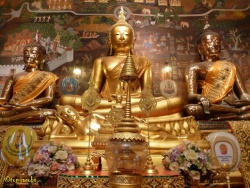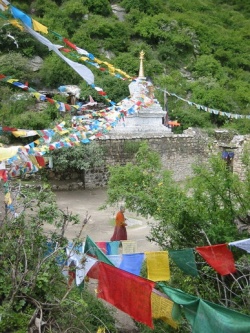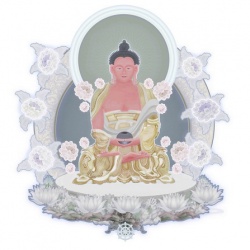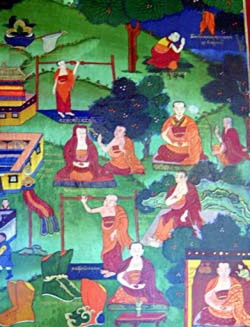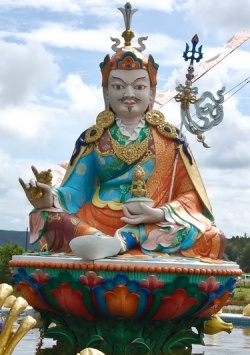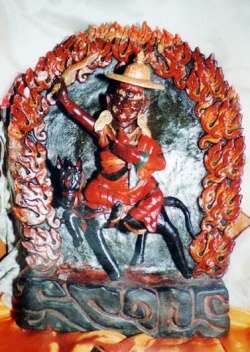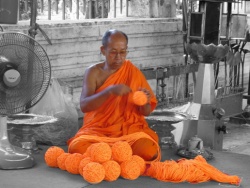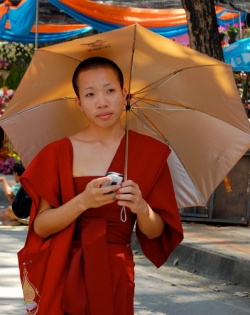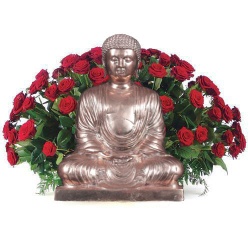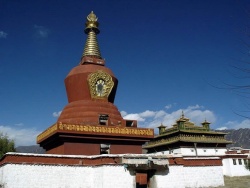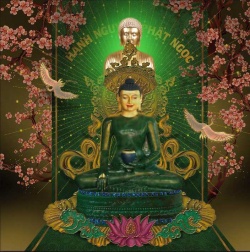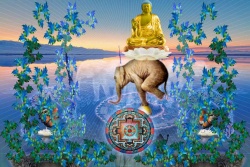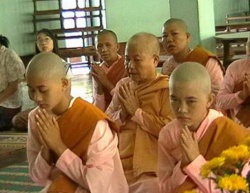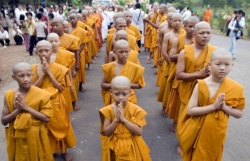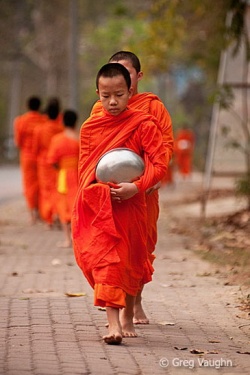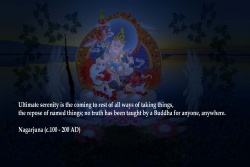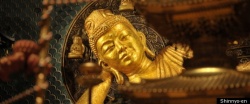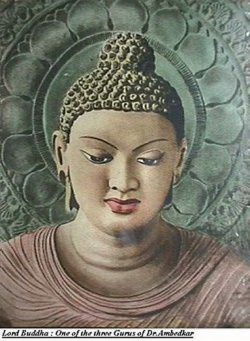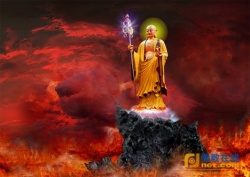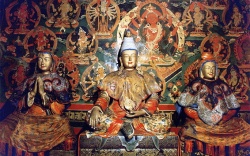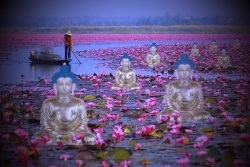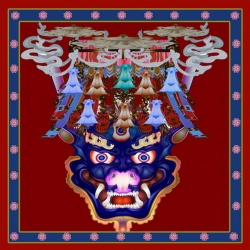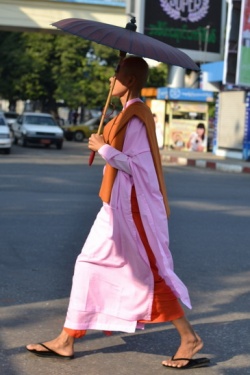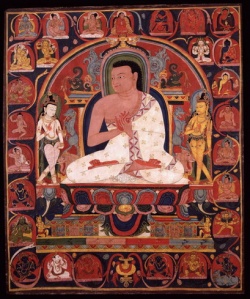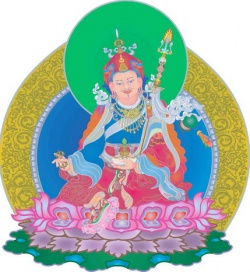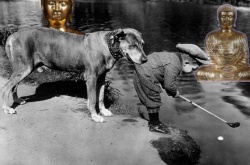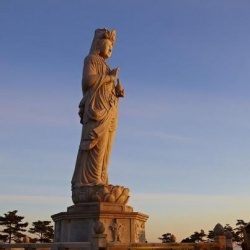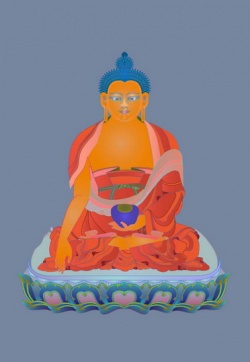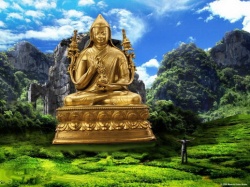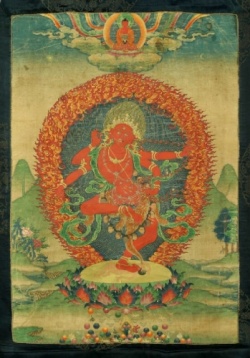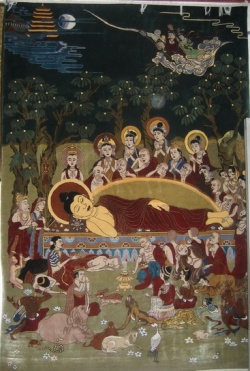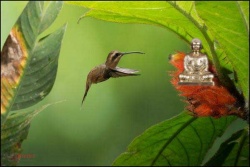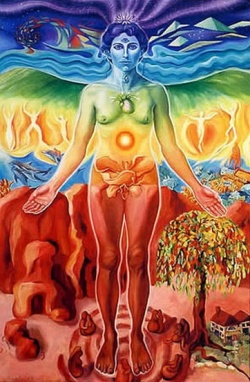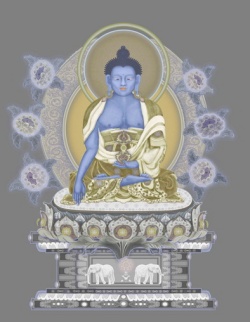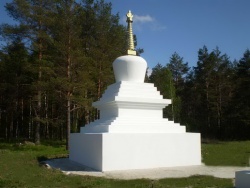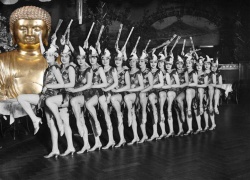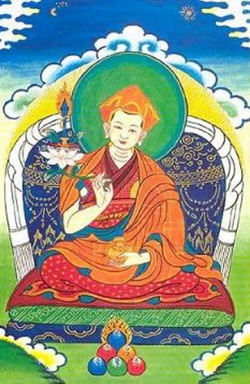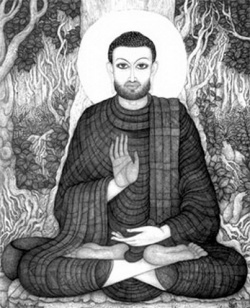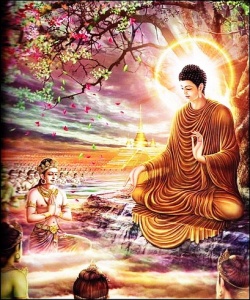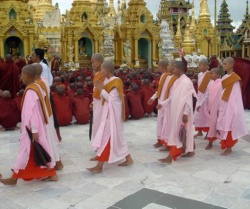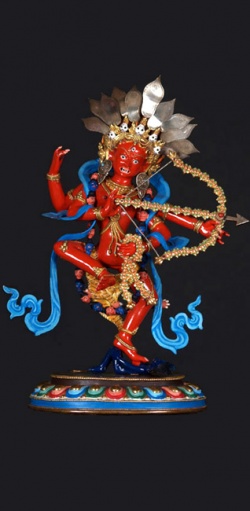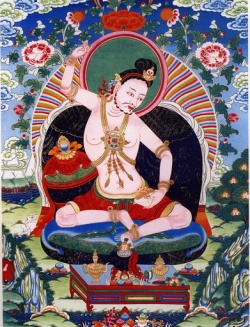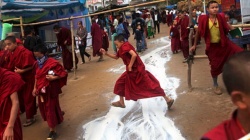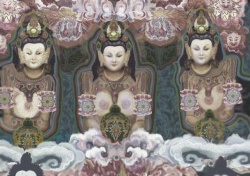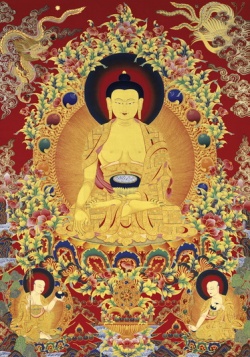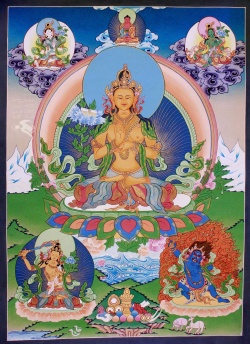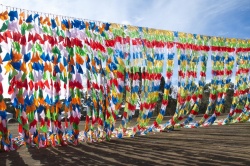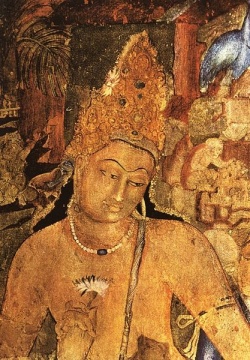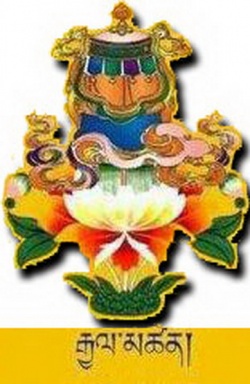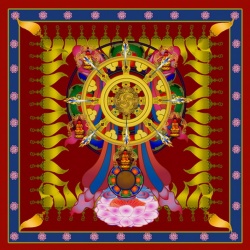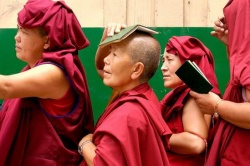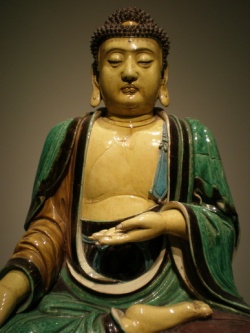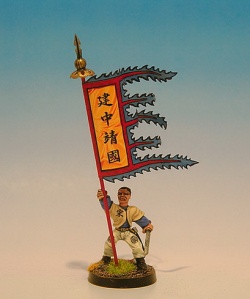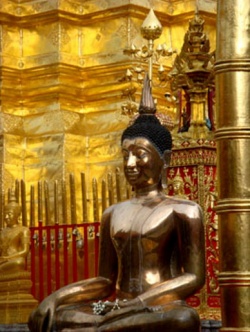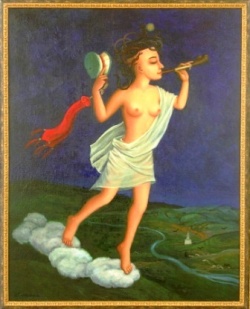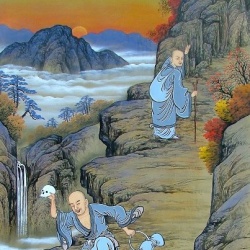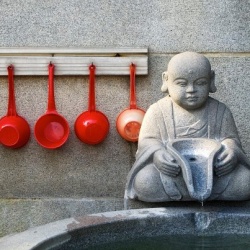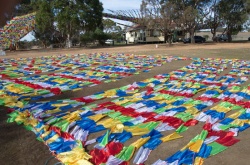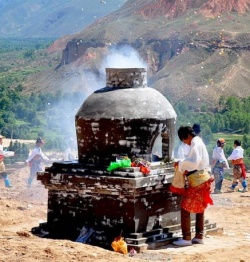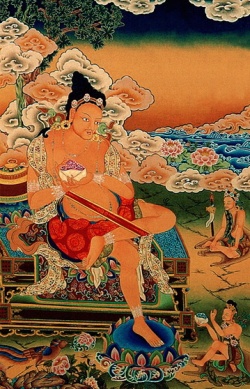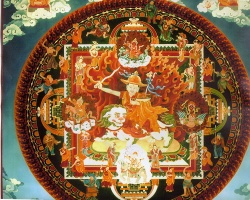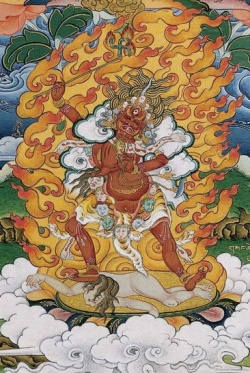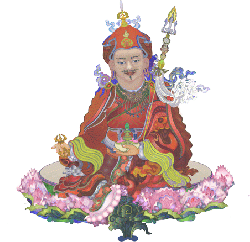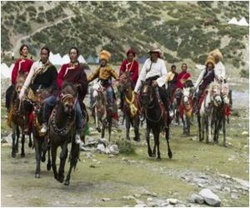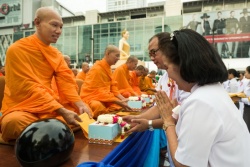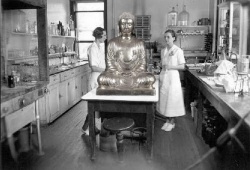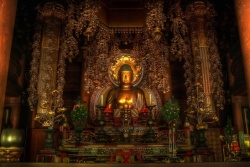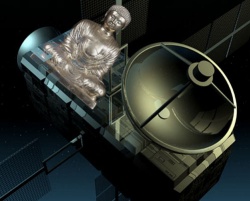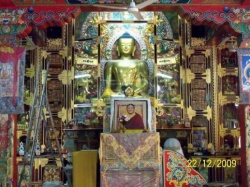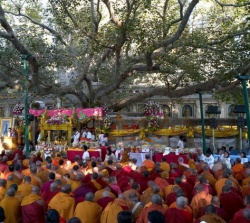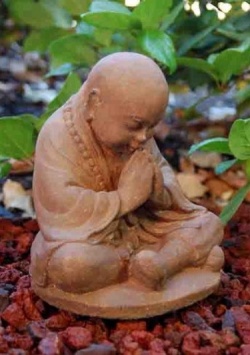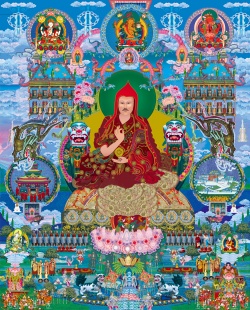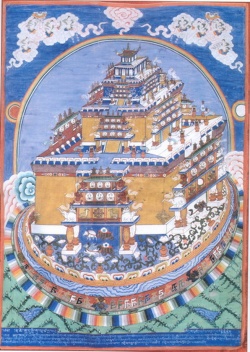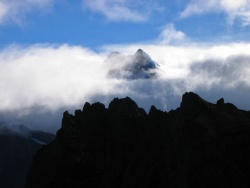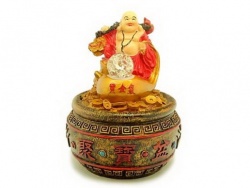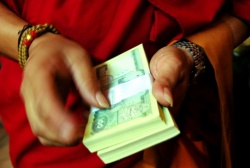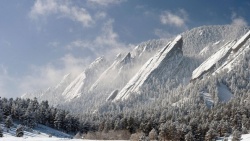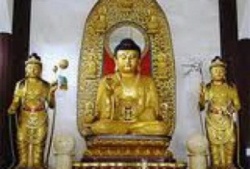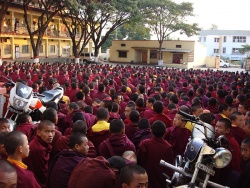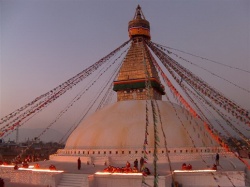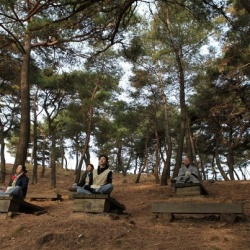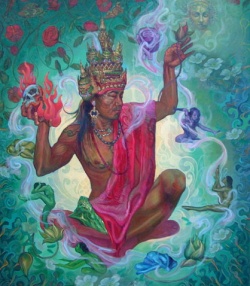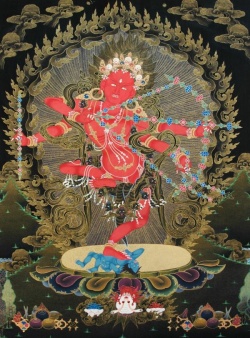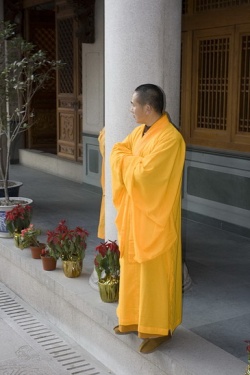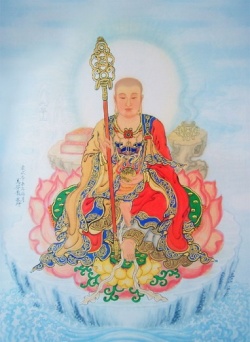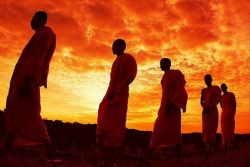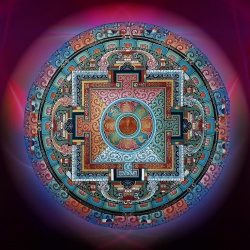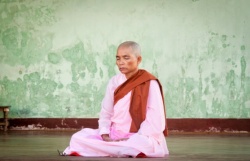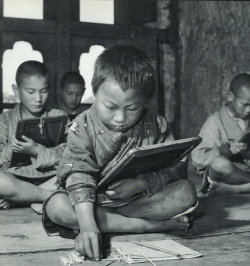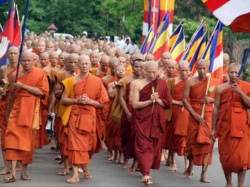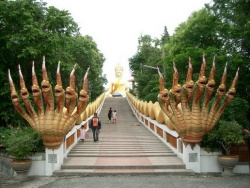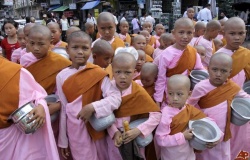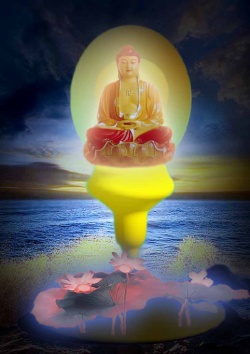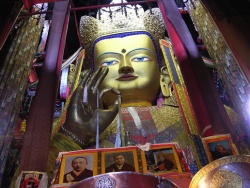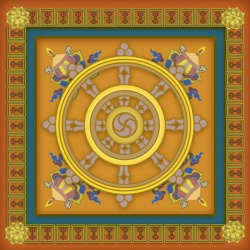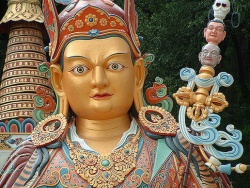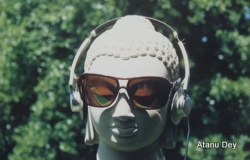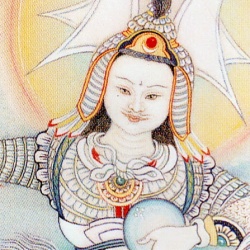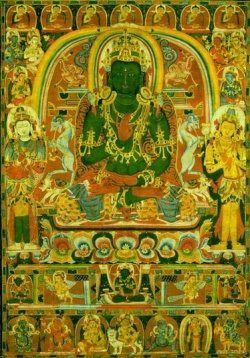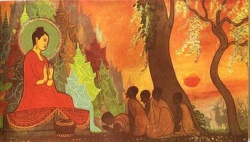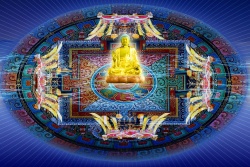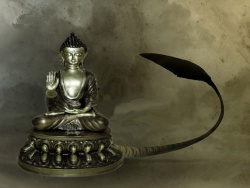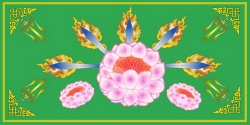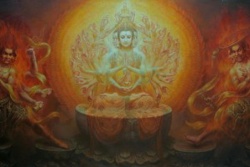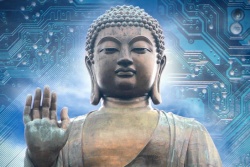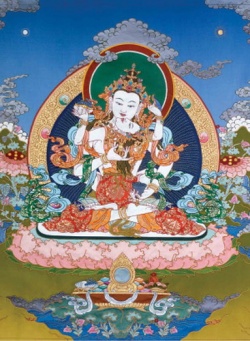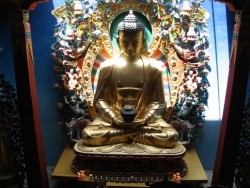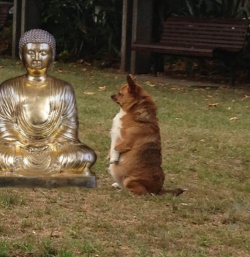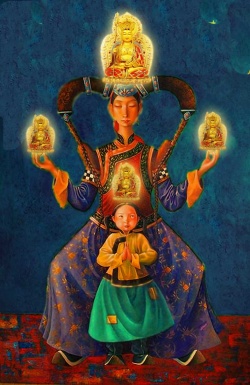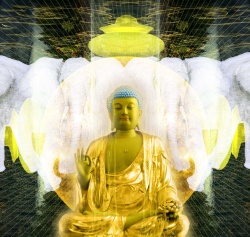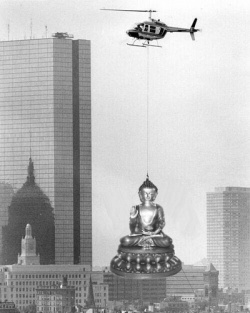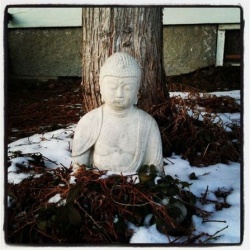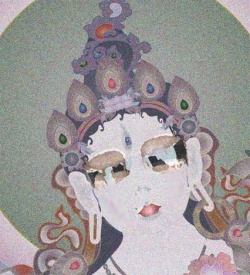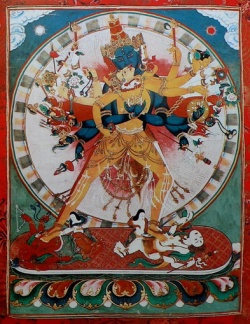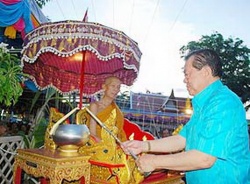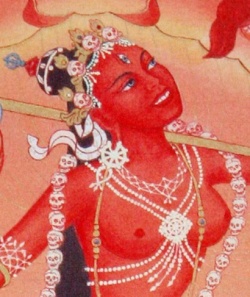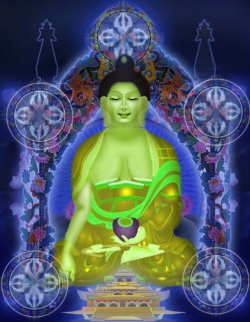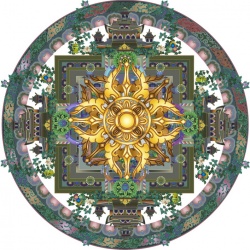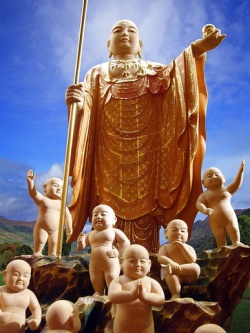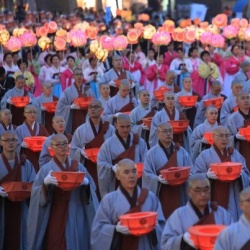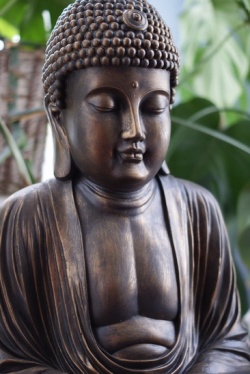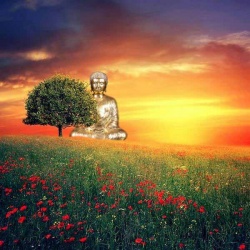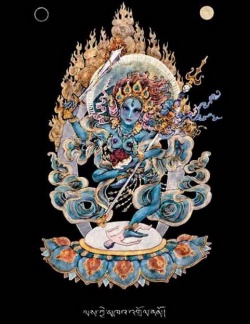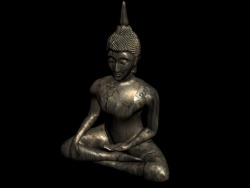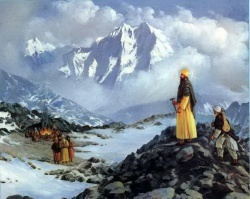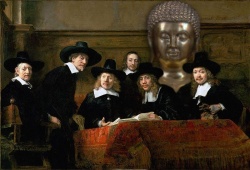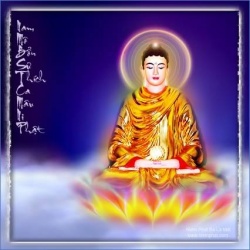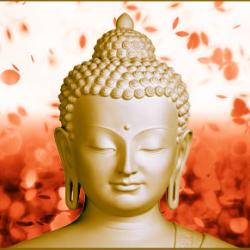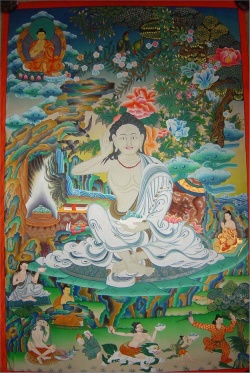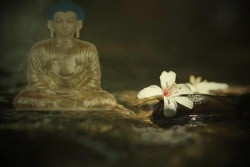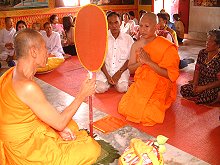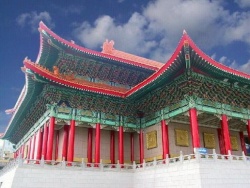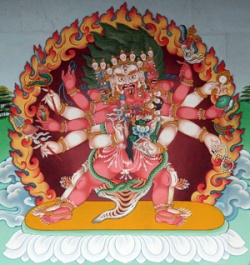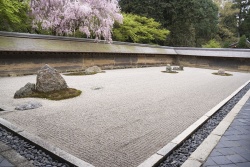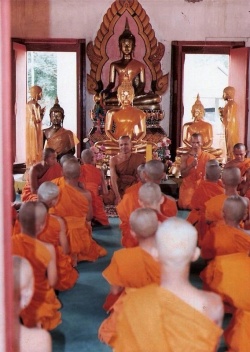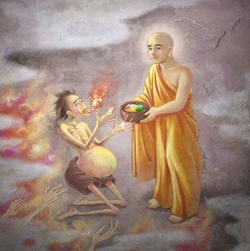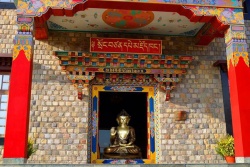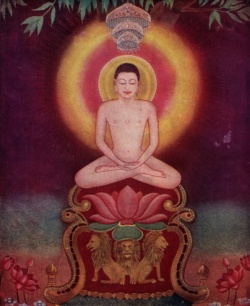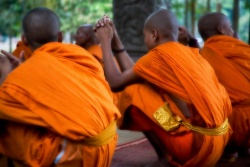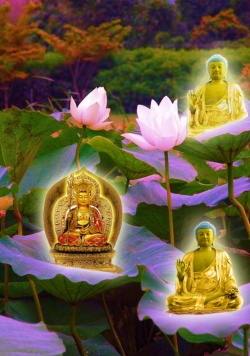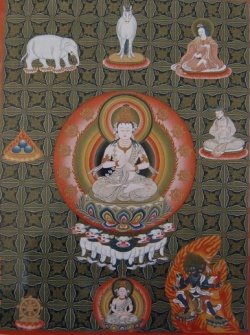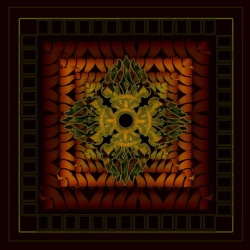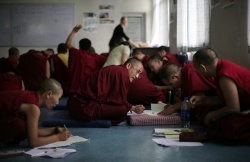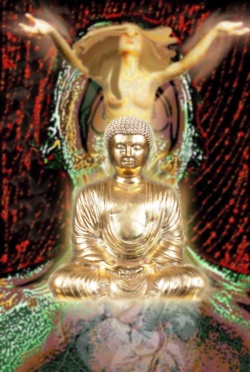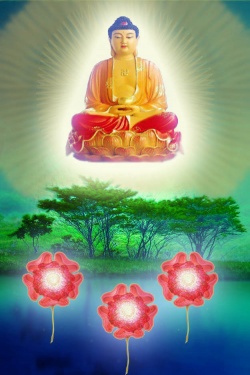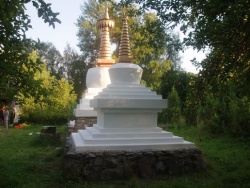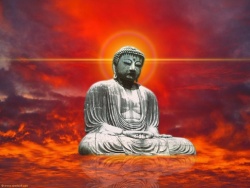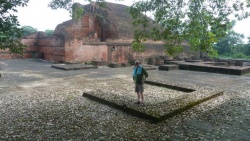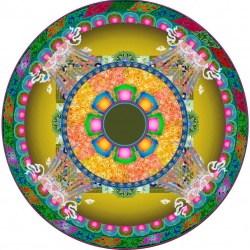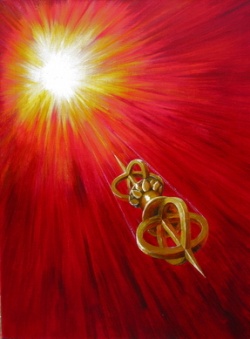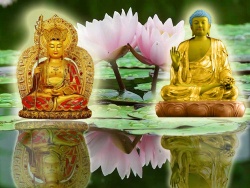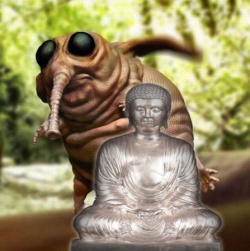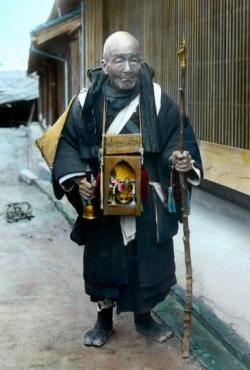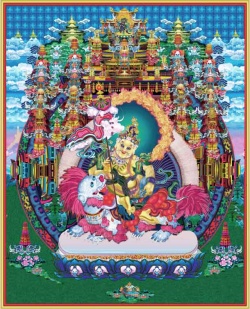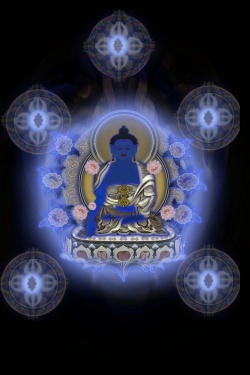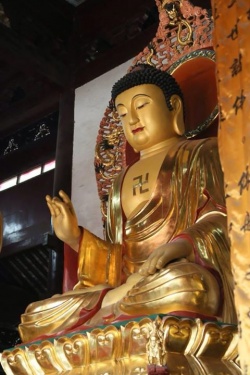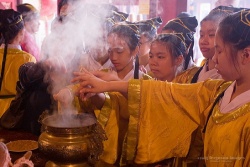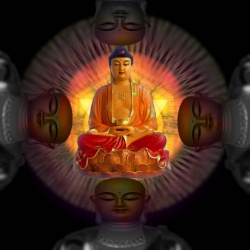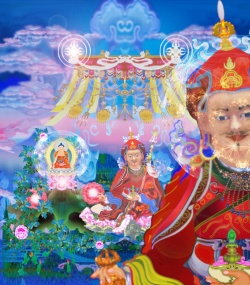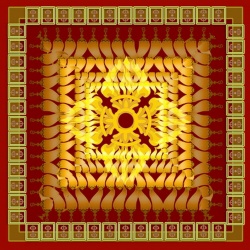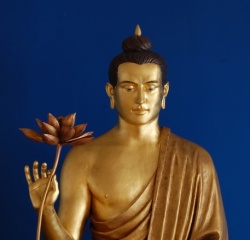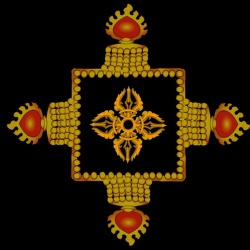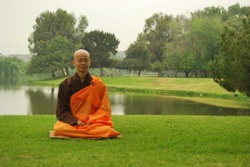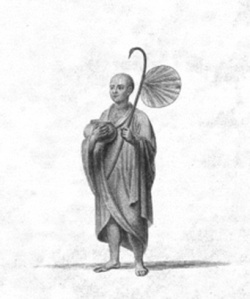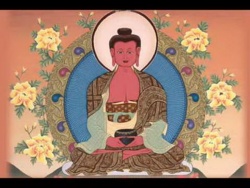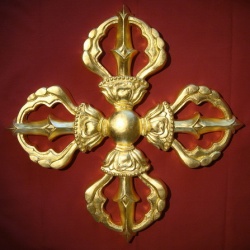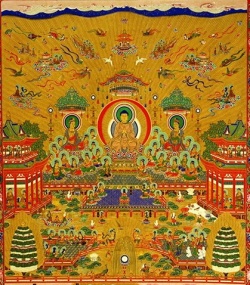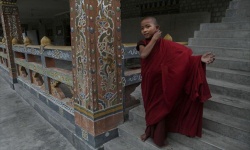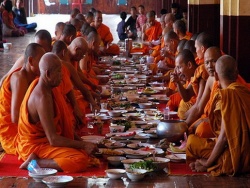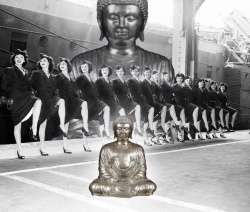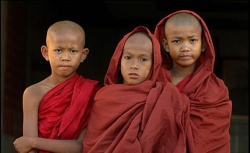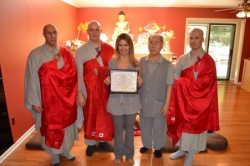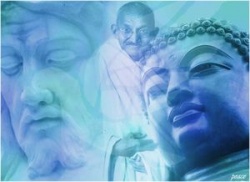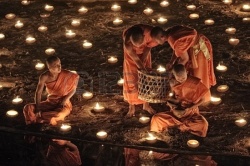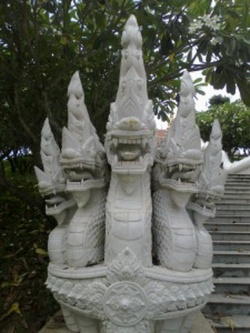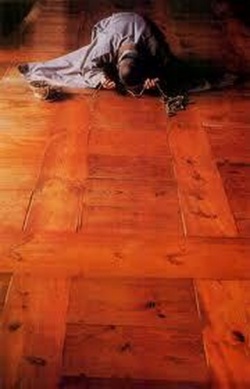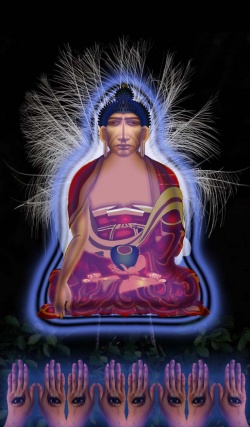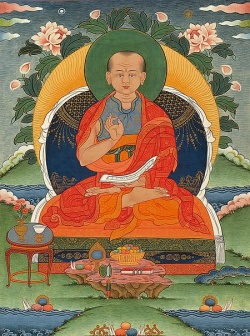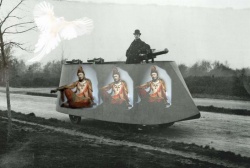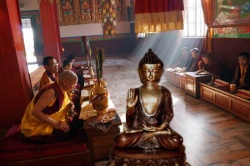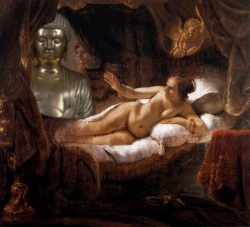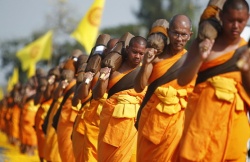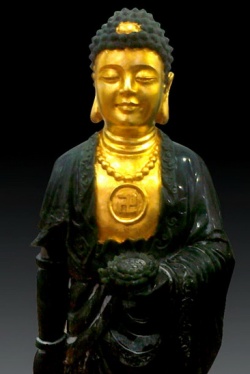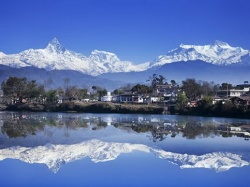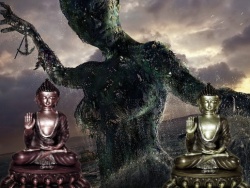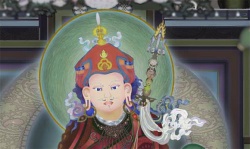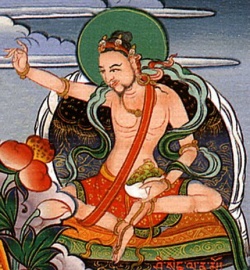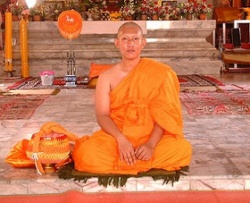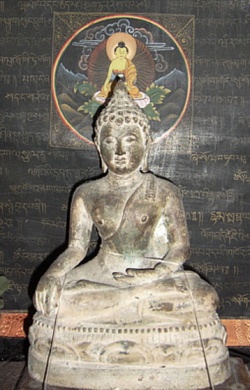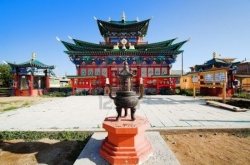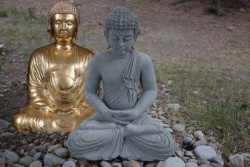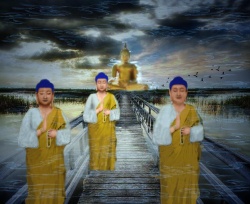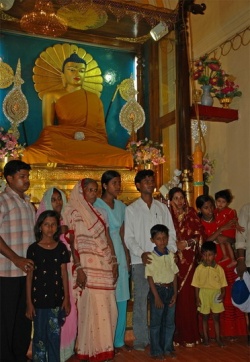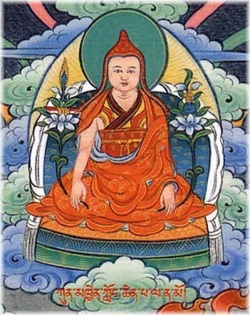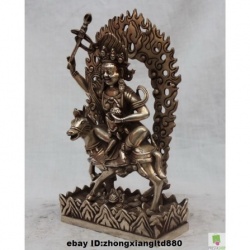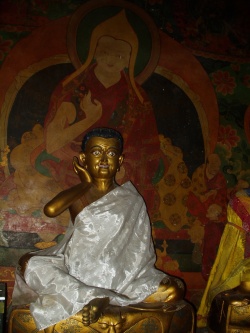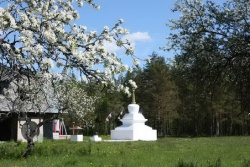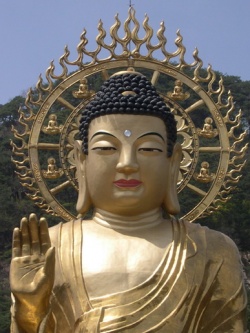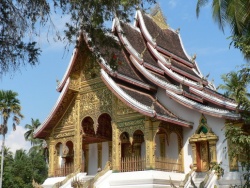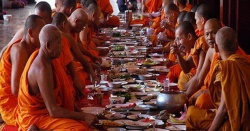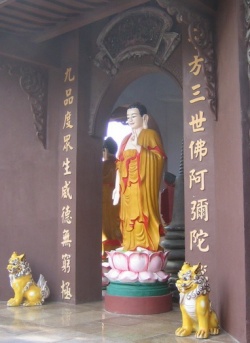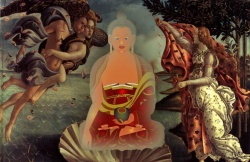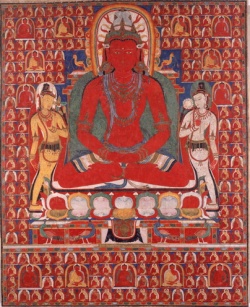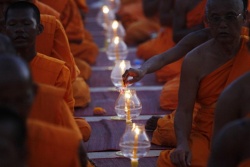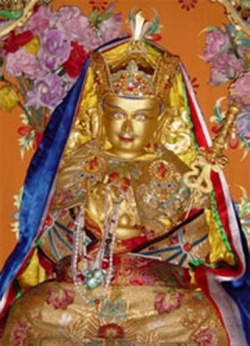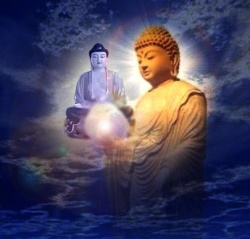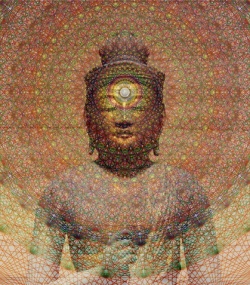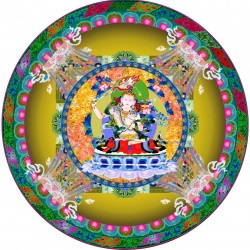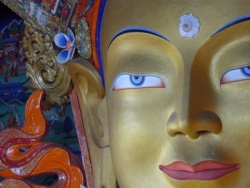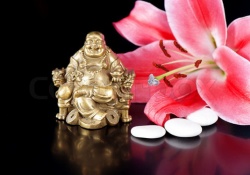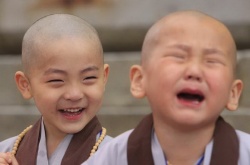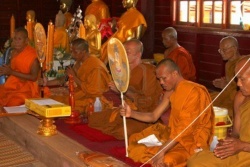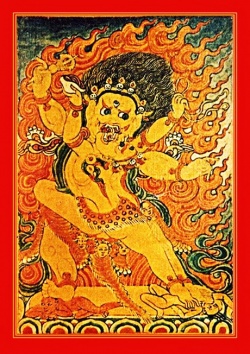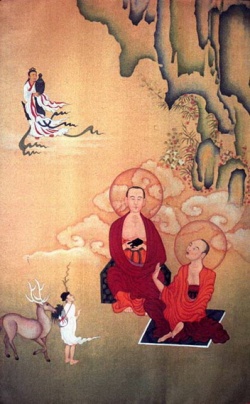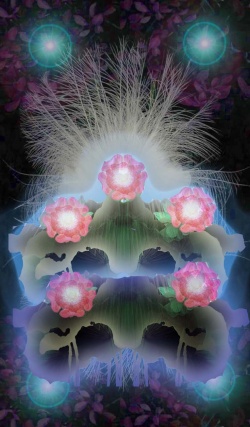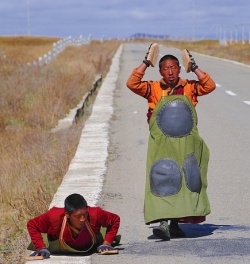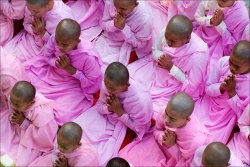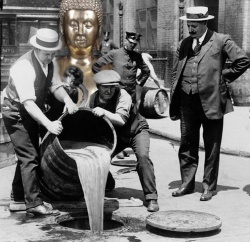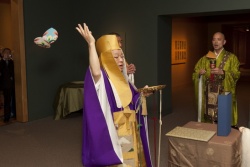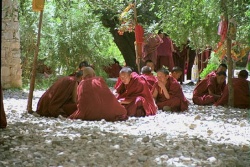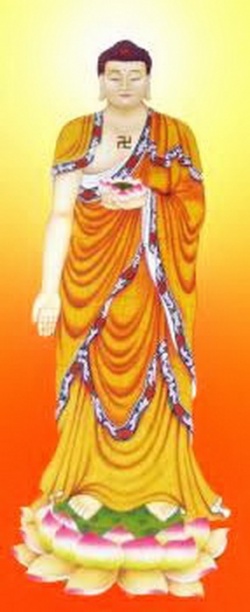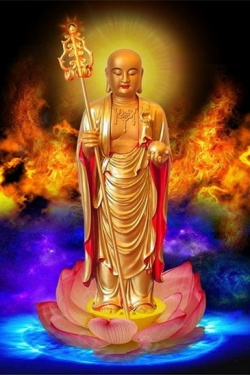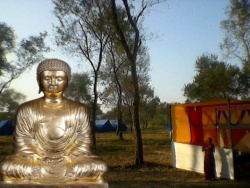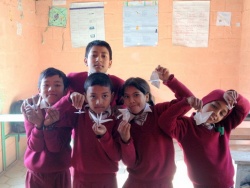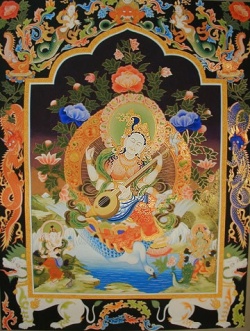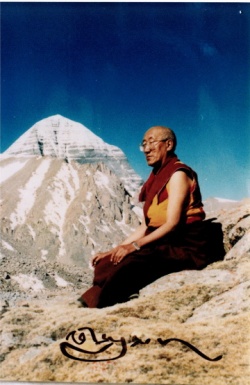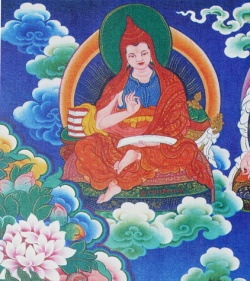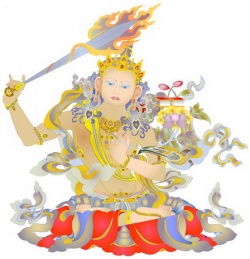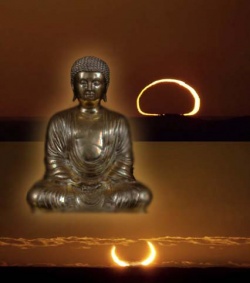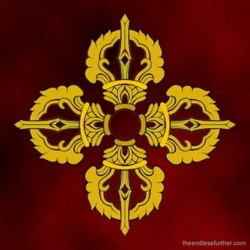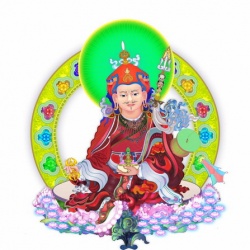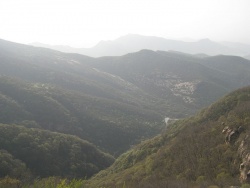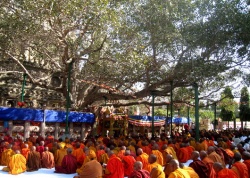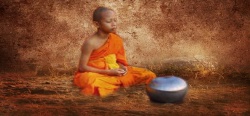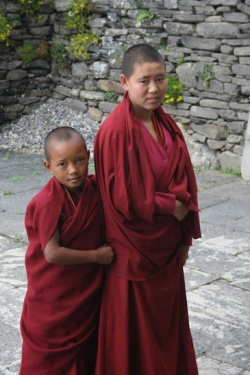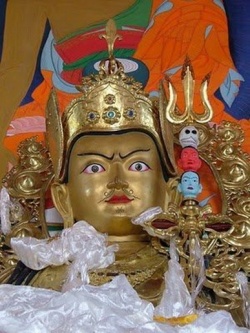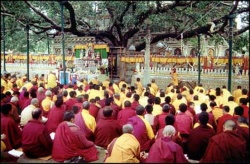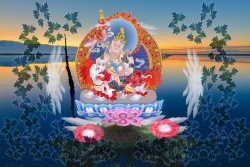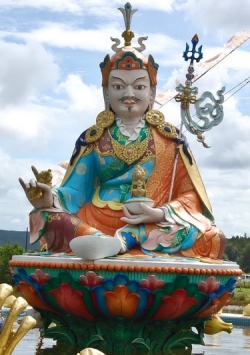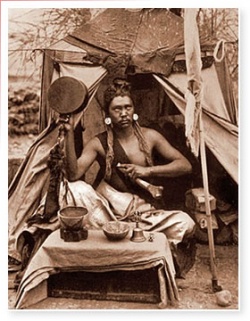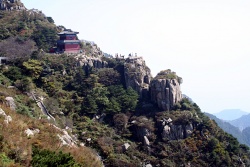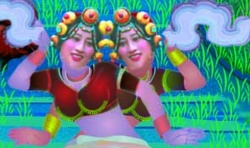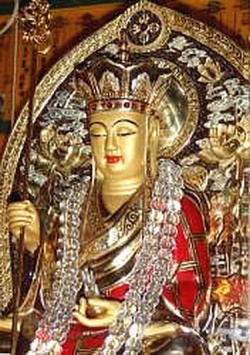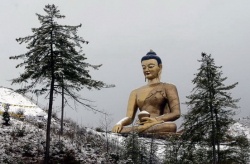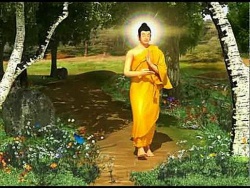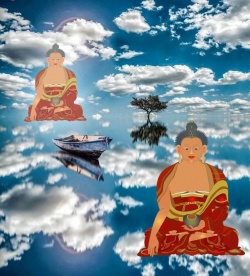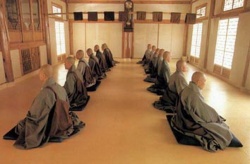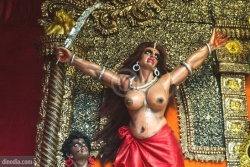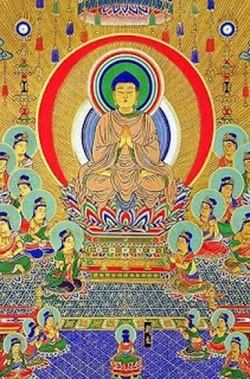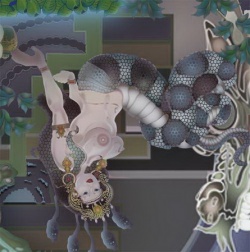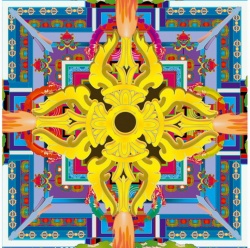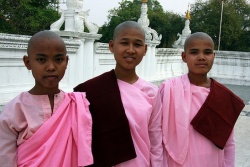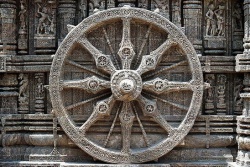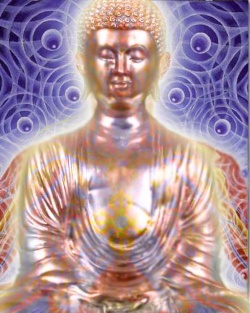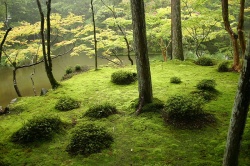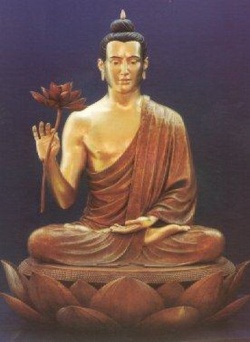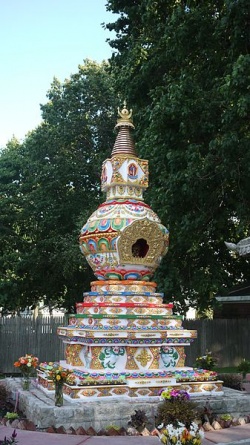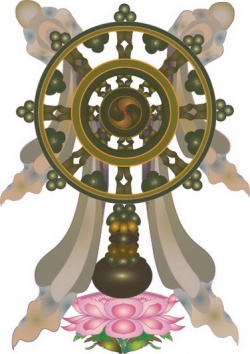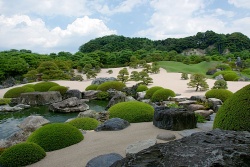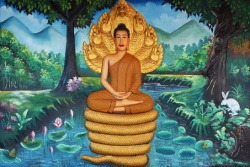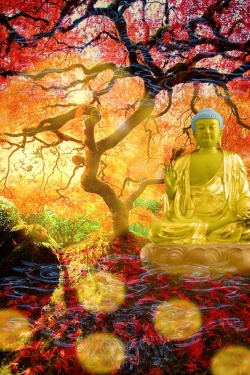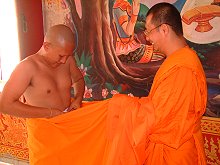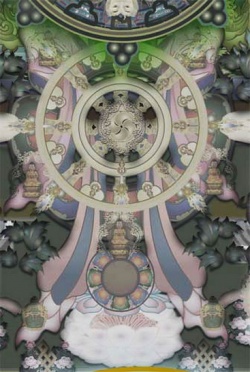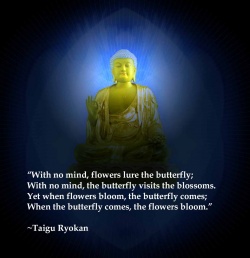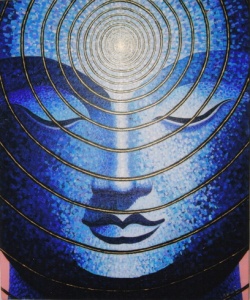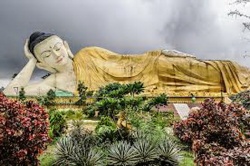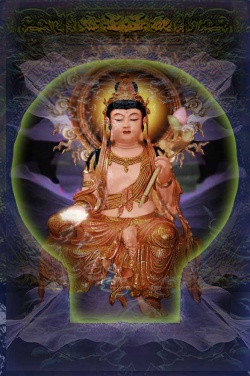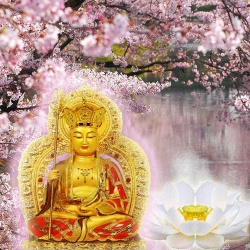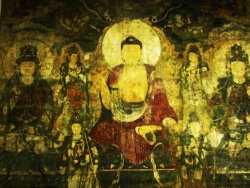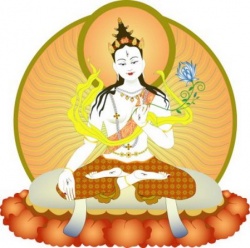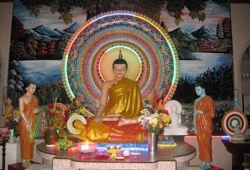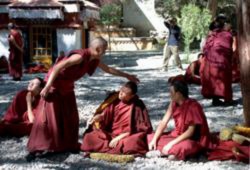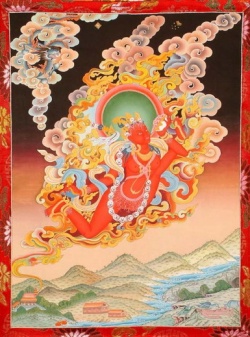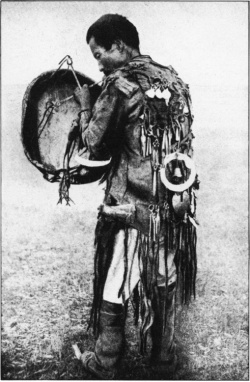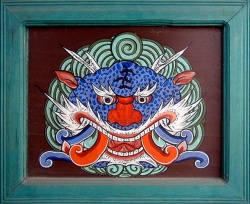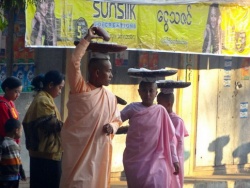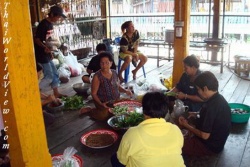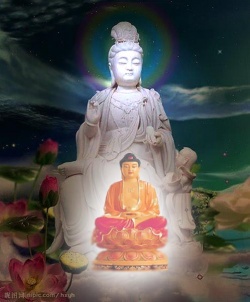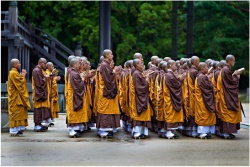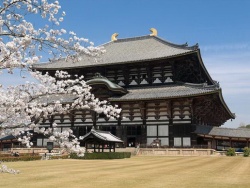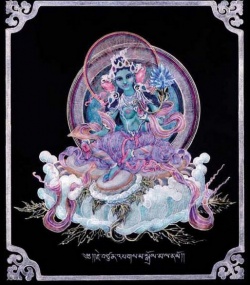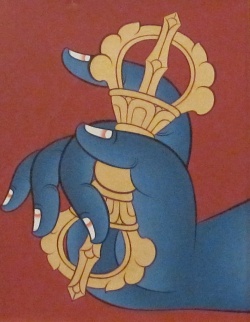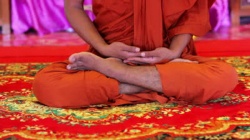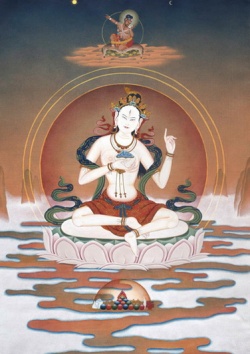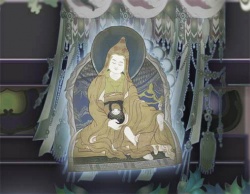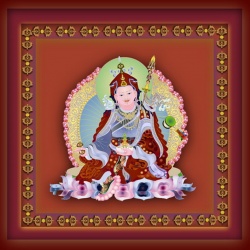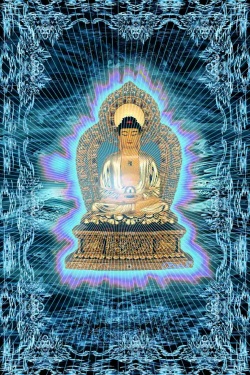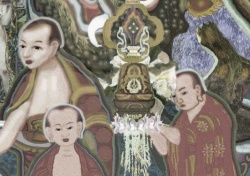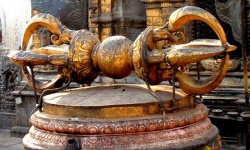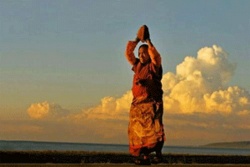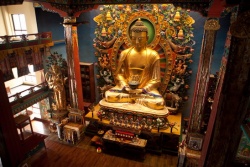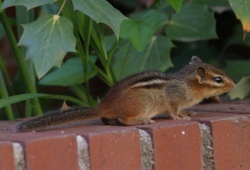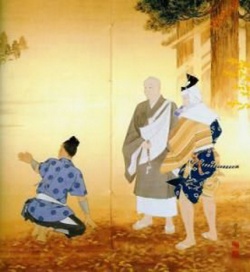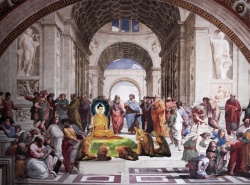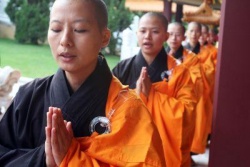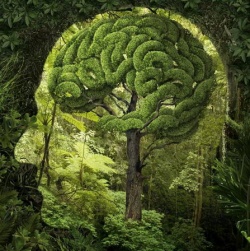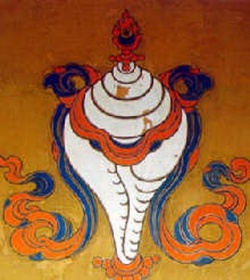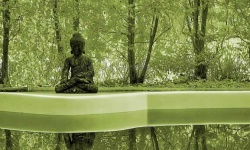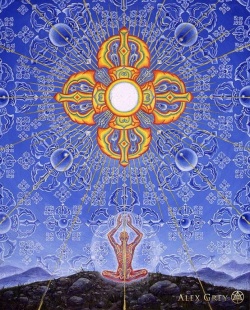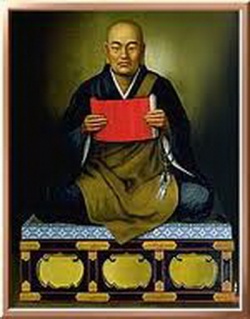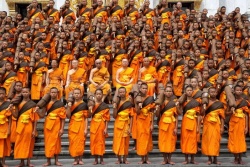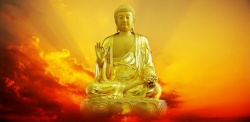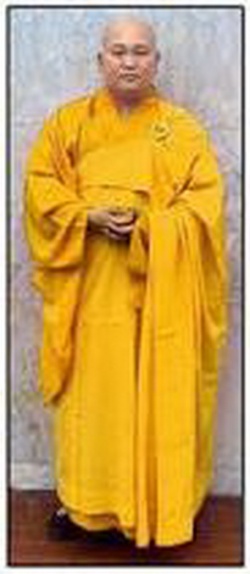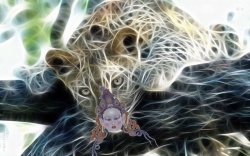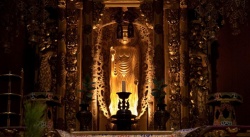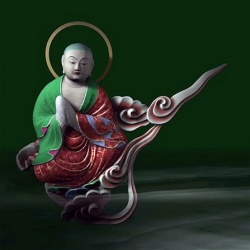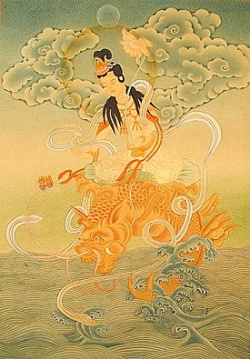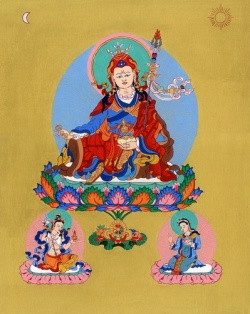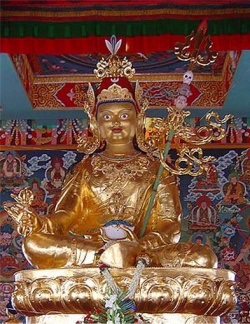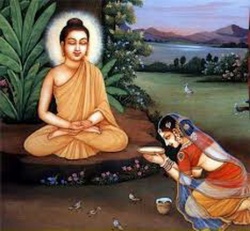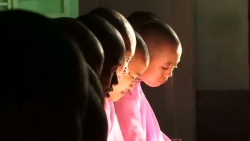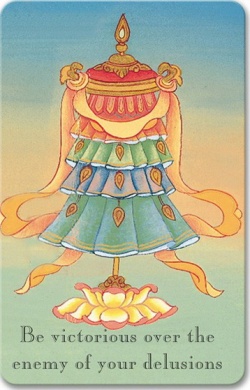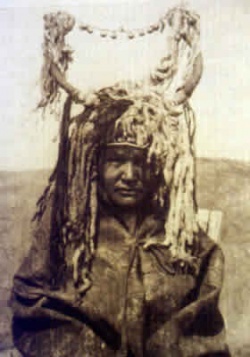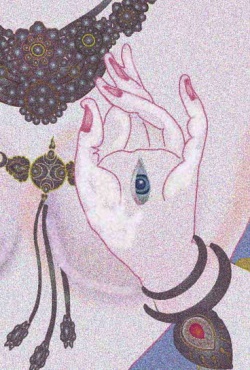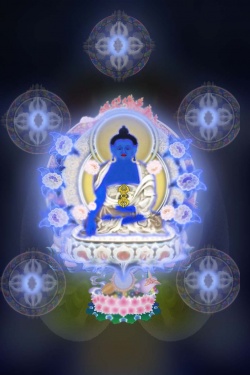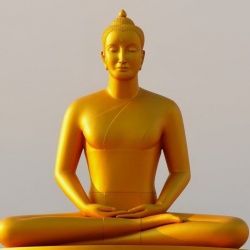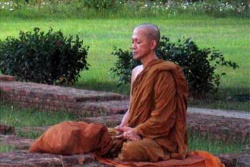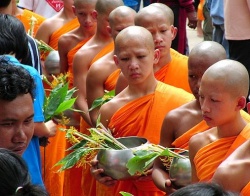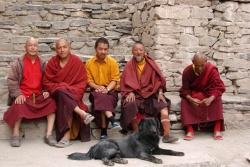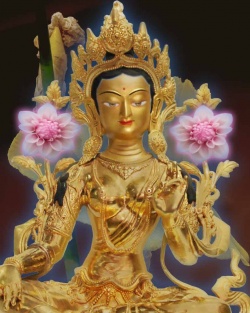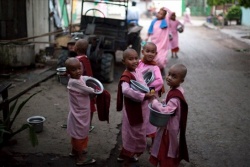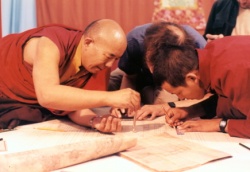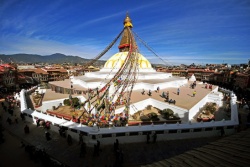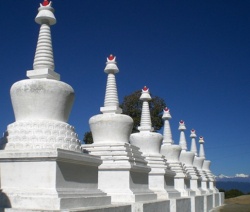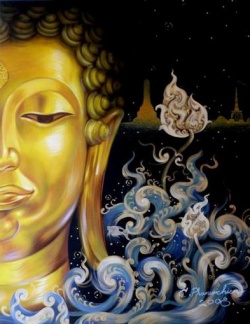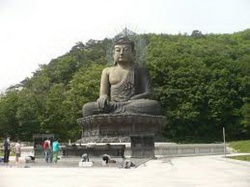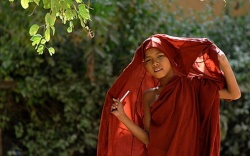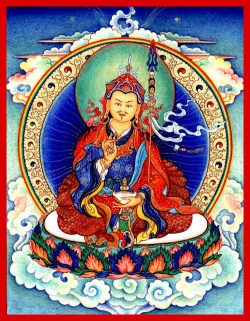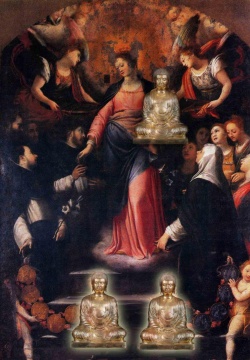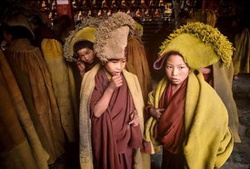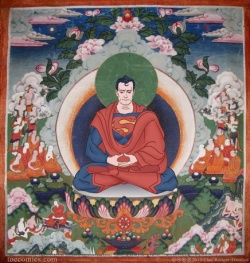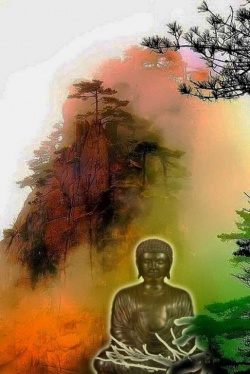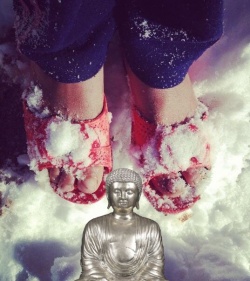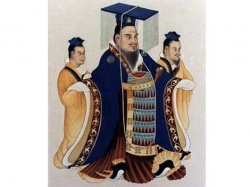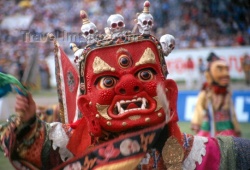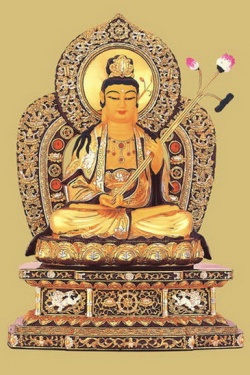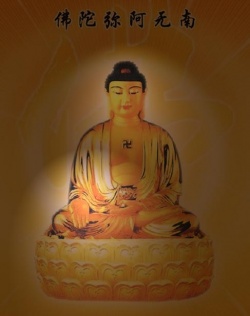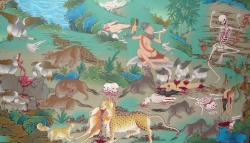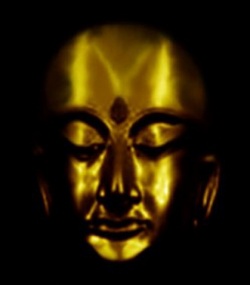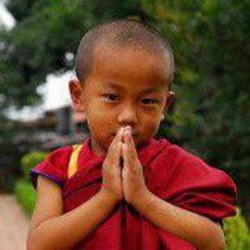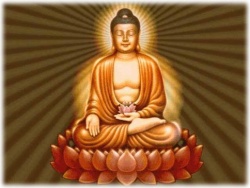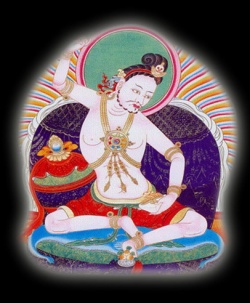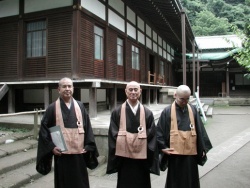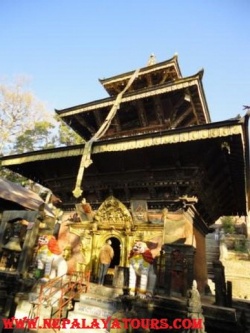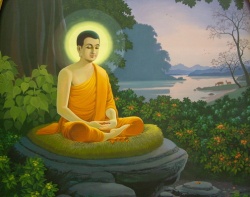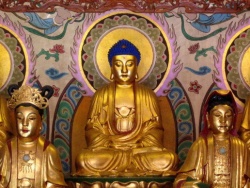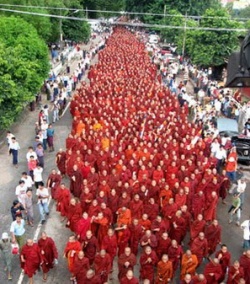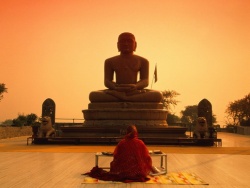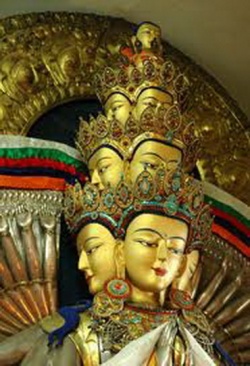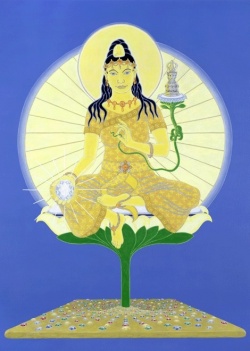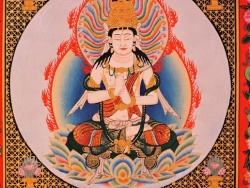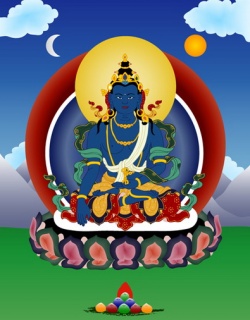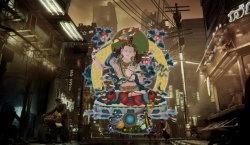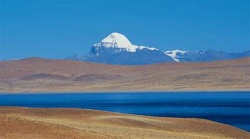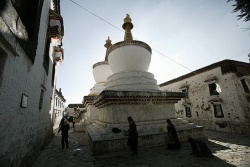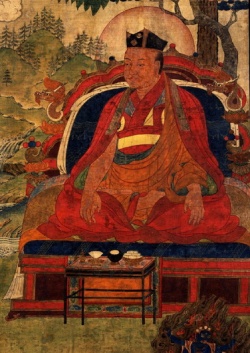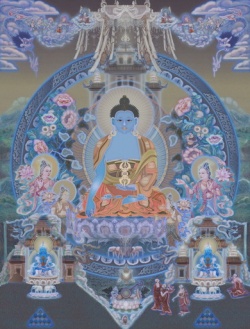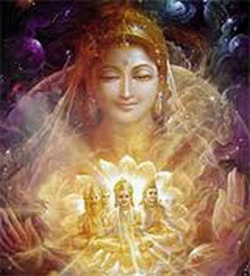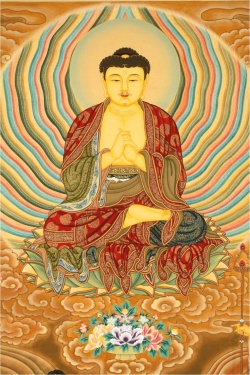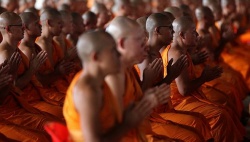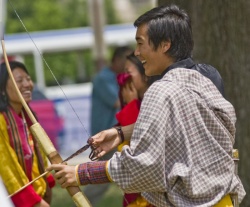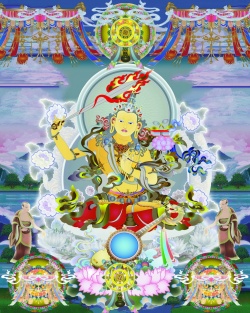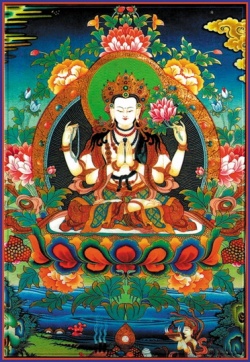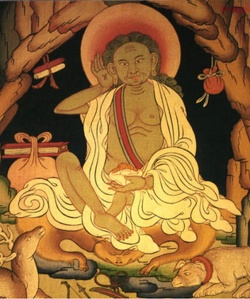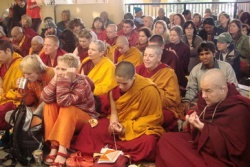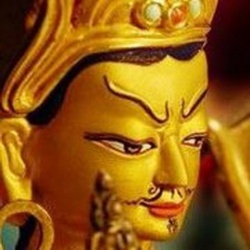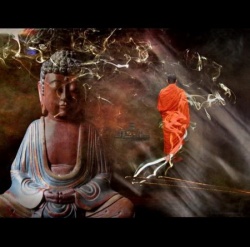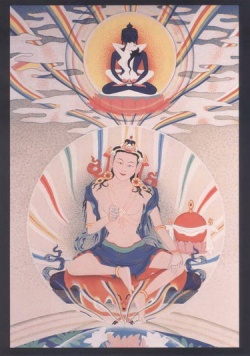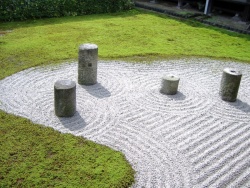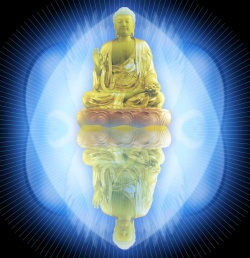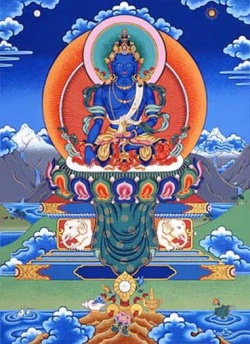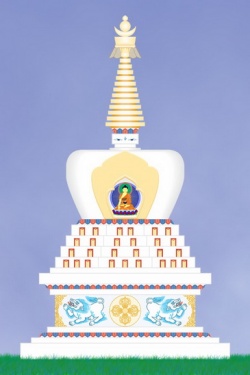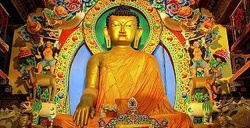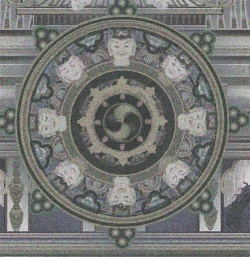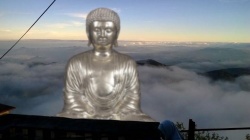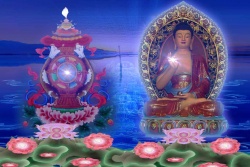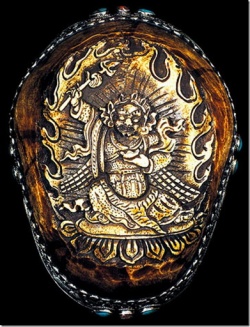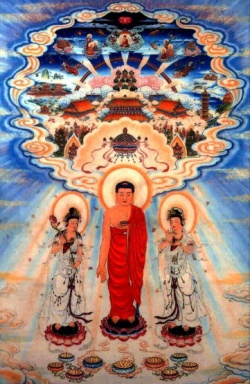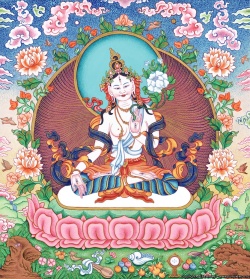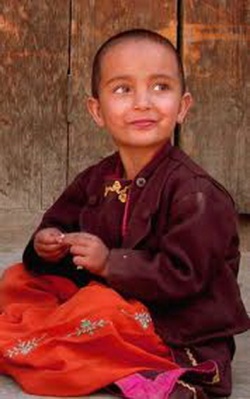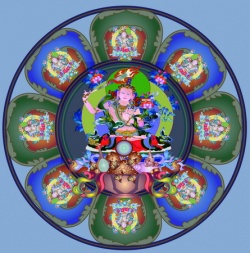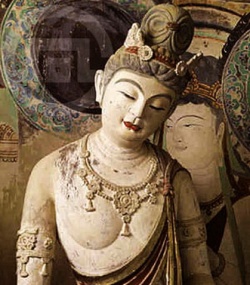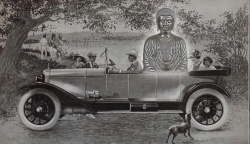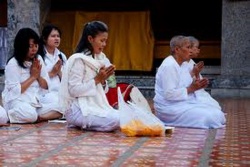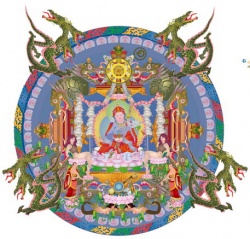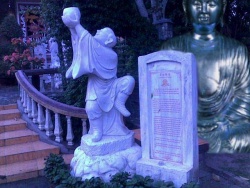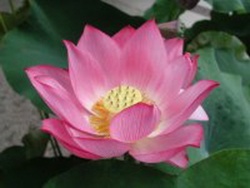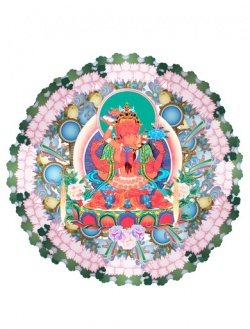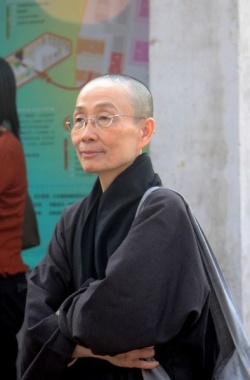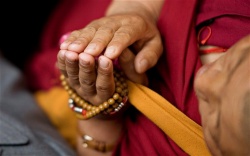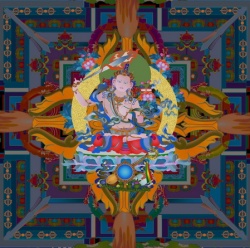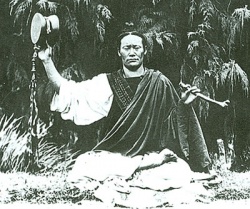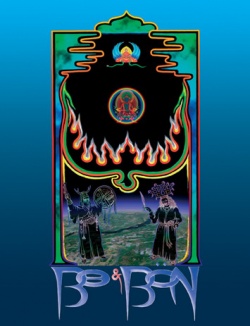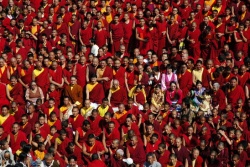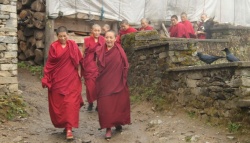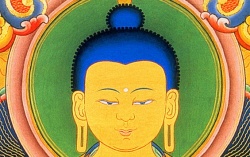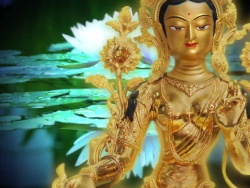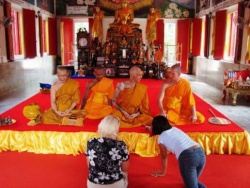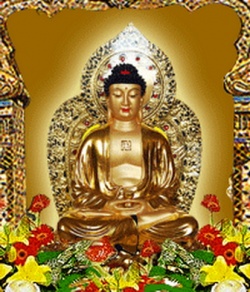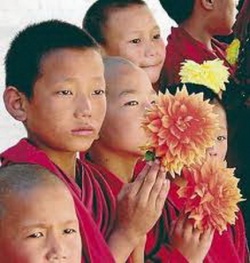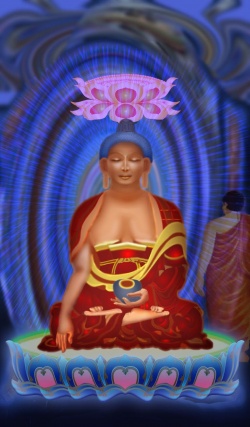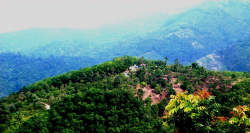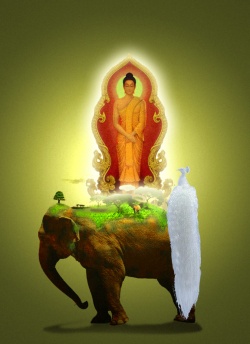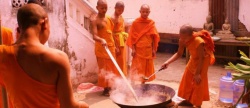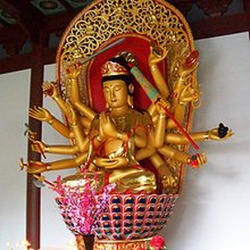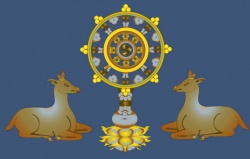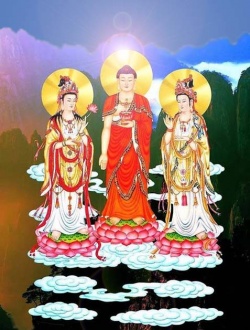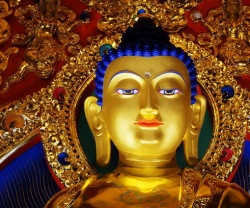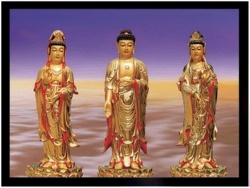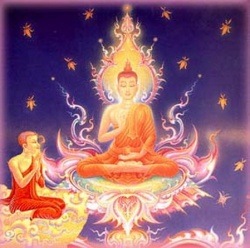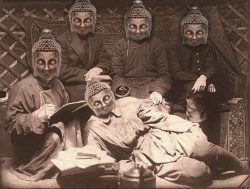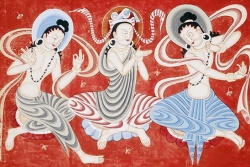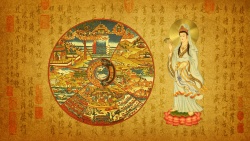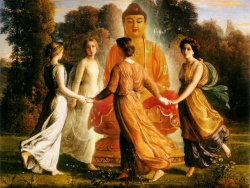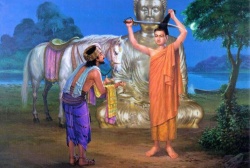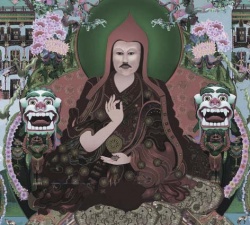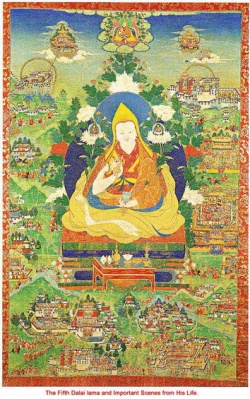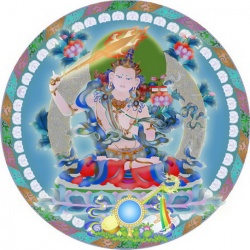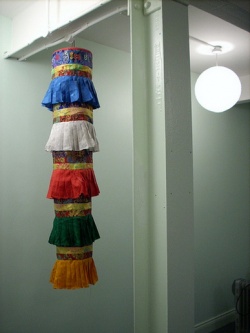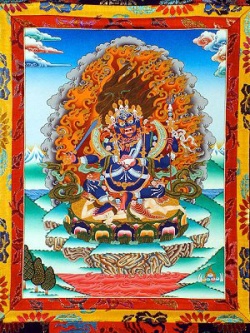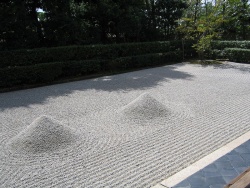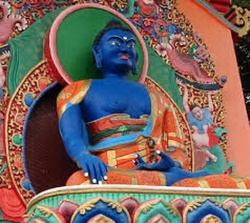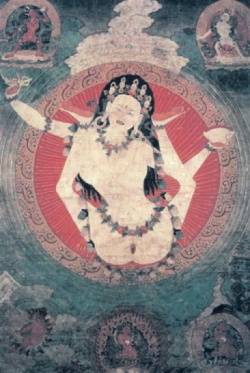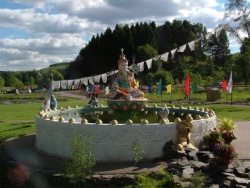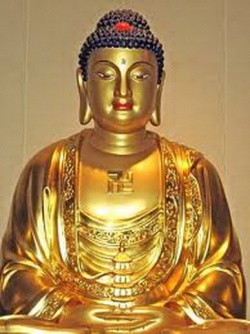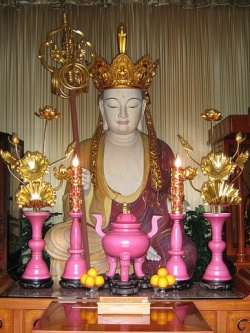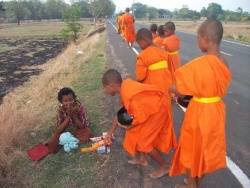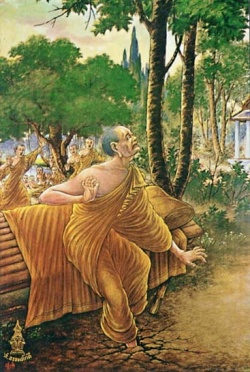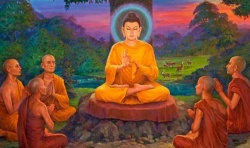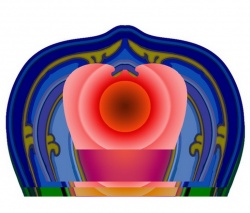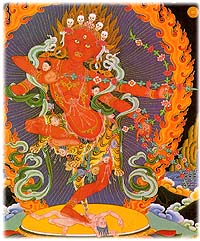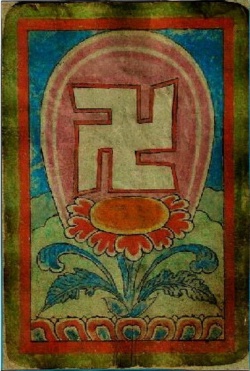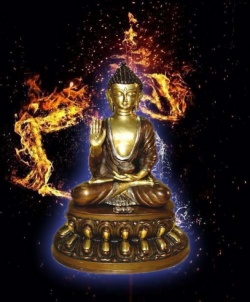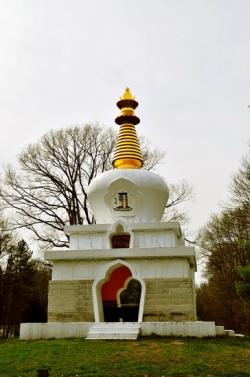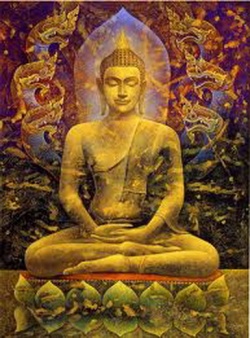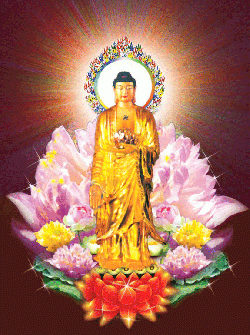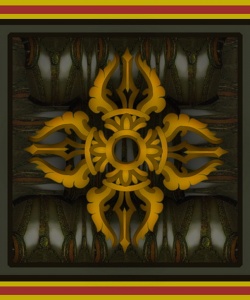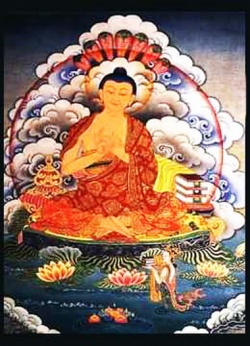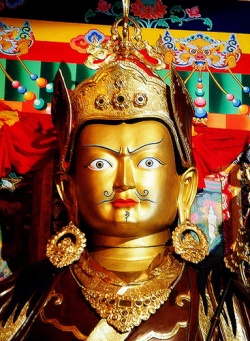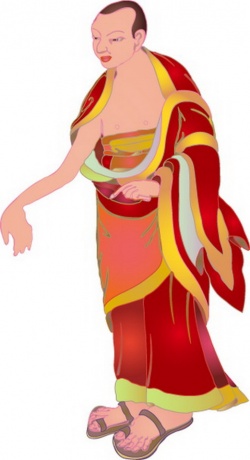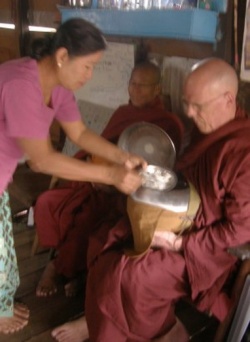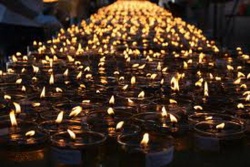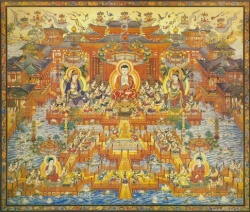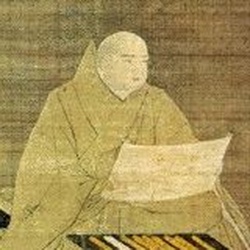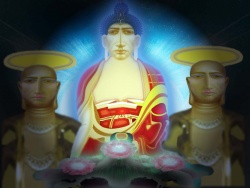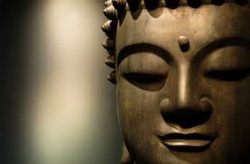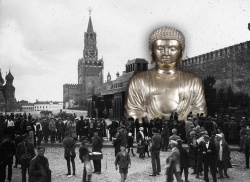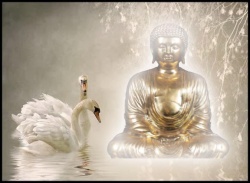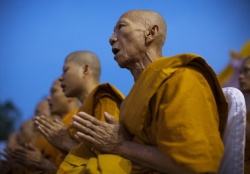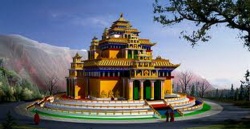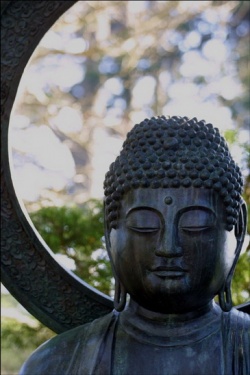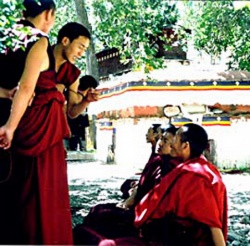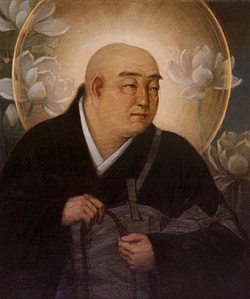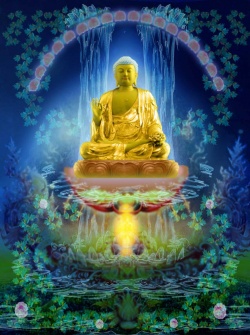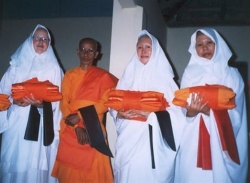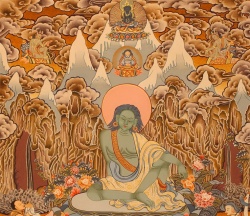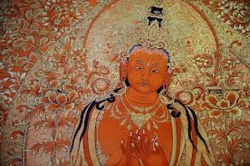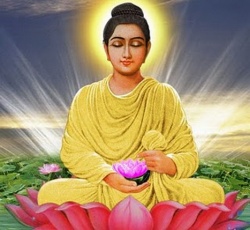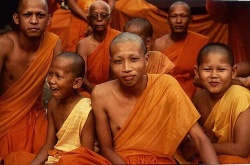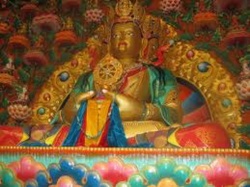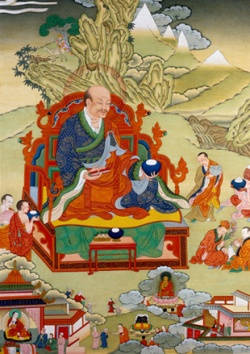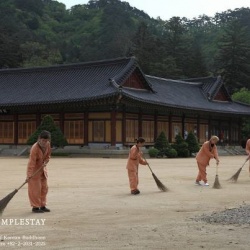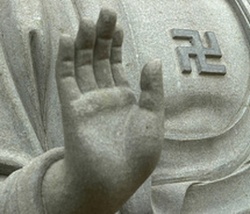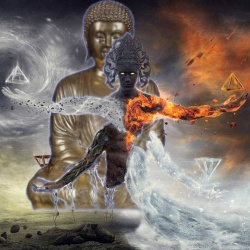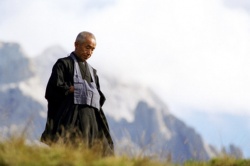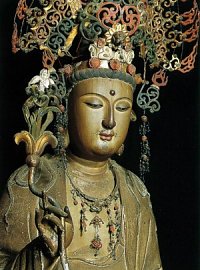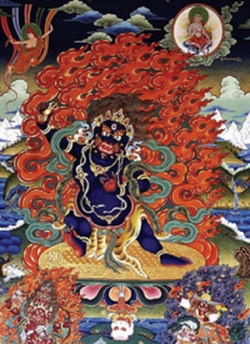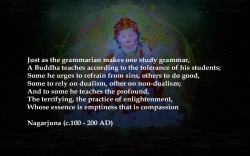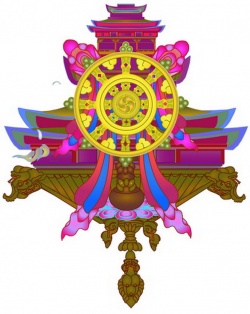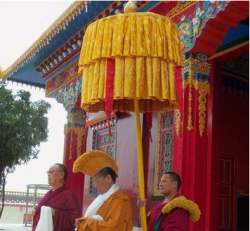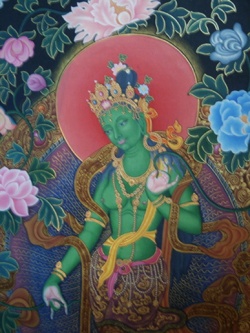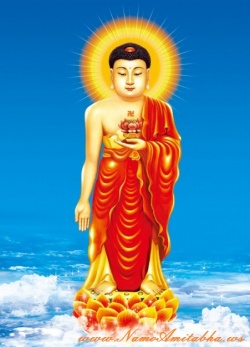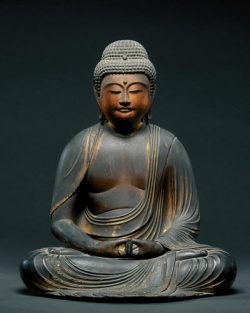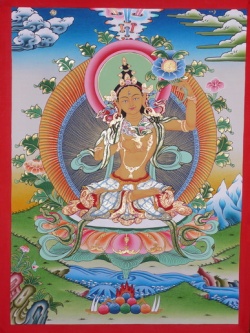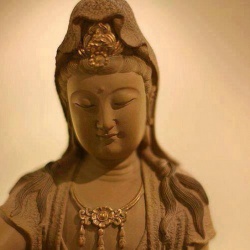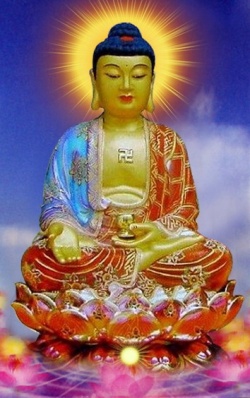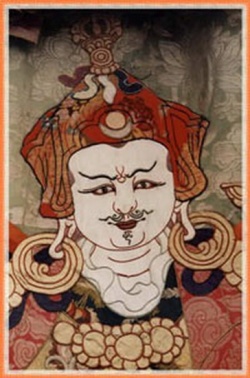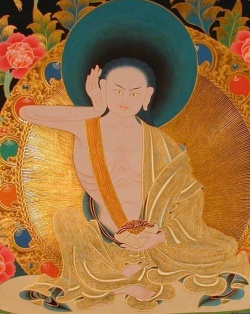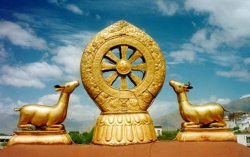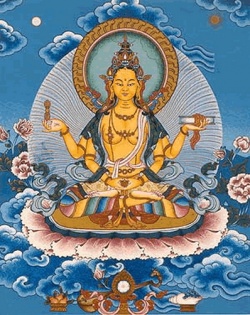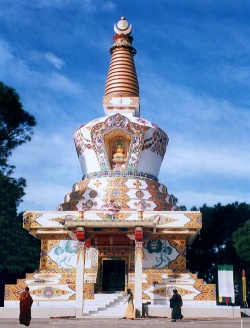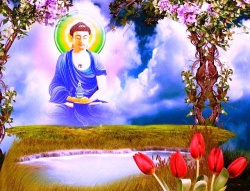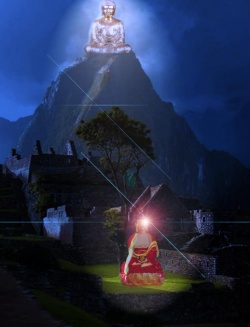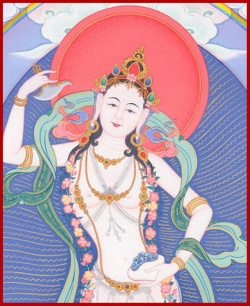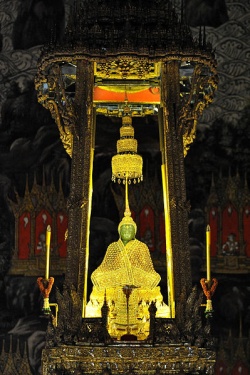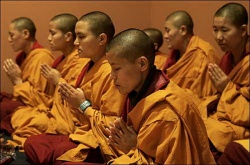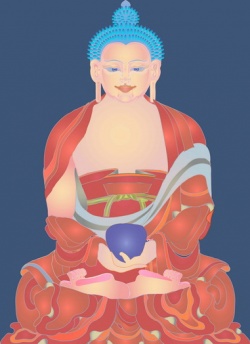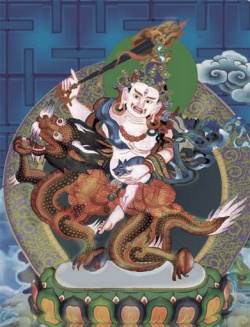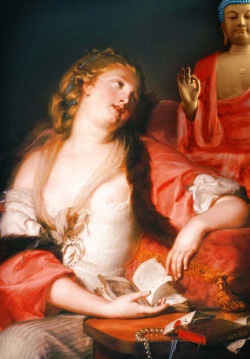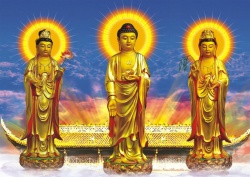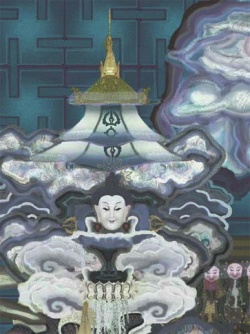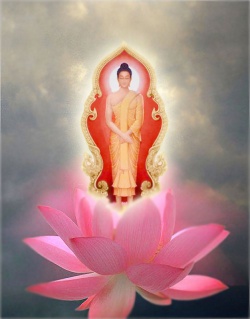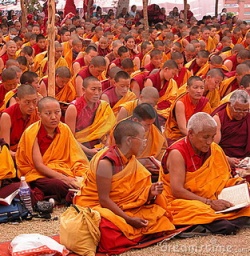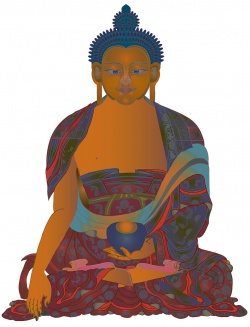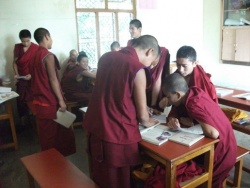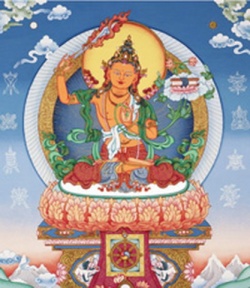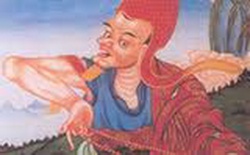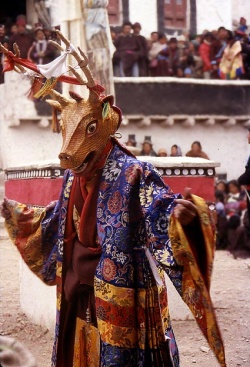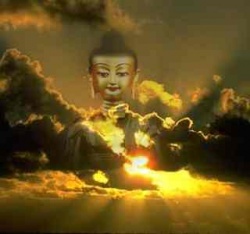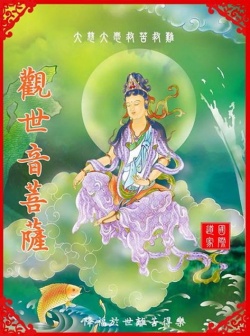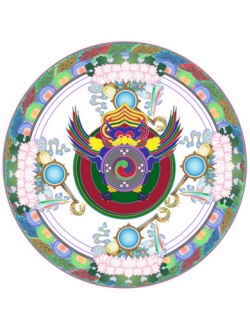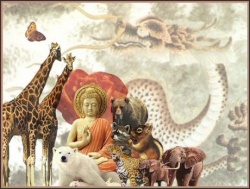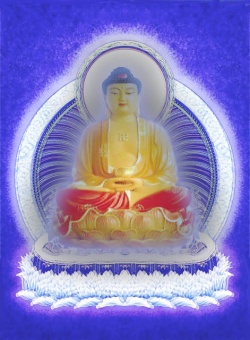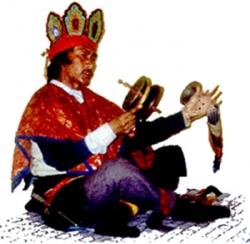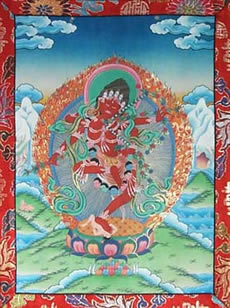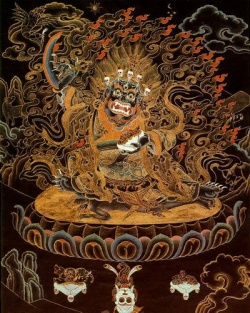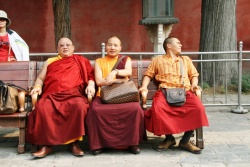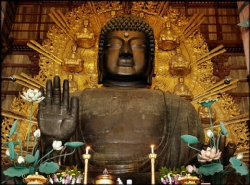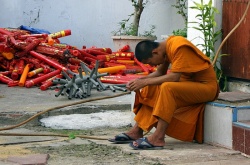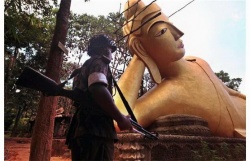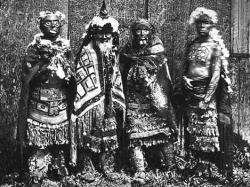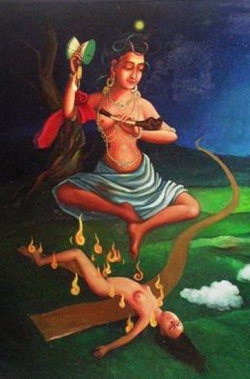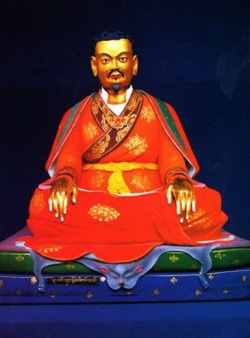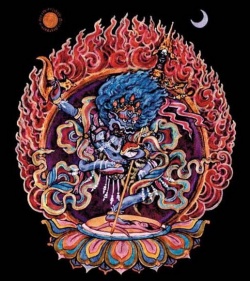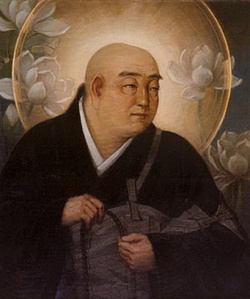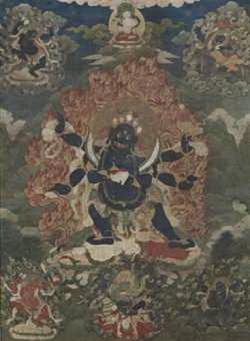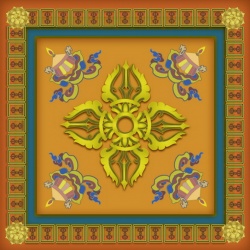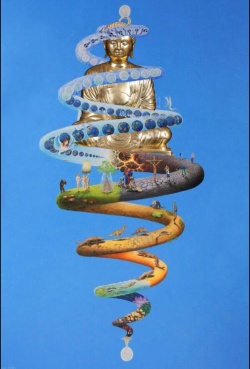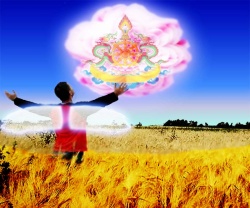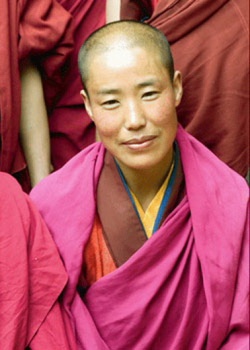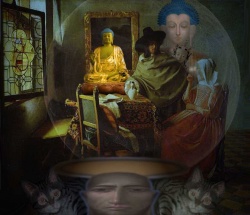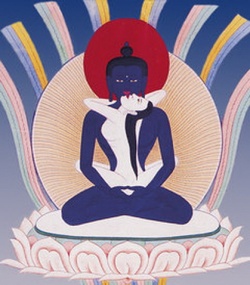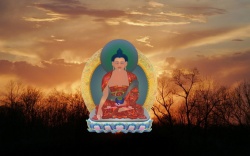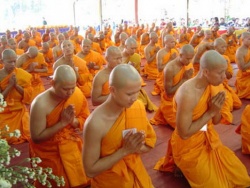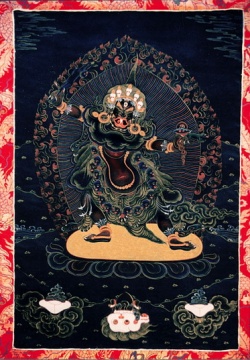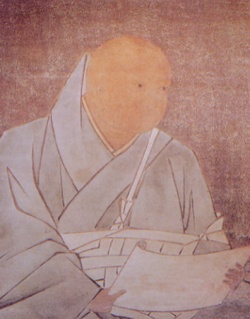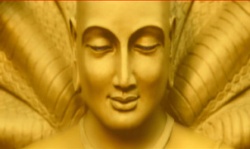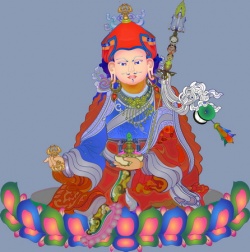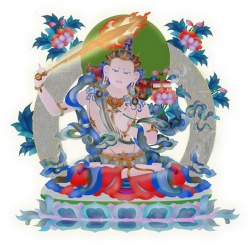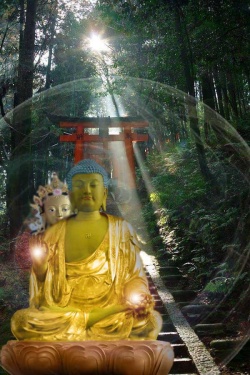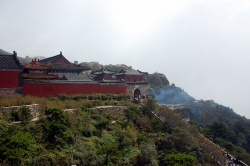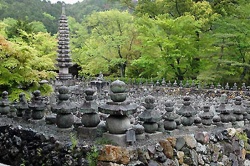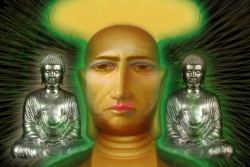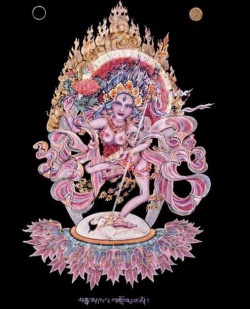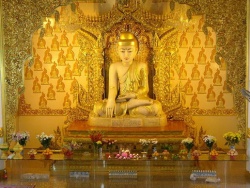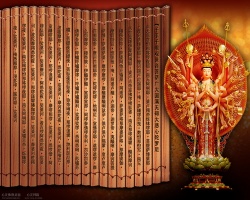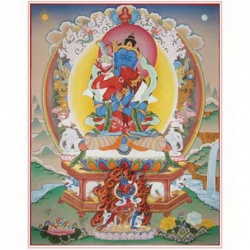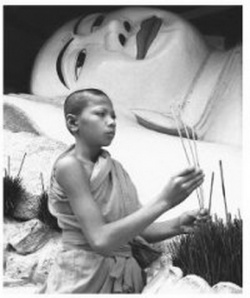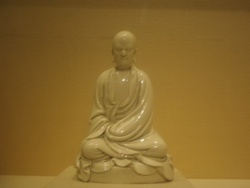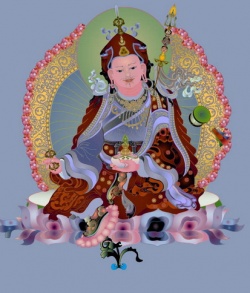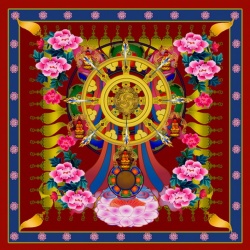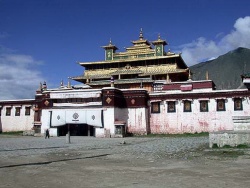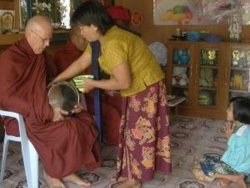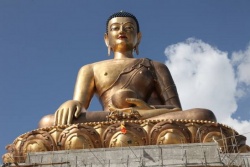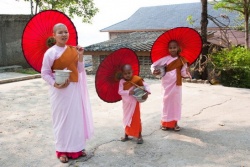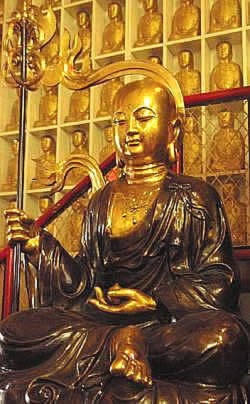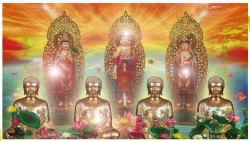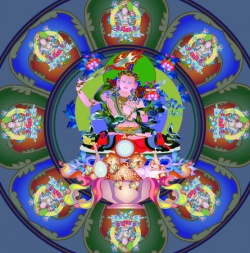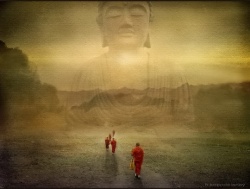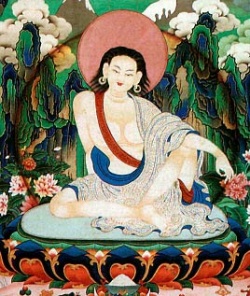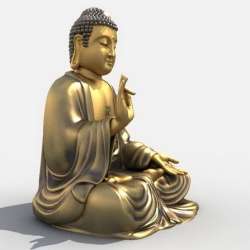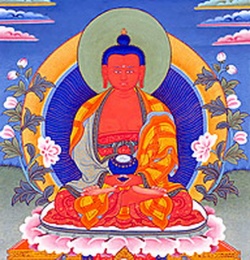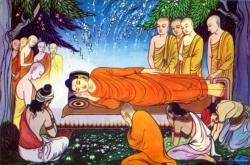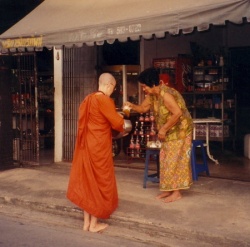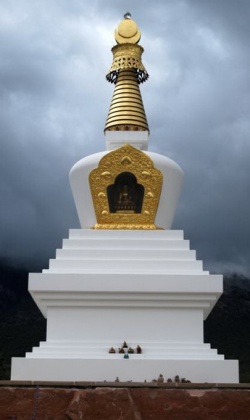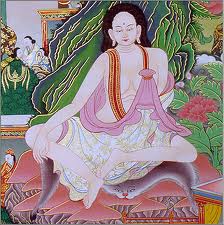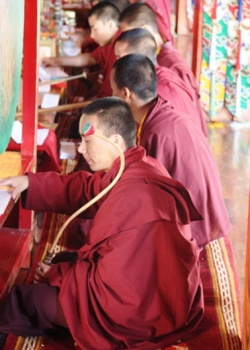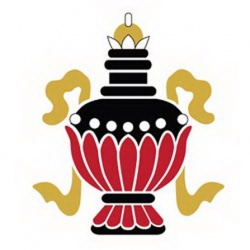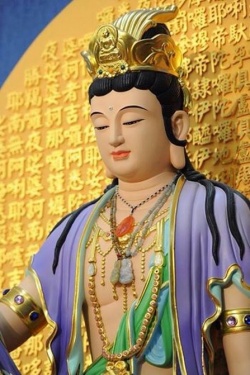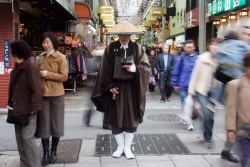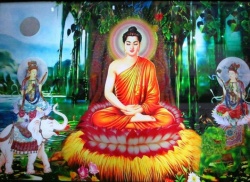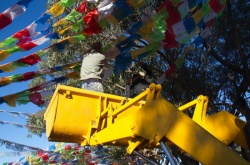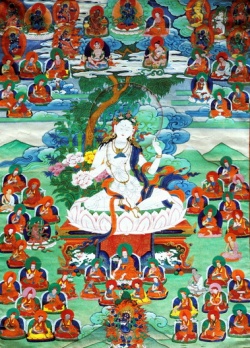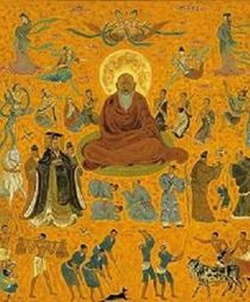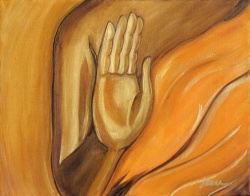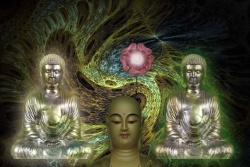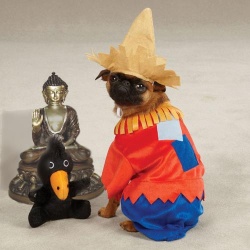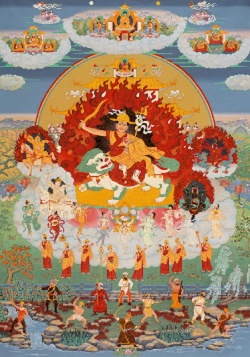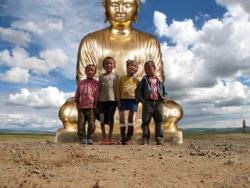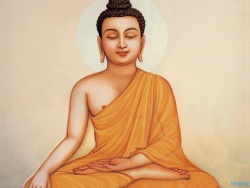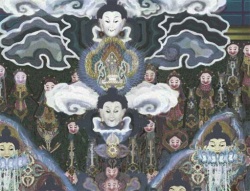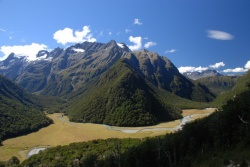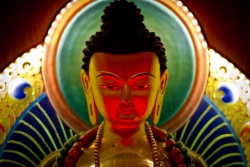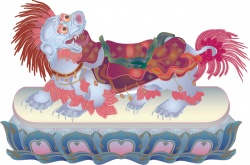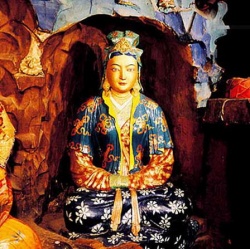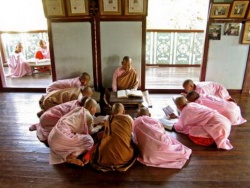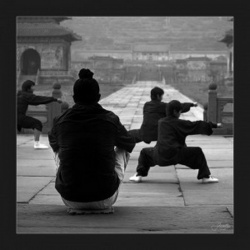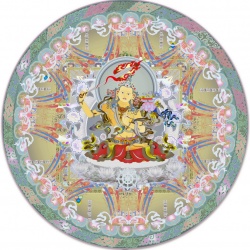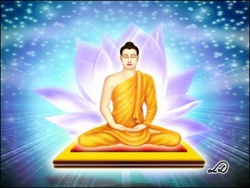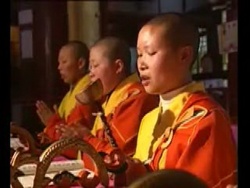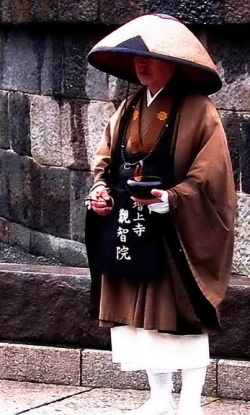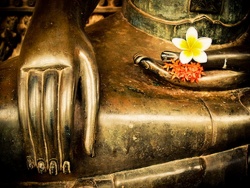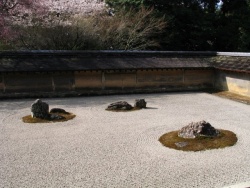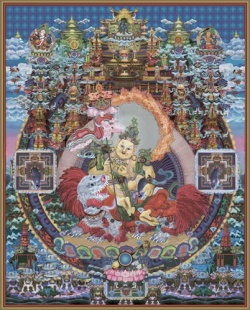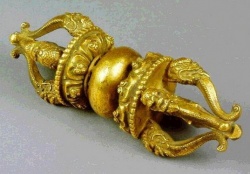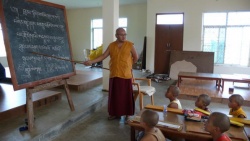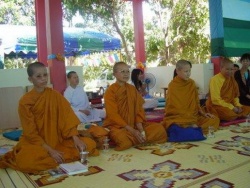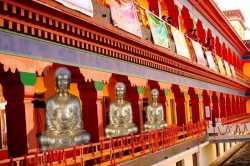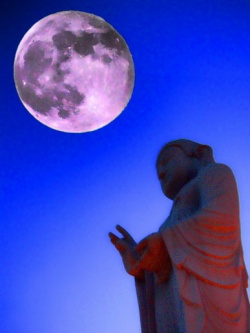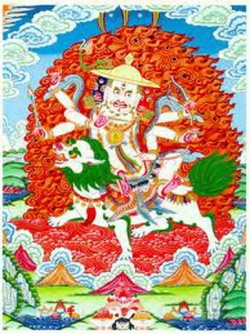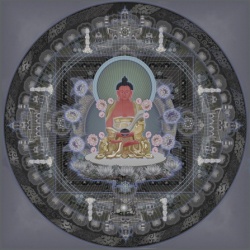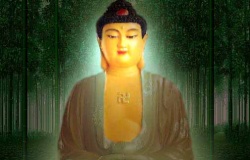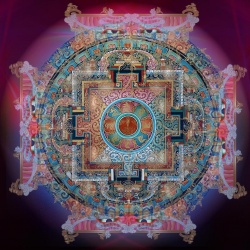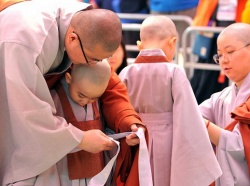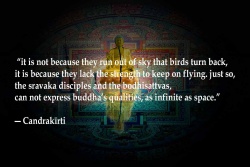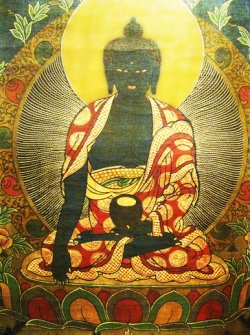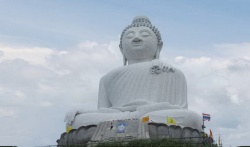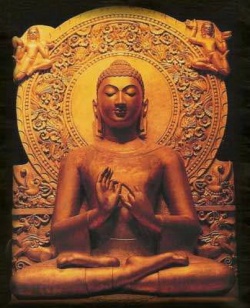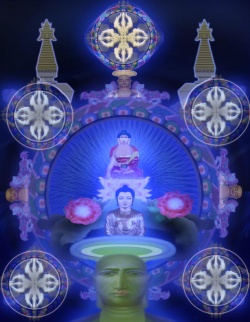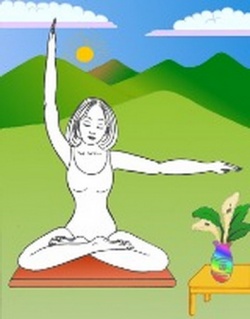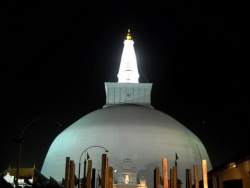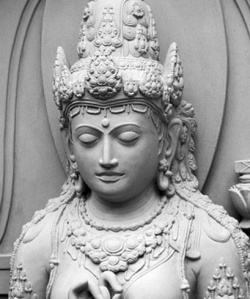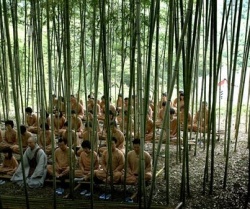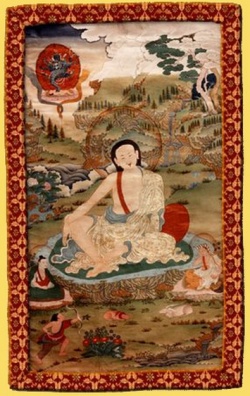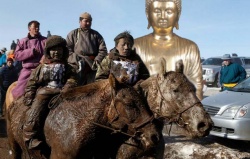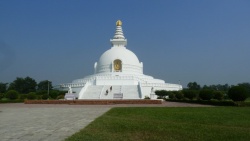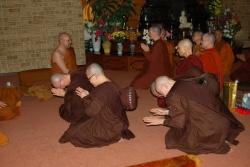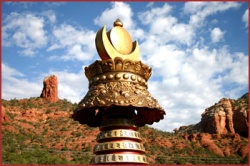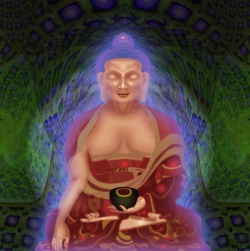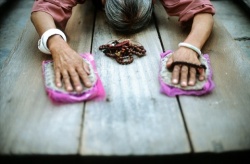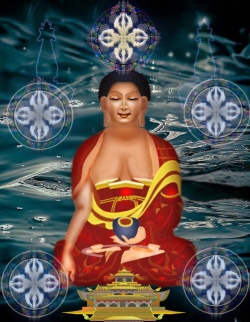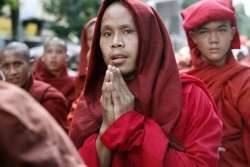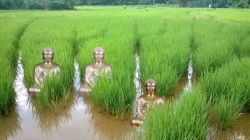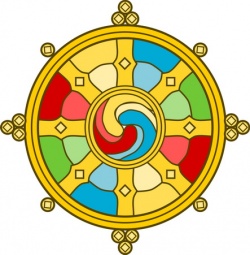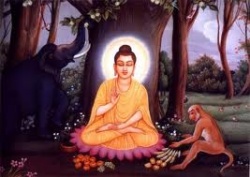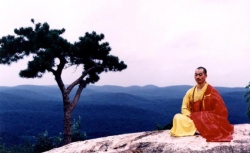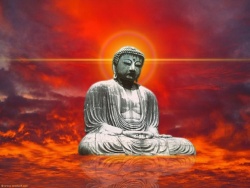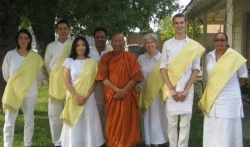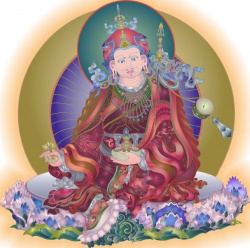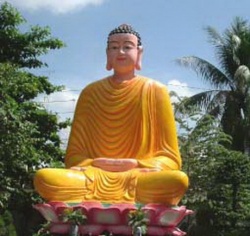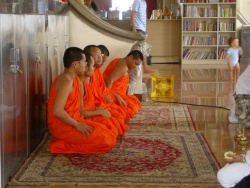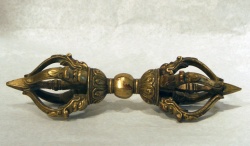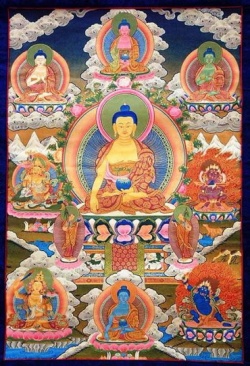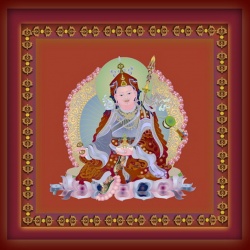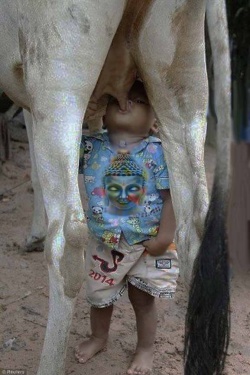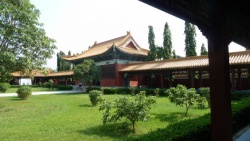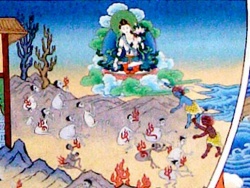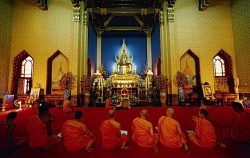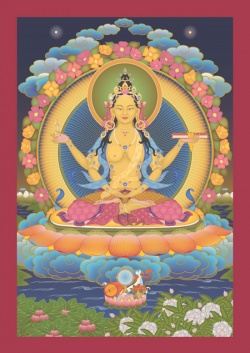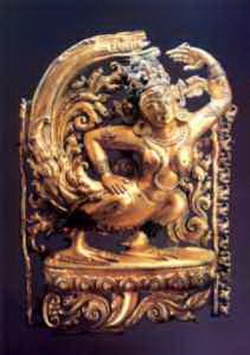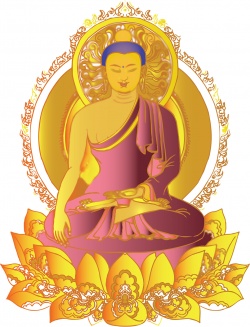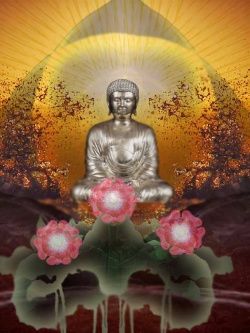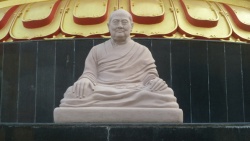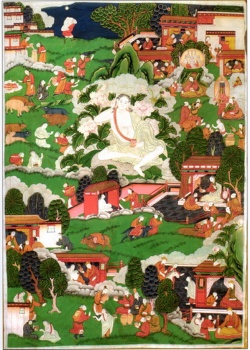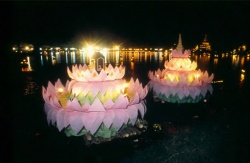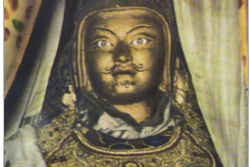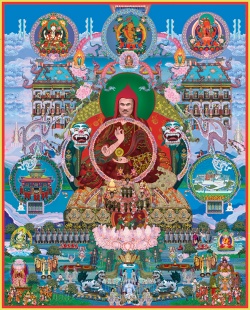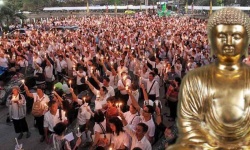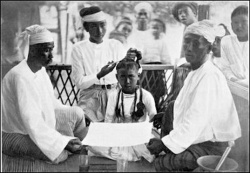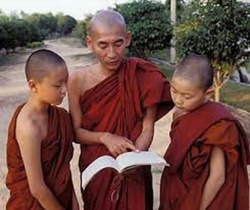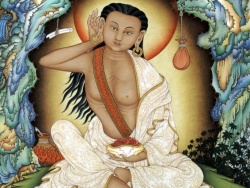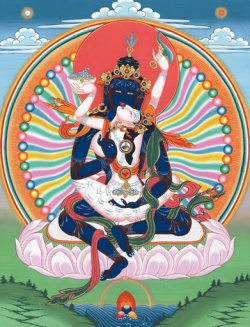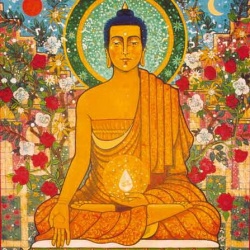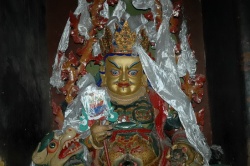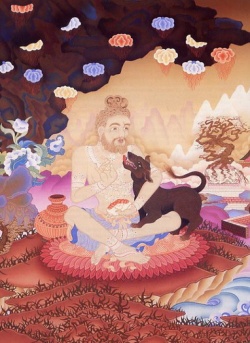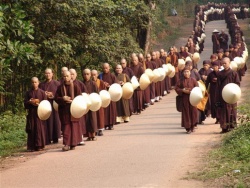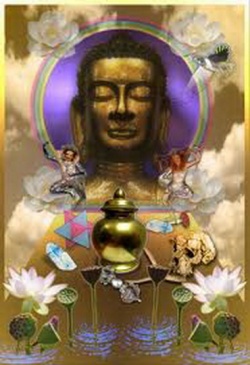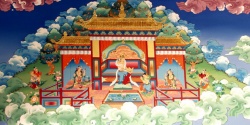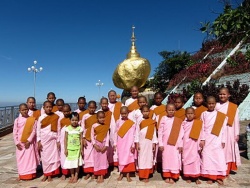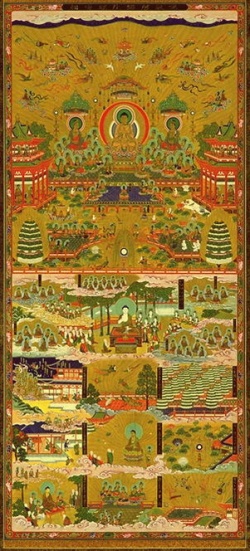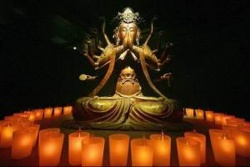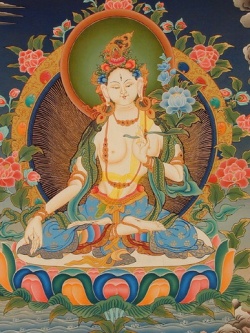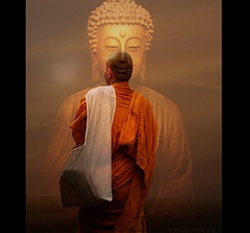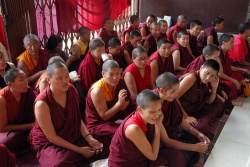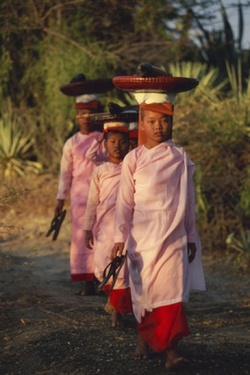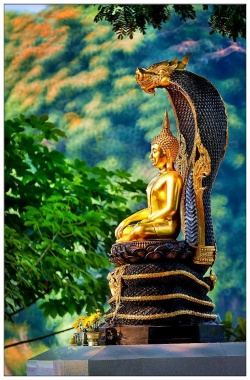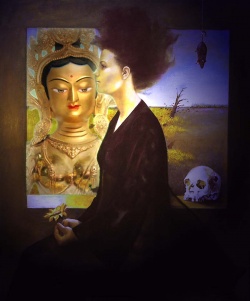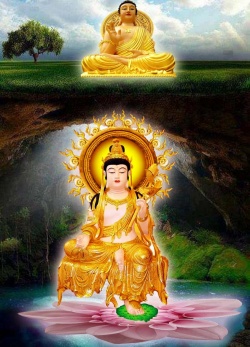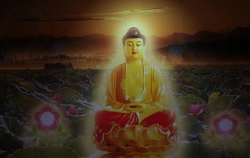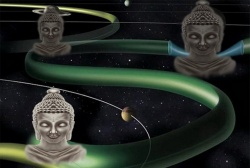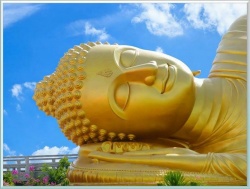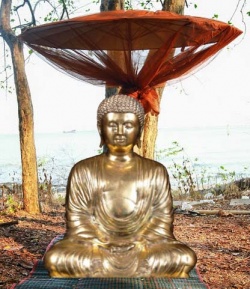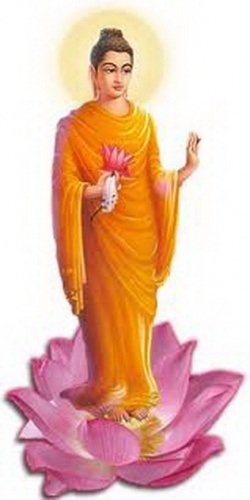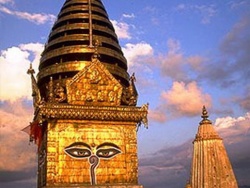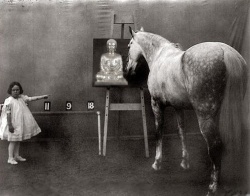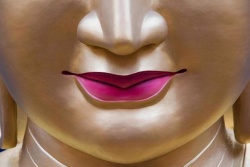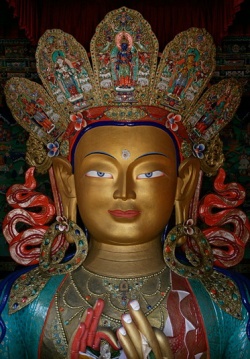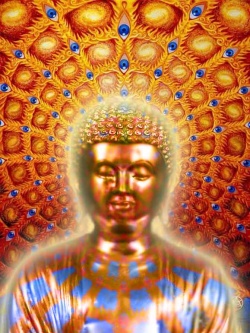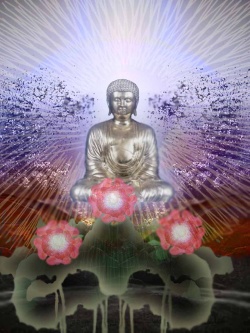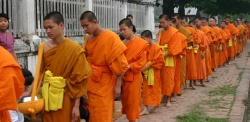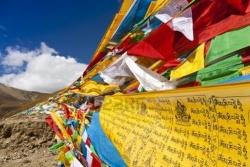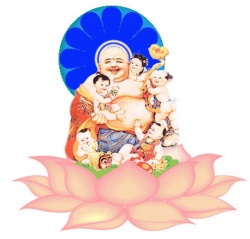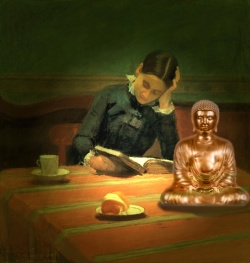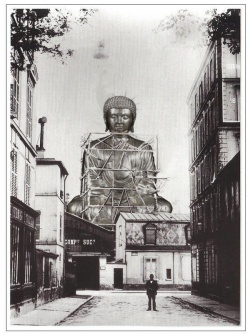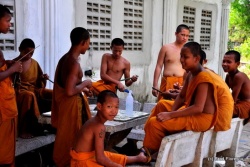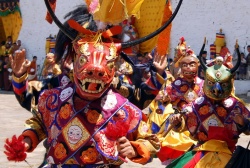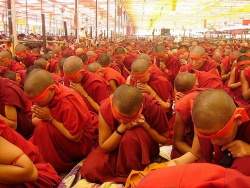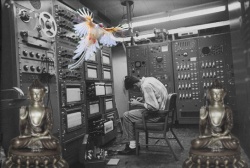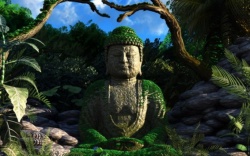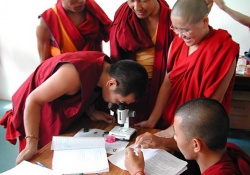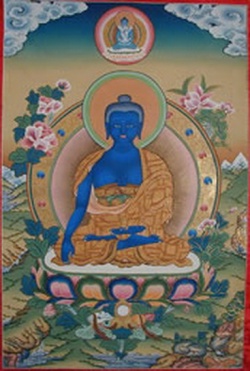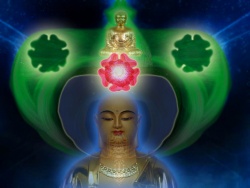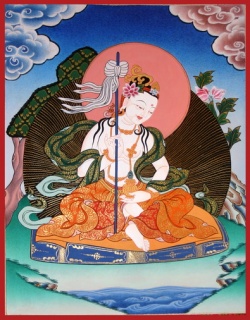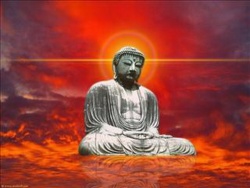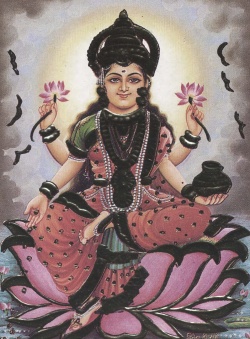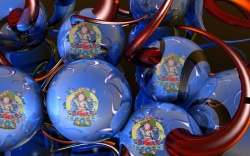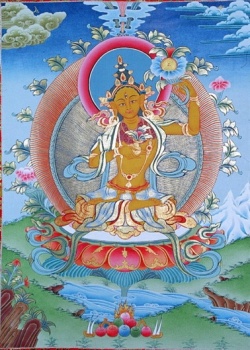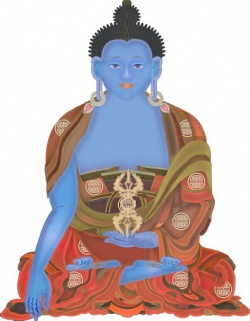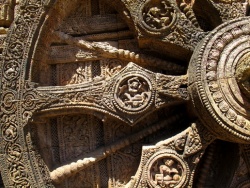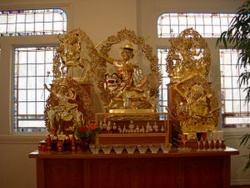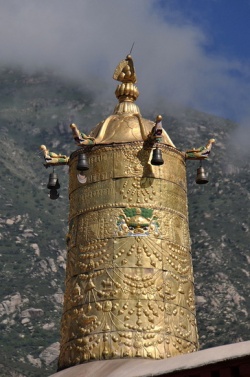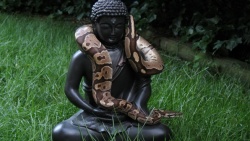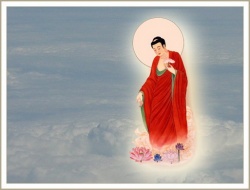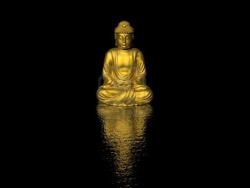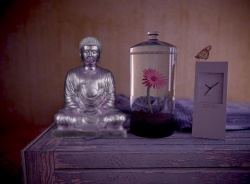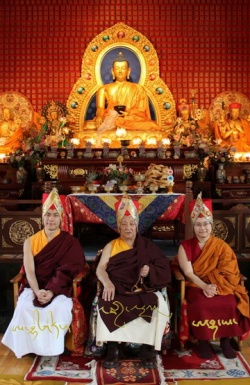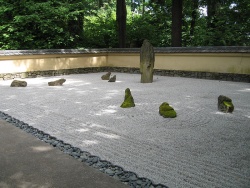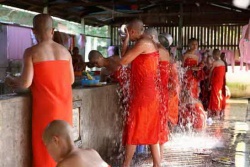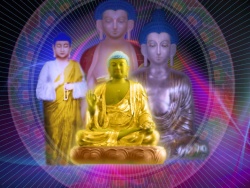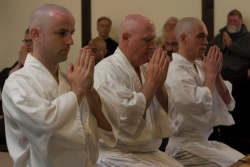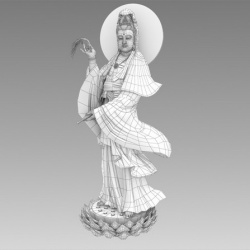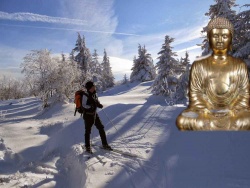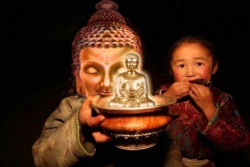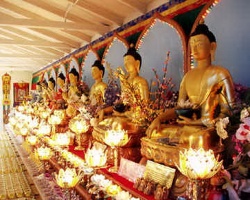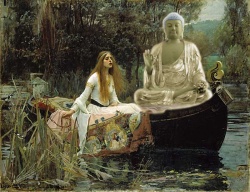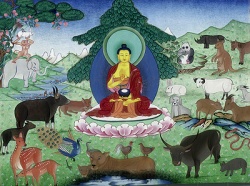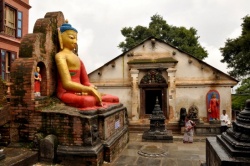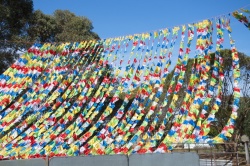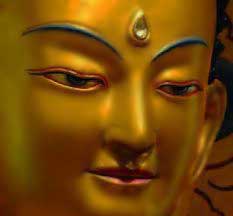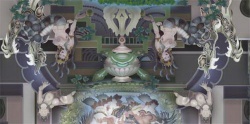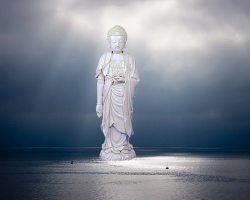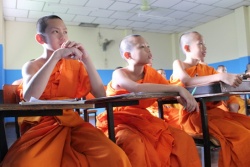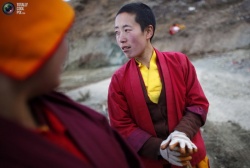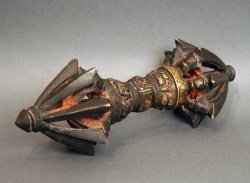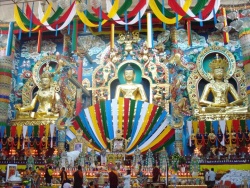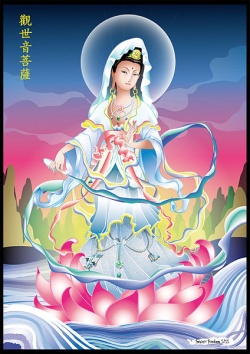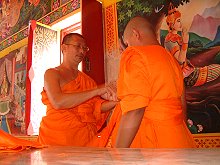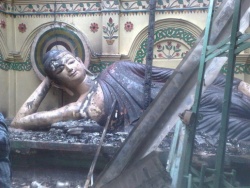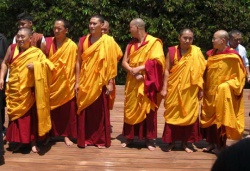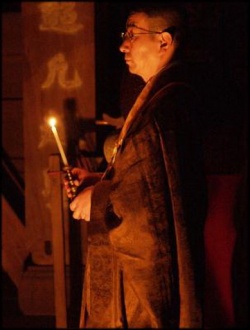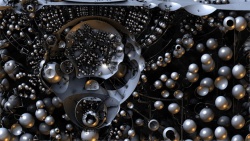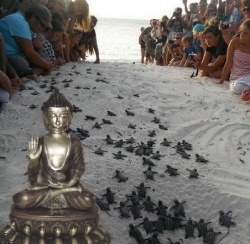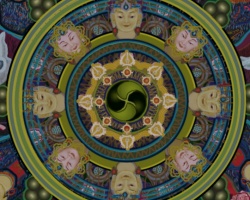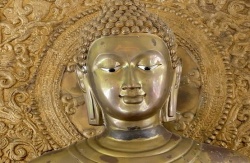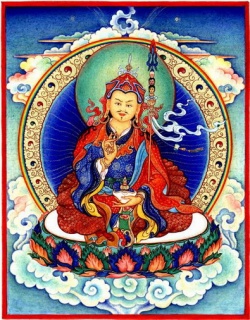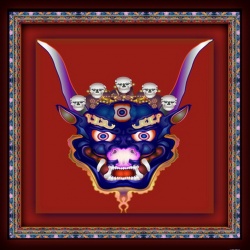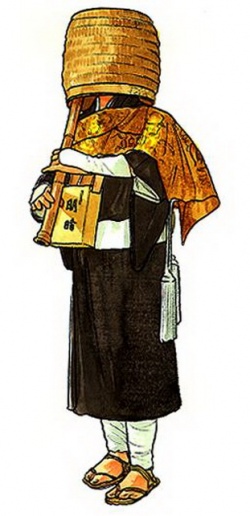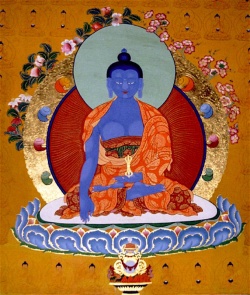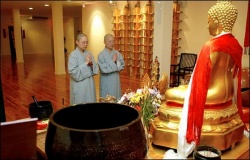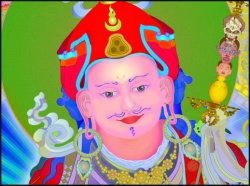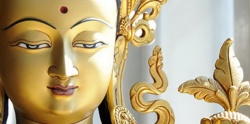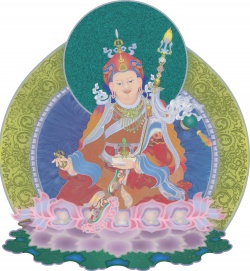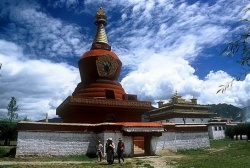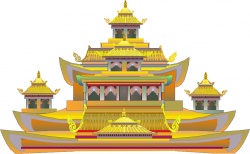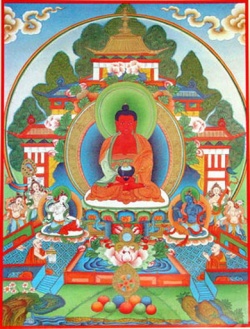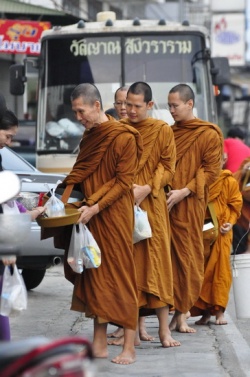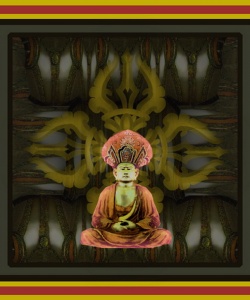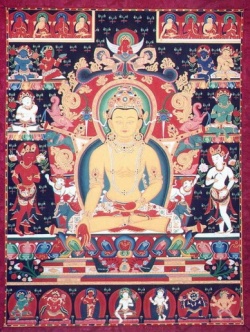Vagbhata's Astangahrdayasamhita
Vagbhata's Astangahrdayasamhita Aṣṭāṅgasaṅgraha (अष्टाङ्गसंग्रह) and the Aṣṭāṅgahṛdayasaṃhitā (अष्टाङ्गहृदयसंहिता)
THE FIRST FIVE CHAPTERS OF ITS TIBETAN VERSION
ABHANDLUNGEN
Ft'R DIE KUNDE DES MORGENLANDES
IM AUFTRAG DER DEUTSCHEN MORGENLANDISCHEN GESELLSCHAFT HERAUSGEGEBEN VON HERBERT FRANKE
XXXVII, 2
VAGBHATA'S
m
ASTANGAHRDAYASAMHITA
• • • o
THE FIRST FIVE CHAPTERS OF ITS TIBETAN VERSION
EDITED AND RENDERED INTO ENGLISH ALONG WITH THE ORIGINAL SANSKRIT
BY
CLAUS VOGEL
ACCOMPANIED BY A LITERARY INTRODUCTION
AND A RUNNING COMMENTARY
ON THE TIBETAN TRANSLATING-TECHNIQUE
DEUTSCHE MORGENLANDISCHE GESELLSCHAFT
KOMMISSIONSVERLAG FRANZ STEINER GMBH WIESBADEN 1965
AUe Eeohte vorbehalten Ohne ausdrttckliche Genehmigung des Verlages ist es nicht geatattet, das Werk oder einzelne Teile daraus nachzudrucken oderauf photomechanischem Wege (Pbotokopie, Mikrokopie usw.) zu verrtelfaltigen. © 1965 by Franz Steiner Verlag GnibH, Wies- baden. Als Habilitationsschrift auf Empfehlung der Philosophischen Eakultat der Philipps-TJniversitSt Marburg gedruckt mit Unterstfltzung der Deutschen Eor- schungsgemeinsobaft. Gesamtherstellung: Wiesbadener Graphische Betiiebe GmbH Printed in Germany
Contents
Preface VII
A. Introduction 1
I. Vagbhata's works in general and the question of their authenticity .. 1
1. Traditional views 1
2. Cordier's view 2
3. Jolly's view 3
4. Hilgenberg-Kirfel's view 4
II. Vagbhata's circumstances of life 7
5. His origin 7
6. His date 8
III. Vagbhata's Astangahrdayasamhita 10
i. Its commentaries and their authors 10
7. Synopsis 10
8. Arunadatta 12
9. Indii 13
10. Candranandana 15
11. Hemadri 16
12. Others 16
ii. Its later history 17
13. Excerpts and summaries 17
14. Manuscripts 17
15. Editions 18
iii. Its Tibetan version 18
16. Eeason why translated and canonized 18
17. The colophon 18
18. The translating team 19
19. Rin-chen-bzan-po 20
20. Xylographs used for this edition 21
a. Chone 21
b.Derge 22
c. Narthang 23
d. Peking 23
21. Their stemmatical relationship 24
22. Principles followed in this edition 33
23. Corruptions 33
24. Sanskrit variants to be inferred 34
VI Contents
25. Interpolations to be detected 35
20. Remarkable interpretations 35
27. Some aspects of the translating-technique 36
a. Circumlocution 36
b. Redundancy of speech 37
c. Fluctuation of terminology 38
d. Ambiguity of nomenclature 39
e. Incongruity of expression 39
f. Replacement of unsuited words 40
g. Verbalization 40
h. Handling of word-order 41
i. Sanskritisms 42
j. Faithfulness 43
B. First chapter 44
C. Second chapter 82
I). Third chapter 121
E. Fourth chapter 171
F. Fifth chapter 198
G. Bibliography, abbreviations, sigla 265
H. Appendix (to Introd. § 4) 281
Preface
After Beineich Latjfee's Beitrage zur Kenntnis der Tibetischen Medizin (Berlin, 1900) had been for decades the only comprehensive if preliminary work on the topic, the study of Lamaist healing-art has received of late a new and unexpected impulse from three publications, each of which is meritorious in its own individual way : Cyrill von Korvin-Keasinski's strictly scientific Tibetische Medizinphilosophie (Zurich, 1953), Theodoe Btjeang's mainly popular Tibetische Heilkunde (Zurich, 1957), and Ilza Veith's richly illustrated Medizin in Tibet (Leverkusen, 1960). What is still a desideratum— though it should properly be the starting-point of any such research— is a complete edition and translation of the rOyud bzi, the standard book of Tibetan medicine, which is supposed to have been adapted from a now lost Sanskrit original by the Kashmirian physician Candranandana about the middle of the 8th century A.D., and which is said to have been written by none other than Kumarajivaka, the famed contemporary of Buddha Sakyamuni 1 . The indispensable condition, however, of a correct understanding of the rGyud bzi is an intimate knowledge of Tibetan medical terminology, which in its turn can be acquired only by closely comparing an extant medical Sanskrit text of some length with its Tibetan counterpart. No work seems better suited for this pur- pose than Vagbhata's Astmgahrdayasamhita, the only representative description of Indian medicine incorporated into the Lamaist canon.
The plan to bring out a critical edition of the Tibetan Astmgahr-dayasamhita, a specimen of which— along with the original Sanskrit, a literal translation, and a running commentary on the translating- technique— is now placed before the learned public, was conceived in the winter of 1958—59, during a prolonged stay at the International Academy of Indian Culture in New Delhi, where the present writer made a complete transcript of the text from the Peking xylograph: a tedious job that was, however, well paid in the end since the Japanese photomechanical reprint, like the Narthang xylograph, turned out to be difficult to read in many places. It is intended to publish all 120 chapters in Sanskrit, Tibetan, and English and to prepare a trilingual glossary of the medical terminology that may serve, as it were, for a master-key to the locked treasures of Lamaist healing-art.
1 This is not to answer beforehand the question of its true provenance and authorship, on which now see Unkeio in Kobvtn-Kkasikski's Medizinphibsophie ■p.xvni sq.
VIII Preface
In concluding, the author wishes to express his sense of obligation to Prof. Dr. Wilhelm Rac for the indefatigable support given at all stages of this work; to Dr. Wolfgang Voigt of the State Library, Marburg, and the staff of the India Office Library, London, for the prompt services rendered in the procurement of urgently needed books; and, last but not least, to Mr. William Fielding Hatton for a styUstic check-up on the Introduction.
Marburg, June 25, 1963 Clatts Vogel
Introduction
1. In the medical literature of the Hindus, three voluminous works generally go by the name of Vagbhata 1 ; they are the Astangahrdaya-samhita [[[Ah]].] or "Collection of the Essence of the Octopartite (Science)," the Astahgasamgraha [As.] or "Compendium of the Octopartite (Sci- ence)," and the Rasaratnasamuccaya or "Jewel Accumulation of Metallic Preparations 2 ." While the genuineness of the Ah. and As. has never been seriously questioned, the Rasaratnasamuccaya is in some manuscripts attributed to one Nityanatha or Asviniktimara and at any rate disagrees so much in content and style from those two works that Vagbhata* s authorship appears rather dubious 3 .
In return for this, the Ah. and As. pose another problem, namely, whether they originate with one and the same author or with two differ- ent authors who are namesakes. For though the colophons of both works give Vagbhata, the son of Simhagupta, as the author, Indian commentators often refer to the former simply as Vagbhata, but to the latter as Vrddha-Vagbhata 4 , a term that is usually interpreted as "elder
1 Other forms are Babhata (Bengal) and Vahata (South India). The Tibetans have reproduced the name with Pha-gol or Pha-khol, which comes nearest to the Bengali spelling. For details, see notes on Opening Statement.
2 Vagbhata is further credited with an autocommentary on his Ah., which is extant only in Tibetan (cf. Hum, SPAW 1895 p. 270), as well as with the following works: Bahatanighantu, Bhavaprakaia, Padarthacandrika, Sastradarpana, Satasloki, Vagbhatiya, and Vamanakalpa (cf. Coedier, Vagbhata pp. 7 & 16). It is virtually certain, however, that the bulk of these works originate from different authors, the name Vagbhata being fairly common after all (of. Godb, Studies
Ip.l71*g.)-
3 Cf. COBDIEE, Vagbhata p. 7 sqq.; Jolly, Medicin p. 4. The authenticity has
recently been defended by Bhattachaeyya (ABOEI xxviii p. 121 sq.), whose argumentation centres around the fact that Candrata in his Yogaratnasamuceaya (gadasantivarga, fol. 4b) ascribes a passage from the Rasaratnasamuccaya (xxi 145—149) to one Rasa-Vagbhata. But how "the inclusion of the Rasa-Vagbhata along with Vagbhata . . . and Vrddha vahada . . . among the sources of Candrata is a most important discovery on the problem of the identity of the different Vagbhatas" in the way Bhattachaeyya has it remains a complete mystery. Any disinterested person would take it for evidence to the contrary, namely, that the three of them are only namesakes and have actually nothing to do with one another.
4 It should be observed, however, as Bhattachaeyya (ABORI xxviii p. 116 sqq.) rightly points out, that this policy was adopted only by later scholiasts, say from Hemadri onwards, and that Arunadatta, Indu, and Candranandana leave
1 Vogel, Vagbhata
2 Introduction
Vagbhata." This distinction between a junior and senior writer of the same name is at first sight corroborated by a passage from the Ah. (VI 40.79) which expressly states:
artawjavaidyakainaltodadkimantkanena
yet 'sUdigasamgrahamahamrtarasir aptah j
'tasntftd analpaphalam alpasamudyamanarri
prtfyartlutm dad uditam prthag em tantram //
The big nectar heap of the Astangasamgraha, which (was) obtained
by churning the big ocean of the octopartite medicine— from this
the present work (was) produced separately, for the joy of those who
show (but) little zeal, (being) of no little use.
2. Once the precedence of the As. seemed established, further osten- sible evidence was adduced in its favour. Cokdieb. 1 , who was the first to tackle the problem methodically, relied on the following five arguments . ( 1 ) The title Astangasamgraha is identical with the one quoted by ancient Arab sources 2 as Kitab Asankar or Astankar. (2) The As. is the only work in which the traditional division of medicine into eight parts is fully implemented. (3) The mixture in the As. of prose and verse reminds one of Caraka and Susruta, while the Ah. consists only of verses. (4) Four stanzas of the As. that do not occur in the Ah. have been included in
no doubt about the fact that they consider the authors of both works identical. A few examples will suffice to prove this.
Arunadatta, in commenting on the cursory treatment which honey is given in Ah. I 5. 51 sqq., remarks: tatha, hy ayam eva tantrakarah samgrahe madhuno bheddn akhyat "thus, for instance, the present writer in his Compendium specified various sorts of honey."
Indu, in pondering over the different effect on digestion which radish is accorded in As. I 17 ~ I p. 128b 3/4 and Ah. I 6. 102, professes: vrddhamulakasya tridosa- kartuh katukasya kaphakartrtve yad deary a-Vahatena maihuravipakitvam, kdra/ijam uktam tat svayani hrdayapathitasyaiva vrddhamulakasya katuvipdkitvam smrtam kim vanyai Jdmcid iti na jane "while (in the present case) of full-grown radish, (which is) productive of (all) three humours (and) pungent because of its productive- ness of phlegm, sweetness of digestion (has been) named as (its) action by Master Vahata, (in the analogous case) of full-grown radish mentioned in his Essence pungency of digestion (has been) recorded by him (as such); if (there is) anything else (to it) I (do) not know [ ?]."
Candranandana, in comparing the Ah. with the As., often employs phrases like tatha. ca samgrahe proktam dcdryeqa "and so (has been) taught by the Master in his Compendium" (Ah. I 5. 13) or ity uktam, samgrahe tantmkartrd "thus (has been) said by the Author in his Compendium" (Ah. I 20. 39).
1 Donnees p. ? As this pamphlet is not available to us, we must depend for what follows on Jolly's abstract (ZDMG liv p. 262).
2 Mainly the Fihrist (Flttgel, ZDMG xi p. 148 sqq.), Mas'udfs Golden Meadows, and Ibn Abi UseibiVs Fountains of Information (Dietz, Analecta I p. 117 sqq. ; Cceeton, JRAS vi p. 105 sqq.; Muller, ZDMG xxxiv p. 465 sqq.).
Introduction 3
the Madhavanidana, in the same way that Vrnda and Cakradatta have only used the As., not the Ah. (5) The As., despite its greater volume, makes no mention of quicksilver, while the Ah. does.
3. Discussing these arguments, Jolly 1 called them plausible but not decisive and raised the following objections: (1) The dubious Arabic term Astankar may apply to the As. as well as to the Ah. 2 . (2) The eight- fold division is observed in the Ah. too, though not as strictly as in the As. According to Arunadatta (on Ah. VI 1 init.), the first part is treated in the first five sections, whereas the other five parts are dealt with in the sixth section. And by the same scholiast (on Ah. VI 38 & 39 fin.), the chapters on poisons and elixirs are both called "treatises" (ta?itra), a term synonymous with "part" {anga). (3) It is true that a mixture of prose and verse is characteristic of the old sutra style ; but the possibility of a later imitation must be reckoned with, and the earliest datable documents of Indian medicine as preserved in the Bower Manuscript are versified almost throughout. (4) In view of the large number of mnemonic verses that are common to nearly all medical books, no undue emphasis should be placed on some special points of agreement. That both the As. and the Ah. contain rather old material appears from the many prescriptions they share, for instance, with the Bower Manuscript. (5) Quicksilver must have been introduced into Indian pharmacopoeia much earlier than is commonly conceded, because it occurs already in Susruta 3 .
Notwithstanding his criticism of Corbieb's views and his additional counter-argument that the Ah. had been circulated in countless manuscripts, expounded in numerous commentaries, and held in high esteem, while the As. remained, as it were, an unnoticed wall-flower, Jolly stuck to the priority claim of the As., and that mainly for three reasons 4 : (1) the above-quoted statement from the Ah., (2) the archaic mixture of prose and verse in the As., and (3) the Buddhistic tendencies in the
1 ZDMG liv p. 262 sq.
2 Jolly seems to have overlooked that the texts in question actually read kitab asdnkar [w. 11. asatar, astankar, asdtkar] al-jami' "the summarizing book Asankar," which indeed agrees with Astangasamgraha rather than with Astan- gahrdayasamhita (unless one considers the final r in asankar a relic of hrdaya). But even so, the argument is by no means conclusive, because it only proves that the As. is fairly old, a point that goes undisputed.
The JPihrist describes this work as a translation into Arabic by Ibn Duhn, who appears to have been director of the hospital of the Barmecides (jl. 752—803 A. D.). Cf. Fltjgbl, ZDMG xi pp. 149 & 151.
3 IV 25.39, V 3.14, VI 35.7. Jolly still considered the mention of, or silence on, quicksilver not unimportant for determining the chronology of the Ah. and As. We now know, however, that reference is made to quicksilver in at least two stanzas of the As. (VI 30 ~ III p. 226 a 1 ; VI 49 ~ III p. 446 a 2) which word for word agree with their counterparts in the Ah. (VI 25.61, VI 39.162).
4 Medicin p. 8.
4 Introduction
As., which, though still existent, were largely obscured in the Ah. He was followed without reserve by Hoernle 1 , who introduced the names Vagbhata I and Yagbhata II for the authors of the As. and the Ah. respectively, by Keith 2 and Wintermtz 3 , who included Jolly's reason- ing in their histories of Indian literature, and by Gode*, who recorded the progress of Vagbhata research until 1938. All these scholars contrib- uted substantially to impressing the antecedence idea on a wider public 5 . The issue seemed definitely settled.
i. However, in a learned introduction to their pioneering translation of the Ah. 4 , Hilgesbebg and Ktjrfel undertook to closely re-examine the entire problem and arrived at an altogether different conclusion. Because of the prime importance of these findings, their train of thought may here be reproduced at some length.
Starting with those four lines in the epilogue which supposedly prove the Ah. to be a condensed version of the As., it should be observed that they are quite incompatible with a statement in the prologue (1 1.4 sq.), which says:
tebhyo 'tiviprakirnebhyah prayali sarataroccayah //
kriyate ' stangahrdayairi natisaniksepavistaram j
(These) [i.e. the works of Agnivesa etc.] being too widely scattered,
there is (now) made from them, as a collection for the most part of
very essential (matter), the Astaiigahrdaya, without too much brevity
or prolixity.
If the Ah. were regarded as a sort of story within a story, then its head and tail pieces would not fit together. Another inconsistency lies in tbe fact that in the epilogue (VI 40.59 sqq.) Atreya's disciples Agnivesa etc. are assumed to have been present at the first recital of the Ah., whereas in the prologue nothing like that is intimated. Furthermore, the whole debate among Agnivesa and his fellow-pupils on the merits of distinguishing between wholesome and unwholesome, which actually only serves the purpose of motivating and praising the new book, would be much more in keeping with the supposed original (the As.), where it is missing though, than with its alleged epitome (the Ah.). Add to this further discrepancies : in v. 62 the name Punarvasu is abruptly substituted for Atreya without having been introduced so far, neither in the text nor in Arunadatta's commentary 7 ; and in v. 59 the sage Bheda is thought to be attendant, while in v. 87 the question is raised why his work is neglected. Such absurdities are apt to throw discredit upon the
1 Osteology p. 6 sq. 2 History p. 510. 3 Gescbichte III p. 549.
4 Studies I p. 171 sqq.
5 E.g., Mukhopabhyava, History III p. 790 sqq.; Kashtkae, ABORI xxxvii p. 338 sq. 6 p. xvii sqq.
7 It. may rightly be argued, however, that the identity of Itreya and Punarvasu, which is confirmed by Arunadatta (on Ah. VI 40.59), was so familiar to the Indians as not to require special mention.
Introduction 5
whole epilogue, and the suspicion suggests itself that we have before us an interpolation. Since the stanzas in question have been translated into Tibetan, however, they must have been added at a comparatively early stage.
Next there is the mixture of prose and verse, the dubious value of which for proving the As. prior to the Ah. Jolly himself had already conceded. When he nevertheless adhered to this argument, he did so because internal evidence seemed to speak in its favour. But the reasons he advanced do not stand a critical investigation. By comparing line for line the Cikitsasthanas and Kalpasthanas of both works with each other and then with the relevant passages of the Carakasamhita, [CaS.]
1 , Hilgenbbeg and Kikfel reached the following conclusions:
(1) In the metrical parts, the extra verses of the As. may be isolated almost every- where without any difficulty or violence to the wording; what is left behind is the text of the Ah. Hence the As. and the Ah. are in the ratio of two different recensions of the same text, one of which appears enlarged or abridged as against the other. (2) Both works show a considerable identity or resemblance of wording with the much earlier CaS., which applies to their common stock as well as to the additional verses of the As., but not to the prose portions. No matter whether Vagbhata drew on Caraka or whether both authors relied on the same source, it is not the presumedly older prose but the supposedly younger verses that form the loan-texts
2 . Now if verses that are found in one text (the Ah.) inde- pendently occur in another (the CaS.) in a similar connection, while yet a third (the As.) gives prose instead, then the verses cannot be a transposition from the prose, but the prose must be an adaptation from the verses ; and it is indeed possible in the prose portions of the As. to trace not only signs of the original metrical version such as unusual word-order and rhythm, but also vestiges of the gradual transition from verse to prose as preserved in the variants 3 . Thus Jolly's second argu- ment is not tenable either.
1 See Appendix.
2 The same situation could be demonstrated by means of the Garudapuranaj which almost literally contains the Nida.nastha.na of the Ah. (see KntFEL, Festgabe Garbe p. 102 sqq.), provided it can be definitely shown that both texts are not interdependent.
3 That the prosification of the Ah. was not the work of a single man but extended over a longer space of time also appears from the fact that Arunadatta (on Ah. 1 12.52 sqq.) cites 24 slokas from the As. which in the present text correspond only to prose (I 20 ~ I p. 149b 10 sqq.; ef. Cobdiee, JA ix 18 p. 152). It is interesting in this connection to learn of the existence of a Madhya- or "middle" Vagbhata and his Madhyasamhita. or "middle collection" (already see Coediee, Museon N.8. iv p. 334) which, though lost as such, is known from many quotations in NMcalaka- ra's Ratnaprabha, and Sivadattasena's Tattvabodha and, judging by these, repre- sents an intermediate stage in the course of prosification. A number of passages given by Niscalakara have been analysed by Bhattachaeyya, ABORI xxviii p. 113 sqq.
(J Introduction
Finally, as concerns the Buddhistic tendencies prevalent in the As., JorxY referred in the main to a prayer addressed to Buddha, which he thought was missing in the Ah., and which runs as follows (I 27 ~ I p. 2(?3a,5 aqq.):
o)ii namo hhagavate bhaisajyagurave vaiduryaprabharajaya tathagatayar-
hate mmyaksanibuddhaya /
Om! Reverence to the Victorious One, the Medicine Master, the
Cat's-eye-splendoured King, the Thus-gone One, the Saint, the Fully Enlightened One! It was already Cordier 1 who set him right by tracing this prayer in the Ah. too (I 18*18). On the other hand, it is possible in the As. to find, besides Mahayanie traits, typical Hinduistic features, such as relating the story of Virabhadra's creation with fever (III 1 init.), suggesting the presentation of a Vedic offering against phthisis (IV 7 fin.), and praising the Asvins by adducing all the Vedic and Brahmanic myths connected with them (VI 50 med.). So there can be no talk of a specifically Buddhistic character of the As.
After the theory of a senior and junior Vagbhata has been deprived of its basis, the question remains to be answered how else the term Vrddha-Vagbhata can be understood. Here, Hilgenberg and Kireel say, analogous cases will help us on. In his Catalogus Catalogorum
2 , Aufrecht lists, inter alia, a Vrddharyabhata besides an Aryabhata, the Vrddhayavanajataka of a Vrddhayavanacarya besides the Yavanajataka of a Yavanacarya, a Vi'ddhagargyasamhita, besides a Gargyasamhita, and a Viddhayogasataka besides a Yogasataka . Turning to indigenous authors , Bhavamisra records among his sources not only a Vagbhata and Vrddha-vugbhata, but also a Susruta and Vrddhasusruta
3 , and Todaramalla mentions, apart from these, an Atreya and Vrddhatreya, a Harita and Vrddhaharfta, and a Vrddhabhoja
4 . It stands to reason that in these instances (the number of which can probably be increased) the attribute vrddha signifies, not a senior writer or an older work as opposed to a junior writer or a younger work, but rather the author of an enlarged recension as against that of a shorter original or such books themselves. That this is the only interpretation possible for the aphorisms going by the name of Vrddha-Canakya has been irrefutably demonstrated by Kbessler 5 .
Other evidence points in the same direction. To give only one example, the Ah. (II l.S sq.) says that, healthy conditions granted, a woman who has completed her 16th and a man who has completed his 20th year will produce a sturdy child, while younger parents will beget a sick, short- lived, hapless creature at the most. This statement, which is in perfect
1 JA is 18 p. 168. 2 s. w.
3 Cf. Aufrecht, Cat. Bodl. viiip. 311b.
- Cf. Webee, Verzeiohniss I p. 289 sq. 5 Stimmen p. 38.
Introduction 7
harmony with Indian, circumstances, has been amplified in the As. (II 1 init.) to the effect that a 21-year-old man shall marry an approximately 12-year-old girl, but will father with her a sturdy child only when he is 25 and she 16. The As. here makes a positive concession to the Hindu point of view that marital cohabitation should take place immediately after the first menses (which start at the age of 12 ; cf. Ah. II 1.7) at the risk of otherwise committing a serious offence 1 . If the Ah. really were an abstract of the As., then it would be quite inconceivable why the epit- omizer should have swerved from common opinion in so vital a matter. Even though the As. has lost all of its originality and much of its importance by what has been said hitherto, it cannot be entirely dis- missed as second-hand. On the contrary, the scholiastic exhaustiveness and pedantic consequence with which every subject is treated make it a valuable supplement to the much condensed and often enigmatic Ah.
5. About Vagbhata' s life 2 nothing else is known than what he himself has handed down in a short autobiographic note (As. VI 50 fin.) :
bhi§agvaro Vagbhata ity abhun me pitamaho namadharo °smi yasya / suto 'bhavat tasya ca Simhaguptas tasyapy aham Sindhusu labdhajanma // samadhigamya guror Avalokitat gurutarac ca pituh pratibham maya / subahubhesajasastravilocanat suvihito 'ngavibhagavinirnayah //
My paternal grandfather, whose namesake I am, was the eminent physician Vagbhata; his son was Simhagupta, and his (son) again (am) I. Among the people of Sind I was born.
Having obtained my knowledge from the venerable Avalokita and my (even) more venerable father, whose eye (represents) medical science in a very high degree 3 , (there was) well made by me (this)
1 Cf. Jolly, Becht p. 55 sqq.
2 Tradition now takes him for Dhanvantari, the physician of the gods and founder of Ayurveda, identifying him with one of the fourteen gems obtained at the churn- ing of the ocean; then for the great sage of the present Kaliyuga as opposed to Atri (Caraka) and Susruta, who are related to the past Krta- and Dvaparayugas respectively (Har. VI 2 fin.); then for an incarnation of Buddha; and then again for a voluptuous brahmin given to all sorts of revelries and lost in love with a low- caste woman. There is also a story current among the learned pundits of South India that Vagbhata, formerly a brahmin, was persuaded by a Buddhist priest to adopt his religion, which he embraced in the latter part of his life. Cf. Gode, Studies I pp. 174 & 178.
3 Indu explains: adesdrthaparijiiaTiahetutvad "on account of its being the cause of the full perception of the entire object." Htlgenberq & Kike-el, who render this line "nach Prufung vieler Medizinbucher" (p. xlvii), seem to read vUokanal instead of vihcanat.
8 Introduction
complete exposition 1 , arranged according to the (eight) parts (of
medicine).
That Vagbhata, as stated in this note, hails from North India 2 also appears from the fact that he reckons seeing a Dravida or Andhra among the bad omens (Ah. 116.49; As. II 12 ~ I p. 367M3), and that he regards the earth as chiefly occupied by the Himalaya and Vindhya mountains, taking herbs which grow on the former for soma-like and wholesome, but such as come from the latter for fire-like and unwhole- some (Ah. V 6.29; As. V 8 fin.).
6. Vagbhata' s date, however, once the two-author theory is discarded, may be fixed with considerable accuracy 3 . For the well-known Chinese pilgrim I-ching, who stayed in India from 672 till about 688 A.D., after enumerating in his book of travels "the eight sections of medical science," proceeds as follows 4 :
1 vinirttaya, by Indu glossed as viniscaya, is given in the dictionaries only as denoting "complete settlement or decision, certainty, a settled rule" (MW p. 970) or the like, which does not make sense here. The above translation rests upon BhP. VI 2.20 where the corresponding vinirifi is used in the meaning of "to explain fully" (Sanyal):
ta emm. suvinir^Xya dharmam bhagavatam nrpa /
tarn yamyapaMn nirmucya vipram mrtyor amumucan jj
These [i.e., Visnu's emissaries], having thus well and fully explained the divine
law [i.e., the Bhagavata creed], O king, (and) having freed him [i.e., Ajamila]
from Yama's fetters, released the brahmin from death.
s In the colophon of Ja(i)jjata's Susrutatlka, Vagbhata is given the appellation Mahajahnupati "'Lord of Mahajahnu." Bhattacharyya (ABORI xxviii p. 122) identifies Mahajahnu with the present Majhanda (spelt Mahajanda by Preedy, SRBG N.S. xvii p. 673, and Manjhand on Bartholomew's map), a small township and subdivision of the Karachi district, situated about 50 miles north of Hyderabad on the west bank of the River Indus. It is not altogether impossible that this was Vagbhata's domicile.
3 Till now it varied between such extremes as the 2nd cent. B.C. (Kttnte, Introd. p. 15) and the late 12th cent. A.D. (Cobdier, Vagbhata p. 3; refuted by Jolly, ZTXMG liv p. 262), though usually scholars placed the "elder" Vagbhata in the early 7th and the "younger" one in the 8th cent. A.D. Cordier founded his chronology on a spurious passage from Kalhana's Rajatarangini, which is missing in Stein's edition and runs as follows: [[Simhaguptasutah paramabauidJw Vagbha- tdcaryah Kdsmlratmrapati-Jayasimhasya prajapalanasamaye varttamana asit "the prominent Buddhist Vaghhatacarya, the son of Simhagupta, lived under the reign of the Kashmirian king Jayasimha [1196—1218 A.D.]." When faced with Jolly's retort, he strove to make good ( JA ix 1 7 p. 1 83 sq. ) by advancing an equally untenable theory based on a rather fantastic narrative in Merutunga's Prabandhacintamani (V20), which assigns Vagbhata to the court of King Bhoja of Dhara, (r. 1018—60). It is well known, however, that this quasi-historical work stops at no anachronism and hence commands little if any authority (Winternitz, Geschichte II p. 332).
- Kan-hai chi-kuei nei-fa-chuan, ch. 27 ~ Taisho Tripitaka, vol. 54, p. 223, col. 3. The transliteration is owed to Prof. Wolf Haenisch, Marburg. The English rendering is that of Takakusu (Record p. 128).
Introduction 9
ssu chih pa shu hsien wei pa pu. chin-jih y% jin liieh wei i chia. wu-tien chih ti hsien hsi ch'iu hsiu. tan ling chieh cM wu pu shih-lu. These eight arts formerly existed in eight books, but lately 1 a man epitomized them and made them into one bundle. All physicians in the five parts of India practise according to this booh, and any physician who is well versed in it never fails to live by the official pay. Though neither name nor title are given, there can be little doubt but that this passage refers to Vagbhata, the author of the Ah., who must consequently have flourished near the middle of the 7th century 2 .
1 Mukhofadhyaya (History III p. 794), while rightly correlating "lately" (chin- jih) with "formerly" (hsien), goes so far as to maintain that by "lately" any period subsequent to "formerly" can be understood. But neither the English nor the Chinese admits of such an interpretation, which would amount to a meaning "later, after- wards" untenable for chin-jih. (By courtesy of Prof. Alfred Hoitmann, Berlin.)
2 Some dissentient views must here be touched upon. Takakusu suggests in his additional notes (p. 222) that "this epitomizer may be Susruta, who calls himself a disciple of Dhanvantari, one of the Nine Gems in the Court of Vikramaditya." It need hardly be mentioned that Susruta's relation with Dhanvantari (Susr. 1 1.12) and Dhanvantari' s relation with Vikramaditya (Pseudo-Kalidasa, Jyotir-vidabharana XXII 10) are of a purely legendary nature and of virtually no chron- ological value (Wintbbnitz, Geschichte III p. 42 sq.), and that Susruta must have lived far earlier (Jolly, Medicin p. 9 sq.). In making his suggestion, Takakusit apparently relied on the fact that I-ching recorded the eight branches of medicine in very much the same way that Susruta did, with only nos 5 & 6 (pediatries and toxicology) given in reverse order (Jolly, ZDMG lvi p. 566 and JRAS 1907 p. 173 sq.). On the other hand, Susruta did not epitomize those eight branches at all. This notwithstanding, Jolly saw unfit to rule him out altogether, on the ground that I-ching might have read Susruta's introduction and "looked upon his work as a recent compilation, because it purports to be an extract in eight parts . . . from an earlier work in 100,000 verses." If such were really the case, however, then I-ching would indeed be guilty, as Hoernle (JRAS 1907 p. 414 sq.) pointed out, not only of lightly brushing aside Indian tradition, which regards Susruta's work as one of great antiquity (and on which I-ching had to rely in his day), but also of grossly misunderstanding Susruta's introduction, which puts matters into quite a different perspective, the relevant passage (Susr. 1 1.6) reading as follows: iha khalv ayurvedam namopangam atharvavedasydnutpddyaiva prajah slokasa- tasahasram adhydyasahasram ea hrtavan Svayambhuh j tato 'Ipayustvam alpame- dhastvam ccUokya naranam bhuyo 'stadha pranttamn //
Now then, the so-called Ayurveda (is) a subsidiary part of the Atharvaveda. Before even creating man, the Self-existent One [i.e., Brahman] composed (it) in a hundred thousand stanzas and athousand chapters. Afterwards, considering man's shortness of life and narrowness of intellect, he recast (it) into eight divisions. Bhattacharyya's opinion (ABORI xxviii p. 127) that I-ching referred to an- other medical compendium existent at his time (such as Ravigupta's Siddhasara or Acyuta's Ayurvedasara), apart from being purely hypothetical and rather far- fetched, is equally unsatisfactory; for a book that once was so popular as to have been read all over India is not very likely afterwards to have fallen into complete oblivion. Besides, Vagbhata does not mention any such work among his sources, an omission that would be hard to explain in the case of so renowned a predecessor.
10 Introduction
I>lung's account fully agrees with the fact that the Persian, physician. C A1I ibn Sahl Rabban at-Tabari, wl]LO included "a survey of the Indian system of medicine" in his Firdaus al-Hikma or "Paradise of Wisdom" (dated 849/50 A.D.), names Garak, Susrud, the Astanqahradi, and the Nidan as his sources 1 . If the Ah. was so famous in Persia by that time as to be put on a par with Caraka and Susruta, it must have been written during the 7th century at the latest 2 .
T. As is also manifest from these testimonies, Vagbhata enjoyed early and widespread recognition both inside and outside India. Hence it is no wonder that numerous commentaries on the Ah. (as against only three on the As. a ), many of them unedited so far, can be traced in manu- sript. catalogues, publishers' lists, etc. The following have come to our notice (those fully or partly printed are marked by an asterisk) 4 :
1 VII 4.1 (p. 557 Siddiqi; p. 1110 Siggel). Cf. Meyebhof, ZDMG Ixxxv p. 63 sq. and Isis xvi p. 12; Mcllee, JRAS 1932 p. 791 sqq.
- Disregarding this impregnable testimony, which could have easily saved him from a serious misconception, Bhattachabyya (ABOM xxviii p. 122 sqq.) assigns our author to the 9th century and identifies him with Vagbhata, the father of TTsata (who wrote the CiMtsakalika). After some chronological speculations on the iconolatry of Pamasavari (As. IV 2 fin.) and the twelve-armed Avalokitesvara (Ah. VI 5.50 ~ As. VI 8 fin.), he refers for the terminus a quo to a Vagbhata quotation in Niscalakara's Ratnaprabha, the first line of which is lost (A fol. 1 1 7 a) :
- //
[bojdhicaryavatdroktam hatnaiokadininditam j
aturam sravayed dhiman bodhayec ca muhur muhuh jj
That said in the Bodhicaryavatara, by which lust, grief, etc. have been censured,
a wise (physician) shall iet his patient hear and understand time and again. Since Santideva's Bodhicaryavatara dates from the middle of the 7th century, so he argues, its recognition as a scriptural text places Vagbhata not before 800 A.D. However, the present stanza is contained neither in the Ah. nor in the As. and, like many similar quotations in Ni^calakara's seholion, apparently originates from the secondary Madhyasanihita (see above, p. 5 n. 3). What is more, it occurs in only one of the three manuscripts utilized by Bh., which does not contribute exactly to its credibility. If anything at all, this sioka simply proves the Madhya-samhita to be later than 800 A.D. Bh. labours under the misconception that the so-called Vrddha-, Madhya-, and Svalpasamhitas are three separate works of the same author rather than three different recensions of the same text. The revisor of the Madhyasamhita may well have been a namesake or even descendant of the great Vagbhata, who, judging hy his own words (As. VI 50 fin.), belonged to an old family of physicians. There is no need to go into Bh.'s views on the terminus ante quern since naturally they do not conflict with the present investigation.
3 Viz., *Indu , s Sasilekha, the *Arthaprakaiika (in Hindi), and a fragmentary Vyakhya (in Canarese script) on which see KtnppuswAMi, Descriptive Catalogue xxiii no 13071.
4 Cf. Cobdieb, Vagbhata pp. 6 & 14 sqq. and Museon N.S. iv p. 335j Gode, Studies I p. 181 sqq. ; HmaENBEBG-KntPEL, Transl. p. xxiii; Mooss, Ed. II p. v.
Introduction 11
(a) Commentaries with author and title indicated :
(1) *Atridevagupta's Vidyotini (in Hindi);
(2) *Arunadatta's Sarvangasundari or Sundara ;
(3) ASadhara's Astangahrdayoddyota or Uddyota;
(4) *Indu's Sasilekha;
(5) Udayadityabhatta or Suvarnapurandhara's Hrdayaprabodhika ;
(6) *Uppotta Kannan's Bhaskara (in Malayalam) ;
(7) Kahnaprabhu's Nidanacintamani (on Nidanasthana) ;
(8) *Candracandana or Candranandana's Padartha(guna)candrik5
or Gunapatha (also in Tibetan) ;
(9) Damodara's Saiiketamanjari;
(10) *Paramesvara's Vakyapradipika;
(11) (Bhatta-)Narahari or Nrsimhakavi's VSgbhatakhandanaman- dana;
(12) Ravi's Vyakhyasara;
(13) Vagbhata's Astahgahrdayanamavaiduryakabhasya (also in Tibetan) ;
(14) Vasudeva's Anvayamala ;
(15) Visvesvarapandita's Vijneyarthaprakasika, ;
(16) Sankarasarman's Lalita;
(17) *Sivadasasena's Tattvabodha (on Uttarasthana) ;
(18) *Sivasarman's Sivadipika (in Hindi);
(19) *Sridasapandita°s Hrdaya(pra)bodhika ;
(20) Hatakanka(ga)°s Astangahrdayadipika 1 ;
(21) *Hemadrf s Ayurvedarasayana or Dinacaryaprakarana.
(b) Commentaries with author only indicated :
(22) Todaramalla (on Nidanasthana) ;
(23) Ramanatha ;
(24) Ramanujacarya (in Telugu).
(e) Commentaries with title only indicated:
(25) Andhratika (in Telugu) ;
(26) *Kairali (on Uttarasthana) ;
(27) P&thya 2 ;
(28) Balaprabodhika ;
(29) Brhatpathya ;
(30) Brhadvyakhyasara ;
(31) Vyakhya 2 ;
(32) Htdayabodhika s ;
(33) Hrdya.
1 Hatakanka's Sarvangasundari recorded by Bubnell (Index I p. 65b) looks suspicious. There may be a confusion -with Arunadatta's commentary at the bottom of it. Of. Cordieb, Vagbhata p. 6.
2 Behind these titles several commentaries may be concealed.
8 This is perhaps identical with [[UdaySdityabhatta's] or with gridasapandita's Hrdayaprabodhika.
12 Introduction
Among these commentaries, there are four that have reached some fame : Arunadatta's Sarvangasundarl, Indu's Sasiilekha, Candranandana's Padarthacandrika, and Hemadri's Ayurvedaras&yana. A few facts may here be given on their authors.
8. Arunadatta was the son of Mrgankadatta
1 and probably hailed from North India
2 . Besides the Sarvangasundarl
3 , he appears to have written a commentary on Susruta
4 and, as will presently be seen, on the As.
His term of life may be fixed indirectly with some accuracy. For Dalliana, while elaborating on the term aksivairdgya (Susr. V 1.30), records the following alternative :
rupagrahane 'lasatvam iti Gayi j vigatarage aksinl bhavata iti Sam-
graharunau, /
Inactiveness in the perception of colours : thus Gayin ; the eyes become
discoloured : thus the Samgraha and Aruna. Since the parallel passage of the Ah. (I 7.15), like Susruta, has nominal aksivairagya, which Arunadatta glosses by nominal aksiviraktata, the second reference can only be to the As. (I 8 ~ I p. 65a 17/18) and to a lost commentary on it by Arunadatta; for there alone it is said that at the sight of poisoned food cakorasyaksiyi virajyete "the eyes of the Greek partridge [Perdixrufa] become discoloured," a verbal phrase which may well have been explained as indicated. As Dalhana is assigned, by general consent 5 , to the 12th century 6 , Arunadatta must have lived
1 Thus the colophons. He himself gives his own name as Aruna and his father's as Mrganka (1 1 init.). These short forms are doubtless due to the metre.
a Under the lemma oiananga "extravaginal congress" (Ah. I 7.71), he observes: d<iJ;sit}atya hi mukkena kurvanti "for Southerners perform (coitus) through the mouth." In Bkattachakyya's opinion (IHQ xxiii p. 132), which there is no reason to dispute, only a Northerner could have ventured such a sweeping assertion. At any rate, Arunadatta's remark runs diametrically counter to Vatsyayana's doctrine (p. 130), repeated by most subsequent authorities (cf. Schmidt, Beitrage p. 233 sqq.), that oral intercourse was typical of the inhabitants of the Punjab. As a Northerner or even a Punjabi he probably took offence and committed a pious fraud, putting the blame for this disdainful practice on some far-away people. VatsySyana, on the other hand, was less sensitive about the matter, although he too must have been a Northerner, referring as he does to the southern custom of marrying one's maternal girl-cousin as something unusual (p. 207 sq. ; cf. Schmidt, ZDMGlviip. 706).
Das Gupta (IC iii p. 159 sq.) reckons the Sarvangasundarl among the medical works of Bengal, unfortunately without offering any proof to that effect.
s Simply styled Sundara by Paeadkak Shastki in the N.S.P. edition of 1939.
- Cf. Auebecht, Cat. Cat. I p. 30 a.
5 Cf. Jolly, Medicin p. 10; Hoernle, Osteology p. 16: Bhattachabyya, IHQ xsiii p. 132.
8 He is quoted by Hemadri (according to Cordiek, Donnees p. 3), the archivist and chief minister of the kings Mahadeva (r. 1260—71) and Ramacandra (r. 1271 —1309) of Devagiri (see below, § 11), and in his turn quotes Cakrapanidatta
Introduction 13
prior to him 1 . Whether he is identical with the lexicographer of the same name first mentioned in Vardhamana's autoeommentary on Ganar. II 77 (dated 1140) cannot be ascertained 2 .
9. Indu is still a largely unknown quantity as far as the circumstances of his life are concerned. Judging by the fact that he expressly defines Andhra and Dravida as the names of two southern peoples or kingdoms 3 and repeatedly mentions Kashmirian terms for particular plants 4 , he is likely to have been a Northerner and a native of Kashmir 5 .
Tradition
(on Susr. VI 49.19), whose father Narayana, or (according to a variant reading, on which see Bhattachabyya, IHQ sxiii p. 134 sq.) who himself, was the head-cook and minister of King Nayapala (r. 1038—55) of Bengal (see colophon).
1 So far it was customary to determine Arunadatta's date according to Hoesnle's method (Osteology p. 17), which is as follows.Vijayaraksita and Srlkanthadatta (on Nid. LIX 29) controvert a certain doctrine of Arunadatta (on Ah. VI 12.1) regarding the position of the so-called "first" (prathama) membrane of the eye, which, in keeping with common opinion, they equate to the "innermost" (sarva- bhyantara) membrane, while he takes it for the "outer" (bahya). Since these scholiasts cite Gunakara (on Nid. V 31), who commented on Nagarjuna's Yogaratnamala in 1240 (Aufbecht, Cat. Cat. I p. 155b), and in their turn are cited by Vacaspati (Atank. introd. v. 8), whose father Pramoda was the chief court-physician of Hammira Mahammada (ibid. v. 2 sqq.), that is, Amir Muizzuddm Muhammad or Muhammad of Ghur (d. 1205), they must have flourished about 1240, and Arunadat-ta must consequently have lived prior to them, probably around 1220.
This ingenious calculation was dealt a serious blow by Bhattachabyya (IHQ xxiii p. 130 sqq.), who pointed out that Indu's Sasilekha (on As. VI 15 init.) and the anonymous Kairali (on Ah. VI 12.1) controvert the same doctrine, again without mentioning any name, and that evidently all three scholiasts just refer to a dissentient view common in their day. Further, the identity of the medical author Gunakara with a Jaina scholar of the same name, who commented upon a work on magic rites, incantations, and sorcery, should by no means be taken for granted.
What, incidentally, is meant by those "membranes" (patala), of which four are distinguished in Indian ophthalmology, cannot be ascertained for the time being. Magnus' view (Augenheilkunde p. 37) that they represent retina, choroid, sclera, and mucosa is categorically rejected by Esseb (Ophthalmologic p. 14). As for the above "outer" membrane, Hobrnlb (Osteology p. 17) considers it to be the cornea plus aqueous humour.
^ Cf. Gods, Studies I p. 185. s On As. II 12 ~ I p. 368 a 20/21.
4 E.g. in his notes on the vegetable section (iakavarga) Ah. I 6.73—116 and As. 1 7 ~ I pp. 50-54.
5 Here a conjecture made by Bhattachabyya (ABOBI xxviii p. 118) deserves special attention. In commenting on Vagbhata's view that even a brahmin may take garlic if it is through the milk or curd of a cow that has been fed garlic after a three days' fast (As. VI 49 ~ III p. 423a 4 sq.; cf. Bower Ms. I 34), Indu remarks: ity deary usya desasiddhdh kdSmirakah j vayam etan na mdtnah "thus the master's Kashmirian local authorities; we (do) not know this (practice)." Stumbling at the collocation desasiddhdh M&mlrahah "Kashmirian local authorities," Bhatta- OHABYYA proposes to punctuate not after but before MSmirakah, so that the passage
1 4 Introduction
makes him a pupil of Vagbhata 1 , and his referring to the author of the All. simply as "Master" {acarya}* seems to point in the same direction 3 . What is more, a contemporary of Vagbhata by the name of Indu, or rather Indukara, is quite familiar to us; he is the father of Madhavakara, the renowned author of the Madhavanidana, which can hardly have been written later than the 7th century, since in 849/50 it is already quoted by a Persian physician as an authority equal to Caraka, Susruta, and the Ah. *. It must, be stressed, however, that this identification is by no means conclusive, based as it is on very shaky evidence 5 .
Another way of fixing Indu's date also leads to nothing definite. Among the medical writers he mentions by name is the Caraka scholiast rMuittara Hari(s)candra*, whom Maheivara 7 states to be the court physician of King Sahasahka. Wilson 8 suggests the possibility of Sahasanka being a title of Sricandradeva, who (according to a copper- plate inscription from Nidigal 9 ) founded towards the end of the 11th
would ran as follows: "Thus the master's local authorities; we Kashmirians (do) not know this (practice)." Attractive though his suggestion is, it must be left alone for the time being. Its tenability hinges on the open question of whether or not Kashmirian brahmins were allowed to take garlic under the above circumstances. BCJnXER, while dealing with the peculiarities of Kashmirian brahmins (Report p. 1ft sqq.), does not mention anything like that; and of little avail is a reference in Rajat. I 342 to King Gopaditya (r. 370-310 B.C.), "who," it is said, "after having banished garlic eaters to Bhukslravatika, directed brahmins devoid of ordinances of their own to Khasata" (bhukslravdpikdyam yo nirvasya lasunaiinah / khdsatuyam vyadhdd vipran nijdc&ravivarjit&n) .
1 T. Rudbapabasava, in his preface to the Trickur edition of the As. (p. iv), gives the following "meditation stanza" (dhya7iasloka), which he says is "universally known" (lokaprasiddha) :
lamhaimairukalapam ambujambhacchayadyutim vaidyakan antevasina Indit-Jajja{a-muMian adhyapayantam soda / aijulphamalakaTtcukamitadaralaksyopavitojjvalam katfthastkagarusdram aujitadrsam dhyaye drdham Vdgbhatam //
1 steadily meditate on Vagbhata: the tassel of his beard-hair dangling (and) the brightness of his complexion resembling a lotus; always instructing his medical pupils Indu, Jajjata, et al. ; the splendour of his sacred thread being (but) slightly visible, distinguished (as he is) by a spotless coat reaching down to bis ankles; aloe-sap being in his throat (and) his eyes bedaubed.
On the coat (kuncuka), see Bhttshatj, Costumes p. 20.
2 On As. II 4 — I p. 304b 13 sqq. et passim. The reference is to Ah. II 1.94.
3 Thus Gode, Studies I p. 162 sq. But Bhattachabyya (ABORI xxviii p. 117 xq.) objects that in eommentatorial literature the word acdrya, if used without preceding wad or asmad, refers to the author of the text which is explained rather than to the teacher of the scholiast who explains it. 4 See above, § 6.
5 Bhattachabyya (IHQ xxiii p. 139) refutes it on the ground that Indukara, like Madhavakara, belonged to Eastern India.
6 On As. Ill 2~II p. 12a 14.
7 Visvaprakasa, introd. v. 5, reproduced by Webee, Verzeichniss II p. 261.
8 Works V p. 215 sq. » Cf. Colebbooke, Essays II *p. 286 (~ 2 p. 253).
Introduction 15
century the ruling dynasty of Kanauj, which realm he acquired "by his own strength" ; but this is, as he himself puts it, nothing else than "a mere etymological speculation" on the phrase "by his own strength," Sahasanka being a possessive compound formed of sahasa "strength" and anha "mark."
Besides his commentary on the Ah., styled Sasilekha, Indu also wrote a commentary on the As., which bears the same title and follows the wording of the former wherever Ah. and As. agree with each other. As this work is frequently mentioned as "Indumati" in Niscalakara's Ratnaprabha, which was written between 1110 and 1120 1 , Indu must have nourished in the 10th century at the very latest. He often adduces anonymous definitions of a pharmaeopoeial nature 2 and evidently commands a thorough knowledge of the medical convertible terminology 8 ; so he may be identical, for all we know, with the author of a medical glossary, also called Indu, who is very frequently cited by Ksirasvamin in his commentary on the Amarakosa 4 . Since this commentary dates from the second half of the 11th century 5 , the glossarist Indu must have lived prior to the year 1050 6 .
10. Candranandana (Tib. Zla-ba-la dga-ba), the son of Ratinandana (Tib. Chags-pa-la dga-ba), hailed from Kashmir'. His terminus ad quern is established by the fact that the Padarthacandrika (Tib. Thsig-gi don-gyi zla-zer) was translated into Tibetan by Rin-chen-bzan-po between the years 1013 and 1055 8 . He may or may not be identical with the physician Candrabhinandana (Tib. Zla-ba-la mhon-dga), who is
1 Cf. Bhattaobabyya, ABORI xxviii p. 118 & IHQ xxiii p. 129 sqq. His chro- nology depends on the reign of Ramapala, which, he fixes at 1078—1120 (IHQ iii p. 583 sq.), not without being contradicted (Majumdab, HB I p. 180 sq.). But objec- tions are raised only against his evidence, not against his result, at which others arrived independently of him, and which may now be regarded as common opinion.
2 E.g. on Ah. 1 3.30—32 & 48. 8 See his notes on Ah. I 6.94 sqq.
- Especially in his notes on the tree and herb section {vanausadhivarga, H 4).
5 It often refers to Bhoja, the author of a Sabdanuiiasana, who (according to Ganar. I 2 schol.) is identical with Bhoja, the king of Malwa {r. 1018—60; cf. OHI 3 p. 204) and author of the Sarasvatlkanthabharana, and is repeatedly quoted by Vardhamana, the author-cum-scholiast of the Ganaratnamahodadhi, which was written in 1140. Cf. Attfbecht, ZDMG xxviii p. 104. The identity of the grammar- ian and the writer on poetics is questioned by Zachariae, GGA 1885 p. 377.
6 The suggestion that the vyakhyakara Indu and the naighantuka Indu may be one and the same person was first made by Das Gupta (IC iii p. 154). It was repeat- ed, not without reserve, by Gode (Studies I p. 159 sq.).
7 See Tibetan colophon. Htjth (SPAW 1895 p. 270), evidently depending on the Mongolian, Manchurian, and Chinese indexes, wrongly transcribed the name as Candrananda. He was followed by Uhkbig (KoEVXN-KBAsrNSKi, Medizinphilo- sophie p. xix), through Coediee (JA ix 17 p. 185; BEEEO iii p. 614) had corrected this mistake long before.
8 See below, § 19. According to Cobdieb, Catalogue iii p. 472, Candranandana was a contemporary of King Abhimanyu II of Kashmir (r. 958 — 972).
16 Introduction
said to have assisted "Vairocana in putting the Four Tantras (rGyud bzi) into Tibetan at the time of King Khri-sron-lde(u)-btsan 1 , or with the medical lexicographer Candranandana, who is frequently cited by the Aniara scholiast Ksirasvfimin in the late 11th century 2 . On at least two occasions, his views seem to have been refuted by Arunadatta, though no name is given in either case 3 .
11. Hemadri is the only one among the scholiasts under discussion who poses no problem as to his identity and chronology. Preluding Ms Ayurvedarasayana, he introduces himself as the author of the Catur-vargacintamani (v. 2), a standard encyclopedia on ancient religious rites. For a proper performance of the vows etc. set forth in that work, it is necessary to enjoy good health, and the present commentary has been written with a view to facilitating the attainment of such good health ; it follows the doctrines of previous authorities on the subject, such as Caraka and Susruta (v. 3), without repeating what has been said by their commentators (v. 4). Hemadri was the son of Kamadeva, grandson of Vasudeva, and great-grandson of Vamana. Besides the Catnrvargacintamani and Ayurvedarasayana, he wrote several other works (Sraddhapaddhati, Hemadriprayoga, Nanasantayah, Tristhalivi- dhi) and commentaries (on Vopadeva's Muktaphala and Saunaka's Pravanakalpa)*; but he is different from Bhatta Hemadri, the son of Lsvarasuri and author of the Raghuvamsadarpana 5 . While in the Catur-vargaeuitamani (1 1.6 & 13) he describes himself as being in charge of the state records of King Mahadeva of Devagiri (r. 1260—71), from the Ayurvedarasayana (introd. v. 5 sq.) and a contemporary inscription 6 he appears to have been the archivist and chief minister of his successor Ramacandra (r. 1271 — 1309). So Hemadri flourished in the second half of the 13th century, and it is reasonable to assume that he composed the Caturvargaeintamani under the reign of Mahadeva and the Ayurveda-rasayana under that of [[Ramacandra]'.
12. There is one more Vagbhata scholiast who deserves special men- tion, although no manuscript of his commentary has yet been traced. He is the Jaina teacher Asadhara (the son of Sallaksana and father of Chahada), who lived about 1236 A.D. 8 and is said to have written, be- sides the Uddyota, 17 more books, not all of which, however, are likely to be his 9 . According to a valuable eulogy attached to his Dharmamrta,
1 Cf. Csoma, JASB iv p. 1. According to the Tang Annals (Btjshell's trans- lation, JRAS 1880 pp. 473 sq. & 506), Khri-sron-lde(u)-btsan reigned from 755 to 797 A.D. * On Ak. II 4.63 et passim.
3 On Ah. I 5.17 [15] & 1 19.87 [75]. The bracketed verse-numbers refer to Raj-vaibya's edition. * Cf. Aotrecht, Cat. Cat. I p. 768, II p. 185, III p. 52.
5 Cf. Gode, ABORI xiv p. 126 sqq. 6 Cf. Barnett, EI xiii pp. 202 & 205.
7 For the whole paragraph see Kane, History I p. 354 sqq., and Gode, Studies I p. 186 sqq. 8 His Trisasthismrtisastra dates from that year.
9 Cf. Peterson, Report II p. 86"; Aoteecht, Cat. Cat. I p. 54.
Introduction 17
two manuscripts of which are found in the Bhandarkar Oriental Research Institute, Poona, he hailed from Sapadalaksaya (the vicinity of Jaipur) and, as his country was overrun by a barbarian king, fled to Malava, taking refuge at Dhara, where he was enthusiastically received by Bilhana, the chief minister of King Vijayavarman 1 . Since Asadhara was apparently a senior contemporary of Hemadri, the discovery of his commentary would be a notable gain indeed, if only because of its antiquity.
As for the other scholiasts, Todaramalla was the Hindu financier of the Emperor Akbar (r. 1556— 1605) 2 , while Sivadasasena was the court physician of Barbak Shah of Bengal (fl. 16th cent.) 3 .
13. Of excerpts and summaries, there are found an anonymous Astangahrdayasamgraha embracing 700 granthas and Govindadeva's Astangahrdayasamhita or Yogalilavati comprising 300 slokas*. How popular the Ah. has remained up to the present day may be seen from the fact that as late as the year 1864 a certain Paramesvara of South India completed an abstract from it entitled Hrdayapriya, which closely follows the wording of the Ah.
14. Numerous manuscripts (as against but a few of the As. 5 ) are extant either of the whole or of parts of the Ah. and its commentaries 6 , some of them being fairly old. The earliest traceable so far was written by one Samalabhatta at Ahmadabad in samvat 1544 (i.e. 1486/87 AJD.) ;
i Cf. Gode, Studies I p. 182. 2 Cf. Irvine, IGI II p. 399.
3 Cf. Das Gotta, IC III p. 157. Lane-Poole, Dynasties p. 307, dates this ruler as early as 1459 A.D. See Godb, Studies I p. 123.
- Cf. Sastri, Catalogue xvi no 11034,- List MSS Benares p. 129.
5 G. S. Tabte consulted two MSS for his edition: one owned by G. S. Nirantar of Nasik (~ Bhandarkar, Lists I nos222— 27) and dated saka 1794 (i.e. 1872 A.D.), the other owned by B. S. Mate of Poona (Introd. p. 2). Cordeer's confrontation (JA is 18 p. 152 sq.) of Bhandarkar's MS. with Tarte's edition is completely illusory, because the former was actually used in the latter (JELelgenberg-Kire'el, Transl. p. xxii).
T. RudrapaRasava gives no information about his sources. He only states (Introd. p. v) that Indu's Sasllekha., given along with the text, was reconstructed during several years of extraordinary labour from highly dilapidated palm-leaf MSS in the possession of eight physicians and the royal library in Cochin.
R. S. Kinjawadekar based his text on Tarte's and Rtoraparasava's editions as well as on two more MSS : one procured by P. K. Gode for the Bhandarkar Oriental Research Institute in Poona, the other owned by G. S. Godbole of Bombay. Incidentally, as both these MSS only contain the As. proper, Indu's SaSilekha, also given in Kinjawadekar's edition, must be a reprint from Rudra- paRasava' s edition. — Finally, there is a fragmentary palm-leaf MS. in Canarese characters, recorded by Kupptjswami, Descriptive Catalogue xxiii no 13070.
6 Cf. Auprecht, Cat. Cat. I pp. 35 sq. & 773, II pp. 7 & 188, III p. 8; Kttpptt- swami, Descriptive Catalogue xxiii nos 13072—85; Rangacharya-Ktoptjswami, Triennial Catalogue I sqq. (v. indexes); Sastri, Catalogue xvi nos 11007—33.
2 Vogel, Vagbhata
18 Introduction.
two others are dated samvat 1576 (i.e. 1519/20 A.D.) and samvat 1735 (i.e. 1078/79 A.D.) 1 .
15. The t ditto princeps, accompanied by a modern commentary (entitled "Bhiiskara") and printed in Malayalam characters, is owed to Uitotta Kankak and appeared 1874—78 in Calicut. Since then countless other editions, with or without scholia, of the Ah. in its entirety as well as of individual sthanas have been published 2 , but nevertheless the text still awaits philological treatment. A first step in this direction was taken only recently by N. S. Mooss, who consulted no less than 11 M8S of the Ah. and 4 MSS of Indu's iSasilekha, noting every single variant in the apparatus criticus and thereby setting a standard for any future enterprise of this sort 3 . As in many similiar cases, however, it must be seriously doubted if the benefits derived from a critical edition of the Ah. would compensate for the pains taken in preparing it.
16. Mention was made above (§4) of Buddhistic tendencies existent in the Ah., and a magic formula directed to Buddha was adduced as evidence. Other characteristic examples are an allusion in 1 1.1 to the three moral poisons, which almost certainly shows Buddha to be "the unprecedented physician" in question, an enumeration in I 2.21 sq. of the ten commandments, and a reference in I 2.46 sq. to the application of awareness. This is not of course the place to decide whether Vagbhata himself was a Buddhist or whether he only had Buddhistic inclinations ; but any future research on the problem * will also have to take cognizance of such typically Hinduistic features as the three objectives of life (I 2.29 ; cf. 1 1.2) and the aversion to Buddhist sanctuaries (I 2.33 & 37). What- ever the final solution may be, there ean be no doubt but that it is those Buddhistic tendencies which led the lamas to translate, of all works, the Ah. into Tibetan and to incorporate it into the Tanjur 8 .
1 7. According to the colophon, which is reproduced below, the trans- lation was made by the Indian pundit Jarandhara and the Tibetan lama Rin-chen-hzan-po 6 :
1 Cf. Ktjnte, Pref. p. 1. 2 See Bibliography.
3 The present work is mainly concerned with establishing and interpreting the Tibetan version. Hence no attempt has been made to produce a critical edition of the original Sanskrit, which could be done only after the wording of those copies used by the Tibetans and all the scholiasts has been ascertained. In fact, the text given is merely that of A. M. Kunte's second Nirnaya Sagara Press edition (marked B for Bombay), with variant readings found in N. S. Mooss' Vaidya Sarathy Press edition (marked K for Kottayam) being listed in the foot-notes.
4 Useful preliminary work was already done by Coedibk, JA ix 18 p. 167 sqq.
5 The medical works contained in the Tanjur and the chronological questions connected with them were first discussed by Huth, SPAW 1895 pp. 269 sqq. & 283 sq., with additions in ZDMG xlix p. 280 sqq. A more detailed description was later given by Cokdieb, BEFEO iii p. 604 sqq.
6 (336a 2), ((335a 6)), [337a 6], 322b 3. For the meaning of the abbreviations and brackets, see below § 20.
Introduction 19
in Tibetan —
sman-pai bdag-po dGe-'dun-gsan-ba zes bya-bai bu /j 1 sman-pa chen-po
Pha-hkol 2 zes bya-bas yan-lag-hrgyad-pai snin-po mdzas -pa-las 3 rgyud
4 phyi-mai gnas[l]-te drug-poo // //
((7)) sman-dpyad yan-lag-brgyad-pai snin-po bsdus-pa zes bya(B)-ba
ji-sned-pa rdzogs-so // //
rgya-gar-gyi mkhan-po Dza-ran-dha-ra* dan /j s zu chen-gyi lo-tsa e -ba
dge-slon Rin-chen-bzan-pos 5 [bsgyur-cin] 7 zus-te gtan[337bl]-la
phab-pao* // //
in English —
Of the work Astasigahrdaya by the great physician named Vagbhata, a son of the master of physicians named Sanghaguhya 9 , (this) is the sixth (section), being the Uttarasthana.
The medical research-work entitled Astangahrdayasamhita is (here- with) entirely finished.
By India's Professor Jarandhara 10 and Revising Great Translator Monk Bin-chen-bzah-po it has been [translated], revised, and edited.
18. This translating team worked together on no less than nine canonical texts dealing with such diverse themes as hymnology, mystics, meditation, discipline, medicine, and chemistry. Besides the Astan- gahrdayasamhita, their list of publications includes :
(1) the Visesastavatlka or "Commentary on the Hymn on Distinction" by Prajnavarman ;
(2) the Devatisayastotratika or "Commentary on the Hymn on Pre- eminence to Gods" by the same author;
(3) the Tattvasarasamgraha or "Compendium on the Essence of Truth" by Dharmendra ;
(4) the Yogavataropadesa or "Guide to the Understanding of Medita- tion" by the same author;
(5) the Pratimoksabhasyasampramusitasmaranamatralekka or "Writing on Nothing but the Unlost Memory of the Commentary on the Pratimoksasiitra" by an anonymous author;
(6) the Padarthacandrikaprabhasa or "Moonshine Splendour of Word Meanings" by Candranandana (a commentary on the Ah.) 11 ;
1 N; no Sad CD; simple Sad P. s CD; gel NP.
3 NP; double Sad C; simple Sad D. 4 CD; Dza-randha-ra'N'P.
5 NP; simple Sad CD. 6 NP; tsthsa CD.
7 CD ; missing in NP. 8 NP; pa CD.
9 This is the exact retranslation of the Tibetan name. In the Sanskrit colophons of Ah. I, II, III & VI and As. I & VI, however, Vagbhata's father is called Simha- gupta, -which would be Sen-ge-sbas-pa in Tibetan. Interestingly enough, Aufbecht (Cat. Bodl. viii p. 303 a) records Samghagupta as the principal spelling of his MSS no 741— 42.
10 Elsewhere the spelling varies among Janardana, Jarandana, Jarandana, Jarandhara, and Jarandhara. u See above, §§ 7 & 10.
2*
20 Introduction
(7) the Dhupayogaratnamala or "Jewel Garland of Incense Prepara- tions" by Nagarjuna; and
(8) the Astapadikrtadhupayoga, a treatise on "Incense Preparations Made into Chess-board Squares" by the same author.
1J*. While Jarandhara is not otherwise known, Rin-chen-bzaii-po (or Ratnabhadra, as his name would be in Sanskrit) is one of the most outstanding figures of his time, bearing the honorary title of "great translator" {lo-tm-ba chen-po) and holding the notable record of 150-odd translations and revisions— not to mention his many original works, among them a Sanskrit-Tibetan glossary.
Descended from a Kashmirian family, he was born 958 A.D. in the West Tibetan province of m^a-ris. When he was 13 years old, he received his consecration at the hands of Abbot Ye-ses-bzah-po. Buddhism then being at a low in his native country, he paid three visits to adjacent Kashmir and there studied Tantrayana with 75 pundits; the most eminent among them were Sraddhakaravarman, Kamalagupta, and Jinamitra. At the age of 49, he joined the order of Bla-chen, which sought to remedy the abuses of Buddhism that had cropped up after its persecution by King Glan-dar-ma. Some time later, Grand Lama lHa-lde-btsan appointed him "head monk" {dbui mchod-gnas) and "diamond professor" (rdo-r]e-slob-dpo?i), presenting him with the estate of ier in the South- West Tibetan province of sPu-hrans. In this capacity, he erected numerous monasteries, temples, and symbols at Khra-tsa, Ron, and other places. An adherent of the Madhyamika school of philosophy founded by Nagarjuna, he also developed a brisk teaching activity, especially in the field of Prajnap&ramita and Anuttarayoga literature, and produced many learned disciples, among whom were some ten Sanskritists capable of doing translation work. Besides this, he rendered signal service to the reformation and propagation of Bud- dhism, known as the "later spread" (pkyi-dar) of the doctrine. At the age of 85, he met Atlsa, the famous patriarch of Magadha, who had come to mNa-ris on the repeated entreaties of King Od-lde. Being 26 years his senior, he did not at first bow to him in reverence ; but when, on a visit to the Golden Temple at mTho-ldin, he found him correctly describing the attributes of, and extemporaneously composing hymns on, every deity he saw, he paid due homage to him and entered into close relations with him. Among other things, he learned from him the method of "propitiation" (sgrub-pa), that is, how to coerce the Godhead through profound meditation. Because of his advanced years, he had to decline an offer to accompany the master on his trip to Central Tibet. He died, aged 97, at Khva-tse-vin-gir on the 17th of Magha 1055.
Thus far indigenous sources 1 , which differ only in small details. What is particularly interesting is Sum-pa-mkhan-po°s remark that
1 Sum-pa p. 182; g&m-nu pp. 68 sq., 249 sq., et passim.The entire material available on Rin-chert-bzan-po has been gathered and sifted by Tucci,Iiido-TibeticaII&IIIl.
Introduction 21
"at the age of 55, when the pundits Sraddhakaravarman, Karagupta [ ?], Buddhasrisanti, Buddhap&la, Kamalagupta, et al. were invited to Tibet, he copiously translated sutras (and) mantras such as Prajnaparamita, Yoga, and Saniaja (scriptures) 1 ." From this it would seem that Rin- chen-bzan-po started his translations at a comparatively late date, and that the Tibetan version of the Ah. too was made between the years 1013 and 1055 2 .
20. The Ah. belongs to the mDo or Sutra section of the Tanjur, four different xylographs of which are available, and occurs at the following places (the abbreviations and brackets are those used in the present edition) :
Ghone Tanjur (C), vol. he (119), fol. (44b 1— 336a3) 3
Derge Tanjur (D), vol. he (119), fol. ((44bl-335a7))
Narthang Tanjur (N), vol. se (118), fol. [15bl— 337a7]
Peking Tanjur (P), vol. se (118), fol. 15a5— 322b5
For establishing the Tibetan text, all these xylographs have been con- sulted, and a short account of them may be given here.
The Chone* Tanjur is extant but in one copy 5 , which was purchased for the Library of Congress, Washington, in 1928 by Rock e . It comprises
1 na-lnai dtts-su bod-dv, pafy-di-ta Sri-dha-lca- [read Srad-dhd-ka-ra-] varma dan Ka-ra-gup-ta dan BwJ-dha-dri-dan- [read dan-] ti dan Bud-dha-pa-la dan Ka-ma-la- gup-ta sogs spyan drafts thse der-phyogs [read -phyiri] dan yo-ga dan 'dus-pa sogs mdo snags man-du hsgyur-£in (line 11 sqq.).
2 Cordier. ( Vagbhata p. 11), referring to Fotoaux (Lalit. ed. II p. is), still held that the Tibetan translations of Sanskrit works, at least of those pertaining to medicine and magic, were made as late as the 12th or 13th century, at the time they were incorporated into the Tanjur. His view is no longer tenable.
3 In the provisional numbering of the Library of Congress, this is vol. 198.
4 Co-ne, less correctly spelt Co-ni, is a village (pop. 2000) and monastery in the A-mdo province of North-East Tibet or, according to another version, in the south- western part of the Kansu province of China. Situated not far from the upper course of the Hwang-ho, it once was the centre of all yellow-cap lamaseries in that region and later came to be a stronghold of the Yellow Church there, housing some 3800 monks under the rule of Yung-lo (1403—25). The wood-blocks of the first Kanjur and Tanjur edition, which along with many others were deposited in the huge archives, are said to have dated from the 15th or 16th century. The library and the printing press were completely destroyed, and the buildings badly damaged, when Mohammadan fanatics under the command of the four brothers Ma devastated the province in the early 1930s. The monastery itself was reconstructed in after years, but its treasures are lost for ever.
5 On the distribution of the various Kanjur and Tanjur editions among the libraries of the world, see Ch'en, HJAS ix p. 60 sqq.; Tucci, HJAS xii p. 480 sq.; Meisbzahl, PG viii 2 p. 27 ; Mauser., JOIB ix p. 99 sqq.
6 See his interesting report in NGM liv p. 569 sqq. , partly reprinted in The Illustrat- ed London News of September 1929. As the impression was struck in his presence, Rook could supply some valuable details on technical matters. Thus he was told
22 Introduction
209 volumes and is being catalogued by Mbisezahl. The colour of ink i.s black, the size of the folios e. 60.5 by 15.8 cm., the size of the printed surface 56.5—57.5 by 9 cm. 1 , and the number of hues per page 7. The text has been enclosed with a rectangular frame. The left-hand margin of the obverse bears, perpendicularly to the main body, the title of the subdivision, the number of the volume, and the number of the folio (e.g. gno-ba rig-pa. he. £e-h\a). The print is easily readable but contains, despite assertions to the contrary by the Chone lamas themselves 2 , not a few mistakes.
The Derge 3 Tanjur is available in several libraries, both Oriental and Occidental, and has been catalogued by Japanese scholars of the TShoku Imperial University, Sendai 4 . The copy used for the present edition is that of the former Prussian State Library, Berlin, now stored partly in the State Library, Marburg, and partly in the University Library, Tu- bingen. Details of its procurement could not be learned. It consists of 214 volumes, 14 of which got lost during World War II and were not recovered so far. As a microscopic analysis has shown, its paper was made from fibres of a genus of Thymelaeaceae, probably Daphne or Wikstroemia 5 . It is struck in black ink. The folios measure 62 by 11.5 cm. The printed surface is 51.5 cm. long and 7.5 cm. wide. The lines number
7 a page. The text is placed in a rectangular box with a 1.5 cm. margin on either side, that on the left giving the number of volume and folio (recto) and the title of the subdivision (verso) respectively, while that on the right remains blank. The print is perfectly legible and virtually free of carver's errors.
that a skilful lama needed 4 days to cut 1 block, and that 16 years were necessary to carve the blocks of the Tanjur alone, the wood used being walnut and a lighter species not identifiable. He also learned that 45 monks required 3 months to print the Kanjur and almost 6 months to strike the Tanjur. The paper was bought at Kungehang in Eastern Kansu, 11 days distant from Chone; it was very thin, and
8 sheets were pasted together to yield 1 leaf. The "wages" of the printers were 250 cash, i.e. 5c, per day, plus rations of barley flour, tea, and yak butter.
1 Working from a microfilm, we have to rely on the data kindly given us by Dr. Walter H. Maurek, Washington.
2 Rock, XGM liv p. 581.
s sDe-dge, also spelt bDe-dge and sDe-deg, is a remote place and principality in Eastern Tibet. It lies on the left bank of the Yang-tse-kiang in the Hsi-K'ang province. Of the several monasteries belonging to this principality, that of Derge itself is the most famous. It is occupied by followers of the Tantric rSfan-ma-pa sect, who disavow the reforms of Atisa and bTson-kha-pa. As late as the 19th century, the Yellow Church had not yet succeeded in getting any hold on the region. The Kanjur and Tanjur editions of this lamasery must therefore be considered heterodox. The Kanjur blocks of the first impression are said to have dated from the loth or 16th century.
4 Ui [et al.], Catalogue p. 181 sqq. The Ah. bears the serial number 4310.
5 Cf. Meisezahl, Libri x p. 292 sqq.
Introduction 23
The Narthang 1 Tanjur too is accessible in several research, centres. An abstract of its contents was given long ago by Gsoma 2 . The xylograph utilized in the present edition was acquired for the Prussian State Library, Berlin, in 1889 by the imperial minister to Peking, Herr von Bbandt. Like the Derge Tanjur, it was transferred to a salt-mine during World War II, where it sustained considerable damage through inade- quate keeping, and is now deposited in the State Library, Marburg, with 12 (out of 225) volumes still missing. Its paper exhibits a yellow- brown colour, apparently because it was impregnated with an arsenical lye against destruction by insects 3 , and consists of Thymelaeacea fibres, probably of the Daphne genus*. It is entirely done in black ink. Its measurements are 63.5 by 16.5 cm. for the folios and 58 by 8 cm. for the printed surface. Each page bears 7 fines. The text has been put into a rectangular case, with a 1.5 cm. margin on the left of the obverse giving the title of the main division and the number of volume and folio (e.g. mdo. se. bcu-drug). The print is to a large extent difficult to decipher on account of blurs 5 . Sometimes resorting to abbreviations 6 , the carvers have made comparatively few mistakes; in fact, Lattfeb 7 was told by several lamas that the Narthang edition was considered by far the best of them all from the point of view of textual criticism.
The Peking 8 Tanjur, of which apparently only a few impressions were ever struck, is within easy reach of scholars now that the Japanese have
x sNar-than is a small village in Southern Tibet. It is situated about six miles south-west of bKra-sis-lhun-po (Tashilhunpo) in the gTsan (Tsang) province, and is touched by the road leading from gZi-kha-rtse (Shigatse) to Sa-skya. The monas- tery is the personal property of the head-lama of Tashilhunpo, who is known as the Tashi Lama. It was founded in 1153 and saw many a great man. Here the reformer bTsoh-kha-pa (1357—1419) studied Asanga's Yogacara philosophy and the first Dalai Lama (1391—1475) began his clerical career at the age of 7. The wood-blocks of the Kanjur und Tanjur encyclopedias were prepared under Abbot Rig-pai-ral- gri in the years 1730 to 1742 (cf. Tucei, HJAS xii p. 479 sq.). The edition itself goes back to an order given by the sovereign Pho-lha-nas, also called Pho-lha- nas-mi-dban or simply Mi-dban. 2 AR xx p. 553 sqq.
3 Cf. Kirfel, LO xlv p. 5. 4 Cf. Meisezahl, PG viii 2 p. 18 sq.
5 The poor state of the Berlin copy gave rise to the opinion that the Narthang edition as such was inferior in get-up. Nothing could be farther from the truth than this. Laoter (Account p. 7) describes a perfectly clear Narthang Kanjur in the possession of the Newberry Library, Chicago. Obviously the legibility depends on the kind of paper used.
6 E.g. rjesu for rjes-su 1 1.31; yonsu for yons-sw I 2.12 & 3.55; sod for sogs I 3.19; grod for grogs I 3.22; mum for swum I 5.39. ' Loc. cit.
8 Peking, the capital of China, has been the place of issue of several Kanjur edi- tions conveniently named after the emperors on whose direction they were published. The earliest among these is the Yung-lo edition completed in 1410 (Pander, ZE xxi p. (201) ; cf. Laueer, JRAS 1914 p. 1129 sq.), which is said to be a true copy of the old Narthang edition (Ch'en, HJAS ix p. 58) released under Buyantu Khan (1312—20) ('Jigs-med p. 105), and which, incidentally, appears to have been the prototype of the Berlin manuscript (Lauter, JRAS 1914 p. 1129 sqq.). Next came a
24 Introduction
finished reproducing it, along with the Kanjur, by photolithography 1 . It is made up of 224 volumes. An inventory, prepared from the Paris block-print, is owed to Coedieb 2 . The copy consulted in editing the present text was procured in 1955 for the International Academy of Indian Culture. New Delhi, by Rag hit Vera. As is the case with all Peking xylographs, it is printed in red throughout 3 , the paper used being of a stiff, cardboard-like quality. The folios are 70 cm. in length and IS) em. in width, having 8 lines to the page. The 62 by 13.5 cm. frame encasing the text has a 2 cm. margin on either side: that on the left bears a Tibetan legend stating the title of the subdivision or, in the case of longer works, that of the work itself 1 (recto only), the number of volume and folio (recto and verso alike), and whether it is the obverse or reverse (e.g. ylag-brgyad-pa*. se. bcu-drug. gon and se. bcu-drug. og respectively) ; that on the right gives a Chinese translation of it (e.g. ti i-jm shih-pa. i-ching pa chih. shang [ksia]. shih I'm 6 ). The print makes easy reading but shows not a few mistakes; what is particularly interesting in this connection is a dittograph of 87 padas beginning in fol. 25a 7.
til. As concerns the interrelationship of these four xylographs, all that is essential has already been said by Laufee 7 , who took a lifelong
reprint of the Ymig-lo edition, made from 1602 to 1605 and called the Wan-li edition. Scarcely a century afterwards, between 1683 and 1700, another reprint was undertaken, known as the K r ang-hsi or first palace edition (Laufee,, BAIS 1909 p. 567 sgq.). Some forty years later, in 1737, a thoroughly revised and partly enlarged version of it came out, the Ch'ien-lung or second palace edition, which de- rives from the redaction of the fifth Dalai Lama (1617—82) (Citr. p. 44) and passes for the Peking edition par excellence. In contrast to this, the Tanjur seems to have been issued only once, and that probably after 1742; for details see below, p. 32 n. 2.
1 Tripitaka, vol. 46 sgg. The Ah. is found in vol. 141.
- Catalogue, pt. 2 sg. The Ah. is listed in III p. 470.
3 Printing a xylograph in red is considered to be 108 times as meritorious as printing it in black. Similarly, in copying manuscripts and xylographs, the merit of the scribe is raised to the third power of 108 by using various inks, to the fourth power by using silvery ink, and to the fifth power by using golden ink. The figure 108 is sacred; thus the Kanjur usually has 108 volumes, and the lamaist praying string 108 beads. Cf. Unkbig, Erdball II p. 330.
- which then lends its name to the whole volume; thus ylag-brgyad(-pa) occurs throughout the margins of vol. 118, although not only the Ah. but also the Yogasa- taka (fol. lal— 9b5), the Jivasutra (fol. 9b5— 13b4), the Avabhesajakalpa (fol. 13b4— 15ao), and the first hook of the Astangahrdayanamavaiduryakabhasya (fol. 322b5— 410a8) are contained in it.
5 Abbreviation for yan-lag-brgyad-pa, with subjoined I, a short form of yan-lag- brgyad-pai snin-po bsdus-pa also employed by Bu-ston in his reference to the Tibetan Ah. (cf. gSun-'bum, lHa-sa edition, vol. ya, fol. 18b 6). Contracted spellings like ylag are very popular in marginal legends, especially as far as the pagination is concerned. Cf. Meisezahl, Oriens xiii/xiv p. 285 sgg.
6 i.e. "volume 118, medical sutra Astanga, recto [verso], 16." (Transliteration and English rendering by courtesy of Prof. Aitoed Hobtmann, Berlin.)
7 Citr. p. 42 sgq.
Introduction 25
interest in the history and evolution of the Tibetan canon. Thus little remains but to repeat and modify his statements, which are chiefly based on the index volume of the Chone Tanjur, and to make additions wher- ever this seems desirable.
The codification of the Tibetan Tripitaka goes back to the early 14th century 1 when at the instance of the Rev. 'Jams-dbyans, the court chaplain of the Mongol emperor Buyantu Khan (1312—20), a great number of sacred texts still scattered among the country's various hermitages and lamaseries were assembled and incorporated into the old stock of scriptures already existent at the Narthang monastery. This collection, which was in manuscript form, was deposited in the 'Jam Temple and represents the prototype of all subsequent Kanjur and Tan- jur editions 2 .
Every available text having been utilized, it is by no means astonish- ing that the original Narthang copy included a considerable amount of duplicates. To eliminate these as well as to augment, revise, and classify the remaining vast material was the object of research done some years afterwards by Kun-dga-rdo-rje and Bu-ston on the Kanjur and Tanjur respectively 3 . When completed, their redaction, which was again a manuscript set, received an adequate place in the Golden Hall of 2a-lu, where it is still kept*, unless it has fallen a victim to recent developments. In view of its great antiquity and direct relation to the original, the knowledge that it is as good as lost to western scholars is particularly distressing.
Independent of Bu-ston's tradition, there seems to have existed another Tanjur recension, connected with the Central Tibetan district of Chongay fPhyon-rgyas) 5 , of which unfortunately no details are known. To this, Sans-rgyas-rgya-mthso (1620—1705), from e. 1645 ad- viser of the 5th Dalai Lama (1617—1682) and from 1679 regent of Lhasa, drew the attention of his spiritual master, who, in order to facili- tate his struggle against the heterodox red-caps, promptly undertook to prepare a new edition of it. Though doubtless inferior to Bu-ston's version as far as authenticity is concerned, it had a lasting effect on all later editions. Not only was it made the basis of the Peking Tanjur published under the Emperor Ch'ien-lung; it was also amalgamated with
1 Not the first part of the 13th century as claimed by Ch'en, HJAS is p. 53. Cf. Tucci, HJAS xii p. 477.
2 Cf. Ttjcci, Scrolls I p. 107 sq.
s Lattfeb (Citr. p. 53) assigns the Tanjur redaction to the reign of Buyantu Khan (1312—20); but Tucoi points out that Bu-ston (1290—1364) -was still too young at that time to command the experience necessary for such a difficult task (Scrolls I p. 108), and that he first came to iSa-lu in 1320, under the local rule of Grags-pa-rgyal-mthsan (Indo-Tibetica iv 1 p. 79 sq.), while the revision was made even later, under the auspices of the latter's son Kun-dga-don-grub (Scrolls I p. 258). * Cf. Ttjcci, HJAS sii p. 478 sq.
8 For the spelling see Richardson, CAJ viii p. 73.
26 Introduction
Bu-st oil's, revision into the Derge Tanjur of 1733—72 and, by the con- current aid of the original, into the Narthang Tanjur of 1742.
Some extra words must be said about the Chone Tanjur issued in 1772. Lx\ufee 1 , who had no copy of it at his disposal then, took it for a sister contamination of the Derge Tanjur. However, as a mere glance at the apparatus crilicns of the present edition will show, the harmony of the two is so far-reaching as to virtually preclude this possibility. Irrespec- tive of the almost identical pagination, C agrees with D and differs from X, P, or NP in no less than 504 out of 572 instances (misprints reckoned). For countercheck, here is a list of those 68 cases in which C deviates from D :
1.19 yan-dag-par sbyor-bas for yaii-dag sbyor-bas; 1.3S zug-rnu 'byutt-bai dpyad for zug-rnu dbyun-bai dpyad; 1.46 ma-nad snad dan kha-nad for rna-nad sna dan kka-nad; 2. 2 nya-glo-dha for nya-gro-dha;
2. 3 lud-pai hid for lud-pai hi;
2.24 phan-da-gdags-pa for phan-gdags-pa;
2.25 rgyvd for rgud ;
2.28 yoiis-m mgu-ba for yons mgu-ba;
2.30 dbu-mii lam for dbu-mai lam;
2.31 brus for khrus ;
2.41 gtsan-gzan for gcan-gzan;
2.46 Aid mthsan-du for nin mthsan-du;
3. 7 thsa for thse;
3.14 'difov'de;
3.15 slos for spos;
3.17 dgun-sman for dgun-smad;
3.19 pyi for pkyi;
3.21 skom-du sbyor-ba for skom-du sbyar-ba;
3.24 stsogs-sin for sgrogs-sin;
3.27 ni-mai od-zes span for ni-mai od-zer span;
3.30 bu-rum for bu-ram ;
3.35 'bob for 'dab;
3.37 bud-med bees gzugs for bud-med bcos gzugs;
3.39 rdzi-thsar for rdzi-char;
3.41 bde-rtsa for pad-rtsa;
3.44 mi-yi stobs for me-yi stobs;
3.48 sbyor skyo-me for sbyar skyo-ma (2 errors) ;
3.49 'phrul-du for 'phral-du; 3.53 ga-bur for ga-pur;
3.53 'phyens phren for 'phyans phren ;
1 Citr. p. 54.
Introduction 27
3.54 nid for ni;
4. 6 'byun-po for 'byun-no;
4. 6 mas-gtor-ba for mas-gton-ba; 4.10 mi mo for mi mo;
4.13 de-las zas for de-to zas;
4.22 bud-med gzon bston for bud-med gzon bsten ;
4.23 g>sod! dpyad for grso dpyad ;
4.27 srin-lcyi for srid-kyi ;
4.28 <fots dws for dws ;
4.29 sad da?i for sa dan ;
4.30 bsku-zin for &s&w-ze«i;
4.31 des «i mi for des ni me ;
4.32 chags-grugs for chag-grugs ;
4.33 wes zi for Eer zi ; 4.36 brtag-te for brtags-te; 4fin.yan-lag-pa for yan-lag-brgyad-pa;
5. 2 'gyur-pa for gyur-pa ;
5. 3 'bras-chen for 'iras-cfom;
5. 4 'byur-ba for 'gyur-ba;
5. 8 'dris for 'ires;
5. 8 rgya-mthsar bah for rgya-mthsor bab ;
5.24 i/a for j/aw ; 5.28 se£ for sa£;
5.32 mudgai srin for mudgai sran;
5.41 khu-bal for khu-ba ;
5.43 lan-thsa for lan-thsva ;
5.48 ZaZ cfter for pAaZ cAer;
5.56 s« °6n mkhris-par on for sa °6n mkhregs-par on ;
5.56 srid-buioT srin-bu;
5.57 rZ*gr ring's for rZigr Hwas ; 5.59 dti-6a for Mw-6a;
5.62 raft for ra?i ;
5.63 mdog 'gyur khon yuns-Sin for mdog 'gyur khon yans-sin; 5.71 srid-bu fox srin-bu;
5.76 srid for snn;
5.81 on-nad for or-WGwZ;
5.82 rigs rim ji-bzin for rag's rim ji-bzin.
Most of these deviations at once appear to be simple blunders that may be classified as follows :
(1) Dittographs:4.28;
(2) Superfluous letters: 1.46, 2.3, 2.24, 3.54, 4.13, 4.23, 4.29, 4.32, 5.2, 5.41;
28 Introduction
(3) Omitted vowel-signs, letters, or words: 3.7, 4.36, 4/m., 5.8, 5.24,
5.43, 5.58 b;
(4) Confused or miscarved letters: 1.38, 2.2, 2.31, 2.41, 2.46, 3.14, 3.15, 3.19, 3.24, 3.35, 3.39, 3.41, 3.53c, 4.6 bd, 4.27, 4.33, 5.4, 5.8, 5.48, 5.56c, 5.59, 5.62, 5.71, 5.76, 5.81;
(5) Levelled' vowels or consonants: 2.30, 3.17, 3.21, 3.27, 3.30, 3.37,
3.44. 3.48 (twice), 3.49, 3.53d, 4.10, 4.22, 4.31, 5.32, (5.56b), 5.57, 5.63, 5.82.
There remain only six items that cannot be explained as mechanical errors; they concern the insertion of two hyperinetric syllables (1.19, 2.28), the raalcorreetion of two rare words into commoner ones (2.25, 5.3), and finally the elimination of two evident misprints (4.30, 5.28). None of these variants cany enough weight, however, to justify the as- sumption of an independent Chone redaction; while the first four show every mark of an arbitrary change by either the scribe or the carver 2 , the last two may well prove non-existent in the end : be it that the missing vowel-signs broke off from the original wood-blocks or that they did not properly come out in the present copy. Going by the material ex- amined, the Chone Tanjur must be regarded as a direct offspring of the Derge Tanjur".
If this result is correct, it must be possible to find a number of errors that have been passed from the Derge into the Chone xylograph. As it is, however, sometimes difficult in the present state of Tibetology to know corrupt from variant readings, we have given in the following list all cases that appear suspicious either by themselves or from the context :
1 .28 mjr im for sgrin [dahsa] ; 2init. dpyad for spyad [car yd']; 2. 8 brtan for brten [silayet] ;
2. 9 thsul for ihsil [medas] ;
2.14 drags-pas for drags-par [vi°] ;
2.37 rifts for rin [ciram] ;
3. 3 las for lam [mdrga] ; 3. 6 stem for sten [tola];
1 The term "levelling" has tentatively been chosen for the frequent mistake of replacing a given vowel or consonant with a preceding or following one.
2 In making a printing-block, the text is first written on Chinese tissue paper and then pasted face-down, or traced in mirror- writing, on the block; after that, the wood in between the letters is carved off.
3 There is yet another piece of evidence that may be adduced in favour of this conclusion. According to an oral communication by Dr. Eiohaed O. Meisezahl, Beuel, the Chone Tanjur does not embrace a single work that is not found in the Derge Tanjur, while the Derge Tanjur contains quite a number of works that are missing in the Chone Tanjur.
Introduction 29
3. 7 thse for che [agrya]; 3.15 bdug for bdugs ; 3.18a stsogs for sogs [cita]; 3.18o ?ms for nod [roga];
3.34b Wa» dan for <&wi M<m [sKstfa] ;
3.34c khan-pa for kha-ba [hima];
3.35 hal-lha-ra for Tca-lha-ra or lealha-ra [kahlara] ;
3.43 min for smin [pa&a] ;
3.46 tea %i for Ina-yi or tern [jacmca ];
3.53 ur-sin for w-sir [imra];
3.58 thog-mai zag bdun for *Aogr ?n{Aai zagr Mimi [a/i^adKsapfa/ia] ;
4. 6 bcin for spy in [avagaha] ;
4. 9 frjag' for bhag [dharana] ; 4.19 frros for zos [bhuktva] ; 4.27 gzu for 6sm [pacaraa] ; 4.29 dro for gro [godhuma] ; 4.32 dti^s for d/itgr [visa] ;
5. 3 gan-zin for gan-zig [yena] ;
5. 8 6a6for 5 ia6[°sra,];
5.38 rma for rmya [glapita] ;
5.57 shran for sjfcrare [^wZma] ;
5.60 shran skye for dfcra skyed [kesya] ;
5.63 t/aws for yan [laghu] ;
5.66 2/t'w for min [na].
Even if some of these turn out to be genuine variants, they cannot possibly have entered the Chone text otherwise than through the Derge edition.
What has hitherto been said on the transmission of the Tanjur may be illustrated by the pedigree overleaf.
Thus the interrelationship of the several block-prints would be satis- factorily established, were it not for the above-mentioned dittograph in the Peking edition, which requires further investigation. For, strange as it may seem, this dittograph (marked P 2 in contrast to P x ) is not a mere repetition but rather a different recension of what precedes. The matter stands shortly as follows. In 87 dittographed padas there are found 46 variant readings (errors excluded). In no case does P 2 go with P x alone against the other xylographs. In only 7 cases it agrees with NP against CD; but in as many as 21 cases it concurs with CD against KfP. In further 9 cases it deviates from all block-prints. The remaining instances show in 4 cases accord with N, in 1 case accord with DN, and in 4 cases accord with CDN.
Considering their length (for P 2 see cut), it is obvious that both P a and P 2 make almost precisely one folio, though they do not agree with any of the extant folios. Hence it may be assumed that in preparing the Peking edition a leaf of the lost exemplar (that is, the 5th Dalai Lama's
3G
Introduction
1312-20
1320-64
1645-82
1733-72
1742
1742-96
1772
edition) was inadvertently placed among the leaves of the revised text, from where it got unnoticed into the press copy. The question remains which one is the primary version.
The best way of tackling this problem is to examine those readings which Pj and P 2 share with none of the other versions. The following list gives the relevant material and its philological evaluation :
Introduction
31
Three pages from Peking Tanjur (fol. 25a, 25b, 26a) stowing dittograph, with irrelevant passages effaced
32 Introduction
(a) Peculiar readings in P x
5.43b dan for yin: change of words effacing period;
5.43 e rise for thsc [agre] : change of words restoring original ;
5.43d bcad-na for bcas-na [pidita] : change of words distorting sense ;
5.44a 'bus for dbus [jantu }: change of spelling constituting lectio faci- lior\
5.44b shags-pa for {s}pags-pa [samhara]; change of spelling constituting lectio facilior;
5.45 m/iar-ba for mhar-bas [°madhuryaih]: neglect of case-ending ob- scuring syntactical connection ;
5.46b skye for shjes: change of tenses not affecting sense, perhaps only haplography;
5.46b rem for rim [hramat]: error;
5.46d dro for drod [usqa] : interchange of cognates, perhaps only error.
(b) Peculiar readings in P 2
5.30b bskyed for skyed [Jcrt]: change of tenses constituting lectio diffici- lior, thus also in 5.33 bd, 5.37, 5.41b;
5.30c yid-ga for yi-ga: error;
5.34 bsri for sri: change of tenses constituting lectio difficilior;
5. 38 brdol for rdol: change of tenses constituting lectio difficilior;
5.40 sua for rna [karna] : change of spelling constituting lectio diffici- lior, perhaps arbitrary change of words ;
5.41b phyur-ba for chur-ba [kilata]: interchange of synonyms;
5.42b rmad for s-mad [nindita]: change of spelling constituting lectio difficilior.
Applying to this material the rules of textual criticism, especially that on "trivialization 1 ," it must be concluded that P a was made from P 2 , though not without having been heavily edited.
There is one interesting aspect to this situation. If P 2 belongs to the 5th Dalai Lama's edition, then any reading in discord with it (errors and individual changes excluded) must of necessity originate from Bu-ston's recension, which represents the only alternative branch of tradition. Now, as P x is independent of Bu-ston's recension but shares with it, on the strength of the above reasoning, no less than 21 variants, we are given no choice but to suppose that P x (and hence also P) is directly related to N 2 . Such a connection, which, by the way, would easily account
1 Cf. Maas, Criticism p. 13.
2 The Peking Tanjur cannot, therefore, have been published "in the 2nd year of Yung-eheng (1724)," as Cafmr is inclined to believe (HJAS ix p. 58 sq.), but must have been prepared after the completion in 1742 of the Narthang Tanjur, that is, under the rule of the Emperor Ch'ien-lung, which is also Lauter's opinion (Citr. p. 54). It is, consequently, a pendant not of the first but of the second palace edition.
Introduction. 33
for the many other cases of agreement between N and P x , is quite in tune with the eminent position assigned to the ISTarthang xylograph by
Tibetan scholars.
22. From our inquiry into the stemmatical relationship of the extant Tanjur editions it appears that, to use the terminology coined by textual critics, three of the witnesses in question (D, N, and P) have been con- taminated, while the fourth (0) depends exclusively on a surviving exem- plar (D) and must be ehminated as being worthless qua witness. That leaves us with no objective principle to follow in estabMshing the earliest get-at-able version, except where N goes against all other xylographs and hence is likely to reproduce either the original or Bu-ston's edition (peculiar errors and arbitrary changes barred) 2 . We have therefore adopt- ed, as a rule, those readings which are closest to the Sanskrit, which are best in form, style, and matter, or which make it easiest to see how the variants arose. Where two lections of equal value are available, we have given preference to that found in N as the most eminent witness.
23. On the other hand, we have deliberately abstained from altering, however slightly, the transmitted text, though its corruption is sometimes quite obvious, as may be seen from the following instances :
1 init. °sam-hi-tta for °sam-hi-ta l°samhita"\ ;
2. 2 c bslca dan thsa dan kha-ba-dag j rise 'jam for bsha dan thsa dan
kha-ba dan / rise 'jam [mrdvagram kasayakatutiktakam] ; 2.22 a de-ltar sdig-pai las-mams bcu for de-ltar sdig-pai las mam bcu
[papam karmeti dasadha] ; 2.39cd chan 'ihson-ba dan sbyor-ba-dag / sbyin dan len-la spyad mi bya for
chan 'thson-ba dan sbyor-ba dan / sbyin dan len-la spyad mi bya
\madyavikrayasamdhanadandda,nani nacaret] ; 3.38 d 'dod-pai rgyun for 'dod-pai rgyud [kamatantra]; 3.52c dan-bai dri-med chu zes-pa for nan-pai dri-med chu zes-pa [sue*
hamsodakam ndma] ; 5.34a skran-nad for skran-nad [sopha]; 5.45 c bsil dan mnar-bas for bsil dag mnar-bas [saityaprasadamadhuryaih].
Of these instances the sixth is particularly interesting inasmuch as CD have substituted dans-pai for dan-bai. Evidently the redactors did not recognize the corruption and, instead of eliminating it, perpetrated a malcorrection.
1 including mistakes like la for nal [Arama] 2.36, po for dbart-po [indriya] 4.25, Tier zin for ner zi [upajama] 4.33, gan for gar [ghana] 5.6, and ro-mi bsal-iifi for ro-ma bsil-zin \vrsyam himarri] 5.19.
2 Obsolete spellings also indicate an early stage of tradition. But as these occur only sporadically in NP and would disturb the otherwise uniform orthography of the Tibetan text, they have been relegated to the apparatus criticus. Such cases are, e.g., rgyun-tu for rgyun-du (1.1), brtan-cin for brtan-zin (2.26), dus-du for dus-su (3.17), mnar-ste for mnar-te (3.56), and gian-dag-du for gian-dag-tu. (3.57).
3 Vogel, Vagbliata
34 Introduction
2-1. More frequent than such cases where the Tibetan text may be corrected after the Sanskrit are those in which a Sanskrit variant can be inferred from the Tibetan. Here are some examples:
2. 1 smtha [bde-gnas] for svastha ;
2.10 trddho jlrnas ca [rgas-sin 'khogs-pa] for vrddho 'jtrril ca ;
2.44 madyadisaktim [chan sogs chags] for madyatisaktim;
3.29 b mbahuwri K [chu mart, bsres-la] for subahu van B; 3.29 e iom \kha bskams] for iopha;
3.39 jaJardratalavrntani [ta-lai bsil-yab spos-chus btab] for jalardras Uilarrntani ;
5.30 sltake visame jvare [gran-bai rims dan mi snoms rims] for sitake visamajvare ;
5.42/3 iksoli mro . . . rasah K [bu-ram sin khu 'khrii] for ikso raso . . .
sarah B :
5.52 meda [tJisil] for incha ;
5.55 ivagdosahrt [pags-pai Ties sel} for tvagdosakrt ; 5.70 sosaiopJio [Ins skem skran-or] for sophasoso° ; 5.77 hlnda [sdon-bu] for kanda.
Elsewhere the conjectural reading is too remote from the transmitted text to be generally acceptable 1 , or a satisfactory solution cannot be reached at all 2 .
Two further cases deserve special attention as they throw some light on the technique of revision adopted by the Tibetans. In 5.32 NP have klta-ra sa, which implies a variant sitapala "sugar and meat," while CD give m-Ma-ra, which agrees with the transmitted sitopala "sugar- crystal, sugar." Similarly, in 5.55 NP read bad-kan bskyed, which pre- supposes a variant kaphahrn na "not eliminative of phlegm," whereas CD offer bad-kan sel, which corresponds to the transmitted Jcaphakrn na "not generative of phlegm." No matter whether NP or CD furnish the primary version, neither change could possibly have been made without the help of a Sanskrit copy. This is particularly noteworthy in view of the fact that other redactionai changes leave a different impression. To cite but one characteristic instance, in 4.1 and (directly connected with it) in 4.17 NP write mchi-ma "tear" for the original airu and baspa, while CD, irrespective of the basic text, put nichil-ma "spittle" in its place, thereby affecting the very substance of the passage 3 .
- E.g. amayan [nod] for asrayau (5.58), pitta [mkhris-pd] for ku?tha (5.60), sukra or blja [khu-chu] for pitta (5.61), khedita [sun] for virikta (5.66).
2 E.g. arucau: kha-zas ten (5.30), vdaram, vi§amajvaram: Ito-nad Wan rims-nad (5.57), amJapdkarasam: zu rjes skyur-zin cun-zad 'khrv, (5.63), mrdu: sar-pa (5.66).
3 Similar distortions are rdzas ni khu-ba CD for rdzas-kyi zu-ba NP [wpako dravyasya] (1.17), og dkri NP for mgo dkri CD [rnaidi] (2.32), nal-log NP for nal Uog CD [svapnadhyayana] (2.42), lud-pa CD for lud nal NP l&ramasvasa] (4.1), rmen-bu CD for rma-f)bu NP [vrayajantv,] (5.59).
Introduction 35
25. In the same manner that variants are deducible from the Tibetan, interpolations may be uncovered with its aid. Generally speaking, any line or verse omitted by the translators is subject to suspicion, regardless of whether or not additional evidence shows it to be spurious. Thus 3.1 cd, 4.3, and 4.4cd do not occur in K either, whereas 2.41 cd, 4.20ab, 4.22cd, 5.36cd, 5.72cd, and 5.73ab appear in all the copies consulted. Things are different only with 3.35a, which is found in CD but wanting in NP ; here we probably have before us an oversight on the part of jNTP, though nothing definite can be told because of the intricate sentence-con- struction. It ought, however, to be borne in mind that the Tibetan reflects not the original but only the earliest reachable form of the text, and that inclusion in the Tanjur alone is no sufficient proof for genuineness. This applies, for instance, to the line on belching (1 4.9), which has no counterpart in the preceding argument, to the section on urine (I 5.80 sq.), which is not mentioned in the immediately following summary, and to the epilogue (VI 40.59 sqq.), which Htlgenberg & Iyirfel have demonstrated to be a counterfeit on internal grounds x .
Lacunae, on the other hand, could not be traced so far. There are a number of surplus lines in the edited portion, to be sure, but these result either from paraphrasing an unusual term (as 3.30 e) or from completing an ellipsis (as 5.55b), or else bear the stamp of an insertion (as 2.12ed). The reverse phenomenon that two stanzas have been condensed into one is also met with (cf. 1.37, 4.7 sq.), but cannot satisfactorily be ac- counted for.
26. When it comes to estabhshing the sense of a word or group of words, or determining the construction of a sentence, susceptible of more than one possibility, it is only natural that the Tibetans do not always agree with the opinions advanced in Axunadatta's Sarvanga- sundarl or Indu's Sasilekha, and followed in our translation of the San- skrit text. It is, however, noteworthy that they do not as a rule concur with Candranandana's Padarfchacandrika. either, in spite of this commen- tary itself being part of the Tanjur 2 . All such discrepancies will be stated at their appropriate places, though, and mention shall be made here only of some particularly remarkable interpretations, eccentric or otherwise.
In 2.3, for example, dantamamsa "tooth-flesh" [i.e. gums] is regarded as a copulative instead of determinative compound and is translated by so dan mil "teeth and gums," perhaps with reference to the parallel passage As. I 3.16, which has both danta and dantamamsa. In 2.7 and 5.17 just the opposite has happened: visamurcchd "poison and stupor" and amapinasa "rawness [i.e. indigestion] and catarrh" are considered determinative rather than copulative compounds (as is in the last case
1 See above, § 4.
2 Not until our translation was almost complete did we procure a copy of Can- dranandana's work.
3*
36 Introduction
also done by Candranandana) and are rendered dug-gis brgyal "fallen in a toxic stupor" and chain sar "raw catarrh" respectively, though. Vag- bhata does not describe these diseases anywhere. In 3.33 sitala "cold" is given the unusual though possible sense of dkar-ba "white," probably on account of the preceding sasita "sugared" having read sasita "cooled" in the translators' copy. In 5.67, lasty, grahani "dysentery" is changed into its antonym rtug skem "dry stool" [i.e. costiveness], maybe by association with the cognate grahin, which can also mean "constipating." In 3.24, on the other hand, the compound manikuttimakanti is ex- plained by all scholiasts as a possessive dependent : manayo vajramara- katadayas tatkrtani kuttimani taih kantir yesam tani "those whose splendour (is produced) by tessellated pavements made of jewels (such as) diamonds, emeralds, etc." (Indu's paraphrase) ; the Tibetans, however, resolve it as a possessive descriptive or rather appositional possessive : nor-bu bcag 'drai mdans Idan-pa "showing a splendour like (that of) tesseral jewels," thereby avoiding the somewhat fantastic idea of a forest ground laid with gems. In 3.37 saudha generally passes for a substantive synonymous with harmya "mansion," whereas the trans- lators understand it in the adjective sense of rdo-thal byugs "coated with mortar," thus saving common people from having to sleep on, of all places, a palaee-roof garden. In 3.41 the phrase mrnalavalayah kdntdh protphullalcamalojivalali "beautiful women possessed of lotus-fibre brace- lets (and) radiant with full-blown lotuses" has been turned chuh-ma gdu-bu pad-rtsa 'dra / padma rgyas-pa Ua-bur mdzes "women beautiful as full-blown lotuses in their lotus-fibre-like bracelets," with the simile of the next line having been extended, against tradition but nevertheless convincingly, to the whole stanza. In 5.11 pracya, avanti, and aparanta are interpreted to signify, not the peoples of Gaur, Malwa, and the Kon- kan, as the commentaries have it, but rather the lands inhabited by these peoples, which is equally correct and, in view of what follows, even more satisfactory (the Tibetan text itself being somewhat at variance with the original Sanskrit). In 5.81, finally, laghu is taken, not for a predicate noun ("light"), as the scholiasts suggest, but for an adverb ("quickly"), which, judging from its position, indeed seems to be its true function in the present context.
27. Turning in conclusion to the translating-technique of the Tibet- ans, a minute description has been given for each individual stanza, so that only the most salient features need be outlined in the present context. Among these is prominent the roundabout fashion of rendering certain terms, especially medical, for which no proper equivalents are at hand 1 . Two groups may be distinguished:
1 Sanskrit words, unless already forming part of the Tibetan language, are used only as a last resort. Those met with in the present text and not yet listed in the dictionaries include pa-ta-la [pStala] 3.32, kalha-ra with v. 1. kal-lha-ra [kalhara] 3.35, mudga [mwdga] 3.51, 4.29, 5.32, sa-hya [sahya] 5.11, pa-ri-ya-tra [pariyatra] 5.12, and Jsanta-ra with v. 1. ka-ta-ra [Mntara] 5.46.
Introduction 35
25. In the same manner that variants are deducible from the Tibetan, interpolations may be uncovered with its aid. Generally speaking, any line or verse omitted by the translators is subject to suspicion, regardless of whether or not additional evidence shows it to be spurious. Thus 3.1 cd, 4.3, and 4.4cd do not occur in K either, whereas 2.41 cd, 4.20ab, 4.22cd, 5.36cd, 5.72cd, and 5.73ab appear in all the copies consulted. Things are different only with 3.35a, which is found in CD but wanting in NP ; here we probably have before us an oversight on the part of jNTP, though nothing definite can be told because of the intricate sentence-con- struction. It ought, however, to be borne in mind that the Tibetan reflects not the original but only the earliest reachable form of the text, and that inclusion in the Tanjur alone is no sufficient proof for genuineness. This applies, for instance, to the line on belching (1 4.9), which has no counterpart in the preceding argument, to the section on urine (I 5.80 sq.), which is not mentioned in the immediately following summary, and to the epilogue (VI 40.59 sqq.), which Htlgenberg & Iyirfel have demonstrated to be a counterfeit on internal grounds x .
Lacunae, on the other hand, could not be traced so far. There are a number of surplus lines in the edited portion, to be sure, but these result either from paraphrasing an unusual term (as 3.30 e) or from completing an ellipsis (as 5.55b), or else bear the stamp of an insertion (as 2.12ed). The reverse phenomenon that two stanzas have been condensed into one is also met with (cf. 1.37, 4.7 sq.), but cannot satisfactorily be ac- counted for.
26. When it comes to estabhshing the sense of a word or group of words, or determining the construction of a sentence, susceptible of more than one possibility, it is only natural that the Tibetans do not always agree with the opinions advanced in Axunadatta's Sarvanga- sundarl or Indu's Sasilekha, and followed in our translation of the San- skrit text. It is, however, noteworthy that they do not as a rule concur with Candranandana's Padarfchacandrika. either, in spite of this commen- tary itself being part of the Tanjur 2 . All such discrepancies will be stated at their appropriate places, though, and mention shall be made here only of some particularly remarkable interpretations, eccentric or otherwise.
In 2.3, for example, dantamamsa "tooth-flesh" [i.e. gums] is regarded as a copulative instead of determinative compound and is translated by so dan mil "teeth and gums," perhaps with reference to the parallel passage As. I 3.16, which has both danta and dantamamsa. In 2.7 and 5.17 just the opposite has happened: visamurcchd "poison and stupor" and amapinasa "rawness [i.e. indigestion] and catarrh" are considered determinative rather than copulative compounds (as is in the last case
1 See above, § 4.
2 Not until our translation was almost complete did we procure a copy of Can- dranandana's work.
3*
38 Introduction
Above all belongs here the additional translation of Sanskrit pre- fixes already implied by the Tibetan simplexes, e.g. yons-su (tyrtag for parikseia '"one shall examine" (1.21), ner bsten for upasaya "reaction" (1.22), rjes (b)rtse for anurakta "beloved" (1.28), mam 'gyur for vikrii "alteration" (1.39). and Jcun-tu spyod byed-pa for xamacaran "practising" (2.47). (3) Hendiadyses such as bsku-byug "besmearing & anointing" for abhyanga "inunction" (2.7, 2.9, 4.6), dril-pfajis "rolling & wiping" for udmriana "massage" (2.14), mig nad gyan-pa "disease & itching [i.e. morbid itching] of the eyes" for aksikaiidu "itching of the eyes" (4.18), chag(s)-grugs "breaking & crumbling" for bJianga "fracture" (4.32), and bkres -Tien nad-pa "pained & diseased [i.e. painfully diseas- ed] with hunger" for ksudhatura "pained with hunger" (5.66).
This last mode of expression is employed frequently in rendering action- nouns.
It is well known that, as a basis for the translating committees to rely on, special vocabularies were prepared in which every Sanskrit word had got, as far as possible, only one Tibetan equivalent in order to secure a maximum degree of uniformity. Nevertheless the present text shows a certain fluctuation of terminology not readily under- standable from the necessity of suiting the metre. If this reflects an early stage of translating-technique or some kind of poetical license or just the natural unsteadiness of phrase to be expected in all such works, ancient or modern, there is no way of telling. A few examples will suffice to illustrate the point :
aiisara "tropical diarrhea" —
(1) thsad(-pai) nad "heat disease" 1.40, 5.24 (cf. thsad 5.52);
(2) thsad(-pas) 'khru "heat(-caused) diarrhea" 2.17, 5.13. aria* "hemorrhoids" ~
(1) gzail-'brum "anus pocks" 1.40, 1.42, 5.13 (cf. 'brum 5.59);
(2) gzah-nad "anus disease" 5.25. graham, °gada, °dosa "dysentery" — -
(1) pho-bai drod chuh "poor heat of the stomach" 5.14;
(2) 'kkru-bai nad "dysenteric disease" 5.31 ;
(3) pho-nad "stomach disease" 5.34, 5.70;
(4) rtug skem "dry excrements" 5.67 (see § 26). dipana "digestive" ~
(1) drod {b)skyed "producing (digestive) heat" 2.15, 5.19, et passim;
(2) drod che "rich in (digestive) heat" 5.25;
(3) drod 'bar "(digestive) heat being kindled" 5.62. hrdya "cardiac" ~
(1) yi-gar on "meeting one's appetite" 5.1 ;
(2) yid{-du) on "suiting one's mind" 4.30, 5.48, 68, 76, 79;
(3) silin-la phan "being wholesome for one's heart" 5.71 (cf. ahrdya - sniii gnod 5.26).
Introduction. 39
The last instance deserves special notice inasmuch as it presupposes a differentiation of meaning not immediately deducible either from the context or from the scholia. In 5.1, it is true, Indu glosses hrdayasya priyam "dear to the heart" and Candranandana remarks hrdayaya hitam hrdyam hrdayasya va priyam "hrdya (means) good for the heart or dear to the heart," whereas Arunadatta states hrdayaya hitam na tu hrdayasya priyam iti hrdyam iti vyahhyeyam "hrdya (is) to be explained as wholesome for the heart, but not as dear to the heart 1 ." On the other cases, however, Indu does not comment at all and Aruriadatta only at times {hrdayaya [a]hita "[not] good for the heart" 5.26, 48, 68), while Candranandana interprets hrdayaya kita "good for the heart" in 5.68, hrdayaya priya "dear to the heart" in 5.71, and hrdayapriya "not dear to the heart" in 5.26, which is just the opposite of how the Tibetans have understood these passages.
In the same way that one and the same Sanskrit term is rendered by different Tibetan terms, one and the same Tibetan term may correspond to different Sanskrit terms, thus bringing about a certain ambiguity of nomenclature. The majority of these cases are doubtless due to a lack of proper equivalents, as can be seen from the following examples : chan "spirits" -—
1) madya "spirits" 2.44 et passim;
2) surd "arrack" 3.12, 4.21;
3) arista "liqueur" 5.70 (cf. 3.22, 45). chan dans "clear spirits" —
1) acchasurd "barm" 3.12;
2) varunl "toddy" 5.68. to sbos "inflated belly" —
1) adhmana "inflation" 2.18, 5.17;
2) anaha "constipation" 5.25. bras "pimple" ~
1) hatha "urticaria" 4.18;
2) parlsarpa "erysipelas" 5.38. sa bkra "motley flesh" ~
1) svitra "white leprosy" 1.43, 5.81 ;
2) Tcotha "urticaria" 5.59.
Seeking a way out of the difficulty, the translators merely substituted general Iterms for specific ones.
On much the same level are a number of other cases in which, for no apparent reason, the Tibetan is slightly out of keeping with the original, implying either (1) more, (2) less, or (3) something else than is expressed
1 It may be noted en passant that according to Panini's Grammar the taddhita suffix ya means "wholesome" in general (tasmai hitam V 1.5), but "dear" after hrdaya (hrdayasya priyah IV 4.95). The problem with which the scholiasts struggle in the present context seems to be whether rule V 1.5 is annulled or supplemented by rule IV 4.95.
40 Introduction
by the Sanskrit. Though no serious distortions result, the matter seems important enough to justify a few examples for each category :
(1) iariracinta "care of the body" — - lus-lcyi bya-ba "affairs of the body" 2.1 ; tufa or anila "wind" - {b)ser-bu "fresh breeze" 2.40, 3.23, 3.55 ; hrllasa "palpitation of the heart" ~ ro-stod mi bde "indisposed upper part of the body" 4.18; lutaditantu "webs of spiders etc." — srog- ckags gdug dan-ba s{ts)ogs "webs etc. of poisonous insects" 5.8; hastisodhcma "purgative of the bladder" ~ gcin-nad sel "removing urinary diseases" 5.16.
(2) damstrin "tusked or fanged animal" -~ sbrul gdug "venomous snake" 2.41; snigdha "fat" ~ mum-bag "slightly fat" 2.11, 3.26; guhyavedana "pubic pain" ~ pho-mthsan na "penile disease" 4.20; dravadravya "liquid substance" ~ chu sna-ihsogs{-pa)-la s{ts)ogs-pa "all sorts of water etc." 5 init.; grakin "injurious" —- mi bzod-pa "unbearable" 5.7.
(3) garbhave&man "inside room" ~ khan-pa nis-rim byas "ground floor" 3.16; drava "liquid" ~ sla-ba "thin" 3.28; ksata "rupture" ~ mthson- rmas [v.l. -smas] "knife(-inflicted) wound" 4.32; lehhana "stimula- tive" — • nod sbyoii "curing diseases" 5.71 ; Mama "weariness" ~ rmya "exhaustion" 5.79.
An interesting counterpart of the last category form those compara- tively rare cases in which the translators, having regard to the changed circumstances, replace obviously unsuited words by substantially differ- ent ones. In 2.23, e.g., devout people are required to treat a cow [go) with deference; cow worship, however, being unknown in Tibet, dge-slon "monk" has been written instead of go. In 2.38 decent folks are warned against coming near a cremation ground (smasana) ; but since bodies are either buried, embalmed, burned, or cut in pieces and fed to animals by the Tibetans 1 , dtir-khrod "funeral place" has been substituted for smasana. In 3.48, lastly, health -conscious persons are advised to stay on sheltered roof-gardens free from vapour (vaspa) during the rainy season; moisture issuing from the ground, however, being more likely to freeze than evaporate in the rough climate of Tibet, ba-mo "hoar- frost" has taken the place of vaspa.
Another trait, one that is more or less contingent on the nature of the Tibetan language, is the practice of verbalizing the nominal style of the original Sanskrit. This policy often goes beyond the customary substi- tuting of full verbs for predicate nouns whose copulas are missing, as may be seen from the following confrontation (4.11 sq.) :
in Sanskrit —
sosangasadabddhiryasammohabhramahrdgada,^, // trsnaya nigrahat tatra sitah, sarvo vidhir hitah j angabhangarucigUnikarsyaiulahhramah ksudhah //
1 Cf. Koepken, Religion II p. 322 sq.
Introduotioa 41
Xerostomia, flaccidity of limbs, deafness, stupor, giddiness, and heart disease (result) from the restraint of thirst. In this case every cold application (is) -wholesome. Backing in the limbs, anorexia, lassitude, emaciation, stitches, and giddiness (result from the restraint) of hunger.
in Tibetan —
skom-pa bsgags-pas kha skams-iin /
yan-lag mi bde rna mi gsan //
mgo 'khor myos-sin snin-nad 'byun /
der bsil cho-ga ihams-cad phan /
bkres-pas lus iig yi-ga 'chus /
lus snoms nam chun gzer mgo 'khor \\
Through restrained thirst one's mouth is dry, one's limbs are not well, one's ears are not quick, one's head spins, one is stuporous, and heart diseases arise. In this case every cold application is wholesome. By hunger one's body is ruined, one's appetite disturbed, one's body lazy, one's strength poor, one feels pain, (and) one's head spins.
Then there is the peculiar manner of handling the original word- order, which, on the ground of idiom and metre, often runs directly counter to the fixed rules of Tibetan syntax. Two opposite courses are taken by the Lamaist translators in tackling this problem. Either the sentence-construction is preserved and the word- (or pada-) order changed or, less frequently but all the more remarkably, the word-order is retained and the sentence-construction altered, irrespective of any distortion that may result. Here is one such case by way of example (3.42):
in Sanskrit —
adanaglanavapusam agnih sanno 'pi sidati / varsasu dosaik //
The (gastric) fire of those whose body has been emaciated by (the period, of) absorption, though (being already) weak, is (further) weakened during the rains by the humours . . .
in Tibetan —
mthu 'phrogs-pas ni na-bai Iua / dman-par-las kyan dman gyur-te / dbyar ni gnod-pas gnod 'gyur-te / //
The body (which is already) sick by the absorption of strength, after having become even weaker than weak, gets (further) affected by the humours in the rainy season . . .
42 Introduction
Last but not least a phenomenon belongs here that is somewhat alien from the nature of Tibetan and, therefore, may well be characterized as a sort of Sanskritism. It concerns the proleptic use of the governing verb and its resumption by an auxiliary as met with, for instance, in the following stanza (5.68) :
in Sanskrit —
pei/am nosnopacarerjia na viriktaksudhaturaih j imtyarthatlksnamrdvalpasambharam kalusam na ca 1 1
(Alcohol is) to be drunk neither by one who is engaged in warming activities, nor by those who have been purged and who are pained with hunger, nor (when it is) exceedingly fierce and mild and made of inferior material, nor (when it is) turbid.
in Tibetan —
thsa-bai spyod-par Idem mi btw'i / sun-cm bkres fieri nad-pas min / iin-tu mo min sar-pa dun j legs-par ma bslans rnog-can min //
(Alcohol) shall not be drunk by one who is engaged in warming activ- ities, nor by one who is tired and pained & diseased with hunger, nor (when it is) exceedingly fierce, nor (when it is) fresh, not properly
prepared, (and) turbid.
Syntactically, the appended clause may be taken for an ellipsis to be completed by repeating the principal verb, say like this: Uun-bar bya-ba min. Judging from similar cases such as 2.37 sq. and 5.32, it would seem that this construction is preferred in negative sentences. But sometimes it occurs in affirmative sentences as well, so in 1.3:
in Sanskrit —
Brahma smrtvayuso vedam Prajapatim ajigrahat /
so 'svinau tau Sahasraksam so 'triputradikan mwnm \\
Brahman, having recalled medical science, taught (it) to Prajapati; he, to the two Asvins; they, to the Thousand-eyed One; he, to the sages Atriputra etc.
in Tibetan —
Thsans-pas thse-yi rig-byed dran j sKye-dgui-bdag-la bSad-pa yin j de-yis Tha-skar des brGya-byin / des rGyun-ses stsogs dran-sron-lao //
Introduction 43
Brahman, having recalled medical science, told (it) to frajapati; he, to (the two) Asvinl(putras); they, to the Hundred-powered One; lie, to the sages Atri(putra) etc.
Here the auxiliary is even missing, and its office is taken by the final o,
Time and again Tibetan versions have been praised for their almost proverbial faithfulness, especially when compared to their Chinese counterparts, and repeated attempts have been made even to recon- struct the wording of lost originals with their help. Justified though such a policy may seem in the case of prose compositions, it is certainly out of the question as far as metrical works are concerned, Here the fixed number of syllables and lines allotted to each line and stanza 1 calls for many changes, both slight and drastic, not to speak of those numerous instances where the text is altered for no apparent reason whatsoever. In fact, as the following analysis of the first five chapters of Vagbhata's Ast anganrday asamkita will show, hardly a single stanza can be traced that is exactly alike in Sanskrit and in Tibetan.
1 On Tibetan metrics see Beosh, Beitrage p. 53 &$,
First Chapter
Opening Statement
In Tibetan —
[15b 1] 15a5 yan-lag-brgyad-pai snin-po bsdus-pa slob-dpon Pha-gol-
gyis mdzad-pa bzags-so // // 1
(44 b 1 ) ( (44 b 1 )) rgya-gar skad-du j & astam *-ga-hri-da-ya z -sam-hi-tta na-
ma / bod skad-du / yan-lag-brgyad-pai snin-po bsdus-pa its bya-ba j bcom[2]-
Idan-'das de-bzin-gsegs-pasman-gyi bhbai-durya od-kyirgyal-po-h phyag*-
'thsal-lo jj
1 N ; double sad P ; passage missing in CD. a NP ; asp-am CD .
3 CD insert a simple sad here. * N adds 'phyag.
In English —
The Collected Essence of the Octopartite (Science), composed by Master
Vagbhata, is contained (in what follows).
In Sanskrit (it is entitled) Astangahrdayasamhita mama; in Tibetan,
Yan-lag-brgyad-pai snin-po bsdus-pa zes bya-ba.
Reverence to the Victorious One, the Thus-gone One, the Medicine
Master, the Cat's-eye-splendoured King!
Remarks
In their opening statement, the translators announce the new work and its author (this part is wanting in CD), record its full title in Sanskrit and Tibetan, and pay homage to Buddha as the lord of medicine (on this aspect see Waddell, Buddhism p. 353 sg.). Some points of interest may here be raised.
The Sanskrit title, to begin with, admits of two interpretations, both equally common in the existent literature, according as its initial member (astdnga) is considered a determinative or a possessive compound; in the first case it would read, "collection of the essence of the eight parts (of medicine)," in the second, "collection of the essence of the eight-membered (science)." The Tibetan title, on the other hand, bears only one interpretation, namely, "collected essence of the eight-membered (science)," the words yan-lag-brgyad-pa having a possessive meaning because of the suffix pa and ranking equal with terms like yi-ge-drug-pa "six-letter (sequence)" for the famous formula om ma-®i pa-dme Mm or sum-cu-pa "thirty(-letter sequence)" for the Tibetan alphabet (cf. Jaschke, Grammar p. 33). Besides, it should be noted that the final member, hrdayasamhita "collection of essence," has been denominalized into snin-po bsdus-pa "collected essence." This phenomenon, which occurs very frequently, is explained by the fact that in Tibetan verbal nouns and adjectives cannot be substantivated to such a degree as to assume nominal construction.
First Chapter 45
The author's name, Vagbhata (i.e. "slave of speech"), has been translated instead of transliterated, which is in keeping with common Tibetan usage. Its present equivalent, Pha-gol, is an inaccurate form of Pha-hhol (Mongolian Ebige-yin boyol, i.e. "slave of one's father"), which recurs in the colophon but has there been amended by CD. While the second members are thus brought into full harmony with each other, the first components remain at a sharp variance. It ought, however, to be noted that instead of Vagbhata the Prabandhac. V20 (p. 314 DinInatha, p. 199 Tawney) twice gives Bdhada, whereas Bengali and South Indian manuscripts often read Babhata and Vdhata respectively. This leads one to assume that Vag- bhata is nothing but a subsequent Sanskritization of an original Prakrit name, and that the translators had such a vernacular spelling before them (cf. Hindi & Bengali bap, Kashmiri bab, Nepali bd, "father").— In Svapnac. II 160, our author is called V&caspati (i.e. "lord of speech"), which presupposes a variant Vdgbhatta; but that seems to be an etymological pun rather than a serious attempt at explain- ing the formation of the word.
The salutation, lastly, reminds one of a passage in 1 18.18 which forms part of a spell (mantra) and runs as follows:
om namo bhagavate bhai$ajyagurave vaiduryaprabhardjaya 1 tathdgatdydrhate
samyaksambuddhdya /
Om! Reverence to the Victorious One, the Medicine Master, the Cat's-eye 2 -
splendoured King, the Thus-gone One, the Saint, the Fully Enlightened One ! Interestingly enough, the Tibetans have retained here the original Sanskrit, transliterating it in the manner of a mystic formula (dhdranl) : s
om (3) na-mo 6Aa-g , a-6a*((3))-*e / bhai-sa-dzya^-gu-ru bai-dHrya e -pra-bha-ra-dzd-
ya I ta-thd-ga-td-ya' 3 f arha s 4e / sam-tnyak 9 -sam 10 -btiddha-ya / This is not, however, to say that both salutations are directly related to each other; on the contrary, they doubtless derive from a current Buddhistic pattern.
As concerns the variant readings, CD have resolved the sandhi of a?tam-ga into asta-am-ga, while N has inserted an erroneous 'phyag after phyag. It may also be observed that all xylographs print sam-hi-tta, which appears to be an old corruption of sam-hi-ta.
1 B ; vaiduryaprabhdrajdya K.
2 For this identification of vaidurya see Finot, Lapidaires p. xlv sqq.
3 (83b2), ((83b2)), [58b 7], 57b 1. * CDN; m P. 5 CDF; jye N. « DNP ; durya, C. 7 CD ; ta-yd NP. 8 or a-rha CDN; ar-ha P.
9 P; sam-myag CD; sammyak N. 10 P; sam CDN.
II
Salutatory Stanza (1) Sanskrit Text ragadirogan satatdnusaktan asesakayaprasrtan aAesan / autsukyamoharatidan jaghana yo 'purvavaidyaya namo 'stu tasmai J I
Reverence be (paid) to him, the unprecedented physician, who destroyed all diseases— (such as) lust etc.— perpetually clinging to (and) spreading over all bodies [the whole body], causing desire, ignorance, and ill-will.
46 First Chapter
Tibetan Version
, dod(2)'7-chags-la ((2)) sogs ma-lus-pa-yi nad /
rgyun-du 1 'brel-bas Iws kun ma-lus khyab /
'dod dart- ijti-niug kkro 9 -ba sel-ba-yi /
sman-pa snoa-mcd de-la phyag[3]-'thsal-lo //
1 CD ; tu NP. 2 CDP ; dro N.
Reverence to him, the unprecedented physician, removing all diseases— (such as) lust etc.— perpetually clinging to and spreading over each and every body [the whole and entire body], (namely), desire, ignorance, (and) hatred.
Remarks
The salutatory stanza, composed in the Upajati metre, begins the Sanskrit text of the Ah. Like the final portion of the opening statement, it is addressed to Buddha in his capacity as lord of medicine; for though no name is mentioned and the terminology is slightly different, an allusion appears to be made here to the three moral poisons (visa, dug) in Buddhist philosophy. These are known as lust {raga, 'dod-chags), hatred (dvesa, ie-sdan), and ignorance (moha, gti-mug) and are symbolized by a dove, serpent, and pig respectively in the nave of the wheel of life (for details see Waddell, Buddhism p. 105 sqq.).
As regards the Tibetan version of this stanza, the following may be noted (the lemmata are arranged according to the Sanskrit text) :
'dod-chags, the common equivalent of raga "lust," is, properly speaking, a hendi- adys signifying "love and desire," that is, "amorous desire."
sogs is given here by all block-prints alike. As will later be seen, CD often write stsogs instead, both forms being approximately in the ratio of three to seven. Though nothing definite can be told yet, stsogs seems to be an orthographic peculi- arity rather than an antiquated spelling. For rgyun-du XT have an obsolete rgyun-tw.
asesakdyaprasrta, "spreading over all bodies" [or "spreading over the whole body," as this compound may alternatively be resolved according to Arunadatta] has been translated tautologically by lus kun ma-lus khyab "spreading over each and every body" [or "spreading over the whole and entire body"]. Both aiesa and ma-lus literally mean "without exception, without remainder."
asesa, separated from its governing noun by two intervening appositions, has been transferred to its proper place before roga, the rhetorical figure of hyperbaton being incompatible with Tibetan syntax. For khro-ba IS has a misearved dro-ba.
After autsukyamoMrati the root-suffix da "causing" has been omitted, which makes it necessary to interpret the remaining words as a specification of ragadi. This would also accord with the fact that raga and autsukya have been rendered by similar terms, namely, 'dod-chags and 'dod.
The relative clause jaghana yah "who destroyed" has been expressed by a parti- cipial clause, with the original perfect having been replaced by a present: sd-ba "removing."
The predicate astu "be (paid)" has been dropped and its office taken by the final o of phyag-'thsal-lo.
tasmai, lastly, has been interchanged with namas on grounds of syntax.
First Chapter 47
II
Introductory Line Sanskrit Text
athata ayuslcamiyam 1 adhyayam vyahhyasyamali / iti ha smakur Atre- yadayo maharsayah J I
1 K adds nama.
Now we shall set forth the_ chapter concerning the wish for long life. Thus spoke the great sages Atreya etc .
Tibetan Version
de-nas thse rin-bar 'dod-pai leu bsad8-par byao / rOyun-ses-kyi-bu-Ia (3)
sogs-pa dran-sron chen-po((3))-rnams-kyis 'di-ltar bsad-do //
Now will be set forth the chapter on wishing life to be long. Thus was spoken by the great sages Atreya etc.
Remarks
ayuskamiya "concerning the wish for long life" has been turned thse rin-bar 'dod-pai "on wishing life to be long." Putting nominal phrases verbal and express- ing suffixes of appurtenance by objective genitives is typical of the Tibetan trans- lating-technique.
vyahhyasyamah "we shall set forth" has been rendered Mad-par byao "will be set forth," with the agent left unnamed, so that the passive construction in English comes closest to the original.
iti "thus" usually refers not to what follows but to what precedes. Arunadatta, however, takes it here to stand for evam, which has both meanings. Hence its translation into Tibetan by 'di-ltar.
Atreya has, in accordance with Mvy. 3461, been Tibetanized as rCfyun-des-hyi-bu "son of the always knowing one." While bu clearly represents the patronymic suffix eya, the correlation between rOyun-des and Atri remains obscure, the latter being usually etymologized as the "devourer" (attri). There is a remote possibility that Atri has been associated with Agni, who is known in Vedic literature both as "omnivorous" (viivad RV. VIII 44.26 etc.) and as "omniscient" {viivavedas RV. I 128.8 etc.).
II. 2
Sanskrit Text
ayuh kamayamanena dharmarthasukhasadhanam j
ayurvedopadesesu vidheyah paramadarah //
By him who wishes a long life leading to virtue, wealth, and happiness, the utmost attention (is) to be paid to the precepts of medical science.
Tibetan Version
thse ni rin-bar 'dod-pa-yis / chos dan nor dan bde-ba sgrub 1 j ihse-yi rig-byed luh bsad\4P\-pa / rab-tu gus-par 15b 1 bya-bar gyis // 1 NP; bsgrub CD.
48 First Chapter
By Mm who wishes life to be long (the mind) shall be made deeply intent on what is set forth (in) the precepts (of) medical science, (which) leads to virtue, wealth, and happiness.
Remarks
In contrast to the salutatory stanza, which alludes to the Buddhist roots of vice, the present stanza refers, if covertly, to the Hindu aims of life. But this seems to be a commonplace of Indian medicine rather than a clue to the author's faith. Caraka already observes that "health is the supreme foundation of virtue, wealth, love, and release" {dJm.rmdrtJmMrrianioksa'^dm arogyam mvlam uttamam 1 1.15), whereas the As. speaks of "diseases causing the obstruction of virtue, wealth, love, and release" (dliarmdrthakdniamoksdvdm vighnakaribhir amayaih 1 1 init.).
Going into particulars, ayuh kamayamdna "he who wishes a long life" has been translated thse ni rin-bar 'dod-pa "he who wishes life to be long."
dharmdrthasukhasddhana "leading to virtue, wealth, and happiness" has been connected not with ayus "long life," to which it belongs grammatically, but with dyurvedopades'a "precepts of medical science." This change of construction became necessary once the original word-order was retained.
For sgrub GD have substituted the corresponding future stem, bsgrub, which comes to the same.
dyurvedopadesa "precepts of medical science" has been paraphrased as thse-yi rig-byed lun Mad-pa "what is set forth (in) the precepts (of) medical science."
vidheyah paramudarah "utmost attention (is) to be paid" has been verbalized into rab-tu gus-par bya-bar gyis "shall be made deeply intent."
11.3
Sanskrit Text
Brahma smrtvayuso vedam Prajapatim ajigrahat j
so 'svinau tau Sahasraksam so 'triputradikan munin \\
Brahman, having recalled medical science, taught (it) to Prajapati; he, to the two Asvins; they, to the Thousand-eyed One; he, to the sages Atriputra etc. ;
Tibetan Version
Thsans-pas thse-yi rig-byed dran / sKye-dgui(4)-bdag-la Mad-pa yin / de-yis Tha-skar ((4)) des brOya-byin j des rGyun-ses stsogs 1 dran-sroh-lao //
1 CD; de-yis rGyun-ses NP.
Brahman, having recalled medical science, told (it) to Prajapati; he, to (the two) Asvini(putras); they, to the Hundred-powered One; he, to the sages Atri(putra) etc. ;
Remarks
The Tibetan translators follow the original Sanskrit word for word (with the exception that smrtva is put after ayuso vedam on grounds of syntax). Their proce- dure is all the more remarkable here as by doing so they get into conflict with
First Chapter 49
elementary grammar, which requires the verb always to stand, at the end of its clause or sentence. On this peculiar aspect of translational Tibetan see Introd. § 27.
ajigrahat "he made grasp, taught" has been rendered by bsad-pa yin "he told."
Asvinav, "the two Asvins" has been represented by Tha-skar, which properly signifies the goddess AsVim, the mutual wife of the two Asvins later considered to be their mother. As in the case of the following rOyun-ses (~ Skr. Atri; see note on v. 2), the name of the parent serves here as a substitute for that of the son.
Sahasraksa "the Thousand-eyed One," an epithet of Indra (who, endeavouring to seduce Ahalya, was cursed by her husband with a thousand female sex organs later changed into eyes; cf. MBh. XIII 34.27 sq.), has been replaced by brQya-byin "the Hundred-powered One" ( — Skr. Satakratu), another epithet of Indra meaning that he has sacrificed a hundred times (cf. MBh. IX 49.1 sqq.).
Instead of des rGyun-des stsogs MP simply read de-yis rGyun-ses, the diastole of des leading to the omission of stsogs.
II. 4
Sanskrit Text
te 'gnivesadikams te tu prthak tantrani tenire / tebhyo 'tiviprakirnebhyah prayah sarataroccayah //
they, to Agnive&a etc. But they composed (their) works separately. (These) being too widely scattered, there is (now) made [kriyate 5 a] from them, as a collection for the most part of very essential (matter),
Tibetan Version
de-yis Me-bzin- 'jug-la sogs 1 / de-mams-hyis 2 rgyvd so-sor [5] byas / sin-tu 'thor-ba 2 de-rnams-las / rab-gces 3 phal-cher btus(5)-pa ni \\
1 NP; stsogs CD. 2 NP; 'thob-pa CD. 3 NP; ces CD.
they, to Agnivesa etc. (But) they composed (their) works separately. (These) being too widely scattered, there was (then) made [byas 5 b] from them, as a collection for the most part (of) very essential (matter),
Remarks
The name Agniveda has been Tibetanized as Me-bivn,-$ug "he who enters like fire" (thus also Mvy. 3471). This translation presupposes for AgniveSa the etymology "he whose entrance is like that of fire" (as against PW I 34 "he who has a fire- temple"), by which a brahmin must be understood; cf. Vas. XI 13 [~KatbUp. I 1.7]: vativanarah pravUaty atithir brahmanyo grham \grhan\ "as fire enters a brahmin guest the house [the houses]."
The particle tu has been omitted for lack of space and the adverb prthak inter- changed with tantrani on grounds of syntax. For the same reason, tebhyah has been placed after ativiprakiri),ebhyah and prayah before uccayah
The word viprakirya (and its equivalent 'thor-ba) should be interpreted to mean, not "umfangreich" as Hilqenbebg & Kxbfel have it, but "scattered" as the com- mentators suggest; see Arunadatta's paraphrase viksiptebhya uccdvacoktarthata- yaivetascetaSca gatebhyo 'ta eva kascid evarthah kasmad em tantrdntaraj jnayate
4 Vogel, Vagbhata
50 First Chapter
"dispersed, gone hither and thither because of the diversity of subjects treated so that every subject is known from another -work."— For 'thor-ba CD have substituted 'ikob-pa, which occurs only as the future of thob-pa "to gain"; but this makes no sense in the present contest.
The comparative suratara is used here for the elative and, consequently, has been rendered by rab-gecs "very essential (matter)." CD give the short form rab-ces instead, which is not attested elsewhere.
1 1. 5
Sanskrit Text
kriyate ' tfangahrdayam natisamksepavistaram j
kaytdialagrahordhimigasalyadamstrajaravrsan \\
the Astangah; daya, without too niucli brevity or prolixity. Body, child, demon, upper part (of the body), dart, fang, old age, and potent man
Tibetan Version
iirt-tu bsdiis min rgyas min-par /
yan-lag-brgyad((o))-pai snin-po bya-s /
lus dan byis-pa gdon las-stod j
3 mthson dan mche-ba rgas ro-tsa //
the Astaiigahj'daya, neither too brief nor (too) prolix. Body, child, demon, upper part of the body, dart, fang, old age, (and) potency:
Remarks
kriyate "is made" has been placed at the end of the sentence and turned into the past tense: byas "was made."
natisamJcsepavistaram "without too much brevity or prolixity" has been inter- changed with astdngahrdayam and put verbally: iin-tu bsdus min rgyas min-par "neither too brief nor (too) prolix."
Mya "body," bala "child," etc. stand for the eight parts of Indian medicine usually known as general therapy, pediatrics, psychiatry, supraclavicular surgery, general surgery, toxicology, rejuvenation, and virilification. Bu-ston, who has quoted the Tibetan version of this and the following line in his Chos-'byun 1 , holds a different view, understanding the first lus as "womb," the second lus (in lus-stod) as "interior or trunk," and rgas ro-tsa as "senile lust." On this misinterpretation, as well as on the nomenclature and arrangement of the eight parts of Indian medi- cine, see Vogel, II J vi p. 290 sqq.— Since Vagbhata names these parts metonymi- cally after the objects with which they are concerned, it is unsatisfactory if not incorrect to render Mya by "Sonde," as Hilgenbeeg & Etrfel do; one should rather say "dart," the object of general surgery being that of removing darts and other foreign bodies.
vrsa "potent man" has been translated by the corresponding abstract noun ro-tsa "potency," spelt ro-rtsa in Bu-ston's quotation.
1 gSun-'bum, lHa-sa edition, vol. ya, fol. 18b 4—6. Cf. Obeemilleb, Transl. I p. 48.
First Chapter 51
II. 6
Sanskrit Text
astav angani tasyahus cikitsa, yesu samsrita / vayuh pittani kaphas ceti trayo dosah samasatah jj
they call its eight parts with which therapy is concerned. Wind, choler, and phlegm, (are), in short, the three humours.
Tibetan Version
gso-dpyad [6] gan-la gnas-pa-yi /
yan-lag brgyad-du de bsad-do j
rlun dan mkhris-pa bad-kan (6) yan j
nes-pa rnam-gsum mdor bsdus yin jj
these are said to be the eight parts with which therapy is concerned. Wind, choler, and phlegm are, in short, the three different humours.
Remarks
The Tibetan differs from the Sanskrit only in some minor points: astav, lias been put after angani; tasya, which refers to asfangahrdayam in 5a, has been given the role of summing up the preceding objects; the relative clause cikitsa yesu samsrita has been placed before its governing noun; iti has been left untranslated; and trayah "three" has been interchanged with dosah and qualified by the addition of mam "different."
A few words may be said on the term dosa and its pendant nes-pa. In non- technical language, they both mean "fault"; in medical literature, however, they denote a morbific agent not necessarily defective itself and hence conveniently called "humour." This differentiation, accepted by nearly all authorities on the subject, is vigorously denied by Muller (JMV xvii p. 76 sqq.), who wants to see the basic meaning also applied to medical texts.
11.7
Sanskrit Text
vikrtavikrta deham ghnanti te vartayanti ca j
te vyapino 'pi hrnnabhyor adhomadhyordhvasamiraydh jj
(According as they are) changed (or) unchanged (in their state), they (respectively) destroy and sustain the body. Though spreading every- where, they (are) seated (respectively) below, between, and above breast and navel.
Tibetan Version
de ni mam gyur 1 ((6)) ma gyur-pas / 4 lus ni 'joms dan gnas-pa yin j des khyab gyur kyan sriin-ga dan j [7] Ue-bai og bar sten-na gnas jj
1 CD; 'gyur NP.
52 First Chapter
According as they are changed (or) unchanged (in their state), they (re- spectively) destroy and sustain the body. Though spread everywhere, they arc seated (respectively) below, between, (and) above breast and navel.
Remarks
vikrtii "changed" has been metaphrased by rnam gyur (v. 1. rnam 'gyur; cf. Mvy. 2574 & 7315), with mam standing pleonastically for vi°, while avikrta "un- changed" has been translated simply by ma gyur-pa. The collocation vikrtdvikrtah may be considered to be either a copulative adjective compound (see the similar combinations hitahita 5.2 and varavara 5.20) or a case of effaced hiatus (~ vilertd avikrtdh; ef. Whitney, Skr. Gr. § 177 b).
te has been transferred to the beginning of the sentence on grounds of syntax.
vartayanti "let live, sustain" has been rendered by gnas-pa yin, which literally means "stay," but here seems to signify "stay up, sustain," in the same way that the corresponding noun gnas "place" often represents the Buddhist term nisraya '"support" (cf. Edgekton, Diet. p. 306 sg.). Such a transitive use of gnas-pa is not, however, recorded in the existent dictionaries.
vyajrin "spreading everywhere" has been turned lchyab gyur "spread every- where."
hrd and its equivalent stiin-ga should be understood here as "breast" rather than "heart," this contrasting better with the following nabhi "navel."
11.8
Sanskrit Text
vayohoratribhuktanain te 'ntamadhyadigah kramat /
fair bhaved vimmas tihsno mandas cagnih samaih samah jj
During life, day and night, and meals they (are) apparent towards the end, middle, and beginning successively. Through them, the (digestive) fire may become irregular, violent, and sluggish (respectively and, if they are) balanced, regular.
Tibetan Version
na-tfood nin-zag zas zos-la /
de ni mtha dbus sogs 1 (7) rtogs rim j
des ni 'ju-ba mi 5 moms mo /
chun* dan mnam-pas ((7)) mnam-par "gyur //
1 NP; stsogs CD. * CD ; chu NP.
During (any) period of life, day, (and) intake (of) food they are noticed towards the end, middle, (and) beginning (successively). Through them, digestion becomes irregular, violent, (and) sluggish respectively and, if they are balanced, regular.
Remarks
vayas Arunadatta and Indu explain as "man's life" (manusyayus, purusayus), while Candranandana takes it to mean any "stage of the body produced by time such as youth" (kdlakrta kurlrasyavastha yauvanadih; cf. Hemadri's gloss iarlra-
First Chapter 53
pari<Qamah). The Tibetans have adopted this second interpretation, reproducing vayas with na-thsod "period of life." Vagbhata distinguishes three such periods of life: youth, till 16; manhood, till 70; and senility, above 70 (Ah. II 3.105).
ahoratri "day and night" is used here in the technical sense of a span of 24 hours (like the Greek vvx&tffiegov). Hence its translation by the tautologic nin-iag instead of the customary nin-mthsan.
bJiukta, a perfect past participle turned action-noun, has been metaphrased by zos, to -which a cognate accusative has been added, by -way of specification.— The genitive, separated from its governing noun by the subject and represented in Tibetan by a dative of sphere, is best considered to be one of general concernment (cf. Whitney, Skr. Gr. § 300b).
ga "coming, appearing" has been rendered more freely by rtogs "are noticed."
rim, the pendant of kramdt "successively," poses a syntactical problem. Follow- ing rtogs, it cannot well be connected with the previous sentence, though that is what the Sanskrit would suggest. The easiest way out of this dilemma seems to be that of referring rim to the next sentence and understanding it in the sense of "respectively."
taih is used here elliptically for fair visamaih "through them (if they are) unbal- anced," as appears from the analogous samaih in pada d.
bhavet "may become" has been shifted to the end of the stanza and translated by 'gyur "becomes," such nuances of speech as the optative of softened statement being unknown in Tibetan.
For chun NP write ehu which, in view of the following dan, seems to be nothing but a haplography passed from N into P (cf. Introd. p. 33 n. 1).
agni "(digestive) fire" has been placed after taih and altered to 'ju-ba "digestion ."
II. 9
Sanskrit Text
Jcosthah hruro mrdur madhyo madhydh syat taih samair api /
sukrartavasthair 1 janmadau viseneva visaJcrimek //
- B; sukla K.
The belly may be hard, soft, (and) normal (respectively, that is), normal only when they are balanced. (As they are) seated in sperm and menstrual blood, (there are produced) by them {taih 10a] in the beginning of birth, just as by poison (in the case) of a poisonous insect,
Tibetan Version
de ni Ito-ba sra sni ran j
mnam-'pas kyan ni bar-mar 'gyur j
[16a 1] slcye-bai dan-por 1 hku Ichrag gnas j
dug-can srin-bui dug dan mthsuns //
1 CD; dban-po NP.
(Through) them, the belly becomes hard, soft, (and) normal (respectively, that is), normal only when they are balanced. As they are seated (in) sperm (and) menstrual blood in the beginning of birth, (there are produced by) them [de ni 10a], just as (by) poison (in the case) of a poisonous insect,
54 First Chapter
Remarks
at/at "may be" and iaih "through them" hare been transferred to their appro- priate places at the end and the head of the sentence and altered to 'gyur "becomes" and de. ni "as to them" respectively, while the second madhyah has been interchanged with fnmair api.
jamimdan "in the beginning of birth," glossed by the scholiasts as garbliMha- nakale "at the time of conception," has been referred not to what follows but to what precedes and, consequently, has been put before iukrartavastliaih. Instead of dah-por, the usual equivalent of adi, XP read dban-po, which is likely to be corrupt.
khrag must be understood here, like the original artava, in the specific sense of "menstrual blood." Impregnation, according to Indian physicians, is brought about by the union of sperm and menstrual blood, which are considered the male and female generative fluids.
vimkrimeh and its corresponding dug-can. srin-bui ought to be connected, not with rimya and dug as is done by Hilgenbeug & Kxrfel contrary to all commen- taries, but with a hypothetical prakrtih {ran-bain) to be inferred from the following prakrtayah (ran-bzin). In other words, the present genitive is again one of general concernment rather than of possession. It must be admitted that the Tibetan, taken by itself, points at first sight in a different direction, especially as visakrimeh has been placed before viseixeva; but then it should be borne in mind that elliptical clauses like this confront a Lamaist translator with serious difficulties and that, under such circumstances, keeping to the original as closely as possible is about the best solution to the problem.
II. 10
Sanskrit Text
taii ca tisrah prakrtayo Mnamadhyottamah prthah j
sarnadhatuh samastasu srestha nindya dvidosajah //
the three constitutions, each (being) weak, average, and strong. That in which the elements are balanced (is) the best of all; to be regarded as inferior (are) those originating (only) in two humours.
Tibetan Version
de ni ran ^[QJl-Min rnam-gsum-ste /
(45a 1) chun 'brin chen-po so-sor blta s j
ma-lus-pa-la Ichams mnam-pa /
((45a 1)) mchog yin nes 3 -pa gfiis 'byun smad //
1 CDN;mj»P. 2 NP,-ZtoCD. 3 CD; mnesKP.
the three different constitutions, each to be viewed as weak, average, (and) strong. That which is balanced as to its elements is the best of all ; those originating (only) in two humours are regarded as inferior.
Remarks
taih "by them" has again been altered to de ni "as to them," in the same way that the preceding vis&na "by poison" has been modified to dug "as to poison." This is indicative of a slightly different sentence-construction (not expressed in our English rendering), the verb to be supplied being something like sampadyante
First Chapter 55
"are produced" in Sanskrit (thus the commentators) but yin "are existent" in Tibetan ; for if -we understand the translation correctly, then ste in pada a serves as a continuative while (b)lta in pada b, together with so-sor, forms the equivalent of prthak.
tisrah has been interchanged with prakrtayah and qualified by the addition of main "different."
rin-bzin (for ran-bzin "constitution") in P is a mistake evidently caused by the preceding ni.— The three constitutions are the so-called wind, choler, and phlegm types of man, on which see Ah. II 3.84 sqq.
samastasu has been represented by a dative of sphere and transferred to the head of the sentence, for the obvious reason that it belongs to srestha as well as to nindydh.
samadhatu "whose elements are balanced" has been reproduced by hhams mnam-pa "balanced as to its elements." (dhatu is used here as a synonym of dosa.) Placing the final member of a bahuvrihi before the initial member and treating it as a modal accusative is one of the commonest ways of turning such compounds into Tibetan.
nindya "to be blamed, regarded as inferior" has been put at the end of the stanza and rendered simply by smad-pa "to blame, regard as inferior," the gerun- dive having been neglected without any palpable effect on the context.
For nes-pa NP read mnes-pa, which is unattested in the meaning of dosa.
II. 11
Sanskrit Text
tatra ruhso laghuh sitah hharah suksmas calo 'nilalj, / pittam sasnehatlksnosnam laghu visrani saram dravam If
Among the (humours), the wind (is) rough, light, cold, pungent, subtle, (and) volatile; the choler — slightly unctuous, violent, hot, light, musty, liquid, (and) flowing ;
Tibetan Version
de[2]-la rlun ni rtsub-cin yah /
gran-zin sra-la phra^zin gyo /
7 mkhris-pa snwm-bcas rno-zin dro j
yan-zin dri(2)-mnam 'khru-iin g&er //
l CD;'jpferoNP.
Among the (humours), the wind is rough, light, cold, pungent, subtle, and volatile; the choler — slightly unctuous, violent, hot, light, musty, liquid, and flowing;
Remarks
ruksa does not mean "dry" in this and similar contexts, as supposed by Jodly (Medicin p. 40) etal.; rather, it is synonymous with parusa "rough," as may be seen from its Tibetan pendant rtsub(-pa). On the physical properties of the humours (according to Caraka, Susruta, and Vagbhata) see VoaBL, PO xxiv pp. 31 & 35.
khara and sra{-ba), both of which literally mean "hard," are here used in the pregnant sense of "hard on the tongue, pungent," since the wind is taught by Susr. I 20.28 to be soft.
50 First Chapter
jihra occurs in NP as 'phra, a rare secondary spelling also recorded in the diction- aries.
anihi has been placed after tatra for syntactical reasons.
n-irn '"musty" has been paraphrased by dri-mnam "reeking of dirt."
dram "flowing" has been rendered by gser(-ba) which, as an equivalent of dram, has been noted already by Das (Diet. p. 1251), but only in the nominal sense of •'water, liquid" (cf. Ah. I 5.82 & 28.37). However, the corresponding adjective meaning is established for the Ah. beyond doubt by such occurrences as I 9.6, 12.11, 16.25, 17.18 & 19.
II. 12
Sanskrit Text
xnigdhah iito gurur mandah slaksno mrtsnah sthirah kaphali / mnisargah samnipatas ca taddvitriksayakopatah //
the phlegm— unctuous, cold, heavy, sluggish, soft, slimy, (and) solid. Combination and junction (result) from the diminution or ebullition of two and three of the (humours respectively).
Tibetan Version
bad-kan snum bsil Ici-ba dan j
rtul-zin 'jam brtan 'byar-bag-can j
((2)) de gnis gsum zad 1 [3] 'khrugs -pa-las j
Idan-pa 8 dan ni 'dus-pa yin jj
i N adds la.
the phlegm— unctuous, cold, heavy, sluggish, soft, solid, (and) a trifle sticky. From the diminution (or) ebullition (of) two (and) three (of) the
(humours respectively) result combination and conjunction.
Remarks
Maks)}a and mrtsna are hardly separable from each other without difficulty. In PO xxiv p. 35, we had understood them to mean "slimy" (~ picchila) and "soft" (~ mrdu), tacitly equating daksna with 'byar-bag-can "a trifle sticky" and mrtsna with 'jam "soft" (which, in itself, is quite possible). On second thought, however, it seems more likely that slaksna corresponds to 'jam and mrtsna to 'byar-bag-can, particularly since Arunadatta and Candranandana (whose commentaries we had not at our disposal when writing the above article) explain slaksna with aparusa "not rough" and mrtsna with mrdyamano 'nguligraJii picchilagwfyayuktas' cakacakd- yamdnah [v. 1. kacakacayamdnah] "sticking to the fingers when squeezed, endowed with a slimy quality, glimmering 1 ."
In other regards, kapha has been transferred to the beginning of the stanza and pada c interchanged with pada d on grounds of syntax. After zad N adds a super- numerary la probably miscarved for the following ' in 'khrugs.
1 Doubtless to be derived from cak [kac] "to shine."
Sanskrit Text
rasasrnmamsamedosthimajjaSukrani 1 dhatavah [ sapta dusyah mala mutraiakrtsvedadayo 'pi ca // 1 B; "majjasukldni K.
First Chapter 57
Chyle, blood, flesh, fat, bones, marrow, and sperm (are) the seven ele- ments ; (they are) liable to be spoilt (by the humours). The secretions (are) urine, feces, sweat, etc. ; and (they are liable to be spoilt by them) too.
Tibetan Version
lus-zuns dans-ma khrag dan sa / tksil dan rus rhan khu-chu-ste / (3) gnod bya bdun yin dri-ma gcin j bsan-ba rhul-la sogs 1 -pa yin If 1 NP; stsogs CD.
The elements are chyle, blood, flesh, fat, bones, marrow, (and) sperm; they are liable to be spoilt (by the humours and are) seven (in number). The secretions are urine, feces, sweat, etc.
Remarks
dans-ma, as the pendant of rasa "chyle" is spelt throughout the Ah., is not in this form given by the lexicographers ; they write dvans-ma instead.
khu-chu, the equivalent of sukra "sperm," is a tautology literally to be turned, "sperm & semen."
dhatu "element" has been transferred to the head of the stanza and etymologized as lus-zuns "body-hold." Though in keeping with the definition offered by the scholiasts (dariradharai/dd dhatavah), this etymology does not conform to Nir. I 20 where dhatu is explained more correctly as a derivative of dhd "to put" (dhatur dadhdteh). The usual Tibetan correspondent is lehams.
sapta is treated by the commentators as an attribute of dhatavah, while dusyah is taken for a short sentence of its own (the neglected sandhi indicating a period after dusyah). The Tibetans do not follow their example; they rather make both sapta and dusya specifications of dhatu, connecting them to what precedes in reverse order by means of ste (the annunciatory continuative called dam-boa by native grammarians; see Bacot on Thon-mi 1 13).
mala and dri-ma properly signify "dirt, impurity." As in the case of dosa and nes-pa, however, their original meaning has become somewhat obliterated in medical usage. Both terms now denote the waste products or "secretions" of the elements, which are respectively phlegm, choler, dirt in the apertures, sweat, nails & hair, fat of eyes, skin & feces, and vital essence (Ah. 113.63 sq.; cf. Jolly, Medicin p. 43).
The words api ca, which according to the scholiasts stand elliptically for te 'pi ca du§yah (Indu's paraphrase), have been omitted by the Tibetans, apparently for lack of space. They have not been translated by Hxlgenbekg & Kibeel either.
II. 14
Sanskrit Text
vrddhih samanaih sarvesam viparltair viparyayah [
rasah svadvamlalava^atiktosanakasdyakah //
(There will be) an increase of all (humours, elements, and secretions) through homogeneous (substances) ; through opposite ones, the opposite. The six [sad 15a] flavours (are) sweet, sour, salt, bitter, pungent, and astringent ;
58 First Chapter
Tibetan Version
thams-cad mnam-pas 'phel 'gyur-zin j
[4] 16a 1 de-las ((3)) bzlog-pas gnod-par 'gyur /
ro ni mmr skyur lan-thsva dan /
ihaa dail kha dan bska-ba-ste //
AH (humours, elements, and secretions) will be increased by homogeneous (substances) and spoilt by those different from them. The flavours are sweet, sour, salt, bitter, pungent, and astringent;
Remarks
In the first sentence, the nominal diction has been abandoned and the wording modified. In the second, the terms tikta "bitter" and usaya [rare for usqa ~ hatu- {ka)] "pungent" have been translated by thsa(-ba) and kha(-ba) respectively, which is just the opposite of what should be expected on the strength of the dictionaries (including Jlvy. 1901 sq.). Glancing over the first book of the Ah. 1 , however, we have found 4 other eases (1.15, 3.4, 5.24, 5.50) in which thsa(-ba) corresponds to tikta and no less than 10 other cases (3.4, 5.24, 6.79, 6.108, 9.21, 9.29, 12.52, 18.21, 18.35, 19.59) in which !:ha{-ba) corresponds to katu(ka). Under these circumstances, we dare not assume a change of word -order in the present stanza.
1 With the aid of a handwritten Tibetan-Sanskrit glossary kindly placed at our disposal by Dr. Lokbsh Chandra, New Delhi. This glossary proves invaluable on many occasions for tracing parallel passages.
II. 15
Sanskrit Text
sad dravyam asritas te tu 1 yathapiirvam balavahah /
tatradya marutarri ghnanti trayas tiktadayah kapham //
x B;caK.
inherent in a substance, they (are) generative of strength in (descending) order; the first three of them destroy the wind, the bitter and following ones— the phlegm,
Tibetan Version
rdzas drug-la gnas (4) de-rnams 1 kyan / go-rim* b£in-du stobs chen yin / de-la 3 2 dan-poi gsum-po ni / rlun 'joms thsa sogs* [5] bad-kan sel \\
1 NP; dag CD. 2 NP; rims CD. 3 NP; las CD. 4 NP; thsva stsogs CD.
inherent in six substances, they are also great in strength in (descend- ing) order; the first three of them destroy the wind, the bitter and following ones remove the phlegm,
First Chapter 59
Remarks
sad has been regarded by the scholiasts as an attribute of rasa (14c), in obvious analogy to sapta and dk&tu (13bc), though an enjambment like this is none too frequent in Sanskrit. In Tibetan, it has been connected -with dravya, -which shows that the translators read saddravyam (in one word) rather than sad dravyam (in two words), taking the phrase for a dvigu.
For de-mams CD have substituted the commoner de-dag; for go-rim, the alter- native go-rims. The enclitic kyan would fit the text of K (ca) better than that of B (tu).
balavaha "generative of strength" has been rendered by stobs chen "great in strength," which corresponds to maJiabala in Sanskrit (see Mvy. 3343). Here again it would be quite possible to assume a variant reading in the translators' copy.
For de-la CD give de-las, which occurs only at times in the sense of tatra.
ghnanti has been left in its original position after the first object (marutam), a new verb (sel) having been added to each of the other two objects (kapham 15d and pittam 16b).
trayah has been transferred to its appropriate place after adyah, while tikta has again been represented by thsa (spelt thsva in CD).
II. 16
Sanskrit Text
kasayatiktamadhurah pittam anye tu kurvate j
samanam kopanam svasthahitam dravyam iti tridha //
the astringent, bitter, and sweet ones— the oholer, the other ones pro- duce (them). Sedative, irritative, (and) good for normal (humours, elements, and secretions) : thus a substance (is) threefold (in its effect) ;
Tibetan Version
bska dan Jcha dan ((4)) mnar-ba ni J
mkhris sel gian-dag byed 1 -pa yin j
de-ltar rdzas ni rnam-pa gsum /
zi (5) 'khrugs tha-mal gnas-la 3 phan //
1 MP; skyed CD.
the astringent, bitter, and sweet ones remove the choler, the other ones produce (them). Thus a substance (is) threefold (in its effect) : sedative, irritative, (and) good for (humours, elements, and secretions) that are in a normal state ;
Remarks
tikta "bitter" has here been represented by its usual equivalent kha(-ba). Con- trast w. 14 & 15.
j-1 The words anye tu hurvate and gian-dag byed-pa yin "the other ones produce (them)" must be interpreted to mean, as the commentators put it, that the bitter, pungent, and astringent flavours produce wind, the sweet, sour, and salt ones— phlegm, and the sour, salt, and pungent ones— choler. In CD byed-pa has been replaced with the synonymous skyed-pa.
60 First Chapter
svastka "normal" has been paraphrased by tha-mal gnas, which is best turned "being in a normal state." Strictly speaking, tha-mal(-pa) alone -would have done in Tibetan ; for gnas (~ stTm) has been added merely in an effort to make the translation more literal.
The clause dravyam iti tridha has been shifted to the beginning of the sentence, ■while the particle iti has nevertheless been rendered by de-ltar, which refers as a rule not to what follows but to what precedes. It is doubtful, though, if the Tibetans really had any such relation in their mind.
II. 17
Sanskrit Text
umasilagunotkarmt tatra viryani dvidha smrtarn j tridha vipako dravyasya svadvamlahatuhattnakah [j
according to the prevalence of the qualities hot or cold, the power in it (is) taught (to be) twofold, (namely heating or cooling) ; threefold (is) the digestion of a substance, (namely) of a sweet, sour, or pungent na- ture;
Tibetan Version
de-la thsa bsil phul-byun-bas j
nus-pa mam-pa griis-su bsad [
[6] rdzm-kyi zu 1 -ba rnam-gsum-ste j
mnar slcyur thsa-bai bdag-nid-can //
1 KP;nikhuCI).
according as (the qualities) hot (or) cold are prevalent in it, (its) power is said to be twofold, (namely heating or cooling); the digestion of a substance is threefold, namely of a sweet, sour, (or) pungent nature ;
Bemarks
■usjfasitaguyx>tkarsdt "according to the prevalence of the qualities hot or cold" has been denominalized into thsa bsil phul-byun-bas "according as (the qualities) hot (or) cold are prevalent," with gwna "quality" having been omitted.
tatra "in it," which belongs to usyasltagu'witkarsat as well as to mryam, has been connected only with the former, the construction and xoivov being impracti- cable in Tibetan.
The words tridha vipako dravyasya have been inverted for syntactical reasons. Instead of rdzas-kgi su-ba CD read rdzas ni khu-ba, which appears to be corrupt.
II. IS
Sanskrit Text
gurv,mandaki7nasnigdha^lak§nasdndramrdusthirdh / gunah sasiiksmavisada vimsatih saviparyayah //
heavy, sluggish, cold, unctuous, soft, viscid, pliant, and solid as well as subtle and dry (are) the qualities (of a substance: they are) twenty together with their opposites.
First Chapter 61
Tibetan Version
((5)) yon-tan lei rtul bsil dan snum j
'jam dan bska4:-ba mnen (6) dan brtan j
■phra dan bcas-sin skam 1 -bag-can j
de bzlog-pa dan rii-su yin //
1 NP;&sfoxCD.
the qualities (of a substance are) heavy, sluggish, cold, unctuous, soft, viscid, pliant, slightly subtle, and a trifle dry: these, together with their opposites, are twenty.
Remarks
Except for the inevitable transposition of gu%a and vimsati, the Tibetan version. is a faithful reproduction of the original Sanskrit— so faithful, in fact, that the merely connective office of sa° in sasuksmamiada seems to have escaped the trans- lators' attention; for phra dan bcas-Sin sham-bag-can cannot 'well be interpreted otherwise than indicated.
The opposite qualities not mentioned here are specified by Arunadatta and Candranandana as laghi^kanos^ruksakharadravakathinasarasthiilapiaAildh "light, violent, hot, rough, harsh, mobile, hard, liquid, coarse, and slimy." The confron- tation of vi&ada and picchila is noteworthy in that it presupposes a meaning "dry" or the like not attested for vidada but corroborated by the Tibetan sham (which CD have malcorrected into bska "astringent"). For vUada^skam, also see I 9.7.
II. 19
Sanskrit Text
kalarthakar-manam yoga 1 hlnamiihyatimatrahah 1 /
samyagyogas ca vijneyo rogarogyaihaharanam jj
1 B ; yogo and °kah K.
The weak, wrong, and excessive connections (of a humour) with season, object, and action and (its) proper connection (with these are) to be known as the sole cause (s) of illness and health (respectively).
Tibetan Version
dus don las-hyi sbyor[l]-ba-rnams / dman dan log^pa Uiag-pa dan / yan-dag 2 sbyor-bas nod dan ni / nad-med 5 rgyu ((6)) gcig yin zes bya //
1 NP ; par CD. 2 C adds par .
According as the connections (of a humour) with season, object, (and) action are connected weakly, wrongly, excessively, and properly, they are said to be the sole causes of illness and health.
Remarks
It must be observed at the outset that the present sioka is not readily under- standable by itself, neither in Sanskrit nor in Tibetan. Judging from Arunadatta' s
62 First Chapter
and Candranandana's comments as well as from a more detailed account in I 12.34 sqq. (which see for further information), the attributes hlna, mithya, atimatra, and samyaTic arc meant to qualify Mia, artha, and karman rather than yoga. Such a phenomenon is known to classical scholars as a metathesis qmlitatum.
Mnamiihyaiimatraka and samyagyoga, which are respectively subordinate and co-ordinate to yoga (the singular in K is not confirmed by the Tibetan), have been combined with it into a gerundial clause, with the pertinent changes limited to a minimum degree.
For log-pa CD have substituted log-par, which seems to be influenced by the adverbial mithya but does not harmonize with the sentence-construction.
After yaii-dag C has added a s\ipernumerary though grammatically correct
-par,
vijneya, "to be known" has been transferred to the end of the stanza and rendered by sen bya, a phrase usually corresponding to nama, namocyate, or the like. Its being used as a verb of declaration, with a supine (yin) depending on it, is very strange. Since vijneya would ordinarily be ses bya in Tibetan, the present zes bya bears every mark of an old corruption.
11.20
Sanskrit Text
rogwi tu domvaisamyam dosasamyam arogata / nijagantuvibhagena tatra roga dvidha smrtah 1 / tesam kayamanobhedad adhisthanam apt dvidha // 2
1 B; matah K.
2 We have retained this peculiar grouping of lines in order to avoid any discrep- ancy in numbering between the Nirnaya Sagara Press edition and ours.
Illness (is) disharmony of the humours; harmony of the humours (is) health. Of these (two conditions), the diseases (are) taught (to be) twofold because of (their) division into endogenous and accidental ones ; on account of the distinction between body and mind, their seat too (is) twofold [on account of their classification into (such of the) body and (such of the) mind, (their) seat too (is) twofold].
Tibetan Version
nad tii nes-pa ma-snoms yin /
ues(7)-pa' snom 1 -pa iwd-med-nid* j
de-la ?iad ni ran-bzin gnas j
glo*-bur clut-yis g¥iis\\6hl]-su bsad j
de-mams lus sems dbye-ba-yis j
6 gnas kyaii rnatn-pa gnis yin-no //
1 M> ; moms CD. 2 CD ; yin NP. 3 CDN ; bio P.
Illness is disharmony (of) the humours; harmony (of) the humours (is) health. Of these (two conditions), the diseases are said to be two(fold) because of (their) division into endogenous (and) accidental ones; on account of the distinction between body (and.) mind, they are twofold
First Chapter 63
with regard to (their) seat too [on account of their classification into (such of the) body (and such of the) mind, (their) seat too is twofold].
Remarks
The chiastic word-order in the first and second padas has been retained by the translators.
snom-pa has been altered to snoms-pa in CD, evidently for uniformity's sake.
nad-med-nid, as given in CD, is the precise correspondent of arogatd "state of non-illness, health." The reading nad-med yin in NP is a redactional change obviously prompted by stylistic considerations.
tatra, which Arunadatta and Candranandana refer to the preceding roga and arogatd, has been placed at the head of the sentence.
glo-bur is written blo-bur in P, both spellings being equally current.
dvidha "twofold" has been rendered simply by gnis "two" (instead of the usual rnam-lpa] gnis), a brachylogy doubtless caused by lack of space.
For smrtah "taught" K prints matah "held." The Tibetan bead "are said" does not clearly show which reading the translators had before them.
The last sentence admits of two slightly different interpretations, depending on whether tesam is referred to Myamanobhedad or adhisthdnani. The Tibetan is of no avail here, being ambiguous itself.
II. 21
Sanskrit Text
rajas tamas ca manaso dvau ca dosav udahrtau / darsanasparsanaprasnaih parlksetatha 1 rogi'nam //
1 B ; parik§eta ca K.
Passion and delusion (are) taught (to be) the two mental disorders. By inspection, palpation, and interrogation (the physician) shall examine a patient ;
Tibetan Version
'dod-chags gti({l))-mug hyan yid-hyi j
nes-pa gnis-su bstan-pa yin /
(45b 1) nad-pa blta dan reg-pa dan j
dri-ba^-yis ni yons-su brtag 2 //
1 NP ; dris-pa CD. 2 CD ; rtag NP.
Passion and delusion are taught to be the two mental disorders . . .
Remarks
The sentence starting with nad-pa in 21 c and reaching up to 'thob-pa yin in 22 b,
though reproducing the original word for word, differs sharply from it in structure,
and besides is obviously corrupt. As it stands in the block-prints, the Tibetan can
only be rendered—
"with regard to a patient, there are: examination by inspection, palpation, and interrogation, portent of the cause of disease, symptom, reaction, (and) course"
which does not make any sense. One should rather expect it to read —
64 First Chapter
"with regard to a patient, there is an examination by inspection, palpation,
and interrogation ; with regard to a disease, there are cause, portent, symptom,
reaction, {and) course" with pada 22a changed into nad ni gii-ma dan-poi thsul. But this is still somewhat unsatisfactory. Perhaps one should also change (b)rtag into rtog and translate as follows —
"a patient is examined by inspection, palpation, and interrogation; a disease is
(diagnosed by) cause, portent, symptom, reaction, (and) course" with the predicate left in its mid-sentence position and taken up at the end by an auxiliary (see Introd. § 27), which would come closest to the basic text.
The variant dris-pa found in CD is merely a substitute spelling of dri-ba.
The particle atlta, replaced by ca in K, has been omitted in Tibetan; it seems to be expletive anyhow.
1 1. 22
Sanskrit Text
rogani nidanapragrupalaksanopasayaptibhih / hhumidehaprabhedena desam ahur iha dvidha \\
a disease (he shall diagnose) by cause, portent, symptom, reaction (to certain articles of food or medicine), and course. On account of the dis- tinction between land and body, (scholars) say the (meaning of) region
(is) twofold here, (namely tract of land and part of body).
Tibetan Version
nad-hyi gzi-yi dan{[T]}-poi thsul /
[2] mthsan-nid ner 1 bsten 'thob-pa yin /
sa daii Iv^-kyi bye-brag -gis j
'di-la yul-sa rnarn-ghis Mad Jj
1 CD'P;ne-barN.
... On account of the distinction between land and body, the (meaning of) region is said to be twofold, (namely tract of land and part of body).
Remarks
'Tier has been resolved by N into tie-bar, which does not agree with the metre.
deia "region" has been translated by yul-sa, a tautological compound properly meaning "place & region."
ahuh "(scholars) say" has been shifted to the end of the sentence and rendered by the impersonal bsad "are said" as a matter of course.
iha "here" refers to the science of medicine; it has been put right after °prabhe- dena.
II. 23
Sanskrit Text
jangalam vatabhuyistham anupam 1 tu Icapholbanam / sadharartam samamalam tridha bhudeiam ddiiet //
1 B; anupam K.
First Chapter 65
Jungle (is) full of wind, swamp (is) rich in phlegm, (and) ordinary land (is) possessed of balanced humours: (thus) one may define a tract of land as threefold.
Tibetan Version
((45b 1)) skam 1 -sa phal-cher rlun bskyed 2 -cin j rlan-can bad-kan 'phel-ba yin j (2) 8 cha-mnam nes-pa mnam-pa-ste j sa-yi phyogs ni [3] gsum-du biad //
1 CDP ; shams N. 2 NP ; skyed CD.
Jungle chiefly produces wind, swamp increases phlegm, (and) ordinary land is indifferent to the humours : (thus) a tract of land is said to be three(fold).
Remarks
The first half of the sentence has been paraphrased rather than metaphrased. But if the meaning has been grasped correctly remains doubtful. From the explana- tion given by the commentators it would seem that the terms jafigaia, anupa, and sadhara'Qa stand metonymically for the plants, birds, human beings, wild animals etc. indigenous to these regions (jatausadhik7iagapuritsamrgddayah Arunadatta & Candranandana) .
skams-sa in N is obviously a miswriting.
bskyed is, strictly speaking, the perfect of skyed-pa "to produce." in NP, however, it is used also for the present (as often elsewhere). CD have skyed in virtually all the cases.
mala serves here, according to the scholiasts, as a substitute for dosa; hence its translation by nes-pa.
tridha "threefold" has been interchanged with bhudeia and reproduced simply by gsum "three" (see v. 20). So we should perhaps understand the final clause as follows: "(thus) the tracts of land are said to be three (in number)."
II. 24
Sanskrit Text
ksan&dir vyadhyavastha ca halo bhe§ajayogakrt /
Sodhanam iamanam ceti samdsdd a-usadham dvidha jf
Moment etc. and state of disease (make up) the right time deterrruning the (suitableness of the) administration of a remedy. Purgative and sedative : thus, in short, a medicine (is) twofold.
Tibetan Version
skad-cig-la sogs nad-kyi skabs / dus-su sman ni sbyor-bar byed / mdor-na sman ni rnam-gnis-te j sbyan-ba dan ni ((2)) zi-bao //
Moment etc. (and) state of disease let (the physician) administer a remedy at the right time. A medicine, in short, is twofold : purgative and sedative.
5 Vogel, Vagbhata
60
First Chapter
Remarks
The terms k?a^adi "moment etc." and vyadhyawsika "state of disease" represent the idea of time in its astronomical and medical aspects. According to Arunadatta and Candranandana, the units of time not specified here comprise lava, truti, muhurta ("hour"), yama ("night-watch"), ahoratra (day & night), paksa (half- month), mam, (month), rtu (season), ayana (half-year), and samvatsara (year) 1 , while the states of disease are characterized as sama (immature), nirama (mature), rnrdu (mild), madhya (moderate), and tiksffa (severe).
The nominative kalo lias been reproduced in Tibetan by the terminative dus-su, which makes it almost certain that the basic reading was kale; hence the difference in interpretation. It is equally certain, however, that this reading is corrupt inasmuch as a dual predicate (bhesajayogakrtav) would then be required, which is incompatible with the metre.
The third and fourth padas have been transposed, with the annunciatory te taking the place of iti.
1 Indian writers differ considerably on the division of time, especially as regards the smaller units up to a muhurta (~ 48 minutes). Cf. Cqlebrooke, Essays I p. 540 sqq. This applies also to medical authors. Hemadri, for example, while comment- ing on the present stanza, takes ksai^a to mean aksinimesa (twinkling of an eye) and adi to stand for kd^hakaM(J>hagay7iddikdmuhurtaya7nahoratrapaksa7nasartvayana- varsai^i, equating —
15
30
17
20
'>.
aksinimesa
kastha
kala
bhaga
nadika
3 3 / t muhurta
yama
ahoratra
paksa
masa
rtu
ayana
8
15
2
2
3
2
to
to
to
to
to
to
to
to
to
to
to
to
kastha
kala
bhaga
nadika
muhurta
yama
ahoratra
paksa
masa
rtu
ayana
varsa
Sulruta, on the other hand, who is the with the problem extensively (I 6.4 sqq.
15 aksinimesa
30 kastha
20Vio kal5
30 muhurta
15 ahoratra
2 paksa
2 masa
3 rtu
2 ayana
5 samvatsara
only physician of the classical triad to deal ), assigns—
to
to
to
to
to
to
to
to
to
to
1
1
1
1
i
I
1
i
i
1
kastha
kala
muhurta
ahoratra
paksa
masa
rtu
ayana
samvatsara
yuga
The terms lava and trufi recorded by Arunadatta and Candranandana occur in neither system.
First Chapter 67
II. 25
Sanskrit Text
sarirajanam dosanam kramena par am ausadham J bastir virelco vamanam tatha tailam ghrtam madhu //
The best medicine for somatogenic diseases — according to the (above) order (of humours) — (is) a clyster, cathartic, (and) vomitive; in the same way, sesame-oil, ghee, (and) honey.
Tibetan Version
16b 1 lus-las byun-bai nad-rnams-kyi j rim-gyis sman-gyi (3) dam-pa ni / mas-btan 1 bkru-sman slon[4:]-sman dan / de-bzin til-mar mar sbran-rtsi //
1 NP; gton CD.
The best medicine for somatogenic diseases— according to the (above) order (of humours) — (is) a clyster, cathartic, (and) vomitive; and — in the same way— sesame-oil, ghee, (and) honey.
Remarks
The words Sariraja dosa must here be understood, both as "bodily humour" and as "somatogenic disease" : in their primary meaning "bodily humour" they depend on hramenjM and refer to the sequence vayu — pitta— kapha in v. 6 ; in their secondary meaning "somatogenic disease" they belong to param ausadham and contrast with manodosa in v. 26. The Tibetans proceed eclectically, adopting the latter connota- tion but retaining the former construction.
The terms basti "clyster," vireka "cathartic," and vamana "vomitive" have been paraphrased by mas-btan "moving-domrward (drug)," bkru-sman "washing-off drug," and slon-sman "thrusting-out drug" respectively. Instead of mas-btan, CD read mas-gton throughout.
1 1. 26—27
Sanskrit Text
dhldhairyatmadivijnanam manodosausadham param j bhisag dravyany upasthata rogl padacatustayam // cikitsitasya nirdi§tam pratyekam tac caturgunam / dahlias tirthattas'astrartho drstakarmd Sucir bhisak //
Intelligence, firmness, and knowledge of one's self etc. (are) the best medicine for mental disorders. Physician, (medicinal) substances, attend- ant, (and) patient (are) taught (to be) the four factors of therapy, (and) they (are) possessed of four qualities each : dextrous, one who has learned the precepts of (medical) science from a teacher, one who has seen practice [tried in practice], (and) clean (is) the physician ;
5*
68 First Chapter
Tibetan Version
6/0 dan brtan bdag sogs x ses-pa j
sems-kyi hes-pai 2 sman mchog yin j
gso-ba-dag-tu bstan((3))-pa ni j
sman- pa sman dan nad-gyog dan jj
nad-pa yan-lag rnam-bzi-ste /
(4) re-re'an rnam-pa b£i[5]-b£i yin j
sman-pa mkhas stegs 2 gzwn don ses j
las-mams 3 mthon-zin 3 gtsan-ba yin jj
1 NP ; stsogs CD. 2 CD ; rtogs NP. 3 NP ; bzin, CD.
Intelligence, firmness, (and) knowledge of one's self etc. are the best medicine for mental disorders. According to what lias been taught in therapeutics, physician, medicine, attendant, and patient are the four factors, each individual one being fourfold: the physician is dextrous, one who knows the precepts of (medical) science from a teacher, one who has seen practice [tried in practice], and clean;
Remarks
As piida 27 a has been placed before pada 26 e, both stanzas cannot well be separated from each other.
dravya means "substance" in general and "medicinal substance" in particular. Here it has been used in the latter sense (as appears from the corresponding ausadha 2Sb), and so has been rendered by sman "medicine."
cikitsitasya, a genitive attribute belonging to padacatustayam, has been represent- ed by gso-ba-dag-tu and connected with nirdistam. This change of construction, hand in hand with which goes a change of word-order, points to a variant cikitsitesu in the basic text, the plural oicihitsita denoting the therapeutic chapters of medical works (see PW II 1007).
pratyekam caturgunam "possessed of four qualities each" has been put tauto- logically: re-re'aii rnam-pa bii-bii yin "each individual one being fourfold," with guna "quality" left untranslated.
tirtha is explained by the commentators as upadhyaya or guru "teacher." Its proper equivalent is known to be stegs (also occurring as mu-stegs or mu-stegs-pa), for which NP have substituted rtogs "knowing, expert."
drstaharman is susceptible of two equally relevant interpretations: "one by whom practice has been seen" and "one whose practice is tried." Its Tibetan coun- terpart las-rnams mthon-zin, too, can be understood either way. The reading mthon- b&m offered by CD is less satisfactory inasmuch as a present participle would make little sense here.
suci and gtsan-ba are intended to signify cleanliness of body and clothing as well as integrity of character.
bhisaj has been transferred to the beginning of the sentence for syntactical reasons.
II. 28
Sanskrit Text
bahukalpam bahugunarn sampannam yogyam ausadham j anuraktah sucir dakso buddhiman paricarakah jj
First Chapter 69
susceptible of many modes of application, possessed of many qualities, perfect, (and) suitable— the medicine; loyal, clean, dextrous, (and) endowed with intelligence— the attendant;
Tibetan Version
smart ni cho-ga man-po dan j
yon-tan man Idan phun((4))-thsogs 'phrod /
nad-gyog rjes brtse 1 gtsan-spra-can j
sgrin 2 -zin bio dan Idan-pa (5) yin //
1 GDP; rtse N. 2 NP; sgrim CD.
the medicine— possessed of many modes of application and many quali- ties, perfect, (and) suitable ; the attendant —loyal, possessed of cleanliness, dextrous, and endowed with intelligence ;
Remarks
bahukalpa "susceptible of many modes of application" and bahuguna "possessed of many qualities" have been combined into a single phrase: cho-ga man-po dan yon-tan man Wan "possessed of many modes of application and many qualities."
sampanna (Tib. phun-thsogs) "perfect" is interpreted by the commentators to allude either to the origin (praiastabhumidesajata "grown in a recommended tract of land") or to the preparation (pakasamskaradiyukta "subjected to cooking, dressing etc.") of the medicine. Arunadatta refers in this connection to Ah. V 6.1 sqq.:
dhanvasadhara>ne des"e same sanmrttike sucau / s^nasdnacaitydyatanadvabhravalmlkavarjite jj mrdau pradalcsvnajale kuiarohisasamstrte / aphdlakrste 'ndkrante pddapair balavattaraih // sasyate bhesajam jatam /
"As medicine is recommended (anything) grown in a desert or moderate region — (a region that is) even, of good soil, clean, devoid of cremation grounds, topes, temples, ehasms, and ant-hills, soft, of auspicious water, covered with kusa and geranium grass, untilled by the plough, (and) unassailed by bigger trees."
ausadha "medicine" and paricaraka "attendant" have been placed at the head of their respective clauses.
For rjes brtse N has an erroneous rjes rtse.
Hci "clean," on which see v. 27, has been paraphrased by gtsan-spra-can "pos- sessed of cleanliness."
sgrim (for sgrm) seems to be a mistake passed from D into C, the letters n and m being easily confutable in Tibetan.
II. 29
Sanskrit Text
adhyo rog'% bhisagvaiyo jnapakah sattvavan api /
sarvausadhaksame dehe yunah pumso jitatmanah //
the patient— wealthy, obedient to his physician, communicative, and endowed with courage. In case the body of a self-controlled young man is tolerant of all medicines,
70 First Chapter
Tibetan Version
»flwF[6]-;pa phyug-cin bsgo-ba iicui j 4 xcs-par n ua-sifi stim-stobs Man / sman kun bzod-par nus-pai lus / skye.i-bu gzon-zin bdag-uid ihul //
the patient— wealthy, obedient to instructions, knowledgeable, and endowed with courage. In the case of a body tolerant of all medicines (and) a man (who is) young and self- controlled.
Remarks
adhya has been interchanged with rogin on the usual grounds of syntax.
bhisagvasya "obedient to his physician" has been modified to bsgo-ba nan "obe- dient to instructions."
jtiapaka "causing to know, communicative" has been rendered by ses-par was "able to know, knowledgeable."
pums lias been co-ordinated with deha in an effort to leave the original word-order intact. The locative absolute has been represented by a modal accusative.
II. 30
Sanskrit Text
amarmago 'Ipahetvagraruparupo 'nupadravah j
atulyadusyadesartuprakrtih padasampadi //
a disease [gadah 31 d] not going to the vitals, trifling in its cause, por- tents, and symptoms, not leading to sequelae, disagreeing as to the (affected) element, region, season, and constitution— with the (above) factors being complete
Tibetan Version
gnad-dtc ma son ((5)) rgyu snar-thsvl / mthsan-nid chun dan gnod-pa med j gnod-bya yul 5 dus [7] raji-bzin(6)-rnams / mthsufis min yan-lag phun-sum-thsogs //
(a disease) not going to the vitals, trifling in its cause, portents, (and) symptoms, doing no harm, disagreeing as to the (affected) element, region, season, (and) constitution — with the (above) factors being com- plete
Remarks
The subject of both this and the next sentence is gada "disease" in 31 d. As the corresponding nod stands in 31 e, the present sentence is elliptical in Tibetan.
On the "vitals" (marman, gnad), of which 107 are distinguished in Indian medicine, see Ah. II 4.1 sqq.
The words alpahetvagrariiparupa, must be regarded as a single possessive com- pound whose final member is a copulative compound: "trifling in its cause, portents,
First Chapter 71
and symptoms." See the analogous sequence in v. 22. Hilgenberg & Ktbfel have erroneously separated alpahetu from agraruparupa : "die . . . nur kleine Ursache hat, deren Symptome noch im Anfangsstadium stehen."
The term upadrava "sequela" has been rendered loosely by gnod-pa "harm." In 1 12.60 & 62 it occurs as bla-gnan "danger of life," in the former instance with v. 1. bla-brnan.
The phrase dusya (~ gnod-bya), which properly means "liable to be spoilt," is here used in the sense of dhdtu "element"; cf. v. 13.
The plural suffix mams after ran-bzin indicates that the words gnod-bya yul dus ran-bzin have been understood and treated in the manner of a Sanskrit dvandva.
II. 31
Sanskrit Text
grahesv anugwyesv ekadosamargo navah sukhah / sastradisadhanah, hrcchrdh samhare ca tato gadah //
(and) the planets favourable—, (originating in the affection) of a single humour and path, (and having developed but) recently, is) easy to cure; (a disease) remediable (only) by scalpel etc. and, (as follows) from the (aforegoing definition, one dependent) upon a mixture (of affected hu- mours is) difficult to cure ;
Tibetan Version
gza 1 ni rjes-su 2 mthun-pa-la [
nes-pa lam gcig gsar gso sla j
nad* ni mihson sogs^-hyis gdab h -cin /
gso((6))-ba dka-zin de6-Zas 'dres e //
i-NPibzaCT). 2 CDP;rjewN. 3 CD;gnadNP.
4 NP ; mihsan stsogs CD. 5 NP ; btab CD. « CD ; 'das NT.
(and) the planets favourable—, (originating in the affection of) a single humour (and) path, (and having developed but) recent(ly), is easy to cure; (even) a disease (that is) remediable (only) by scalpel etc., difficult in its treatment, and, (as follows) from the (aforegoing definition), miscellaneous (as to the affected humours),
Remarks
The term graha (~ gza) was used by the Indians, just as the corresponding nlavty; by the Greeks, not only for the planets proper (Mercury, Venus, Mars, Jupiter, and Saturn), but also for the sun and moon. It denotes, in other words, all celestial bodies seeming to have a motion of their own among the fixed stars; the sun answers this description in so far as it moves between the tropics of Cancer and Capricorn and travels through the zodiac from west to east. Occasionally, the ascending and descending nodes of the moon (i.e. the two intersecting points of the lunar orbit and ecliptic passed as the moon goes north and south respectively) were reckoned among the planets as well, whence graha and gza may symbolize the number "nine."— Instead of gza CD read bza, which is unauthenticated in this meaning.
The adverbial rjes-su has been shortened to rjesu in N; ef. Introd. p. 23 n. 6.
72 First Chapter
The term marga (~lam) alludes to the three courses a disease may take in attacking the body : the stages of the outer path being roughly extremities, elements, and skin; those of the inner path, stomach and bowels; and those of the middle path, vitals and joints. Cf. I 12.44 sqq.
The padas 31 cd and 32ab have been grossly misrepresented by the Tibetans in that the clean-cut distinction between difficultly curable and incurable but mitigable diseases has been abandoned in favour of a word-for-word translation following the original in arrangement rather than construction. On this phenom- enon see Introd. § 27.
As concerns the numerous variants, gnad (for nad "disease") and rnthsan (for mtlison "scalpel") are unattested secondary spellings, while btab "remedied" (for gdab "going to be remedied, remediable") 'and das "passed away, fatal [?]" (for 'dres "mixed, miscellaneous") appear to be malcorreetions made by a later hand.
II. 32
Sanskrit Text
■iesatvad ayuso yapyali patkyabkyasad viparyaye j
anupakrama eva syat sthito 'tyantaviparyaye //
because of a rest of life (that may still be left, a disease may well be) mitigable through a wholesome regimen (even if it is) in the opposite state (of curability) : it may be (rated) incurable only if it is in the very opposite state :
Tibetan Version
thse-yi Ihag-ma lus phyir [17a 1] 'thso j go-bzlog-pa-la 1 (7) goms phan-nid / bcos--pai thabs med-nid-du 'gyur / &in-tu phyin-ci-log-par gnas //
1 CD; las NP.
(can be) cured, because there may (still) be left a rest of life; otherwise, a regimen (may be) wholesome ; if (a disease) becomes incurable, it is in the very opposite state (of curability) :
Remarks
The noun phrase iesatvad ayusah "because of a rest of life" has been turned into a subordinate clause: ihsi-yi Uiag-ma lus phyir "because there may be left a rest of life." ayus "life" might well be taken to mean "vital energy" in this context, were it not for the Sanskrit gloss jivita and the Tibetan equivalent thse, both of which preclude any such interpretation.
Instead of go-bzlog-pa-la NP read go-bzlog-pa-las; the Tibetan ablative is quite unusual, however, in reproducing the Sanskrit locative, whose function is normally assumed by the dative of sphere.
In the second half of the stanza, the construction has again been sacrificed to the word-order, but this time by a less drastic measure— the interchange of prot- asis and apodosis.
anupakrama has been metaphrased by bcos-pai thabs med "being without a means of curing."
First Chapter 73
Sanskrit Test
autsukyamoharatikrd drstaristo 'ksanasanah J
tyajed artam bhisagbhupair dvistam tesam dvisam dvi§am //
causing desire (for the sense-objects), mental alienation, and discontent, showing the symptoms of death, (and) impairing the sense-organs. One shall avoid a patient hated by physicians and kings, hostile to these, hostile (to himself),
Tibetan Version
'dod dan rmons dan khro-bar byed / 'chi-ltas snan-zin 7 dban-po nams / sman-pa rgyal-po\2]((7))-la sdan dan / de dan mi mdza dan-ba dan //
it makes (a patient) desirous (of the sense-objects), mentally alienated, and discontent, the symptoms of death show up, and the sense-organs are impaired. (A patient who is) hostile to physicians (and) kings, un- popular with them, hostile (to himself),
Remarks
The compound autsukyamoharatikrt "causing desire, mental alienation, and discontent" has been transformed into a short sentence of its own, in which the original objects appear as predicate nouns: 'dod dan rmons dan khro-bar byed "it makes desirous, mentally alienated, and discontent." Practically the same word- grouping occurs in the salutatory stanza, where it must be understood in a different way, though.
As autsukyamoharatikrt, so have drstarista "showing the symptoms of death" and aksanasana "impairing the sense-organs" been rendered independent, with intransitive verbs taking the place of the former transitives : 'chi-ltas snan-£in dban-po nams "the symptoms of death show up and the sense-organs are impaired."
The predicate tyajet "one shall avoid" has been transferred to the end of the sentence in 34 d and reproduced by span (a secondary form of sport), which is a brachylogy for span-bar bya "shall be avoided." The following aria "patient" has been disregarded.
The attributes bhisagbhupair dvistam "hated by physicians and kings" and tesam dvisam "hostile to these" have been inverted: sman-pa rgyal-po-la sdan dan de dan mi mdza "hostile to physicians (and) kings and unpopular with them." This was evidently done with a view to sidestepping the collocation dvisam dvisam, the second member of which is paraphrased by the scholiasts as dvisam dtmanah "hostile to himself."
Sanskrit Text
hinopakaranam vyagram avidheyam gatayusam /
candam Sokaturam bhirum krtaghnam vaidyamaninam //
destitute of the (bare) necessaries, busy, disobedient, finished with life, frantic, harassed with, grief, timid, unmindful of past services, (and) regarding himself as a physician.
74 First Chapter
Tibetan Version
yo-byad mi 'byor hrel-ba dan / (46 a 1 ) nan-dn mi btub thse zad daii / gtum-zin mya-nan-la mnan 'jigs 1 j byas-pa mi bzo 2 sman brnas spatl 3 //
1 CD; 'jig NP. 2 NP; gzo CD. s XP; spans CD.
lacking the (bare) necessaries, busy, disobedient, finished with life, frantic, harassed with grief, timid, not remembering past services, (and) despising medicines, shall be avoided.
Remarks
h'mopahararyi "destitute of necessaries" has been rendered by yo-byad mi 'byor "not having at hand, lacking, necessaries."
avidheya "disobedient" has been paraphrased by fian-du mi btub, which literally means "unable to obey."
For 'jigs "timid" NP offer the unattested spelling 'jig.
krtaghna "destructive, unmindful, of past services" has been translated by byas-pa mi bzo "not remembering past services." For 630 CD have substituted the commoner gzo ; cf. Mvy. 2357, where both spellings occur side by side.
vaidyamanin may be interpreted to signify either "regarding oneself as a physi- cian" or "despising a physician." The commentators, following Pan. Ill 2.82, understand it in the sense of someone "who, though no physician, regards himelf as a physician (and) prepares medicines at his own discretion" (avaidyo 'pi yo vaidyam ivatmanam manyate svamatenaivausadham karoti) 1 . The Tibetans, however, have sman brnas instead, which can only be turned "despising medicines," unless sman is considered a brachylogy for sman-pa "physician."
On span (r^ tyajet) see previous stanza. The perfect spans given in CD makes no sense here ; it is probably a malcorrection.
1 Tims Candranandana and Indu, the latter omitting only the particles iva and eva; Arunadatta's naimusadham is obviously corrupt and must be restored to ^svamateynaivausadham.
II. 35
Sanskrit Text
tantrasyasya param cato vaksyate ' dhyayasamgrahah j ayuskamadinartviMrogdnutpddanadravdh //
Hereafter will be given a summary of the chapters of this book. [1] The wish for long life, [2—3] the conduct during day and seasons, [4] the
non-production of diseases, [5] the fluids,
Tibetan Version
8 de-nas gzan yan rgyud 1 'di-yi j
leu bsdus-pa bsad [3] bya-ste j
thse rih nin re ((46a 1)) dus spyod dan /
nad med bya dan btun-ba (2) dan jj
1 CD; rgyu NP.
First Chapter 75
Hereafter will be given a summary of the chapters of this book. [1] The long life, [2—3] the conduct during every day (and) the seasons, [4] the deliverance from diseases, [5] the drinks,
Remarks
The ensuing list of contents, which is on the whole self-explanatory, has not been commented upon. In cases of doubt, reference may be made to the chapter heads synoptically presented in Tibetan and Sanskrit by Cordieb, BEFEO iii p. 609 sqq. For convenience' sake, the chapter numbers have been given in square brackets.
II. 36
Sanskrit Text
annajndTMnnasamraksdTndtrddravyarasasrayah j dosadijwnatadbhedataccikitsadvyupakramah //
[6] the knowledge of food, [7 — 8] the protection and quantity of food, [9] the medicinal substances, [10] the properties of the flavours, [11] the knowledge of the humours etc., [ 12] their classification, [13] their therapy, [14] the twofold treatment,
Tibetan Version
zas ses bya dan zas bsdam 1 dan j
zas thsod sman dan ro-la gnas j
nad 4es 17 a 1 bya dan rfe 2 dbye-ba j
de gso-ba dan gso thabs gnis \\
1 CD;sdamTXP. 2 NP; cZeiCD.
[6] what ought to be known about food, [7] the neutralization of (poi- sonous) food, [8] the quantity of food, [9] the medicines, [10] the prop- erties of the flavours, [11] what ought to be known about the humours, [12] their classification, [13] their therapy, [14] the two ways of treat- ment,
II. 37
Sanskrit Text
svddhyddisnehanasvedarekdsthapanandvanam j dhumagandusadrksekatrptiyantrakaiastrakam \\
[15] the purgatives etc. (in toto), [16] the lubricants, [17] the diaphoret- ics, [18] the cathartics, [19] the enemas, [20] the sternutatories, [21] the inhalants, [22] the gargles, [23—24] the douching and satiating of the eyes, [25] the blunt instruments, [26] the sharp instruments,
Tibetan Version
sbyan sogs 1 snum-chos [4] Jchrus Man* bya j srnan-dud khar((2))-dor mig bkru dan J gso dan dbyun-thabs zug-rnu (3) mthson //
1 NP; stsogs CD. 2 NP; brta CD.
76 First Chapter
[15] the purgatives etc. [in toto), [16] the lubricants, [17—20] what ought to be administered for purging, [21] the inhalants, [22] the gargles, [23—24] the douching and satiating of the eyes, [25] the blunt instru- ments, [26] the sharp instruments,
1 1. 3S
Sanskrit Text
mravidMh 1 salyavidhih Sastraksaragnikarmakah 2 j sutrastMnam ime 'dhyayas trimsat sarlram ucyate //
1 B;«Va°K. ~ B; °lcarmahav, K.
[27] the method of bloodletting, [28] the method of (extracting) thorns, (and) [29—30] the treatment with scalpel, caustic, and moxa: these thirty chapters (make) the rules section. (Next) is given the somatology
(section) :
Tibetan Version
gtar dpyad 2 zug-rnu dbyun^-bai dpyad f mthson dan thal-sman me-btsa 2 las / mdo-gnas leu sum-cu ni j 'di yin 3 lus-hyi brjod bya[5]-ste //
1 DXP; 'byuti C. 2 NP; btsai CD. 3 CD; yi NP.
[27] the method of bloodletting, [28] the method of extracting thorns, (and) [29 — 30] the treatment with scalpel, caustic, (and) moxa: these are the thirty chapters of the rules section. (Next) will be given the somatolo- gy (section) :
II. 39
Sanskrit Text
garbhdvahrantitadvyapadangamarmavibhagiham j vikrtir dutajarn sastham nidanam sarvarogikam Jj
what pertains to [1] the descent of the embryo (into the womb), [2] its miscarriage, and [3—4] the distribution of limbs and vitals, [5] the alterations, (and) sixth what relates to the messenger. (One chapter each on) the aetiology of [1] all diseases,
Tibetan Version
mnal-du 'jug dan de-yi nad 1 / yan-lag gnad-kyi bye[[3))-brag dan / 3 rnam 'gyur ban-chen-las byun drug j (4) nad kun 'byun-bai nad-gzi dan //
1 NP; dei nad dan CD.
First Chapter 77
[I] the entrance (of the embryo) into the womb, [2] its diseases, [3—4] the distribution of limbs (and) vitals, [5] the alterations, (and) [6] what relates to the courier (make) six (chapters). (One chapter each on) the aetiology of [1] what relates to all diseases, and (that of)
II. 40
Sanskrit Text
jvarasrksvdsayaksmddimadddyarsotisdrinam j mutrdghdtapramehdndm vidradhyddyudarasya ca jj
of cases of [2] fever, [3] hemorrhage, [4] dyspnea, [5] consumption etc., [6] alcoholism etc., [7] hemorrhoids, and [8] diarrhea, of [9] ischuria, [10] diabetes, [11] abscesses etc., and [12] abdominal swellings,
Tibetan Version
rims khrag dbugs mi-bde gcon sogs 1 / chart, dan gzan-'brum thsad-pai nod / [6] chu-gags gcin ni sni-ba dan / khon-'bras 4 dmu-rdzin-dag dan ni //
1 NP; stsogs CD.
[2] fever, [3] hemorrhage, [4] dyspnea, [5] consumption etc., [6] alcohol- ism, [7] hemorrhoids, [8] diarrheal diseases, [9] ischuria, [10] diabetes,
[II] abscesses, [12] abdominal swellings,
II. 41
Sanskrit Text
pdndukusthdnildrtdndrn vatasrasya ca sodasa j
cikitsitam jvare rakte Mse ivdse ca yaksmani //
of (patients) suffering from [13] jaundice, [14] black leprosy, and [15] wind, and of [16] rheumatism (make) sixteen (chapters). (One chapter each on) the therapy in [1] fever, [2] hemorrhage, [3] cough, [4] dyspnea, [5] consumption,
Tibetan Version
skya-rbab mdze-nad rlun((4:))-gis gzir j dreg-nad x -dag dan bcu-drug yin / (5) rims-nad gso dan khrag dan ni j lud-pa dbugs mi-bde dan gcon 1 1
1 NP; nag CD.
(patients) suffering from [13] jaundice, [14] black leprosy, (and) [15] wind, (and) [16] rheumatism make sixteen (chapters). (One chapter each on) the therapy in [1] fever and (that) in [2] hemorrhage, [3] cough, [4] dyspnea, [5] consumption,
78 First Chapter
II. 42
Sanskrit Text
vamau. madatyaye 'rsahsu visi dvau dvau ca mutrite / vidradha u * gulmajatharapandumphavisarpisu jj
1 B; vidradhl K.
[6] nausea, [7] alcoholism, (and) [S] hemorrhoids, two (on that) in [9 — 10] diarrheal diseases, two (on that) in [11 — 12] urinary diseases, (and again one chapter each on) the therapy [cikitsitam 43 b] in [13] abscesses, in cases of [14] visceral induration, [15] abdominal swellings, [16] jaundice, [17] cutaneous swellings, and [IS] erysipelas,
Tibetan Version
slon 1 dmi chan 2 -nad [7] gzah-'brum dan j 5 tksad-nad- pho-ba gcin-nad gnis \ khan- bras skran dan dmu-rdzin dan / skya a -rbab or-nad me({5))-dbal dan jj
1 CD ; son NP. = CDN ; thsad P. 3 NP ; sbya CD.
[6] nausea, [7] alcoholism, [8] hemorrhoids, [9] diarrhea, (and) [10] stomach trouble, two (on that) in [11 — 12] urinary diseases, (and again one chapter each on) the ways of treatment [gso-bai dpyad-mams 43b] in [13] abscesses, [14] visceral induration, [15] abdominal swellings, [16] jaundice, [17] cutaneous swellings, [18] erysipelas,
II. 43
Sanskrit Text
kusthasvitranilavyadhivatasresu cikitsitam f dvavitnsatir ime 'dhyayah kalpasiddhir atah param //
(and) in [19] black leprosy, [20] white leprosy, [21] wind diseases, and [22] rheumatism : these (make) twenty-two chapters. Thereafter (follows the section on) pharmacy and restoration of health :
Tibetan Version
mdze daih sa bkra rlun-nad dan /
dreg-nod gso-(Q)bai dpyad-rnams-te j
leu ni-su gnis 'di 6 yin j l
[17b 1] de-las gzan-pa cho-ga grub //
1 All xylographs have a break here.
[19] black leprosy, [20] white leprosy, [21] wind diseases, and [22] rheumatism: these make twenty-two chapters. Thereafter follows [[[yin]] 44 d] (the section on) pharmacy (and) restoration of health:
First Chapter 79
II. 44
Sanskrit Text
kalpo vainer virelcasya tatsiddhir bastikalpana I siddhir bastyapadarn sastho dravyakalpo 'ta vitamin //
[1—2] the preparation of vomitives (and) cathartics, [3] the treatment (of diseases caused) by them, [4] the preparation of enemas, [o] the treatment of diseases (caused) by enemas, (and) sixth the preparation of medicinal substances. Lastly (comes) the final (section) :
Tibetan Version
slcyug-sman bkru-sman cho-ga dan j de grub mas-btan 1 cho-ga dan j mas-btan l nes grub drug-pa ni j ((6)) sman yin de-nas phyi-ma ni //
1 NP; gton CD.
[1—2] the preparation of vomitives (and) cathartics, [3] the treatment (of diseases caused) by them, [4] the preparation of enemas, [5] the treatment of diseases (caused) by enemas, (and) sixth (the preparation of) medicines. Lastly (comes) the final (section) :
II. 45
Sanskrit Text
balopacare tadvyddhau tadgrahe dvau ca bhutagau /
unmade 'tha smrtibhramie dvau dvau vartmasu samdkisu //
(one chapter each) on [1] the nursing of children, [2] their diseases, (and) [3] their demons, two relating to [4 — 5] evil spirits, (one each) on [6] madness and [7] amnesia, two each on [8—9] eyelids (and) [10—11] eye-junctures,
Tibetan Version
byis x -pa ner 2 spyod dei 7 nod dan j de gdon 'byun-por (7) gtogs s -pa gnis / smyo dan brjed[2]-byed sogs 4 gnis gnis / mig-mchu s rdzi-mai grva mihsams dan //
1 CD;byas'NV. 2 CD; ftes NP. s CD; rfogrs NP. * NP; stsogs CD.
8 NP; chu CD.
(one chapter each on) [1] the nursing of children, [2] their diseases, and [3] their demons, two relating to [4—5] evil spirits, (one each on) [6] madness and [7] amnesia, two each on [8—9] eyelids (and) eyelash edges (as well as) [10—11] eye-junctures,
SO First Chapter
1 1. 46
Sanskrit Text
drktamolihgana&esu trayo dvau dvau ca 1 sarvagau / karnanasamukhasirovrane bh-agne* bhagamdare //
1 dvau ca B ; cupi K. - B; bhafige K.
three on [12—14] pupil, dimness (before the eyes), and loss of vision, two each relating to [15—16] all (eye-diseases and) on [17—18] ears, [19-20] nose, [21-22] mouth, [23-24] head, and [25—26] wounds, (one each) on [27] fractures (and) [28] anal fistulae,
Tibetan Version
mig-'bras rab-rib mthofi-nams gsum j
gnis gnis kun{[§J\-la {{!)) 'gro-ba yin /
rna dan sna 1 dan Mia dan 2 mgoi j
rma dan chag-grugs 3 mthsan-par brdol* j'j
1 NP; wad snad C; nad sna D. 2 NP; nad CD.
3 CD; cJtag-drugs N; cM-irugs P. i NP; rdol CD.
three on [12 — 14] pupil, dimness (before the eyes, and) loss of vision, two each relating to [15—16] all (eye-diseases and) on [17—18] ears, [19—20] nose, [21—22] mouth, and [23—26] head-wounds 1 , (one each) on [27] fractures (and) [28] anal fistulae,
1 mgoi rma, mistranslation for mgo rmal
II. 47
Sanskrit Text
granthyadau ksudrarogesu * guhyaroge prthag dvayam / vise bhujamge kltesu musakesu* rasayane \\
1 B ; °roge <aK. 2 B ; kite ca musike ca K.
two each on [29—30] knots etc., [31—32] minor diseases, (and) [33—34] genital diseases, (and one each) on [35] poisons, [36] snakes, [37] insects, [38] mice, (and) [39] elixirs;
Tibetan Version
"bras (46b 1) [3] sogs 1 phra-moi nad-rnams dan / gsan-bai nad ni tha-dad gnis / dug dan sbrul dan srin-bu gdug 2 / 17bl byi-ba dan ni bcud-kyis len //
1 NP; stsogs CD. 2 NP; srin-bui dug CD.
two each on [29—30] knots etc., [31—32] minor diseases, and [33—34] genital diseases, (and one each) on [35] poisons, [36] snakes, [37] danger- ous insects, [38] mice, [39] elixirs,
First Chapter 81
II. 48
Sanskrit Test
catvarimSo 'napatyanwm adhyayo bijaposanak j
ity adhyayasatam vimsam sadbhih sthanair udlritam //
the fortieth chapter (deals with) strengthening the potency of the child- less. Thus (there are) a hundred and twenty chapters put forth in six sections.
Tibetan Version
bu-med sa-bon gso-ba-ste j
((46b 1)) leu bzi-bcu-nid yin-no j
de-ltar leu' 1 brgya ni-su /
gnas ni drug-tu [4] bsad-pa yin //
1 CD add ni.
(and) [40] healing the potency of the childless — (these) are forty chap- ters. Thus a hundred and twenty chapters have been put forth in six sections.
II
Closing Line
In Tibetan —
yan-lag-brgyad(2)-pai snin-po bsdus-pa-las 1 2 mdoi gnas-kyi leu-ate 3 dan-poo j/ jj
1 CD insert a double lad here. 2 NP; missing in CD.
In English —
From the Astangahrdayasamhita, the first chapter of the Sutrasthana.
6 Vogel, Vagbhata
Second Chapter
12
Introductory Line Sanskrit Text aihaio dinacaryadhyayam 1 vyakhyasydmah // 2
1 B; dinacarydm namadhyayam K.
s Iv adds: iti hi snidhur Atreyadayo makarsaydh; cf. 1 1 introd.
Now we shall set forth the chapter on the conduct during the day.
Tibetan Version
de-nas nin re-zin spyad 1 -pai leu bsad-par byao //
1 XP; dpyad CD.
Now will be set forth the chapter on the conduct during every day.
Remarks
Una? "during the day" has been paraphrased by nin re-zin "during every day"; cf. 1.35. The same expression recurs in 3.2, where CD read nin re bzin, and in Dzl. p. 82.8, where Schiefner (Erganzungen p. 21), with reference to p. 82.3, wants to write idn re bzin too; here the Petersburg Kanjur, whose provenance has not yet been established beyond doubt (see Ch'en, HJAS is p. 57), offers nin re-re instead.
carya "conduct" corresponds to spyad-pa (more commonly spelt spyod-pa), which is found only in NP. dpyad-pa (or dpyod-pa), as given by CD, properly means "examination" (victim), but here appears to be a secondary spelling of spyad-pa. Similar eases could not be traced. The reverse phenomenon, however, that spyod-pa occurs instead of dpyod-pa seems to be far more frequent; cf. Jaschke, Diet, p. 329, and Suv. p. 42.20 & 25.
12.1
Sanskrit Text
brdhme muhurta uttisthet svasiho raksdrtham ayusah / sariracintam nirvartya krtasaucavidhis tatah //
At the brahmanic hour a healthy man shall get up, for the protection of his life. Having completed the care of the body, having then per- formed the rite of purification,
Tibetan Version
bde-gnas thse ni ((2)) bsmn-bai phyir j yud-thsam thsans phyir gnas-te [5] lans \ hs-hyi 3 bya-ba rdzogs byas-nas \ de.-na$ gtsan-sprai cho-ga (3) bya //
Second Chapter 83
A healthy man shall get up at the brahmanie hour, for protecting his life. Having risen (and) completed the affairs of the body, he shall then perform the rite of purification.
Remarks
The term brdhma muhurta (~ yud-thsam thsans) "brahmanie hour," usually spelt brahmamuhurta, denotes the fourteenth or second last muhurta of the night, a full day comprising thirty muhurtas of forty-eight minutes each. As appears from its post-noun position, thsans "Brahman" is used here as an adjective.
The predicate uttisthet "shall get up" has been transferred to the end of the sen- tence and metaphrased by phyir gnas-te, with te anticipating the auxiliary bya in 3b. It has been resumed in the next sentence by laiis "having risen."
The subject svastJia "healthy man," which belongs to the following sentence as well, has been shifted to the head of the stanza and rendered by bde-gnas, a com- pound precisely equivalent to sustha; this is an oft-recurring variant of svastlia.
The nominal phrase raksdrtham dyusah "for the protection of his life" has been verbalized into thse ni bsrun-bai phyir "for protecting his life."
Instead of sariracinta "care of the body," the translation has lus-kyi bya-ba, which rather corresponds to iarlrakarya "affairs of the body." This expression seems more relevant inasmuch as it more clearly implies, besides the idea of making toilet, that of relieving nature, for which activity the rite of purification is meant in the first place.
The possessive compound krtasaucavidhi "having performed the rite of purifi- cation" has been turned into an independent sentence: gtsan-sprai cho-ga bya "he shall perform the rite of purification," bya being on a par with phyir gnas-te in pada b. The following tatah has been inserted between subordinate clause and main sentence.
12. 2
Sanskrit Text
arkanyagrodhakhadirakaranjakakubhddikam / pratar bhuktva ca mrdvagram Icasayakatutiktakam jj
and having at dawn taken his meal, he shall eat [bhaksayed 3 a] a soft- tipped (and) astringent, pungent, or bitter tooth-cleaner [dantadhavanam 3 a] of mudar, banyan, catechu, Indian-beech, or arjun (sprigs) etc.
Tibetan Version
arka 1 nya-gro 2 -dha sen-lden / ka-randza ha-ku-la sogs 3 j bska dan ihsa dan kha-ba-dag j rise 'jam nan-par zas spyad-nas jj
1 CD; arga NP. 2 DNP; glo C. a NP; stsogs CD.
Having at dawn taken his meal, he shall eat as a tooth-cleaner [so-yi dag-byed bca-bar bya 3b] the astringent, pungent, bitter, and soft- tipped (sprigs of) mudar, banyan, catechu, Indian beech, arjun etc.
6*
84 Second Chapter
Remarks
The possessive copulative arka-nyagrodha-kJwdira-karanja-kakuhh&'dika, which (like mrdvngm and kamyakatutiktaka) syntactically belongs to dantadhavana in 3a, ha.s been severed from its governing noun and rendered immediately dependent on the principal verb, with the former object turned into a predicate noun.
For arka XP write (less correctly) arga, the distinction between hard and soft mutes being often neglected in the adoption of Sanskrit words.
For nya-gro-dlui C has a misspelt nya-glo-dha. It may be noted here that the principles employed by the Tibetans in transliterating Sanskrit names are diametri- cally different from those used in translating them: while it is the etymology that counts in the latter case (even though it may be wrong from the linguistic point of view), it is the ligatures that matter in the former. Thus nyagrodha is spelt nya-gro-dha and not nyag-ro-dha, as would be in keeping with its derivation ("grow- ing downwards").
The participial clause prdtar bhuktva ca has been placed after mrdvagram and this again has been interchanged with kasdyakatutiktalann.
The plural suffix dag after kha-ba is grammatically suspect (if at all, it should stand after 'jam) and probably corrupt; the original reading seems to have been dan (cf. 2.39).
On the tooth-cleaning procedure in general, see the exhaustive description given in Susr. IV 24.4 sqq. Hjxgenberg & Kiefbl's translation of the present stanza is far wide of the facts.
12. 3
Sanskrit Text
bhaksayed dantadhavanam 1 dantamamsany abadhayan /
nadyad ajirnavamathusvasakasajvararditi //
1 B ; °pavanam K.
without injuring the gums. Anyone suffering from indigestion, nausea, dyspnea, cough, fever, and hemiplegia of the face
Tibetan Version
so ((3)) dan rnil-la ma gnodi-par / [6] so-yi dag-byed bca-bar bya / ma-zu slon-bro dbugs mi-bde j lud-pai 1 lu % rims kha-yon-can //
1 NP; $a CD. 2 DNP; Vad C.
without injuring teeth and gums. Anyone suffering from indigestion, nausea, dyspnea, mucous cough, fever, (and) hemiplegia of the face
Remarks
The first pada has been interchanged with the second and the verb transferred to the end of the sentence.
The compound dantamamsa "tooth-flesh, gums" has been interpreted as copula- tive rather than determinative and rendered by so dan rnil "teeth and gums"; see As. 13.16 (our subsequent numbering), which reads dantan dantamamsany abadhayan "without injuring teeth (and) gums."
Second Chapter 85
The predicate nadyat "shall not eat" has been moved to the end of pada 4b.
kasa "cough" has been paraphrased by lud-pa{i) lu "mucous cough," as against the usual Ivd-pa.—lvd in C is a miscarving.
arditin means "suffering from hemiplegia of the face" and not just "suffering, as Hilgenberg & Kibeel understand it (that would rather be ardita),
12.4
Sanskrit Text
trsT^yapakahmnetrasirahkarnamayi ca tat j sauviram anjanam nityam hitam absrios tato bhajet //
and afflicted with thirst, stomatitis, and diseases of the heart, eye, head, and ear shall not eat [nadydd 3c] this. He shall then regularly turn to galena as a collyrium, (which is) good for the eyes.
Tibetan Version
(4) shom-zin kha bslcams 1 snin mig ma j
mgo-bo na-bas 'di mi bca /
rtag-tu mig[l5]]-sman skyer-khanda j
mig-la phan-pas de phyir ((4)) bsten //
1 P; shams CD; bskam, N.
(and) afflicted with thirst, xerostomia, (and diseases of the) heart, eye, ear, (and) head shall not eat this. He shall then regularly turn to bar- berry extract as a collyrium, because it is good for the eyes.
Remarks
asyapalca "inflammation of the mouth, stomatitis" has been rendered by kha (b)skams "dryness of the mouth, xerostomia," this being a major symptom of the complaint; cf. Ah. VI 21.58 sq.— bskam in N is a haplography.
Siras "head" and kanja "ear" have been transposed on metrical grounds.
sauvira is generally understood by the dictionary-makers as "antimony" — meaning stibnite or antimony trisulphide [Sb 2 S 3 ], in which form this metal usually occurs native. Writers on Indian pharmacopoeia and chemistry, however, tend to identify sauvira as galena or lead sulphide [PbS] ; cf. Dutt, Materia p. 74, and Ray, History p. 175. * The Tibetans, on the other hand, who seem to have had no ready access to either mineral, prescribe as a substitute skyer-khaio4a or "barberry extract" (so Das, Diet. p. 110; Lattebr, BeitrSge p. 62, equates skyer-pa with turmeric).
aftjana and aksan have been interchanged with sauvira and Mta respectively, while nitya has been placed at the beginning of the sentence.
The participial phrase hitam aksqoh "good for the eyes" has been translated by a gerundial clause: mig-la phan-pas "because it is good for the eyes."
1 It is interesting to learn in this connection that two samples of stibnite bought in the bazaars of Karachi and Bombay, when analysed in the Historical Pharmaceutical Institute of the Technical University of Brunswick, turned out to be galena. Cf. Patel, Mineralien p. 25 sq.
86 Second Chapter
K adds here a spurious sloka which recurs in As. I 3.24 sq. (our subsequent numbering) and runs as follows:
loaine tena blmmtak mwnigdtoglianapaksmaiiii /
ryaktairican.ie vimale manojhe suksmadariane \\ "Thereby one's eyes become endowed with very smooth and dense eyelashes, bright in that the' three colours 1 become distinct, beautiful, (and) sharp-sighted."
1 Viz. red (capillaries), white (sclerotic), and black (pupil).
12.5
Sanskrit Text
cakms tejomayam tasya visesac chlesmano 1 bhayam j
■yojayet saptaratre 'smat sravanarthe rasanjanam //
1 vwe$3t slesmatio B; visesac slesmato K.
The eye (is) composed of fire, (and) the danger of phlegm (is) particularly (imminent) for it; so one shall apply elixir-salve every seven nights for demueification.
Tibetan Version
[7] 1 de ni me-yi ran-bzin-te / lhag-par bad-kan-la 'jigs-pas / mchi-ma 'dzag phyir skyer-khanda j zag bdun-zin ni blugs-par bya //
1 In X follows a blank of 8 cm., apparently an erasure; the text is complete.
As these are composed of fire and particularly endangered by phlegm, one shall instil barberry-extract every seven days for lachrymation.
Remarks
In Sanskrit, the present stanza consists of three co-ordinate sentences ; in Tibetan, these have been linked to form a period, with caksus tejomayam, and tasya . . . bhayam subordinated to yojayet . . . rasanjanam.
caksus and tasya have been dropped and their offices taken by de ni, which refers to mig in pada 4d.
tejomaya "composed of fire" has been rendered by me-yi ran-bzin, which is synonymous with me-las grub-pa and me-las byas-pa "made out of fire"; seeMvy. 6477 where ratnamaya "composed of gems" is turned gzi rin-po-che-las grub-pa'am rin-po-che-las byas-pa'am rin-po-chei ran-bzin.
bhaya "fear, danger" has been verbalized to 'jigs-pa "be afraid of, endangered by."_
yojayet "shall apply" has been transferred to the end of the sentence and trans- lated more specifically by blugs-par bya "shall instil," the idea in Tibetan of this and the preceding stanza being that barberry-extract shall be used cosmetically every morning but medically only once a week.
saptaratre "every seven nights" has been altered to zag bdun-zin "every seven days." Though idiomatically correct (cf. Mvy. 8413), this modification is materially incorrect, as appears from Car. I 5.17 sq. :
Second Chapter 87
diva tan na prayoktavyam nelrayos tikpjam anjanam /
virekadurbald drstir adityam prdpya sldati jj
tasmat sravyam nisayam tu dhruvam anjanam isyate j
"Strong eyesalve, now, (is) not to be applied to the eyes by day. A seeing-organ weakened by drainage gets affected when exposed to sunlight. So eyesalve for drawing (phlegm) is invariably indicated only by night."
asmat "so" has been rendered superfluous by the above change of construction and hence has been omitted in Tibetan. Also, the padas c and d have been trans- posed for syntactical reasons.
srawridrthe "for letting (phlegm) go, demucification" has been paraphrased by mchi-ma 'dzag phyir "for the flowing of tears, lachrymation." Both interpretations amount to the same thing inasmuch as from the Indian point of view lachrymation naturally involves demucification.
rasdnjana "elixir-salve" is understood as a rule to denote an extract called rasaut in the vernaculars and prepared by boiling together equal parts of a decoc- tion of Indian barberry (Berberis asiatica Roxb. and other species) and milk. Dutt (Materia p. 107) points out that some Bengali physicians, who are evidently not acquainted with this plant, invariably use galena or lead sulphide whenever the term occurs in a prescription. Other substitutes are copper vitriol and brass calx (pw V 174).
12.6
Sanskrit Text
tato naiunagandusadhumatambulabhag bhavet j
tarnbulam ksatapittasra 1 ruksotkupitacaksusam jj
1 B; °pittasrg° K.
One shall then turn to a sternutatory, a gargle, an inhalant, and betel; betel (is) unwholesome [apathyam 7 b] for those affected with pulmonary rupture, hemorrhage, and eyes irritated by roughness,
Tibetan Version
de-nas 6 sna{5)-sman mkhur^-bkan-dor J
dud z -pa so-rtsi bsten-par bya /
so-rtsi glo s [18a,l]-'grams mkhris-pa Jchrag j
rtsub((5))-pas mig ni na-ba dan jj
1 CD ; 'khur NP. 2 CDP ; bdud N. 3 CD ; bio NP.
One shall then turn to a sternutatory, a gargle, an inhalant, (and) betel; betel is harmful [gnod-pa yin 7 b] for those affected with pulmonary rupture, hemorrhage, (and) roughness at the eyes,
Remarks
gatjdusa "gargle" has been paraphrased by mkhur-bkan-dor, meaning roughly "that which one spits out [dor, from 'dor-bdj after having filled \bhan, from 'gens-pa] one's cheeks"; mkhur(-ba), of which 'khur in NP is a rare alternative spelling (v. Loeesh Chandra, Diet. II p. 305, s. v. mkhur-ihsos), corresponds to Skr. ganda.
bdud-pa (for dud-pa) in N seems to be a mistake.
88 Second Chapter
ksata denotes a rupture in general as well as a rupture of the lungs; compare the definitions given in Susr. IV 2.20 sq. and VI 41.24. Here it must bo understood in the latter sense, as appears from Candranandana's gloss urahknata "pectoral rupture," and consequently has been translated by glo-'grams "pulmonary rup- ture" (in Mvy. 0513 also written glo-'drams-po). JSTP have bio instead of glo, a scarce secondary form recurring in o.49 as the reading of N and in 5.67 again as that of NP.
rUksotkupitamksm may be interpreted, according to Candranandana and Indu, to signify either "affected with eyes irritated by roughness" or else "affected with roughness and irritated eyes." In Tibetan, preference is given to the former possi- bility: rtsub-pas mig ni na-ha "affected with roughness at the eyes." Roughness means deficient lubrication by phlegm, as for example in oligodacryorrhea.— kupita "irritated" has been rendered by na-ba "affected" and assigned a different role.
I 2. 7
Sanskrit Text
visamurchamadartdnam apathyam sosinam api j
abhyangam dcaren iiityam sa jarasramavataha II
for those stricken with poison, stupor, and alcoholism, and for those
suffering from desiccation. One shall regularly perform an inunction;
that (is) dispersive of old age, fatigue, and wind
Tibetan Version
dug-gis hrgyal-zih chaii-nad- gzir / his shjem gyur-la gnod-pa 7 yin / rtag-tu bsku-byug spyod byed-na j de ni rgas nal rlun 'joins yin j /
for those fallen into a toxic stupor, for those stricken with alcoholism, (and) for those suffering from desiccation. If one regularly performs an inunction, that disperses old age, fatigue, (and) wind
Remarks
visamurchamaddrta is regarded by Arunadatta and Candranandana as a tat- purusa having a tripartite dvandva for its initial component: "stricken with poison, stupor, and alcoholism." The Tibetans hold a different view, taking visamurchd also to be a tatpurusa and translating as follows: dug-gis brgyal-im chan-nad gzir "fallen into a toxic stupor and stricken with alcoholism"; they may appeal to Susr. VI 46.7 sqq. where a stupor is described as being caused by wind, choler, phlegm, blood, alcohol, or poison.
apaihya "unwholesome" has been placed at the end of the sentence and turned gnod-pa yin "is harmful."
sosin "suffering from desiccation" has been paraphrased by Zws skyem gyur, lit. "having become thirsty as to the body." sosa serves as a synonym of rdjayaks- man "consumption," which is called "desiccation" on the ground that it desiccates the elements {rasadi&owq.ac chosdh III 5.3). Hemadri offers mukhasosa "xerostomia" as an alternative interpretation, quoting Susr. IV 24.24:
raMapittahsatalcsii^rg^murcJtaparttinwm j ruksadurbalamattebhyo no, Mtam muhhaAosvijam, JJ 1
1 The Nirnaya Sagara Press edition reads ruk^adurbdlamartyandm "for those whose body is rough and weak" as well as casyasosir^am.
Secoad Chapter 89
"(Betel is) not good for those affected with hemorrhage, pulmonary rupture and consumption, thirst, and stupor, for those who are rough, weak, and drunk, (and) for those suffering from xerostomia."
abhyanga "inunction" has been rendered by a hendiadys: bshu-byug, lit. "be- smearing & anointing" (cf. 2.9 & 4.6). Expressing action-nouns this way is a favourite practice in Tibetan.
acaret "one shall perform" has been changed from a finite verb to a conditional gerund: spyod byed-na "if one performs."
nityarn. "regularly" has been shifted to the head of the sentence.
12.8
Sanskrit Text
drstiprasadapustydyuhsvapnasutvaktvadardkyakrt j sirahsravanapadesu tarn visesena silayet //
(and) productive of brightness of look, plumpness, (long) life, (sound) sleep, beauty of skin, and strength ; one shall practise it especially at the head, ears, and feet ;
Tibetan Version
mig (6) gsal lus rgyas [2] thse 'phel-zin / gnid on pags 'jam rtas byed yin / ((6)) de 1 ni mgo dan rna-ba dan j rkan-pa khyad8-par rtag-tu bsten 2 //
1 NP ; des CD. s NP ; brtan CD.
(and) produces bright eyes, plump body, growing life, oncoming sleep, smooth skin, (and) strength; one shall regularly turn to it especially for the head, ears, and feet ;
Remarks
The abstract nouns drstiprasada "brightness of look," pusti "plumpness," and sutvahtva "beauty of skin" have been turned into their concrete pendants mig gsal "bright eyes," lus rgyas "plump body," and pags 'jam "smooth skin," whereas the pregnant nouns ayits "(long) life" and svapna "(sound) sleep" have been para- phrased by thse 'phel "growing life" and gnid, on "oncoming sleep." With regard to pusti it may be noted that embonpoint is considered a mark of beauty; cf. Car. 15.89:'
suspariopacitangai ca balavan priyadarianah j
bTiavaty abhyanganityatvan naro 'Ipajara eva ca // "By the regular performance of inunction, a person becomes smooth- and plump - limbed, strong, good-looking, and slow-aging."
tarn has been interchanged with Sirahsravatjapadesu and translated by de ni; CD read des ni instead, which refers to the agent: "he," that is, "the healthy man."
Mlayet "one shall practise" has been replaced by rtag-tu bsten "one shall regularly turn to," a phrase corresponding in 2.4 to nityam bhajet. For bsten, the future of sten-pa, CD have substituted brtan, which seems to be a secondary form of brten, the future of rten-pa; both verbs are similar in meaning but different in construc- tion: the former taking as a rule the accusative, the latter the dative.
90 Second Chapter
12.9
Sanskrit Text
varjyo 'bfiyangah kaphagrastakrtasamiuddhyajm}ibhih [ lagharain karmammarthyam dlpto 'gnir medasah ksaijah \\
inunction, (is) to be avoided by those seized with phlegm, subjected to purgation, and suffering from indigestion. Lightness, power of action, a blazing (stomach) fire, reduction of fat,
Tibetan Version
bad-han skyes dan ma-zu dan j
bkru-sman sogs 1 blah bsku-byug span j
yah-iih- las ni nus-pa dan j
me-yi drod bskyed 2 thsil 3 'bri[3]-la 1 1
1 NP; stsogs CD. - NP; skyed CD. 3 XP; thsul CD.
inunction shall be avoided when phlegm has arisen, in indigestion, and when a purgative etc. has been administered. Lightness, power of action, increasing heat of the (stomach) fire, reduction of fat,
Remarks
Predicate (varjya) and subject (abhyafiga) have, in reverse order, been transferred to the end of the sentence, while the agent (kaphagrastakHasamsuddhyajlro^ibJiih) has been deprived of its grammatical function and converted into three modal accusatives agreeing with the original compound in matter but differing from it in arrangement and phrase. Thus kaphagrasta "seized with phlegm" appears as bad-kan skyes "phlegm having arisen," krtasamsuddhi "with a purgation having been performed" as bkru-sman sogsbtan "a purgative etc. having been administered," and ajtrtyin "suffering from indigestion" simply as ma-zu "indigestion."
dlpto 'gnih "blazing (stomach) fire" has been represented by me-yi drod (b)slcyed "increasing heat of the (stomach) fire."
thsul (for thsil) seems to be a mistake passed from D into C.
12. 10
Sanskrit Text
vibhakiaghanagatratvam vyayamad upajayate j vatapittamayi bah vrddho 'jirni ca tarn tyajet //
(and) a harmonious and solid condition of the body result from gymnas- tics; someone suffering from wind and choler diseases, a child, an old man, and someone suffering from indigestion shall eschew it ;
Tibetan Version
lus{l)-kyi skabs phyed mkhregs-pa-nid / ISal rtsol-ba-las ni ((7)) 'byun-bar 'gyur j rluii mkhris 1 nad-can byis-pa dan j rgas-siii 'khogs-pas de span bya 1 1
1 CDN; khris P.
Second Chapter 91
and harmoniousness (and) solidness of the body result from gymnastics; someone suffering from wind (and) choler diseases, a child, and someone being old and frail shall eschew it ;
Remarks
vibhalda has been metaphrased by phyed(-pa) ; both words literally mean "divid- ed," but may also be used in the sense of "proportioned, harmonious." The affix tva has been rendered twice: by slcabs ("nature") in the case of vibhakta and by nid ("self") in the case of ghana.
khris (for mkhris) in P is a sylographieal error.
Instead of vrddho 'jir^i ca "an old man and someone suffering from indigestion" the Tibetan has rgas-sin 'khogs-pa "someone being old and frail," which precisely corresponds to vrddho jinjas ca. As the difference in writing is only slight, there can be little doubt that this was the reading of the original text, particularly in view of Susruta's statement (IV 24.44 sq.) that —
vyayamam, kurvato nityam viruddham, api bhoja-nam //
vidagdham avidagdham vd nirdosam paripacyate / "in a man regularly engaging in gymnastics, even disagreeable, decomposed, or crude food is fully digested without any ill effects."
Sports exercises are in fact a good remedy for sluggishness of the bowels, and it is inconceivable why Vagbhata should have discouraged them in this case.
12. 11
Sanskrit Text
ardhasahtya nisevyas tu balibhih snigdhabhojibhih / sitakdle vasante ca mandam eva tato 'nyada //
by those, however, who are robust (but) eat fat (food it is) to be engaged in with half their strength in the cold season and spring (and) only little in any other season.
Tibetan Version
stobs-ldan mum-bag za-ba dan / gran-bai dus dan dfyid-dus dan j mis[[2J]-ldan-dag[4:]~gi l de bsten bya / de-las gzan thse dal-ba nid jj
1 NP; gis CD.
those who are robust (but) eat slightly fat (food) shall engage in it in the cold season and spring as far as they are able (to do so), in any other season only with leisure.
Remarks
Pada a has been placed after pada c for syntactical reasons; otherwise, the word-order has been left virtually intact.
ardhasahtya "with half their strength" has been paraphrased by nus-ldan-dag- gi(s) "as far as they are able (to do so)," a construction usually restricted to verbs (Das, Diet. p. 39) but here extended to a predicate noun. The interpretation
92 Second Chapter
accords with indu's gloss yavac chakyatc taio 'rdham iti. Susr. IV 24.46 sq. is more elaborate on this point:
rnrresv rimt; ahar ahah pumbhir dtmahitaisibhih //
bala-syardhena bartavyo vyayumo limit y ato 'nyatha / "By people who seek their own good gymnastics (is) to be engaged in in all seasons (and) day for day, (but only) to the half extent of their strength ; otherwise it is injurious (to their health)."
The adversative particle tu has been omitted.
snitjdlm "fat" has been translated by snum-bag "slightly fat"; cf. 3.26.
The term tsltakala (~ gran-bai dus) "cold season" comprises hemanta "winter" (mid-November to mid-January) and sisira "pre-spring" (mid-January to mid- Mareh). Both seasons are often regarded as a unit, especially in the Brahmanas (hemantasmrau PW VII 1655).
The subsidiary nature of the clause mandam eva tato 'nyada "only little in any other season" is reflected in that its equivalent de-las gian fhse dal-ba hid "in any other season only with leisure" stands after the governing verb and thus has become a new if elliptical sentence.— testes and de-las are comparative ablatives dependent on anyada and gian thse respectively.
12. 12
Sanskrit Text
tarn krtvanu sukham deham, mardayec ca samantatah j trsna hsayah pratamako raktapittam sramdh klamah jf
Having finished it, one shall massage the body on all sides to one's heart's content. Thirst, consumption, syncopic dyspnea, hemorrhage, fatigue, weariness,
Tibetan Version
(47 al) de byas ci-bder lus-dag ni / kun((4:l &l))-nas yons-su 1 mne-bar by a / rtsol--ba de byas zin-nas ni / bde-bar lus kun gnas-par bya /' sin-tu rtsol s -bas 3 lud-pa dan j shorn dan gcon-can mi-dran[5] mun 1 1
1 CDP; yonsu N. 2 CDN; rtso P. s CB;rtsalNP.
Having finished it, they shall thoroughly massage their bodies on all sides to their heart's content. [Having completely finished gymnastics, one shall be at ease with one's entire body.] From excessive gymnastics result ['byuii-bar 'gyur 13 b] cough, thirst, consumption, syncopic dys- pnea,
Remarks
The words deham mardayec ca "one shall massage the body" have been rendered by lus-dag ni yons-su mne-bar bya "they shall thoroughly massage their bodies," which points to a variant dehan mardayeyuh in the basic text.
Second Chapter 93
samantatas has been interchanged with mardayec ca and translated twice: by kun-nas "on all sides" and by yoiis-su "thoroughly" (contracted to yoftsu in N; cf. Introd. p. 23 n. 6).
After pada b the Tibetan inserts two lines that are not traceable in our editions and that, judging from their contents, are a clumsy interpolation. For rtsol-ba, P has a miscarved rtso-ba.
Pada 13a has been put before pada 12c on syntactical grounds; thereby pada 12 d has come to stand at the beginning of the next stanza. Instead of rtsol-ba NP read rtsal-ba, which is not attested so far as a secondary spelling of rtsol-ba.
hsaya "consumption" has been reproduced by gcon-can, lit. "consumptive," which makes no sense in this connection. The suffix can is likely to be corrupt for dan.
pratamaka "syncopic dyspnea" has been represented by mi-dran mun, lit. "darkness of unconsciousness." While mun is a wrong etymologization of tamaka (which is not derived from tamas "darkness" but from tarn "to gasp for breath"; cf. Introd. § 27), mi-dran marks the difference between tamaka and pratamaka, which lies in the supervention of fever and fainting-fits. There are five, sis, or seven varieties of dyspnea (svdsa) according to Indian authorities: Ah. Ill 4.1 sqq. names minor (ksudraka), bronchial (tamaka), respiratory (chinna), major (mahat), and expiratory (urdhva) dyspnea; Susr. VI 51.1 sqq. adds syncopic (pratamaka) and Car. VI 17.45 sqq., besides this, cardiac (samtamaka) dyspnea.
drama "fatigue" has been paraphrased by rgyas nal "great fatigue" so as to better contrast it with the following klama "weariness," which presupposes no physical exertion (Susr. Ill 4.51).
12. 13
Sanskrit Text
ativydydmatah kdso jvaras chardis ca jdyate \
vydydmajdgarddhvastrihdsyabhdsyddisdkasam //
cough, fever, and nausea result from excessive gymnastics. He who shows [bhajann 14b] rashness in (doing) gymnastics, waking, (making) travels, (enjoying) women, laughing, talking etc.,
Tibetan Version
khrag dan mkhris rgyas nal dan dub 1 / rims (2) dan slcm-pa 'byun-bar 'gyur j ((2)) rtsol-ba mi nal lam bud-med / dgod % dan smra sogs Sugs 'byin dan //
^GD-.dugW?. z CD;rgadNP.
hemorrhage, great fatigue, weariness, fever, and nausea. When (a man) shows rashness in (doing) gymnastics, not sleeping, (making) travels, (enjoying) women, laughing, talking etc.,
Remarks
For dub NP have a suspicious and probably corrupt dug; the mistake may have been caused by the following Sad.
jdgara "waking" (jagara according to Pat. on Pan. Ill 3.101) has been turned into its negative equivalent mi ! hal "not sleeping."
94 Second Chapter
For dgod NP write rgad, which seems to be a secondary form of rgod but is not otherwise attested.
dan after sugs 'byin must be understood here as coniitative, lit. "with showing rashness."
12. 14
Sanskrit Text
tjajam simha ivakarsan bhajann ativinasyati / udvartanani kaphaJiaram medasah pravilapanam 1 J/
1 B; pravilayanam K.
is most utterly ruined, like a lion who falls in with an elephant. Massage (is) eliminative of phlegm, dissolvent of fat,
Tibetan Version
sen-ges glan[[-iJ\-po drans-pa bzin j sin-tu drags^par" ma-runs 3 'gyur j [6] dril-phyis bad-kan sel-ba dan j thsil ni rab-tu zu byed-cin //
1 CD ; grogs NP. 2 NP ; pas CD. 3 NP ; run CD.
he gets most utterly ruined, like when a lion has fallen in with an elephant. Massage (is) the best (way) [mchog 15 b] of ehminating phlegm, making fat dissolve,
Remarks
The words gajam simha ivakarsan "like a lion who falls in with an elephant" have been turned into a comparative clause: sen-ges glan-po drans-pa biin "like when a lion has fallen in with an elephant," with gaja placed after simha and the present dkarsan, changed into the perfect drans-pa.
bhajan has been transferred to the end of the preceding stanza.
drags-par, which represents the prefix vi° in vinasyati, has been pieced together from the suspicious readings grags-par in NP and drags-pas in CD.
For ma-runs CD give the alternative spelling ma-run.
udvartana "massage" has been rendered by the hendiadys dril-phyis, which implies the act of rolling ('dril-ba) and wiping ('phyi-ba).
The construction of the following sentence has been altered by (1) taking the adverb param in 15b for a predicate noun and the predicate nouns kaphahamm etc. for attributes of it and (2) turning the dependent compounds kaphaharam etc. into participial clauses, thus verbalizing the nominal diction of the original.
12. 15
Sanskrit Text
sthirikaranam angandm tvakprasadakararn param / dlpanam vrsyam ayusyam snanam urjabalapradam jj
productive of firmness of limbs, (and) productive of pureness of skin in the highest degree. Bathing (is) digestive, viriligenic, vitalizing, genera- tive of vigour and strength,
Second Chapter 95
Tibetan Version
yan-lag brtan-par byed(3)-pa dah j pags-pa ((3)) gsal-bar byed-pai mchog / khrus ni 5 drod skyed ro-tsa dan j thse dan mdaiis dan stobs rob bskyed 1 jj
1 NP; skyed CD.
making the limbs firm, and making the skin pure. Bathing produces (gastric) heat, generates virility, life, vigour, and strength,
Remarks
dipana "digestive" has been translated by drod skyed "produces heat"; what is meant here is the heat of the gastric fire (me-yi drod v. 9), which is responsible for digestion.
vrsya "viriligenic," dyusya "vitalizing," and urjabalaprada "generative of vig- our and strength" have been combined to rotsa dan thse dan mdaiis dan stobs rah (b)skyed "generates virility, life, vigour, and strength."— urja (~ mdaiis) denotes the vital essence, usually called ojas, that consists of the seven elements, pervades the whole body, and brings about the functioning of the organs. It is described in Susr. 1 15.21 as a soma-like, unctuous, white, cold, solidifying, mobile, distinct, soft, and slimy substance and identified by BmsHAGEATNA (Transl. I p. 130) as al- bumen. — rah is used pleonastically for the prefix pra.
snana has been moved to the head of the sentence.
12. 16
Sanskrit Text
kanduTnalasraTnasvedatandratrddahapaprnajit / usnambunadhahkayasya pariseko balavahah jj
(and) destructive of itch, dirt, fatigue, sweat, laziness, thirst, and disease. The douching with warm water of the lower part of the body (is) creative of strength;
Tibetan Version
gya dah dri-ma hal dan 1 [7] rhul /
snoms 2 skom lus-thsa mi-4is 3 sel /
chu dron-gyis ni lus-kyi smad j
blugs-sih bkrus-pa stobs bskyed* 6 yin //
1 CD;drimnaldaAldan'NP. 2 N; snom CDP. 3 CD;s'esNP.
4 MP; skyed CD.
(and) destroys itch, dirt, fatigue, sweat, laziness, thirst, body-heat, (and) disease. The douching with warm water of the lower part of the body creates strength ;
Remarks
mala ( — dri-ma) must be taken here in its non-medical sense of "dirt"; the meaning "secretion" assumed by Hjlgenbbeg and Kikfel is untenable because of
96 Second Chapter
the following sveda "sweat," which is reckoned among the secretions in 1.13.— The reading iri miial dan Idan in NP, though being the lectio difficilior, has not been adopted on the ground that miial is unattested so far as a variant form of nal.
snoms in N and shorn in GDP are both of equally frequent occurrence.
ddlia "heat" has been specified by lus-thsa "body-heat."
papman, lit. "eril," has been rendered by mi-sis, prop, "misfortune." According to III 1.1, papman is a synonym of roga and other such words as signify disease; its Tibetan equivalent is given there as sdig-pa.—mi-des in NP appears to be a misspelling.
pariseka "douching" has been translated twice, each time by a hendiadys : in pada 16d by blugs-iiii bkrus-pa, lit. "the besprinkling and bathing," and in pada 17a by blugs-khrus byas-na, lit. "having made a besprinkling and bathing."
12. 17
Sanskrit Text
tenaiva cottamangasya 1 baldhrt kesacaksusam j snanam arditanetrasyakarnarogatisarisu jj
1 B ; tfiitamangasya K.
(the douching) with it of the head (is) detractive from the strength of hair and eyes. Bathing (is) prohibited [garhitam 18 b] for those suffering from hemiplegia of the face, diseases of the eye, mouth, and ear, and diarrhea,
Tibetan Version
de nid (4) mgor blugs((4:))-khriis byas-na j
skra dan mig-gi stobs 'phrog yin j
khrus ni 'gram chags 1 mig-nad [18b 1] dan /
rna-bai nad da-ii thsad-pas 'khru //
1 CD; 'chags NP.
having made a douching with it at the head, (that) detracts from the strength of hair and eyes. Bathing is prohibited [smad 18b] in hemiplegia of the face, diseases of the eye, diseases of the ear, diarrhea,
Remarks
The objective genitive vMamangasya "of the head" has been replaced by the terminative mgor "at the head." The following balahrt has been interchanged with kesacaksusam.
ardita "hemiplegia of the face" has been translated by 'gram chags, which literally means "broken cheek"; in v. 3 the same term had been rendered by kha yon, prop, "wry mouth."— For chags NP read 'chags, which looks suspicious because of the preceding 'gram.
netrasyakarijaroga "diseases of the eye, mouth, and ear" has been decomposed into mig-nad, "diseases of the eye" and ma-bai nod "diseases of the ear," with Ssya "mouth" left aside.
The possessive affix "in "having, suffering from" has been disregarded.
Second Chapter 97
12. 18
Sanskrit Text
adhmanapinasajlrnafyhuktavatsu ca garhitam / jirne hitam mitam cadyan na vegan irayed balat //
1 B; °jirni° K.
for those affected with inflation, catarrh, and indigestion, and for those who have (just) eaten. After (the food of the day before has been prop- erly) digested, one shall take (a) wholesome and frugal (meal). One shall not stimulate the natural urges by force ;
Tibetan Version
Uo sbos cham-pa ma-zu dan /
zos 7na1-thag-tu 1 mams-la smad /
zu-nas phan-zin ran-par za j
gsan sogs* nan-gyis (5) brnag 3 mi bya //
1 NP; #<z CD. 2 NP; bsan stsogs CD. 3 CD; brnags NP.
inflation, catarrh, (and) indigestion and for those who have just eaten. After having digested (the food of the day before), one shall eat in a wholesome and frugal way. One shall not attempt evacuation etc. by force ;
Remarks
adhmdna "inflation" has been paraphrased by Uo sbos, lit. "inflated belly."
bhuktavatsu "for those who have eaten" has been turned zos ma-thag-tu mams-la "for those who have just eaten." The insertion of the adverb ma-thag-tu between stem and ending is noteworthy here inasmuch as it leads to the concurrence of two disparate suffixes; CD have avoided this concurrence by replacing tu with pa. — The possessive affix °vat, which properly belongs to the entire compound, has been referred only to the final member.
jirne is taken by the commentators for an elliptical locative absolute to be completed, say, lite this: purva ahare ( Arunadatta) l , hyastane 'nne (Candranan- dana), hyastane 'nne sati (Hemadri) "after the food of the day before has been digested." Only Indu holds a different view, as appears from his remark: jtripa eva bhohtavyam ajirne na bhoktavyam evety ubhayaniyamam "in the ease of digestion (one is given) permission to eat; in the case of indigestion (one is) not (given) permission to eat: thus (the permission to eat is) of a two-way description." The Tibetans follow the majority interpretation.
hitam mitam cadyat "one shall take (a) wholesome and frugal (meal)" has been translated phan-iin ran-par za "one shall eat in a wholesome and frugal way," with hitam and mitam understood as adverbs rather than accusative objects.
vega "natural urge" has been rendered more specifically by g£an sogs "evacuation etc." The spehings gsan and Man are more or less interchangeable.
irayet "one shall stimulate" has been put at the end and reproduced by brnag bya "one shall attempt"; the perfect stem brnags is untenable in this context.
1 So Rajvaidya's edition; Ktjkte prints purvaka aharam (sc. adyat). 7 Vogel, Vagbhata
98 Second Chapter
12. 19
Sanskrit Text
na vcgito 'nyakaryafy 1 syan najitva sadhyam amayam /
sukharthah sarvabkfitanam matah sarvafy pravrttayah //
1 B ; a Mryl K.
nor shall one engage in (any) other (business without) having responded to the natural urges, nor without having got over a curable disease.— All activities of all beings (are) supposed (to be) aimed at bliss,
Tibetan Version
sugs ma ((5)) phyuii-bar gzan mi bya j
gnod-las mi bde-bar ma yin j
setns[2]-ca?i tkams-cad 8 bde 'dod phyir j
rtsom^-pa kmi-la 'jug-par J dod //
1 CD; rtson NP.
nor shall one engage in (any) other (business) without having given vent to the natural urges, nor without having recovered from a disease. — All beings are supposed to enter on all activities because they long for bliss,
Remarks
The negative particle na must be connected, as appears from the Tibetan, both with vegitah and with anyahdryah syat. As such double relations are somewhat unusual in Sanskrit, the suspicion suggests itself that na vegito is corrupt for navegito, which would perfectly harmonize with the analogous najitva.
The participial phrase na vegitah (or, if our conjecture is accepted, avegitah) is interpreted by Arunadatta to signify samjatavatavinmMtravegas tarn akrtva "not having responded to the natural urge of wind, feces, and urine (already) aroused." In Tibetan, it has been represented by a supine: sugs ma phyun-bar "without having given vent to the natural urges."— For a specification of the natural urges and the diseases caused by their suppression see I 4.1 sqq.
The participial clause ajitva sadhyam amayam "not having got over a curable disease" has been rendered gnod-las mi ode-bar "without having recovered from a disease." The attribute sadhya "curable" is wanting.
The auxiliary ma yin, which corresponds to the second na, is meant to resume the proleptically used gzan mi bya. On this construction see Introd. § 27.
The last half of the stanza has been translated rather freely if not distortedly. The reading rtson-pa (for rtsom-pa) in NP is suspect.
12. 20
Sanskrit Text
sukharn ca na vino, dharmat tasmad dharmaparo bhavet / hhaktya kalyanamitrdi^i sevetetaraduragafy //
and (there is) no bliss without virtue; so one shall be excellent in virtue. One shall wait on good friends with devotion, going far away from others.
Second Chapter 99
Tibetan Version
bde-ba 1 chos med-par ma yin j
de-bas chos-la brtson-par byao 2 /
mos-pas dge-bai bses-gnen bsten /
(6) cig-s'os ((6)) rin-du span-bar bya 1 1
1 NP; bar CD. 2 NP; bya CD.
(and) there is no bliss without virtue ; so one shall aspire to virtue. One shall wait on good friends with devotion (and) shun others from far away.
Remarks
Instead of bde-ba chos med-par ma yin "there is no bliss without virtue," which corresponds precisely to sukham . . .na vind dJiarmat, CD read bde-bar chos med-par ma yin "one is not in bliss without virtue." — dharma (Tib. chos) "virtue" is decorum towards fellow-men, animals, and gods, i.e. legal, moral, and religious discipline; a one- word rendering of this universal term can only be approximate.
The nominal expression dharmaparo bhavet "one shall be excellent in virtue" has been verbalized and modified to chos-la brtson-par bya(o) "one shall aspire to virtue." While the commentators take para to mean "excellent" (pradhana), the translators understand it in the sense of "intent".
bhahti (Tib. mos-pa) "devotion" is a specifically Hinduistic term denoting, like harman "works" and jnana "spiritual knowledge," a means of salvation, whereas kalyanamilra (Tib. dge-bai bses-gnen) "good friend" is a specifically Buddhistic term signifying one (not as a rule a Buddha) who helps in conversion and religious prog- ress. The juxtaposition of both these terms is noteworthy.
The predicate noun itaraduraga "going far away from others" has been turned into an independent clause of a somewhat different wording: cig-sos rin-du span- bar bya "one shall shun others from far away."
12. 21
Sanskrit Text
MmsasteydnyathdMmam 1 paisunyam* parusanrte* /
sambhinndldpa^vydpddam abhidhyd^drgviparyayam \\
1 B; °kama° K. 2 B; °paiSunya° K. 3 B; °rtam K.
4 B; sambhinnalapam K. 5 B; abhidhydm, K.
Violence, theft, adulterous love, slander, abuse, untruth, incoherent talk, malevolence, covetousness, and misapprehension of the doctrine :
Tibetan Version
18b 1 'thse dan brku dan 'dod log-spyod j phra[3]-ma nag rtsub brdzun thsig dan j mi-'brel smra dan gnod-sems dan j brndb-sems Ita-ba phyin-ci-log //
Violence, theft, misconduct in love, slanderous talk, abusive (and) deceitful speech, incoherent talk, malevolence, covetousness, (and) misapprehension of the doctrine :
7*
100 Second Chapter
Remarks
anyathSkama "adulterous love" (lit. "otherwise-love") has been paraphrased by 'dod log-spyod "misconduct in love."
paiiunya "slander" has been translated by phra-ma nag "slanderous talk" (lit. "slander-talk"), whereas parusdnrta "abuse and untruth" has been rendered by rtsub brdzun thsig "abusive (and) deceitful speech" (lit. ". . . deceit-speech"). Both phra-ma and brdzun are nouns used here as adjectives.
12. 22
Sanskrit Text
papain karmcti dasadha kayavanmanasais tyajet /
avritivyadhisokartan anuvarteta saktitah //
such (is the) tenfold sinful act (that) one shall eschew with body, speech, and mind. Those stricken with want of livelihood., disease, and grief one shall support to the best of one's ability;
Tibetan Version
de-ltar sdig-pai las-mams bcu /
Ins -nag yid2-kyis span-bar bya \
phons-pa (7) imd-pa ((!)) mya-nan gzir j
ci nus-par ni phan-gdags [4] bya 1 1
such (are the) ten acts of sin (that) one shall eschew with body, speech, (and) mind. The poor, sick, (and) grief- stricken one shall support to the best of one's ability ;
Remarks
papain karma "sinful act" has been turned sdig-ps.i las "act of sin." The plural suffix rnams is striking because of the numeral 6cm that follows ; it is no doubt corrupt for rnam(-par), the phrase rnam-bcu corresponding exactly to the original dasadha.
The ten sinful acts recorded above agree in substance with the ten Buddhist commandments (three for the body, four for the speech, and three for the mind) defined in Mvy. 1685 sqq. as abstention from—
(1) destruction of life {pratjMigMta, srog gcod-pa);
(2) taking of what has not been given (adattddana, ma sbyin-par len-pa) ;
(3) misconduct in love (karnamithyacdra, 'dod-pas log-par gyem-va);
(4) deceitful speech (rnrsavada, rdzun-du smra-ba) ;
(5) abuse {pdrusya, thsig rtsvb-mo [v.l. -po] smra-ba);
(6) slander (paisunya, phra-mar smra-ba) ;
(7) incoherent talk (sambhinnapraldpa, thsig [v.l. nag'] bkyal- [v.l. "khyal-] ba);
(8) covetousness {abhidhyd, brnab-sems);
(9) malevolence (vyapada, gnod-sems) ;
(10) heretic doctrine (mithyadrsti, log-par Ita-ba).
avrttivyddhisoMrta "stricken with want of livelihood, disease, and grief" has been translated by phons-pa nad-pa mya-nan gzir "poor, sick, (and) grief-stricken."
Second Chapter 101
anuvarteta has been interchanged with iaktitah and rendered by phan-gdags bya. The verb phan- 'dogs-pa is a hendiadys literally meaning "to be useful to and take care of." In Mvy. 2870 & 2874 it is equated to upakara "help" and in Mvy. 2875 to upayuj "to attach oneself to."
Saktitas, prop, "according to one's ability," has been reproduced by ci' nus-par, prop, "however one is able to."
12. 23
Sanskrit Text
atmavat satatam pasyed api kltapipilikam j arcayed devagovipravrddhavaidya l nrpatiih%n // 1 B; °vaidyavrddha° K.
even worms and ants one shall always regard as equal to one's self. Gods, cows, brahmins, seniors, physicians, kings, and guests one shall treat with deference ;
Tibetan Version
'bu-srin grog-sbur z -dag-la yan / ran dan 'dra-bar rtag-tu blia j lha dan dge-slon bram-ze dan / sman[[SJ]-pa rgan rgyal mgron-pos mchod jj 1 NP; spur CD.
even worms (and) ants one shall always regard as equal to one's self. As they are treated with deference by gods, monks, brahmins, physicians, seniors, kings, (and) guests,
Remarks
The padas a and b have been transposed for syntactical reasons, the former containing the predicate.
kifa (Tib. 'bu-srin) signifies "worm" as well as "insect." In view of the following pipilikd (Tib. grog-sbur) "ant," which, strictly speaking, denotes an insect itself, the first meaning is preferable here (Htlgenbeeg & Kerfel seem to disagree). No undue emphasis should, however, be placed on the zoological aspect of these terms, worms and ants being only representative of all small and helpless crea- tures.— For grog-sbur CD clearly print grog-spur. There appears to be some uncer- tainty as to the correct spelling of the word; the dictionaries usually have grog- sbur, but Jasohke (Diet. p. 78) writes grog-spur.
arcayet "one shall treat with deference" has been transferred to the end of the stanza and rendered by mchod, which takes as a rule the accusative (or, rarely, the dative) of the person. The instrumental mgron-pos is very strange in this connection and can only be interpreted to denote the agent: "treated with deference by . . ." There is obviously something wrong about the reading.
go "cow" has been replaced by dge-slon (Skr. bhiksu) "monk," because cow worship is not practised in Tibet. For material changes like this see Introd. § 27.
vrddha "senior" and vaidya "physician" are given in reverse order, which con- firms the text of K.— vrddha (Tib. rgan), prop, "old," is understood by the commen- tators to relate to religious standing rather than age : jnanaMlatapobrahmacaryavra- tadisu saktah "committed to spiritual knowledge, moral conduct, religious austerity, chastity vow, etc." (Candranandana's paraphrase).
102 Second Chapter
12. 24
Sanskrit Test
vimukhan narthinah kuryan navamanyeta naksipet / upakdrapradkan-ah syad apakdrapare °py arau //
beggars one shall not occasion to turn away, nor shall one despise or insult (them). One shall be excellent in beneficence even towards an enemy intent on maleficence.
Tibetan Version
slon-la rgyab-hyis phyogs mi bya / brnas-par mi bya thsar mi gcad 1 /
(47b 1) ((47 bl)) gnod-par byed brtson dgra[5]-gzan-ld 'an / phan 2 -gdags-pa ni gtso-cher bya // 1 CD; bead NP. " DNP; C adds da.
one shall not turn one's back upon beggars, nor shall one despise or insult (them). One shall excel in beneficence even towards an enemy
intending to do harm.
Remarks
The clause vimukhan narthinah kurydt "one shall not occasion beggars to turn away" has been rendered more freely by slon-la rgyab-kyis phyogs mi bya "one shall not turn [with] one's back upon beggars," the image being different in Sanskrit and Tibetan.
The verb thsar-gcod-pa (usu. "to annihilate") in the rare sense of "to insult" also occurs Mvy. 7183, where it stands for hybrid nirbhats "to revile" ; cf. Edgee- ton, Diet. p. 302. Going by the reading bead in NP, the perfect stem of good-pa seems here and there to assume the office of the future.
The padas c and d have been interchanged on grounds of syntax, the former making up the predicate. Moreover, the nominal diction has been converted into a verbal one and the word-play upaka.ro,: apakara abandoned as apparently imprac- ticable. After phan C has a miscarved da.
ari "enemy" has been translated by dgra-gian, which is best interpreted as a hendiadys meaning "enemy & stranger." It may be remembered in this connection that Thteme (Fremdling p. 1 sgq.) has established "stranger" to be the original meaning of Skr. ari.
Arunadatta, elaborating on the latter part of this stanza, adduces Sis. II 37 by way of comparison :
upakartrarina samdhir na mitreyMpakarix>a j ttpakdrdpakarau hi laksyam laksanam etayoh //
"With a beneficent enemy (may be made) a compact, not with a maleficent friend; for beneficence and maleficence (are) to be considered the (main) characteristics of these two."
, • m 12. 25
Sanskrit Text
sampadvipatsv ekamana hetav irsyet phale natu 1 / kale hitam mitam bruyad avisamvadi pesalam jj
1 B;tuna~K.
Second Chapter 103
In fortune and misfortune (one shall be) even-minded. Of the cause (of success) one shall be jealous, but not of success (itself). One shall talk at the right time in a proper, concise, uncontradictory, agreeable manner.
Tibetan Version
'byor dan 4 rgud' L -la , ah yid gcig bya / rgyu-la phrag-dog 'bras-bu min / dus-su phan dan ran-par smra / slu-ba med-cin 2 nes-par bya jj
1 DNP; rgyud C. 2 CDP; ci N.
In good luck and even in misfortune one shall be even-minded. Towards the cause (of success one shall feel) jealousy, not towards success (itself). One shall talk at the right time in a proper, concise, undeceitful, definite manner.
Remarks
The antithetical pun sampad: vipad has again been held unfit for imitation. To rgvd-la has been added an emphatic 'an. The reading rgyud in is suspect here, though it is tenable as such (cf. Mvy. 7389).
The copula after ekamanafy, which is altogether missing in Sanskrit, has not been fully given in Tibetan either; yin-par is to be supplied.
irsyet "one shall be jealous" has been replaced by phrag-dog "jealousy." This is noteworthy inasmuch as the Tibetans usually follow the opposite policy of verbal- izing nominal phrases.
briiyat "one shall talk" has been retained in its mid-sentence position (smra) and resumed at the end of the stanza by an auxiliary (bya).
avisamvadin "uncontradictory" has been reproduced by slu-ba med-cin "being without deceit, undeceitful."— ci (for tin) in N is a haplography.
For peSala "agreeable" has been substituted nes-pa "definite." Perhaps the translators had a different reading before them.
12. 26
Sanskrit Text
purvabhibhasl sumukhah susilah karunamrduh /
naihah suhhl na sarvatra viirabdho 1 na ca Sanhitah //
1 B; visrabdho K.
(One shall be) greeting first, bright-faced, well-conducted, (and) soft with pity; (one shall) not (be) happy alone, nor (shall one be) trustful and afraid of everybody.
Tibetan Version
biin 'dzum gson-por smra-ba dan [
spyod-pa ((2)) [6] bzan(2)-£in snin-rje 'jam 1 /
gcig-pu 5 bde 2 min thams-cad-la /
yid* mi brtan-zin* dogs mi bya //
iCDPjrjesjowN. 2 CDN; Men P. 3 CDP; yin N. *CD;«bNP.
104 Second Chapter
(One shall be) smiling (all) over the face, greeting first, amiable in conduct, and soft with pity; one shall not be happy alone, nor (shall one be) trustful and afraid of everybody.
Remarks
purvabhibhasin "greeting first" (prop, "speaking first") has been interchanged with sumuiha "bright-faced" and translated by gson-por smra-ba, a phrase literally meaning "speaking straightforward." The adverb gson-por is, however, also used as a substitute for snar "beforehand" (Das, Diet. p. 1313), at least in the present combination; see Mvy. 848 and 1787, where gson-por smra-ba is equivalent to the synonymous purvabhilapin.
sumukha "bright-faced" has been rendered by biin 'dzum "smiling (all) over the face" and susila "well-conducted" by spyod-pa bzan "amiable in conduct."
For snin-rje 'jam N has an apparently corrupt sniti-rjes jam.
bden (instead of bde) as given by P is a xylographical error.
visrabdha "trustful" has been reproduced by yid brtan, which properly signifies "firm as to one's mind." The corresponding noun is, however, frequently employed in the sense of "confidence" or "reliance" (Das, Diet. p. 1135).— For yid N has a miscarved yin; for zin NP write, less correctly, tin.
12. 27
Sanskrit Text
na katneid atmanah satrum natmanam kasyacid ripum j prakasayen napamanam 1 na ca nihsnehatam* prabhoh jj
1 B; nawmanam~K.. 2 3 ; nisnehatam K.
One shall not proclaim somebody (to be) one's enemy nor oneself (to be) somebody's foe nor contempt nor (one's) master's ungraciousness.
Tibetan Version
su yan bdag-gi dgra yin dan j id<xg ni su-yi dgrar gyur dan / brnas dan bdag-la gtso-bo ni / mi byams zes ni smra mi bya //
One shall not proclaim that somebody is one's enemy, that one has become somebody's enemy, that one contemns (somebody), and that (one's) master is ungracious towards oneself.
Remarks
The predicate has been transferred to the end of the sentence, while the accusative objects and their adjuncts have been converted into subordinate clauses, so to speak, wound up by the particle £es (usually spelt des after a final s).
satru "enemy" and ripu "foe" have both been rendered by dgra "enemy," without regard to the stylistic variation in the original Sanskrit.
nihsnehatam prabhoh may be interpreted to mean "ungraciousness of the master" as well as "unkindness towards the master." The Tibetans have decided in favour of the first possibility: bdag-la gtso-bo ni mi byams ies "that (one's) master is
Second Chapter 105
ungracious towards oneself." The term byams-pa "kind, gracious" is used only of the relation of parents to their children, of benefactors to the indigent, or (as in the present case) of superiors to their subordinates, but not conversely. Cf. Jaschke, Diet. p. 375.
12. 28
Sanskrit Text
janasydiayam alaksya yo yatha paritusyati j tarn taihaivanuvarteta pararadhanapanditah //
Having descried a man's character, one shall adapt oneself to him in such a way that he is content, expert (as one shall be) in the pleasing of others.
Tibetan Version
'gro[7]-bai bsam[[6Jj-pa ((3)) ses-nas ni /
gah{Z)-iig ji-ltar yons 1 mgu-ba j
de-la de-bzin rjes 'jug-cin /
gzan-dag dga byed mdzans-pa yin //
1 DNP; C adds w.
Knowing a man's character, one shall adapt oneself to him in such a way that he is content, and shall be expert in pleasing others.
Remarks
alaksya "having descried" has been rendered loosely by ses-nas "knowing." pari° (in paritusyati) and anu a (in anuvarteta) have been represented separately by yons and rjes. After yons C inserts a redundant su.
pararadkanapa^dita "expert in the pleasing of others," which figures as a pred- icate noun in Sanskrit, has been formally superordinated to anuvarteta: gian-dag dga byed mdzans-pa yin "and shall be expert in pleasing others."
12. 29
Sanskrit Text
na pidayed indriyani na caitany atilalayet j
trivargaSunyam narambham bhajet tarn cavirodhayan //
One shall not strain one's senses, nor shall one pamper them too much. One shall not turn to an undertaking devoid of the three aims of life, not setting them at variance either;
Tibetan Version
dban-po gzir-bar mi bya-zin /
'di rob nams bder bya-ba'an min j
thsoms 7 gaum med-pai [19al] brtsom 1 -pa-la /
mi bsten de dan ((4)) 'gal mi bya //
1 N; rtsom CDP.
106 Second Chapter
The senses shall not be strained, nor shall they be too much at ease. One shall not turn to an undertaking devoid of the three aims of life, nor shall one act in discord with them ;
Remarks
pidayet "one shall strain" has been interchanged with indriya-^i "senses" and, like the following atilalayet "one shall pamper too much," rendered intransitive: gzir-bar bya "shall be strained" and rab nams bder bya-ba "shall be too much at ease" (lit. "shall be too happy in their condition").— nams is often pleonastically added to words expressive of some state of affairs.
trivarga (Tib. tlismns gswm), prop, "the three sets," refers to the three objectives of existence described in Hindu philosophy as virtue (dharma), profit (artha), and love (kdma).
brtsom-pa (for the ordinary rtsom-pa) as found in N is, according to Lokesh Chandba (Diet, is p. 1922) , attested three times : Abhis. I 2 (~ arambha), NyayabT. p. 4,20 (~ prdrambha), and NyayabT. p. 27,7 (~ arambha).
<m and dan (in pada d), though equivalent in their current sphere of meaning, are poles asunder in the present context: ca, on the one hand, is used as a disjunc- tive particle contrasting the negative na bJiajet to an affirmative bhajet that must be supplied (say like this: "one shall not busy oneself with an undertaking devoid of the three aims of life ; rather, <one shall busy oneself > without setting them at variance") ; dan, on the other hand, serves to connect the object de with its govern- ing verb 'gal-ba, which is construed as a rule either this way or with an ablative ending in las. The instance is characteristic of the translating-technique adopted by the Tibetans ; while meticulously retaining the words of the original as such, they freely assign them different functions whenever they deem it necessary to do so.
avirodhayan, which has been treated as a finite verb in Tibetan, may be under- stood to mean either "not setting at variance" or "not acting in discord." While the commentators follow the first interpretation (Arunadatta adds parasparam "with one another"), the translators decide for the second: 'gal mi bya "nor shall one act in discord." Objectively speaking, however, the scholiasts' point of view deserves preference inasmuch as the devout Hindu is in fact bound to keep the aims of life in strict mutual harmony.
I 2. 30
Sanskrit Text
anuyayat pratipadam sarvadharmem madhyamam / nicaromanakhasmasrur nirmalanghrimalayanah //
one shall follow a middle course in all (religious and profane) matters. — One's hair, nails, and beard (shall be) short, one's feet and secretory paths not dirty.
Tibetan Version
chos(4)-riiams kun-gyi lam-la ni / dbu-mai 1 lam-gyi z rjes 'jug bya / skra sen hha-spu rin mi gzag 3 j sgo dgu rlcan-pa dri med bya \\
1 DNP ; mii C. 2 CD ; gyis NP. 3 CD ; biag NP.
Second Chapter 107
one shall follow a middle course in religious matters (and) in every (other) way.— One's hair, nails, (and) beard shall not be left (to grow) long, nor shall one's nine apertures (and) one's feet be dirty.
Remarks
anuyayat "one shall follow" has been transferred to the end of the sentence and metaphrased by rjes 'jug bya, the adverb rjes(-su) corresponding to anu°. The genitive lam-gyi, for which KP have the instrumental lam-gyis 1 , is explained by the fact that rjes has preserved to some extent its original substantive character, so that rjes-su 'jug-pa means quite literally "to enter into the track of."
sarvadharmesu "in all matters" has been placed at the beginning of the sentence and rendered by chos-rnams kun-gyi lam-la "in religious matters (and) in every (other) way." This agrees in substance with Indu's paraphrase sakalavydpdresu sarvesv ac&rem ca "in all activities and in all religious practices."
dbu-mii (for dbu-mai) in is a miscarving.
The predicate nouns mcaromanakhasmasruh, lit. "one whose hair, nails, and beard are short," and nirmalaghrimalayanah, lit. "one whose feet and secretory paths are not dirty," to which the copula sydt or bhavet must be added, have been converted into a full sentence, with some minor changes made in expression and word-order: skra sen kha-spu rin mi gzag sgo dgu rkan-pa dri med bya "one's hair, nails, (and) beard shall not be left (to grow) long, nor shall one's nine apertures (and) one's feet be dirty." NP have substituted the perfect biag for the future gzag, thus introducing a relative time element unsuitable in the present context.
roman, strictly speaking, denotes the short hair on the body (Tib. spu; a fine example is the following kha-spu, lit. "face-hair," which stands for imairu "beard"), whereas kesa signifies the long hair of the head (Tib. skra). This differentiation, though neglected in the original, has been re-established by the Tibetans.
maldyana "secretory path" has been translated by sgo "aperture," of which dgu "nine" are distinguished. These fall into two groups, seven of the head and two of the abdomen (1 11.36), and comprise the two nostrils, the two ears, the two eyes, the anus, the mouth, and the urethra (II 3.40) ; women have got three more, the two breasts and the vagina (II 3.41). A slightly different classification and specifi- cation is given in connection with hemorrhages (III 3.7 sq.).
1 Both cases are often confused with each other in spoken as well as written language. Of. Fbancke, Addenda p. 114.
12. 31
Sanskrit Text
snanasllah susurabhify suveso 'nulbanojjvalah / dharayet satatam ratnasiddhamantramahausadhlh //
Fond of bathing, well-perfumed, well-clad, (and) not extravagant (but) brilliant (in trinkets) : one shall always wear jewels, effective charms, and sovereign remedies.
108 Second Chapter
Tibetan Version
khrus^-la d-ga-zih 8 dri-zim bsgos 2 j
cha[2]-lugs bzan-ziii mi 'phyar spa 3 j
rin-chen grub-pai gsaii-snags dan j
((5)) sman chen rtag-lu bcan l (5)-bar bya //
1 DXP; brus C. 2 NP; bsgo CD. 3 CD; span NP. 4 CDP; boa N.
Delighted at bathing, fragrant with perfume, chic in clothing, and not extravagant (but) beautiful (in trinkets) : one shall always wear jewels, effective charms, and sovereign remedies.
Remarks
snanastta, lit. "having bathing as custom," has been rendered by khrus-la dga- (-60) "delighted at bathing," -which is indeed the underlying sense ("fond of bath- ing" MW p. 1267).— brus in C is an error.
sumrabhi "well-perfumed" has been translated by dri-ivm. bsgos "fragrant with sweet scent, perfume"; bsgos, for which CD read bsgo, corresponds to Skr. avasita (1 3.32) or the like (ef. Lokesh Chandba, Diet, iii p. 586).
suvesa "well-clad" has been turned cha-lugs bzan(-ba) "chic in clothing."
anulbaqa "not extravagant" has been reproduced by mi 'phyar, which agrees precisely with the commentators' explanation anvddhata "not lifted up," that is, "not excessive, extravagant."
ujjvala "brilliant" has been represented by spa (more commonly spelt dpa) "beautiful"; the reading span found in NP is suspect.— While suvesa refers to the wearing-apparel, aniilbai}<yjjvala relates to adornments such as jewels, bracelets, rings, etc.
dharayet and satatam have been inverted and transferred to the end of the stanza ; bca (for bean) in N is a mistake.
12. 32
Sanskrit Text
satapatrapadatrano vicared yugamatradrk j nisi catyayike karye dandl maull sahdyavan //
Equipped with parasol and foot-gear, one shall move about, looking (ahead) as far as a yoke ; but at night (only) for an urgent matter (and) with stick, head- wear, (and) companion.
Tibetan Version
gdugs dkar lharn dan Idan-pa ni j '
gna-sih gan-tsam blta-zin 'gro /
19 a 1 mihsan-mo don chen-dag-la ni j
dbyug 1 thogs mgo 2 dkri [3] grogs Idan bya //
1 NP; dbyig CD. 2 CD ; og NP.
Equipped with a white parasol (and) foot-gear, one shall move about, looking (ahead) as far as a yoke; at night, (only) for important matters, one shall take a stick, wrap one's head, (and) have a companion along.
Second Chapter 109
Remarks
atapatra "parasol" (lit. "heat-protector") has been translated by gdttgs dkar "white parasol."
vicaret "one shall move about" has been placed at the end of the pada,
yugamatradri and its equivalent gna-sin gan-tsam blta-£in "looking (ahead) as far as a yoke" are used in the sense of looking to the ground in order to avoid treading on something. According to the Indian system of measures, 1 yoke (yoga) equals 4 cubits (hasta) or 8 spans (vitasti) or 96 fingers {aiiguli) or 576 (or 768) barley-corns {yava) ; cf. Colebrooke, Essays I p. 528 sqq.
The last two padas of the Sanskrit text form an elliptical sentence co-ordinate with, and to be completed after, what precedes. The translators have severed this connection by omitting the disjunctive ca and supplying new verbs {thogs-pa, dkri-ba, and Idan-pa) from the possessives da^din, maulin, and sahayavat, assigning them the function of necessitatives.
atyayiha "having a rapid course, urgent" has been rendered somewhat loosely by chen{-po) "great, important." Besides, the singular has been exchanged for the plural.
Instead of dbyug(-pa) CD read dbyig(-pa), which is equally common.
For mgo "head" NP write og "below," which is evidently corrupt, though it would make sense ("one shall . . . wrap [oneself] below").
I 2. 33
Sanskrit Text
caityapujyadhvajdSasiaccMydbhasniatusdsticm / nakramec charkardlosthabalisndnabhuvo 'pi ca //
One shall not tread on the shadow of a tope, respectable (person), flag, and inauspicious (object) or on ashes, chaff, and impure (places), nor (shall one tread) on gravel, clods, and offering and bathing sites.
Tibetan Version
mchod-rten mchod-bya rgyal-mthsan dan / mi-iis grib-ma thai phub dan / mi((6))-gtsan gseg bon (6) gtor-ma dan / hhrus-byas 2 sa ni 'gom 1 mi bya //
1 CD j bsgom NP.
One shall not tread on the shadow of a tope, respectable (person), flag, and inauspicious (object or on) ashes, chaff, impure (places), gravel, clods, (and) offering and bathing sites.
Remarks
caitya may be a tope as well as a sacred tree (usually the pipal or Bodiii tree, Ficus religiosa L.) in Buddhist terminology. The Tibetan equivalent mchod-rten denotes only the former, its etymology being "receptacle of oblations" ; the latter is called mchod-rten-iin, which corresponds to Skr. caityadruma.
nakramet "one shall not tread on" has been moved to the end of the stanza and rendered by "gom mi bya, for which NP have substituted bsgom mi bya "one shall not meditate"; like the previous og (v. 32), this seems to be a corruption rather than a true variant.
1 10 Second Chapter
ball (of dubious etymology) and its pendant gtor-ma (i.e. "that which is strewn") signify propitiatory oblations consisting of portions of uncooked or unbaked food such as grain, rice, etc. which are offered to gods, demigods, saints, et al. so as to ward off all sorts of danger, particularly visitations of epidemics, drought, famine, etc. (MW p. 723; Das, Diet. p. 527). Bloody sacrifices are not included in the term.
snanabhH "bathing site" is the place where someone else has bathed (yatra kascit mStah Indu), and which he has defiled thereby; hence its translation by khrus-byas sa.
12. U
Sanskrit Text
nadim taren na bahubhyam nagniskandham abhivrajet / samdigdhmiavam vrksani ca ndrohed dustayanavat //
One shall not cross a river with one's arms, nor shall one go near a pyre. One shall not board a dangerous ship nor (climb) a tree, just as (one shall not get into) a defective vehicle.
Tibetan Version
chu-bor rkyal-te 'gro mi bya j me chen pliun-por 'gro mi bya / tke-thsom bcas[4:]-pai gru sin-la 1 / gzon s -pa mi bsrun bzin 3 mi gzeg* //
iCDjfosNP. 2 NP;6zojiCD. 3 CDN;6zareP. *lXB;'deeg CD.
One shall not go to a river, swimming (through it), nor shall one go near a pyre. One shall not board a dangerous ship (nor climb) a tree, just as (one shall not get into) a defective vehicle.
Remarks
nadim taren na bahubhyam "one shall not cross a river with one's arms" has been turned freely chu-bor rkyal-te 'gro mi bya "one shall not go to a river, swimming (through it)."
agniskandha "fire-heap, pyre" has been rendered me chen phwA-po, lit. "huge fire-heap" (■ — mahan agnirasih Indu); cf. Mvy. 224, where mei phun-po chen-po stands for mahan agnkkandhah. The Prakrit equivalent agikhamdha, which occurs in Asoka's fourth rock-edict, is explained by Buhleb (ZDMG xxxvii p. 260) as referring either to bonfires or to scaffolds or pillars for illumination; this inter- pretation is adopted by Thomas (JRAS 1914 p. 394 sq.), but rejected by Huxtzsch (Inscriptions p. 7).
Instead of sin-la NP read Jin-las; dative and ablative are occasionally confused in the same way as genitive and instrumental (see note to v. 30).
gzon-pa (in NP) is another, according to Jaschke (Diet. p. 484) incorrect, form of bion-pa (in CD); combined with che, it recurs g2on-nu p. 16 as the translation of Mahavahana (a king's name).
bzan (for bzin) in P is a mistake.
gzeg-pa (in NP) is an alternative form of 'dzeg-pa (in CD), as appears from Mvy. 8629. The verb is construed as a rule with the dative (Mn-la, q.v.).
Second Chapter 109
Remarks
atapatra "parasol" (lit. "heat-protector") has been translated by gdttgs dkar "white parasol."
vicaret "one shall move about" has been placed at the end of the pada,
yugamatradri and its equivalent gna-sin gan-tsam blta-£in "looking (ahead) as far as a yoke" are used in the sense of looking to the ground in order to avoid treading on something. According to the Indian system of measures, 1 yoke (yoga) equals 4 cubits (hasta) or 8 spans (vitasti) or 96 fingers {aiiguli) or 576 (or 768) barley-corns {yava) ; cf. Colebrooke, Essays I p. 528 sqq.
The last two padas of the Sanskrit text form an elliptical sentence co-ordinate with, and to be completed after, what precedes. The translators have severed this connection by omitting the disjunctive ca and supplying new verbs {thogs-pa, dkri-ba, and Idan-pa) from the possessives da^din, maulin, and sahayavat, assigning them the function of necessitatives.
atyayiha "having a rapid course, urgent" has been rendered somewhat loosely by chen{-po) "great, important." Besides, the singular has been exchanged for the plural.
Instead of dbyug(-pa) CD read dbyig(-pa), which is equally common.
For mgo "head" NP write og "below," which is evidently corrupt, though it would make sense ("one shall . . . wrap [oneself] below").
I 2. 33
Sanskrit Text
caityapujyadhvajdSasiaccMydbhasniatusdsticm / nakramec charkardlosthabalisndnabhuvo 'pi ca //
One shall not tread on the shadow of a tope, respectable (person), flag, and inauspicious (object) or on ashes, chaff, and impure (places), nor (shall one tread) on gravel, clods, and offering and bathing sites.
Tibetan Version
mchod-rten mchod-bya rgyal-mthsan dan / mi-iis grib-ma thai phub dan / mi((6))-gtsan gseg bon (6) gtor-ma dan / hhrus-byas 2 sa ni 'gom 1 mi bya //
1 CD j bsgom NP.
One shall not tread on the shadow of a tope, respectable (person), flag, and inauspicious (object or on) ashes, chaff, impure (places), gravel, clods, (and) offering and bathing sites.
Remarks
caitya may be a tope as well as a sacred tree (usually the pipal or Bodiii tree, Ficus religiosa L.) in Buddhist terminology. The Tibetan equivalent mchod-rten denotes only the former, its etymology being "receptacle of oblations" ; the latter is called mchod-rten-iin, which corresponds to Skr. caityadruma.
nakramet "one shall not tread on" has been moved to the end of the stanza and rendered by "gom mi bya, for which NP have substituted bsgom mi bya "one shall not meditate"; like the previous og (v. 32), this seems to be a corruption rather than a true variant.
112 Second Chapter
One shall not twist one's limbs, nor shall one sit in a squatting posture. The activities of body, speech, (and) mind one shall suspend before fatigue (arises).
Remarks
aiiga "limb" has been turned lus-kyi yan-lag, lit. "part of the body," whereas ce?teta viguqam "one shall move in an unmannerly way" has been rendered gou-iih "one shall twist."
aslta "one shall sit" has been transferred to the end of the sentence.
utkaiaha, as given in B, is unattested so far; usually the spelling varies among utkatika 1 , utka}uka, utkutaka, and vihutuha.
pr&h &ramat "before fatigue (arises)" has been metaphrased by sna-Tias hal-las, the prepositional use of sha-nas being noteworthy.— la (for nal) in NP is a carver's error passed from N into P (see Introd. p. 33 n. 1).
1 According to MW p. 175, who depends on pw i p. 219, utkatika denotes a manner of sitting in which the legs are outstretched and form a right angle. But Yogas, iv 131, to which he expressly refers, defines this posture quite otherwise: putapdrs^isamayoge prahur utkatikasanam "if (there is) contact between the buttocks and heels, they call (it) the utkatika seat."
12. 37
Sanskrit Text
nordhvajanus dram tisthen nahtam seveta na drumam / tatha catvaracaitydntas^atuspathasurdlaydn jj 1 B; °caityanta° K.
One shall not lie down (too) long with raised knees, nor shall one stay at a tree by night ; at a crossing of three roads, the vicinity of a tope, a crossing of four roads, and a house of gods either;
Tibetan Version
pus 'gren yun rin 1 4 gnas mi bya J
mth$an-mo sin druii bsten mi bya /
(48al) ((48a 1)) sum-mdo mchod-rten drun bzi-mdo j
lha-yi khan-pa' an* de-bzin-no \\
1 KP; mis CD. 2 NP; lhai khan-pa yah CD.
One shall not lie down for (too) long a time with raised knees, nor shall one stay near a tree by night ; at a crossing of three roads, the vicinity of a tope, a crossing of four roads, and a house of gods either;
Remarks
dram "(too) long" has been translated by yun rin "for (too) long a time." The spelling rihs in CD is extremely rare (cf. Suv. p. 76.10 v. 1.) and most probably corrupt.
seveta na "one shall not stay," which serves as a predicate for the following two elliptical sentences as well, has been placed at the end of the pada and resumed later en by the final o (37 d) and the auxiliary min (38b) respectively.
Second Chapter 113
After Sin "tree" the postposition drun "near" has been inserted.
tatkd has been moved to the end of the stanza.
For lha-yi khan-pa'an CD -write thai khan-pa yan, which is equally satisfactory.
tl t - m 1 2« 08
Sanskrit Text
sunatavUunyagrhasmaSandni divapi na / sarvathehseta nadityam na bharam sirasa vahet jj
(and) at an execution site, a forest, an empty house, and a cremation ground not even in the day-time. By no means shall one look into the sun or carry a burden on one's head,
Tibetan Version
gsod-sa 'brog ston khan ston dan j dur-khrod-du ni [6] nin-mo'an min l j mam-bun ni-m.a[[5J}-la mi blta j mgo-yis Jchur ni bskur mi bya jj
1 CDN; yin P.
(and) at an execution site, a barren wilderness, an empty house, and a funeral place not even in the day-time. By no means shall one look into the sun or carry a burden on one's head,
Bemarks
suna and its correspondent gsod-sa "execution site" may also be interpreted to mean "slaughtering-yard."
afavi "forest" has been translated by 'brog ston "barren ■wilderness" as woods are not known in Tibet; Mvy. 5266 equates the word to 'brog alone. Similarly, SmaSana "cremation ground" has been replaced by dur-khrod "funeral place" because of the different customs in India and Tibet of disposing of the dead: while the Indians cremated the bodies, the Tibetans either buried, embalmed, burned, or cut them into pieces as food for animals (ef. Kobppeit, Religion II p. 322 sq.). On material changes like this see Introd. § 27.
min has erroneously been spelt yin in P.
ikseta and bharam have been put after adiiyam, and Sirasa respectively.
bskur is attested so far only as the perfect, future, and imperative stem of skur-ba "to send"; here it must be taken for a secondary form of bkur, which is used in West Tibetan writings as the perfect (and future) stem of 'khur-ba "to carry" (cf. Das, Diet. p. 67).
12. 39
Sanskrit Text
nekseta pratatam suksmadl'pta'hnedhyapriyani ca j Tnadyavikraya^amdMnadanadanani nacaret jj
1 B; °dipra° K.
nor shall one continuously look at minute, glittering, impure, and un- pleasant (objects). One shall not indulge in the selling, preparing, offer- ing, and accepting of liquor.
8 Vogel, Vagbhata
114 Second Chapter
Tibetan Version
sin-tu pkra dan 'thser-ba d-aii /
(2) mi-gtsan mi((2))-sdug rgyun mi blta /
chan 'thson-ba dan sbyor-ba-dag /
sbyin dan len-la spyad mi bya //
nor shall one continuously look at very minute, glittering, impure, (and) unpleasant (objects). One shall not indulge in selling, preparing, offer- ing, and accepting liquor.
Remarks
nek?eta and praiatavi have been exchanged one for the other and transferred to the end of the sentence.
suksma "minute" has been rendered by iin-tuphra "very minute." dag (after sbyor-ba), which occurs in all the extant xylographs, is very strange in this connection. It might be explained by assuming that the translators analysed vikraya^arndhaTutddnaddnani as vikrayasamdhane and danadane, in which case it would, properly speaking, be a dual suffix; cf. Beckh, Beitrage p. 9 sqq., and Fbancke, Addenda p. 113. There is, however, a strong possibility that dag is simply corrupt for dan.— The several verbal nouns have been converted into participles.
12. 40
Sanskrit Text
purovatataparajastusaraparusanilan /
anrjuh ksavathudgarakasasvapndnnamaithunam //
Frontal wind and sunshine, haze, frost, and rough wind; sneezing, belching, cough(ing), sleep(ing, taking) food, and (performing) coitus in a twisted posture ;
Tibetan Version
mdun-gyi bser 1 -bu m 2 [7] thsan rdul j 6 ba-mo dan ni rlun rtsub 3 dan j sbrid-pa sgregs-pa Ind-pa zas j gnid log nal-po gcu* mi bya //
iN;serCD;sr*erP. *CDN;ft»»P. 3 CD ; thsub ]STP. * CD; gcusTS; bom P.
Frontal cold wind (and) hot sun, haze, hoar-frost, and rough wind- in sneezing, belching, cough(ing, taking) food, falling asleep, (and per- forming) coitus one shall not twist— ;
Remarks
purovatatapa (Tib. mdun-gyi bser-bu ni thsan) has been interpreted according to Susr. IV 24.96 na prativdtatapam seveta and Dalhana's explanation abhimukham vatam atapam va . . . nddhyasita nopaviset "one shall neither sit nor lie down facing wind or sunshine." Hence its translation by "frontal wind and sunshine" and "frontal cold wind (and) hot sun." The commentators understand purovdta to mean pHrvadigagafo vatah "wind blowing from an easterly direction" (Arunadatta's
Second Chapter 115
paraphrase) while taking puradtapa in the sense oipurvaiapa "frontal sunshine."— bser-bu is spelt ser-bu in CD and gser-bu in P, all three forms being in frequent use. For ni thsan P writes erroneously nin thsan; the same mistake occurs I 3.48 in both N and P.
tusara may denote frost, cold, snow, mist, dew, or drizzle (MW p. 452) ; here it has been rendered ba-mo "hoar-frost."
Instead of rlun rtsuh, the precise equivalent of parusanila "rough wind," NP read rlun-thsub "wind-storm, gale."
anrju "twisted" has been placed at the end of the stanza and turned into a finite verb : gcu mi bya "one shall not twist." Since this cannot possibly refer to the objects in padas a and b (which are dependent on span 44d), we are given no choice but to treat the last two hemistichs as a parenthesis. — For gcu N has substituted gcus, the perfect of gcud-pa (misspelt bcus in P), which does not go with the follow- ing mi bya.
svapna "sleep" has been interchanged with anna "food" and reproduced by guid log "falling asleep."
12. 41
Sanskrit Text
kulaashayanrpcdvistovyaladamstrivisatyinah / hinanaryatinipunasevam vigraham uttamaih jl
the shadow of a slope, the enemy of a king, a beast of prey, a tusked [fanged] animal, and horned cattle; intercourse with wicked, dishonour- able, and overshrewd (people and) quarrel with superiors ;
Tibetan Version
gad-khai grib-ma rgyal-po sdan /
(3) sbrul gdug ((3)) gcan-zan 1 rva-can dan jj
1 NP; gtsan-gzam, C; gcan-gzan D.
the shadow of a slope, the enemy of a king, a poisonous snake, a beast of prey, (and) horned cattle ;
Remarks
Mia "slope" has been rendered by gad-lcha, lit. "face of rock" ; cf. Mvy. 8599, where the synonymous tata has been translated this way. What is apparently meant here is a precipice composed of brittle stone and liable to landslide; at any rate, gad-pa denotes in a more specific sense what is called by geologists pudding-stone or conglomerate: water-worn fragments of rock cemented into a mass.
nrpadvista, lit. "one who is hated by a king," has been turned rgyal-po sdan, lit. "one who hates a king." Though the approach is different, both phrases come to the same.
damstrin, which has changed places with vyaTa, signifies any being possessed of tusks (elephant, boar, etc.) or fangs (lion, tiger, leopard, hyena, poisonous snake, etc.). The Tibetans have confined it to sbrul gdug "poisonous snake"; the exact correspondent would be mche-ba-can.
The spellings gcan-zan (NP) and gcan-gzan (D) are of equally frequent occur- rence ; gtsan-gzan (C) is a mistake.
The last two padas are missing in Tibetan and hence are likely to be spurious.
8*
116 Second Chapter
12. 42
Sanskrit Text
samdhyasv abhyavaMrastrisvafnadhyayanacintanarn /
satrvsattragar^ahirnaganihdfanihManam \\
taking food, (enjoying) women, sleep(ing), reading, and thinking at dawn and dusk; food (originating) from enemies, sacrifices, vagrants, meetings, harlots, and traders ;
Tibetan Version
dus-mthsams-dag-tu zas bza dan /
7 bud-nied [19b 1] nal klog 1 sems-las daA /
dgra-boi nar-rnar zan thsogs 'dus /
smad-ihson tkson-pai zas-dag dan //
i CD; log NP.
taking food, (enjoying) women, sleeping, reading, (and) t hinkin g at dawn and dusk; food (originating) from enemy sacrifices; victuals (originating) from vagrants, meetings, harlots, (and) traders ;
Remarks
sarndhyasu, lit. "at the junctures (of day and night)," has been rendered dus- mthsains-dag-tu,, lit. "on the borders of time." Either phrase denotes the morning and evening twilight.
For Hog, the equivalent oiadhyayana "reading," NP write log, which, combined with the preceding %al, would signify "falling asleep" (cf. v. 40) ; but this is doubtless corrupt.
satru "enemy" has been considered to be depedent on, rather than co-ordinate with, sattra "sacrifice" (wrongly spelt satra in the printed texts): dgra-boi nar-mar zan "food (originating) from enemy sacrifices."— nar-ma in the present sense recurs only Bodhic. I 32 a, where sattradayika is translated nar-mai zas [zan N] sbyor-ba. After nar-ma an additional zan "food" has been inserted.
garpa (Tib. thsogs), lit. "troop," is interpreted by the commentators to denote kathakacdranadayah "story-tellers, minstrels, etc."
akirya is explained by Indu in no less than four different ways: (1) as akvrnam, i.e. prthagjanaify . . . itastato vydptam "obtained by various people here and there"; (2) as aklrne, i.e. janasamsadi "at a meeting of people"; (3) as dMrrjam, Le.janair akirnam "scattered around by people"; and (4) as akirnah, i.e. dhurtah "rogues." The Tibetans have decided in favour of the second possibility.
gay>ika "harlot" has been paraphrased by smad-'thson, which properly means "she who sells her lower part."
asana "food" has been put in the plural: zas-dag "eatables, victuals."
Sanskrit Text
gatravaktranahhair vadyam hastakesdvadhunanam /
toyagnipujyamadhyena yanam dhumarn Savdsrayam //
music (made) by body, mouth, and nails; the shaking of hands and hair; the walking between (two) waters, fires, and respectable (men); the smoke resulting from (the cremation of) corpses;
Second Chapter 117
Tibetan Version
lus dan mchu dan sen sgra 'byin / lag-pa skra ni sprug^-pa (4) daii / chu me ((4)) mchod-byai bar-du 'gro / 8 ro bsregs-la bsten 2 dud-pa daii //
1 NP ; sprugs CD. 2 NP ; brten CD.
making noise with body, lips, and nails; shaking hands (and) hair; walking between (two) waters, fires, (and) respectable (men); smoke resulting from the cremation of corpses ;
Remarks
vaktra "mouth" has been changed into mchu "lip" and vadya "music" into sgra 'byin "causing noise to come forth, making noise." This and the nest precept are apparently aimed at those who, like modern jazz fans, make a habit of accompany- ing musie by striking their bodies, clicking with their tongues or lips, clapping their hands or finger-nails, and the like. This is also the interpretation proposed by K. L. Bhishagratka for the parallel passage in Susr. IV 24.95 na gatranakhavak- travaditmm kuryat "one shall not make musie with body, nails, and mouth" or, as the commentator Dalhana puts it, na gatram va^yabhaqdam kuryat "one shall not make one's body a musical instrument."
For sprug-pa CD have substituted the perfect sprugs-pa, which serves here as an action-noun.
dhumam davasrayam "smoke resulting from corpses" has been paraphrased by ro bsregs-la bsten dud-pa "smoke resulting from the cremation of corpses." For bsten, the perfect and future root of sten-pa, CD give brten, the perfect and future root of rten-pa; both verbs are almost synonymous and have been interchanged once before (see v. 8).
12. 44
Sanskrit Text
madyatisalcbim viirambhasvatantrye 1 strisu ca tyajet /
acaryah sarvacestasu loka eva hi dhimatah //
1 B ; visrambham svatantra" K.
excessive attachment to liquor; and confidence in, and independence from, women : (all these things) one shall eschew. In all activities of a wise (man) the world alone (is) his teacher ;
Tibetan Version
chan sogs 1 [2] chags dan bud-med-la / yid-rton ran-dban gyur-pa* span j bio-Man spyod-pa thams-cad-la / 'jig-rten nid ni slob-dpon yin //
1 NP ; stsogs CD. 2 CD; pas NP.
attachment to liquor etc. ; and confidence in, (and) independence from, women: (all these things) one shall eschew. In all activities of a wise (man) the world alone is his teacher ;
118 Second Chapter
Remarks
Instead of madyatisaktim "excessive attachment to liquor" the text used by the translators must have read madyadisaktim "attachment to liquor etc.," as appears from the Tibetan chan s{ts)ogs chags; this variant is not, however, found in any of the present editions.
svdtantrya "independence" has been rendered raii-dban gyur-pa, lit. "the having become, being, independent." The variant gyur-pas in NP is unclear and, at any rate, does not agree with the original; it may perhaps be understood this way: "confidence in women one shall eschew by independence (from them)."
dcaryah has changed places with dhimatah for syntactical reasons.
12. 45
Sanskrit Text
anukuryat tarn evato laukike 'rthe 1 pariksakah j
ardrasamtanata tyagah kayavalccetasam damah //
1 B ; laukikdrthe K.
therefore (he who is) circumspect in worldly matters shall follow this alone. Soft-mindedness, liberality, control of body, speech, and mind,
(and)
Tibetan Version
de-has 'jig19bl-rten-pa-yi don j (5) rtogs-par byed^-pas de nid bya j ((5)) snhi-rjes brlan^-zin gton 3 dan Idan / lus dan nag yid [3] dul-ba dan //
1 CDN ; by ad P. 2 CD ; bslan NP. 3 CD ; ston NP.
therefore he who knows worldly matters shall follow this alone. Being soft with pity, possessed of liberality, controlled in body, speech, (and) mind, and
Remarks
anukuryat and tarn eva have been interchanged and transferred to the end of the sentence, bya being apparently elliptical for rjes-su bya; cf. Mvy. 7500, where rjes-su byed-pa corresponds to anuvidkdna "obedience."
To rtogs-pa "to know" (.--' Latin novisse) byed-pa has been added as an auxil- iary; byad-pa in P is a mistake.
ardrasamtanata "soft-mindedness" has been rendered by snin-rjes brlan-zin "being soft with pity," tydga "liberality" by gton dan Idan "possessed of liberality,' and Myavakcetasam damah "control of body, speech, and mind" by lus dan nag yid dul-ba "controlled in body, speech, (and) mind."— The spellings bslan (for brlan) and ston (for gton) in NP have yet to be verified.
1 2. 46
Sanskrit Text
svarthabuddhih pararthesu parydptam iti sadvratam j naktamdinani me yanti kathambhutasya samprati jj
Second Chapter 119
in other (people's) affairs the (same) attitude (as) in one's own affairs: thus noble conduct (is) perfect. "My nights and days are passing now, (myself) being in what situation V
Tibetan Version
gian-gyi don-la ran don sems / de-dag dam-pai spyod miliar thug / de-ltar bdag ni 2 nin 1 mthsan-du I ji-lta-bur ni gnas 'gro zes //
1 DNP; nid C.
thinking about other (people's) affairs (the same way as) about one's own affairs: these (traits make up) noble conduct carried to the limit. "I am moving about day (and) night now, being in what situation ?"
Remarks
smrthab-uddhih "attitude towards one's own affairs" has been placed after pararihesu "towards other (people's) affairs" and, like the preceding nouns, put verbally: ran don sems "thinking about one's own affairs."
parydpta "perfect" has been transferred to the end of the sentence and rendered mthar thug "reaching, carried to, the limit."
For iti "thus" has been substituted de-dag "these (traits)."
The last two padas have been arranged and construed somewhat differently, though the underlying sense remains unaffected.
naktamdina "night and day" has been turned nin mthsan "day (and) night"; nid (for nin) in C is an error.
samprati "now" has been translated by de-ltar, which usually means "so" (— > evam, tatha), but sometimes corresponds to adhuna (Sivy. 8297) or sdmpratam (Mvy. 8298) "now" as well.
12. 47
Sanskrit Text
duhkhabhan na bhavaty evam nityam samnihitasmrtih J
ity acarah samasena samprapnoti 1 samacaran //
1 B; yam prapnoti K.
Having one's awareness fixed constantly on this (idea), one does not become participant in distress. — Such (is), in short, the conduct (during the day) ; observing (it), one attains
Tibetan Version
rtag-tu dran-pa ner (6) 'jog-pa / sdug-bsnal snod-du mi ((6)) 'gyur-ro / de-ltar spyod-pa mdor bsdus-pas / [4] gan-zig kun-tu spyod byed-pa //
Applying one's awareness constantly to this (idea) [zes 46d], one does not become participant in distress. — Such is, in short, the conduct (during every day), observing which
120 Second Chapter
Remarks
The padas a and b have been interchanged on grounds of syntax, with evam transferred to the end of the preceding stanza.
samnihUasmrti "having one's awareness fixed on" has been rendered dran-pa her 'jog-pa "applying one's awareness to," which is only a verbalization of dran-pa her [or he-bar] b£ag-pa, the Tibetan correspondent of smrtyupasthdna "application of awareness" (Mvy. 952 sqq.). Thus there can be little doubt but that the padas 46cd and 47 ab reproduce a purely Buddhist train of thought. A detailed account of the four kinds of smHyupastMna (Pali satipatthdna), pertaining to the body (kaya), the sensations {vedana), the mind (citta), and the phenomena (dharma) respectively, is given Siks. 228.9 sqq.
prdpnoti "one attains" has been placed at the end of the sentence (48b) and put in the future tense: 'thab 'gyur "one will attain." The prefix sam° is evidently corrupt for yam as found in the Kottayam edition and corroborated by the Tibetan gan-iig.
12. 48
Sanskrit Test
ayur arogyam aisvaryam yaso loharris ca sasvcddn //
long life, health, power, fame, and the eternal worlds.
Tibetan Version
thse dun nad-med iban-phyug dan \
3 grags-pa 'jig-rten rtag 'ihob 'gyur //
one will attain long life, health, power, fame, (and) the eternal worlds.
Remarks
arogya has been metaphrased by %ad-med, both words properly signifying "non- disease."
aisvarya "power" has been translated by dban-pkyug, which ordinarily means "master" (lit. "he who is rich in power"), but occasionally stands for "power" (lit. "richness in power") as well; cf. Mvy. 6539.
12
Closing Line
In Tibetan —
yan-lag-brgyad-pai snih-po bsdus-pa-hs 1 mdoi gnas-kyi leu gnis(7)-pao // // 1 CD insert a double sad here.
In English-
Prom the Astangahrdayasamhita, the second chapter of the Sutra- sthana.
Third Chapter
13
Introductory Line Sanskrit Text athata rtucaryadhyayam 1 vyakkyasyamah // 2
1 B; rtucaryam namadhyayam K.
2 K adds: iti ha smahur Atreyadayo maharmyah; cf. 1 1 introd.
Now we shall set forth the chapter on the conduct during the seasons.
Tihetan Version
de-nas dus-su ((7)) spyad 1 -pai leu Mad-par byao // 1 MP; spyod CD.
Now will be set forth the chapter on the conduct during the seasons.
13.1
Sanskrit Test
masair dvisamkhyair maghadyaih kramdt sad rtavah smrtah /
sisiro Hha vasantai ca grlsmavarsasaraddhimah // l
1 Line missing in K.
With the months numbering two (each and) beginning with Magna, (there are) said (to be) six seasons in succession: pre-spring, then spring, and summer, monsoon, autumn, and winter.
Tibetan Version
[5] dgun-zla ra-ba sogs 1 gnis4:-gnis /
rim-bzin dus ni drug-tu Mad //
1 NP; stsogs CD.
Beginning with Margasiirsa (and comprising) two (months) each, there are said to be six seasons in succession.
Remarks
mma "month" has been left untranslated; for the instrumental absolute see Whitney, Skr. Gr. § 281 g.
dvisamkhya "numbering two" has been placed after mdghadya and rendered simply by gnis-ghis "two each."
122 Third Chapter
maghadya '"beginning with Magha" 1 has been changed to dgun-zla ra-ba (mgo-la) s(ts)ogs "beginning with Margasllrsa" (cf. Mvy. 8270). This substitution of the first month of winter (according to the Tibetan calendar) for the first month of pre- spring (according to the Indian calendar) deserves notice inasmuch as it agrees precisely with the parallel passage in As. I 4 (~I p. 24all sqq.), which reads:
tair (masair) inargailrsadibMr dvisamkhyaih kramdd dhemantasisiravasanta-
gnsmavarsasaradakhyah sad rtavo bhavanti j
With these (months) beginning with Margasirsa (and) numbering two (each),
there are six seasons in succession, called winter, pre-spring, spring, summer,
monsoon, and autumn. The same sequence recurs in Ak. I 1.3.14 sqq. and MBh. XIII 106.17; it is suppos- ed to have been prevalent especially among Northern Buddhists (see Weber, Nachrichten II p. 333).
The second half of the stanza is wanting in Tibetan ; as it is not found in K either, it is doubtless an interpolation.
13.2
Sanskrit Text
siMradyas tribhis tais tu vidyad ayanam uttaram j
adaTiam ca tad adatte nrnam pratidinam balam Jj
Pre-spring etc.— by these three (seasons) one shall know the northern course (of the sun), and this (is named) "absorption" (as) it absorbs strength from man every day.
1 In starting the year with the month of Magha and the season of Sisira, Vag-
bhata follows Susr. I 6.6:
tatra inaghadayo dvadasa masah / dvimdsikam rtum hrtva sad rtavo bhavanti j te sisiramsatitagrfernavarsasaraddhe'niantdh j tesam tapastapasyau Msirah madhu- madhavau vasantah sucisukrau grlsmah nabhonabhasycm varsah isorjau sarat saliahsahasyau hemanta iti jj
Next (come) the twelve months, beginning with Magha. Making a season bimes- trial, there are six seasons. They (are) pre-spring, spring, summer, monsoon, autumn, and winter. Of these, Tapas and Tapasya (make) pre-spring; Madhu and Madhava, spring; Suci and Sukxa, summer; Nabhas and Nabhasya, monsoon; Isa and tjrja, autumn; (and) Sahas and Sahasya, winter.
This system, termed by Hoernle (Transl. p. 35) as "civil" in contrast to the
medical one that immediately follows, derives its origin from an isolated Vedie
tradition preserved, for example, in Jyot. I 6 sq. :
maghasukZaprapannasya pausakrsxiasamapinah j
■yugasya paricavarsasya kalajnanam pracahsate jj
svar akramete somarkau yada, sakam savasavau /
sydt tadadi yitgam maghas tapah duklo 'yanam hy udalc //
(Now the author) sets forth the chronology of the five-year cycle starting with
the bright half of Magha (and) ending with the dark half of Pausa. When the
moon and sun ascend the sky together, being in conjunction with Vasava [21st
lunar mansion], then the cycle, the (month) Magha (or) Tapa, the bright half,
(and) the northern path begin.
Eor details of interpretation see Weber, Nachrichten II p. 354 sqq. and Veda-
kalender p. 23 sqq.
Third Chapter 123
Tibetan Version
de-las dgun-zla tka-chuh sogs x j
gsum ni byan-du 'gro zes bya j
de thse mi-mams nin re-ziii 2 /
mthu 'phrog 3 -pa zes (48b 1) bya-ba yin //
1 NP; chuiis stsogs CD. 2 NP; bzin CD. 3 NP; 'pkrogs CD.
Of these the three (seasons) beginning with (the month of) Magha are called the northern course (of the sun) ; this period, absorbing strength from man every day, is named accordingly.
Remarks
Considerable liberties have been taken by the translators both with the arrange- ment and with the construction of the present verse. As stating these in detail would be useless, mention is made only of some special points of interest.
Sisiradyah and tribhis taih form at first sight an anacoluthon; since the padas 1 c and d are probably spurious, however, it is more likely that the original text had a period after sisiradyak. Besides, sisira "pre-spring" has been replaced by dgun-zla tha-chun (mchu) "Magha" (cf. Mvy. 8272), which is the last month of winter according to the Tibetan calendar, but the first month of pre-spring accord- ing to the Indian division of the year as found from the Sutra period onwards. As such, and not as the name of a season, the term is here to be understood. The proper Tibetan equivalent would be dgun-smad (cf. Mvy. 8258). —The variant reading tM-chuns (CD) is met with already in Mvy. 8263 & 8269.
vidyat "one shall know" has been translated by zes bya, "are called," which is apparently corrupt for ses bya "are to be known"; cf. 1.19, where vijfteya also corre- sponds to an erroneous &es bya.
Por 'phrog-pa CD have substituted * phrogs-pa, which recurs in v. 4 as the spelling of P, in v. 17 again as that of CD, and in v. 42 as that of all xylographs. Also see Mvy. 5363.
pratidinam "every day" (like dina° in I 2 introd.) has been rendered by nin re-zin. CD read nin re bzin instead, which would be nod? hiaxnrp rrp> TJ/ieQav (Isoe. IV 78), the Tibetan bzin or b£in-du being often equivalent to the Greek xard with accusative; cf. Jaschke, Diet. p. 483.
I 3. 3
Sanskrit Text
tasmin hy 1 atyarthatiTcsnosnaruhsa margasvabhavatah j adityapavanah saumyan ksapayanti gunan bhuvah //
1 B ; tasminn K.
For in this (period) the sun and winds, being exceedingly violent, hot, and rough because of the nature of the (solar) path, destroy the soma- like qualities of the earth.
Tibetan Version
de thse sin-tu rno{ (48b l))-£in thsa j
rtsub-pai lamlQ]5-gyi l no-bo-nid /
ni-ma rlun-gi zla-ba-yi j
sa-yi yon-tan zad-par byed //
1 NP; las-kyi CD.
124 Third Chapter
In this period, (because of) the exceedingly violent, hot, (and) rough nature of the (solar) path, the sun (and) winds destroy the moon-like qualities of the earth.
Remarks
Id "for" has been omitted in the Kottayam edition as well as in Tibetan.
atyartliatikMOftiarukia "exceedingly violent, hot, and rough" has been connected with margaswbhava "nature of the (solar) path" instead of adityapavana "sun and wind." It looks as if the translators had a variant atyarthzttksnosnarukmmargasva- bhavatah before them, although the possibility of a change in construction cannot be excluded.— rtsub-pai and lam-gyi (for which CD falsely write las-hyi) are both adjuncts of no-bo-nid; a similar instance is the following tda-ba-yi sa-yi yon-tan. That the adjectival precedes the substantival attribute in such cases is a point not expressly mentioned by modern grammarians.
iii-ma rlun-gi must here be taken for the agent, the suffix gi being sometimes used to denote the instrumental; see Lalotj, Manuel p. 24, and Wellbe, Index p. 4.
sa«OT2/a"soma-like" has been rendered by zla-ba "moon-like," either term meaning as much as "cool and moist." This agrees with the practice current in post-Vedic mythology of equating Soma, the god of the soma plant 1 and the divine intoxicant made of it, with the moon, the lord of plants and the receptacle of the other divine beverage called "nectar" (amrta).
k?apayan.ti "destroy" has been transferred to the end of the sentence and meta- phrased by zad-par byed, lit. "make consumed."— gwij/m has been interchanged with bhuvah.
1 Perhaps Sareostemma brevistigma W. & A. The attempts of identifying soma are legion; some have been recorded by Mullbk, Asiatica p. 436 sq.
13. 4
Sanskrit Text
tiktah leasaydh Icaiuko balino 'tra rasak Icramat j tastndd adanam agneyam rtavo daksinayanam //
Then the (rough) flavours bitter, astringent, (and) pungent (are) strong in succession. Therefore (the period of) absorption (is) fire-like.— The southern course (of the sun comprises) the seasons
Tibetan Version
'dir ni thsa bslca kha-ba-yi / ro-rnams stdbs ni che-ba yin / de-has me ni mthu-stobs 'phrog * / Iho-phyogs-su ni 'gro-bai dus jj
iCTm;'phrogs¥.
Then the (rough) flavours bitter, astringent, (and) pungent are great in strength. Therefore fire absorbs strength.— The seasons of the southern course (of the sun),
Third Chapter 125
Remarks
tikta "bitter" and. katuka "pungent" have been translated by thsa(-ba) and khu-ba respectively, on which see 1.14.
bcdin "strong" has been placed at the end of the sentence and rendered by stobs ni che-ba "great in strength." The missing copula has been addedi
aim "then" and rasa "flavour" have been transferred to the beginning of the first and second hemistichs respectively, while hramat "in succession" has been omitted.
tasmad adanam agneyam "therefore absorption (is) fire-like," which relates to what is said in w. 3 and 4ab, has been altered to de-bas me ni mthu-stobs 'phrog "therefore fire absorbs strength," mthu-stobs being, properly speaking, a tautology ("strength & power").— On 'phrog{s) see v. 2.
The following period has been handled rather freely, especially as far as the syntactical relationship of the several clauses is concerned.
13. 5
Sanskrit Test
varsadayo visargas ca yad balam visrjaty ayam j sawmyatvad atra somo hi balavan Myate ravih //
monsoon, etc. and (is named) "liberation" as it liberates strength (in man) ; for the moon (is) strong then because of its being soma-like, (while) the sun declines,
Tibetan Version
dbyar[[6J\-la sogs-pai 1 (2) slar ((2)) stobs bskyed 2 - /
[7] 'di stobs slar ni bskyed 2 -pas-na /
"dir ni bsil-bas zla-ba ni /
stobs dan Idan-pas ni-ma 'bri jj
i CD ; par NP. 2 KP ; shyed CD.
(those) beginning with monsoon, re-create strength (in man); as they re-create strength, the moon is strong then because of its coolness, while the sun declines.
Remarks
dbyar-la sogs-pai is dependent on dus, which must be repeated from the previous stanza. NP write dbyar-la sogs-par instead, which presupposes a different inter- pretation of the whole sentence : "During the seasons of the southern course (of the sun), (namely) monsoon etc., strength (in man) is re-created." But in either case daksiijayana has been treated as an adjunct of r tu, which is incompatible with the Sanskrit text.
visarga "liberation" has been verbalized and paraphrased by slar stobs (fi)skyed "re-create strength," in much the same way that adama "absorption" (v. 2) has been represented by mthu 'phrog(s)-pa "absorbing strength." Similarly, the corre- sponding visrjati "liberates" has been translated by slar {b)skyed "re-create."
ca "and" has been omitted and yad "as" replaced, by the composite suffix pas-na. Besides, the causative clause has been connected, with what follows rather than with what precedes.
126 Third Chapter
idam has been put at the head of the pada and referred to rtu instead of dahsi^a- yana as required by the above change of construction.
saumyatvad and atra as well as hlyate and ravih have been transposed on syn- tactical grounds. For saumyatva "being some-like" the Tibetans have substituted bsil-ba "eoohiess"; see v. 3.
13.6
Sanskrit Text
meghavrstyanilaih sltaih santatape mahltale / snigdhai cehamlalava?iamadhura balino rasah //
the surface of the earth showing heat tempered by cool clouds, rains, and winds. And now the smooth flavours sour, salt, and sweet (are) strong.
Tibetan Version
char 'bab-pa dan rlun bsil-bas /
sa-sten 1 thsa-ba zi-ba-na /
"dir 7 ni snum dan slcywr lan-thsva j
mnar-bai ro-rnams mthw bskyed 2 -do //
1 NP; stens CD. 2 NP; skyed CD.
When the surface of the earth has been tempered in its heat by cool rainfall and wind, then the smooth as well as sour, salt, (and) sweet flavours develop strength.
Remarks
megha "cloud" has been left untranslated, whereas vrsfi "rain" has been turned char 'bab-pa "falling rain, rainfall"; cf. Mvy. 4634 & 5311 sq.
Santabapa "showing tempered heat" has been interchanged with maMtala "sur- face of the earth" and resolved into thsa-ba zi-ba "tempered in its heat." The locative absolute, which still belongs to what precedes, has been rendered by a temporal clause and joined to the next sentence so as to keep the original word-order intact. — The spelling sa-steiis (CD) is rare though not unique ; it recurs, for example, in Bodh. 5 36 (D) and in Mvy. 3423.
ca "and," which is meant to contrast iha "now" with atra "then" in v. 4 (caSabdo vyatireke Indu), has been wrongly interpreted to link snigdha with amlalavayama- dhura. — On the formal differentiation between rough (ruksa) and smooth (snigdha) flavours see 1 10.37 sq.
iha "now" has been placed at the head of the main clause and correlated to zi-ba-na "when it has been tempered," taking the sense of "then."
balin "strong" has been transferred to the end of the stanza and paraphrased by mihu (b)skyed-do "develop strength."
13.7
Sanskrit Text
site 'gryam vrstigharme 'Ipam balam madhyam tu kesayoh j balinah sitasarnrodhad dhemante prabalo 'nalah //
Strength (is) greatest in the cold (season and) little in monsoon and summer, but middling in the remaining two (seasons). In a strong (man)
Third Chapter 127
the (digestive) fire is [bhavaty 8a] strong during -winter because of its obstruction by cold.
Tibetan Version
((3)) dgun (3) cite 1 [20a 1] char dun tksa dus-su j stobs chun lhag-ma-dag-la 'brin j stobs-ldan gran-bas bkag-pas-tia / dgun-gyi dus-su me stobs Idwi //
1 ^P;thsaC;thseJ).
Strength is great in winter, little in the monsoon and summer seasons, (and) middling in the remaining two (seasons). In a strong (man) the (digestive) fire is strong during the winter season because it has been obstructed by cold.
Remarks
slta "cold," like Mtakdla "cold season" in 2.11, denotes the period from mid- November till mid-March going by the name of hemantasisira "winter & pre- spring." The Tibetans have simply put dgun "winter" (Mvy. 8257) in its place; if this term is also representative of dgun-smad "pre-spring" (Mvy. 8258) remains to be seen.
agrya "greatest," itself a superlative, has been degraded to the positive che{-ba) "great," of which tksa (C) and thse (D) are mere corruptions.
alpa and bala as well as madhya and sesa have been interchanged for syntactical reasons, while tu has been omitted. That bala has been retained in its mid-sentence position is noteworthy, though.
iesayoh has been translated by lhag-ma-dag-la, the suffix dag being expressive of the dual. This harmonizes with the result Beckh has obtained from a close study of the Tibetan Meghaduta (Beitrage p. 9 sqq.) ; his findings are questioned by Feanckb (Addenda p. 113).— The three temporal locatives Site, vrstigharme, and iesayoh have been reproduced each by a different case: the first by an accusative {dgun), the second by a terminative {char dan thsa dus-su), and the third by a dative {lhag-ma-dag-la) .
SUasamrodhdt "because of its obstruction by cold" has been turned into a gerun- dial clause: gran-bas bhag-pas-na "because it has been obstructed by cold." — Indu explains the meaning of the whole sentence as follows:
vahner usmai^o romahupair bahir niksaranto bahyena Saityena samruddhdh pra-
tinivrtyodaram pravisya tarn evagnim samvardhayaTtii j "The vapours of the (digestive) fire, coming forth through the pores, (are) stop- ped by the outward cold (and), having turned back (and re-)entered the belly, increase this very fire." He refers in this connection to As. 1 4 ~ I p. 24b 16 sqq., which starts as under :
dehosrnatyo viianto 'ntah site sltanilahatah j
vdare 1 pi^itosmwi^am, prabalam kurvate 'nalam // "The vapours of the body, turning inwards in the cold (season after having been) struck by cold wind, make the (digestive) fire strong, its vapours having been condensed in the belly."
1 The Trichur edition prints jathare.
128 Third Chapter
13.8
Sanskrit Text
bhavaty alpendhano dhatun sa paced vayuneritah / ato hime 'smin seveta svadvamlalavanan rasan /'/
Having (only) little fuel, it may cook the elements (when) kindled by wind. In this cold (season), therefore, one shall turn to the sweet, sour,
and salt flavours.
Tibetan Version
8 de ni rlun-gis sbar-bas-na /
zas nun gyur-na lus-zuns skems /
de-bas dgun ni mnar skyur [2] dan j
lan-thsvai ro ni ((4)) bsten-par (4) bya jf
As it is kindled by wind, it may parch the elements if fuel has become little. In winter, therefore, one shall turn to the sweet, sour, and salt flavours.
Remarks
bhavati "is" still belongs to the preceding sentence. Enjambments like this are not uncommon in the prosody of Vagbhata and other medical authors.
dhatu "element" has been translated etymologically by lus-zuns "body-hold" ; cf. 1.13.
sa and vayuneritah have been transferred to the beginning of the stanza.
facet "may cook" has been rendered freely by skems "may parch." The same form recurs in Dbh. V f ( — ucchosayati), Suv. p. 29.8 ( — sams'usyate), and Suv. p. 48.18 (~ samsosaka), while the usual spelling is skem{-j>a).— The idea behind this is that the digestive fire metabolizes the elements if the intake of food and hence the production of humours is insufficient. Indu cites a later 1 verse, which says:
aharam agnih pacati dosdn aharavarjitah /
dhatun Icsity&su, dosesu jivitam dhdtusamksaye // "The (digestive) fire (usually) cooks the food; if it lacks food, the humours; if the humours have been consumed, the elements; after the consumption of the elements, life (itself)."
hime 'smin "in this cold (season)" has again been simplified to dgun "in winter" ; cf.v. 7.
seveta "one shall turn to" has been placed at the end of the sentence.
rasa and its equivalent ro "flavour" have been used metonymically for food possessed of the flavours mentioned.
1 if we understand the introductory vaksyati ca correctly; our endeavours to trace this couplet in the extant editions (hampered by the total lack of indexes) proved unsuccessful.
13.9
Sanskrit Text
dairghyan ni&anam etarhi pratar eva bvibhuksitdh /
ava&yalcaryam sambhavya yathoktam, Silayed anu jj
Third Chapter 129
(Though) being hungry already at dawn because of the length of the nights in this period, one shall (first) perform the necessary business as mentioned (above) and then practise
Tibetan Version
de thse miksan-mo rin-bas-na j nan-par nid ni bkres-par 'gyur j nes-par 20 a 1 bya-ba byas-nas ni J ji-skad bsad rdzogs de rjes-la jj
(Though) getting hungry already at dawn because the nights are long in this period, one shall (first) perform the necessary business and then, after having completed whatever has been mentioned (above) ,
Remarks
The phrase dairghyan nisanam etarhi "because of the length of the nights in this period," has been inverted and verbalized: de thse mthsan-mo rin-bas-na because the nights are long in this period."
bvbhuksitah "being desirous to eat, hungry" has been rendered by bkres-par 'gyur "getting hungry."
sambhavya and its correspondent byas-nas, lit. "having performed," are translated here as finite verbs in order to make the English version readable.
yathohtam "as mentioned (above)," which refers to the instructions of chapter two (particularly w. 1—6), has been severed from its governing verb {sambhavya) and turned into a separate clause: ji-skad b&ad rdzogs "after having completed whatever has been mentioned (above)."
Mlayet "one shall practise" has been omitted and compensated for by transform- ing the action-nouns dependent on it into predicates.
13. 10
Sanskrit Text
vdtaghnatailair abhyangam murdhni 1 tailam vimardanam j
niyuddharn leusalaih sardharn padaghatam ca yuMitah //
1 B; murdha° K.
inunction (of the body) by wind-destroying oils, oil(ing) at the head, massage, wrestling with competent people, and treading with one's feet ; (all this) in a proper way.
Tibetan Version
rlun 'joms til-mar-gyis byug-cin / spyi-bo 1 til-mar-gyis byug [3] mne / bag-yod-pa dan stobs 'gyed -tin / rkan 2 -pas ran-par 2 mne-bar (5) bya jj
i CD add 'an. 2 CDN; kan P.
anoint (one's body) with wind-destroying oils, anoint one's head with oil, massage (one's limbs), try one's strength with careful people, and tread with one's feet in a proper way.
9 Vogel, Vagbhata
130 Third Chapter
Remarks
After spyi-bo "head" CD insert an enclitic 'at'i "also."
niyvddha "wrestling" has been interchanged 'with its adjunct and paraphrased by stole 'gyed{-pa) "try one's strength."
kusala "competent" has been translated by bag-yod-pa "careful."
yuktitah "in a proper way" has been placed before, and connected only with, padaghata "treading with one's feet," although it belongs to the other action- nouns as well.— kan (for rkaii) in P is a mistake.
13. 11
Sanskrit Text
kasayapalirtasnehas tatah snato yathavidki j kunkuinena sadarpeya pradigdho 'guruHhupitah //
1 B; 'garuf K.
Having thereupon bathed according to ritual— with the oil removed by an astringent—, rubbed (one's body) with musk-charged saffron, (and) fumigated (oneself) with aloe-wood :
Tibetan Version
((5)) de-nas bska-bas snum bsal-la 1 j cho-ga bzin-du khrus dag bya j gur-gum gla-rtsi dan bcas-pas 2 j lus bsku a-ka-ru-yis bdug \\
iCDN^oP. 2 CDjyaNP.
Thereupon, having removed the oil with an astringent, one shall purify (oneself) by a bath according to ritual, rub one's body with musk- charged saffron, fumigate (oneself) with aloe-wood,
Remarks
The participial phrases snata, pradigdka, and dhupita have been turned into gerundial clauses almost co-ordinate with the main sentence (w. 12—14).
The possessive compound kasaydpahrtasneha "with the oil removed by an astrin- gent" has been placed after tatas "thereupon" and rendered by a temporal clause: bska-bas snum bsal-la "having removed the oil with an astringent." For bsal-la P reads bsal-ba, which is probably corrupt, though an absolute participle seems to be not altogether impossible in such cases; cf. v. 45, where NP have byas-pa instead of byas-la.
snata "having bathed" has been interchanged with yaihavidhi "according to ritual" and translated by khrus dag bya "shall purify (oneself) by a bath."
For bcas-pas NP write less correctly bcas-pa.
To bsku "shall rub" lus "body" has been added.
13. 12
Sanskrit Text
rasan snigdhan palam pustam gaudam acchasurdm swam / godhumapistamdseksuksirotthavikrtih iubhah //
Third Chapter 131
one shall (at last) turn to [hkajet 14b] rich, broths, fat meat, rum, barm, arrack, delicious products made of wheat, (rice-)flour, urd-beans, sugar- cane, and milk,
Tibetan Version
sa thson khu-ba [4] mum-pa dan / bu-ram-chan dan chan-dans 3 chan / gro dan 'bras-khur ma-ia dan / o-ma bu-ram-sin by as bza jj
(and at last) turn to [brten-par bya 14b] fat meat, rich broths, rum, barm, arrack, food made of wheat, rice-flour, urd-beans, milk, (and) sugar- cane,
Remarks
rasan migdhan "rich broths" has been interchanged with palarri pustam "fat meat."
acchasura (~ chan-dans), lit. "clear spirits," is explained by Arunadatta and Indu as suramayda "barm," while the following sura (<~ chan), lit. "spirits," is taken by Indu to mean liquor "made of grain" (pistakrta), that is roughly, "arrack."
pisfa "flour" has been translated by 'bras-khur "rice-flour"; cf. Indu's gloss salipista at As. I 4 ~ I p. 25 b 9.
iksu "sugar-cane" has been placed after kslra "milk."
vikrti "product" has been rendered by bza "food," whereas its adjunct subha "delicious" has been omitted.
13. 13
Sanskrit Text
navam annam vasam tailam saucakdrye sukhodakam j
pravarajinakaus'eyapraven Ikaucavastrtam 1 //
1 B ; °kaut7iapdstrtam K.
fresh victuals, lard, (and) sesame-oil; (besides), to tepid water for puri- fication (and) a bed [sayanani 14b] covered with a quilt, hide, and silk, ramie, or goat's-hair sheet,
Tibetan Version
((6)) kha-zas (6) gsar dan zag til-mar / dro-'jam chu-yis gtsan-sbra 1 bya / beu-ras slag z -pa dar 3 sogs A bgo / dreu[5]-rnog reu-bal la-ba* gdin jj
1 N( ?)P; spra CD. z CDP; peu bslag N. 3 CD ; dan NP.
4 P ; stsogs CD ; sog N. 5 la-ba NP ; chen CD.
fresh victuals, lard, (and) sesame-oil; (besides), to purification with tepid water, to a quilt, fur-coat, silk-dress or the like, mule's-hair cushion, kid's- wool blanket, (and) carpet,
9*
132 Tliird Chapter
Remarks
The plirase Mucakarye sukhodakam "tepid water for purification" has been modified to dro-'jam chu-yis gtsan-sbra bya "purification with tepid water." The spellings gimn-sbra in XP and gtsan-spra in CD are both of frequent occurrence (cf. Mvy. 6309 & 6479).
The following adjective-compound, which is dependent upon sayana "bed" in 14 b, has been separated from its governing noun and treated as a copulative compound, with the final astrta "covered" nominalized into gdin "carpet." For identifying the various textiles here mentioned, we have consulted the commen- taries of Anmadatta, Candranandana, Hemadri, Indu, and Cakrapanidatta (on Car. 16.15).
pravara "quilt," synonymous with {var^a-)kambala and (sthula-)pata, is de- scribed as "a heavy cover" (gurupravaratjta Cakrapanidatta) "woven together from cotton etc. and the hair of sheep, deer, rams etc." (kdrpdsddindvirankurabhradiro- nmbhH ea samsyutah Indu). The Tibetan equivalent beu-ras, lit. "calf-cotton," seems still to reflect the animal and vegetable raw material used in its manufacture.
ajina "hide" denotes "the pleasant-to-touch hairy skin of tigers etc." (vyaghra- dindm sukhasparsam romasam carma Indu). For its counterpart {g)yan-(g)zi or (l)pags-pa {Mvy. 6994), the translators have substituted slag-pa "fur-coat."— peu bslag-pa in X is a corruption.
kauieya is "a kind of silk made of threads obtained from the cocoons of the silk- worm" {krmikosottlbatantunirmitah pattavisesah Indu). The Tibetan has dar sogs bgo "silk-dress or the like" instead.— dan in NP and sog in N are suspect.
praveyfi "ramie," interchangeable with goryi and sucldhdna (°bdxia, °vdi}u), signifies "a fabric made of Chinese silk" (ghanas cinapattavinirmitah Indu), and originates from an East- Asian herb (Boehmeria nivea Hook. & Aek.) also called "Chinese silk plant" in English. The translation gives dreu-rnog "mule's-hair cushion" as a surrogate.
kautava "goat's-hair sheet," equated to (citra-)kambala, tavaraka, and rdnkava (-vastra), is understood as "a fabric made of goat's hair dyed with safflower juice" (hiii-siuiibJiarasaraktacchagaromanirmito ghanah Indu). The Tibetan reu-bal la-ba "kid's-wool blanket" agrees on the whole with this definition. CD read reu-bal chen, which may be interpreted to mean "kid's-wool fabrics," by analogy with phrases like gos chen "silk fabrics." In Mvy. 5861 bal la-ba corresponds to hocava 1 .
1 This is also the spelling given by the majority of the manuscripts at Divy. pp. 40.11, 550.16 & 553.9; Cowbll and Neil print kocca(ka) throughout, which is untenable. The Pali equivalent kojava is defined as "a goats' hair coverlet of fine workmanship" (Cheldees, Diet. p. 208). In East Turkestan our fabric was known as kojara or kosava, which Lutders (Textilien p. 37) relates to the woollen tapes- tries and pile carpets discovered in the grave pits of the Lou-Ian cemetery; for illustrations see Stein, Asia iii pi. xliv & lxxxvii and Serindia iv pi. xxxvii.
13. 14
Sanskrit Text
usnasvabhavair laghubhih pravrtah sayanam bhajet /
yulctyarkakiranan svedam, padatrdnani 1 ca sarvada jj
1 B ; padatravam K.
Third Chapter 133
clad (as one shall be) with naturally warm (and) light (night-clothes) ; (moreover), to sunbeams (and) sudorifies in a proper way and to foot- gear all the time.
Tibetan Version
4 ran-bzin dro-zin yaii-ba x -yi j gos bgo mal-la brten-par by a / ni-mai od-la ran-par 'de 2 / dugs bya lham ni rtag-tu bgo //
1 CD ; pa NP. 2 D ; 'd i C ; bde NP.
to putting on naturally warm and light (night- )clothes, (and) to a bed; (moreover), one shall properly bask in the sunbeams, take sudorifics, (and) always don foot-gear.
Remarks
In order to follow the course once taken to its logical end, the translators have also turned the predicate noun pravrtah "clad" into an object and changed the attendant instrumentals ustyaswbhavaih and laghubhih "with naturally warm (and) light (night-clothes)" accordingly: rart-b&m dro-zin yan-ba-yi gos bgo "putting on naturally warm and light (night-)clothes." The spelling yan-pa (for yan-ba) in NP is obsolete.
Since the governing verb bhajet has retained its original position, the appended objects arkakiraijan, svedam, and padatranam have been combined into a new sentence, with the necessary predicates either added from the context ('de and bgo) or taken from the object itself (dugs bya).
ran-par "properly" has been confined to 'de, while the basic yuktya "in a proper ■way" refers to svedam as well.— For 'de "one shaE bask in" (misspelt 'di in C), NP have substituted bde "one shall delight in" ; perhaps this is only a corruption for bide, the future of 'de-ba, which would be even more satisfactory in the present case.
dugs bya means literally "one shall warm (oneself)" ; what is implied here appears from two later occurrences (I 20.17 and 23.4) where the same phrase stands for svedayet "one shall cause to sweat, apply a sudorific."
, • ™ ! 3 - 15
Sanskrit Text
p'voarorustarvasronyah samadah pramadah priyah j haranti iltam usnangyo dhupakunhumayauvanaili jj
Passionate (and) lovely women with exuberant thighs, breasts, and buttocks take away the cold, their body being hot with incense, saffron, and youth.
Tibetan Version
(7) ((7)) chwn-ma gzon-zin yid-on rgyags / nu-ma brla dan ro-smad rgyas / gur[6}-gum-gyis 5 byugs spos x -kyis bdugs 2 / lus-kyi drod-kyis gran sd-bao //
i DNP; alos C. 2 NP; bdug CD.
134 Third Chapter
Young, pretty, (and) buxom women, exuberant in breasts, thighs, and buttocks, anointed with saffron, (and) fumigated with incense, take away the cold by the heat of their body.
Remarks
Both versions, though virtually identical in content, are widely different in form. Ab a matter of fact, they agree only in their skeleton structure (subject, predicate, object), whereas all other parts have undergone more or less far-reaching changes.
The possessive compound plvarorustana-sro^yah "with exuberant thighs, breasts, and buttocks" has been resolved as usual by means of modal accusatives: nu-ma brla dan rosmad rgya.s "exuberant in breasts, thighs, and buttocks [lit., lower parts]," with tiru and stana transposed.
The attribute samadah "passionate," also translatable as "intoxicated," has been replaced by rgyags "fat, buxom."
The predicate noun us-gaiigyah "their body being hot" has been rendered by lus-hji drod-kyis "by the heat of their body."
The instrumental dvandva dhupakutikumayauvanaih "with incense, saffron, and youth" has been disconnected from its governing noun, separated into its three components, and converted by the requisite additions and alterations into a series of subject attributes: dhupa "incense" becoming spos-kyis bdugs "fumigated with incense," kunkuma "saffron"— gur-gum-gyis byugs "anointed with saffron," and yauvana "youth"— gion "young." At the same time, dhupa and kunkuma have been interchanged, —silos (for s-pos) in C and probably also Mug (for bdugs) in CD are xylographical errors.
13. 16
Sanskrit Text
angaratapasamtaptagarbhabhuvesmacarinah / sHaparusyajanito ?ia doso jatu jayate //
In (a man) living in an inside or basement room heated by charcoal heat there never arises a disease caused by cold and roughness (of wind).
Tibetan Version
sa-khan kfia-n-pa iiis-rim byas j
mdag-mai 1 drod-kyis bsros-pa ni f
gran dan, rtsub-pa-las byun-bai /
?ies- pa (49a 1) nam yan mi ((49a 1)) 'byun-no jj
1 KP; mei CD.
In (a man) having warmed basement (and) ground floor by the heat of live coals there never arises a disease caused by cold and roughness (of wind).
Remarks
The Tibetan translation deviates from the original Sanskrit only in the first half of the stanza. Here the padas have been inverted and several other changes made.
aiigdra "charcoal" has been rendered somewhat loosely by mdag-ma "live coal," also occurring as me-mdag, for which CD read mdag-me "live-coal fire." The proper equivalent would be sol-ba or the like; cf. Bodh. X 8.
Third Chapter 135
samtapta "heated" has been separated from garbhabhuvesman, put in the active voice (bsros-pa "having warmed"), and substituted for carin.
garbhabhuvesma", which must be interpreted to mean garbhavesmani tatMvidhe bhuvesmani va "in an inside room or, likewise, in a basement room" (Indu's explana- tion), has been represented by sa-khan khan-pa nis-rim byati. While sa-khan is a metaphrase of bhuvesman "basement" (Hindi taikhdna), khan-pa nis-rim byas is incongruous with garbhavesman "inside room"; it denotes, to use the Tibetan wording, "the room built in the second place," that is, the ground floor.
carin "living" has been dropped and the gap filled as indicated above.
dosa (~> nes-pa) must be understood here, not in the secondary meaning of "humour," but in the original sense of "fault, disease"; cf. 1.21. Arunadatta and Indu equate it to duhkha "trouble."
13. 17
Sanskrit Text
ayam eva vidhih kdryah sisire 'pi visesatah / tada hi sitarn adhikarn rauksyam cadanak&lajam //
This regimen (is) to be observed in especial also during pre-spiing; for then (there are still felt) excessive cold as well as roughness caused by the period of absorption.
Tibetan Version
dgun-smad 1 [7] 6 dus-su* lhag-par yan /
cho-ga 'di nid bya-ba yin /
de thse lhag-par grah-ba dan j
stobs 'phrog s -las bywh rtsub-pa yin //
'DNPjmraC. 2 CD;<frtNP. » NP; 'pJirogs CD.
This regimen shall be observed in especial also during the pre-spring season ; (for) then there are (still felt) excessive cold as well as roughness caused by the absorption of strength.
Remarks
The padas a and b have been transposed on syntactical grounds and the attri- butes ayam eva, adhikam, and dddnakdlajam interchanged with their respective nouns. Besides, the particle hi "for" has been omitted.
As concerns the variant readings, dgun-sman in C is a simple miscarving, while dus-du in NP is an antiquated spelling. On stobs 'phrog(s) see v. 2.
13. 18
Sanskrit Text
kaphas' cito hi siSire vasante 'rkawi6utapitah / hatvagnim kurute rogan atas tarn tvaraya jayet //
The phlegm accumulated in pre-spring (and) heated by sunbeams in spring causes diseases after having impaired the (digestive) fire ; so one shall quickly remove it.
136 Third Chapter
Tibetan Version
dgun ni bad-kan Jcho^na sogs 2 j
dpi/id dm iii-mai od dros-pa /
tne-yi drod (2) nams nad ((2)) bskyed 3 7-£?e /
[20 b 1] de-bas dc ni myur-du bsal //
1 XP ; Tchoii CD. 2 NP; stsogs CD. 3 NP; nas skyed CD.
The phlegm accumulated in winter (and) heated by sunbeams in the spring season causes diseases after the heat of the (digestive) fire has been impaired ; so one shall quickly remove it.
Remarks
cita "accumulated" has been rendered by sogs, which seems to be a rare perfect form oisog-pa "to accumulate" (also spelt gsog-pa, bsog-pa, or sogs-pa); the usual perfect stem is hsags, for which Suv. p. 54.18 has bsogs. In 4.26 the synonymous samcita has been translated by gsogs gyur (with v. 1. sogs 'gyur).
hi has been interpreted as emphatic and hence reproduced by Mo-wa, while the scholiasts consider it correlative with atas. CD read khon-na instead, which would mean "in the interior (of the body)."
iieira "pre-spring" has been placed at the head of the stanza and changed into dgun "winter" ; see v. 7.
hatvagnim "after having impaired the (digestive) fire" has been paraphrased by me-yi drod Tiams "after the heat of the (digestive) fire has been impaired."
kurute and rogan have been transposed for obvious reasons.— nas (for nad) in CD is corrupt.
13. 19
Sanskrit Text
tikmair vamananasyadyair laghuruksais ca bhojanaih / vyayamodvarianagMtair jitva slesnianam ulbanam //
Having removed the surplus phlegm by pungent emetics and sternu- tatories etc., by light and rough food, (and) by gymnastics, massage, and treading ;
Tibetan Version
mo dan skyug-sman sna-sman sogs 1 j yah daii rtsiib-pai kha-zas dan / bcag dan lus-kyi mne-ba 2 -yis j bad-kan bdo-bai nad bsal 3 bya jj
1 CDF; sod"N. - ~KP;pyi-mnes-paC;phyi-mnes-paD. s CDP;0saZN.
By pungent (substances), emetics, sternutatories etc., light and rough food, treading, and body massage one shall remove the disease of sur- plus phlegm.
Third Chapter 137
Remarks
In Sanskrit, the stanzas 19 to 23 ab form a period consisting of three participial clauses and a main sentence 1 . In Tibetan, the first and second participial clauses have been rendered independent, while the main sentence has been divided into two parts. In spite of these structural changes, the word-order has been left virtually intact.
Vikstya "pungent," though doubtless meant to be an attribute of ■vamananasyadya "emetics, sternutatories, etc." and also treated like that by the commentators, has been turned into a noun (rno "pungent substance") and co-ordinated with what follows by the insertion of dan '"and."
sod in N is an abbreviated spelling of sogs ; cf. Introd. p. 23 n. 6.
vyayama "gymnastics" (~ rtsol-ba 2.10, 12, 13) has been omitted, unless bcag is a short form of rtsol-bcag (which corresponds to vyayama in 14.7); then agJwta "treading" would be absent.
udvartana "massage" has been paraphrased by Itis-kyi mrie-ba "body massage." CD read lus phyi-mnes-pa instead (the former with a miscarved pyi), which properly means "wiping and rubbing the body," phyi(s) and mTies being the perfect stems of 'phyi-ba and mned-pa combined into a hendiadys action-noun ; cf. dril-phyis "rolling and wiping" in 2.14.
jitva "having removed" has been translated by bsal bya "one shall remove." N writes gsal, which is a scarce secondary form of bsal; cf. Mvy. 1358, where gsal-ba. is equated to vinodana, "driving away."
siesmaiixim vHhatjam, "surplus phlegm" has been converted into a genitive attribute dependent upon an added nod "disease."
1 Candranandana and Indu let the period start with laghuruksaih and jitva respectively, connecting what precedes with jayet in v. 18. Their interpretation is not corroborated by the Tibetan.
13. 20
Sanskrit Text
snato 'nuliptah karpuracandandguru^unhumaih J
puranayavagodhumaksaudrajangala&ulyabhuk jj
1 B ; °candanagaru° K.
having bathed (and) besmeared oneself with camphor, sandal, aloe, and saffron; (and) eating old barley and wheat, honey, and the roasted meat of game :
Tibetan Version
khrus by as ga-pur tsandan 1 dan /
8 gur-gum sogs*-pas bsku-bar ((B)) bya /
(3) nas dan gro ni [2] rnin-pa dan /
sbran-rtsi skam-sai bsregs* ia bza //
1 CDN; tsan-dan P. 2 NP ; stsogs CD. s CD ; bsreg NP.
Having bathed, one shall besmear (oneself) with camphor, sandal, saffron, etc. Eating old barley and wheat, honey, (and) the roasted meat of game;
138 Third Chapter
Remarks
anulipta "having besmeared oneself" has been placed at the end of the clause and rendered by bsku-bar bya "one shall besmear (oneself)."
For tsandan P writes tsan-dan, which recurs in 3.38, 40, 53 as the spelling of XI', while CD retain the ligature throughout.
aguru "aloe" (~ a-ka-ru 3.11) has been omitted and s(ts)ogs-pa "etc." put in its stead.
skam-.w, lit. "of dry land, jungle," is a petrified genitive standing for jdfigala "Jungle animal, game"; see v. 51, where the same form is used as an accusative object. The full expression is skam-sai srog-chags; cf. w. 30 & 45.
bsreg in XP, properly the future of sreg-pa "to roast," seems also to take the function of the perfect; thus bsreg-zu corresponds to hutasana "oblation-eater, fire" in Mvy. 7397.
I 3_ 21 22
Sanskrit Text
sahakararamnmisran asvadya priyayarpitan j
priyasyasangasurabhm priyanetrotpalankitan //
saumanaxyakrto hrdyan vayasyaih sahitah pibei / n irgadan l dsavtiristasidh u 2 mardvikamadhavan //
1 B; nigadan K. 2 B; sithu K.
one shall together with friends drink unvitiated asava and arista liqueur, rum, wine, and mead mixed with mango juice, offered by one's love after (her) having tasted (them), fragrant by the contact with one's love's mouth, marked by one's love's eye-lotuses, causing cheerfulness, (and) pleasing one's heart ;
Tibetan Version
a-mrai 1 khu-ba dan sbyar-bai /
khu-ba skorn-du sbyar 2 -ba btun }
chun-ma dri-zim utpal-gyi s j
mig dan 20 bl Man dan Ihan-cig bcin* jj
yid ni dga-zin bder byas-pas j
grogs* ((4)) dan lhan-cig [3] btun-bar (4) bya j
skyon-med chan rgan 6 dro-jam dan j
bu-ram rgun chart sbran-chan dan //
1 CDN ; mai P. 2 DNP ; sbyor C. 3 CD ; gyis NP. 4 NP ; tin CD.
5 CDP;grofl!N.
6 Erased in X; another erasure, with no word missing, follows after dro.
drinking an essence mixed with mango juice (and) prepared against thirst ; (and) associating (oneself) with women possessed of sweet scent (and) lotus-eyes : one shall drink together with friends after having made (oneself) glad and happy as to one's mind; (and) one shall drink [btun bya 23 b] unvitiated old (and) tepid liquor, rum, wine, mead,
Third Chapter 139
Remarks
The English translation of the major part of the Tibetan text, though fairly sound in itself, must nevertheless be viewed with caution; for little help could be derived from the original Sanskrit, which is largely different in form and matter. Under these circumstances, a close comparison of the two versions would be of no avail, and only such points will be dealt with in the following as are of special interest for one reason or another.
a-ma in P is corrupt for a-mra, also spelt a-mra (~ Skr. dmra "mango").
sbyar-ba, the perfect of sbyor-ba, is construed as a rule with dan in the meaning of "mixed with" and with the terminative in the meaning of "prepared for" ; cf. JIschke, Diet. p. 406. The juxtaposition of both usages is noteworthy.— sbyor-ba in C is evidently a mistake.
netrotpala "eye-lotus" has been rendered by vtpal-gyi mig "lotus-eye," for which NP write less correctly utpal-gyis mig.
For dan lhan-cig bcin "tying together, associating, with" CD have substituted dan lhan-cig-cin "being together with, in the company of," which is best referred to the temporal clause ending with byas-pas: "after having made (oneself) glad and happy as to one's mind in the company of women possessed of sweet scent (and) lotus-eyes."— chun-ma, lit. "wife," is evidently understood here (as in v. 15) to mean simply "woman" or "mistress."
byas-pas "after having made," though perfectly fitting the context, may ulti- mately rest on a wrong interpretation of °krtah, the inflected root-suffix having been mistaken for a passive past participle.
asava and arista are two brands of liqueur differing in their share of liquid and solid ingredients (Dalhana on Susr. I 45.197). The former is prepared from 100 palas of wood-apple extract, 500 palas of inspissated sugar-cane juice, and 1 prastha of honey (Kaut. II 25.19). The latter is made either, according to the Mitaksara, of soap-berries and molasses or, according to the Matsyasuktatantra, of bael roots, plums, and sugar (Mitra, Indo-Aryans I p. 412).
13. 23
Sanskrit Text
sr-hgahjerambu sarambu madhvambu jaladambu va /
daksinanilasitesu parito jalavahigu //
1 B ; drngi IK..
(moreover) ginger water, essence water, honey water, or nut-grass water. In groves [Mnanesu 25b] cooled by southerly winds, discharging water on all sides,
Tibetan Version
sga-chu bshol dan seui chu / sbran^chu'am gla*-sgan2-chu btun bya / Iho-phyogs bser 3 -bus bsil-ba dan / mtha-ma kun-tu chu 'bab-la \\
i CDP ; sgran N. 2 CD ; bla NP. 3 NP ; ser CD.
140 Third Chapter
boiled ginger water, pomegranate water, hone}' water, or nut-grass water. In groves [skyed-mos-thsal-du 25b] cooled by southerly cold winds, (with) water flowing on all sides
Remarks
srngaverambu "ginger water" has been translated by sga-chu bshol "boiled ginger water," which agrees with the explanation given by the commentators except Candranandana (supthikvathiiajala Arunadatta).
sdrumbu "essence water" is described by Candranandana as water made with an extract of either pomegranates or catechu, asan, sandal, etc. The Tibetans adopt the former interpretation, rendering the term as seui chu "pomegranate water."
sgran-chu (for sbran-chu) in N is probably a xylographical error.
jalada, prop, "water-giver, rain-cloud," is according to the scholiasts a synonym of musta or musta "nut-grass," and consequently has been reproduced by gla-sgan (for which NP offer the unattested spelling bla-sgan). It is certainly wrong to understand jaladambu in the sense of "Regenwasser," as Hjxgenberg & Kjkfbi, do.
The following ten padas (up to 25d) make np a monster sentence the gist of which exceeds hardly two hemistichs, the remainder being only a series of attributes belonging to kdnanesu. While both versions agree in their general arrangement, the Tibetan shows a remarkable looseness of construction, chu (in 23d), od (in 24a), m (in 24d), sift (in 25a), and dri-zim (in 25b) being without a proper syntactical connection.
daksiyanila "southerly [i.e. maritime] wind" has been rendered by Iho-phyogs (b)ser-bu "southerly cold wind" (cf. 2.40). This slight change of wording is signifi- cant inasmuch as in Tibetan climate southerly winds must not necessarily be cold.
jalavahin "discharging water" has been turned intransitive: chu 'bdb-la "(with) water flowing."
13. 24
Sanskrit Text
adrstanastasuryesu manikuttimakantisu /
parapustavighustesu kamakarmantabhumisu //
the sun having perished in them (as it were because of its being) invisible, showing the splendour of tessellated jewel pavements, resounding with cuckoos, affording excellent places for sexual activities,
Tibetan Version
ni-tnai od [4] ni mi snan dan j
((5)) nor-bu bcag "drai (5) mdans Idan-pa /
kliu-byug man-pa sgra sgrog-cin 1 /
'dod-pai lons-spyod Uan-pai sa \\
1 NP; stsogs-sin C; sgrogs-sin D.
and the sunbeams being invisible, showing a splendour like tesseral jewels, sending forth the melodious notes of cuckoos, (with) places pro- viding for sexual enjoyment,
Third Chapter 141
Remarks
nasta "perished" has been dropped (including the implied simile) and surya "sun" turned ni-mai od "sunbeams."
inanikutiimakanti is interpreted by the scholiasts differently than by the trans- lators. The scholiasts, on the one hand, resolve it into mat^ayo vajramarakatadayas tathrtani huttimdni taih hantir yesam tdni "those whose splendour (is produced) by tessellated pavements made of jewels (such as) diamonds, emeralds, etc." (Indu's paraphrase), taking it for a possessive dependent. The translators, on the other hand, represent it by nor-bu bcag 'drai mdans Idan-pa "showing a splendour like tesseral jewels," treating it as a possessive descriptive or rather appositional possessive. In so doing they avoid the somewhat fantastic idea of a forest ground laid with gems.
parapustavighnsta "resounding with cuckoos" has been rendered by hhu-byug snan-pa sgrasgrog-cin [v. 1. sgrogs-sir't] "sending forth the melodious notes of cuckoos." For parapusta, which literally means "that nourished by others" and more precisely corresponds to gian-gyis rgyas or gian-gyis gsos (Das, Diet. p. 1078), the Tibetans have substituted the onomatopoeic Tchu-byug.—stsogs-iiii (for sgrogs-iiii) in C is corrupt.
hamakarman "sexual activity" has been modified to 'dod-pai lotis-spyod "sexual enjoyment."
anta is understood by Arunadatta (who refers to Udbhata 1 ) and Indu in the sense of prasasta "praised, praiseworthy, excellent." A similar usage is met with in Megh. 23 and Si£. IV 40, where Mallinatha (quoting the lost Sabdarnava) equates anta to ramya "lovely." 2 In Tibetan the word is neglected.
1 Evidently the writer on poetics who was chief pundit of King Jayapida of Kashmir (779— 813 A.D.). Cf. Rajat. IV 495.
2 It ought, however, to be noted that in none of these cases is the basic meaning of anta ("end") unsatisfactory and the explanation offered by the scholiasts con- clusive. One may easily render lcarmdnta by "business," vandnta by "forest skirt," and mehhalanta by "girdle [slope] edge." This seems also to be the view held by the other commentators.
13. 25
Sanskrit Text
vicitrapuspavrkse§u kananesu sugandhisu j
gosthikathabhiS citrabhir madhyahnam gamayet sukhl //
displaying motley-blossomed trees, (and) emitting a fragrant smell: (there) one shall happily pass the noonday in capricious conversation (held) in (pleasant) company.
Tibetan Version
3 sna-thsogs me-tog Idan-pai sin / dri-zim skyed-mos-thsal-dv, ni / dga-'dun gtam ni sna-thsogs-pas j phyed\5>~]-dus x bde-bas bde-bar bya lj
- NP; du CD.
142 Third Chapter
trees endowed with motley blossoms, (and) a fragrant smell: (there) one shall be perfectly happy at noon with capricious conversations (held) in pleasant company.
Remarks
kanamm has been interchanged with sugandhisu for syntactical reasons.
On fjoMMkatM the commentators are at variance among themselves: Aruna- datta understands it as '"conversation (accompanied) with amusement" {gosthydm, krldaydm katltdh); Candranandana as "entertainment with song, tabor, etc." (goythyo gandharvamrdangadibkih) and "conversation on poetry" (kavyakathdh) ; Hemiidri as "talk on wordly matters" (lokavarttah) and "talk on religious [scien- tific] works" (mstravdrttah) ; and Indu as "conversation held in the company of witty people" (vidagdhdnam asanabandho gosthi tasyam hrtdh kathdh). The Tibetan comes closest to this last interpretation, translating dga-'dun gtam "conversation (held) in pleasant company."
madhjahtuim gamayet sukM "one shall happily pass the noonday" has been rendered loosely by phyed-du(s) bde-bas bde-bar hya "one shall be perfectly happy [lit. happy with happiness] at noon."
13. 26
Sanskrit Text
gurusitadivasvapnasnigdhamlamadhurdms tyajet j tlkmam&ur atitlksnamsur grisme samksipativa yat jj
Heavy and cold (food), sleep in the day-time, and fat, sour, and sweet (food) one shall eschew.— As the hot-rayed one, having exceedingly hot rays, is, as it were, destructive in summer,
Tibetan Version
lei bsil ((6)) nin-nio nal-ba (6) dan \ snum-bag mnar skyur span-bar bya j f[4]] fii-mal od-zer rob thsa-bas / so-ga "phrog-pa 'dra-ba yin jj
Heavy (and) cold (food), sleep in the day-time, and slightly fat, sweet, (and) sour (food) one shall eschew.— As the sun-rays are exceedingly hot, they are, as it were, eliminative in summer.
Remarks
snigdha "fat" has been turned snum-bag "slightly fat" (cf. 2.11) and amla "sour" placed after madhura "sweet."
tlks^dmsu "the hot-rayed one" [i.e. the sun] has been omitted and its attribute atitlksyamsu "having exceedingly hot rays" converted into a causative clause: ui-inai od-zer rab thsa-bas "as the sun-rays are exceedingly hot." Thereby the original word-play tiksqarnsv, : atitlks^dmsu got lost.
mmksipati and 'phrog-pa are both used absolutely: "is destructive" and "are eliminative." The commentators add jagatsneham or jagatah sneham "the world's moisture" as object.
yat "as" has been dropped and the syntactical connection with what follows severed.
Third Chapter 143
13. 27
Sanskrit Text
pratyaham, kslyate 1 slesma tena vayus ca vardhate j ato 'smin patukatvamlavyayamarkakarams tyajet jf
1 B; Myate K.
the phlegm decreases daily, and the wind becomes strong thereby; so in this (period) one shall eschew salt, pungent, and sour (food), gymnas- tics, and sun-rays.
Tibetan Version
de-bas de thse lan-thsva thsa x /
skyicr rtsol 2 ni-mai od-zer a span //
1 CD ; thsva NP. 2 CD ; sol NP. 3 DN ; zes C ; zen P.
So in this period one shall eschew salt, pungent, (and) sour (food). gymnastics, (and) sun -rays.
Remarks
The first two hemistiohs, though found in all editions, are missing in Tibetan. As they are not explained by the commentators either, they form no doubt an inter- polation.
As concerns the variant readings, thsva (for thsa) in NP is a mistake apparently influenced by the preceding lan-thsva, while sol (for rtsol) in NP looks at least sus- picious; od-zes and od-zert (for od-zer) in CP are simply xylographieal errors.
13. 28
Sanskrit Text
bhajen madhuram evannam laghu snigdham himam dravam /
susltatoyasiktaiigo lihyat saktun saiarkaran //
One shall turn only to sweet, light, fat, cold, (and) liquid food. Having besprinkled one's limbs with very cold water, one shall sip sugared groats.
Tibetan Version
zas ni mnar dan [6] yan-ba dan /
snum bsil sla-ba nid bsten bya /
rab bsil chu((l))-yis 5 lus (7) bkru l -zm j
phye-zan kha-rar 2 bcas-pa bza //
1 CD;Jcrus^iP. 2 CD;raNP.
One shall turn only to sweet, light, fat, cold, (and) thin food. Bathing one's body in very cold water, one shall eat sugared groats.
Remarks
bhajet and annam have been transferred to the end and beginning of the sentence respectively.
144 Third Chapter
drava "liquid" has been turned sla-ba "thin."
siktanga "having besprinkled one's limbs" has been paraphrased by lus bkru-zin "bathing one's body," with no chronological succession implied.— hrus-zin in NP seems to be corrupt for bkrus-Mii or khrus-Sin "having bathed," -which would better harmonize with the original Sanskrit.
lihyat "one shall sip" has been rendered by baa "one shall eat" and placed at the end of the stanza.
saktu, "groats" is prepared as a rule from barley-meal; hence its translation into Tibetan by phye-zan, which properly signifies "barley-meal porridge."
For kha-rar NP write kha-ra, which from the point of view of grammar is less suited to the following bcas-pa.
I 3. 29
Sanskrit Text
madyam na peyam peyam va svalpam subahuvari va / anyatha sophasaithilyadahamohan Jcaroti tat //
Alcohol (is) not to be drunk, or to be drunk (only) in small quantities or with much water; otherwise it causes cutaneous swellings, flaccidity, heat, and stupor.
Tibetan Version
chart mi btun-ste 'thun-na yarl / nun-ba'am chit man hsres-la btuii / gzan-dn de ni kha bskams 1 Ihod / [7] thsa dan rmons-par byed-pa yin \\
i NP; shorn CD.
Alcohol shall not be drunk or, if it is drunk, shall be drunk (only) in small quantities or after having been mixed with much water; other- wise it makes one dry in the mouth, flaccid, hot, and stuporous.
Remarks
The second peyam has been moved to the end of the sentence and an additional 'thun-na yan "if it is drunk" put in its place.
The predicative subahuvari "with very much water" has been reproduced by a temporal clause: chu man bsres-la "after having been mixed with much water."
The copulative compound sophasaithilyadahamoha "cutaneous swellings, flaccid- ity, heat, and stupor" has been resolved into a series of predicatively used adjec- tives: kha bskams Ihod thsa dan rmoiis-pa "dry in the mouth, flaccid, hot, and stuporous." For sopha "cutaneous swelling" the translators read apparently dosa "xerostomia" (given as a variant in the Kottayam edition); CD write kha shorn instead of kha bskams, which would mean "thirsty in the mouth."
tat has been inserted after anyatha on syntactical grounds.
Q 1 •* m I 3. 30
Sanskrit Text
kundendudhavalam- salim aSnlyaj jarigalaih palaih / pibed rasam natighanam rasaldm ragakhandavau 1 // x B ; ragasadabau K.
Third Chapter 145
One shall eat rice (that is) white like jasmine and the moon, (together) with the meat of game. One shall drink broth (that is) not too thick, rasala, curds, raga and khandava syrup,
Tibetan Version
'bras-chan kun-da 1 Itar 6 dkar dan /
skam-sai srog-chags ia-dag bza /
(49bl) ((49bl)) khu-ba mi ska 2 zo dan ni /
bu-ram* sbyar sogs i gyos byas btun /
phal-cher skyur-ba btun-bar byao jj
1 N; kunda CDP. - CD; bska NP. 3 DNP; rum C. * XP; stsogs CD.
One shall eat boiled rice (that is) white like jasmine, and the meat of game. One shall drink broth (that is) not thick, curds, and a potion (that is) concocted from treacle products etc. (and) preponderantly sour.
Remarks
kun-da, is spelt kwnda in CDP, with the original ligature left intact.
indu "moon" has been dropped.
Soli "rice" has been turned 'bras-chan "boiled rice" and put at the head of the stanza.
a&nlyat "one shall eat" has been placed at the end of the sentence.
pibet "one shall drink" has been transferred only to the end of the present stanza though it belongs also to the following one; thereby it became necessary to add another btun in 31 d.
atighana "too thick" has been simplified to ska "thick"; bska "astringent," as found in NP, seems to be a redactional change rather than a secondary spelling.
rasala, which denotes a certain kind of thick milk mixed with sugar and spices, has been rendered merely by io "curds," evidently for lack of an adequate term. A similar reason accounts for the lengthy paraphrase of ragakha'ndavau (written ragasadabau in K) as bu-ram sbyar sogs gyos byas btun phal-cher skyur-ba "a potion (that is) concocted from treacle products etc. (and) preponderantly sour," which led to the insertion of a supernumerary hemistich. — bu-rum in C is nothing but a mistake.
The best definition of rasala, raga, and khaijdava is given by Indu. Quoting from some unidentifiable source 1 , he says:
khajena mathitam padaiarkaram dadhisamyutam [
^wntMfirakasindhHtthai rasatam marjikdm viduhf/
"(One) quarter of sugar mixed with (three quarters of) curd, stirred with a twirl- ing-stick, (and) seasoned with dry ginger, cumin, and rock-salt they know as rasala (or) marjika."
1 If Das Gupta (IC III p. 154) and Gode (Studies I p. 159 sq.) are correct in assuming that Indu the commentator of the Ah. & As. and Indu the author of a lost medical Nighantu repeatedly cited in Kslrasvamin's commentary on the Ama- rakosa (see Introd. § 9) are one and the same person, then the stanzas in question may well have been taken from this very Nighantu.
10 Vogel, Vagbhata
146 Third Chapter
And again:
drakmkv&thah sdlisaktupapannah ksavdraprayah sarkaravdmiimiirah / gaudamsadhyah satrijatah sadhanyo raga jiieyah mdabo dadimamlah jj
"A decoction of grapes mingled with sali-rice grits, charged with honey, combin- ed with sugar and bamboo manna, enriched with a portion of treacle, seasoned with the three spices [mace, cardamom, cinnamon], (and) mixed with dlianya rice (is) to be known as raga; (and) as sadaba (when it is in addition) acidulat- ed with pomegranates."
13. 31
Sanskrit Text
panakam pancasaram va 1 navamrdbhdjanasthitam j
mocacocadalair yuktam saml-am mrnmayasuktibhih jj
1 B ; pancasdrdkhyam K.
or. from clay shells, a five-essence potion (that is) kept in a new vessel, mixed with small banana and coco-nut pieces, (and) acidulated,
Tibetan Version
snin-po Ina-yi [21 a 1] btun-ba ni / kham-phor sar-pa-la 7 gnas-pa j chu-£in rgya-star 1 dum-bu bsres j skyur bcas kha?n-phor 2 -snod-kyis btun jj
1 CD ; rgyas-Uar NP. 2 CDN ; par P.
(Moreover) one shall drink from clay cups a five-essence potion (that is) kept in a new clay vessel, mixed with small banana (and) coco -nut pieces, (and) acidulated.
Remarks
pdnaka has been interchanged with its attribute paricasdra and the following va left untranslated. Yet it is not likely that the first pada ran panakam pancasd- rdkhyam in the basic test, which (according to the apparatus critieus of K) is the reading of all manuscripts but one. Indu adduces another Nighantu sloka:
draksdmadhuMmadhukakoladddimasddhitam j
panakam paficasdrdkhyam ddhatrs'Qdmvartakam jj
"Prepared from grapes, mahua fruits, liquorice, jujubes, and pomegranates, the potion called "five essences" (is) eliminative of heat and thirst."
coca (K wrongly prints a second moca) usually denotes the cinnamon bark but may also stand for the coco-nut, the fan-palm fruit, and the banana (MW p. 402). Adding to this uncertainty, Arunadatta identifies it as panasaphala "bread-fruit," while Indu is silent on the point. Candranandana and Hemadri, however, give ndlikera "coco-nut" as equivalent, and this is also the meaning of rgya-star (cor- rupted to rgyas-Uar in NP), which recurs in 5.19 & 6.117 as the sole spelling of all xylographs and roughly translates "large nut."
Third Chapter 147
mrnmayaiukti "clay shell," which signifies a thin-walled cup (tanukaU capakaih Candranandana), has been rendered tautologically by kham-pkor-snod "clay-vessel cup."— por (for phor) in P is a miscarving.
13. 32
Sanskrit Text
patalawsitam camhhah sakarpuram su<alam / sasahkakiranan bhaksyan rajanyam bhaksayan pibet //
and water (that is) perfumed with trumpet-flowers, charged with cam- phor, (and) very cold. Taking at night moonbeams as food, one shall drink
Tibetan Version
dm ni pa-ta-las bsgoa l -iin j (2) ((2)) ga-pur 2 bcas-Mn Sin-tu bsil j zla-zer Ita-bui [2] bza-ba ni j mihsan-rnoi 3 dus-su bzaS-ba dan jj
iCD-.bsgonsTXP. 2 NP; bur CD. 3 CD;rooNP.
Taking in the night-time water (that is) perfumed with trumpet-flowers, charged with camphor, and very cold, (and) food (that is) like moon- beams,
Remarks
For bsgos "perfumed" (~ dvasita; cf. 2.31) NP have substituted bsgons "made into balls" (. — •piijdita), which bears every mark of a redactional change.
ambhas "water" has been transferred to the bead of the stanza and connected with bhaksayan in 32 d instead oipibed in 30 c.
For ga-pur CD have ga-bur, the same distinction being made in 3.40; of other stanzas compared, 3.20 & 53 read ga-pur, while 13.6 has ga-bur. This uncertainty of spelling is also reflected in the dictionaries (ga-pur Jaschke, ga-bur Das) ; the Mvy. writes ga-pu-ra in 5834 and ga-bur in 6258. It is noteworthy that the initial media is not subject to a similar fluctuation though, going by the Sanskrit, a tenuis should be expected at least in part of the cases.
s"a4aAkakira^an bhaksyan bhaksayan "taking moonbeams as food" has been rendered by zla-zer Ua-bui bza-ba bza-ba dan "with taking food (that is) like moon- beams," the cognate accusative having been retained.— "Moonbeams" are defined by Indu, who again cites an unknown authority, as follows :
vams^piatasitakhandaih sagodhumapriyangubhih j
ksire pakaghane ksiptaih pii}M&& candrakarahvayah jj
Lumps out of bamboo manna, flour, and sugar candy mixed with wheat and
millet (and) thrown into milk thickened by boiling (are) called "moonbeams." On what grounds the dish is named "moonbeams" in Sanskrit and to what way it can be characterized as "moonbeam-like" in Tibetan is not clear from this defini- tion. More light is cast on the problem by Arunadatta and Candranandana, who identify the dish as some camphor preparation called "camphor tubes" (karpu-
10*
148 Third Chapter
ranadika, also spelt karpuranMika) that is described in Bhpr. 1 2.2.106 sqq.; 1 cam- phor, however, is often metaphorically expressed by words literally meaning "moon" (see MW s. vv. candra, soma, irvdu, vidhu, etc.), -while the analogy between "tubes" and "beams" is too obvious to require elaboration.
rajanyam "at night" has been paraphrased by mthsan-mo(i) dus-su "in the night- time."
pibet "one shall drink" has been placed at the end of 33 b.
1 This description runs as follows :
ghrtadhyai/a saynitaya lainbam krtvd putam tatah /
tavaugolvaxfakarp&rayutai/a sitaydnvitam //
paced djyena siddhaisa jfieya karpuranalika j
Having made an oblong leaf wrapper (that is filled) with wheat-flour enriched
with ghee, and (that is) combined with sugar mixed with cloves, pepper, and
camphor, one shall bake (it) in clarified butter; when ready, this (is) to be known
as a "camphor tube."
Note: vivaria is explained by the Hindi commentator as marie "pepper."
13. 33
Sanskrit Text
sasitam mahisam kslram candranaksatrasitalam /
ahhramJcasamahamlaHalaruddhosTmrasmisu //
1 B; sola K.
sugared buffalo's milk (that is) cooled by the moon and stars. In groves [vanesu 34 a] in which the hot-rayed one is darkened by cloud-grazing huge sal trees and palmyra palms,
Tibetan Version
zla-ba skar-ma Mar dkar^-bai / ma-hei o-ma bsil-mo btuh / sa-kt, ta 2 -la chen-jm 3 ni / S'prin reg thsa-bai od-zer sgrib j/
» CDN; dka P. * NP; to CD. » NP; mo CD.
one shall drink cold buffalo's milk (that is) -white like the moon (and) stars. Possessed [bcas-nas 36 b] of beautiful groves [nags-thsal bzan 34 b] (that are) darkening the hot rays with cloud-grazing huge sal trees (and) palmyra palms,
Remarks
sasita "sugared" has been interchanged with candranalcsatrasitala and translated by bsil-ino "cold," which points to a variant saMta in the basic text. Accordingly, silala (which usually signifies "cool") has been given the rare sense of dkar-ba "white"; cf. SUalacchada "white leaf" or "white-leaved" MW p. 1078.— dka-ba in P is a carver's error.
abhramkasamaha^dlaidTarvddhosriMrasmi "in which the hot-rayed one [i.e. the sun] is darkened by cloud-grazing huge sal trees and palmyra palms" has been rendered more freely by sa-la ta-la chen-po [v.l. ta-la chen-mo] ni sprin reg thsa-bai
Third Chapter 149
od-ser sgrib "darkening the hot rays with cloud-grazing huge sal trees (and) palmyra palms." It may be noted by the way that mahaiala cannot possibly be understood in this context to denote "grosse H&user," as is done by Hilgexberg & Kibfel.
13. 34
Sanskrit Text
vanesu madhavUlistadrdksastabakaAdlisu j sugandhihimapdniyasicyamaTiapatalike //
(and which are) profuse in bunches of grapes clinging to spring-flowers ; in a rest-house [kdyamane 35 a] in which (are found) plenty of cloths besprinkled with fragrant cold water,
Tibetan Version
rgun-'brui sne-ma gyur-za-zin j
((3)) 'khri-Mn (3) dan Idan 1 nags-thsal [3] bzail /
21 a 1 dri-bzan kha-bai 2 chu-yis ni j
bsil 3 khan lus dan 'thsam byas-pa* //
1 NP; Man dan CD. 2 NP; khan-pa CD. 3 CDP; gsil N. *NP;JaCD.
profuse in bunches of grapes, and endowed with creepers; of a rest- house (that is) cooled by fragrant cold water
Remarks
vana "grove" has been transferred to the end of the second hemistich and further specified by the addition of bzan "beautiful."
mddhaviMista "clinging to spring-flowers" has been separated from, and inter- changed with, draksdstabakaMlin "profuse in bunches of grapes," and has been rendered more freely by 'khri-Mn dan Idan "endowed with creepers." The term madhavl (from madhava) "spring-flower" denotes a species of creepers alternatively called atimuktaka and generally identified as Hiptage madablota Gabbtn.— !For dan Idan CD read Man daii, which does not make sense here.
gywr-za, the correspondent of salin "profuse," is of doubtful meaning and its rendition only tentative: Schmidt (according to Jaschke, Diet. p. 518) takes it to signify, "what has become ripe and eatable"; Achabya (according to Das, Diet. p. 1154) equates it to Skr. nirbhara and pusa "dependence, support," while Das himself (referring to the rTsis-gzi phyogs-bsgrigs ch. 17) understands by it "a tree bent under the weight of its flowers or fruits" ; the Diet, of the Fr. Cath. Miss. p. 922 again translates "manger les epis murs." In the absence of further occurrences, no definite conclusion can be arrived at.
hima "cold" has been reproduced by kha-ba, which usually corresponds either to tikta "bitter" or to katu(ka) "pungent" (v. remarks on 1.14), but sometimes assumes the present meaning as well: thus in 6.138 (~Mma "coldness"), Suv. p. 155.22 (~Hwi "snow"), Suv. pp. 35.19 & 178.14 {^tusdra "snow"), etc. CD write khan-pa instead of kha-ba, which again does not make sense here.
sicyamana "besprinkled" has been detached from its syntactical connection and removed to the next pada, its place being taken by an added bsil "cooled" (misspelt gsil in N).
patalika "plenty of cloths" has been left untranslated, evidently for lack of space, and its attribute sicyamana joined to kdyamdna instead.
150 Third Chapter
13. 35-36
Sanskrit Text
hayamane cite cutapravalaphalalumbibhih j
kadalidalakaklara^mrnalakamalotpalaih //
kalpite. komalais 2 talpe hasalkicsumapallave / ■madhyaindine 'rkatapartah svapyad dharagrke 'thava //
1 B ; kalhara K. - B; komalaih kalpite K.
(and which is) covered with the shoots and fruit-pendants of mango- trees; (or) on a couch (which is) prepared from tender banana-leaves, white nymphaeas, lotus-fibres, nelumbos, and blue nymphaeas, (and) in which (are found) opening buds and sprouts : (there) one shall sleep at noon when pained by the heat of the sun ; or in a bath-house
Tibetan Version
chag-chag btab dan a-mra-yi I 1
Idum-bu 'bras-bu 'phyan 2 -ba datl /
chu-Sin 'dab 3 dan kalha*-ra /
pad-rtsa padma utpa-la //
me-tog rgyas-pa dan Man-par /
((4)) 2 "jam-pai (4) gnas-mal bcas-nas [4] ni /
phyed-dus ni-mas gdun-bas & -na /
nal-ba'am chu-yi khan-pa ni //
1 Line missing in STP. 2 CDN; 'cUii P. 3 DNP;'6o6C. * NP; kal-lha CD. B N; gduns-pa CD; gdun-pas P.
(and) besprinkled; (or) of a couch (that is) soft in that it is furnished with shoots (and) fruit -pendants of mango-trees, banana-leaves, white nym- phaeas, lotus-fibres, nelumbos, blue nymphaeas, (and) full-blown flowers : (there) one shall sleep at noon when pained by the sun; or in a bath- house
Remarks
Myamana "rest-house" has been transferred to the end of the preceding stanza and rendered etymologically by khan lus dan 'thsam byas-pa "a house made suitable for the body." (The actual derivation remains yet to be established.) For byas-pa CD read byas-la, -which seems corrupt inasmuch as a dative is incompatible with the sentence-construction.— kdyamana is described by Indu as "a kind of house built from living bamboo etc., thatched with leaves, (and) varicoloured, or covered with patches of harita grass" (ardravenvadikalpitah patrapihito vicitro haritaiadvalava- cchanno va grhaviieaah).
The first hemistich is found only in CD ; if it was originally left out by the trans- lators and subsequently added by a redactor, or if this is simply an oversight on the part of NP, cannot be told for sure.
cita "covered" has been omitted and its adjunct cutapravalaphalalumbibhih "with the shoots and fruit-pendants of mango-trees" subordinated to the following kalpita "prepared."
Third Chapter 151
lumbin is not listed in the dictionaries, though the spelling is confirmed by all extant editions. Judging from the Tibetan equivalent 'phyan-ba hanging down" (miscarved 'chan-ba in P), it appears to be a secondary form of lambin. The commen- tators equate it to stabaka "bunch" or samghata "cluster."
'bob (for 'dab) in C is a xylographical error.
kalha-ra is a Tibetanization of kalhara, which in its turn is an oft-recurring variant of hzhlara (the ligatures Vha and Wa being not always clearly discernible from each other). CD have corrupted this to kal-lha-ra.
For kwmala "nelumbo" the translators have substituted the synonymous padma. On the various names for lotus and their identification see Rac, Asiatica p. 505 sqq.
halpita "prepared from" has been expressed more generally by dan ldan-pa "furnished with" and rendered dependent on komala in the form of a supine, whereas komala "tender, soft" has been connected with talpa instead of kadall etc.
The compound hasatkusumapallava has been deprived of its possessive character and, like kadall etc., referred to kalpiia. Besides this, hasatkuswma "opening bud" has been replaced by me-tog rgyas-pa "full-blown flower" and pallava "sprout" left untranslated.
The locatives wnesu 34 a, kayamane 35 a, and talpe 36 a have been turned into (elliptical) terminatives governed by an inserted bcas-nas "possessed of."
arkataparta "pained by the heat of the sun" has been simplified to Td-mas gduii- bas-na "pained by the sun." — gdun-ba in N and gduiis-pa in CD are alternative spellings of equal frequency, while gdun-pa in P is a mistake.
The principal verb smpyat "one shall sleep" has been kept in its original position and the ensuing locative dharagrhe, together with its attribute, fashioned into a new sentence.
Sanskrit Text
pusta ^strlstanahastasyapravrttoSiravarin i j
nisdkarakardkirne saudhaprsthe nUasu ca //
l B; putta TS-
UI which cuscus-water is flowing from the breasts, hands, and mouth of a modelled woman. And on a moonbeam-flooded palace-roof garden (one shall fix) at night
Tibetan Version
bvd-med bcos 1 gzugs nu-ma lag / hha-las u-iir chu 'bob bya / mthsan-mo yan-thog rdo-ihal byugs / 3 zla-bai od-kyis bsil-bar rial // i DNP; bees C.
cuscus-water shall flow from the breasts, hands, (and) mouth of a female effigy. At night one shall sleep on a roughcast roof-garden (that is) cooled by moonbeams.
Remarks
pustastri "modelled woman" has been translated by bvd-med bcos gzugs "a woman's artificial body, female effigy." What is meant here is a kind of gargoyle given the shape of a female statue.— bees (for bcos) in C is a mistake.
152 Third Chapter
nimkarakaraklrvu "flooded by moonbeams" has been interchanged with nisasu "at night" and rendered freely by zla-bai od-kyis bsil-ba "cooled by moonbeams."
fiuudhaprfitha "palace-roof garden" has been represented by yan-tlwg rdo-thal byugs "roof-garden coated with mortar." While the commentators take saudha (from tmdha "mortar") for a substantive denoting a mortared house or "palace" (harmya), the Tibetans regard it as an adjective meaning "mortared, roughcast." It cannot be denied that this last interpretation, though less poetic, comes closer to reality.
The particle ca "and," so one should think, makes the present line still a part of the preceding sentence, and the addition in Tibetan of another rial "one shall sleep" certainly warrants this assumption. The following asana "bedstead" (in 38a), for which K reads asanam, would then have to be connected with svasthacitta, as is in fact done by the translators who insert a supine bde-bar for the purpose. However, both Arunadatta, Candranandana, and Indu start a new sentence here, letting it end with asana {asanam) and supplying karya, sasyate, or karyam as predicate. The question of whether or not such an enjambment should be conceded is ultimately one of personal taste.
13. 38
Sanskrit Text
asana a svastJiaciltasya candanardrasya malinah j nivrttahdmalaatrasya susuksmatanuvasasah If
1 B; asanam, K.
one's bedstead. From him whose mind is at ease, (who is) moist with sandal (and) adorned with garlands, by whom the manual of love has been put aside, (and) whose clothes are very thin and fine —
Tibetan Version
((5)) mal-stan bde[5]-bar sems (5) bde-zin / tsan-dan 1 Ide-gv, 'phren z -ba thogs j rab-tu phra-bai gos bgos-sin s / 'dod-'pai rgyun-las ldog*-par bya jj
1 XP;tsandanCI>. *NP; phren CD. s NP;feCD. 4 KP;6z%CD.
Being at ease in one's mind in that one is content with one's bedstead, sporting sandal ointment (and) garlands, (and) being clad with very thin clothes : one shall turn away from the stream of love.
Remarks
While in Sanskrit the present stanza opens a period extending over the next 16 hemistichs, in Tibetan a break has been made after the fourth pada, with the initial genitive attributes turned into a separate sentence. For the syntactical rela- tion of asana, see remarks on last verse.
candanardra "moist with sandal" and malin "adorned with garlands" have been joined together into a single phrase: tsan-dan Ide-gu (')phren-ba thogs "sporting sandal ointment (and) garlands." On the spelling of tsan-dan, see v. 20.
Third Chapter 153
nivrttakamatanlra "by whom the manual of love 1 has been put aside" has been interchanged with susuksmatanuvdsas and converted into the main clause: 'dod-pai rgyun-las Idog-par bya "one shall turn away from the stream of love." Although fitting the context, there can be no doubt whatever that rgyun "stream" is simply corrupt for rgyud, the proper equivalent of tanira "manual." —Uog-pa has been replaced in CD by the synonymous dog-pa.
tanu "fine," which is more or less tautologic after the preceding susukemn "very thin," has been left untranslated. For bgos-iin CD read bgos-te.
1 This is not likely to refer to any erotic work, such as Vatsyuyana's Kamasutra, in particular.
13. 39
Sanskrit Test
jal&rdras talavrntani vistrtah padminlputah j utksep&i ca mrdutksepa jalavarsihimanilah //
(from him) wet-cloth, palmyra-stalk, large lotus-leaf, and yak-tail fans (which), gently raised, (are) showering water and offering cool wind;
Tibetan Version
tai-lai bsil-yab spos-chus* 4 btab j padmai 'dab rgyas rlun-yab dan / dal-gyis legs-par [6] gyob-pa dan j rdzi-char z ((6)) bser^-bii dan Man bya //
1 1ST; to CD. 2 CD; cAk NP. s DKP; thsar G. *NP;«erCD.
Fans of palmyra palms besprinkled with sweet-scented water (and) fans of large lotus-leaves, swinging gently (and) properly and providing wind- rain (and) cool breezes ;
Remarks
jalardra has been joined to tcUavpiia and rendered by epos-chits btab "besprinkled with sweet-scented water" (for which NP read, less correctly, epos-chu btab). This makes it likely that the Tibetans had a variant jalardratalavrntani before them and consequently took jalardra in its literal sense "wet with water." The text known to the scholiasts and handed down to us has another meaning; here it is necessary to assume as the basic form a substantive jalardra, which recurs in §i&. I 65 and denotes a wet cloth moved to and fro for the sake of cooling.
talavrnta, "palmyra-stalk fan" has been translated ta-lai bsU-yab "fan of palmyra palm," which is in keeping with Candranandana's and Hemadrf s interpretation. According to another explanation (followed by Arunadatta&Indu and also recorded by Candranandana), the term is used metaphorically for "fans made of the tail- feathers etc. of peacocks (and) having the form of palmyra-stalks" (mayurapiccM- dikrtani talavrntdkrtini vyajanani). For ta-la CD write ta-la again; cf. v. 33.
dan after rlun-yab has no conceivable function other than that of an expletive.
utlesepa has been omitted in Tibetan; Indu equates it to camara "yak-tail fan."
mrdutksepa, lit. "the raising of which is gentle," has been paraphrased dal-gyis legs-par gyob-pa "swinging gently (and) properly."
154 Third Chapter
jalavarsihimanila "showering water and offering cool wind" has been turned freely rdzi-ehar (b)ser-bu dan Man bya "providing [lit. making provided with] wind-rain (and) cool breezes," the idea being that as these fans are besprinkled with water they afford not only wind but also rain, as it were.— thsar (for char) in C is a mistake.
13. 40
Sanskrit Text
karpuramuHikdmSld harah saharicandandh /
manoharakalalapah sisavah sarikah x sukdh //
1 B ; sarikah K.
wreaths of camphor and of jasmine; strings of pearls furnished with yellow sandal ; young thrushes (and) parrots whose chatter is lovely and sweet; (and)
Tibetan Version
(6) ga-pur malli 1 -kai 2 'phren s -ba /
mu-tig do-Sal tsan-dan* dkar /
ne-tso sa-ri-ha-la sogs 5 j
sgra snan 5 yid on sgrogs-pa dan \\
1 NP ; bur ma-li CD. 2 CD ; ha NP. 3 NP ; phren CD.
4 NP; tsandan CD. 5 NP; stsogs CD.
wreaths of camphor (and) of jasmine; pearl-necklaces white with sandal; parrots, thrushes, etc. sending forth a sweet (and) lovely chatter; and
Remarks
On ga-pur and ga-bur see v. 32. For malli-ka CD read ma-li-hai, the spelling being less correct but the genitive more adequate.
'phreii-ba and phreii-ba are alternative forms; cf. v. 38.
Kara "string of pearls" has been rendered mu-tig do-4al "pearl-necklace," while its adjunct saharvxm&ana "furnished with yellow sandal" has been turned tsan- dan dkar "white with sandal." On tsan-dan and tsandan see v. 20.
manohara "lovely" and hala "sweet" have been transposed, while the bahuvrihi has been resolved by adding sgrogs-pa "sending forth."— sisu "young" has been omitted and sogs "etc." inserted after sarilca "thrush," which has been interchanged with suka "parrot."
13. 41
Sanskrit Text
mrnalavalayah kantdh protphullakamalojjvalah /
jangama iva padminyo haranti dayitdh Iclamam 1 1
beautiful women (who), possessed of lotus-fibre bracelets (and) radiant with full-blown lotuses, (are) like moving water-lilies: (these) take away the weariness.
Third Chapter 155
Tibetan Version
chun-ma gdu-bu pad 1 -rtsa 'dm / padma rgyas-pa Ita-bur [7] mdzes j padma-can ni 'gro 'dra-ba j snom-pa* ad-bar byed-pa ([!)) yin jj
1 DNP; Me C. 2 CD; snom-par N; snoms-par P.
women beautiful as full-blown lotuses in their lotus-fibre-Iike bracelets (and) resembling moving water-lilies : (these) take away one's weariness.
Remarks
The phrase mryMavalayah kdntah protphullakamalojjmldh "beautiful women possessed, of lotus-fibre bracelets (and) radiant with full-blown lotuses" has been rendered freely by chun-ma gdu-bu pad-rtsa 'dra padma rgyas-pa Ita-bur mdzes "women beautiful as full-blown lotuses in their lotus-fibre-like bracelets," with the simile of the second line having been extended to the whole stanza.— bde-rtsa (for pad-rtsa) in C is a corruption.
padmini "water-lily" has been metaphrased by padma-can, the affix can, corre- sponding to °in%.
haranti and dayitah have been placed respectively at the end and beginning of the stanza.
snom(s)-par (for snom-pa) in NP seems to be a mistake occasioned by the follow- ing sel-bar.
13. 42
Sanskrit Text
adanaglanavapusam agnih sanno 'pi sldati /
varsasu dosair dusyanti te 'mbulambambude 'mbare //
The (gastric) fire of those whose body has been emaciated by (the period of) absorption, though (being already) weak, is (further) weakened during the rains by the humours. These get irritated when the sky is covered with clouds banging down because of their water, (and that)
Tibetan Version
mihu 'phrogs^iypas 1 ni tui-bai lus / dman-par s -las kyah dman 6 gyur-te / dbyar ni 3 gnod-pas gnod 'gyur^-te j mkha-la sprin 'dus chu-yis [21 bl] brlan 1 1
iNP.-jpaCD. 2 NP; pa CD. s CD; hyi N; gyi P. *NP;^«rCD.
The body (which is already) sick by the absorption of strength, after having become even weaker than weak, gets (further) affected by the humours in the rainy season. (When) heaps of clouds wetted with water (are seen) in the sky, (the humours) are irritated \gnod-par byed 44a]
Remarks
In their endeavour to follow the original word-order as closely as possible, the translators had to resort to syntactic changes on a large scale. Above all it was
156 Third Chapter
imperative, once the predicates were kept in their medial position, to let the first sentence close with sldati instead of dornih, and the second with dusyanti instead of inandena (in 44a). This again rendered necessary the addition after mandena of a new verb (gnod-par byed) that substantially agreed with dusyanti. Furthermore, both subjects (agni and te) have been dropped, presumably for lack of space, and while the latter may still be inferred from the context, the former has lost its func- tion to vapus, the bahuvrihi compound having been stripped of its possessive character.
As for details, adana "absorption" has again been paraphrased by rnihu 'phrogs- pa "absorption of strength" (cf. 3.2, 4, 17); but this time the reading 'phrogs-pa occurs in all the block-prints. For the instrumental CD have substituted a temporal accusative.
glan-a "emaciated" has been turned na-ba "being sick."
For dman-par-las CD write dman-pa-las, apparently in order to avoid the unusual combination of the affixes par and las. If this is the ordinary policy in such cases cannot be told for sure. Anyhow, as dman-par grammatically depends upon gyur-te and las merely serves as a comparative particle, the reading of MP is altogether unimpeachable.
api is referred by the commentators to varsdsu and equated to punar "again," and that, as they put it, "because of the multivocalness of particles" (anekarthatvan nipdtanam Arunadatta & Indu). But their interpretation is quite arbitrary and is not confirmed by the Tibetan.
dbyar jm "in the rainy season" has been replaced in NP by the genitive dbyar-gyi (misspelt -kyi in N) "of the rainy season."
For 'gyur-te CD read gyur-te, thereby making the clause antecedent in time to what follows.
ambulambambude 'mbare "when the sky is covered with clouds hanging down because of their water" has been rendered very freely mkha-la sprin 'dus chu-yis brlan "(when) heaps of clouds wetted with water (are seen) in the sky."
13. 43
Sanskrit Text
satusarena maruta sahasa sitalena ca j bhubaspeyamlapakenu malinena ca varina //
by wind accompanied with drizzle and suddenly (turned) cold, ground vapour, water liable to sour digestion and polluted,
Tibetan Version
cku-thigs bcas-pai rlun dan ni /
gran-ba drag-por 1 ldun-ba dan j
sa-yi rlahs-'pa shyur smin 2 dan /
cku ni rnog-pa s ((50al))-can-dag(50a,l)-gis //
l CD!j»NP. 2 NP;mi3iCD. 3 NP; ma CD.
by wind accompanied with drizzle, suddenly rising cold, ground vapour, sour digestion, polluted water,
Third Chapter 157
Remarks
satusdra has been rendered by chu-thigs bcas-pa, which literally means "accom- panied with waterdrops" and precisely agrees with the explanation offered by the commentators {sajalaka%a Arunadatta & Candranandana, sajalabindu Indu). The word tusara as such denotes anything from frost to cold, snow, fog, dew, and drizzle (cf. MW p. 452).
sttaia has been interchanged with aahasa and regarded, not as an attribute be- longing to marut (as is done by the scholiasts), but as an independent substantive. Consequently, sahasd has been taken for an attribute rather than adverb and paraphrased by drag-por Idaii-ba "rising suddenly." The absolute drag-pa in NP is less satisfactory from the grammatical point of view.
amlapaka has been interpreted to be, not a possessive compound referring to vari (as is suggested by the commentators in accordance with Car. I 6.34) 1 , but an independent descriptive compound. — min (for smin) in CD is probably a mistake.
For rnog-pa CD write rnog-ma, both spellings being equally correct. The plural suffix dag seems to go, not so much with the noun to which it immediately belongs, but with the preceding nouns as well, which, taken together, indeed make up a plural. Like the case suffix gis, which is also more or less superfluous in view of the following chun-baa (in 44a), it serves mainly as an expletive.
1 bhubafpan meghanisyandat pakad amldj jalasya ax / varsasv agnibale ksl^e kupyanti pavanadayah //
The strength of the (gastric) fire being weakened during the rains on account of evaporation from the ground, precipitation from the clouds, and sour digestion of water, the (humours) wind etc. get irritated.
13. 44
Sanskrit Text
vdhninaiva ca mandena tesv ity anyonyadu$isu /
bhajet sadharayarri sarvam usmanas tejanam ca yat //
and poor (gastric) fire. As the (humours and the gastric fire) irritate one another this way, one shall turn to all (substances) that (are) applicable to all humours and promotive of the (gastric) fire :
Tibetan Version
7 me-drod chwri-bas 1 gnod-par byed j phan-thsun gnod-pa de-la ni / dro-zin me^-yi stobs bskyed s -pa / thun-mons* gan [2] yin bsten-par bya //
1 CDN; chvd-pas P. 2 DNP; mi C. 3 NP; skyed CD. *N;mo»CDP.
(and) poor heat of the (gastric) fire. As the (humours and the gastric fire) irritate one another, one shall turn to (those substances) which are warm, produce strength of the (gastric) fire, (and) are applicable to all humours :
158 Third Chapter
Remarks
vahni "(gastric) fire" has been paraphrased by me-drod "heat of the (gastric) fire"; cf. me-yi drod in v, 18.
chvd-pa (for chun-ba) in P is corrupt.
iti "this way" and sarva "all" have been omitted, while bhajet "one shall turn to" has been placed at the end of the stanza.
npnayas tejanam "promotive of the (gastric) fire" has been interchanged with sadfiara\M "universal, applicable to allhumours" and rendered freely by dro-zin me-yi stobs (b)skyed-pa "being warm and producing strength of the (gastric) fire."— mi (for me) in C is a xylographical error.
For tkun-mons CDP have substituted the alternative spelling thun-mon.
13. 45
Sanskrit Text
asthapanam Huddhatanur jirnarn dhanyam rasan Jcrtan /
jangalam pisitam yumn 1 madhvaristam cirantanam //
1 B ; yusam K.
a cathartic enema after one's body has been purged (with a vomitive etc.), old grain, prepared soups, game-meat, broths, old wine and arista liqueur ;
Tibetan Version
sbyan-bas lus ni dag byas-la 1 /
zas ni yan-bag khu-ba bza j
slcam-sai 8 srog-chags Sa-khu (2) dan /
((2)) sbran-rtsi chan 2 ni min-pa btun \\
1 CD; pa NP. 2 NP; can CD.
having purged one's body with a cathartic enema, one shall eat as food a soup (made) of early-barley meal and drink game-broth and old mead;
Remarks
While the Sanskrit, up to 47 b, simply gives a list of the just mentioned substances, which syntactically still belongs to what precedes, the Tibetan starts a new sentence here, adding zas ni bza "one shall eat as food" and btun "one shall drink" as pred- icates.
The first hemistich has been rendered sbyan-bas lus ni dag byas-la "having purged one's body with a cathartic enema." This makes it virtually certain that the basic text read asthdpanaduddftatanur instead of asthapanam suddhatanur, all the more so asasthapana "cathartic enema" does not quite fit into the present list of victuals. There are three kinds of enemas : cathartic enemas, lubricant enemas, and urethra injections; cf. I 19.2. For byas-la NP have an absolute byas-pa.
jlrnam dhanyam "old grain" (that is, according to Indu's comment on v. 20, five- or six-month-old grain) has been replaced by yan-bag "early-barley meal" and treated as an adjunct of rasa "soup," with krta "prepared" having been omitted. It is not impossible that the translators had a variant jirnadhanyarasan before them. The Tibetans distinguish barley into three varieties : early (mgyogs-nas), late (ser-mo);
Third Chapter 159
and middling (che-nas) barley ; the former is called alternatively khra-ma, drug-cu- nas, or yan-ma and grows ripe in about 60 days(cf. Jaschke, Diet. p. 304, s. v. was).
jangalani pisitam "game-meat" has been simplified to skam-sai srog-chags "jungle-animal, game" and rendered dependent on yusa "broth." This points to a reading jangalapUitam yusam in the basic copy. The omission of piiita "meat" is not, however, absolutely certain inasmuch as &a might be taken for its equivalent ; then yusa would correspond only to khu instead of the ordinary m-khu.
madhu, equated by the commentators to mdrivlka "wine," has been interpreted as sbran-rtsi chan "honey-spirits, mead" (for which v. 22 reads sbran-ehan), while arista "arista liqueur" has been left untranslated. The latter seems to be little known in Tibet, because it has been neglected once before (see v. 22). Here it may again be held that arista is not missing but is represented by chan (like in 5.70), while madhu has, in accordance with its literal meaning "honey," been reproduced by sbran-rtsi. Yet the whole sentence-construction runs counter to such a formalistic interpretation 1 , and that sbran-rtsi should not be separated from chan is also indicated by the variant sbran-rtsi-can "provided with honey" in CD, which may be explained as denoting any kind of honey beverage.
1 In retrospect, the same argument applies to the collocation yan-hag khu-ba, which, if taken for an asyndeton, would undoubtedly come closer to the original. Here additional evidence may be found in the following skam-sai srog-chags sa-khtt, which, in view of the governing btun, can be understood only the attributive way, despite the absence of a genitive termination.
13. 46
Sanskrit Text
mastu sauvarcaladhyam va pancakolavacurrt,itam /
divyam hawpam, irtam cambho bhojanam tv atidurdine \\
whey richly mixed with soehal salt or besprinkled with powder of the five spices, rain-water, well-water, and boiled water ; in very bad weather, however, food
Tibetan Version
dar-ba kha-ru-thsar sbyar-ba'am * / thsa-ba Inai 2 johye-ma-can / khron-pai chu ni bskol-ba'an run j char chei [3] dus-su hha-zas ni j/
i CD ,• ba NP. 2 NP ; Ina ni CD.
(moreover one shall take) buttermilk mixed with soehal salt or be- sprinkled with powder of the five spices, well-water, or else boiled one; at times of heavy rain food
Remarks
mastu "whey" has been replaced by dar-ba "buttermilk." Another such case is seemingly met with in 1 14.22 ; but there mastu and arista have been transposed, so that actually mastu corresponds to zo-ga-chu "whey" and arista to dar-ba "butter- milk." For this last meaning of arista see Ak. II 9.53.
160 Third Chapter
A few words must here be said about mastu. Amarasimha (Ak. II 9.54) defines it as rnavdam dadhibkavam "the scum produced upon curds" [i.e. sour cream], having previously (v. 49) explained matj.da by sarvarasagra "the head of any liquid' ' [i. e. scum]. J Other lexicographers follow suit. Thus Halayudha (Abhidhanar. II ICO) describes it as dadhimartda "the scum of curds," 2 while Hemacandra (Abhidhanac. 390) states: sarvarasagryam maxtdam atra tu dadhije mastu "(that which is) found on top of any fluid (is called) manda; if it is, however, produced upon curds, (it is called) mastu." Quite a different view is held by the commentators. To name only some, Kslrasvamin (on Ak. II 9.54) understands mai^da as dravo bhagah, so that mastu would then be "the liquid part produced in curds" [i.e. whey]; Sayana (on SBr.III 3.3.2) interprets mastu as dadhibhavam sarabhutam udakam "the water produced in curds (and) constituting their chief part"; and Palhana (on Susr. I 45.81 sqq.) calls it adhodadhi jalamisram "the water-mixed lower part of curds." In later texts, the word is even given a sense contrary to its original meaning; thus Bhavamisra (Bhpr. 12.5.21) says:
dadhnas tvupari yo bJuigo ghanah snehasamanvitah /
sa loke sara ity akto dadhno maigidas tu mastv iti jj
The thick (and) oil-containing part that (is found) on top of curds (is called)
sara in common language ; the diffused whey of curds, mastu. The Tibetan rendition of the term, too, must be viewed in the light of this con- spicuous change in meaning. While mastu has been replaced in the present case, it has been retained in 5.35 and translated there by zo-klm,-chu "whey," for which CDP 2 read io-ga-chu (the former corresponding in Mvy. 5693 to dadhimaiida).
sauvarcaMdhya "richly mixed with sochal salt" has been simplified to kha-ru- thsar sbyar-ba "mixed with sochal salt," the following va (~'am) "or" being missing in NP. Sochal salt is prepared by boiling down soda with emblic myrobalan; Ray (History p. 228) identifies it as saltpetre.
By pancafcola "the five spices" are meant long pepper (pippali), long-pepper roots (pippalimula) , elephant pepper (cavya), plumbago (citraka), and dry ginger (nagara). Instead of liiai CD offer liia ni, which is probably corrupt for Ina-yi.
divya (sc. ambhas) "rain-water" and tu "however" have been left untranslated, whereas ca "and" has been replaced by 'an run "or else."
atidurdina "very bad weather" has been paraphrased by char chei dus "time of heavy rain."
1 Loiseleto, in his translation, renders maistda by "ecume" but mastu by "petit-lait du eaille."
2 Attebecht, in his glossary, takes mastu for "the liquid part of curdled milk, whey."
13. 47
Sanskrit Text
vyaktamlalavar!,asnekam samsuslcam Jcsaudraval laghu / apadacdri surabhih satatam dhupitambarafy //
(that is) perceptibly provided with sour matter, salt, and oil, completely dry, furnished -with honey, (and) light. Not going on foot, smelling sweet- ly, (and) wearing constantly fumigated garments:
Third Chapter 161
Tibetan Version
rabi-skyur lan-thsva snum dan bcas / 21 bl sham-zih sbran-rtsir Idan-la yah } rkan-gis mi 'gro dri-zim (3) byugs 2 I rtag((S))-tu gos ni spos 3 -kyis bdugs *■ //
iCD;ro«XP. * CD ; byug XP. s CD; sos XP. * ST ; Mug CD.
(that is) provided with strongly sour matter, salt, (and) oil, dry, fur- nished ■with honey, and light. Not- going on foot, anointed with perfume, (and) constantly fumigated with incense as to one's garments :
Remarks
vyaktamlalavay.asneha, lit. "in which sour matter, salt, and oil are perceptible," has been rendered by rab-skyur lan-thsva snum dan bcas "provided with strongly sour matter, salt, (and) oil." For rab-skyur "strongly sour matter" XP write ran- slcyur, which Csoma translates as "vinegar," though this condiment was probably unknown in Tibet (cf. Jaschke, Diet. p. 27).
samduska "completely dry" has been simplified to skam(-pa, -po) "dry."
surabhi, prop, "possessed of sweet smell," has been paraphrased by dri-zim byugs "anointed with perfume." The perfect byug given in XP is not attested so far and may be corrupt.
satatam "constantly" may be connected, as Indu points out, with both surabhi and dhupitdmbara; the Tibetans have referred it to the latter.
dhupitdmbara, lit. "whose garments are fumigated," has been resolved into gas ni spos-kyis bdugs "fumigated with incense as to one's garments." While sos (for spos) in XP is undoubtedly corrupt, bdug (for bdugs) in CD looks at least suspicious; cf. v. 15.
13. 48
Sanskrit Text
Jiarmyaprsthe vased baspaSitaslkaravarjite / nadljalodamaidMhuhsvapnayasatapams tyajei \\
one shall stay on a (sheltered) palace-roof garden free from vapour, cold, and drizzle. River-water, water-mix, sleep in the day-time, exertion, and sunshine one shall eschew.
Tibetan Version
khan-bzan 1 sten-du ba-mo bsil / char-gyi zer spans gnas-par bya z / klun 3 -chu dan sbyar* [4] skyo-ma 5 dan [ nin-griid* 2 rtsol dan ni ' thsan span s //
1 XP;&5a»sCD. 2 NP;byas CD. » P; rluii CD; klu X. * DXP; sbyor 0. 5 DX ; skyo-me C ; spyo-ma P. 6 CD ; hid XP. 7 CD ; n in XP.
s CDP;spa»sX.
one shall stay on a (sheltered) palace-roof garden, (thus) being free from hoar-frost, cold, (and) drizzle. River-water, mixed pap, sleep in the day- time, exertion, and hot sun one shall eschew.
11 Vogel, Vagbhata
162 Third Chapter
Remarks
harmyaprsthe "on a palace-roof garden" has been translated by hhin-bzan(s) sten-du, which means literally "on top of a beautiful house." Compare the different interpretation in v. 37 of the synonymous saudhaprstha.
raset "one shall stay" has been removed to the end of the sentence on grounds of syntax. For gnats-par bya CD read gnas-par byas "having stayed," thereby subordinating the clause to what follows.
baspa "vapour"' (r^rlans-pa Mvy. 1052 & 4489) has been replaced by ba-mo "hoar-frost," since in the rough climate of Tibet the moisture issuing from the ground is more likely to freeze than to evaporate.
sikara "drizzle" has been rendered by char-gyi zer{-ma), which signifies literally "raindrop."
rarjita "avoided by, free from" has been metaphrased by spans but construed differently ; while belonging to harmyaprstha in Sanskrit, it refers to the agent in Tibetan.
For klnn-cku "river-water" (misspelt klu-chu in N) CD have substituted rlun chu "wind (and) water," which is a redactional alteration made without consulting the Sanskrit text.
iidamantka "water-mix" has been represented by sbyar skyo-ma "mixed pap," sbyor skyo-me in C and sbyar spyo-ma in P being simply xylographical errors. Accord- ing to a Kighantu iloka cited by Indu,—
saktavah mrpisabhyaktah mtodakasamanvitah /
natidravo ndtisdndra vdamantka iti srnrtdh jj "Groats oiled with ghee (and) charged with cold water, neither too liquid nor too solid, (are) called udamantha."
nid (for ghid) in NP is suspect, particularly in view of the preceding nin.
atapa "heat, sunshine" has been turned hi, thsan "hot sun," for which 3STP have a corrupt nin thsan; cf. 2.40.
span "one shall eschew" has been changed in N to spans "having eschewed." If correct, this must be co-ordinated with gyur-pa-la in 49a: "with those who have eschewed . . . (and) who have become ..."
13. 49
Sanskrit Text
varsasitocitanganam sakasaivarkaraimibhih j taptanam samcitam vrstau pittarrt, 6aradi hupyati jj
With those whose body has become used to the cold of the monsoon, when suddenly afflicted by sunbeams, the choler accumulated in the rainy season gets irritated in autumn.
Tibetan Version
dbyar lus bsil-bar gyur-pa-la j 'phral l -du ni-zer-gyis gduns-pas / char (4) ((4)) 'bob thse-na* bsags-pa-yi / mkhris-pa ston ni Idan-bar 'gyur jj
1 DNP; 'phrul C. 2 NP;wa'ajjCD.
Third Chapter 163
With those who have become cold as to the body in the monsoon, when suddenly afflicted by sunbeams, the eholer accumulated at the time of rainfall gets irritated in autumn.
Remarks
varmgitocitaiiga "whose body has become used to the cold of the monsoon" has been rendered freely by dbyar lus bsil-bar gyur-pa "having become uold as to the body in the monsoon."
For 'phral-dv, C has an erroneous 'plirul-du.
samcita and vrsti have been transposed on grounds of syntax.
vrsti "rainy season" has been paraphrased by char 'bob time "time of falling rain, rainfall." CD add an emphatic 'an to the temporal locative.
13. 50
Sanskrit Text
tajjayaya ghrtam tiktam vireko raktamoksanam / tiktam svadu kasayam ca ksudhito 'nnarti bhajel laghu //
For its removal (are indicated) bitter ghee, purgation, (and) bloodlet- ting. When hungry, one shall turn to bitter, sweet, astringent, and light food:
Tibetan Version
de bsal phyir ni sman-mar kha /
bkru-sman 3 gtan 1 [5] dan gtar-ga by a /
kha dan mnar dan bska 2 -ba dan j
bkres thse zas ni yan-ba s bza jj
1 CD ; btan NP. a CD ; ska NP. 3 CD ; yin-pa NP.
For removing it one shall give bitter ghee (and) a purgative and shall do a bloodletting. One shall eat bitter, sweet, astringent, and — when hungry — light food:
Remarks
tajjayaya "for its removal" has been verbalized into de bsal phyir ni "for remov- ing it."
ghrtam tiktam "bitter ghee" has been paraphrased by sman-mar kha, which means literaEy "bitter medicinal ghee"; on its preparation see IV 19.2 sqq.
For the missing predicate (kdryam or the like), gtan "one shall give" and bya "one shall do" have been inserted. The form btan in NP suggests an antecedence in time hardly intended by the author: "For removing it one shall do a bloodletting with bitter ghee (and) a purgative having been given (beforehand)."
Instead of bska-ba "astringent" NP write slca-ba "thick," which does not agree with the basic text and seems to be an arbitrary change made by a later redactor; cf. v. 30, where quite similarly ska "thick" has been altered to bska "astringent."
ksudhitah "when hungry" has been retained in its medial position and conse- quently referred only to laghu, although it belongs to the whole sentence. — yin-pa (for yan-ba) in NP is a corruption.
11*
164 Third Chapter
bhajet "one shall turn to" has been placed at the end of the stanza and rendered by bza "one shall eat," which is later (in 52b) superseded by an additional Hun "one shall drink."
I 3. 51
Sanskrit Text
ialimudgasitadhatrl'patolamadhujdngalam * / taptam taptdmiakiranaih sitani iitamsurasmibhih //
1 B ; a patdani rnadhu jafigalam K.
rice, inung-beans, white sugar, emblic myrobalans, wild snake-gourds, honey, and game; to water [jalam 52 d] (that is) heated by the beams of the hot-rayed one (and) cooled by the beams of the cold-rayed one,
Tibetan Version
'bras-chan mudga skyu-ru-ra /
sbran-rtsi skam-sai jM-to-la /
(5) ((5)) ni-mai zer-gyis gduns-pa dun /
zla-bai od-kyis bsil 4 byas-la //
boiled rice, mung-beans, emblic myrobalans, honey, game, (and) wild snake-gourds; one shall drink water [chu btuh 52b] (that is) heated by sunbeams and cooled by moon-rays,
Remarks
sali "rice" has been translated by 'bras-clian "boiled rice"; cf. v. 30.
sitd "white sugar" has been omitted, while patola "wild snake-gourd" has been placed after jaiigala "game."
jaiigala "game" has been rendered by skam-sai, on which see v. 20.
tapta "heated" and Mta "cooled" have been transferred to the end of their respec- tive hemistichs, whereas taptamsu "hot-rayed one" and Mtamsu "cold-rayed one" have been represented simply by ni-ma "sun" and zla-ba "moon."
13. 52
Sanskrit Text
samantad apy ahoratram Agastyodayanirvisam / suci hamsodakam ndma nirmalam malajij jalam //
and this thoroughly day and night ; (that is) detoxicated by the (heliacal) rising of Canopus, pure, called "swan-water," devoid of dirt, (and) destructive of dirt ;
Tibetan Version
Ri-si iar-bas dug med-pa j
[6] nin mthsan gni-gar 1 sbyans chu btun /
daii-bai 2 dri med* chu zes-pa /
dri med dri-ma sel 'gyur-ba //
1 P; gnis-kar CD ; gnid-gar N. 2 NP; dans-pai CD. 3 NP; man CD.
Third Chapter 165
detoxicated by the rising Canopus, (and) purified both day (and) night : (water that is) pure, called "dirt-free water," lacking dirt, dispelling dirt,
Remarks
The construction of what follows is slightly different from the original. The first pada has heen interchanged with the second and connected, not with the preceding tapta "heated" and ilia "cooled," but with a newly added sbyatis "purified," which renders the introductory samantad api "and this thoroughly" superfluous. Besides, jala "water" has been transferred from the fourth to the second hemistich and subordinated to a newly added btun "one shall drink," so that what ensues (up to 53b) must be regarded as appositions rather than attributes.
alwratram "day and night" has been represented more emphatically by nin mthsan ghi-gar "both day (and) night," gnis-kar in CD being an alternative spelling of gni-gar (corrupted to gnid-gar in N).
Agastya, also written Agasti, has been reproduced here and in IV 3.131 by the Sanskrit word Ri-si (for rsi), Agastya being evidently taken for the Indian sage par excellence. The proper Tibetan correspondent, which is given as Ri-byi in Mvy. 3457, occurs in IV 6.54 and VT 35.64, but only as the reading of CD, while XP have respectively Ri-si and Ri-yi instead.
Canopus (a Carinae or <x Argus) is a star of the first magnitude in the southern hemisphere and next to Sirius the brightest of all fixed stars; it is invisible in Europe, though. On the date of its heliacal rising and the rules for computing it, as noted by the indigenous astronomers, see Colebbooke, Essays II p. 310 sqq. The regent of Canopus is said to be the sage Agastya, from whom the star takes its name in Sanskrit. The story of Agastya cleaning the waters is also alluded to in VI 35.63 sq. The topic recurs in other medical texts (Car. 16.46; As. I 4 ~ I p. 27b7 & VI 40 ~ III p. 328a20) as well as in classical poetry (Ragh. XIII 36). Its origin we were unable to trace.
iidaya denotes in this connection what astronomers call the heliacal rising, that is, the first appearance of a star after a period of invisibility due to its conjunction with the sun. The Tibetan equivalent iar-ba may be understood either as a verbal noun, in which case it is the perfect root of 'char-ba "to rise," or as a present parti- ciple, in which case it is a secondary form thereof.
Instead of Suci hamsodakam nama "pure (and) called swan-water" the Tibetan reads dan-bai dri ined chu ies-pa "pure (and) called dirt-free water," which has been changed by CD into dans-pai dri man chu ies-pa "pure (and) called scent-rich water." Both versions are incompatible with the original, the latter clearly showing the polishing hand of a redactor. There can be little doubt but that the initial dan-bai is corrupt for nan-pai, in which case the line would translate: "called dirt-free swan-water." Perhaps one should go even farther and place nan-pai after dri-med, thereby bringing the Tibetan into full harmony with the basic text.
13. 53
Sanskrit Text
nabhisyandi na va ruksairi panadi§v amrtopamam /
candanoi irakarpuramuktasragvasanojjvalah, jj
(and that is) neither causative of effusions nor rough, (but) nectar-like among the beverages etc.; (and)— beautifully adorned) with sandal, cuscus, camphor, pearls, garlands, and (fine) clothes—
166 Third Chapter
Tibetan Version
mi 'brug rtsub-pa ma yin-pa /
btun-ba-la sags bdud(&)((6))-rtsir mthswis /
f[5]l tsan-dan u-sir 1 ga-pur dan /
mu-tig cku?i 'phyan 2 [7yphren 3 gos mdzes //
1 NP; tsandan ur-sih CD. 2 N; 'phyeits C; 'phyans D; 'phyan P.
a NP; phren CD.
neither causing effusions nor being rough, (and) resembling nectar among the beverages etc.; (and)— beautifully adorned) with sandal, cuscus, camphor, pearl ornaments, garlands, (and fine) clothes- Remarks
As nirmala '■devoid of dirt" and maiajU "destructive of dirt" in 52 d, so abhisyan- din "causative of effusions," ruksa "rough," and amrtopama "nectar-like" have been put verbally: 'brag (for 'brub) "causing effusions," rtsub-pa yin-pa "being rough," and bdud-rtair mihsutls "resembling nectar."
For tsan-dan CD write tsandan, on which see v. 20. For u-6ir they read ur-sin, which appears to be a popular etymology of sorts.
m%kta "pearl" has been translated by mu-tig chun "pearl ornament," whereas sraj "garland" has been paraphrased by 'phyan-(')pkren, which properly means "dangling wreath." For 'phyan (miscarved 'phyan in P) CD read 'phyans (miscarved 'phyeAs in C), the perfect participle being, however, less satisfactory in this connec- tion.
13. 54
Sanskrit Text
savdhesu sav.dhadhavala.rp, candrikam rajanimulche /
tusaraksarasauhityadadhitailavasatapan //
to the palace-white moonlight on palace(-roof garden)s at nightfall. Dew, alkali, surfeit, curds, sesame-oil, lard, sunshine,
Tibetan Version
kkan-bzan 1 rdo-thal-gyis dhar-zin j zla-zer-can-du mthsan gnas kyah* / zil-pa thai-smart, ha-can 'drans s / zo dan til-mar zag ni i thsan //
1 N; klian-bzans CD; kka-bzan P. 2 NP; bya CD. 3 NP; 'grans CD.
4 DNP; nid C.
one shall stay at night on palace(-roof gardens that are) white with mortar and flooded by moonbeams. Dew, alkali, surfeit, curds, sesame- oil, lard, hot sun,
Remarks
saudha (from sudha "mortar") properly means "mortared" and usually stands for "mortared house, palace." In the first case, it has accordingly been translated by khan-bzan(s), lit. "beautiful house" (cf. v. 48), hha in P being merely a sylo-
Third Chapter 167
graphical error. (Arunadatta and Candranandana interpret saudha here in the sense of dhavalagrftaprstha or grhamastaka "palace-roof garden.") In the seeond case, however, savdhadhavala "white like a palace" has been represented by rdo-thai- gyis dkar(-ba) "white with mortar" (ef. v. 37) and referred, not to amdrika "moon- light," but (along with this) to saudha "palace": khan-bzan(s) rdo-thal-gyin dkar-iih zla-zer-can-du "on palace(-roof gardens that are) white with mortar and flooded by moonbeams."
rajanlmukhe "at nightfall" has been simplified to mthsan "at night" and <jnas kyan (v.l. gnas bya) "one shall stay" added as predicate.
ksara "alkali" has been rendered by thal-sman, which literally signifies "ash- medicine"; cf. 1.38.
For ha-catl 'drafts CD have substituted the commoner spelling ha-caii 'grans.
atapa "heat, sunshine" has again been paraphrased by ni thsan "hot sun"; cf. 2.40 & 3.48.— Hid (for ni) in C is a mistake.
13. 55
Sanskrit Text
tiksnamadyadivasvapnapurovatan parityajet j
site varsasu cadyams trin vasante 'ntyan rasan bhajet //
pungent Hquor, sleep in the day-time, and easterly wind one shall eschew. In the cold (and) the rainy season one shall turn to the first three, in spring to the last (three) flavours,
Tibetan Version
6 mi-bzan chan dan nin-par nal /
(7) ((7)) mdun-gyi bser^-bu yons-su* span j
dgun [22a 1] dan dbyar ni daA-poi 3 gsum /
dpyid ni tha-mai ro gsum-ste* jj
1 N; ser CD; bsU P. 2 CDP; yonsv. N. i CD;poNP. * NP; bsten CD.
bad liquor, sleep in the day-time, (and) easterly cold wind one shall eschew. In winter and monsoon one shall turn [bsten 56 b] to the first three, in spring to the last three flavours,
Remarks
tiksnamadya. "pungent liquor" has been interpreted as mi-bzan chan "bad liquor."
purovata "easterly wind" has been rendered by mdun-gyi (b)ser-bu "easterly cold wind," with bser-bu "cold wind" corrupted in P to bsil-bv. "coolness" ( ?). In 2.40 (q.v.) the same expression is, in spite of the commentaries, more likely to denote frontal wind.
Por yons-su N uses the abbreviated spelling yonsu- T cf. Introd. p. 23 n. 6.
ilta "cold (season)," which according to the scholiasts must be understood to mean hemantasUira "winter and pre-spring," has been translated simply by dgun "winter"; cf. 2.11 & 3.7.
Instead of dan-poi, which is correlated with the following tha-mai, NP write less correctly dan-po.
tri "three" has been reproduced twice, as is demanded by the contest.
168 Third Chapter
bhajel "one shall turn to" has been transferred by NP to the end of the sentence (in 56 b), whereas CD have retained it in its original position, substituting bsten
for ste and adding another bsten later on.
13. 56—57
Sanskrit Text
svadum nidaghe saradi svadutiktakasdyakan j saradvasanlayo ruksam iUam gharmaghanantayof} jj anna-panam samasena viparUam ato 'nyadd / nityam sarvarasabhyasah svasvadhikyam rtav rtau \\
in summer to the sweet one, (and) in autumn to the sweet, bitter, and astringent ones. To sum up, in autumn and spring rough, in summer and autumn cold, in seasons other than these opposite food and drink; always constant use of all flavours, (but) in each season superiority of
its own respective (flavour).
Tibetan Version
so-ga 1 mnar-te* ston-ka ni /
mnar dan kha dah bska-ba bsten /
mdor1-na zas dan skom-dag ni j
ston dan dpyid ni rtsub-pa-ste //
so-ga dbyar-mtha (50b 1) bsil((S0hl))-bar [2] bya j
gzan-dag-tu 3 ni de-las bzlog j *
rtag-tu ro kun bsten-pa-las j
rail-ran dm-su lhag-par bsten jj
1 NP ;sos-ka CD. 2 CD;sieNP. 3 CD;eZwNP.
4 Double sad wanting in N.
in summer to the sweet one, and in autumn to the sweet, bitter, and astringent ones. To sum up, food and drink shall be rough in autumn and spring and cold in summer (and) autumn; the contrary thereof (shall be the case) in the other (seasons). While constantly turning to all flavours, one shall primarily turn to each (flavour) in its own respec- tive season.
Remarks
As pada 57 a has been placed before pada 56 c on grounds of syntax, the present two slokas are best dealt with together. Apart from the just mentioned rearrange- ment of lines, the adverbial phrases nidaghe, gharmaghanantayoh, samasena, and anyada have been put in front of their respective nouns, while the nominal diction has been verbalized by adding suitable predicates. Little remains to be said on other matters.
For so-ga CD have substituted the alternative spelling sos-ka; cf. Mvy. 8253. For mnar-te and g£an-dag-tu NP have retained the obsolete forms mnar-ste and gian-dag-du; cf. Introd. p. 33 n. 2.
Third Chapter 169
atas has been connected -with viparlta instead of anyada, as would have to be expected from its position and Candranandana's comment; but Arunadatta and Indu put it the same way.
After bzlog the usual double sad is wanting in N.
13. 58
Sanskrit Text
rtvor antyadisaptakav rtusamdhir iti smrtah j tatra purvo vidhis tyajyah sevanlyo 'parah kramat •'/
The two seven-day periods at the end and beginning of two (successive) seasons (are) called "the junction of two seasons." In these, the former regimen (is) gradually to be abandoned (and) the new one to be observed ;
Tibetan Version
dus gnis thog 8 mthai 1 zag bdu?i ni /' dus mthsams yin-par ses-par bya / der* ni sna-mai cho-ga span j og-ma 3 rim-bzin bsten[3]-par bya 1 1
1 NP; mai CD. 2 NP; de CD. 3 CDN; mar P.
The (twice) seven days at the beginning (and) end of two (successive) seasons one shall know to be the intermediate period of (two) seasons. In these, one shall abandon the former regimen (and) gradually turn to the new one ;
Remarks
antyadi "end and beginning" has been translated in reverse order: thog miha "beginning (and) end" (corrupted to thog-ma "beginning" in CD). The transposition is illogical, though.
rtusamdhi "junction of two seasons" has been paraphrased by dus mthsams "intermediate period of (two) seasons."
iti smrtah "(is) called . . ." has been rendered by yin-par s"es-par bya "one shall know to be."
For der ni CD read de ni, which comes to the same.
sevamya "to be observed" has been placed at the end of the sentence and turned bsten-par bya "one shall turn to."
og-mar (for og-ma) in P is a xylographical error.
hramat "gradually," which belongs to tyajya and sevanlya alike, has been referred to the latter only.
13. 59
Sanskrit Text
asatmyaja hi rogah syufy sahasa tyagasilanat jj
for (such) diseases (as are) caused by disagreeable (food) may result from practising the abandonment (too) suddenly.
170 Third Chapter
Tibetan Version
((2)) m[2)-8pak-na ni nd 'gyur-te \
"fhi-k nd ni oii-kr 'pr //
as diseases arise from its non-abandonment, a disease may suddenly come upon one.
Remarks
The Tibetan version of this line is a paraphrase rather than a translation of the original Sanskrit, and a comparison of the two would be of no avail. In any case, it looks as if the translators read saliwatyapBamt rather than saksa lyagaslknat, analysing sahm atyafjaiikmt
n
Closing Line
In Tibetan-
yan-kg-bryyd-pi snii-p hsius-p-h /* nioi qnas-bji* 22a 1 Im qsm-fM fl II
1 Phrase missing in JSP. 2 Suffix wanting in NP.
In English—
From the AstangahrdayasamMta, the third chapter of the Sutrasthana.
Fourth Chapter
14
Introductory Line Sanskrit Text athato roganutpadaniyadhyayam 1 vyakhyasyamah //*
1 B; rogdnutpadanlyam namadhyayam K.
2 K adds: Ui ha smahur Atr&yadayo mahamayah; cf. I i introd.
Now we shall set forth the chapter concerning the non-arising of diseases.
Tibetan Version
de-nas nod mi 'byun-bar bya-bai dpyad-kyi leu Mad-par byao //
Now will be set forth the chapter on the investigation into how a disease will not arise.
14.1
Sanskrit Text
vegan na dharayed vatavinmutraksavatrtksudham / nidrakagaframaivasajrmbte&vuxhardiretasam //
The natural urges of wind, stool, urine, sneezing, thirst, hunger, sleep, cough, panting with fatigue, yawning, tears, vomiting, and sperm one shall not suppress.
Tibetan Version
fhyi-dbugs Man gci 1 sbrid[4c]-pa dan j
(3) ((3)) bkres skom gnid dan lud naP-dbugs /
£[2]j glal dan mchi s -ma shyug^fa dan /
hhu-bai &ugs ni dgag mi bya jj
iCDPjciN. 2 NP;j>aCD. s NP;m<MCD. * NP; shrugs CD.
The natural urges of wind, stool, urine, sneezing, hunger, thirst, sleep, cough, panting with fatigue, yawning, tears, vomiting, and sperm one shall not suppress.
Remarks
vegan na dharayed "one shall not suppress the natural urges" has been trans- ferred to the end of the stanza and trs "thirst" interchanged with ksudh "hunger.' For the rest, the Tibetan version is a faithful reproduction of the original Sanskrit.
vata "wind" has been translated by phyi-dbugs, which literally signifies "breath from behind."
172 Fourth Chapter
For gci X erroneously writes ci.
hamasvdsa has heen explained by Candranandana as srarwya janitaivasah "panting caused by fatigue." The correspondent nal-dbugs should consequently be understood the same way. That drama and iial are dependent on svasa and dbugs follows of necessity from the context, as fatigue does not fall under the natural urges. Interestingly, CD have dropped rial and filled the resulting gap by sub- stituting lud-pa for lud; this can only be the doing of a later redactor who was unaware of the syntactical relation and so took offence.
For mchi-nut, "tear" CD read mckil-ma "spittle"; thus also, contingent on it, in v. 17. Here again a later hand was at work.
Instead of skyug-pa CD have skyugs-pa, the perfect root of that verb. As they are used here substantially, both forms are possible.
14. 2
Sanskrit Text
adkovatasya rodliena gulmodavariarukklamah, / vdtamutrasakrtsangadrstyagnivadhahrdgadah jj
By the stoppage of the downward wind (are caused) visceral induration, secretory stasis, pain, weariness, retention of wind, urine, and feces, impairment of vision and digestion, and heart-disease.
Tibetan Version
■phyen 1 ni bkag-par gyur-pa-yis j
skran dan rtug skam gzer snoni lei /
phyen 1 dan, Man gci kho%-du 'gags /
[5] mig rdul s drod chun snin3-nad ((4)) 'gyur jj
l NP; s i%e»CD. 2 NP;rfuZCD.
By stopped wind are caused visceral induration, dry secretions, pain, dull weariness, inwardly retained wind, feces, (and) urine, weak eyes, poor (gastric) heat, (and) heart-disease.
Remarks
adhovdtasya rodhena "by the stoppage of the downward wind" has been simpli- fied to Ophyen, ni bkag-par gyur-pa-yis "by stopped wind," with the action-noun replaced by the corresponding past participle and the genitive attribute changed into the governing noun. Similarly, vatamutrasalcrtsanga "retention of wind, urine, and feces" has been represented by (')phyen dan bsaii gci khon-du 'gags "inwardly retained wind, feces, (and) urine," with khoii-du added redundantly and mutra put after sakrt.
vdavarta "secretory stasis" has been translated by rtug sham "dry secretions," the main symptom standing for the disease. Similarly, drstyagnivadha "impairment of vision and digestion" has been rendered by mig rdul drod chun "weak eyes (and) poor (gastric) heat."— rdul(-po) is a secondary form of rtul(-po) recurring in Dzl. p. 125.2.
Mama "weariness" has been turned pleonastically snom lei "dull weariness." At the end of the stanza, 'gyur "are caused" has been added as predicate.
Fourth Chapter 173
14. 3
Sanskrit Text
snehasvedavidhis tatra vartayo bkojanani ca / panani bastayas" caiva sastam vatanulomanam //
In this case (are prescribed) application of lubricants and diaphoretics, suppositories, ("wind-promoting) food and drink, and enemas; (moreover), due regulation of the wind (is) commended.
Tibetan Version
Missing
Remarks
The present stanza is wanting in the Tibetan version as well as in all com- mentaries except Arunadatta's, and hence is undoubtedly an interpolation.
14. 4
Sanskrit Text
sahrtah pindikodvestapratisyayasirorujaJ), / urdhvavayuh parlkarto hrdayasyoparodhanam //
(By the stoppage) of feces (are) said [smrtah 5b] (to be caused) cramps in the calf, catarrh, headache, upward wind, colic, heart-trouble,
Tibetan Version
(4) Man 'gags byin-pai na 'gyur-zin /
cham-pas 'debs-sin Mad-pa na //
By stopped feces the muscles of the calf are (morbidly) altered, one gets afflicted with catarrh and sick in the head,
Remarks
sahrtah "of feces," to which rodhena "by the stoppage" must be added from 2a, has been translated bsan 'gags "by stopped feces," the technique being the same as above.
The following diseases (up to 5b) have been represented by way of short sentences, with suitable verbs either supplied from the context ('debs, 'gyur-ba) or derived from the respective nouns {na, 'byun-ba). An exceptional position is held by piydihod- vesta "cramps in the calf," which has not only been verbalized but paraphrased as well: byin-pai na 'gyur "the muscles of the calf are (morbidly) altered."
The second half of the stanza is spurious; it is not only missing in Tibetan but is also left unexplained by the scholiasts.
14. 5—6
Sanskrit Text
mukhena vitpravrttU ca purvoktas camayah smrtah / angabhangas'marffiastimedhravanksanavedanah // mutrasya rodhat purve ca prayo rogas tadausadham / vartyabhyangavagahai ca svedanam bastikarma ca //
174 Fourth Chapter
outflow of stool through the mouth, and the above-named diseases. Racking in the limbs, gravel, and pain in the bladder, the penis, and the groins (arise) from the stoppage of urine, and normally the above diseases (as well). The remedies for these (are) suppositories, inunction, bathing, sweating, administration of enemas,
Tibetan Version
khar ni mi-gtsah 'byiui-ba dun j siiar bsad nad-du'an 'gyur-ba yin / gcin bsgays 1 -pa-yis yan[6]-lag na / 4 rdeu chu-so pho-mthsan dan jj dhu-yi nan na snar-gyi nad / phal((o))-cher 'byun-no 2 de-yi (5) smart / ren-bu. bshu-byug lus spyin 3 dan j dugs dan sman-mar* mas-btan^-bao jj
1 NP ; 'gags CD. 2 DP ; po CN. 3 NP ; bcin CD. 4 CDP; ram N.
5 NP; gtor C; gton D.
stool flows out into the mouth, and it comes to the above-named diseases. By stopped urine are normally caused sickness in the limbs, gravel, sickness in the bladder, the penis, and the side, (and) the above diseases (as well). The remedies for these are suppositories, inunction, dipping the body, making (it) warm, and medicinal oils (administered) as enemas.
Remarks
mukhena "through the mouth" has been translated by khar ni "into the mouth," the difference in meaning being only slight.
vis "stool" has been paraphrased by mi-gtsan, which literally signifies "unclean."
smrta "said" has been omitted.
aiigabhanga "racking in the limbs" has been generalized to yan-lag na "sickness in the limbs," in the same way that bastimedhravanksatTtavedana, "pain in the bladder, the penis, and the groins" has been rendered by chu-so pho-mthsan dan dku-yi nan mi "sickness in the bladder, the penis, and the side," with na being more likely to stand for nad than to serve as case-affix (in which event vedana would be missing and roga would have to take its office).
mutrasya rodhat "from the stoppage of urine" has been removed to the beginning of the sentence (in 5 c) and turned gcin bsgags-pa-yis "by stopped urine," the change of cases resulting from the difference in construction : while in Sanskrit something like jayante "arise" (thus Arunadatta) must be supplied, the Tibetan has 'byun-no "are caused" (corrupted to 'byun-po in GN).—bsgags, which recurs in v. 11, seems to be a rare perfect stem of either 'gag-pa, or 'geg(s)-pa "to stop" ; CD give the com- moner 'gags in both cases.
prayas "normally," which in Sanskrit doubtless belongs only to the last clause, has in Tibetan been referred to the whole sentence.
abhyanga, "inunction" has been reproduced by a hendiadys: bsku-byug, which properly means "besmearing & anointing"; cf. 2.7 & 9.
avagdha "bathing" has been expressed by liis spyin "dipping the body" and svedana "sweating" by dugs "making (it) warm."— For spyin CD read bcin, which is obviously a mistake.
Fourth Chapter 175
baslikarman "administration of enemas" has been represented by sman-mar mas-btan- [v.l. gion-] ba "medicinal oils (administered) as enemas," that is substan- tially, "lubricant enemas"; cf. 1 19.2.— ram (for mar) and gtor (for gton), as found in N and C respectively, are xylographical errors.
Sanskrit Test
annapdnam ca vidbhedi vidrodhofthc.su yaksmasu j mutrajesu ca 1 pane ca praghliaktam msyate ghrtam ij jlrnantikam cottamaya matraya yojatiddvayam j avapldakam etac ca satnjfiitatji dliaranat punah // 1 B; toK.
and stool-loosening food and drink in diseases springing from the stop- page of stool; in those caused by (the retention of) urine, on the other hand, ghee is commended as drink, both before meals (in a small dose) and after digestion in a large dose, and this twofold application (is) known as an instillation. From the suppression again
Tibetan Version
zas shorn bian-ba 'gags-pa dan /
bsan 'gags 1 [7]5-fos5 byun glo-gcon mthsuris /
chu bkag z -pa-la a mar-sar* ni /
che thsad tsam ni rab-tu sbyar //
1 CD;'gagNP. 2 CD; 'gag NP. s NP; las CD. * NP; guar CD.
. . . ; in stopped urine, ghee shall be applied in as much as a full dose.
Remarks
As appears from the final o in 6d, the Tibetan begins a new sentence here. The first two lines, though still recognizable as a translation of their Sanskrit counter- parts, are obscure if not corrupt, the main crux being bian-ba 'gags-pa "stopped stool," which is the very opposite of vidbhedin "loosening stool"; perhaps bsan-ba 'gtigs-pa "restoring stool" should be read. Besides this, yaksman, which is used here in the general sense of "disease" (roga Arunadatta, vyadhi Candranandana; cf. Ill 1.1), has been rendered glo-gcon mihsuns "phthisis-like," with its syntactical relation left undetermined. Under such circumstances, we have abstained from turning the passage into English.
Of the remaining portion, only the words mutrajesu . . . tiasyate ghrtam . . . uttamaya matraya and dhararjM have been reproduced (for the latter see next stanza), and that with considerable liberty. Since the omissions do not affect a single verse but reduce two couplets to one, with nothing of importance missing, it stands to reason that the Tibetans have abridged the original test rather than followed a different version. The peculiar overlapping of sentences and the somewhat enigmatic definition of avapidaka may well have prompted this procedure.
With regard to the variants, the following may be noted: 'gag{-pa) "stopping," as given by NP for the perfect forms 'gags and bkag-pa, is hardly ever used and only badly fits the context; so does the gerundial suffix las in CD, which seems to be influenced by the preceding 'gags-las, whereas mar-sar and mar-gsar are both of frequent occurrence (ef. Mvy. 5835).
176 Fourth Chapter
14. 9
Sanskrit Text
udgarasyarucih kampo vibandho hrdayorasoh \ adhmanakasahidfamas ca hidhmavat tatra bhesajam //
of belching (result) anorexia, tremor, oppression in the heart (region) and the chest, inflation, cough, and hiccup ; in this case the remedy (is) as in hiccup.
Tibetan Version
sgregs((6))-pa bkag l (Q)-na yi-ga 'chus /
lus 'dar sfdn dan bran 'gags na /
sbo-zin lud-pa skyigs-bus 6 'debs /
dei"- swan shjigs-bu-dag [22b 1] dan 'dra //
1 NP; bgag CD. 2 CD; de NP.
In suppressed belching one is sick -with a disturbed appetite, trembling body, (and) oppressed heart (region) and chest, inflated, and affected with cough (and) hiccup. The remedy for these (is) as in hiccups.
Remarks
To begin -with, eructation is not mentioned in v. 1 as one of the natural urges. Since w. 2—22 are otherwise strictly arranged according to that list, we have good reason to believe that the present stanza is an early interpolation.
While the word-order has been changed only in the second and fourth padas, with vibandha and hidhmavat placed after hrdayoras and bhesaja on syntactical grounds, the nominal style has been relinquished throughout in favour of a verbal mode of expression, the necessary predicates being either derived from the sub- stantives in question (bkag from dharaija in Sd and sbo from adhmana) or supplied from the context (na and 'debs). Also, some of the diseases have been named after their principal symptoms: aruci "anorexia" corresponding to yi-ga 'chus "disturbed appetite," kampa "tremor" to lw 'dar "trembling body," and vibandho hrdayorasoh "oppression in the heart (region) and the chest" to snin dan bran 'gags "oppressed heart (region) and chest." Besides, tatra "in this case" has been translated by dei "for these" and hidhmavat "as in hiccup" rendered plurally: shyigs-bu-dag dan 'dra "as in hiccups," there being several kinds of hiccup (cf. Ill 4.19).— The spelling hidhma occurs throughout the present text and hence has been retained despite Bohtlxngk's assertion (pw vii p. 274) that it is, like hikva and hisJca, corrupt for hikka. MiriJiEB (WZKSO iii p. 14) is of opinion that it derives from popular usage.
As regards the variant readings, bgag (for bkag) in CD seems to be a secondary form (cf. Mvy. 7381), while de (for dei) in NP is less satisfactory from the grammat- ical standpoint.
14. 10
Sanskrit Text
sirortlndriyadaurbalyamanyastambharditam kswteh J tiks^adhumafijaTiaghranandvandrkavilokanaih //
Headache, weakness of the senses, stiffness of the neck, and hemi- plegia of the face (result from the suppression) of sneezing. By pungent
Fourth Chapter 177
inhalants, collyria, perfumes, and sternutatories and by looking at the sun
Tibetan Version
sbrid bkag mgo na dban mi mo 1 j gneu 2 reiis kha yo 'gram chag 3 'gyur / dud rnon-gyis bdug mig-sman dan / (7) sna((7))-sman ni-m<t Ita-ba-yis //
1 DNP; rmo C. 2 NP; gna CD. » XP; chags CD.
By suppressed sneezing are caused sick head, dull senses, stiff neck, wry mouth, (and) distorted cheek. By pungent inhalants, by perfumes, collyria, and sternutatories, (and) by looking at the sun
Remarks
The word-order of the Tibetan agrees with that of the Sanskrit except for ksuti, which has been transferred to the beginning of the stanza, and a/tjaiui, which has been interchanged with Sghrdijia.
The translating-technique is much the same as in the previous verses, with ksuteh (sc. dharayai) "from the suppression of sneezing" turned sbrid hhag "by suppressed sneezing" and the diseases named after their main symptoms. An exceptional position is held by ardita "hemiplegia of the face," which has been represented by a tautology: kha yo 'gram chag "wry mouth (and) distorted [lit. broken] cheek," either term being earlier (2.3 & 17) used alone in the same sense. The predicate, which is missing in Sanskrit, has been supplied by the Tibetans ('gyur). A slight deviation from the original lies in the fact that tik$#a, which the scholiasts refer to the entire compound (except its final member), has been connected only with dhuma; as if to stress this point, its equivalent rnon has been given a (superfluous) case-ending of its own.
Turning to the variants, rmo in C is merely a carver's error, whereas gna and chags in CD are alternative spellings oigmu and chag; on the former see Mvy.9550.
I 4. 11—12
Sanskrit Text
pravartayet k§viim saktam snehasvedau ca sUayet ( So^a^asddabadhiryc^ammohabhramahrdgadah // trsnaya nigrahat tatra Utah sarvo vidhir hitah / angabhangaruciglanikars^asulabhraTnah ksudhah Ij
one shall stimulate impeded sneezing; moreover, one shall repeatedly use lubricants and diaphoretics. Xerostomia, flaccidity of limbs, deafness, stupor, giddiness, and heart-disease (result) from the restraint of thirst. In this ease every cold application (is) wholesome. Racking in the limbs, anorexia, lassitude, emaciation, stitches, and giddiness (result from the restraint) of hunger.
Tibetan Version
sbrid-pa 'gags7-pa bsal bya-zin j
snum dan dugs kyan bsten-par bya j
12 Vogel, VagWiata
178 Fourth Chapter
skom-pa bsgags x {2"\-pas kha skams^-sin /
yan-lag mi bde r«a mi gsaii \\
tngo 'kh-or myos-sin snin-nad 'byuii j
der bsil cho-ga thams-cad phan /
(51al) 8 bkres-pas lus ((51al)) zig yi-ga 'chus j
lus snoms 3 nam chun gzer mgo 'khor //
- NP; 'gags CD. 2 CDN; bskama P. 3 NP; snom CD.
one shall remedy impeded sneezing; and moreover one shall keep to lubricants and diaphoretics. Through restrained thirst one's mouth is dry, one's limbs are not well, one's ears are not quick, one's head spins, one is stuporous, and heart-diseases arise. In this case every cold appli- cation is wholesome. By hunger one's body is ruined, one's appetite disturbed, one's body lazy, one's strength poor, one feels pain, (and) one's head spins.
Remarks
The arrangement has been altered only -where absolutely necessary from the Tibetan point of view. Thus pravartayet has come to stand at the end of 11a, trsqayd nigraMt at the head of lie (this, incidentally, being the reason why both stanzas are discussed together), sarva after vidhi, and ksudhah at the beginning of 12 e.
The phrase, however, has been changed throughout. Not only have the diseases been named after their principal symptoms, but the resulting new terms have also been turned into short sentences. In a number of cases, the outcome is somewhat vague or does not fit the basic text at all: thus angasada "flaccidity of limbs" has been rendered by yan-lag mi bde "one's limbs are not well," angdbhanga "racking in the limbs" by lus zig "one's body is ruined" (as against yan-lag na "sickness in the limbs" in v. 5), and sula "stitch" by gzer "one feels pain." — sosa, on the other hand, which denotes any kind of desiccation and is not specified in the commentaries, has been paraphrased by kha, (b)skams "one's mouth is dry" and hence may be understood as xerostomia.
Going into further details, pravartayet "one shall stimulate" has been replaced by bsal bya "one shall remove, remedy" (cf. 5.71) and illayet "one shall practise, repeatedly use" by bsten-par bya "one shall keep to."
trsnaya nigraMt "from the restraint of thirst" has been translated by skom-pa bsgags-pas "through restrained thirst."— For bsgags CD have substituted the com- moner 'gags; cf. v. 5.
ksudhah (sc. nigraMt) "from the restraint of hunger," as this ellipsis must be completed after the preceding line, has been simplified to bkres-pas "by hunger."
Instead of srioms CD offer the alternative spelling snom.
Sanskrit Text
tatra yojyam laghu snigdham usnam alpam ca bhojariam /
nidraya mohamurdhaksigauravdlasyajrmbhikah jj
In this case light, fat, warm, and little food (is) to be taken. (From the restraint) of sleep (result) stupor, heaviness of head and eyes, indolence, yawning,
Fourth Chapter 179
Tibetan Version
de-la 1 zas yan snum [3] dro dan 2 ( chun-ba*-dag ni sbyar-bar bya / gtiid bhag khoil myos spyi-bo mig j Ici-zin snom-la glal orl-zin //
1 DNP; las C. 2 CDP; dag N. a CD ; pa XP.
In this case light, fat, warm, and little food shall be taken. From re- strained sleep one is stuporous, one's head (and) eyes are heavy, one is indolent, yawning comes upon one,
Remarks
What lias been said on the preceding stanzas with regard to the order of words and mode of expression also holds good for the present verse.
de-las (for de-la) in C and dag (for dan) in N are xylographieal errors caused by the following zas and chun-ba-dag respectively, while chuit-pa (for cliun-ba) in NP seems to be the relic of an outdated orthography.
yojya "to be taken" and bhojana "food" have been interchanged on grounds of syntax.
nidrayafy (se. nigraMt) "from the restraint of sleep" has been translated by ghid bkag khon "from restrained sleep."
14. 14
Sanskrit Text
angamardas ca tatrestah svapnah samvahanani ca /
kasasya rodhat tadvrddhih svasarucihrdamayah //
and rheumatism. In this case sleep and massages (are) desirable. Prom the stoppage of cough (result) its increase, dyspnea, anorexia, heart- disease,
Tibetan Version
22 bl lus zig snam sems (2) de-la ni j
gtiid log ((2)) lus mries 1 phan-pa yin j
lud-pa bkag-pas de 'phel-zin /
dbugs mi bde\£\-zin yi-ga 'chus jj
iNPjmweCD.
and one's body is, as it were, ruined. In this case going back to sleep (and) massaging the body are wholesome. By stopped cough the same is increased, one's breath is not well, one's appetite is disturbed,
Remarks
The practice of metonymizing and verbalizing begun in v. 1 1 has been continued in this and the subsequent stanzas, with a similar vagueness of expression noticeable in some cases, whereas the arrangement of words follows the original, apart from necessary but insignificant changes.
A problem is posed by angamarda, which syntactically still belongs to the preced- ing list of diseases and hence cannot be taken in its literal sense of "body massage."
12*
180 Fourth Chapter
While the other commentators are silent on the point, Candranandana paraphrases: aiigani nirdyanta iva "the limbs are, as it were, crushed." This harmonizes on the whole with the Tibetan rendering Ins zig sham sems "theho&y is, as it were, ruined," the first component of which has previously (v. 12) been used for translating aiigabhanga "racking in the limbs." The term angamarda should therefore be under- stood in a similar way; Bohtltngk (pw II p. 286, with reference to Car. II 6.8) suggests "Gliederreissen."— On the meaning of snam sems (lit. "one thinks in one's mind") see 1 11.20, where, the clause medhram dhumayaiiva "the penis, as it were, smokes " has been turned pho-tnthsan thsig-pa snam-dv, sems.
For miles CD have substituted mfie, the perfect and the future stem being more or less interchangeable when used substantively.
isia "desired, desirable" has been transferred to the end of the sentence and replaced by phan-pa "wholesome," with yin-pa added as copula.
krdamaya "heart-disease" has been removed to the beginning of the next stanza, obviously for lack of space.
1 4. 15
Sanskrit Text
soso hidhma ca karyo 'tra kasaha sutaram vidhih j gulmahrdrogasammohah sramasvasad vidkaritat //
desiccation, and hiccup. In this case a still more cough-destroying ap- plication (is) to be made. Visceral induration, heart-disease, and stupor (result) from suppressed panting with fatigue.
Tibetan Version
snin-nad slcem~ L -byed skyigs-bus 'debs /
der ni lud bsal cho-ga 2 bya /
nal-dub dbugs ni bkag-pa-las j
slcran dan sfml nod myos(Z)-par 'gyur //
1 NP; stems CD.
(and) one is stricken with heart-disease, desiccation, (and) hiccup. In this case a cough-destroying application shall be made. From sup- pressed panting with fatigue one gets sick with visceral induration and heart (-disease as well as) stuporous.
Remarks
sosa "desiccation" has been rendered shem{s)-byed "making dry," which, properly speaking, is the epithet of a demon that causes drought in general and desiccation of the body in particular. In Mvy. 4761 it is equated to Sloanda "Attacker," a name of Karttikeya, who, among other things, is leader of the demons of children's diseases (cf. VI 3.11). The word may also be used in the metonymical sense of drought and desiccation as such.
karya has been transferred to the end of pada b and sramasvasad vidMrtiat to the head of pada c, both for syntactical reasons.
The dvandva compound gulmahrdrogasammoha "visceral induration, heart- disease, and stupor" has been represented somewhat incongruously by shran dan snin nod myos-par 'gym, lit. "one gets sick with visceral induration and in the heart (as well as) stuporous." Were it not for the terminative myos-par, one would rather translate: "visceral induration, heart-disease, (and) stupor are caused."
Fourth Chapter 181
14. 16
Sanskrit Text
hitam visramanam tatra vatagknm ca kriyahramdfi j jrmbhayah ksavavadrogah sarvaS canila 1 jidvidhih. //
1 B; sarvo 'tranSa? K.
In this case relaxation (is) wholesome and the wind-destroying method
of treatment. From (suppressed) yawning (result) diseases (such) as (those resulting) from (suppressed) sneezing, and (in this case) every wind-destroying application (is wholesome).
Tibetan Version
de-la ((3)) rial gso bya-ba dan j
Hun sel bya-bai 1 cko-ga phan j
glal bkag[5]-pa 2 ni sbrid bkag mthsmm j
cho-ga thams-cad rltin 'jams bya //
1 CD ; sel-ba-yi NP. 2 NP ; na CD.
In this case a treatment that will disperse fatigue and remove wind is wholesome. With suppressed yawning (it is) as with suppressed sneez- ing, (and in this case) every application that will destroy wind (is whole- some).
Remarks
The rhetorical order of words in the first line and the elliptical mode of expression in the second have been abandoned, with only the predicate to be supplied in either case.
vidramaipa "relaxation" has been rendered nal gso bya-ba "going to disperse fatigue" and made dependent upon, rather than co-ordinate with, kriyakrama "method of treatment," which in its turn has been simplified to cho-ga "treatment." Similarly, vataghna "destroying wind" has been translated by rluH set bya-ba "going to remove wind"; the present participle sel-ba in NP, though coming closer to the basic text, is less satisfactory from the stylistic point of view.
jrmbhayah (sc. vidhdritayah) "from suppressed yawning," as the ellipsis is best completed after the previous stanza, has been represented by a modal accusative : glal bhag-pa ni "with suppressed yawning." For this CD have substituted a locative assuming the function of a conditional gerund: glal bkag-na ni "if yawning has been suppressed."
roga "disease" has been dropped and the remainder of the compound given a more general meaning: sbrid bkag mthsuns "as with suppressed sneezing."
anilajit "destroying wind," like the above vataghna, has been reproduced by a future participle: rlun 'joms bya "going to destroy wind." It would, of course, also be possible to take rluA 'jams alone for the correspondent of anilajit and bya for the predicate: "shall be made" (~kdrya; cf. v. 15); but then ihams-cad "every" would be out of place, the sense being that any, not every, wind-destroying applica- tion shall be resorted to in this case.
182 Fourth Chapter
14. 17
Sanskrit Text
phmsdkn£rohrdrunmanydstambhdrucibhrarndh j sagulma baspatas tatra svapno madyarri priyah kathdlj, //
Catarrh, pain in the eyes, the head, and the heart, stiffness of the neck, anorexia, and giddiness— along with visceral induration— (result) from (suppressed) tears. In this case sleep, liquor, (and) cheerful words (are wholesome).
Tibetan Version
3 mchi 1 -ma bkag-pas mgo snin na /
gna rem yi-ga 'chus mgo 'khor /
skran bcas sna-chu 'dzag (4) 'gyur der j
gnid ((4)) noms chan btuii gtam shan phan jj
1 NP; mchil CD.
By suppressed tears are caused sick head (and) heart, stiff neck, disturbed appetite^ spinning head— along with visceral induration—, (and) drip- ping nasal mucus. In this case satisfying one's desire for sleep, drink- ing liquor, (and) cheerful talk (are wholesome).
Remarks
The word-order has been retained except for pinasa and priya, which have been interchanged with baspatas and hatha, and the nominal diction preserved except for smpna and madya, which have been turned into participial phrases, while the ellipses have again been duly completed. The names of the various diseases have for the most part been replaced by short descriptions of their main symptoms. Finally, alesi "eye" has been left untranslated and mchi-ma "tear" altered to mchil-ma "spittle" in CD, on which see v. 1.
14. 18
Sanskrit Text
visarpakothakusthaksikandupandvamayajvardh j sakasasvasakrllasavyangasvayathavo vameh jj
Erysipelas, urticaria, leprosy, itching of the eyes, jaundice, and fever as well as cough, dyspnea, palpitation of the heart, freckles of the face, and swellings of the skin (result) from (suppressed) vomiting.
Tibetan Version
skyug[6]-bro brnags 1 -pas me-dbal mdze j 'bras dan mig nad 4 gyan-pa rims j skya-rbab lud-pa dbuugs mi bde j dan-ga ro stod mi bde skrans 2 jj
1 CD ; mnags NP. 2 NP; skran CD.
By being replete with vomitus (are caused) erysipelas, leprosy, urticaria, disease (and) itching of the eyes, fever, jaundice, cough, dyspnea, bad
Fourth Chapter 183
appetite (and indisposed) upper part of the body, (as well as) swellings of the skin.
Remarks
The -word-order has been changed in four places: kotha has come to stand after kitstha, pat}dvamaya after j vara, hrllasa after vyaiiga, and vami before visarpa.
The nomenclature of diseases is essentially the same as in the Mahavyutpatti. Only the following deserve special mention :
kotha is, according to VI 31.32 sq., a persistent form of utkotha, a disease charac- terized by numerous strongly itching, red-coloured, circular spots on the skin and identified by Dutt as Urticaria evanida (see Jolly, Medicin p. 101), by others as impetigo, ringworm, etc. (see MW p. 313). Its usual Tibetan correspondent is zlwm-po 1 , which properly denotes any round-shaped object. In the present case it has been rendered by bras, which is equated in Mvy. 9487 to gaqda "pimple."
aksikandu "itching of the eyes" has been translated by a hendiadys: mig nod gyan-pa "disease (and) itching of the eyes," that is substantially, "morbid itching of the eyes."
hrllasa "palpitation of the heart" has been represented more generally by ro stod mi bde "indisposed upper part of the body," whereas vyaiiga "freckles of the face" has been expressed altogether differently by daii-ga (sc. mi bde) "bad appetite." It is possible that the Tibetans had a variant reading before them or else mistook lasa for abhilasa "appetite" and vyaiiga (from vi-anj) for the homonymous vyaiiga (from vi-anga) "ill-limbed, crippled, deranged."
For skran(s) see remarks on 5.34.
In other respects, the prefix sa "along with, as well as" has been omitted, while vameh (sc. vidharitdydh) "from suppressed vomiting" has been turned skyug-bro brnags-pas "by being replete with vomitus," mnags in NP being perhaps a rare secondary spelling of bmags. It is not, however, impossible that both brnags and mnags are corrupt for brnans, the perfect of rnan-ba "to stop," which would come closest to the original.
i Cf. IV 19.66, VI 31.32 sq., VI 32.33; in two other occurrences (IV 19.52 & 20.9) it is missing.
Sanskrit Text
gandusadhumd-nahard ruksam 1 bhuktvd tadudvamah j
vyayamah srutir asrasya iastam catra virecanam //
1 °dharan ruksam B ; °aharam ruksam, K.
A gargle, an inhalant, a fast, after one has eaten pungent (food)— its ejection, gymnastics, a bloodletting, and a purgative (are) commended in this case.
Tibetan Version
der 1 Jcha bkan dbo dud smywh* gnas /
rtsub zos 3 de nid skyug*-pa (5) dan /
rtsol ((5)) dan myur-bar gtar-ga gdab j
[7] bkru-sman btan*-ba'an 5 bsnags-pa yin //
1 Missing in NP. 2 CDN; myuii P; NP add bar. 3 NP; bros CD.
- NP; skyugs CD. 5 NP; gtaii CD.
184 Fourth Chapter
After one has filled one's mouth— spilling (its contents), keeping to an inhalant (and) a fast, after one has eaten pungent (food)— ejecting it, engaging in gymnastics, quickly doing a bloodletting, and giving a purgative will be commended in this case.
Remarks
While leaving intact the original word-order except for sasta, which has been interchanged with virecana, and atra, which has been transferred to the head of the stanza, the Tibetans have expanded the several subjects into participial phrases, adding suitable verbs if necessary. In the case of gandusa "gargle," apparently for want of an adequate term, they have resorted to the extraordinary paraphrase Mm bkaii dbo "after having filled one's mouth— spilling (its contents)"; a similar roundabout expression occurs hi 2.6, where gandusa is interpreted as mhhur-bhan- dor "that which one spits out after having filled one's cheeks." In the case of ttrutir aerasya "bloodletting" they have added not only a verb but also an adverb: myur-bar gtar-ga gdab "quickly doing a bloodletting."
As regards the variants, 3STP have omitted der and compensated for the missing syllable by inserting bar after smyun (misspelt myun in P). For zos "after one has eaten" CD write bras "after one has tasted," which is less satisfactory in this context; since zos and bros are very similar in script, the latter may be nothing but a corrup- tion. Instead of shyvg (present) and btan (perfect) CD read shyugs (perfect) and gtan (future) ; as the distinction of tenses is abandoned hi substantive usage, these substitutes are equally correct from the grammatical point of view.
14. 20
Sanskrit Text
saksaralavanani tailam abhyangartharn 1 ca sasyate / mkrat- tatsravanam guhyavedana svayathur jvarak //
1 T5;abliyangarthe.'K. % B ; &vMM K.
Besides, sesame-oil mixed with alkali and salt is recommended for in- unction. From (suppressed) sperm (result) its outflow, pubic pain, cuta- neous swelling, fever,
Tibetan Version
hhu-ba bhag-fas de 'dzag dan /
pho-mthsan na dan or-nad rims \\
By suppressed sperm are caused ['gyur 21b] its outflow, penile disease, cutaneous swelling, fever,
Remarks
The first two hemistichs, though known to all commentators, are missing in Tibetan and seem to be an early interpolation.
In the second half of the stanza, guhyavedana "pubic pain" has been translated by pho-mthsan na "penile disease," whereas the initial ellipsis has been completed as in previous such cases.
Fourth Chapter 185
14. 21
Sanskrit Text
hrdvyatka tnutrasangdrtgabhangavrddkyasma^avdhatah 1 j tdmracudasurdsdlibastyabhyangdvagdhanam jj
1 B; °vardhmMma8ai}datah K.
throbbing of the heart, retention of urine, racking in the limbs, swelling of the testicles, gravel, and impotence. Cock, arrack, rice, enema, inunction, bathing,
Tibetan Version
snin-nad elm 1 'gags lus zig 2 dan j
rdeu 'phel daft ma-nin 'gyur /
de-la khyim-byai sa dah ckaii j
'bras-clian ((6)) mas[23a.l]6-btan 3 (6) lus spyin* dan jj
1 CD; chus NP. 2 CD; zigs NP. s NP; gtoii CD. 4 NP; bciii CD.
heart-disease, retained urine, ruined body, gravel, testicular swelling, and impotence. In this case rooster-meat, arrack, boiled riee, an enema, dipping the body,
Remarks
hrdvyatha "throbbing of the heart" has been translated by snin-nad "heart- disease," mutrasanga "retention of urine" by cku 'gags "retained urine" (the instrumental chus in NP is obscure and no doubt corrupt), and angabhanga "racking in the limbs" by lus iig "ruined body" (see v. 12; zigs in NP seems to be an alter- native spelling).
vrddhi has been interchanged with asman and metaphrased by 'pliel; both words literally mean "increase" but in medical terminology denote a testicular swelling (cf. Ill 11 & VI 13). The Kottayam text and the parallel passage As. I 5.20 (our subsequent numeration) read vardhman instead, which also signifies "hernia"; both diseases are regarded as congenerous by Indian physicians (cf. Jolly, Medicin p. 104).
'gyur "are caused" and de-la "in this case" have been added.
tdmracuda "red-crested one, cock" has been paraphrased by khyim-bya "domes- tic cock, rooster." As the food is meant in this case, the Tibetans have inserted sa "meat."
By sura and chart is understood, not just plain liquor, but arrack or spirits made of grain; cf. 3.12.
idli "riee" has been rendered by 'bras-chart, "boiled riee"; cf. 3.30 & 51.
abhyanga "inunction" has been dropped.
avagakana "bathing" has again been turned lus spyiii "dipping the body"; as in v. 6, CD write bcin for spyin, which does not make sense and appears to be a xylographical error occasioned by homophony.
14. 22
Sanskrit Text
bastiiuddhikaraih siddham bhajet kslrani priyah striyah j
trtsulartani- tyajet kslnani vidvamam vegarodhinam jj
186 Fourth Chapter
milk prepared with bladder-cleansing (substances, and) lovely women one shall turn to (in this case. A patient) suffering from stoppage of the natural urges (and either) affected with thirst and stitches (and) ema- ciated (or) vomiting stool one shall give up.
Tibetan Version
chu-soi nod bsal til-mar btsos /
o-ma bud-med gzon bsten 1 pkan 1 1
1 DNP; bston C.
and turning to prepared sesame-oil eliminative of bladder-diseases, to milk, (and) to young women are wholesome.
Remarks
The first half of the stanza has undergone two major changes of construction, not to mention the shift oibhajet and priya. One concerns the attribute siddha "prepar- ed," which has been severed both from the accusative object ksiram it belongs to and from the instrumental bastttuMMJcaraih it governs, and which has been joined to a newly added accusative object til-mar "sesame-oil." (Perhaps the translators had a variant test before them.) The other concerns the verb bhajet "one shall turn to," which has been deprived of its function as predicate and degraded to the role of a participle: bsten "turning to" (bston in C is an error), with a newly added plum "are wholesome" serving as predicate. Furthermore, bastisuddhikara "bladder- cleansing" has been rendered by chu-soi nod bsal "eliminating bladder-diseases" and priya "lovely" replaced by gzon "young."
The second half of the stanza, the English translation of which follows Aruna- datta's paraphrase, is missing in Tibetan as well as in Candranandana's commentary ; it was, however, known to Hemadri and Indu.
14. 23
Sanskrit Text
rogah serve 'pi jayante vegodlranadharanaih j nirdistam sadhanam tatra bhuyistham ye tu tan prati //
AH possible diseases are caused by provocation and suppression of the natural urges. A cure (has been) given (only) for those which (occur) most frequently among them.
Tibetan Version
sugs ni blcag dan btsir-ba-yis j
nod ni kun kyan "byun-bar 'gyur j
sin-tn man-po de-yi phyir j
gso^J-dpyad 7 man-po °dir bsad-do //
1 DNP; gsod 0.
All possible diseases are caused by suppressed and forced natural urges. (Only) for the most frequent ones common methods of treatment have here been given.
Fourth Chapter 187
Remarks
The second and fourth hemistichs have been interchanged with the first and third respectively in order to meet the requirements of Tibetan syntax.
vegodiraqadharaina "provocation and suppression of the natural urges" has teen rendered Sugs ni bkag dan htsir-ba "suppressed and forced natural urges,"
sadhana "cure" has been translated by gm-dpyad "method of treatment" (gsod in C being a mistake) and specified by adding mat't-po "many, frequent, common."
nirdista "given" has been transferred to the end of the stanza on grounds of syntax.
tatra has been connected with nirdifta instead of bhftyiftha and reproduced by 'dir, which rather corresponds to atra, a slight irregularity necessitated by the change in relation.
bhuyistham, which is an adverb in Sanskrit, has been turned adjectively in Tibetan: sin-tu man-po "most frequent." The following relative ye has been omitted.
14. 21
Sanskrit Text
tatas canekadlid prayah pavano yat prakupyati / annapanausadhani tatra 1 yunjltato 'nulomanam //
1 B ; tasya K.
And inasmuch as the wind is usually irritated by this (provocation and suppression of natural urges) in many ways, one shall apply to it food, drink, and medicine (suitable) for its regulation.
Tibetan Version
de-las phal-cher ((7)) rlun du-ma /
gan (7) phyir 'khrugs-par gyur-pas 1 -na j
de phyir de-yi* zas shorn, 9 sman /
mnam-par 'gyur-bar 1 sbyar-bar* bya //
i NP; 'gywr-bas CD. a NP; dei CD. 3 CD add dan. *CD;6«NP.
Inasmuch as the wind is usually irritated by these (suppressed and forced natural urges) in many ways, one shall apply to it such food, drink, (and) medicine that it becomes normal (again).
Remarks
To keep the original sentence-construction, the Tibetans have radically changed the word-order, particularly in the second half of the verse, placing anehadhu after pavana, tatra before annapanausadha, yunjlta at the end of 24 d, and atas at the head of 24c.
prahupyati "is irritated" has been rendered by 'Ichrugs-par gyur-pa, lit. "has been irritated," the perfect denoting here, not the tense proper, but the antecedence in time to the action of the principal verb sbyar-bar bya; as this stands in the future, the variant 'khrugs-par 'gyur-ba in CD has much the same function, a perfect infinitive in compound present forms being not infrequent.
188 Fourth Chapter
For tatra K reads tastja, which is supported by the Tibetan, the genitive being possible if rare in this connection; cf. MaxkP. LI 11: sublwsubhe nr-namyunkte "he bestows good and evil upon men." It should be noted that de-yi is a Sanskritism inasmuch as sbyor-ba usually takes the dative or the postposition dan. Instead of de-yi CD write dei; to make up for the missing syllable, they insert dan between skom and smart.
anulomanam, "for its regulation" has been represented by a supine: mnam-par 'gyur-bar "so that it becomes normal (again)." Here and in translating the predicate NT have disregarded the terminative case-ending.
14. 25
Sanskrit Text
dharayet tu sada vegan hitaisl pretya ceha ca j lobMrsyadvesamatsaryaragadlnam jitendriyah jj
He, however, who desires welfare both after his death and here shall always suppress the urges of avarice, jealousy, hatred, envy, passion, etc. after having subjugated his senses.
Tibetan Version
'di dan gzan-du phan 'dod-pas j
'dod chen phrag-dog ze8-sdan [3] dan j
ser-sna ' ' dod-chags-la sogs sugs j
rtag dgag 1 dban 2 -po thul-bar bya jj
» NP ; bkag CD. 2 Missing in NP.
He who desires welfare in this and the other (world) shall always sup- press the urges of avarice, jealousy, hatred, envy, passion, etc. (and) subjugate his senses.
Remarks
As in the preceding stanza, the word-order has been thoroughly changed in favour of the sentence-construction. This has been altered only by turning the predicate (dharayet) into a future (dgag NP) or perfect (bkag CD) gerund and the predicate noun (jitendriya) into the main clause (dban-po thul-bar bya). — An in- teresting phenomenon is the omission in NP of dban, which reveals quite clearly the interdependence of these two xylographs (see Introd. § 21 fin.).
In other respects, tu "however" has been neglected and lobha "avarice" translated by 'dod chen, lit. "great desire," a term corresponding in Mvy. 2210 & 2223 to the hybrid icchantilea (cf. Edgbeton, Diet. p. 113).
Finally, pretya ceha ca "both after death and here" has been paraphrased by 'di dan gzan-du "in this and the other (world)."
14. 26
Sanskrit Text
yateta ca yaihahalam malanam Sodhanani prati j atyartha x samcitas te hi kruddhah syur jivitacchidah j/
1 B; atyartham K.
Fourth Chapter 189
And one shall in good time strive after purgation of the secretions ; for if accumulated beyond measure, they may boil up (and) cut off Hfe.
Tibetan Version
((51bl)) dri-ma-rnams ni (51bl) sbyah-bai phyir /
ji-bzin dus-su nan-tan bya /
de ni sin-tu gsogs gyur^-na /
sas-cher 'khrug 2 -pas srog 23 a 1 rgyun gcod //
1 NP ; sogs 'gyur CD. * NP; 'khrugs CD.
One shall in good time make an earnest effort at purging the secretions ; if accumulated beyond measure, they boil up vehemently and thereby cut off the stream of life.
Remarks
The rhetorical -word-order in Sanskrit, which is marked by the hyperbaton-eum- tmesis of predicate and prefix in the first line and by the interstitial arrangement of the predicate nouns in the second, has given way to a grammatical one, while the construction has undergone no changes; only the particles ea and hi are missing in Tibetan.
yateta "one shall strive" has been rendered by nan-tan bya "one shall make an earnest effort."
Tnaiandrn, Sodhanam prati "after purgation of the secretions" has been verbalized to dri-ma-rnams ni sbyan-bai phyir "at purging the secretions."
For gsogs gyar "having become accumulated" CD write sogs 'gyur "becoming accumulated"; for the spelling of (g)sog-pa see remarks on 3.18.
To 'khrug-pas, which CD have replaced by the perfect 'khrugs-pas in order to stress the priority of action, the translators have added sas-cher "in an eminent degree, vehemently" (~ tivra Mvy. 7264 sqq.).— The instrumental serves to estab- lish a causal relation to the following gcod, which we have expressed in English by inserting "thereby."
The metaphor jivitaxchid "cutting off life" has been expanded into srog rgyun gcod "cutting off the stream of life."
14. 27
Sanskrit Text
dosah hadacit kupyanti jita langhanapacanaih /
ye tu sam&odhanaih suddha na tesam punarvdbhavafy jj
The humours are sometimes irritated after having been subdued by fasting and cooking ; with those, however, which (have been) purged by purgatives, no (such) reappearance (takes place).
Tibetan Version
gnod-pa [4] srnyun dan bzu 1 byas-pas /
bsal ley an slar ni Idan srid 2 -kyi j
gan zig legs-par sbyan-ba z -dag /
de ni ((2)) slar yan 'byun mi 'gyur //
1 NP ; giu CD. 2 DNP ; srin C. 3 NP ; sbyans-pa CD.
190 Fourth. Chapter
The humours, although removed by one's having made a fast and aided digestion, are liable to rise again; those, however, which are properly- purged, do not reappear.
Remarks
A number of changes have been made in the arrangement and diction of the original. Thus kadacit "sometimes" has been omitted, while kupyanti "are irritated" has been transferred to the end of the sentence and replaced by slar ni Idan srid-kyi "are liable to rise again," the gerund in kyi being a substitute for the adversative particle tu.—srin in C is a mistake.
jita "subdued" has been shifted to the end of the clause and rendered by bsal kyait "though removed," a concessive sense being not necessarily implied by the Sanskrit.
laiighanapdcama "fasting and cooking" has been reproduced by smyun dan b&u byas, which is best turned "having made a fast and aided digestion," both smyun and b&u being elliptical terminatives dependent upon byas (lit. "having made [oneself] to fast and [the humours] to be digested"). For bin, the future of zu-ba, CD read g&u, which seems to be an alternative spelling, though it is not otherwise attested as such.
samsodhanaih suddhah "purged by purgatives" has been simplified to legs-par sbyan-ba "purged properly," with the cognate instrumental left unheeded. Instead of the present sbyan-ba. CD use the perfect sbyans-pa, which comes still closer to the basic text.
The words na tesdm punarudbhavah "with those ... no (such) reappearance (takes place)" have been put verbally: de ni slar yan 'byun mi 'gyur "those ... do not reappear."
Sanskrit Text
yathahramam, yathayogam ata urdhvam prayojayet j
rasayanani siddhani vrsyayogarns ca halavit //
He who knows the right time (for administering remedies) shall there- after apply perfect elixirs and aphrodisiac preparations according to the (prescribed) order (and the attendant) circumstances.
Tibetan Version
du$ l (2) s'es-pa-yis de phan[[2J\-chad / rim-pa bzin-du ci rigs-par j bcud-kyis len-rnams [5] grub-pa. dan j ro-tsai sbyor-ba sbyar-bar bya // 1 C adds dus.
He who knows the right time (for administering remedies) shall there- after apply perfect elixirs and aphrodisiac preparations according to the (prescribed) order (and the attendant) circumstances.
Remarks
While the word-order has again been adapted to Tibetan usage, with the subject and predicate moved to the beginning and end of the verse and the temporal placed before the modal adverb, the sentence-construction has been left unaltered.
Fourth Chapter 191
Entering into particulars, yathakramam "according to the (prescribed) order" has been rendered by the original rim-pa bzin-du, whereas yathayogam "according to the (attendant) circumstances" has been translated by the imitative ci rigs-par. The juxtaposition of these two modes of expression is remarkable.
rasayana "elixir" has been represented by bcud-kyis len, which in this or similar forms 1 is its usual Tibetan correspondent. While rasayana must be etymologized as that which comes forth (ayana) as juice (rasa) from pressed fruits, infused herbs etc., bcud-kyis len may be interpreted as an essence (beud) by which (kyis) are obtained (len-pa) health, longevity etc.— The position of the plural suffix rnams after bcud-kyis len instead of ro-tsai sbyor-ba is striking; perhaps mam should be read.
vrsyayoga, lit. "a preparation productive of sexual vigour," has been turned ro-tsai sbyor-ba, lit. "a preparation for sexual desire." The cognate accusative has for once been retained in Tibetan.
dus (after dus) in C is a dittography.
1 bcud-kyis len also 5.21 & 6.157; bcud-kyis len-pa 18.17; bend len 0.72, S4, 121, 161 ; bdud-kyis len [?] and bevd-kyi len Mvy. 5776.
Q 1 ■+ rp ♦ I4 ' 29 - 31
Sanskrit lext
bhesajaksapite pathyam aharair brmhanam hramat j sdlisa^tikagodhumamicdgamdtnsaghrtadibhih / j hrdyadipanabhaisajyasamyogad rucipaktidaih j sabhyangodvartanasnananiruJiasnehabastibhifb jj tatha sa labhate sarma sarvapavakapdtavam / dhlvarnendriyavaimalyam vrsatdm dairghyam ayusah j]
If (a patient) has been debilitated by medicine, strengthening (him) gradually by food such as rice, sixty-day-old rice, wheat, mung-beans, meat, and ghee — (which), in combination with cardiac and stomachic remedies, (is) promotive of appetite and digestion — as well as by inunc- tions, massages, baths, and purgative and lubricant enemas (is) whole- some. Thus he recovers comfort, intensity of all the fires, faultlessness of intellect, colour, and senses, potency, (and) longness of life.
Tibetan Version
sman-rnams-kyis ni lus sbyans phan j
sa x -lu drug-cu-pa dan gro 2 j
mudga 3 sa* dan mar-la sogs j
((3)) 3 phan-pai zas 6 -kyis rim lus rta' jj
(3) yid on drod skyed sman sbyar-ba /
yi-ga 'byed-cin 1 'ju s [6] byed dan j
bsku-ziri 9 dril-phyis khrus bcas 10 dan /
drag-po 'jam rtsi mas-btan 11 brtas jj
des ni me 12 kun stobs ldan4:-zin j
- NP;saCD. 2 P; dro CD; 'gro N. 3 GDP; mufya N. *DNP;&kZC.
5 CDP;za<ZN. 6 NP; brtas CD. 7 CD; 'bye-zin NP. 8 CDP;6£mN.
9 CNP;zanD. 10 NP; byas CD. « NP ; gtoii CD. 12 DNP;m»C.
192 Fourth Chapter
bio mdog dban-po dri-ma med /
de-bzin thse {(4)) row. ro-tsa dan /
dpal dan gzi-mdans thoh-par (4) 'gyur //
Having purged one's body with medicines, one becomes gradually strong (again) as to one's body by wholesome food such as rice, sixty-day-old rice, wheat, mung-beans, meat, and ghee. Having become strong (further- more) by appetizers and digestives combined with pleasant (and) stomachic remedies, by inunctions and massages accompanied with baths, and by enemas (made) of strong (and) mild fluids : the (patient) becomes endowed with strength as to all the fires and devoid of faults as to intellect, colour, (and) senses (and) thus possessed of long life, carnal desire, happiness, and vitality.
Remarks
The Tibetan version of this paragraph reveals considerable differences both bet%veen its two recensions and from the original. Those centre around the substitu- tion of brias for (b)rta in 29d ("having become gradually strong [again]") and of byas for bcas in 30c ("by having made inunctions, massages, and baths"), while these hinge upon the disconnection of stanzas 29 and 30 on the one hand and the connection of stanzas 30 and 31 on the other, to which add the modification of bhesajaksapite, the verbalization of brmkaya, and the tripartition of IdbhcUe. Within this altered frame, the word-order strictly follows the basic pattern, except for padas 29 b and 31a. As an elaborate comparison with the Sanskrit would be inex- pedient under such circumstances, only a few points of interest will here be discussed.
To begin with, pathya "wholesome" has been relieved of its office as predicate and degraded to the role of an attribute, its repetition (phan in 29 a and phan-pai in 29 d) evidently serving to emphasize the appositional nature of the intervenient words (29b c).
and (for zas) in N is a xylographical error.
rta(-ba) in NP appears to be a secondary spelling of brta-ba. The omission of the prefixed b is attested so far only for the perfect brtas; cf. Jaschke, Diet. p. 224.
For sa-lu CD write sa-lu. The orthography varies elsewhere too; cf. Udr. pp. 1.9, 1.22, 19.24.
For gro "wheat" N has an erroneous 'gro, whereas CD read dro, which, if correct, signifies the hot time of day (from about 9 a.m. till 3 p.m.) or a meal taken then, the idea being perhaps that a convalescent shall eat rice, sixty-day-old rice, and— "at noon" or "for lunch"— mung-beans, meat, ghee etc.; godhwma "wheat" would be missing in that case.
mvbga (for mvdga) in N and dad (for da) in C are again carver's errors.
hrdyadipanabMisajya "cardiac and stomachic remedies" has been translated yid on drod skyed sman, which literally means "remedies pleasing the heart (and) producing (gastric) heat." The interpretation in this context ofhrdya as "pleasant" is quite untenable, though. —Remedies of the above description include, according to Arunadatta, dry ginger (swQtM), long pepper (pvppcdi), fresh ginger (ardraka) cinnamon (tvac), cardamom (eld), or the like.
rutipaktida "promotive of appetite and digestion" has been represented by yi-ga 'byed-cift 'ju byed "that which opens appetite and causes digestion," that is substantially, "appetizers and digestives."— For 'byed-cin NP have substituted the
Fourth Chapter 193
intransitive 'bye-£in, which is less suitable here; biu (for 'ju) in X" seems to be a mistake.
The matra of iin (in bsha-iiii) is missing in D; cf. Introd. p. 28 sup.
On the hendiadys dril-phyis see 2.14.
sa has been retained in NP as bcas but connected only with snana.
niruhasnehabasti "purgative and lubricant enemas" (ef. I 19.2) has been para- phrased by drag-po 'jam rtsi mas-btan [v.l. gton] "enemas (made) of strong (and) mild fluids."
mi (for me) in C is a blunder.— On the various fires Arunadatta elaborates as follows :
tatra bhaumdpyagneyavayavydh pancosmayah sanabhasak pahcamahabhutagnaya
dhatvagnayah sapta trayodaso jatharagnih j "Among these (are reckoned) the five kinds of heat relating to earth, water, fire, and wind as well as ether, (that is), the fires of the five gross elements, (moreover) the seven fires of the body-elements, (and) as the thirteenth the fire of the stomach."
sarman "comfort" has been moved to the end of the series of objects and turned dpal dan gzi-mdahs "happiness and vitality," gzi-mdaiis being a tautological expres- sion either component of which corresponds to Skr. ojas; on this term see 2.15.
vrsata "potency" has been rendered by ro-tsa "carnal desire" (cf. v. 28) and interchanged with dairghyam ayusah "longness of life," which again has been translated by thse rin "long life."
14. 32
Sanskrit Text
ye bhutavisavayvagniksatabhangddisambhavah / kamakrodha i bhayadyas ca te syur agantavo gaddi, //
1 B; ragadvesa° K.
Those which (are) caused by demons, poison, wind, fire, ruptures, frac- tures etc. and (include) passion, anger, fear etc. are the (so-called) acci- dental diseases.
Tibetan Version
[7] 'byun-po dug 1 dan rlun dan me / mthson rmas z chags 3 -grugs sogs 1 'byun dan / 'dod-chags ze-sdan 5 'jigs sogs 5 gan j de ni glo-bur nod ces bya //
1 NP; dugs CD. 2 NP; smas CD. 3 ON; chag DP. « NP; stsogs CD.
5 NP; 'jig-thsogs CD.
Those which are caused by demons, poison, wind, fire, sword- or spear- wounds, fractures etc. and (include) passion, anger, fear etc. are called the accidental diseases.
Remarks
In accordance with Tibetan usage, the relative pronoun has been moved to the end of its clause and the predicate shifted to the close of the sentence. Otherwise, no changes in word-order and construction have been made.
dug "poison" has been replaced in CD by dugs "heat," which appears to be a mistake rather than a true variant.
13 Vogel, VagMiata
194 Fourth Chapter
ksata "rupture" signifies, according to Susruta (IV 2.20 sq.)\ "an external wound at any part of the body that (is) neither a cut nor a stab (but is) indicative of the symptoms of both (and) uneven." Here it has been turned into its opposite mthson rmas "sword- or spear-wound," which would rather be chinna or viddha in San- skrit terminology.— For rmas CD have substituted the alternative spelling smas.
bhaitga "fracture" has been rendered by chag(s)-grugs, a hendiadys literally meaning "breaking & crumbling."
For 'jigs sags, the precise equivalent of bhayadya "fear etc.," CD write 'jig- thsogs, which usually stands for Skr. saikaya "real personality" (Mvy. 1955 & 4684), one of the five heresies in Buddhism; cf. Edgerton, Diet. p. 553. There can be no doubt but that a later redactor was here at work.
syuh, which must be regarded as an optative of softened statement (see Whitney, Skr. Gr. § 573a) meaning "are," has been reproduced by ces bya "are called."
1 TiMicchinnam ndtibhinnam ubhayor laksananvitam // visamam vraytam ange yat /
14, 33
Sanskrit Text
tyagah prajnaparadhanam indriyopasamah smrtih j desaMlatm,avijna?ia?n sadvrttasyanuvartanam jj
Avoidance of offences against wisdom [2.29], assuagement of the senses [2.29 & 4.25], awareness [2.46 s^.], knowledge of region [1.22 sqq.], season [2 passim], and constitution [1.9 sq.], (and) imitation of the conduct of sages [2.19 sqq.]:
Tibetan Version
ies-rab nes-pa span-ba dan / dban-po ner 1 ((5)) zi- dran-pa dan / yul [23 bl] dus bdag-nid ses-pa dan j dam-pai spyod{5)-pai rnam 3 'jug -pa //
1 DNP; lies C. 2 CD; zin NP. 3 NP; rjes CD.
Avoiding offences against wisdom, becoming assuaged as to one's senses, being aware, knowing region, season, and constitution, and imitating the conduct of sages :
Remarks
Except for the transposition of tydga and prajnaparadha and the conversion into participles of the verbal nouns, the Tibetan is a faithful reproduction of the original Sanskrit.
As concerns the variant readings, nes (for ner) in C is simply a mistake caused by the preceding nes-pa, while sin (for zi) in NP is an old corruption passed from N into P.— rnam{-par) in the sense ofanu, as given by NP, is extremely rare; it recurs, so far as we can see, only in the Lankavatarasutra (Stjzttki, Index s. v. anugama) and hence has been replaced in CD by the usual rjes(-m).
Fourth Chapter 195
14. 31
Sanskrit Text
anutpattyai samasena vidhir esa pradarsitah / nijagantuvikaranam utpannanam ca Mntaye //
this method (has been) taught in brief for the non-arising of endogenous and accidental diseases and for the alleviation of (those which have) arisen.
Tibetan Version
Uian-cig slcyes dan 6 glo-bur nad j mdor-na ma skyes-pa-yi phyir l / skyes-pa zi-bar bya-bai phyir j cho-ga 'di ni hstan z -pa yin //
1 NP; skyes mi 'byuu dan CD. 2 NP; bsten CD.
with regard to endogenous and accidental diseases, this method has been taught in brief for (preventing those which have) not (yet) arisen (and) for alleviating (those which have) arisen.
Remarks
While leaving intact the subject-matter, the translators have taken considerable liberties in handling both the word-order and the sentence-construction of this stanza. Thus the third and fourth herniations have come to stand before the first and second respectively, to which add the transposition of anutpattyai and samasena, and the genitive attribute nijagantuvikaranam bas been turned into a modal accusa- tive.
The redactors of CD have made two further changes, substituting skyes mi 'byuti dan for skyes-pa-yi phyir and bsten-pa yin for bstan-pa yin. Our verse would then read in English:
with regard to endogenous and accidental diseases, this method shall be ob- served — in brief— for making (those which have) not (yet) arisen not arise and (those which have) arisen sedate. The secondary nature of this last interpretation is, however, quite obvious.
14. 35
Sanskrit Text
sltodbhavam dosacayam vasante visodhayan grlsmajam abhrakale j ghanatyaye varsikam asu samyak prapnoti rogan rtujan na jatu //
(By) quickly (and) properly purging in spring the accumulation of humours produced in the cold (season), in the cloudy season (that) caused in summer, (and) at the disappearance of clouds (that) formed in the rainy season: one never catches the diseases (usually) caused in (these) seasons.
13*
196 Fourth Chapter
Tibetan Version
grah-ba-las byun nes thsogs dpyid-kyi thse j
((6)) mam bsal [2] so-ga-las byun dbyar dus-na j
dbyar 7 bsags sprin bral dus-su (6) legs sbyans-nas 1 j
dus byun nad ni nam-yan 'byun mi 'gyur //
1 NP; na CD.
After having removed in spring-time the accumulation of humours produced in the cold (season and) having properly purged in the rainy season (that) caused in summer (and) at the time of the dissolution of clouds (that) gathered during the rains : the diseases (usually) caused in (these) seasons will never arise.
Remarks
The metre of this and the next stanza is not Anustubh but Upajati, to which correspond 4x9 syllables in Tibetan.
A number of necessary rearrangements have been made in the third and fourth lines, with ghandtyaya put after vdrsika, toga placed after rtuja, and the predicate moved to the end.
As regards the construction, the present participle vUo&hayan has been translated by two temporal— in CD conditional— past gerunds (rnambsal35b &ndsbyans-na(s) 35c), while of its two adverbs dsu has been dropped and samyak coupled only with the second gerund. In another change of tenses (and words), the predicate prdpnoti "one catches" has become 'byun 'gyur "there will arise," with the former object (rogdn) now serving as subject.
For the rest, vasante "in spring" has been rendered by dpyid-hyi thse "in spring- time," ahhrahdle "in the cloudy season" by dbyar dus-na "in the rainy season," and ghandtyaye "at the disappearance of clouds" by sprin bral dus-su "at the time of the dissolution of clouds," each of the three locatives being represented in a different way, namely, by an accusative, locative, and terminative (see 3.7). This apparently intended variation contrasts strongly with the quadruple use of 'byun-ba.
Sanskrit Text
nityam hitahdraviltdrasevi samilcsyakari visayesv asaktah / data samah, satyaparah ksamavan aptopasevl ca bhavaty arogah jj
(By) always keeping to wholesome nourishment and deportment, acting upon mature consideration, being indifferent to worldly objects, generous, balanced, intent on truth, (and) full of patience, and keeping to the great : one becomes free from disease.
Tibetan Version
rtag-tu phan-pai zas dan spyod-lam bsten j brtags l -te byed-cin yul-rnams-la mi chags / gton Idan [3] 8 sems snoms bden ((7)) brtson bzod dan Man \ nams Idan sten 2 -par byed-na nad me<£ 'gyur 1 1 1 DNP; brtag C. 2 CDN; bsten P.
Fourth Chapter 197
If always keeping to wholesome food and behaviour, acting upon mature consideration, being indifferent to worldly objects, endowed with gener- osity, balanced in one's mind, intent on truth, (and) full of patience, (and) keeping to (those) possessed of greatness : one becomes free from disease.
Remarks
As the Sanskrit word-order is almost cut out for Tibetan requirements, no changes have been made in this regard, except for the transposition of bhavati and aroga.
In other respects, the several predicate nouns (°$evin, °larin, etc.) have been combined into a multipartite hypothetical clause, with occasional slight modifica- tions in phrasing (ddtr, sama, apta), whereas the word-play dhdra : vihara has been abandoned.
As concerns the variants, brtag in C is only a secondary form of brtags, the perfect of rtog-pa, while bsten in P is the future of sten-pa, which is also tenable here.
In closing it may be noted that this and the previous stanza, with some variant readings, are also met with in Oar. IV 2.45 & 46.
K appends two verses (again in the Upajati metre) of which the former is found in 10, the latter in 14, out of 15 manuscripts utilized. They recur at the end of As. I 5 and read as under:
arthesv alabhyesv akrtaprayatnam hrtadaram nityam upayavitsu j jitendriyam nanupatanti rogas tathdlayuhtam yadi nasti daivam jj halo 'nukulo visayd manojnd dharmydh kriyah karma mkhdnubandhi j sattvam vidheyam visadd ca buddhir bMvanti dhirasya sadd sukhdya //
"Him by whom no endeavour has been made at (getting) unreachable things, by whom attention has always been given to those knowing the (right) means, (and) by whom the senses have been subdued— befall no diseases unless there is divine power involved at the same time."
"Favourable time, pleasant sense-objects, righteous acts, action entailing hap- piness, obedient spirit, and pure intellect always redound to the happiness of a steadfast man."
14
Closing Line
In Tibetan —
(7) yan-lag-brgyad^-pai snin-fo bsdus-fa-las / 2 mdoi gnas-kyi z leu bzi- pao II II
1 Omitted in C. 2 Phrase missing in NP. 3 Suffix wanting in NP.
In English —
From the Astangahrdayasamhita, the fourth chapter of the Siitrasthana.
Fifth Chapter
15
Introductory Line
Sanskrit Text
atMto dravadravyavijnaniyam adhyayam 1 vyakhyasyamah // s
1 B; °vijuanlymn mmadhyayam, K.
2 K adds: iti ha smahur Atreyadayo maharsayah; cf. 1 1 introd.
Now we shall set forth the chapter concerning the knowledge of the fluid
substances.
Tibetan Version
de-nas chu sna-thsogs 1 -la sogs-pai bye-brag m-par bya-bai leu bsad-
2Zbi-parbyao II
1 CD add pa.
Now will be set forth the chapter on how one will know the difference between all sorts of water etc.
15. 1-2
Sanskrit Text
jlvanam tarpanam hrdyam hladi buddhiprabodhaimm / tanv avyaktarasam mrstarn sitam laghv amrtopamam 1 1 gangambu nabhaso bhrastarri sprstam tv arkendwmmtaih / hitahitatve tad bhuyo desakalav apeksate //
Vitalizing, refreshing, pleasing one's stomach, satisfying, stimulating one's intellect, thin, of indistinct taste, savoury, cold, light, (and) nectar-like (is) Ganges water fallen from the sky; (as it is), however, touched by sun, moon, and wind (in falling), it is largely dependent upon place and time so far as its wholesomeness and unwholesomeness are concerned.
Tibetan Version
[4] nikha-las 'bab{(52a,l))-pai gaiigai 1 chu / 'thso byed moms byed yi^-gar on / thsim-zin 3 sems ni gsal byed{52a,l)-la i / sla h -zih ro mi gsal-la iim H
1 NP; gan-gdi CD. 2 CDN; yid P. 3 NP;tyedCD. i CD; pa KB.
5 CD;sforNP.
Fifth Chapter 199
bsil-zin yan-ba bdud-rtsir mthsitns / 2 ni zla rluii-gis reg gyur*-pa j de ni yul dus-la bltos[5]-nas j p7ial((2))-cher phan dan gnod-pa yin //
8 DNP; 'gyur C. 7 NP; Uos CD.
Ganges water falling from the sky gives (a man) life, makes (him) re- freshed, meets his appetite, renders (him) satisfied and brilliant as to his intellect, and is thin, indistinct in its taste, savoury, cold, light, (and) nectar-like; having been touched by sun, moon, (and) wind (in falling), it is, with regard to place (and) time, usually (both) wholesome and harmful.
Remarks
The Tibetans have placed the first pada of the second sioka in front of the first sloka since it contains the subject, thereby making it necessary to treat of both slokas together. Apart from other transpositions (bhrasta, sprsta, bhuyas) dictated by the rules of syntax, there occurs one deviation from the original word-order that goes hand in hand with a change of phrase and construction; it concerns the locative Mtdhitatve, which has been put at the end of the sentence and made its predicate (phan dan gnod-pa yin), with the attendant word-play abandoned, while the former verb (apelcsate) appears in the garb of a gerund (bltos-nas).
With regard to the diction, the predicate nouns of the first sentence have all been converted into full verbs. In some instances, the rendering is rather free; thus hrdya "pleasing the stomach" has been represented by yi-gar on-ba "to meet the appetite," bvddhiprabodhana "stimulating the intellect" by sems ni gsai byed-pa "to render brilliant as to the intellect," and avyaktarasa "of indistinct taste" by ro mi gsal-ba "to be indistinct in taste." In nearly all cases, however, the views of the scholiasts seem to have been shared by the translators. A fine example is mrsta, usu. "clean," which has been interpreted to mean £im "savoury," in keeping with Arunadatta's statement that mrstam Svddham iti na vyakhyeyam "mrsta (is) not to be explained (here) as suddha." (Arunadatta glosses, asvadasukha "pleasant in taste"; Candranandana, svadu "sweet"; Indu, svadiiivadigunayukta "connected with the qualities of sweetness etc.") The only exception is hrdya, which Indu and (after him) the Tibetans take in the sense of hrdayasya priyam "dear to the stomach [heart]," whereas Arunadatta holds that hrdayaya hitam na tu hrdayasya priyam iti hrdyam iti vyakhyeyam "hrdya (is) to be explained as wholesome to the stomach [heart] but not as dear to the stomach [heart]" and Candranandana admits both possibilities: hrdayaya hitam hrdyam hrdayasya w priyam "hrdya (means) good for the stomach [heart] or dear to the stomach [heart]" ; this conflict of opinions originates in the ambiguity of Pan. IV 4.95, on which see Introd. p. 39 n. 1.
Three other peculiarities deserve special attention: bhrasta "fallen" has been translated by 'bab-pa "falling," ahita "unwholesome" by gnod-pa "harmful," and bhuyas "largely" by phal-cher "usually," the latter, incidentally, being coupled not with bltos-nas but with phan dan gnod-pa. In rendering apeks, the Tibetans have restored the basic idea of "looking" {ltos-pa), which is almost lost in Sanskrit.
The term gangambu "Ganges water" denotes pure rain-water such as falls in the month of Asvina (from mid-September till mid-October) , the mental connection being that Ganges water is to a Hindu the sum and substance of purity. HmGESBEBQ & Kikfel erroneously take it for dew-water, which is incompatible with Susr. 1 45.7 :
200 Fifth Chapter
tatrantarih%am caturvidluim j tad yathd—dharam karam tausaram haimam iti /
temm dhdram pradhanarti laghutvat / tat punar dvividham—gangam sam-udram
ceti I
"Atmospheric water, then, (is) fourfold, namely, coming down as rain, hail, dew, (and) snow. Of these, that coming down as rain (is) the best on account of its light- ness. This, again, (is) twofold, Gangetic and oceanic."
As to the variants, gan-ga (for gaiiga) in CD is a more Tibetanized spelling, while thsim byed (for thsim-ziii) in CD is a more concinnous rendering to be ascribed to a later redactor; byed-pa (for byed-la) in NP shows a certain laxity of syntactical connection, whereas Uos-nas (for Utos-nas) in CD reveals a slightly different approach to the time-element involved; yid-ga (for yi-ga) in P, slar-ba (for sla-ba) in NP, and 'gyur-pa (for gym-pa) in C, lastly, appear to be nothing but xylographical errors.
15. 3
Sanskrit Text
yenabhivrstam amalani salyannam rajatasihitam / aklinnam avivarnam ca tat peyam gangam anyatha \\
If, berained by it, stainless rice-pap kept in a silver bowl (remains) unputrid and undiscoloured, it (is) to be drunk as Gangetic (water). Otherwise,
Tibetan Version
gan-zig 1 char 'bab dri-ma med / 'bras-chan" dnul-phor nan (2) gnas-pa / ma rul mdog hyan ma gyur-pa / gangai* chu 3 de A btun-bar bya //
- NP;zi«CD. 2 DNP; cAew C. s NP; gan-gaiGD. 4 CD;sfeNP.
If it falls as rain (and) stainless rice-pap kept in a silver bowl has become (through it) neither putrid nor discoloured, it may be drunk as Ganges water.
Remarks
abhivr§ta "berained" has been converted into char 'bob "falling as rain," with the hypothetical relative serving as subject.— gan-iin (for gan-zig) is obviously a blunder copied by C from D.
'bras-chan has been miscarved 'bras-chen in C.
gangam (sc. ambu) "Gangetic water" has been placed at the head of the pada and rendered by gangai chu "Ganges water" (again spelt gan-gai chu in CD), with the ellipsis duly completed. The following de, which reproduces tat, has been cor- rupted to ste in NP.
anyatha "otherwise" has been removed to the beginning of the next stanza.
15.4
Sanskrit Text
samudram tan na patavyaw, masad asvayujad vina / aindram ambu supatrastham avipannam sada pibet //
Fifth Chapter 201
(it is) oceanic (water); this (is) not to be drunk except in the month of AsVayuja. Indric water placed in a beautiful cup (and remaining) unspoiled one may always drink.
Tibetan Version
gzan-du mthso-chu ston-zla ni / 'brin-po min-par btun mi bya f [6] char-pai chu ni snod bzan bzag / ((3)) 'gyur^-'ba med-pa 1 rtag-tu btun //
1 DXP; 'byur C. 2 NP; par CD.
Otherwise, (it is) ocean-water; (this) shall not be drunk except in the month of AsVayuja. Rain-water placed in a beautiful cup (and) remain- ing unspoiled one may always drink.
Remarks
sdmudram (sc. ambu) "oceanic water" has been turned mthso-chu "ocean-water" ; it is considered to be impure.— Bhishagratna (Susr. I 45.7) thinks that the terms "Gangetic" and "oceanic" water have been chosen according as the rain in question has evaporated from the Ganges or from the ocean; it is, however, highly improbable that the ancient Indians should have known the meteorological phenomenon of condensation.
tad has been omitted and no, patavyam. transferred to the end of the second hemistich.
asvayuja (~ ston-zla 'brin-po) signifies the period from mid-September till mid- October.
aindram ambu "Indric water" has been represented by char-pai chu "rain- water" ; it is interchangeable with Gangetic water and supposed to be of celestial origin, Indra being the lord of heaven.
'byur-ba (for 'gyur-ba) in C is a xylographieal error.
Instead of med-pa CD read med-par, which (unless it is simply a mistake occa- sioned by the following rtag-tu) implies a somewhat different interpretation; 'gyur-ba med-par would then be a supine phrase meaning "except if it is spoiled."
T t K
Sanskrit Text
tadabhave ca bhuyi^tham 1 antariksanukari yat /
suciprthvasitaivete 2 deie 'rkapavanahatam jj
1 B; bhumisikam K. 2 B ; sveta° K.
In case of its absence, however, (it is water springing) in a clean, vast, and black- or white(-soiled) region (and) bit by sun and wind that (is) most similar to atmospheric (water).
Tibetan Version
de med-na ni than-la gnas j bar-snan-ba dan rjes (3) mthun yin j 4 sa-phyogs dkar nag gtsan-zin yans j ni-od rlun-gis phog-pa bsnags //
202 Fifth Chapter
If it is absent, terrestrial (water) is (most) similar to atmospheric (water) ; (that from) a white- (or) blaek( -soiled), clean, and vast region hit by sunlight (and) wind has been recommended (for such an eventuality).
Remarks
In their endeavour to preserve the original word-order just as faithfully as possible, the Tibetans have resorted to a drastic change of construction, omitting the relative yai and punctuating after anuharin. To continue the sentence, they have accordingly made the locative detie their new subject, giving it a metonymical sense, and added bsiiags as predicate. The attribute arhapavanahata, lastly, they have coupled with desa.
Turning to particulars, tadabhave "in case of its absence" has been verbalized into de med-na "if it is absent"; bhiiyistham "most" has been replaced by than-la gnas, lit. "to be found in the steppe," which proves beyond doubt that the basic test had bhumistham "terrestrial" instead (thus also Candranandana, Hemadri, and Indu); antarikm, "atmospheric" has been metaphrased by bar-maii-ba, prop. "visible in between"; suci "clean" and prihu "vast" have been interchanged with Orsitasveta "black- or white(-soiled)" ; and arlca "sun" has been translated by ni-od "sunlight."
I 5. 6
Sanskrit Test
na pibet pahkamivalatrnaparndvllastrtam j
suryendupavanadrstam abhivrsta?n ghanam guru jj
Not shall one drink (water that is) turbid and covered with mud, tape- grass, grass, and leaves, unseen by sun, moon, and wind, rained upon, thick, heavy,
Tibetan Version
Ueii-Jca 'dam-rdzab na-lcibs [7] dan j rtsva 1 - dan lo-ma rnog -ma-can j ni zla rlun-gis ((4)) ma phog-pa / mnoii-du 'bob dan chu gar 2 hi 1 1
1 NP; rtsa CD. 2 CD ; gan NP.
Pool(-water that is) turbid with mud, tape-grass, grass, and leaves, unhit by sun, moon, (and) wind, (and) rained upon ; water (that is) thick, heavy,
Remarks
na pibet "one shall not drink" has been removed to the end of the sentence in puda 8b and Iten-ka "pool( -water)" supplied for the lacking object.
paiiha "mud" has been translated tautologically by 'dam-rdzab, that is, "mud & mire."
saivala "tape-grass" (Vallisneria spiralis L.) has been represented by na-lcibs, which, according to Sivy. 3286, is the name of the serpent-demon Saivala 1 . In
1 Thus Minaev's edition, with v. 1. Sovala; the Japanese edition prints Sabala and gives the Tibetan equivalent as ni-lcibs.
Fifth Chapter 203
current Tibetan, it denotes (a) mother of pearl, (b) fish-gills, and (c) a certain medicinal root curative of scalds and blisters; cf. Das, Diet. p. 472.
For rtsva "grass" CD offer the frequent but inaccurate spelling rtsa, which gives rise to a confusion with the homonymous rtsa "vein" or rtsa(-ba) "root."
dstrta "covered" has been disregarded.
adrsta "unseen" has been rendered by ma phog-pa "unhit," the image being somewhat different.
Before gar "thick" (misspelt gan in NP), chu "water" has been added as object. — There is a remote possibility that Iten-ka in pada a and chu in pada d belong together and have been separated by tmesis, either component being followed by a series of adjuncts; in that case, dan in pada d would be a pleonasm.
15. 7
Sanskrit Text
phenilam jantumat taptam dantagrahy atisaityatah j anartavam ca yad divyam artavam prathamam ca yat //
foamy, infested with insects, warm, (and) injurious to the teeth because of excessive cold ; nor celestial (water) that (is) unseasonable ; nor (celes- tial water) that (is) seasonable (but) the first (of the season),
Tibetan Version
lbu x -ba 5 srog-chags-can dan (4) dro /
gran ches so-yis mi bzod-pa j
char gam, dus-su ma bab dan j
dus-kyi dan-por 'bab 2 -pa gan jj
1 NP; dbu CD. 2 NP; bab CD.
possessed of foam (and) insects, warm, (and) unbearable for the teeth because of excessive cold; rain that has not fallen in the right season; and (rain) that falls in the beginning of the right season,
Remarks
phenila "foamy" and jantumat "infested with insects" have been combined into a single phrase: Ibu-ba srog-chags-can "possessed of foam (and) insects."— The spellings Ibu-ba in NP and dbu-ba in CD are interchangeable.
dantagrahin "injurious to the teeth" has been placed after atisaityatah and rendered by so-yis mi bzod-pa "not to be borne by, unbearable for, the teeth."
divyam (se. ambu) "celestial water" has been transferred to the beginning of the pada and represented by char "rain," which, like the previous Iten-ka, stands metonymically for the water in question.
The clause anartavam yad "which (is) unseasonable" has been paraphrased by gan dus-su ma bab "which has not fallen in the right season," whereas the corre- sponding artavam prathamam yat "which (is) seasonable (but) the first (of the season)" has been reproduced by dus-kyi dan-por 'bab-pa gan "which falls in the beginning of the right season." Instead oi'bab-pa "falls" CD write bab-pa, "has fallen," appar- ently on grounds of concinnity, the secondary nature of this variant being quite obvious.
204 Fifth Chapter
15.8
Sanskrit Text
lutaditantuvinmutravisasajjislesadusitam / pascimodadhigah sighravaliA yas camalodakah If
(because it is) polluted by its mixture with the webs, feces, urine, and poison of spiders etc. Those rivers [ta nadyo 9 a] which fall into the western ocean, flow rapidly, and hold no dirty water
Tibetan Version
srog-chags [24a 1] gdug dan-ba sogs 1 'dres j Man gci dug 'dres* gnod ((5)) mi btun / 6 nub-flujogs-nas ni rgya-mthsor 3 'bab* j gan yah'myur 'bah rdul (5) med chu //
1 NP; stsogs CD. 2 DNP;'imC. s DNP; mthsar C. 4 NP;6o&CD.
doing harm through its being mixed with the webs etc. of venomous insects (and) mingled with feces, urine, (and) poison: (such water) one shall not drink. Those [de-dag 9 a] rivers which fall into the western
ocean, flow rapidly, (and) lack dirt
Remarks
luta, "spider" has been generalized to srog-chags gdug "venomous insect" and adi "etc." (which implies this generalization) connected with tantu "web" instead.
tantu "web" has been rendered by dan-ba, which is not attested in this meaning and is either a corruption or a secondary form oidar "silk"; cf. 3.13, where NP have daft but CD write dar.
samMesa "mixture" has been divided into two co-ordinate gerunds (both times 'dres "mixed, mingled"— 'dris in C being an error), which refer to tantu and vin- mutravisa respectively.— luta the Tibetans have coupled with tantu only, while Arunadatta and Candranandana relate it with vvtymutravisa as well.
diisita "polluted" has been commuted into gnod "doing harm."
■paAcima "western" has been translated by nub-phyogs-nas, lit. "from, in, the west," the ablative denoting the place of origin. The use here of the suffix nas is not unlike that of the Greek preposition Ik in phrases such as oi ix rcbv vrpwv xaxovgyot "the robbers of the islands" (Th. 1.8), roiig ex rrjg vavfja%iag "those in the sea-fight" (PI. Ap. 32b), rovg ex r&v axrp&v "those in the tents" (D. 18.169) and rd £x ran> ohtt&rv "that in the houses, the household effects" (X. Cyr. 7.2.5). Cf. Liddell-Scott, Lexicon p. 499.
bob (for 'bob) in CD and rgya-mthsar (for rgya-mthsor) in C appear to be mistakes.
amalodaha "holding no dirty water" has been represented by rdul med "lacking dirt." The following chu, which seemingly corresponds to udaha, actually serves as the subject of the sentence, thus taking the role of nail "river" in 9a, which has been dropped.
After pada 8 b, some manuscripts collated for K introduce the following line from As. I 6 (v. 22c d of our subsequent numeration):
tat kuryat sndnapanabhyam trsnadahodarayoaran j "By one's bathing (in it) and drinking (of it) it may produce thirst, heat, abdom- inal swellings, and fever."
Fifth Chapter 205
15.9-10
Sanskrit Text
pathyah samasat ta tiadyo viparitas tv ato 1 'nyatha / upalasphalanaksepavicckedaik kheditodakah jj himavanmalayodbhutak pathyas ta eva ca sthirah 2 / krmislipadakrtkantliasirorogdn prakurvate //
1 B ; tato K. 2 B ; tv, sthitah K.
(are), in brief, salutary; (those), however, (which do) the opposite (are) different from this. (Those) springing from the Himavat and the Malaya, which hold water retarded by its bounding against rocks and its (conse- quent) dashing down and bursting asunder, (are) salutary ; those, how- ever, (which are) stagnant produce worms, elephantiasis, and diseases of the stomach, throat, and head;
Tibetan Version
de-dag mdor-na dge-ba yin / de-las bzlog-pa 1 bzan ma yin / rdo[2]-Ia sugs drag rdebs-pa-yis / rgyun chad gyens-pai 2 chu-dag daii // 7 gans 3 -can ma-la-ya-las byun / ((6)) dgeo de md* brtan gyun-na \ srin-bu rkan-'bam* snin* dan ni / (6) Ikog-ma klad-pai nod skyed 'gyur 7 //
1 NP; zlog-na CD. 2 CD;paNP. 3 CD; gan NP. * NP; ni CD.
5 NP; 6am CD. 6 CD; rnin NP. 7 CDN; styerm gyur P.
are, in brief, salutary; (those which) turn away from it are no good. Rivers (which have been) interrupted in their flow by being thrown down with great force against rocks (and have consequently been) tossed about as well as (those which have) sprung from the Himavat (and) the Malaya are salutary ; if they are stagnant (and) sluggish, they will produce worms, elephantiasis, (and) diseases of the stomach, throat, (and) head;
Remarks
The Tibetan version of these two stanzas, in which pada limits and punctuation do not always coincide (especially not in the middle portion), is a paraphrase rather than a translation of the original Sanskrit, though on the whole the sense has been faithfully reproduced. Therefore a close study of the translating-technique appears unfeasible. It may only be noted that the attributes in padas 9 cd have been rendered independent, with chu-dag (the pendant of %daka) taking the function of a new subject.
Turning to the material aspect, "Himavat" is another name for the Himalayas, while "Malaya" denotes the Malabar Hills, which form the southern portion of the Western Ghats. By hrd ought to be understood in this context the stomach rather than the heart.
206 Efth Chapter
A few words must be said about the variants. For bzlog-pa CD read, more ele- gantly, dog-na "if they turn away" ; for gyens-pai NP write, less correctly, gyens-pa ; for gaiis-can XP offer the unattested gaii-can; for nid, which corresponds to eva in the basic text, CD have substituted the expletive ni; for rkan-'bam CD use the alternative rhan-bam (cf. Mvy. 8792); and for sum NP give, erroneously, rtoinK— ski/ems gyur in P, lastly, is a misearving.
1 The reverse phenomenon that rnin is confused with sfdii occurs in w. 23 & 65.
15. 11
Sanskrit Text
pracyavantyaparantottha durnamani mahendrajah j
udara&lipadatankan sahyavindhyodbhavak 1 punah jj
1 B; "vindhydbhavah K.
(those) rising with the Praeyas, Avantis, and Aparantas— hemorrhoids; (those) coming from the Mahendra— abdominal swellings, elephantiasis, and indisposition ; (those) again springing from the Sahya and Vindhya —
Tibetan Version
sar dan nub-kyi mtha-las byun j
[3] gzan-'brum shyed-do dban-chen 'bob /
8 dmu-rdzin rkan-'bam 1 nad skyed 'gyur /
sa-hya bindal 2 ri-las 'bab jj
i NP ; bam CD. 2 NP ; Un-dai CD.
(those) rising on the eastern and the western frontier produce hemor- rhoids; (those) coming from the Mahendra will produce abdominal swellings, elephantiasis, (and) indisposition; (by those) springing from the Sahya (and) Vindhya mountains
Remarks
Except for smaller matters such as the omission of amnti and punar and the addition of the lacking predicates, the Tibetan version conforms to the original Sanskrit word for word. This is all the more astonishing as the data here given cannot possibly have been of any practical value for the Lamaist physicians, even if they were familiar in theory with Indo-Buddhist geography 1 . One would have expected the translators either to drop the whole paragraph or else to fit it for Tibetan conditions.
1 The Praeyas, Avantis, and Aparantas are either (according to the commen- tators) the peoples of Gaur, Malwa, and the Konkan or (according to Dowsoh, Dictionary s. w.) the peoples east of the Ganges and those of Malwa and Malabar.
The Mahendra is the Orissa chain, which runs from Gondwana to Orissa and the Northern Circars.
The Sahya is the northern part of the Western Ghats, as distinguished from the Malaya or southern part of them.
The Vindhya is the eastern division of the Vindhya mountains, as against the Paripatra or Pariyatra, their northern and western division (see next stanza).
Fifth Chapter 207
Going into details, pracya and aparanta have been taken, not for the names of peoples (as is done by the scholiasts), but for such of lands, with anta joined to pracya and apara alike.
durnaman "bad-named," a euphemism for arias "hemorrhoids," has been ren- dered less sparingly by gian-brum "anal poeks."
On rkan-(?)bam see v. 10.
dlanka signifies "disease" as well as "fever"; here it is used in the former sense.
vindhya has been Tibetanizcd as binda; CD write bin-da, breaking the ligature.
15. 12
Sanskrit Text
kusthapandusirorogan dosaghnyah pariyatrajah i balapaurusakarinyah sagarambha-s tridosakrt jj
leprosy, jaundice, and diseases of the head; (those) coming from the Pariyatra (are) destructive of the (three) humours (and) promotive of strength and virility. Ocean-water (is) productive of the three humours.
Tibetan Version
mdze dan skya-rbab ((7)) klad-nad 'gyur j
pa-ri-ya-trai nad Tcun sel //
are caused leprosy, jaundice, (and) diseases of the head; (those) from the Pariyatra remove all diseases.
Remarks
In the first pada, 'gyur "are caused" has been added as predicate.
dosaghna "destructive of the (three) humours" has been interchanged with pdriydtraja and paraphrased by nad kun sel "remove all diseases."
pdriydtraja "coming from the Pariyatra" has been rendered by means of a posses- sive genitive: pa-ri-ya-trai "of, from, the Pariyatra."
The last two hemistichs are wanting in Tibetan and in Arunadatta's commentary; they were, however, known to Candranandana, Hemadri, and Indu.
15. 13-14
Sanskrit Text
vidyat kupatadagadin 1 jangalanupaiailatah j
nambu peyam asaktya 2 va svalpam alpagnigulmibhih jj
pdndudardtisarariograhanidosa&otMbhiJi s /
rte iaranniddghabhyam, pibet svastho 'pi calpasah //
1 B; °tatdkddln K. 2 B; asaktydm K. s B; "sophihhih K.
As concerns (water from) wells, ponds, etc., one should know (if it comes) from jungle, swamp, or rock. No water or, in case of incapability, little (is) to be drunk by those suffering from weak digestion and visceral induration (and) by those suffering from jaundice, abdominal swellings, diarrhea, hemorrhoids, dysentery, and cutaneous swellings. Except in autumn and summer, even a healthy man shall drink only little.
208 Fifth Chapter
Tibetan Version
(7) khron-pa rdzin-h, sogs^-pai chu j
skam-sa rlan-can brctg[4:]-las 2 ses /
drod chun 24al skran yod skya-rbab daii /
dmu-rdzin thsad-'khru gzan-'brum-mam //
pho-bai drod chun or-nad-can /
mi btun brnag dka nun-zad btun, /
((52bl)) slon-ka so-ga (52bl) ma gtogs-par j
nod med mis kyan cun2-zad btun jj
1 XPj stsogs CD. 2 CD; la NP.
As concerns water from wells, ponds, etc., one should know (if it comes) from jungle, swamp, (or) rock. (Those) having weak digestion (and) visceral induration (as well as those) suffering from jaundice, abdominal swellings, diarrhea, hemorrhoids, poor heat of the stomach, (and) cutaneous swellings shall not drink ; (if this is) hard to bear, they shall drink (only) little. Except in autumn (and) summer, even an undiseased man shall drink (only) little.
Remarks
In accordance with the requirements of Tibetan grammar, vidyat, na peyam, aiaktya svalpam, and pibet have been transferred to the end of their respective sentences. Besides this, the metonymical expression kupatadagadi "wells, ponds, etc." has been expanded into khron-pa rdzin-la sogs-pai chv, "water from wells, ponds, etc." Moreover, the subject ambit in 13 c has been omitted, with the instru- mentals "gulmibMh and "sothibhih serving as agents in Tibetan.
For brag-las, which corresponds exactly to sailatah, NP read brag-la, replacing the ablative with a dative of sphere.
The instrumental absolute aiaktya "in case of incapability" has been rendered by means of an elliptic gerundial clause, brnag dka standing, say, for brnag-par dlca-na "if (this) is hard to bear."
The connective particle w "or" has been disregarded and the verb (btun) repeated after svalpa.
The secondary suffix "in after gvlma has been translated by means of the aux- iliary yod-pa, with a possessive genitive or dative to be supplied; cf. Jaschke, Diet. p. 515.
grahapidosa "dysentery" [lit. "disturbance of the grahani"] has been paraphrased by pho-bai drod chun "poor heat of the stomach." —The so-called grahani is a certain organ at the entrance of the intestinal tract which contains the gastric fire, taking in the undigested food and putting out the digested one ; if it is impaired by poor gastric fire, the food passes undigested, bringing about looseness of the bowels. Cf. Ah. II 3.49 sqq. Hobbnle (Bower MS. p. 268) identifies this organ as the duodenum.
svasfha "healthy" has been turned nad med "undiseased," with mi "man" added to mark its substantive character.
After 13 b the codex jha (Mooss' siglum) inserts 4»/ 2 slokas which some other manuscripts append to v. 18 (v. inf.).
Fifth Chapter 209
I 5. 15
Sanskrit Text
samasthulakrsa bhaktamadhyantaprathamambupah j Sltam madatyayaglanimurcchacchardttramabhramaii jj
Normal, fat, and lean (respectively get) those who drink water during, after, and before meals. Cold water removes [ambu niyacchati 16 b] alcoholism, lassitude, stupor, nausea, fatigue, giddiness,
Tibetan Version
[o] zan zos-par miha tkog-mar ni / chu 'ihuns ran dan sbom skems 'gytir j chu bail chaii-nad brgyal-ba dan j shyugs dan rial dan ?ngo 'khor dan //
Having drunk water while, after, (and) before taking a meal, one gets normal, fat, (and) lean (respectively). Cold water removes [sel byed yin 16b] alcoholism, stupor, nausea, fatigue, spinning head,
Remarks
bhaktamadhyantaprathaTnarnbupa "drinking water during, after, and before meals" has been interchanged with samasthulakrsa and translated by zan zos-par mtha thog-mar chu 'ihuns "having drunk water while, after, (and) before taking a meal." The perfect infinitive zos-pa is meant to express the antecedence in time to the governing 'thufis.
glani "lassitude" has been omitted.
bhrama "giddiness" has been paraphrased by mgo 'khor "spinning head"; cf. 4.11, 12, 17.
15. 16
Sanskrit Text
trsnosnadahapittasra 1 visany ambu niyacchati j
dipanam pacanam kanthyam laghusnam bastisodhanam //
1 B; pittasrg K.
thirst, heat through hot (factors), hemorrhage, and poison. Hot (water is) promotive (and) causative of digestion, conducive to the throat, light (on the stomach, and) purgative of the bladder;
Tibetan Version
shorn dan lus thsa mkhris-pa dan j
((2)) khrag (2) brgyas 1 3 dug ni sel byed yin /
[6] chu thsan drod skyed zas 'ju-zin /
mgul bde lus yan gcin-nad sel //
1 N; rgyas CDP.
thirst, hot body, profuse hemorrhage, (and) poison. Hot water produces (gastric) heat, digests food, is conducive to the throat (and) light on the body, (and) removes urinary diseases ;
14 Vogel, Vagbhata
210 Fifth Chapter
Remarks
daha "heat" has been turned lus thsa "hot body," while usya "hot (factor)" has been left untranslated; according to the scholiasts, such factors are climate, food, and the like.
pittdsra "bile-blood, hemorrhage" has been rendered mkhris-pa dan Ichrag brgyas "profuse bile and blood, profuse hemorrhage." Perhaps the basic text read trsy,os- tjMhikapittdsra , in which case usya, would correspond to lus thsa and adhika to brgyas. For brgyas, which recurs in Suv. p. 86.23 as the pendant oipurnu "replete," CDP have substituted the commoner rgijas.
ambu has been transferred to the head of pada 15 e.
dipana "promotive of digestion" has been paraphrased by drod skyed "produces (gastric) heat," pacana "causative of digestion" by zas 'ju "digests food," and laghu "light" by lus yan "light on the body" [i.e. on the stomach].
To thsan, the equivalent of ust.ia, another chit, has been added as subject.
bastuodhana "purgative of the bladder" has been represented by gcin-nad sel "removes urinary diseases," just as bastisuddhikara "bladder-cleansing" in 4.22 has been reproduced by chu-soi nod bsal "removing bladder-diseases."
15. 17
Sanskrit Text
hidhmadhmatidnilaslesmasadyahsuddhe 1 navajvare j Msa?napi?iasasvasaparsvaruksu ca sasyate //
1 B; suddhi° K.
it is commended for hiccup, inflation, wind, phlegm, a recently purged (man), new fever, cough, indigestion, catarrh, dyspnea, and pain in the
costal region.
Tibetan Version
skyigs-bu Ito sbos rlun bad-kan j
rims sar 'phral-du zlog byed-cin j
lud-pa cham sar dbugs mi bde /
4 rtsib logs zug-h, (3) bsnags-pa yin 1 \\
1 CD; chu thsan bsnags NP.
it has been commended for hiccup, inflated belly, wind, phlegm, new fever, immediately expelling (feces), eough, raw catarrh, dyspnea, (and) pain in the costal region.
Remarks
adhmana "inflation" has been translated by Ito sbos "inflated belly"; cf. 2.18.
Instead of sadyahsuddha "recently purged," the Tibetans write 'phral-du zlog byed-cin "immediately expelling (feces)," which makes it virtually certain that they had the variant sadyahsuddhi "immediate purgation" before them.
ama "rawness, indigestion" has been omitted and the following plnasa "catarrh" represented by cham sar "new, raw, catarrh." Prom this it would appear that the Tibetans, on the strength of Candranandana's commentary, took amaplnasa for one term— a possibility also conceded by Arunadatta: kecit tv amaplnasa iti plnasa-
Fifth Chapter 211
viiesaijam, amasabdam ahuh "some say (that) in amaplnasa the word ama (is) an attribute of plnasa." While VSgbhata does not mention any such disease in the relevant chapters (Ah. VI 19 & 20, As. VI 23 & 24) \ Bhavamisra (Bhpr. 114.18. 34) defines it as follows :
sirogurutvam arucir nasasravas tanusvarah /
ksamah sihimti cdbhikstfam dmaplmisalaksauam jj "Heaviness of the head, anorexia, running of the nose, low voice, (one is) weak and spits constantly— (that is) the syndrome of amaplnasa."
sasyate '"is commended" has been put in the past tense: bsiiags-pa yin "has been commended," which comes to the same. XP read chu thsan bsnags instead, repeating the subject for clearness' sake.
1 Car. VI 26.104 sqq. and Susr. VI 22—24 do not know it either.
15. 18
Sanskrit Text
anabhisyandi laghu ca toyatn kvathitasltalam / pittayukte hitam dose vyusitam 1 tat tridosakrt //
1 B ; 'dhyusttam K.
Not. causing effluxions (of phlegm) and light (on the stomach is) water (that has) boiled and cooled down. In case a humour is combined with choler, (it is) wholesome; having passed (a day, however), it (is) produc- tive of the three humours.
Tibetan Version
((3)) [7] chu ni bskol-la 1 bsgraivs-pa^-dag j
bad-lean mi skyed lus yan-zin j
mkhris-pa-can-la* phan-pa yin /
de ni zag Ion nes gsum bskyed* //
iKP;6aCD. 2 NP; grafi-ba CD. 3 NP; la'an CD. * NP; skyed CD.
Water (that has) boiled and cooled down produces no phlegm, is light on the body, and is wholesome for (a person) affected with choler; having passed a day, (however), it produces the three humours.
Remarks
In the first part of the stanza, the padas a and b have been transposed for syn- tactical reasons ; in the second, dose has been omitted and its attribute pittayukte referred to a diseased person in general.
In other respects, anabhisyandin "not causing effluxions" has been paraphrased by bad-kan mi skyed "produces no phlegm" and laghu "light" by lus yan "light on the body" [i.e. on the stomach; cf. v. 16].
Instead of bskol-la bsgrans-pa CD write bskol-ba gran-ba, exchanging the parti- cipial for the gerundial suffix and substituting the common gran-ba for the rare bsgrans-pa (which appears to be the perfect of grans-pa, a secondary spelling of gran-ba). The following dag is striking in this context.
To mkhris-pa-can-la CD have added an emphatic 'an.
14*
212 Fifth Chapter
vtjugita, glossed by Candranandana and Indu as vigatahoratra "having passed a day and night," has accordingly been ttimed iag Ion "having passed a (full) day." For bshjed CD give, as usual, the alternative skyed.
After 18 b, the codex ja (Mooss' siglum) puts in an additional line from As. I 6 {46ab of our subsequent numbering):
wtmarge pittakaphayoh samnipate ca pujitam / "(It is) advocated for the combination of choler and phlegm and for the con- junction (of all three humours)."— On the terms samsarga and samnipata see 1.12.
After 18d, some manuscripts insert 4 J / 2 couplets from As. I 6 (26cd— 27, 31, 2S — 29 of our subsequent numeration), the first 2 x / 2 of which are also known to, and commented upon by, Arunadatta:
paniyam natu pariiyam paniye 'nyapradesaje //
ajirne kvathitam came pahve jin}.e 'pi netarat j
site vidhir ayam, tapte to ajinje siiiram tyajet //
atiyogeTia salilam trsyato 'pi prayojitam /
praydti ilesmapittatoam jvaritasya visesatah //
pariiyam, prarjirvam prdfpa visvam eva ca tanmayam /
ato "tyantanipedhena na kvacid vdri varyate //
asyu&osangasadadya mrtyur vd tadalabhatah j
na hi toyad vino, vrttih svasthasya vyadhitasya va jj
"(Any) water (is) not, however, to be drunk if water coming from another place (is still) undigested, and boiled (water not) if raw (water is still undigested), un- boiled (water) not even if boiled (water is already) digested. This precept (applies only) to (boiled) cold (water); if, however, (boiled) hot (water is still) undigested, one shall eschew cold (water altogether). Consumed in excess, water leads to a phlegm and choler condition even with one who is thirsty, particularly when he is running a temperature. Water (is) the (spring of) life of (all) living beings, and everything (is) possessed of it; therefore water is in no case prohibited by (any) ever so incisive restriction (on food). Dryness of the mouth, languidness of the limbs etc., or (even) death (result) from its not being taken; for without water (there is) no function (of life either) in a healthy or in a diseased (person)."
15. 19
Sanskrit Text
Ttaliherodaham snigdham svadii vrsyam himam, laghu j trsnapittdnilaharam dipanam bastisodhanam jj
Coco-nut water (is) unctuous, sweet, viriligenic, cooling, light, elimina- tire of thirst, choler, and wind, promotive of digestion, (and) purgative of the bladder.
Tibetan Version
rgya-star chu ni snum-pa dan j
5 ro mnar ro-tsa bsffl-zin yan j
skom dah mkhris-pa [24 b 1] rlun nad set j
(4) drod skyed 2 lgan{{4:))-pai nod sbyon byed jj
1 CD; mi bsal NP. * GDP; skyes N.
Fifth Chapter 213
Coco-mit water is unctuous, sweet in taste, viriligenic, cooling, (and) light, removes thirst as well as eholer- (and) wind-diseases, produces (gastric) heat, (and) cleans away bladder-diseases.
Remarks
nalikera "coeo-nut" has been rendered by rgya-star, a word also occurring in 3.31 & 6.117 and roughly signifying "large nut"; it is not listed in the dictionaries.
svadu "sweet" has been turned ro mnar "sweet in taste."
ro-tsa bsil has been corrupted in NP to ro mi bsal (for ro-ma bsil ?).
dipana "promotive of digestion" has been represented by drod skyed "produces (gastric) heat," skyes in N apparently being a mistake.
bastisodhana "purgative of the bladder" has been paraphrased by Igan-pai nod sbyoii byed "cleans away bladder-diseases"; cf. 4.22 & 5.16.
15. 20
Sanskrit Text
varsasu divyanadeye pararri toye varavare /
— iti toyavargafy j 1 svadupalcarasarn snigdkam ojasyarn dhatuvardkanam jj
1 Tail-piece missing in B.
In the rainy season, celestial and fluvial water (is respectively) good and no good to the highest degree. Such (is) the section on water. — Of sweet digestion and taste, unctuous, vitalizing, augmentative of the elements,
Tibetan Version
dbyar-gyi ckar-chu chu-boi chu /
mchog-tu bzan dan nan-par bsad /
— cJiui sde-thsan-no jj // x o-ma phal-cher ro zu z 6 mnar j snum-zin mdans bskyed* lus-zuns 'phel //
1 Second double sad wanting in NP. 2 CDN; io P. 3 NP; skyed CD.
The rain-water (and) river-water of the rainy season are said to be (respectively) good and bad to the highest degree. (Such) is the section on water. — Milk is usually sweet in taste (and) digestion, unctuous, effects vitality, augments the elements,
Remarks
varsasu "in the rainy season" has been translated by means of a possessive genitive: dbyar-gyi "of the rainy season."
divyanadeye toye "celestial and fluvial water" has been represented by two separate nouns: char-chu chu-boi chu "rain-water (and) river-water."
■varavara "good and no good" has been turned bzan dan nan-pa "good and bad," with Mad "are said" added as predicate.
iti "such" has been dropped.
svadupakarasa "of sweet digestion and taste" has been reproduced by ro £u mnar "sweet in taste (and) digestion," with paka and rasa transposed on grounds
214 Fifth Chapter
of logic. — According to the Indian doctrine of flavours, substances do not necessarily retain their primary taste after digestion; for details, see I 9.20 sq.
io (for zu) in P is a xylographical error.
ojasya "vitalizing" has been modified to mdans (b)skyed "effects vitality" and dhatumrdhana "augmentative of the elements" to lus-zuns 'phd "augments the elements."
15. 21
Sanskrit Text
vatapittaharam vrsyam Sk&malarn guru sitalam /
prayah payo Hra gavyam tu jlvanlyam rasayanarn //
eliminative of wind and choler, viriligenic, phlegmatogenic, heavy, (and) cooling as a rule (is) milk. Among the (different kinds of milk) \ cow's milk (is) a vitalizer (and) elixir;
Tibetan Version
rlun dan mkhris [2] sel ro-tsa byed j bad-kan skyed hi bsil(5)-ba yin / ((5)) ba-yi o-ma 'thso byed-cin j bcud-hyis ten yin glo-rdol dan //
eliminates wind and choler, generates virility, produces phlegm, (and) is heavy (and) cooling. Cow's milk is a vitalizer and elixir ; it is wholesome [phan 22 a] for pulmonary rupture and
Remarks
Owing to the peculiar divergence in 21b c between caesura and period, the usual congruence of stanzas between original and translation has been disturbed. While the Tibetans skilfully prefixed the overlapping prayah payo to 20 c, they were evi- dently unable to fill the resulting gap in 21 c. Although the adverb atra might have given them a chance to do so, they rather chose to drop it and turn to the next line for help, removing ksata from the head of 22 a to the end of 21 d.
The habitual verbification of predicate nouns apart, it remains only to elaborate on the collocation jivaniyam rasayanarn. The Tibetans have translated it by 'thso byed-cin baud-kyis len "vitalizer and elixir," thus adopting Arunadatta's view that jivaniya entails the generation of vitality (ojasyam), while rasayana serves as a means of gaining the best in chyle, strength, and digestion (rasavlryavipakdndm srestMnam IdbJtopayah). Indu, on the other hand, thinks that jivaniya is to be understood in the sense of saumyadhatuwddliikara "productive of an increase of the soma-like element [i.e. phlegm]"— thus also Candranandana— , whereas rasayana should be adduced only by way of comparison (iva), and that "on account of its being a support of life and means of gaining the desired elements chyle etc." (prdnasamdhdrakatvac chastarasadidMtulabhopayatvaa ca); cf. VI 39. 1 sq.
1 The Haridas Sanskrit Series edition lets the paragraph on milk open with the following couplet of unknown origin:
gavyam mahisam ajam ca kardbham strainam avikam /
aibhain aikaiapham ceti kslram astawdham, matam jj "Coming from a cow, buffalo, goat, camel, woman, sheep, elephant, and solid- hoofed animal: thus milk (is) held (to be) eightfold."— Cf. Susr. 1 45.47.
Fifth Chapter 215
15. 22
Sanskrit Text
ksatakslnahitam medhyam balyam stanyakaram saram / iramabhramamaMlaksmUvasakasatitrtlcsiidJiah jj
(it is) wholesome for pulmonary rupture and pulmonary consumption, intellectualizing, invigorative, productive of breast-milk, (and) purgative, (and) destroys {nasayet 23 b] fatigue, giddiness, intoxication, unbeauti- fulness, dyspnea, cough, excessive thirst, hunger,
Tibetan Version
glo-gcoii-la phan yid 7 gzuns byed I
stobs skyed nu-zo skyed dan 'khru j
nal dan mgo 'khor myos dpal name j [3] lud-pa dbugs mi bde bkres shorn jj
pulmonary consumption, renders one's intellect keen, promotes vigour, produces breast-milk, purges, (and) removes [sel-ba yin 23 b] fatigue, spinning head, intoxication, impaired beauty, cough, dyspnea, hunger, thirst,
Remarks
On ksata, in the specific sense of "pulmonary rapture" (urahksata) see 2.6.
medhya "intellectualizing" has been paraphrased by yid g£uns byed "renders one's intellect keen," bdLya "invigorative" by stobs skyed "promotes vigour," and bhrama "giddiness" (as in previous such cases) by mgo 'khor "spinning head."
alaksmi "unbeautifulness" has been represented by dpal Harris "impaired beauty."
svasa "dyspnea" and kasa "cough" have been transposed; maybe the basic text read kasasvasa instead of svasakasa, as found in codex ha (Mooss* siglum).
atitrs "excessive thirst" has been interchanged with ksvdh "hunger" and simpli- fied to skom "thirst."
15. 23
Sanskrit Text
jlrnajvaram mutrakrcchram raktapittam ca naiayet J
Jiitam atyagnyanidrebhyo gariyo mahisam himam //
old fever, strangury, and hemorrhage. Wholesome for those stricken with excessive digestion and insomnia, very heavy, (and) cooling (is) buffalo's milk.
Tibetan Version
rims rnin 1 gcin (6) ni sri-ba dan j khrag dan mkhris((6))-pa sel-ba yin ( ma-hei % 8 o-ma 'ju drags dan / gnid med-la phan rab lei bsil //
i CDP ; sniri N. 2 CD ; he NP.
old fever, reta inin g urine, and hemorrhage. Buffalo's milk is wholesome for excessive digestion and insomnia, very heavy, (and) cooling.
216 Fifth. Chapter
Remarks
On the confusion of riiiit and sniti see v. 10.
mutrakrcehra "strangury" has been translated by gcin sri-ba "retaining urine."
atyagni and anidra, which are used here as bahuvrflu compounds ("stricken with excessive digestion and insomnia"), have been rendered simply by °ju drags "excessive digestion" and gnid med "insomnia," with their possessive nature left unheeded.
garlyas, lit. "heavier," has been turned rab lei "very heavy," in keeping with Indu's explanation as atiguru. Arunadatta and Candranandana take it in the original sense of gurutara, with gavyat or anyebhyah Icsirebhydh to be added for the object of comparison.
mdhisa "buffalo's milk" has been transferred to the head of the sentence and reproduced by mct-hei o-ma, for which NP have substituted the grammatically less correct ma-he o-ma. As makisa has come to stand before atyagnyanidra, so has hita come to stand after it.
15. 24
Sanskrit Text
alpambupanavyayamakatutiktas'anair laghu / ajam sosajvarasvasaraktapittatisarajit \\
Light by the drinking of (only) little water, by exertion, and by the eating of pungent and bitter (herbs), goat's milk (is) destructive of desiccation, fever, dyspnea, hemorrhage, and diarrhea.
Tibetan Version
ra ni chii nun 'thun zas rgod /
kha-zin thsa-ba za-bas [4] yan 1 /
skem 2 dail rims dan dbugs mi bde j
/25a7> Jchrag dan mkhris-pa thsad-nad sel // s
iDNPjyaC. « NP; stems CD.
3 The text portion starting with line 24d and ending with line 46 d occurs twice in P. The dittograph reaches from folio 25 a 7 to folio 26 a 6. The variants found in it are marked P 2 (as against P x ) in what follows, and tbe numbers of the folios and lines given in pointed brackets. For details see Introd. § 21.
As goats drink (only) little water, move hither and thither in (seeking) food, (and) eat pungent and bitter (herbs, their milk) is light (and) removes desiccation, fever, dyspnea, hemorrhage, (and) diarrhea.
Remarks
The instrumental "asanaih has been represented by a causative clause (za-bas) and the word ra "goat" added for its subject, while the original dja "goat's milk" has been dropped and left to be guessed from the context.
The equivalent oivymjarm "exertion," the phrase zas rgod, is rather obscure and its translation by "move hither and thither in (seeking) food" only tentative. The ordinary meaning of rgod-pa is "wild"; in Suv. p. 170.30 it corresponds to Skr. lola "unsteady." There is just an off chance that zas rgod is corrupt for rgod zas, in which case rgod alone would have to be equated to vyayama and zas interpreted as the object of za-ba.
Fifth Chapter 217
ya (for yah) in C is a xylographical error.
katu "pungent" and tikta "bitter" have been translated by l-ha(-ba) and ihsa-ba respectively, on whieh see 1.14.
For skem CD have substituted the equally correct alternative spelling sfcewis.
I 5. 25
Sanskrit Text
isadruksosnalavanarn austrakam dipanani laglm j sastam vatakapliAiiahakrmisopJiodararmmm //
Slightly rough, warming, and salt (is) camel's milk, (also) digestive (and) light ; (it is) commended for wind, phlegm, constipation, worms, cutaneous and abdominal swellings, and hemorrhoids.
Tibetan Version
(7) rna-moi 24b 1 o-rna cun rtsub dro / lan-thsva 1 bro-zin ((7)) drod che yan j rlun dan bad-lean Ito sbos srin j or-nad dmu-rdzin* gzan-nad sel jj
1 CDP 2 ; thsa NP X . 2 CDP a ; rdzins NP V
Camel's milk is slightly rough, warming, salt-tasting, rich in (digestive) heat, (and) light; it removes wind, phlegm, inflated belly, worms, cuta- neous (and) abdominal swellings, (and) hemorrhoids.
Remarks
lavai^a "salt" has been paraphrased by lan-thsva bro-ba "salt-tasting"; for lan-thsva NP X give the less satisfactory though also tenable spelling lan-thsa (cf. w. 28 & 43).
austraka "camel's milk" has been transferred to the beginning of the sentence, as is required by Tibetan syntax.
dipana "digestive" has been represented by drod che "rich in (digestive) heat."
s'asta "commended" has been shifted to the end of the sentence and replaced by sel "removes."
anaha "constipation" has been rendered by Ito sbos "inflated belly," which usually corresponds to adhm&na "inflation" (cf. 2.18, 4.9, 5.17); a similar case is found in v. 81, which see for further parallels.
Instead of dmu-rdzin, which is the sole spelling of this term in practically all occurrences met with in the Sutrasthana (except vv. 67 & 70), NPj read here and in v. 34 dmu-rdzins, which seems equally correct but has not been adopted for miiformity's sake.
15. 26
Sanskrit Text
manusam vatapittasrgahhigliatdkairogajit /
tarpanascotanair 1 nasyair ahrdyam tusnam* aviJcam //
1 JB; °aicyotanair K. z B; cosyam K.
218 Mfth Chapter
Human milk (is) destructive of eye-diseases (coming) of wind, choler, blood, and injury, (and that) in the form of refreshments and instilla- tions (as well as) sternutatories. Unwholesome for the stomach, however, (and) warming is sheep's milk ;
Tibetan Version
bud-med nu-zo rlwii [5] mhhris khrag j <8> snad-pai mig 1 -nad sel byed-de / thsim byed mig dan snar blugs 2 phan / lug-gi o-ma snin gnod (53 a 1) thsa J I
1 CDP 1 P 2 ;mi:N.
A woman's breast-milk removes eye-diseases (coming) of wind, choler, blood, (and) injury, being wholesome as a refreshment (and) as an instilla- tion into the eyes and the nose. Sheep's milk damages the stomach (and) warms ;
Remarks
rmnusa "human milk" has been paraphrased by bud-med wtt-zo "a woman's breast-milk."
mi (for mig) in N is a carver's error.
°jit "destructive of" has been translated by sel byed-de "removes." Judging from the basic text, the affix de serves here to mark the following words as explica- tive. Without regard to the original, it would of course also be possible to take sel byed-de for an ordinary gerund and phan for the main verb.
ascotana "instillation" and nasya "sternutatory" have been combined into mig dan snar blugs "instillation into the eyes and the nose."
ahrdya "unwholesome for the stomach" has been rendered by sftifi gnod "damages the stomach' ' ; as in w. 1 & 10, hrd ought to be understood in the sense of "stomach" rather than "heart," which does not fit the context.
(u "however" has been dropped and dviha, "sheep's milk" removed to the head of the sentence.
15. 27
Sanskrit Text
vatavyadhiharam MdhmaSvasapittakaphapradam / hastinyah sthairyakrd badham usnam tv aihasapham laghu jj
(it is) eliminative of wind-diseases (and) productive of hiccup, dyspnea, choler, and phlegm. (The milk) of a cow-elephant (is) strongly generative of firmness. Warming, however, (and) light (is) that of a solid-hoofed animal;
Tibetan Version
rlun 'joms skyigs-bu dbugs mi bde /
mkhris{{oZ&l))-pa bad-lean skyed-pa yin /
ban-glah-mo-yis tab brtan byed /
[6] <25bl> rmig-pa-gcig-pai o-ma thsa jj
Fifth Chapter 219
it subdues wind (and) produces hiccup, dyspnea, elioler, (and) phlegm. (The milk of) a cow-elephant makes very firm. The milk of a solid- hoofed animal warms,
Remarks
vatavyadhihara "eliminative of wind-diseases" has been simplified to rluii 'joms "subdues wind."
hastinyah "of a cow-elephant," to which hnra "milk" must be supplied from the context, has been made the agent in Tibetan (lit. "by a eow-elephant one is made very firm"), ban-glan-mo-yis being of course a metonymy for ban-glau-moi o-mas.
badltam "strongly" Arunadatta refers not to sthairyakrt but to u,p}a; this is, however, less satisfactory in view of the pada limit. Both Candranandana and Indu follow the above interpretation, which is also adopted by the Tibetans.
tu "however" and laghu "light" have been neglected, the latter apparently for lack of space, whereas aikaiwpha has been given its appropriate place at the be- ginning of the new sentence.
15. 28
Sanskrit Text
sakhavataharam samlalavanam jadata 1 karam j payo 'bhisyandi gurv amam yuktya srtam ato 'nyatha jj
1 B ; jalata K.
(it is) eliminative of wind in the extremities, slightly sour and salt, (and) generative of numbness. Raw milk (is) causative of effluxions (and) heavy, properly boiled one different from this;
Tibetan Version
yan-lag rlun sel 1 skyur bcas-sin j
3 lan-thsva* bro-zin rmons-par byed j
o rlon bad-kan skyed-cin, hi /
(2) rigs-pas 8 bskol-bas i de-las gzan jj
1 CNPiPj;; sal D. 2 CDP 2 ; fhsa W? x . 3 NPA; P 1 *? CD.
i CB^ !i ;bsgol-baNP 1 .
removes wind in the extremities, is slightly sour and salt-tasting, and makes numb. Raw milk produces phlegm and is heavy; when properly boiled, it is different from this ;
Remarks
sal (for sel) in D is one of the very few mistakes found in this xylograph; perhaps the niatra has only broken or failed in the process of printing.
samlalavatja "slightly sour and salt" has been represented by skyur bcas-sin lan-ihsva bro-zin "is slightly sour and salt-tasting." For lan-thsva NI^ have again substituted the less correct lan-thsa; cf. v. 25.
abhisyandin "causative of effluxions" has been translated by bad-kan skyed-cin "produces phlegm"; cf. v. 18.
dma "raw" has been placed right after its governing payas.
220 Fifth Chapter
yuktya. "properly" has been metaphrased by rigs-pas, which is a Sanskritism doubtless occasioned bv the basic instrumental ; hence it has been altered to rigs-par in CD.
For bskol-bas "SP 1 read bsgol-ba, which seems to be a corruption rather than a secondary form, the omission of the gerundial suffix being objectionable from the stylistic point of view.
15. 29
Sanskrit Text
bhaved gariyo 'ti&rtam dharosnam amrtopamam /
amlapakarcusam. grahi gurusnam dadhi vatajit //
very heavy is (milk that has been) excessively boiled; (that which is still) warm from milking (is) nectar-like. Of sour digestion and taste, constipating, heavy, (and) warming (are) curds; (they are) destructive of wind
Tibetan Version
sin-tu ((2)) bskofc-na 'ju <2> dJca lei / bios ma-thag 2 dro [7] bdud-rtsir s mthsuns j zo ni ro dan zu rjes skyur /
rtug skam* f[4]] lei-la rlun-nad sel //
1 CDP X P 2 ; bsko N. 2 NPj ; tkog CDP 2 . 3 CDP 2 ; rtsi NP t .
4 CDP a ; skyems NP r
if excessively boiled, (milk) is hard to digest (and) heavy ; immediately after milking, (when it is still) warm, it is nectar-like. Curds are sour in taste and after digestion, dry in (their action upon) the excrements, (and) heavy and remove wind-diseases,
Remarks
bhavet has been omitted since the copula is already implied by the elliptical forms dka and lei, which stand for dka-ba dan Ici-bao or dlca-zin Ici-bao.
garlyas, which Candranandana and Indu interpret to be an elative (atiguru) while Arunadatta takes it again (see v. 23) for a comparative proper (gurutara), has been paraphrased by 'ju dka lei "hard to digest (and) heavy."
atisria "excessively boiled" has been interchanged with garlyas and, like the preceding yuktya srtam, reproduced by a gerundial clause: iin-tu bskol-na "if excessively boiled."— bsko (for bskol) in N is a xylographical error.
dharosna "warm from milking" has been translated somewhat differently by bios ma-thag dro "immediately after milking, (when it is still) warm." For ma-thag CDP 2 have substituted ma-thog, which (according to JXsohke, Diet. p. 237) is a colloquialism.— dhdra properly denotes any jet of liquid, in the present case that drawn from the udder.
Instead of bdud-rtsir mthsuns NP X write, less satisfactorily, bdud-rtsi mthsuns; con- trast v. 2.
amlapakarasa "of sour digestion and taste" has been represented by ro dan zu rjes skyur "sour in taste and after digestion" j see v. 20.
grahin "constipating" has been turned rtug skam "dry in (their action upon) the excrements." The term grahin is ambiguous, signifying "astringent" as well (in
Fifth Chapter 221
which sense it is understood by Hilgenberg & Kit.fel).— skyeins in KP 1 is suspect and probably corrupt for skems; cf. 3.8 & 5.38.
dadhi "curds" has been removed to the beginning of the sentence on grounds of syntax.
vatajit "destructive of wind" has been expanded into rluii-nad xel "remove wind- diseases," just the other way round than in v. 27.
<-, , . , m 1 5. 30
(Sanskrit Text
niedahsukra 1 bala&hsmapittamktagni*sophakrt I rocisnu sastam arucau sitake visamajvare //
1 B; sukla K. 2 B; raktapittagni K.
(and) generative of fat, sperm, strength, phlegm, hemorrhage, (gastric) fire, and cutaneous swellings. (As they are) appetizing, (they are) com- mended in anorexia, cold irregular fever,
Tibetan Version
thsil dan khu-chu stobs bad-kan /
khrag-mkhris drod skyed 1 or-nad skyed 1 j
yi^-ga 'byed($)-cin s kha-zas len j
(3) gran-bai rims dan mi snoms ((3)) rims //
1 CDNP i; bskyed P 2 . - CDNPj.; yid P 3 . 3 NP 1? 'bye-tin CDP 2 .
generate fat, sperm, strength, phlegm, hemorrhage, (and gastric) fire, (and) produce cutaneous swellings. As they stimulate appetite and make (one) take food, they are wholesome Iphan 31 h] in cold fever, irregular fever,
Remarks
sukra "sperm" has been represented by the tautologic khu-chu; cf. 1.13 & 5.61.
pittarakta "hemorrhage" has been turned khrag-mkhris, making it pretty certain that the basic text had raktapitta (as also found in K).
"krt "generative of" has been translated twice, after agni as well as after Sopka, each time by skyed "generate, produce," for which P 2 substitutes the secondary bskyed.
rocistyu "appetizing" has been reproduced by yi-ga 'byed-cin "opening, stimulat- ing, appetite." In CDP S the transitive 'byed-cin has been replaced by the intransi- tive 'bye-zifi, which is just the opposite of what happened in 4.30, where NP read yi-ga 'bye-iin while CD write yi-ga 'byed-ci&.—yid (for yi) in P B is a miscarving.
Instead of arucau the Tibetans apparently read something else. From 6.111 rucyam might be conjectured, which does not, however, fit the metre. In both cases the translation offers kha-zas len', which can only be understood from the context to mean "making (one) take food," though a causative use of len-pa is not otherwise attested.
Make visamajvare "in cold irregular fever" has been rendered gran-bai rims dan mi snoms rims "in cold fever and in irregular fever," which plainly indicates a variant reading Sitake visame jvare. This is, however, incompatible with the explana- tion given by the commentators, who just as plainly consider sitake an attribute of visamajvare.
222 Kfth Chapter
15. 31
Sanskrit Text
pinase mutrakrcchre ea ruksam tu grahanlgade / naivadyan niSi naivosnam vasantosnasaratsu na \\
catarrh, and strangury; skimmed, however, in dysentery. Never shall one take them [tan 32b] at night, never warm, (and) not in spring, summer, and autumn ;
Tibetan Version
[25a 1] cham-pa gcin 'gags gyur-pa dan / 'kliru-bai 5 nad-la rtsub-mo phan j zo dron dpyid dan so-ga dan / ston-dus mtlisan-mo btun mi bya //
catarrh, (and) confined urine and, (if) skimmed, in dysentery. One shall not take curds warm, in spring, summer, and the autumnal season, (and) at night ;
Remarks
mutrakrcchra "strangury" has been rendered by gcin 'gags gyur-pa "confined urine."
For grahanigada, which has been interchanged -with ruksa, compare remarks on v. 14.
tu "however" has been replaced by dan "and."
In the second line, the somewhat rhetorical style, marked by the initial position of adyat and the reiterative use of naiva and na, has been abandoned in favour of a less spectacular mode of expression, as it is typical of the Tibetan language. With regard to details, the subject dadhi has been repeated, while the predicate adyat "one shall eat" has been idiomatically changed into btun bya "one shall drink" and placed at the end of the stanza, with nisi "at night" immediately preceding it; iarad "autumn," lastly, has been turned ston-dus "autumnal season."
15. 32
Sanskrit Text
namudgasupam ndksaudrani tan naghrta^sitopalam /
na canamalakam napi nityam namandam* anyatha //
1 Bj Tia caghrta K. 2 3;no mandam K.
(in any other season) 1 not without mung-bean soup nor without honey nor without ghee and sugar nor without emblic myrobalans, also not continuously and not slightly unfinished. Otherwise
1 anyartau Arunadatta.
Tibetan Version
de ni <4> mudgai 1 sran 2 thsod dan \
sbran-rtsi mar dan sa-kha-ra 3 /
1 CDP 2 ; mudga NP a . 2 DNP^; srin C. s CDP 2 ; kha-ra sa NP^
Fifth Chapter 223
skyu-ru-ra ni med mi [2] btun 1 j rtag-tu ma yin ma lans min jj
4 CDP 2 ; 'fhun KP^
(in any other season) one shall not take them without mung-bean soup, honey, ghee, sugar, (and) emblie myrobalans, neither continuously nor unfinished.
Remarks
While in Sanskrit the sentence starting -with naivadyat in 31c reaches as far as amandam, in Tibetan it begins anew with namiidnasupam, a second predicate (btuii, v.l. 'thuii) being proleptically added after andmalakam; thereby the following napi nityam namandam (v. 1. no mandam) is given the role of a postscript. Here again the several negations have been reduced to a minimum, all negative particles (na) being represented by a single mi and all negative prefixes (a, an) by a single med.
miudgasupa "mung-bean soup" has been translated by mvdgai sraa thsod, with sran "bean" (misspelt srin in C) constituting a pleonasm. XP 2 neglect the genitive termination.
Instead of sa-hha-ra, a Tibetanization of iarkara here corresponding to sitopala "sugar-crystal, sugar," NP X write kha-ra ia "sugar (and) meat," which implies a (doubtless corrupt) variant sitopala. The change is remarkable as it cannot possibly have been made without consulting a Sanskrit text.
For btun NP a have 'thun, which is incompatible with the necessitative mood here to be expected. On the anticipation of the principal verb and its resumption by an auxiliary, see Introd. § 27.
manda, explained by Candranandana as niandajata "slowly developed" and by Indu as ajata "undeveloped," has been rendered by ma lans "not having reached the final stage, unfinished." Similarly, Arunadatta describes mandaka as "that which, after having passed the state of milk, has not yet reached the state of curds but is in between" (dugdhavastham vyatUya dadhyavastham asampraptam antara- varti). — The prefix a must be interpreted to mean "slightly" (an isadarthe Pat. on Pan. II 2.18 vartt. 4). For ndmandam Candranandana and Indu read no mandam (a contraction of na u mandam), which does not only come closer to the Tibetan version but is also preferable from the stylistic point of view, since no winds up a tripartite series of composite negations (na ca : napi : no).
anyatha, "otherwise" has been taken into the next stanza, where it belongs syntactically.
15. 33
Sanskrit Test
jvardsrkpittavisarpakusthapdndubhrama 1 pradam j takram laghu kasayamlam dlpanam fcaphavatajit //
1 B ; patjdvamaya K.
(they are) productive of fever, hemorrhage, erysipelas, leprosy, jaundice, and giddiness. Buttermilk (is) light, astringent, sour, (and) digestive; (it is) destructive of phlegm and wind
224 Fifth Chapter
Tibetan Version
(4) ((4)) gzan-du rims Tehrag me6-d6aZ x dan /
mdze dan skya-rbab mgo 'khor skyed z /
dar sar <5> yon-la bska-zin skyur /
drod skyed 2 bad-kan rlun-dag sel //
1 NP X ; me-dbal rims khrag CDP 2 . 2 CDOT^ ; 6s%e<Z P 2 .
Otherwise they produce fever, hemorrhage, erysipelas, leprosy, jaundice, (and) spinning head. Fresh buttermilk is light, astringent, and sour; it produces (gastric) heat, removes phlegm (and) wind,
Remarks
asrkpitta "blood-bile, hemorrhage" has been rendered simply by khrag "blood," obviously for lack of space, the sense being the same as that of khrag-mkhris.
visarpa "erysipelas" has been placed by CDP 2 before jvara "fever," probably on grounds of rhythm.
bhrama "giddiness" has, as elsewhere, been paraphrased by mgo 'khor "spinning head."
For skyed P 2 has both times substituted bskyed.
takra "buttermilk" has been translated by dar sar "fresh buttermilk", sar being a short form of gsar(-ba).
dipana "digestive" has been turned drod skyed "produces (gastric) heat."
kaphavdtajit "destructive of phlegm and wind" has been represented by bad-kan rlun-dag sel "removes phlegm (and) wind," the affix dag being here expressive of the dual.
After pada 33 b the codex ja (Mooss' siglum) inserts two slokas that do not even occur in the As. but show a great similarity to Susr. 1 45.68 cd— 70 ab; they run as follows :
vipdke madhwrarn. snigdham raktapittaprairjtadanam j
balasamvardhanam vrsyam, visesad dadhi mahisam //
ajam tu kaphapittaghnam kaayarogavinaianam j
durnamasvasakasesu hitam agues ca dlpanam //
"Sweet in their digestion, oily, annihilative of hemorrhage, augmentative of strength, (and) viriligenie to a particular degree (are) buffalo's curds. Goat's curds, however, (are) destructive of phlegm, and eholer, annihilative of consumption, wholesome in hemorrhoids, dyspnea, and cough, and incentive of (gastric) fire."
15. 34
Sanskrit Text
SophodardriograhMnidosamutragrahariicih l [ fl^agulma^ghrfxtvy&'padgarapandvamaydn jayet //
1 B; mutrakrcchrajvaramcih K. 2 B; gidmapUha K.
(and) destroys cutaneous and abdominal swellings, hemorrhoids, dysen- tery, retention of urine, anorexia, splenomegaly, visceral induration, ghee(-caused) diseases, factitious poison, and jaundice.
Fifth Chapter 225
Tibetan Version
skran-nad dmu-rdzin 1 gzan-'brum dan / [3] pho-nad chu sri* yi-ga 'chus [ mcher-pa skran dan mar rna-zu / 7 sbyar dug shja-rbab-nad((o))-rnams sel // 1 CDP 2 ; rdzins NP X . 2 CDSn? i; bsri P 2 .
(and) removes visceral induration, abdominal swellings, hemorrhoids, dysentery, retaining urine, disturbed appetite, splenomegaly, visceral induration, ghee(-caused) indigestion, factitious poison, (and) jaundice.
Remarks
Instead of iopha "cutaneous swelling" the Tibetan writes skran-nad "visceral induration," which appears to be an old corruption for skraii-nad; for in 7.19, 12.53, 16.32 & 20.3 sopha has been turned si-rare while 2(5.6 even gives skraiis-nad, the simple skrans(-pa) being in later chapters a frequent pendant of sopha (8.25, 12.46, 26.25 & 56, 28.1, 3, 8 & 31, 29.5, 32, 38 & 74) and its synonym svayathu (4.18, 28.4 & 29.1).
On the spelling of dmu-rdzin(s) see v. 25.
grahanidosa "dysentery" [lit. "grahani disturbance"] has been translated by pho-nad, which properly means "stomach trouble"; for details see v. 14.
mMtragraha "retention of urine" has been rendered chu sri "retaining urine"; cf. v. 23. For sri P 2 reads bsri.
aruci "anorexia" has, as previously, been paraphrased by yi-ga 'chus "disturbed appetite" and ghrtavydpad "ghee(-caused) disease" by mar ma-sit "ghee(-caused) indigestion."
pliha "splenomegaly" has been reproduced by mcher-pa, which is its usual corre- spondent, the equation in Mvy. 4020/21 of yahrt "liver" with mcher-pa and of pliha "milt" with mchin-pa being due to a confusion.
pa-ndvamaya "jaundice" has been metaphrased by skya-rbab-nad, the following suffix mams belonging to the several substantives in toto.
, - ™ 1 5. 35
Sanskrit Text
tadvan mastu saram srotahiodhi vistambhajil laghu / navanilam navam vrsyam Sitam varnabalagnikrt //
Likewise, whey (is) purgative, purificatory of the vessels, destructive of constipation, (and) light. Fresh butter of the same day 1 (is) viriligenio, cooling, productive of colour, strength, and digestion,
1 sadyaska, as opposed to that of long standing, cirotthita, according to Susruta's terminology (I 45.92).
Tibetan Version
<6> de (5) 'dra io-kha x -chu 'khru yan j
rtsa-sbubs sbyon-la rtug skam sel j
'phral-gyi 2 mar sar ro-tsa-zin j
bsil z -zin mdog [4] stobs drod skyed byed //
1 NP X ; ga CDP 2 . 2 CDP^ ; gyis N. 3 CDP 2 ; bsal NP^
15 Vogel, Vagbhata
226 Fifth Chapter
Likewise, whey purges, is light, purifies the vessels, and removes dry- excrements. Fresh butter of the same day virilifies, cools, produces colour, strength, (and gastric) heat,
Remarks
On mastu "whey" see 3.46; zo-kha-chu and io-ga-chv, are alternative spellings of equally frequent occurrence.
vistambhajit "destructive of constipation" has been paraphrased by rtug sham, sel "removes dry excrements."
lagliu "light" has been placed after sara "purgative."
nava, explained by Indu as sadya uddhrtam "churned on the same day," has been translated by 'phral, a noun denoting immediate nearness either in space or in time. For 'phral-gyi N reads, less correctly, 'phral-gyis.
bsal (for bsil) in NP X appears to be a corruption.
15. 36
Sanskrit Text
sanigrahi vatapittasrkksayarsorditakasajit /
ksirodbJiavam tu samgrahi 1 raktapittdk§irogajit \\
1 B; samgrahi K.
constipating, (and) destructive of wind, hemorrhage, consumption, hemorrhoids, hemiplegia of the face, and cough ; (that) prepared from thickened milk, on the other hand, (is) constipating (and) destructive of hemorrhage and eye-diseases.
Tibetan Version
'khru good rlun mkhris-khrag griam8-'6rwm /
glo-gcon kha yon <7> lud-pa 1 sel //
^CDP^graN.
stops diarrhea, (and) removes wind, hemorrhage, hemorrhoids, con- sumption, wry mouth, (and) cough.
Remarks
In the first half of the stanza, samgrdhin "constipating" has been paraphrased by 'khru gcod "stops diarrhea" (see v. 29), ksaya "consumption" interchanged with arias "hemorrhoids," and ardita "hemiplegia of the face" represented by kha yon "wry mouth" (see 2.3).— Ivd-ga (for lud-pa) in N is a mistake.
The second half of the stanza is missing in the Tibetan version and in Candranan- dana's commentary.— ksira must here be interpreted to mean, not "frische Milch" as is done by Hilgenbebg & Ejeeel, but "thickened milk" or "what is formed after milk has been churned" (yat kslram eva mathitvotpaditam Indu).
After pada 36b some manuscripts insert the following spurious line:
caksusyam bdlavrddhwnam praiastam sauhumdryakrt / "(it is) ophthalmic, commended for children and oid people, (and) productive of great tenderness."
Fifth Chapter 227
I 5. 37
Sanskrit Text
sastam dhi&mrtimedMgnibalayuksukra l mksu§dm j balairddhaprajaMntisaiikumarya-svararthiiiam /,'
1 B; Sukla K.
Recommended for wit, memory, intellect, digestion, strength, longevity, sperm, eyes, children, old people, those desirous of offspring, beauty, great tenderness, and voice,
Tibetan Version
zun mar bio mo dran gsal-zin, /
((6)) yid gzuns drod (6) skyed 1 slobs thse 'phel j
mig dan byis rgan bu 'dod dan j
mdans [o] bzan rah gion shad snan phan jj
1 CDjSTP i; bshjed P 2 .
Melted butter produces sharp wit, bright memory, keen intellect, (and gastric) heat; it increases strength (and) lifetime; it is wholesome for eyes, children, old people, desiring a son, fair complexion, great youth- fulness, (and) melodious voice ;
Remarks
sasla "recommended" has been removed from the head of the sentence and its role as predicate noun assigned to four elliptical gerunds, of which only the last one is a proper equivalent while the others are substitutes: skyed "produces" in 37b (where P a reads bskyed), 'phel "increases" in 37b, phan "is wholesome" in 37d, and bsnags "is recommended" in 38 b. Its initial position has been taken by sun mar "melted butter," the Tibetan paraphrase of ghrta "ghee" to be found towards the end of verse 39, which has here been repeated for syntactical reasons.
dhl "wit," smrti "memory," medhd "intellect," and— a little later— svara "voice" have been specified by suitable attributes: bio rno "sharp wit," dran gsal "bright memory," yid gzuns "keen intellect," and shod sTtan "melodious voice."
sukra "sperm" has been omitted.
praja "offspring" has been translated by bu "son," kanti "beauty" by mdans bzan "fair complexion," and saukumdrya "great tenderness" by rah gion "great youthfulness" (gzon-pa being so far attested only as an adjective). The following arthin "desirous of," which in Sanskrit belongs to praja, kanti, saukumdrya, and svara alike, has in Tibetan been confined to praja.
15. 38
Sanskrit Text
ksataksinaparisarpas'astragniglapitatmanam j vdtapittavisonmddasosdlaksmijvardpaham jj
(and) those exhausted from pulmonary rupture, pulmonary consumption, erysipelas, scalpel, and fire ; dispersive of wind, choler, poison, frenzy, desiccation, unbeautifulness, and fever ;
15*
228 Fifth Chapter
Tibetan Version
glo-rdol 1 skems 2 dan gam 25al dan <8> 'bras j
mthson smas mes thsig rmya z -Man bsnags /
rlun dan mkhris-pa dug dan smyo \
lus skems mdans flams ((7)) mws(7)-roara<s 4 sel //
1 CDNP l5 brdol P 2 . 2 N; shem CDPiP-j. 3 NP X ; rma CDP 2 .
4 NPii mocZ CDP 2 .
it is recommended for pulmonary rupture, desiccation, consumption, erysipelas, (and) exhaustion from having been wounded by scalpel and burnt with fire ; it removes wind, choler, poison, frenzy, desiccated body, impaired complexion, (and) fever;
Remarks
After glo-rdol (spelt brdol in P 2 ), which corresponds to ksata (see v. 22), skems (spelt shem in CDP^) has been added, which may conveniently be taken in the sense of sosa "desiccation" (see v. 24), a synonym of lesaya "consumption" (cf. Ill 5.1). The contrast to the following ksina is not quite clear; perhaps skems dan gam is meant to be a tautology.— The spelling glo-brdol recurs in 6.115 & 119, 7.58, 10.7, 14.8, 17.22.
pansarpa "erysipelas" has been rendered by 'bras, which in 4.18 stands for kotha "urticaria" and is ordinarily used in the general sense of "pimple" (gai}da Mvy. 9487, sravika Mvy. 9488) or the like. Its proper equivalent would be me-dbal (cf. 1.42, 4.18, 5.33).
iastragniglapita "exhausted from scalpel and fire" [i.e. surgery and cauteriza- tion] has been translated by mthson smas mes thsig rmya "exhaustion from having been wounded by scalpel (and) burnt with fire." By the nominalization of glapita and the consequent omission of atman (which serves merely as a device for forming the possessive compound), the preceding nouns have become immediately dependent upon sasta. — In CDP 2 rmya "exhaustion" has been replaced by rma "wound," which appears somewhat awkward beside smas "wounded." See v. 79, where rmya is the sole spelling of all xylographs.
dosa "desiccation" and alaksmi "unbeautifuhiess" have been paraphrased by liis skems "desiccated body" and mdans nams "impaired complexion."
The suffix mams after rims, which again (see v. 34) belongs to the preceding substantives in toto, has in CDP 2 given way to nod "disease."
15. 39
Sanskrit Text
snehanam uttamam sUam vayasah sthapanam param 1 j sahasravlryam vidhibhir ghrtam 2 karmasahasrakrt \\
1 B ; ghrtam, K. 2 B ; mdhibhih drtam K.
foremost among fats, cooling, (and) a first-rate preservative of youth: ghee (is) possessed of a thousand powers (and), by its (many) ways of application, productive of a thousand effects.
Fifth Chapter 229
Tibetan Version
snum l -gyi nan-ma [6] snum* mchog-ste j bsil-zin na-thsod 2 'jog(26&l}-pai mchog j iun mar stobs ni ston dan Idan j sbyor-bas B las ni storl byed 'byun* jj
1 CDP 2 ; smart NPj. 2 CDPiP 2 ; snum X. 3 CDP 2 ; ba XPj.
- KP i; 'gyurCBP v
it is the best fat among fats, cooling, and the best (means) of extending youth; melted butter possesses a thousand powers (and) by its being applied produces a thousand effects.
Remarks
snehanam uttamam "foremost among fats" has been rendered snum-gyi nan-na snum mchog "the best fat among fats," for which NPj read sman-gyi naii-na snum mchog "the best fat among medicines" (this being doubtless a redactional change).— The second snum is spelt snum in N; cf. Introd. p. 23 n. 6.
vayasah sthapanam param "a first-rate preservative of youth," as this phrase must be understood according to the scholiasts [and not "fur das Alter das vorziig- lichste Starkungsmittel," as Ejlgenberg & Keefel put it], has been translated 7ia-thsod 'jog-pai mchog "the best (means) of extending youth" ; cf. Mvy. 7430, where 'jog-pa is equated to prabhavayanti.
vidhibhih "by its (many) ways of application" has been turned sbyor-bas "by its being applied." NPi neglect the instrumental termination.
ghrta "ghee" has been transferred to the beginning of pada c and reproduced by iun mar "melted butter"; ef. v. 37.
"krt "productive of" has been represented by byed 'byuii "produces," 'byufi after a verbal root serving as an auxiliary (cf. Jaschke, Diet. p. 397). In CDP 2 it has been modified to byed 'gyur "will produce."
Analogously to v. 33, the codex ja inserts after pada 39 b the following couplet (~Susr.I45.99):
madhuram raktapittaghnam, guru pake kaphdpaham / vatapittapras'amanam suMtam- mahimm ghrtam jj
"Sweet, destructive of hemorrhage, heavy in its digestion, dispersive of phlegm, sedative of wind and choler, (and) strongly cooling (is) buffalo's ghee."
I 5. 40
Sanskrit Text
madapasmaramurchayan chirah, x karnahsiyonijan j
puranani jayati vyadhin vranaSodhanaropanam jj
1 K; murchdyoMrah B.
Frenzy, epilepsy, stupor, (and) diseases affecting the head, ears, eyes, and womb destroys old (ghee; it is) purificatory and curative of wounds.
230 Fifth Chapter
Tibetan. Version
mar rnin smyo dan brjed-byed brgyal /
kktd-nad rna 1 mig mnal-nad dan j
rma-rnams sbyon^-zin [7] <2> 'thso* byed-pas /
(53b 1) ((53b 1)) nod-las 3 rgyal byed dam-pa yin //
1 ODNPi ; sua P a . 2 KP^; «Bj«wi CD. 3 CDP 2 ; 'thsob NP X .
Old ghee cleans up and beals frenzy, epilepsy, stupor, head-diseases, ear-, eye-, (and) womb-diseases, and wounds; it is excellent for making (one) victorious over diseases.
Remarks
The phrase sirahkarnaksiyonijdn . . . vyddMn "diseases affecting the head, ears, eyes, and -womb" has been split into two parts: klad-nad "head-diseases" and rna mig mnal-nad "ear-, eye-, (and) womb-diseases." Instead of rna "ear" P 2 reads sua "nose."
puranam (sc. ghrtam) "old ghee" has been removed to the head of the stanza and translated by mar rnin; although literally meaning "butter" (see v. 35), mar is often used in the sense of "ghee," e.g. 1.25, 3.50, 4.29, 5.32 & 34 (cf. Mvy. 5682). According to Arcmadatta, ghee is regarded as old when it is of 15 and more years' standing (pancadasadivarsasthita).
jayati "destroys" has been shifted to the end of the stanza, severed from the remaining sentence, and rendered loosely by nod-las rgyal byed dam-pa yin "is excellent for making (one) victorious over diseases." Its office has been taken jointly by sodhana and ropaija, which thus form a kind of tautology. For sbyon CD give the future sbyan, which does not go with the following 'thso byed, (misspelt 'thsob byed by NP X ) and is probably nothing but a xylographical error passed from DintoC.
15. 41
Sanskrit Text
balyah kilataplyusakurcikamoranadayah 1 / sukra^nidrakaphakard nistambhigurudosalah //
1 B; kUdtaptyusakikikdmoratadayah K. 2 B; sukla K.
Invigorative (are) caseous milk, early beestings, condensed milk, late beestings, etc.; (they are) productive of sperm, sleep, and phlegm, constipating, heavy, and morbific.
Tibetan Version
phrum sar spri dan rgyct, phrum dan / chur 1 -ba-la sogs stobs skyed z -cin j khu-ba 3 gnid dan bad-kan 'phel / rtug sham byad* lei nes dan loan* //
1 CDNPj ; phyur P 2 . 2 CDl^ ; bskyed P a . * DNPiP 2 ;balC.
- NP X P 2 ; byed CD. » NP X P 2 ; pa dan CD.
Fifth Chapter 231
Early beestings, condensed milk, late beestings, caseous milk, etc. produce strength, increase sperm, sleep, and phlegm, make the excre- ments dry, are heavy, (and) contain morbid matter.
Remarks
The Tibetan version of this stanza is especially valuable because of the equiva- lents it gives for the terms kildta (v.l. kildta), ply&na, kurcikd (v.L kucikd), and moraifa (v.l. morata), affording as it does thereby a unique opportunity to modify or supplement the meanings offered for these equivalents in the existent dictionaries.
Thus kUata "caseous milk," popularly known as kslrdmsu, is "the viscid part of condensed milk" (kSrciMbhutakmrasya ghanabhdgah) 1 . It corresponds to chur-ba (spelt thsur-ba in Mvy. 5691), which Jaschke (Diet. p. 159) describes as a kind of vermicelli prepared from boiled buttermilk, while Das (Diet. p. 423) rightly takes it for a sort of cheese (thus also the Diet, of the Fr. Cath. Miss. p. 327) or curds extracted from milk after boiling and evaporation.
piyusa "early beestings" is "the milk of a cow having just calved up to seven days" (sadyahprasutdya goh kslram saptaham yavat) as opposed to morula "late beestings," which is "that after seven days as long as it does not pass into clearness" (tad eva saptdhdt parato yavat prasaniiatam na gacchati tavat). By the "passing into clearness" must probably be understood the disappearance of the so-called colostrum globules or Donne corpuscles, which takes place in the third week after parturition; HJtLGENBBEO & KrjRFEL, however, refer it to the cow's restitution to ritual purity. Although the Mvy. 5692 equates piyusa to spri-ma (on which see below), it is appar- ent from the attributes sar "fresh, early" and rgya "fully developed, late" that the Tibetan term for "beestings" is phrum. Jaschke (Diet. p. 355) records this word only in the sense of "cartilage, gristle," while Das (Diet. p. 844) refrains from identi- fying it; the Diet, of the Fr. Cath. Miss., finally, does not mention it at all.
kurcikd "condensed milk" is milk "whose constituent parts have turned viscid" (ghandvayavam). For its pendant remains spri, which is unanimously defined as "cream." Since piyusa can have the same meaning, the equation in Mvy. 5692 of piyusa and spri-ma is still correct, all the more so because it is included there in a list of articles of food, in which piyusa "beestings" would be quite out of place.
Little need be said about the translating-teehnique: balya "invigorative" (placed at the end of the clause) has been paraphrased by stobs skyed-cin "produce strength," nistambhin "constipating" by rtug skam byad "make the excrements dry," and dosala "morbific" by nes dan Idan "contain morbid matter." For kara "productive of" has been substituted 'phel "increases."
As concerns the variant readings, kha-bal (for khu-ba) in C is a xylographical error ; phyur (for chur) in P 2 , bskyed (for skyei) in P a , and byed (for byad) in CD are alterna- tive forms; and nes-pa dan (for nes dan Man) in CD is obviously a malcorrection.
1 The definitions here quoted have been taken from Dalhana's commentary on Susr. I 45.90 sq. ; they do not always agree with those given by our scholiasts.
Sanskrit Text ' 5 " 42
gavye kslraghrte sresthe nindite cavisarpbhave j
— iti ksiravargah /* ikso raso 2 gurufy snigdho brrrihathal^ kaphamutrakrt //
■ x Tail-piece missing in B. 2 B ; iksoh saro K.'
232 Fifth Chapter
Milk and ghee coming from cows (are) the best; disapproved of, however, (are those) originating from sheep. Such (is) the section on milk. —Sugar- cane juice (is) heavy, oily, nutritious, productive of phlegm and urine,
Tibetan Version
<3> ba mar o-ma mchog yin-no 1 /
[25b 1] lug-las 4 byun-ba smad 2 -pa yin /
— o-mai sde-thsan-no // // s ((2)) bn-ram-iin klm 'khru lei (2) snum j sa* skye ro-tsa bad gcin *phel //
1 NP X P 2 ; U CD. 2 CDNP X ; rmad P 2 .
3 Second double Sad wanting in P a P 2 . 4 COP^; sar N.
Ghee (and) milk of cows are the best; (those) originating from sheep are disapproved of. (Such) is the section on milk. — Sugar-cane juice purges, is heavy (and) oily, increases the growth of flesh, sexual desire, phlegm, (and) urine,
Remarks
gavye ksiraghrte "milk and ghee coming from cows" has been simplified to ba mar o-ma "ghee (and,) milk of cows," with ksira and ghrta inverted on metrical grounds.
After yin CD punctuate less strongly than NP 3 P 2 , writing yin-te instead ofyin-no.
nindita "disapproved of," which serves for an antonym of iasta "recommended," has been transferred to the end of the sentence and metaphrased by smad-pa; this P 2 has malcorrected into rmad-pa "wonderful."
ca, which is here disjunctive rather than connective, has been omitted.
On 'hhru, which corresponds to sara "purgative," see the following stanza.
brmhana "nutritious" and vrsya "viriligenic" (in 43a) have been combined with kaphamutrakrt "productive of phlegm and urine" into a single clause: sa skye ro- tsa bad gcin 'pTiel "increases the growth of flesh, sexual desire, phlegm, (and) urine."— sar (for sa) in N is probably an error; skye is best taken for a noun so as to avoid a change of subject; and bad is a short form of bad-Jean.
Sanskrit Text
vrsyah slto 'srapittaghnah svadupalcarasah, sarah, 1 /
so 'gre saUtvano dantaptditah sarkarasamah jj
1 B; "raso rasah K.
viriligenic, cooling, destructive of hemorrhage, of sweet digestion and taste, (and) purgative. That at the top (is) slightly salt (and, if) pressed out with the teeth, sugar-like.
Tibetan Version
bsil-ziii khrag-mkhris sel-ba dan j
ro dan zu <4> rjes mnar-ba yin 1 /
de rtse % lan-ihsva 3 bro-zin sos j
[2] 5 bcas^-na kha-ra-dag dan 'dra //
1 CDNP 2 ; dan V x . * P l5 thse CDNP 2 . 3 DNP 2 ; thsa CP X . *CDNP 2 ; bead T? u
Fifth Chapter 233
cools, removes hemorrhage, and is sweet in taste and after digestion. That at the top is salt-tasting and, if pressed out with the teeth, sugar- like.
Remarks
svadupakarasa "of sweet digestion and taste" has been rendered by ro dan £u rjes mnar-ba "sweet in taste and after digestion"; cf. vv. 20 & 29. For the following yin P t has substituted dan.
sara "purgative" has been translated by 'khru "purges" and put in front of guru "heavy." As the Kottayam edition reads saro in 42 c and rasah in 43 b, it is practically certain that the Tibetans had this variant before them; the tmesis of iksu and rasa would have been abandoned anyway.
For rtse, which corresponds exactly to agra "top" but is found only in Pj, all the other xylographs write thse "time." Perhaps agre has been misunderstood in a temporal sense.
salava^a "slightly salt" has been paraphrased by lan-thsva bro-iin "salt-tasting" ; cf. w. 25 & 28. For lan-thsva CP 2 give the less correct spelling lan-tltsa.
bead (for bens) in P x seems to be a redaetional change: "having cut."
sarkarasama "sugar-like" has been turned kha-ra-dag dan 'dra. The plural suffix is baffling; perhaps dag must be interpreted as dag-pa "pure."
15. U
Sanskrit Text
mulagrajantujagdhadipldanan malasamharat j kimcitkalam vidhrtya 1 ca vihrtim yati ydntrihah jj
1 B; kimcitkalavidhriyd K.
On account of the pressing of roots, tops, worm-eaten (parts), etc. (alike), the mixture with dirt, and the withholding (from use) for some time, mechanically extracted (sugar-cane juice) undergoes a change (in quality for the worse) ;
Tibetan Version
rtsa-ba rtse-mo 'bus 1 zos sogs z /
btsir dan dri-mas s sbags*-pa dan /
dus ((3)) ni cun-zad lon-pa-las j
'lehrul- 'khor '(3)<5> -can ni mam 'gyur-te jj
1 P l5 dbus CDNP r 2 NPiPa ; stsogs CD. 8 CDP a ; ma KP S .
- P x ; spags CD; pags NP 2 .
Since roots, tops, worm-eaten (parts), etc. have been pressed (alike) and mixed with dirt, and a short time passes (until its use), mechanically extracted (sugar-cane juice) changes (in quality for the worse) ;
Remarks
The verbal nouns pldana "pressing," samkara "mixture," and vidhrti "with- holding" and their adjuncts have been reproduced by means of a gerundial clause ending in -las, which must here be understood in a causative sense. This, by the
234 Fifth Chapter
way, led to some minor changes of phrase, particularly as far as the words kim- citkalam vidhrtya are concerned. In the last pada, vikrtim ySti "undergoes a change" has been placed after yantrikah and simplified to mam 'gyur-te "changes."
With regard to the variant readings it may be noted that, just as in the ease of rtse (in 43 c), Pj alone has handed down (or rather restored) the original text, dbus zos (for 'bus zos) as well as dri-rna(s) (s)pags (for Ari-rms sbags) in CDNP a being corrupt.
15. 45
Sanskrit Text
vidahi guruvistarnbhi tenasau tatra paunclrakah j
gaityaprasadamadkuryair 1 varas tarn, anu vamsikah //
1 B ; madhuryad K.
thereby it (becomes) burning, heavy, and constipating. Among the (sugar-cane juices), that made of pundra (is) the best because of its coolness, clearness, and sweetness. Next to it (is) that made of vamia.
Tibetan Version
thsa-zin l&i-la mkhregs-par 'gyur /
de-la lcha-ra 6 dkar-poi Sin /
[3] bsil dan mnar-bas 1 mchog yin-la j
de-yi og-ma sbubs-can yin //
1 CDNP 2 ; ba P r
it becomes burning, heavy, and constipating. Among the (sugar-canes) the white sugar-cane is the best because it is cooling and sweet; and next to it is the hollowed one.
Remarks
mstambhin "constipating" has been translated by mkhregs-pa, a word known so far only in the sense of "hard" or the like; see JXsohke, Diet. p. 55, and Das, Diet. p. 186.
tena "thereby" and asau "it" have been omitted and replaced by "gyur "it becomes."
pavfydralca as well as the following vamMJca, sataparvaka, kdntara, and naipala are secondary formations susceptible of two different interpretations, either signi- fying various kinds of sugar-cane or denoting the juice extracted from these. In the former case, they must be understood as "Pundra-grown" (Pundra being the modern Bengal and Bihar), "cane-like," "hundred-knotted," "wood-grown," and "Nepal-grown" ; in the latter, as "made of pundra," "made of vamia," etc. While Arunadatta and Indu decided in favour of this last possibility, paraphrasing tatra by tesv, rasesu madhye and ihsurasesu madhye respectively, the translators gave preference to the other alternative. This is evident from their rendering pawadraika by kha-ra dkar-poi sHn "white sugar-cane," the Pundra-grown species being indeed of a pale, straw-like colour. Except for Mntara, which has been transliterated, all terms appear in a Tibetan garb. Instead of vamiika, the basic text probably read kosaka (cf. Bhpr. 1 2.13.4) or kaHka, sbwbs (sometimes spelt spvbs) being the pend- ant of koia (cf. Mvy. 5537 & 6963) ; this is yet another variety of sugar-cane also
Fifth Chapter 235
known as ko&akrt (cf. Susr. 145.150) and homhara lef. Susr. T 45.155 & Blipr. I 2.13.6).
saityaprasadamadhuryaih "because of its coolness, clearness, and sweetness" has been represented by bsil daii mnar-bas "because it is coolin.it and sweet," with prasdda "clearness" missing; apparently dan is an old corruption of dag "clear." For mnar-bas P 1 reads mnar-ba, thus effacing the gerundial nature of the clause.
15. 46
Sanskrit Text
sataparvakakantdranaipaladyas tatah kramat i saksarah, sakasayas ca sosnah 1 Mmcidviduhinah .'•'
1 B ; kos'nah K.
Those made of sataparvan, kantara, nepala, etc. thereupon (follow) in succession; (they are) slightly pungent, slightly astringent, (slightly warming, (and) a trifle burning.
Tibetan Version
thsigs-brgya-pa dan kanta 1 -ra /
<6> bal-yul skyes 2 sogs 3 ((4)) de-las rim * /
cun-zad thsa bro bska-ba dan j
drod s bcas cun-zad 7 thsa-ba (4) bshjed* //'
1 CDP i; ka-ta NP 2 . * CBNP 2 ; skye P,. 3 NPjPj; stsogs CD. 4 CDNP 2 ; rem P r 5 CDNP s ;droP 1 . 6 NP 2 ; skyed CDPi- 7 End of dittograph.
The hundred-knotted one, the kantara, the Nepal-grown one, etc. thereupon (follow) in succession ; they taste slightly pungent, are a trifle astringent and warming, (and) produce a slight burning.
Remarks
For kania-ra NP 2 offer the less correct spelling ka-ta-ra, the long vowels being disregarded in either case.
skye (for skyes) and rem (for rim) in Pj are xylographical errors, while dro (for drod) in P x may pass for a secondary form (cf. JAschke, Diet. p. 264).
saksdra "slightly pungent" has been translated by cun-zad ttea bro "taste slightly pungent," apparently in order to contrast it with the later kimcidvidahin "a trifle burning," which has been rendered by cun-zad thsa-ba (b)skyed "produce a slight burning."
15. 47
Sanskrit Text
phanitam gurv abhisyandi cayakrn mutra&odhanam / natiSlesmakaro dhautah srstamutrasakrd gudah 1 1
Syrup (is) heavy, causative of effluxions, productive of accumulation (of humours, and) purificatory of urine. Cleaned molasses (is) not pro- ductive of excessive phlegm, letting (one) pass urine and feces.
Tibetan Version
26a6 Jim 1 -ba-can hi bad-Jean [4] bskyed 2 j sogs byed gcin ni sbyoh byed yin j dkar-po bad-han 7 cher mi bsJcyed* / bsan dan gci-ba bde-bar 'byin //
1 N; dbu CD ; sbu P . 2 NP ; skyed CD.
Syrup is heavy, produces phlegm, makes (the humours) accumulate, (and) purifies urine. White (molasses does) not excessively produce phlegm (and) lets (one) easily pass feces and urine.
Remarks
pMtyita, a term for the thickened juice of sugar-cane and other plants conveniently to be reproduced by "syrup," grammatically speaking, derives from the root phan, of which it is the causative past participle: "skimmed off." The Tibetans erroneously consider it a formation of phana "scum" (cf. TBr. Ill 10.1.4) and the possessive suffix -ita (cf. Whitney, Skr. Gr. § 1176b), which would of course be pJwyita, and consequently render it by Ibu-ba-can "scummy."— dbu-ba in CD and sbu-ba in P are frequent alternative spellings of Ibu-ba; cf. v. 7, where N as well as P read Ibu-ba, while CD have again dbu-ba.
abhi§yandin "causative of effluxions" has been paraphrased by bad-Joan (b)sJcyed "produces phlegm"; cf. w. 18 & 28.
cayahrt "productive of accumulation (of humours)" has been translated by sogs byed "makes (the humours) accumulate," mutradodJiana "purificatory of urine" by gcin ni sbyon byed "purifies urine," and nMUlesmaTcara "not productive of excessive phlegm" by bad-lean cher mi (b)skyed "does not excessively produce phlegm."
dliauta "cleaned" has been interpreted as dJcar-po "white" and transferred to the beginning of the sentence, while the governing guda "molasses" has been omitted, the syntactical relation of dJcar-po as well as of the following dmar-nag (48 a), rhin-pa (48c), and sar-pa (48d) thus becoming obscure; maybe they are meant to be connected with Ibu-ba-can.
srspmutradakrt "letting (one) pass urine and feces" has been represented by bdati dan gci-ba bde-bar 'byin "lets (one) easily pass feces and urine," with mutra and daJcrt being transposed. How bde-bar entered the picture is not quite clear; there is just an off chance that the basic text read srstamutrasakrtsukJiah ("pleasant in that it lets one pass urine and feces"), which would account for the occurrence of bde-bar as well as for the omission of guda, to be sure, but would deprive the whole paragraph of its catchword.
15. 48
Sanskrit Text
prabhMakrmirmjjasrhmed^ymarrisakapho 1 'parah j hrdyah puranah pathyas' ca navdh ihsmdgnisadaJcrt //
l B;fowoK.
Excessively productive of) worms, marrow, blood, fat, flesh, and phlegm (is) other (molasses). Old (molasses is) cardiac and salutary, fresh one productive of phlegm and weakness of digestion.
Fifth Chapter 237
Tibetan Version
dmar-nag phaP-cher srin-bu khrag j
rkan thsil ((5)) 4a dan bad-kan bskyed* /
rnin-pa yid oh phan-pa yin j
sar-pa drod [5] 'bri bad-kan bskyed 2 //
1 DNP ; lal C. 2 NP ; shjed CD.
Reddish black (molasses) usually produces worms, blood, marrow, fat, flesh, and phlegm. Old (molasses) suits one's mind (and) is salutary; fresh one produces weakening (digestive) heat (and) phlegm.
Remarks
prabhuta° "excessively productive of)" has been translated by phal-cher (b)skyed "usually produces." The meanings of prabhftta and phal-cher (for which C has a miscarved lal-cher) can hardly be made to fit each other, the proper correspondent of prabhuta being cher or che-bar.
majja "marrow" and asrj "blood" have been transposed.
apara "different, other" [i.e. uncleaned] has been interpreted as dmar-nag "reddish black" and transferred to the head of the stanza.
hrdya "cardiac," glossed by Arunadatta as hrdaydya Mia "good for the heart," has been placed after purana and turned yid on "suits one's mind." On the different ways chosen in rendering hrdya, see Introd. § 27.
slesmagniaadakrt "productive of phlegm and weakness of digestion" has been represented by drod 'bri bad-kan (b)skyed "produces weakening (digestive) heat (and) phlegm," with desman and agnisada taking each other's place.
I 5. 49
Sanskrit Text
vrsyah ksataksinahita 1 raktapittanilapahah j
matsyandikdkhandasitdh kramena gunavattamah* //
1 B; hsinaksatahita K. 2 B; gunawitarah K.
Viriligenic, wholesome for pulmonary rupture and pulmonary consump- tion, (and) dispersive of hemorrhage and wind (are) crude sugar, candied sugar, and white sugar ; (they are) in succession possessed of the best qualities.
Tibetan Version
8 hvags (5) dan khanda ka-ra dkar ] rim-gyis yon-tan che-ba-ste / ro-tsa glo x -gcoh glo^-rdol dan / khrag dan mkhris-pa rlun sel yin \\
1 CDP; bio N.
Crude sugar, candied sugar, (and) white sugar are in succession the best in quality; they virilify (and) remove pulmonary consumption, pulmo- nary rupture, hemorrhage, (and) wind.
238 Fifth Chapter
Remarks
The Tibetan version of this stanza is very much like the original Sanskrit, except that its two halves have been transposed on grounds of syntax.
vraya "viriligenic" has been rendered by ro-tsa (prop, "carnal desire"), -without a foliowing (b)skyed "produces" (2.15), byed "generates" (5.21), or 'phel "increases" (5.42). Similar cases are met with in 5.19 (CD only) and 5.35. In all three instances, the context leaves no choice but to suppose a verb ro-tsa-ba "to provoke carnal desire, virilify" not listed in the dictionaries.
ksataksiyaMta "wholesome for pulmonary rupture and pulmonary consumption" and raktapUtdnilapalia "dispersive of hemorrhage and wind" have been combined into a single clause: glo-gcon glo-rdol dan khrag dan mkhris-pa rlun sel yin "remove pulmonary consumption, pulmonary rupture, hemorrhage, (and) wind," with ksata and ksiyua appearing in reverse order; as this is also the case in K, there can be no doubt but that the basic text read ksinaksatahitd.—blo (for glo) in N is a rare secondary spelling recurring in 2.6 and 5.67.
matsyandikd "crude sugar" has been translated by hvags, which in Mvy. 5838 is the equivalent of kftayda "candied sugar."
guttavattama "possessed of the best qualities" has been turned yon-tan che-ba "best in quality."
15. 50
Sanskrit Text
tadguna tiktamadhurd kasayd x yasaiarkara j
dahatrtchardimurcMsrkpittaghnyah sarvasarkarah jj
1 B; madhurakasdya K.
Of the same qualities, bitter and sweet, (and) astringent (is) camel' s- thorn sugar. Destructive of heat, thirst, nausea, stupor, and hemorrhage (are) all sugars.
Tibetan Version
ya-ba kha-ra thsa-zin mnar j
bska-ste yon-tan de ((6)) dan 'dra j
hha-ra2Q'bl-kar kun 1 [6] thsa dan skom /
skyug-bro 2 brgyal dan khrag-mkhris sel jj
1 CDP ; ha N. 2 CD ; skyu-dro NP.
Camel's-thorn sugar is bitter and sweet, astringent, and like these in quality. All sugars remove heat, thirst, nausea, stupor, and hemorrhage.
Remarks
tadguna "of the same qualities" has been paraphrased by yon-tan de dan 'dra "like these in quality" and interchanged with yasaMrkara "camel's-thorn sugar."
Tor the equation of tikta and thsa, see remarks on 1.14.
ydsa "camel's thorn" [Alhagi maurorum Desv.] is a contraction oiyavasa; hence its Tibetanization as ya-ba.
skyu-dro (for skyug-bro) in NP seems to be corrupt.
sarvas"arltarah "all sugars" has been translated by kha-ra-kar kun and, like yasaiarkara, removed to the beginning of the sentence. A word kha-ra-kar (for the ordinary kha-ra or ka-ra) is not otherwise attested.— ku in N is a carver's error.
Fifth Chapter 239
Sanskrit Text
sarkareksuvikaranam pMnitam ca varavare /
caksusyarri ckedi trtiUsmavisahidhmasrapittanut //
Of the sugar-cane products, sugar and syrup (are) the best and worst (respectively). Ophthalmic, dissolvent (of lumps), expulsive of thirst, phlegm, poison, hiccup, and hemorrhage,
Tibetan Version
bu-ram-sin bsdus 1 k7ia-ra (6) dan / dbu-ba-can mchog tha-ma yin / sbran-rtsi mig phan" gcod shorn 3 dan / bad-kan skyigs-bu khrag-mkkris 'joms //
1 NP ; gdus CD. 2 CD ; phran NP. = CD ; sgom NP.
Of the sugar-cane products, sugar and syrup are the best (and) worst (respectively). Honey is wholesome for the eyes, dissolves (lumps), subdues thirst, phlegm, hiccup, (and) hemorrhage,
Remarks
ihsuvihara "sugar-cane product" has been interchanged with sarkara "sugar" and translated by bu-ram-sin bsdus in NP and bu-ram-sin gdus in CD ; both readings amount to the same, bsdus being originally the perfect stem of sdud-pa and gdus that of the cognate gdu-ba. The partitive genitive has been replaced by a modal accusative.
On phdnita and its equivalent dbu-ba-can see v. 47.
caksusya "ophthalmic" has been paraphrased by mig phan "wholesome for the eyes"; phran (for phan) in NP is suspect.
chedin "dissolvent" (metaphrased by gcod) denotes, according to Indu, that "which on account of its fierceness dissolves, disperses, lump-shaped formations in the body" (yat taik&nyad dehe pi-ydibhutan bhdvan chinatti vijahati).
sgom (for shorn) in NP looks like a carver's error passed from N into P.
visa "poison" has been dropped.
Sanskrit Text
niehakustha ^krmicchardisvasakasatisaranut / vranasodhanasamdhanaropanam vatalarn madhu // 1 B; kusthameha K.
expulsive of diabetes, leprosy, worms, nausea, dyspnea, cough, and diarrhea, purificatory, cieatrizant, and curative of wounds, (and) pro- ductive of wind (is) honey ;
Tibetan Version
2 tlisil che 1 mdze-nad gcin-nad skyug / ((7)) lud-pa dbugs [7] mi bde thsad sel j rma sbyon rma 't?iso chag-drug 2 sbyor / rlun ni skyed-par byed-pa yin jj i NP ; chen CD. 2 NP ; grugs CD.
240 Kffck Chapter
removes excessive fat, leprosy, urinary diseases, nausea, cough, dyspnea, (and) diarrhea, cleans -wounds, heals wounds, joins fractures, (and) produces wind;
Remarks
Instead of meha "diabetes" the Tibetan has thsil che(n) "excessive fat," which makes it fairly certain that the original read medah or even meda (of. E. IV 44.65) "fat," a]l the more so as Susr. I 45.132 mentions medas in the same connection along with meha. A similar case is found in 19.7.
For krmi "worm" the translation has gcin-nad "urinary disease." It would of course only be natural to suppose a change in word-order and equate gcin-nad to meha,, were it not that thsil che would then be unaccounted for. Perhaps the basic test had krcchra, which according to Eajan. XX 19 (cf. pw II 90) may stand for mvirakrcchra; but in that case the fifth syllable of the pada would be long instead of short, as required by the rules of prosody.
svasa "dyspnea" and kasa "cough" have been transposed; see the same phenom- enon in v. 22, where the codex na reads hasasvasa.
vrana, which in Sanskrit belongs to iodhana, samdhana, and ropana alike, has in Tibetan been connected with iodhana and ropana only, while samdhana "cica- trizant" has been severed from the compound and rendered more generally by chag-drug [-grugs] siyor "joins fractures." — Both chag-drug and chag-grugs are hendiadyses properly meaning "breaking & crumbling" ; of. 4.32.
madhw "honey" has been transferred to its appropriate place at the beginning of the sentence in pada 51 c.
15. 53
Sanskrit Text
rulcsam kasayamadhuram tattulya madhu&arkara, /
usnam usnartam usne ca yuktam cosnair nihanti tat //
(it is) rough (as well as) astringent and sweet, similar to it (is) honey- sugar. Taken hot, at a hot (time and place), and together •with hot (food etc.), it kills one who is afflicted with heat;
Tibetan Version
rtsvb-cin (7) bska-la mnar-ba-ste / sbran-rtsii 1 khanda de dan 'dm 2 j thsa-zin thsas 3 gduns thsa-bar Idan / thsa-ba des s ni gsod-par 'gyur //
1 CD; Hsi NT. 2 NP; 'drao CD. 3 CDP; de N.
it is rough as well as astringent and sweet, and honey-candy is similar to it. Him who is hot and afflicted with heat, having heat (and) being hot (itself), it will kill;
Remarks
rmdhuiarhara "honey-sugar" has been placed before tattulya and rendered by sbran-rtsi{i) khanda "honey-candy," a term that is closer to the facts, honey-sugar being according to Dalhana's definition (on Susr. I 45.166) "honey the constituent
Fifth Chapter 241
parts of which have turned solid on account of boiling or on account of drying up after a certain space of time" (pdkat kdldntaraiosandd vd ghanibhutavayamm, madhu).
After 'dra CD add a final o.
In the second half of the stanza, no attempt has been made to bring the Tibetan version into harmony with the Sanskrit text. While carefully retaining the original word-order, the translators seem widely to differ from the customary interpretation, which Arunadatta puts as follows :
tan madhu itpQam upayuktam samnihanti mdrayati / tathmndrtam prataptam
purusam nihanti j us'ne ca kale dese copayuktam us^air dhdrddibhis ca yuktam
samnihanti j
It [the honey] slays [kills] when taken hot; similarly, it slays a man affected with heat [heated] ; and it slays when taken at a hot time and place, and when taken together with hot food etc. For des N is the only xylograph to read de, which is grammatically less satis- factory.
15. 54
Sanskrit Text
pracchardane niruhe ca madhusriam na nivaryate j alahdhapakam dSv eva tayor yasman nivartate j/
— itlksuvargah jj 1
1 Tail-piece missing in B.
in the form of a nauseant and a purgative enema, (however), hot honey is not prohibited, because it quickly turns out again in either case without having undergone digestion. Such (is) the section on sugar-cane.
Tibetan Version
skyugi-sman sman-mar mas-btan 2 -la j sbran[26a,l]-rtsi ((54a 1)) dro-baam bkag-pa med jj — bu-ram-Mn-gi sde-thsan-rw jj // s
1 CDP; skyugs N. 2 NT; gton CD. 3 Second double Sad wanting in P.
in the form of a nauseant (and) a medicinal oil (administered) as an enema, (however), even hot honey is not prohibited. (Such) is the section on sugar-cane.
Remarks
praechardana "nauseant" has been rendered skyug-sman, a phrase that literally means "vomiting medicine"; cf. 1.44 & 3.19. The spelling skyugs-sman given by N is suspect, although it recurs in 26.39.
niruha "purgative enema" has been translated sman-mar mas-btan [-gtonj "medicinal oil (administered) as an enema," which would rather correspond to what is technically known as a "lubricant enema" (anuvasana, asthdpana, snaihika) ; cf. 4.6.
The second line, which is known to all scholiasts, has got no counterpart in Ti- betan.
16 Vogel, Vagbhata
242 Fifth Chapter
15. 55
Sanskrit Text
tailam svayonivat tatra mukhyam tiksnam vyavayi ca /
tvagdosakrd acak&usyam suksmosy,a<rrt kaphakrn na ca //
(Any) oil (is) like its own raw material. Among the (oils, that extracted from sesame is) the best. 1 (It is) violent, penetrating, productive of skin-diseases, not ophthalmic, subtle, warming, not productive of phlegm,
Tibetan Version
"bru-mar ran gnas Ua-bu yin /
(54al) de-la til-mar til dan 4 mthsuns /
gtso-bo rno-iin Jchyab-pa yin j
pags-jpai nes sel mig-la gnod /
thsa-zin [2] rno 1 -la bad-kan ((2)) sel 2 //
1 CD ; row NP. 2 CD ; bshyed NP.
Seed-oil is like its own raw material. Among the (seed-oils), sesame-oil is similar to sesame. It is the best (of its kind), violent, and penetrating; it removes skin-diseases, harms the eyes, is warming and subtle, removes phlegm,
Remarks
taila "oil" has been translated by 'bru-mar "seed-oil" in order to stress its vege- table nature. The following ellipsis has been completed by adding the words til-mar til dan mthsuns "sesame-oil is similar to sesame," as a result of which the Tibetan has got one supernumerary line.
Instead of tvagdosakrt "productive of skin-diseases" the basic text apparently read tvagdosakrt "eliminative of skin-diseases," as may be inferred from the Tibetan pags-pai nes sel. Compared with parallel passages in other medical works, this is decidedly the better reading: in Car. 1 27.287 sesame-oil is stated to be tvacya "conducive to the skin," and in Susr. I 45.112 it is said to be tvahprasadhana "puri- ficatory of the skin."
acahsusya "not ophthalmic" has been turned mig-la gnod "harms the eyes."
suicsma "subtle" has been interchanged with tisna "warming" and reproduced by rno in CD and ron in NP. While the latter is not otherwise known, the former usually means "violent." One is inclined to assume a variant reading tiksna, but in v. 64 suksma has again been rendered by rno (spelt sno in NP).
bad-Jean bshyed "produces phlegm," as NP write instead of bad-lean sel "removes phlegm," is due either to an oversight on the part of the translators (omission of na) or else to a variant in the original (Jcaphahrn, na) ; there is no way of telling defi- nitely to which.
1 Paraphrase according to the scholiasts. The denseness of expression is rendered possible by the double meaning of taila, which signifies both oil in general and sesame-oil in particular.
Fifth Chapter 243
I 5. 56
Sanskrit Text
kr&anam. brmhanayalani stkul&7iam karsanaya ca / baddhavitkam krmiglmarri ca samskarat sarvadosa 1 jit .';
1 B ; roga K.
suitable for the nourishing of the lean and thinning of the fat. generative of hardened stool, destructive of worms, (and)— in combination (with drugs) — curative of all diseases.
Tibetan Version
skem-po-dag ni sa bskyed 1 -ciu j
sbom-poi sa 'bri mkhregs--par oil /
rtug 'gags* srin l -b?i 'joms-pa (2) 5 dan /
sbyar-bas nad-r mains tharns-cad sel //
1 NP; skyed CD. 3 DN; mkhris C; mkhrigs P. 3 XP;rfawCD.
- DXP; srid C.
produces flesh with the lean, the flesh of the fat decreases (and) becomes firm, the stool is obstructed, it destroys worms and, when combined (with drugs), removes all diseases.
Remarks
The greater part of this stanza has been handled very freely as far as the wording is concerned. Thus the predicate noun alam "suitable" has been dropped, while the dative objects brmltayaya "for the nourishing" and karsanaya "for the thinning" (along with their genitive attributes krsdndm "of the lean" and stkaldndm "of the fat") have been converted into gerundial clauses: skem-po-dag ni sa (b)skyed-cin sbom-poi sa 'bri mkhregs-par oil "produces flesh with the lean and the flesh of the fat decreases (and) becomes firm." What is particularly noteworthy is the change from a transitive to an intransitive verb and the addition of mkhregs-par oil "becomes firm," which has no counterpart in the original. The forms mkhris in C and mkhrigs in P are no doubt xylographical errors.
baddhavitka "generative of hardened stool" [lit. "one by which stool is hardened"] has been rendered rtug 'gags "the stool is obstructed," for which CD write rtug skam "the stool is dry." Here again a change of subject has taken place.
srid (for srin) in C is obviously a mistake, though it recurs in w. 71 & 76.
samskarat "in combination (with drugs)" has been put verbally: sbyar-bas "when combined (with drugs)."
I 5. 57
Sanskrit Text
satiktosanam airandam tailam svadu saram guru /
vardhmagulmanilakaphan udaram visamajvaram //
Castor oil (is) slightly bitter and pungent, sweet, purgative, (and) heavy; it cures \jayet 58b] testicular swellings, abdominal swellings, wind, phlegm, visceral induration, (and) irregular fever
16*
244 Fifth Chapter
Tibetan Version
e-randa mar* thsa-zin kha / zu rjes mnar lei 'khru-ba yin j rlig 2 \Z]-rlugs skran 3 rlun bad-kan dan / Uo-nad ((B)) Idan dub rims-nad sel //
i CD; dkar NP. 2 D ; rl*g C; brlig NP. 3 NP; skran CD.
Castor oil is bitter, pungent, sweet after digestion, heavy, (and) purga- tive ; it removes testicular swellings, abdominal swellings, wind, phlegm, fatigue arising from abdominal diseases, (and) pyrexial diseases
Remarks
satiktosana "slightly bitter and pungent" has been placed after airandam tailam "castor oil" and rendered simply by thsa-zin kha "bitter and pungent," with sa "slightly" left untranslated. An inversion of tikta and tisana need not, however, be assumed; cf. 1.14.
For e-randa mar "castor oil" NP have substituted the elliptical e-randa dkar "(oil of the) white castor-oil plant," which is meant to contrast with e-randa ni dmar-poi mar "oil of the red castor-oil plant" in the next stanza. The redactional nature of this change is quite obvious.
svadv, "sweet" has been paraphrased by in rjes mnar "sweet after digestion," although Indu explains it as rasena madhuram "sweet in taste."
vardhma(n)— like the cognate vradhna, bradhna, and bradhma— may be inter- preted to signify testicular swellings as well as hernia, the symptoms of both diseases passing into one another with Indian physicians; cf. Jolly, Medicin p. 104. Arunadatta considers it identical with vrddhi (~phel), the proper term for testicular swellings, for which it often occurs as a variant reading, e.g. in 4.21. Accordingly, the Tibetan has rlig-rlugs, which Mvy. 8869 equates to vatanda "testicular swelling."— The form brlig (for rlig), as found in NP, is not otherwise attested. In C rlig has been miscarved rl*g, with a superfluous u-sign below the initial ligature.
Instead of skran, the common equivalent of gulma "abdominal swelling,' ' CD read skran, which corresponds to sopha or Svayathu "cutaneous swelling" ; cf. v. 34.
In the last hemistich, the Tibetan version does not agree with the Sanskrit text as handed down to us: Uo-nad Idan dub rims-nad "fatigue, arising from abdominal diseases, (and) pyrexial diseases" being altogether different from udaram visama- jvaram "visceral induration (and) irregular fever." The translators must have read something like udarajam iramam jvaram, although nothing definite can be told. Anyway, vdara "visceral induration" has been represented by Uo-nad "abdominal disease" as against dmu-rdzin(s) in all other cases (see v. 25), while jvara "fever" has been expanded into rims-nad "pyrexial disease."
After rims-nad, sel "removes" has been added in anticipation of the predicate jayet "cures," which stands in the next verse and has there been resumed in the modified form phan "is wholesome."
15. 58
Sanskrit Text
ruksophau ca katiguhyakosthaprsthaSrayau jayet / tiksnosnam picchilam visrarn raktairandodbhavam tv ati //
Fifth Chapter 245
as well as pain and cutaneous swellings situated in the hip, pudenda, viscera, and back. Violent, pungent, slimy, (and) musty, however, to an exceedingly high degree (is the oil) extracted from the red castor-oil plant.
Tibetan Version
or-nad rked-pa gsan-bai nad /
6 Ito-ba ro-rgyab nad-la phan /
e-randa ni dmar-poi mar j
(3) mo thsa dri na rob 'byil-'dred jj
(and) is wholesome for cutaneous swellings, diseases of the hip (and) pudenda, (and) diseases of the abdomen (and) back. The oil of the red castor-oil plant is violent, pungent, bad in its smell, (and) exceedingly slimy.
Remarks
ruj "pain" has evidently been omitted since or-nad only corresponds to iopha "cutaneous swelling"; cf. 1.42, 4.20, 5.14, 25, 30. There is a remote chance that the word has been put in the preceding stanza and turned nad, so that rims nad would then have to be taken for two different terms.
katlguhyakosthaprsthasraya "situated in the hip, pudenda, viscera, and back" has been represented by rked-pa gsatl-bai nad Ito-ba ro-rgyab nad '"diseases of the hip (and) pudenda (and) diseases of the abdomen (and) back," -with the final asraya neglected and the syntactical relation to rvMopka severed. Considering the repeated use of nad "disease," it is not unlikely that instead of "aArayav, the translators had a variant °amayah before them; this would at least account for their divergent rendering. — On jayet see previous stanza.
picchila "slimy" has been interchanged with visra "musty" and reproduced by 'byil-'dred, which appears to be a tautology: 'byil-ba recurs in I 26.36 as the sole equivalent of picchila but is not otherwise attested, while 'dred-pa is current in the sense of "to slide" or the like.
visra "musty" has been paraphrased by dri na(-ba) "bad in its smell."
raktairandodbhava "extracted from the red castor-oil plant," to which taila "oil" must be supplied from the previous stanza, has been shifted to the head of the sentence and rendered by e-rapda ni dmar-poi mar "oil of the red castor-oil plant," with tidbhava being represented by a possessive genitive. The distinction between a white (grey) and red castor-oil plant refers to the colour of the seed ; of. Nadkabst, Materia I p. 1065 sq. If the oil extracted from the red variety is identical with the Turkey-red oil of commerce (that is, sulphated or hydrochlorinated castor oil) is an open question.
tu "however" (like ca "as well as" in 58a) has been omitted and ati "exceedingly" connected with picchila only, whereas in Sanskrit it belongs to all predicate nouns alike.
15. 59
Sanskrit Text
katusnarn sar§apam tiksnam kaphasukranilapaham 1 /
laghu pittasrakrt kothakugthar&ovranajantujit 1 1
1 B; kaphasukldnilapaham K.
246 Fifth Chapter
Mustard oil (is) pungent, warming, violent, dispersive of phlegm, sperm, and wind, light, productive of hemorrhage, (and) curative of urticaria, leprosy, hemorrhoids, and wound-worms [wounds and worms].
Tibetan Version
yuns-mar ihsa dro rno-ba dan j bad-kan rlun sel khu^-ba [4] 'bri / yan-zin khrag-mkhris skyed byed-la j sa bkra mdze ((4)) 'brum rma-'bu 2 sel //
1 DNP ;duC. 2 P ; rmen-bu CD ; rrna-bu N.
Mustard oil is pungent, warming, (and) violent, removes phlegm (and) wind, sperm decreases, it is light, produces hemorrhage, and removes urticaria, leprosy, hemorrhoids, (and) wound-worms [wounds and worms].
Remarks
sdrsapa "mustard oil" has been shifted to the head of the sentence.
kaphaiukranilapaha "dispersive of phlegm, sperm, and wind" has been split into two separate clauses: bad-kan rlun sel "removes phlegm (and) wind" and khu-ba 'bri "sperm decreases," du (for khu) in C being a xylographical error. The change of subject is noteworthy.
On kotha "urticaria" see 4.18. The present Tibetan equivalent ia bkra ("motley flesh") usually corresponds to kildsa (6.109; cf. Mvy. 9493) or dvitra (1.43, 5.81 [v.l. ia skraj, 14.28, 15.20, 30.3), both of which signify "white leprosy" ; it may also be equated to sidhman "pityriasis" (Mvy. 9544).
'brum "pock" is a short form of gian-'brum "anal pocks, hemorrhoids."
vranajantu (~rma 'bu) may be interpreted to mean "wound- worm" as well as "wound and worm." While Arunadatta and Indu are silent on the point, Candra- nandana decides in favour of the first possibility; cf. VI 25.19 sqq. : hrmibhaksanat. . . vrano naiva sadhyo 'pi rohati "not even a curable wound heals when eaten by worms."— For rma-'bv, CD have substituted rmen-bu, which corresponds either to arbuda "tumour" (11.10) or, more frequently, to granthi "node" (16.8, 17.27 [v.l. smen-bu], 20.3, 30.42 [v.l. smen-bu]); the dictionaries list it as "wen." The spelling rma-bu (for rma-'bu) in N is suspect.
15. 60
Sanskrit Text
aksam svadu himam kesyam, guru pittanilapaham j natyusnam nimbajam tiktarn krmikusthakajphapranut //
(The oil) got from bellerie myrobalans (is) sweet, cooling, conducive to the hair, heavy, (and) dispersive of choler and wind. That got from chinaberries (is) not too warming (but) bitter (and) expulsive of worms, leprosy, and phlegm.
Tibetan Version
ba-ru7-rai mar mnar bsil lei / skra 1 skyed* rlun dan mkhris-pa sel j
1 NP; skran CD. * N; skye CD; bskyed P.
Fifth Chapter 247
nim-dmar rab-tu thsa min kha / (4) lto z -srin mkhris-pa bad-Jean sel // 3 CD; Ua NP.
The oil of belleric myrobalans is sweet, cooling, (and) heavy, produces hair, (and) removes wind and choler. The oil of ebinaberries is not much warming (but) bitter (and) removes intestinal worms, choler, (and) phlegm.
Remarks
aksam (sc. tailam) "oil got from belleric myrobalans [Tenninalia belieriea Roxb.]" has been rendered by ba-ru-rai mar "oil of belleric myrobalans," with the taddhita suffix an { ±_ — a) corresponding to a genitive.
kesya "conducive to the hair" has been interchanged with, guru "heavy" and translated by skra (b)skyed "produces hair." In CD this has been corrupted to shran skye "abdominal swellings are produced."
pitta "choler" and anila "wind" have been transposed, probably on grounds of rhythm.
nimbajam (sc. tailam) "oil got from ebinaberries [Melia azadirachta L.]" has been moved to the beginning of the sentence and turned nim-dmar "oil of ehinaberriea," with the root-suffix ja neglected. — dmar, which is not otherwise attested, appears to be a secondary form of mar.
krmi "worm" has been paraphrased by Ito-srin, "intestinal worm," Ita-srin in NP being suspect.
Instead of kwstha "leprosy" the Tibetan has mkhris-pa "choler" ; the basic text must have read pitta.
15. 61
Sanskrit Text
umakusumbhajam cosnam tvagdosakaphapittakrt /
vasa majja ca vataghnau balapittakaphapradau jj
That got from linseed and safflower (is) warming (and) productive of skin-diseases, phlegm, and choler. Lard and marrow (are) destructive of wind, generative of strength, choler, and phlegm,
Tibetan Version
zar-7na le-brgan rtsi-yi mar /
[5] dro-zin pags-nad bad mkhris bskyed 1 /
zag dan rkan ni rlun 8 'joms-sin /
((5)) stobs dan khu-chu bad-kan bskyed 1 //
1 NP; skyed CD.
The oil of linseed (and) safflower-juice is warming and produces skin- diseases, phlegm, (and) choler. Lard and marrow subdue wind, produce
strength, sperm, (and) phlegm,
Remarks
umakusumbhajam (sc. tailam) "oil got from linseed [Lhium usitatissimum L.] and safflower [Carthamus tinctorius L.]" has been translated by zar-ma le-brgan
248 Fifth Chapter
rtsi-yi mar "oil of linseed (and) safflower-juice," the technique being the same as in the ease of nimbaja. The equation of umd with zar-ma and kusumbha with Ze- Irgan rtsi is in accordance with Mvy. 1522 & 5919, the meanings listed in the dic- tionaries ("sesame-seed" for zar-ma and "saffron, poppy" for le-brgan) being not correct.
Instead of pitta "choler" the Tibetan gives khu-chu "sperm," making it virtually- certain that the basic copy read dukra or blja (which is graphically closer to pitta).
For bskyed CD both times write skyed.
15. 62
Sanskrit Text
mamsanugasvarupau ca vidyan medo 'pi tav iva j
— iti tailavargah //* dipanarn rocanam madyam fiksnosyam tu§tipustidam jj
1 Tail-piece missing in B.
and in their nature correspond to the meat (of the animals in question) ; fat, too, one shall know (to be) like these. Such (is) the section on oil. — Alcohol (is) digestive, appetizing, violent, warming, generative of satis- faction and plumpness,
Tibetan Version
ia ni ran 1 dnos rjes mthun-la /
thsil yam, de dan 'drar ies by a j
— til-mar-la sogs 2 (5)-pai sde-thsan-no // // chan [6] ni drod 'bar yi-ga 'byed / rno-zin drod bskyed 3 khoh brta* 27al dga \\
1 DNP; rob C. 2 NP; stsogs CD. 3 NP; skyed CD. i CD; rta NP.
(and) in their nature correspond to the meat (of the animals in question) ; and fat, too, one shall know to be like these. (Such) is the section on sesame- oil etc. — As for alcohol, (digestive) heat is kindled (by it), it stimulates appetite, is violent, produces warmth, one grows plump in stature (and) gets satisfied,
Remarks
rob (for ran) in C is a carver's error.
anwga "correspondent" has been turned rjes mthun "correspond," with the prefix antt represented by a pleonastic rjes (as often in such cases).
vidyat "one shall know" has been placed at the end of the sentence on grounds of syntax.
tatta "oil" has been interpreted in the special sense of "sesame-oil" (see note on v. 55) ; hence the addition in Tibetan of sogs- {stsogs-] pa "etc."
In the second half of the stanza, the translation differs from the original in that the subject (madya) has been moved to the head of the sentence and rendered by a modal accusative (chart ni), while the predicate nouns have been converted into gerundial clauses, with the subject changed in some cases. Thus dlpana "digestive"
Fifth Chapter 249
has been paraphrased by drod 'bar "(digestive) heat is kindled," rocana "appetiz- ing" by yi-ga 'byed "stimulates appetite," vfya "warming" by drod (b)shjcd "pro- duces warmth," and tustipmtida "generative of satisfaction and plumpness" by than brta dga "one grows plump in stature (and) gets satisfied," with tusti and pusti transposed on grounds of rhythm. While rta in NP appears to be a secondary (though unattested) spelling of brta, khon-pa properly denotes the interior of a thing; in a more general usage, however, it may signify any state of affairs, either mental or physical, and must then be translated according to circumstances.
15. 63
Sanskrit Text
sasv&dutiktakatukam amlapakarasam saram / sakasayam svararogyapratibhavarnakrl laghu //
slightly sweet, bitter, and pungent, of sour digestion and taste, purgative, slightly astringent, productive of voice, freedom from disease, bold- ness, and colour, light,
Tibetan Version
mnar bcas kha-zin thsa-ba dan j
zu rjes skyur-zin cuA-zad ((6)) 'khru /
bska bcas gdans snan nad-med dan j
spobs bskyed mdog 'gyur khan yan-zih 1 If
1 NP; yuns-iih C; yans-sin D.
it is slightly sweet, bitter, pungent, sour after digestion, a little purging, (and) slightly astringent, produces a melodious tone (of the voice), freedom from disease, and boldness, colour arises, it is light in weight and
Remarks
The prefix sa, which doubtless belongs to svadu, tikta, and katuka alike, has been connected with svadu only: mnar bcas "slightly sweet."
arnlapdkarasa "of sour digestion and taste" has been rendered iu rjes skyur "sour after digestion," with rasa neglected, while the following sara "purgative" has been translated oun-zad 'khru, "a little purging." It strongly looks as if the Tibetans read something like amlapaka and sasara, though it is difficult to bring this into harmony with the metre.
The compound, svararogyapratibhavar'nakrt "productive of voice, freedom from disease, boldness, and colour" has been resolved into two gerundial clauses: (1) gdans sTian nad-med dan spobs bskyed "produces a melodious tone (of the voice), freedom from disease, and boldness" and (2) mdog 'gyur "colour arises," with an intransitive verb taking the place of a transitive one.
laghu "light" has been turned khoii yan "light in weight"; on the meaning of khon-pa see previous stanza.— For yan-iin D gives a probably corrupt yans-Sin (lit. "wide" but perhaps to be connected with gyen-ba "to disturb mentally"), which C has further corrupted to yuns-sin; or is yans-pa just a rare secondary spelling of yan-ba ?
250 Fifth Chapter
15. 64
Sanskrit Text
nastanidratinidrebhyo hitam pittasradusanam j
JcrSasthulahitam ruksam suhsmam srotovi&odhanam /[
wholesome for those suffering from insomnia and hypersomnia, vitiative of choler and blood, wholesome for the lean and fat, rough, subtle, puri- ficatory of the vessels,
Tibetan Version
gnid med-pa dan [7] gnid (6) che-la / phan-zin 2 khrag dan mkhris-pa bskyed 1 / rigs 'thuns skem dan shorn phan-zin J rtsub rno s lus-sgo khyab-cin sbyoh //
1 NP ; skyed CD. 2 CD ; sno NP.
wholesome for those lacking sleep and those abounding in sleep, and it produces hemorrhage. Drunk moderately, it is wholesome for the lean and fat, rough, (and) subtle, penetrates and purifies the apertures of the body,
Remarks
The -words nastanidratinidrebhyo hitam "wholesome for those suffering from insomnia and hypersomnia" have been represented by gnid med-pa dan gnid che-la phan-zin, which admits of two different interpretations: (1) "wholesome for those being without [lacking] sleep and those being great [abounding] in sleep" and (2) "wholesome for non-existent sleep [insomnia] and great sleep [hypersomnia]"; as the former comes closer to the original, it deserves preference here.
pittasradusana may be rendered "vitiative of choler and blood" as well as "counr teractive to bile-blood [hemorrhage]." Neither the commentaries nor the parallel passages Susr. 1 45.170 sq. and Car. 1 27.178 provide a clue. The Tibetans, however, have decided in favour of the first possibility (khrag dan mkhris-pa (b)skyed "pro- duces blood and bile [hemorrhage]"), the vitiation of choler and blood in fact provoking hemorrhage; cf. HI 3.1 sqq.
rigs 'thitms corresponds to yuktya pttam "if drunk moderately" in the next stanza. By placing this clause before kriasthulahita, the Tibetans have confined its reach to the latter part of the sentence, though it no doubt belongs to the pre- ceding portion as well.
suhsma "subtle" has again been turned rno, which usually means "violent"; cf. v. 55. The spelling sno found in NP is not otherwise known.
srotoiModhana is ambiguous ; it may be translated by "purificatory of the vessels" and by "purificatory of the apertures," srotas having both meanings. Again neither the commentaries nor the parallel passages throw any light on the problem The Tibetans, while in v. 35 reproducing the synonymous srotahiodhin by rtsa-sbvbs sbyoh "purifies the vessels," have here chosen the other alternative: his-sgo khyab- cin sbyoh "penetrates and purifies the apertures of the body."
Fifth Chapter 251
I 5. 65
Sanskrit Text
vdtashamaharam yuhtya pitam visavad anyatha / guru tri x dosajananam navarn jlrnam ato 'nyalhrl //
(and) eliminative of wind and phlegm— if drunk moderately; otherwise, (it is) like poison. Fresh (it is) heavy (and) causative of the three humours ; old (it is) different from this.
Tibetan Version
rlun dan bad-han sel-ba yin /
((7)) gzan-du brten^-na dug dan mthsuns !
chan gsar 2 Ici-zih nes bskyed* [26 bl] yin I
chan 3 rnin A de-las gzan-du byed j!
1 NP; bsten CD. 2 NP; sar CD. 3 NP; shyed CD. 4 CDP; snift X.
(and) removes wind and phlegm ; if one partakes (of it) otherwise, it is like poison. Fresh alcohol is heavy and produces humours; old alcohol acts different from this.
Remarks
On yuhtya pitam see preceding verse.
anyatha, "otherwise" has been placed before vimoat and expanded into a condi- tional clause: gzan-du brten-na "if one partakes (of it) otherwise." Instead of brten CD read bsten; the verbs rten-pa and sten-pa are almost identical in meaning but different in construction— the former usually taking the dative, the latter the accusative.
tridosajanana "causative of the three humours" has been simplified to nes (b)skyed "produces humours," with tri "three" neglected; as this is also missing in K, it is likely to be a later emendation.
nam "fresh" has been put before guru and, like firya "old," given a governing noun of its own. For gsar CD ofifer the alternative spelling sar; for niin K writes snift (as in v. 23; cf. note on v. 10).
After gzan-du the translators have added byed "acts" as predicate.
15. 66
Sanskrit Text
peyam nosnopacarena na viriktak&udhaturaih / 7iatyarthatiksnamrdvalpasamb7iaram, kalusam na ca //
(It is) to be drunk neither by one who is engaged in warming activities 1 , nor by those who have been purged and who are pained with hunger, nor (when it is) exceedingly fierce and mild and made of inferior material, nor (when it is) turbid.
1 Such as walking (vihara), eating (ahara) etc. — Arunadatta.
252 Fifth Chapter
Tibetan Version
thsa-bai (7) spyod-par 1 Idan mi btun / sun-tin bkres nen, nod-pas min / iin-tu mo min sar-pa dan / legs-par ma bslans rnog-can min* \\
i CD ; pas NP. z NP; yin CD.
It shall not be drunk by one who is engaged in warming activities, nor by- one who is tired and pained & diseased with hunger, nor (when it is) exceed- ingly fierce, nor (when it is) fresh, not properly prepared, (and) turbid.
Remarks
The present stanza forms a quadripartite negative sentence, -with the predicate (peya) standing at the head and each member beginning, or ending, with a negative particle (na). In Tibetan, the fourfold division has been retained (for a difference in relation, v. inf.), but the principal verb (btun) has been included in the first clause and resumed by an auxiliary (min) in each consecutive clause, while the negation has been referred to the verbs instead of the nouns.
usnopacara "engaged in warming activities" has been translated by thsa-bai spyod-par Han in CD and by thsa-bai spyod-pas Idan in NP. As Man-pa invariably requires the terminative or the postposition dan, the instrumental in NP is very strange; it seems to have been caused by the instrumental in Sanskrit.
viriktak&udhatitra "purged and pained with hunger" has been rendered by sun-tin bkres nen nad-pa "tired and pained & diseased with hunger." The phrase nen nad-pa must be understood as a hendiadys: "painfully diseased with hunger." For virikta "purged" the basic text appears to have read khedita "tired" or the like.
After atyarthatiksna a break has been made and the following mrdvalpasam- bhara joined to kalusa, so that the third and the fourth clause do not fully agree with their Sanskrit counterparts.
Instead of mrdv. "mild" the Tibetans seem again to have read something else, possibly nava (which does not, however, suit the metre).
aLpasamhhara "made of inferior material" has been paraphrased by legs-par ma bslans "not properly prepared."
The final min has been corrupted in CD to yin.
Sanskrit Text
gulmodarariograhanidosahrt snehani guruh / suranilaghni medosrkstanyamutrakaphavaM, //
Arrack (is) eliminative of abdominal swellings, visceral induration, hemorrhoids, dysentery, and desiccation, lubricant, heavy, destructive of wind, (and) generative of fat, blood, breast-milk, urine, and phlegm.
Tibetan Version
'bru-chan skran dan dmu^&kbiyj-rdzin 1 dan /
rtug shem glo*-gcon 4 sel-ba dan /
[2] rlun 'joms thsil dan khrag bskyed s -cin /
gcin bder 'byin(54:'bl)-£in i bad-lean bskyed 3 \\
1 GDP; rfons N. 2 CD;6ZoNP. » NP; skyed CD. *CD;cmNP.
Fifth Chapter 253
Arrack removes abdominal swellings, visceral induration, dry excre- ments, (and) pulmonary consumption, destroys wind, produces fat and blood, lets (one) easily pass urine, and produces phlegm.
Remarks
On the spelling of dmu-rdzm(s) see v. 25.
arias "hemorrhoids" as well as (a little later) snehana "lubricant," guru "heavy," and stanya "breast-milk" have been omitted, apparently for lack of apace.
grahayii, which usually denotes the grahanl organ or its morbid affection (~*> gra- hanlgada or graharyidosa "dysentery" ; cf. v. 14), has here been translated by Hug skem (also written rtug sham or Hug sk[y~\ems) "dry excrements," an oft-recurring paraphrase for costiveness (cf. 4.2 & 5.20) . This rendering goes back to an eccentric interpretation also found in Xilakantka's commentary on MBh. Ill 209.10, where graliaijMosa is explained as vistambMroga "constipation." It may be remembered that the cognate grahin is frequently used in the sense of "constipating" (cf. vv. 29 &36).
4osa "desiccation" [Tib. skem(s)] has been replaced by the synonymous glo-gcon "pulmonary consumption" [Skr. ksaya]; cf. Ill 5. For glo NP read bio again; cf. 2.6 & 5.49.
sura "arrack" has been transferred to the beginning of the sentence and repro- duced by 'bru-chan ['brui chan Mvy. 5719], which literally means "corn spirits," as against simple chan "spirits" in 3.12. The English term "arrack" must of course be viewed with caution as it is only approximate, sura being an intoxicating drink made of barley or rice and sometimes of wheat; cf. Om Pbakash, Food p. 300.
The compound medosrkstanyamutrakapMiMha "generative of fat, blood, breast- milk, urine, and phlegm" has been resolved into three clauses: (1) thsil dan khrag (b)skyed-cin "produces fat and blood," (2) gcin bder 'byin-iin "lets (one) easily pass urine" (v. 5.47), and (3) bad-kan (b)skyed "produces phlegm." For 'byin-iin NP write, less correctly, 'byin-cin.
15. 68
Sanskrit Text
tadguna varuni hrdya laghviiksna 1 nihanti ca /
sulakasavami^vasavibandhadhmdnapinasan / /
1 B; laghus tiksna K.
Toddy (is) of the same qualities, cardiac, light, (and) violent and destroys twinge, cough, nausea, dyspnea, constipation, inflation, and catarrh.
Tibetan Version
chan dans yon-tan de 'dra-las /
yid on yah-zin mo-ba dan j
gzer dan lud-pa dbugs mi bde /
skyug-bro Man 5 'gags ((2)) sbos cham 'joms //
Toddy resembles it in quality, suits one's mind, is light and violent, and destroys twinge, cough, dyspnea, nausea, confined stool, inflation, (and) catarrh.
254 Fifth Chapter
Remarks
tadguna "of the same qualities" has been placed after varufjA and paraphrased by yon-tan de 'dra-las "resembles it in quality."
vdrunl "toddy" has been translated by chan dans (thus also in 7.41), which literally means "clear spirits" and in 3.12 corresponds to acdhasura "barm" ('— - suramancja Sob..).
hrdya "cardiac" has been interpreted as yid on "suits one's mind," which is at variance with the explanations ofFered by Arunadatta and Candranandana (hrda- yaya hita) ; see Introd. § 27.
vibamdha "constipation" has been rendered by Man 'gags "confined stool."
15. 69
Sanskrit Text
natitlvramada laghvl pathya baibhitaki sura j
vrane pandvamaye kusihe na catyartham virvdhyate //
Spirits made of belleric myrobalans (are) generative of not too strong
an intoxication, light, (and) salutary, and are not altogether forbidden in
wounds, jaundice, (and) leprosy.
Tibetan Version
ba-ru x -ra chart, yan-zin phan \ [3] sin-tu ra-ror mi 'gyur-zin / rma dan skya-rbab mdze-nad-la j ha-can gnod-par mi (2) 'gyur-zin jj
1 CD; tu NP.
Spirits of belleric myrobalans are light and salutary, one does not get too intoxicated (by them), and they do not get very harmful in wounds, jaundice, (and) leprosy.
Remarks
natitlvramada "generative of not too strong an intoxication" has been inter- changed with baibMtate surd and reproduced by a gerundial clause: sin-tu ra-ror mi 'gyur-iin "one does not get too intoxicated."
baibMtaiu "made of belleric myrobalans [Terminalia bellerica Roxb.]" has been rendered simply by the attributively used ba-ru-ra "belleric myrobalan," for which NP give a doubtless corrupt ba-tu-ra; cf. 5.60 and Mvy. 5797.
na catyartham virvdhyate ' 'and are not altogether forbidden' ' has been paraphrased by ha-can gnod-par mi 'gyur-zin "do not get very harmful," with the attendant locatives changed into datives of sphere.
15. 70
Sanskrit Text
yathadravyaguno 'ristah sarvamadyagunadhikah j grahanlpdndukusthdrSaJiiophasosodara 1 jvaran jj 1 B ; 4osaiopTwdara K.
Fifth Chapter 255
Liqueur (is) possessed of the qualities of the corresponding raw materials (and) superior to all the qualities of alcohol; it destroys [hanti 71a] dysentery, jaundice, leprosy, hemorrhoids, cutaneous swellings, desic- cation, visceral induration, fever,
Tibetan Version
rdzas bzin yon-tan rjes mthun chan j
chan-gi yon-tan kun-las 6 lhag j
pho-nad shya-rbab mdze gzan-brum I
lus ((3)) skem skrat'i-or dmu l -rdzin rims //
'CDjmuSP.
Agreeing with the qualities of the corresponding raw materials, liqueur is superior to all the qualities of alcohol ; it removes [sel 71 a] dysentery, jaundice, leprosy, hemorrhoids, desiccated body, cutaneous swellings, visceral induration, fever,
Remarks
yathadravyaquya "possessed of the qualities of the corresponding raw materials" has been rendered by means of a participial clause: rdzas bzin yon-Ian rjes mthun "agreeing with the qualities of the corresponding raw materials." By making this participial clause an attribute of chan, the Tibetans could preserve the original hyperbaton.
arista "liqueur" has been represented simply by chan. This is all the more astonish- ing as the following madya "alcohol" has been translated the same way, so that the antithesis of these terms gets effaced. It looks as if the Tibetans had no suitable equivalent for arista on hand ; in two other cases (3.22 & 45) they have dropped it altogether. — For the preparation of arista, see remarks on 3.22.
grahaijl "dysentery" has been paraphrased by pho-nad, which literally means "stomach-disease"; for the several other ways taken in Tibetanizing this term, see Introd. § 27.
sopha "cutaneous swelling" has been interchanged with Sosa "desiccation" (the basic text appears to have read sosas'ophodara, as found in K) and reproduced tautologically by skran-or, either component being elsewhere used in the same sense: for or{-nad) see 1.42, 4.20, 5.14, 25, 30 & 58; for skran(s-pa) see the references given at 5.34.
sosa "desiccation" has been turned lus skem "desiccated body."
Instead of drnu-rdzin NP write smu-rdzin, which is not attested so far; cf. v. 2t>.
15. 71
Sanskrit Text
hanti gulmakrmipUMn kasdya^katuvatalah j
mdrdmkam lehhanam hrdyam natyusnam madhuram saram jj
1 B ; "pllhnah kasayah K.
abdominal swellings, worms, and splenopathy, (and is) astringent, pungent, and productive of wind. Wine (is) stimulative, cardiac, not too warming, sweet, purgative,
256 Fifth Chapter
Tibetan Version
[4] skran dan srin x -hu mcher-nad sel / ro ni bska-zin thsa rlun bskyed 2 / rgun-chan nad sbyon snin-la phan / Mn-tu dro min (3) mnar-zin hh.ru //
iDNP;sritfC. 2 KP;skyedCD.
abdominal swellings, worms, (and) splenopathy, is astringent and pun- gent in taste, (and) produces wind. Wine cures diseases, is wholesome for the heart, not too warming, sweet, and purging,
Remarks
srid-bu (for srin-bu) in C appears to be a xylographical error; cf. v. 56.
kasayakatu "astringent and pungent" has been translated by ro ni bska-iin thsa "astringent and pungent in taste."
For bskyed CD write shyed again.
mardmJca "wine" (from mrdvtka "vine") has been represented by rgun-chan, which properly means "grape spirits."
lehhana "stimulative" has been interpreted as nad sbyon "cures diseases." This is in keeping with Candranandana's paraphrase vikarsana "drawing apart, destroy- ing," but does not quite agree with Arunadatta's definition (from which Indu differs only in wordage): vUikhaty atitaiksiyyad yad dhatums tal lekhanam matam "that which because of its excessive violence stimulates the elements (is) consid- ered lekhana." Cf. 4.11, where pravartayet "one shall stimulate" has been turned bsal bya-iin "one shall remedy."— Hilgenbbbq & Ktcfel render "skarifizierend" ; but how can wine possibly be scarifying ?
hrdya "cardiac" has been reproduced by shin-la phan "wholesome for the heart," although Candranandana glosses hrdayaya priyam "dear to the heart"; cf. Introd. §27.
15. 72
Sanskrit Text
alpapittanilam pai^dumehdriahkrmindsanam j asmad alpantaragunam kharjuram vatalam guru //
possessed of little choler and wind, (and) annihilative of jaundice, diabetes, hemorrhoids, and worms. Wild-date spirits (are) of qualities a little dif- ferent from this, productive of wind, (and) heavy.
Tibetan Version
mkhris rlun 7 cun-zad bskyed 1 skya-rbab / gcin-nad gian-brwrn srin-nad sel jj 1 NP; shyed CD.
produces little choler (and) wind, (and) removes jaundice, urinary dis- eases, hemorrhoids, (and) worm-diseases.
Remarks
alpapittanila "possessed of little choler and wind," as this compound must be analysed according to Arunadatta and Candranandana (alpau pittanilau yasya tat),
Fifth Chapter 257
has been interpreted in a slightly different way: mkhris rlun cun-zad (b)shyed "pro- duces little oholer (and) wind."
meka "diabetes" has been paraphrased by gcin-nad "urinary disease" and hrmi "worm" by srin-nad "worm-disease."
The second half of the stanza appears to be an interpolation ; it is not only missing in Tibetan but also unknown to Candranandana and Hemadri.— The wild date mentioned here goes by the botanical name of Phoenix sylvestris Roxb.
15. 73
Sanskrit Text
Sdrkarah surabhih svaduhrdyo 1 natimado laghuh / srstamutrasakrdvato gaudas tarjaanadlpanah // 1 B ; svadur madyo K.
Sugar spirits (are) fragrant, sweet, cardiac, not too intoxicant, (and) light. Letting (one) pass urine, feces, and wind, rum (is) satiating and digestive.
Tibetan Version
bu-ram-chan ni gcin Hug ((4)) [5] 'gags j
'byin-zin noms-la drod bskyed 1 yin jj
1 MP; skyed CD.
Rum lets (one) pass confined urine (and) feces, satiates, and produces (digestive) heat.
Remarks
The first two hemistichs are missing again in Tibetan as well as in Candranan- dana's and Hemadrfs commentaries, and hence are likely to be spurious.
srstamutrasakrdvata "letting (one) pass urine, feces, and wind" has been para- phrased by gcin Hug 'gags 'byin-zin "lets (one) pass confined urine (and) feces," with vata "wind" neglected.
gauda "rum" has been placed at the head of the line and translated by bu-ram- chan, which properly means "molasses spirits."
dvpana "digestive" has been rendered by drod (b)skyed "produces (digestive) heat."
15. 74
Sanskrit Text
vatapittakarah sldhuh x snehaslesmavikaraha j medahsophodararsoghnas tatra pakvaraso varah //
1 B ; Mthuh K.
Sugar-cane spirits (are) productive of wind and choler (and) destructive of oil- and phlegm-(caused) diseases; among the (two kinds of sugar- cane spirits), that made of boiled (sugar-cane) juice (is) the best, destruc- tive (as it is) of fat, cutaneous swellings, visceral induration, and hemor- rhoids.
17 Vogel, Vagbhata
258 Fifth Chapter
Tibetan Version
bu-ram-sin-cJian rlun mkhris bskyed 1 / snum dan bad-kan-las byun 'joms / 8 thsil or dmu-rdzin (4) gian-brum set J de-bas khu-ba bskol mchog yin \\
1 NP; shyed CD.
Sugar-cane spirits produce wind (and) eholer, destroy oil- and phlegm - caused (diseases, and) remove fat, cutaneous swellings, visceral induration, (and) hemorrhoids; among the (two kinds of sugar-cane spirits, that made of) boiled (sugar-cane) juice is the best.
Remarks
sidhv. (v.l. Mhu), which the scholiasts state to be spirits made either of unboiled or of boiled sugar-cane sap (apakveksurasakrtah pakveksurasakrtas ca Arunadatta), has accordingly been turned bu-ram-sin-chan "sugar-cane spirits" and moved to the beginning of the sentence.
snehaslesmavikaraha "destructive of oil- and phlegm- (caused) diseases" has been translated swum dan bad-kan-las byun 'joms "destroy oil- and phlegm-caused (diseases)," with vikdra replaced by byun and the consequent ellipsis to be completed from the context.
medaMophodararioghna "destructive of fat, cutaneous swellings, visceral indura- tion, and hemorrhoids" has been joined, not to what follows as done by the com- mentators, but to what precedes as suggested by the word-order, with the ordinary or-nad shortened to or for lack of space.
pakvarasa "made of boiled (sugar-cane) juice" has been handled as if it were not a possessive but an appositional compound: Khu-ba bskol "boiled (sugar-cane) juice."
15. 75
Sanskrit Text
chedl madhvasavas tlksno mehcvpinasakasajit \ raktapittakaphotkledi suktam vatanulomanam //
Mead (is) dissolvent (of lumps), violent, (and) curative of diabetes, catarrh, and cough. Verjuice (is) humidific of blood, eholer, and phlegm, regulative of wind,
Tibetan Version
sbran-chan 'grib byed mo-ba yin 1 /
[6] gcin-nad cham-pa lud-pa sel j
((5)) thsa ni khrag mkhris bad-kan-dag j
'ju-zin rlun ni snoms byed-la //
1 NP; ste CD.
Mead reduces (lumps), is violent, (and) removes urinary diseases, catarrh, (and) cough. Verjuice digests blood, eholer, (and) phlegm, regulates wind,
Fifth Chapter 259
Remarks
chedin "dissolvent (of lumps)," as Indu explains the word at v. 51, has been translated by 'grib byed "makes (lumps) grow less, reduces (lumps)." An allusion seems to be made here to the reduction of fat depots.
madhvasava, which (according to the commentators) is synonymous with madhava "mead," has been interchanged with chedin and rendered by sbran-chun, lit. "bees' spirits."
For mo-ba yin CD have substituted rno-ba-ste.
meha "diabetes" has been reproduced more generally by gcin-nad "urinary disease."
"utkledin "humidific" has been turned 'ju-iin "digests" and the compound placed after sukta.
sukta, which properly means "turned sour" and then denotes any sour drink, in especial an alcoholic one, has been represented by thsa, lit. "hot, pungent"; thus also in 5.77, 8.40, 17.9, 22.4, 28.42. Strange though this equation may seem, we are given no choice but to take cognizance of it.
15. 76
Sanskrit Text
bhrsosnatlks^arulcsamla 1 hrdyarift, rucikaram saram / dlpanam Sisirasparsam pandudrkkrminaSanam \\
1 B; ruksamlam K.
excessively warming, violent, rough, sour, and cardiac, generative of appetite, purgative, digestive, cool in touch, (and) annihilative of jaundice, vision, and worms.
Tibetan Version
rab-tu thsa-zin 27 bl mo rtsub skyur j
yid on yi-ga 'bye-zin 'khru /
drod bskyed 1 reg-na (5) bsil-ba dan /
skya-rbab srin z sel mig-la gnod //
1 NP; sJcyed CD. 2 DNP; srid C.
is excessively warming, violent, rough, (and) sour, suits one's mind, appetite arises, it purges, produces (digestive) heat, is cool when touched, removes jaundice (and) worms, (and) harms the eyes.
Remarks
hrdya "cardiac" has again been rendered by yid on "suits one's mind," while the scholiasts do not elaborate; for details, see Introd. § 27.
rucikara "generative of appetite" has been translated by yi-ga 'bye-iiii "appetite opens, arises." In all similar occurrences except 5.62, the transitive yi-ga 'byed(-cin) has been substituted by either CD or NP; cf. 4.30, 5.30, 5.79.
dlpana "digestive" has again been represented by drod (b)skyed "produces (digestive) heat."
siiirasparia "cool in touch" has been put verbally: reg-na bsil-ba "cool when touched."
17*
260 Fifth Chapter
The mm^oxmd pdndudrkkrminasana "annihilative of jaundice, vision.and worms" has been split into two separate clauses: skya-rbab srin sel "removes jaundice (and) worms" and mig-la gnod "harms the eyes."— The form srid (for srin), although recurring in w. 56 & 71, appears to be a xylographical error rather than a secondary spelling.
15. 77
Sanskrit Text
gudeksumadyamardvlkaSuktam laghu yaihottaram / kandamulaphaladyam ca tadvad vidyat tadasutam //
Verjuice of molasses, sugar-cane, spirits, and wine (is) light in the se- quence (of its raw material). And then one shall know squash of bulbs, roots, fruits, etc. (to be also) like this.
Tibetan Version
bu[l]-ram bur x -sih rgun-chan dan j thsa ni phyi-ma phyi-ma yan / sdon-bu rtsa-ba 'bras ((6)) sogs 2 -las / mnan-byas 2 de dan drar £es bya //
iCD;5mNP. 2 NP; stsogs CD.
Verjuice of molasses, sugar-cane, (and) wine is light in the sequence (of its raw material). Squash of stalks, roots, fruits, etc. one shall know to be (also) like this.
Remarks
iksu "sugar-cane" has been rendered by bur-sin (less correctly spelt bu-sin in NP), which is a contraction of bu-ram-sin.
madya "spirits" appears to have been omitted. It is possible, however, that rgum, is short for rgun-chan and represents mardmka while chart corresponds to madya, or that the following dan (which has no conceivable office anyway) is an old corruption of chan.
Jeanda "bulb" has been replaced by sdon-bu "stalk." Apparently the basic text read Mntla.
The particles ca and tada have been dropped.
asuta "squash" has been placed before tadvat and translated by mnan-byas; as asuta is properly the passive past participle of am "to press," so is mnan byas the perfect of its equivalent (g)non-pa, with byas added pleonastically.
15. 78
Sanskrit Text
iandaki 1 casutam canyat kalamlam rocanam laghu / dhanyamlam bhedi tlksnosnam pittahrt sparsasltalam // 1 B; candaM K.
Sandaki as well as other squash (turned) sour in the course of time (are) appetizing (and) light. Rice-made acid (is) cathartic, violent, warming, generative of choler, cool in touch,
Fifth Chapter 261
Tibetan Version
rdo-gu-la sogs bzur x -ba gzan / dus-kyi skyur-po yan zas len j 'bras-khui* (6) ran-skyur 'khru mo thsa j mkhris[27 a,l]-pa bskyed 3 byed bskus-na bsil jj
1 CD ; bsur NP. 2 CDP ; bui N. 3 N ; skyed CDP.
S&ndaki [ ?] etc. (as well as) other squash [ ?] (turned) sour in the course of time are light (and) seize food. Rice-water acid purges, is violent (and) warming, produces choler, is cool when smeared (on the body),
Remarks
In the first pada, we have good reason to believe that sawjaki (v.l. ca<#daki) and asuta correspond to rdo-gu and bzur-ba (v.l. bSur-ba), although there is no internal evidence to corroborate this assumption : rdo-gu and bzur-ba a.re known only in the meaning of "small stone" and "to shear, strain," while bsur-ba derives from sur-ba "to singe, cut off." What renders the above equation slightly dubious is the addi- tion in Tibetan of -la sogs "etc."; maybe rdo-gu denotes one of the ingredients of dandakl, though it could not be identified as one of those mentioned by Arunadatta :
mulakasarsapaJdkani kvathitasutani kalajirakardjikdsu bhavitany amlatikstydni
sdndakUabdenocyante j "Eaddish, black mustard, and potherbs (that have been) boiled, pressed out, (and) soaked in (an infusion of) black cummin and brown mustard (are) sour and violent (and) are denoted by the term sandakl."
kdlamla "(turned) sour in the course of time" has been translated dus-kyi skyur- po; judging from the explanation given by the commentators {kalenanda), dus-kyi seems to stand for dus-kyis (see note on 2.30).
rocana "appetizing" has been interchanged with laghu "light" and paraphrased by zas len "seize food," an expression recurring in 6.65 & 11.3 for ruci, in 6.80 for rucya, and in 6.116 again for rocana.
dhdnydmla "rice-made acid," by which a sort of sour rice-gruel must be under- stood, has been rendered by 'bras-khui ran-skyur "rice-water acid" ; the synonymous kdnjika has been reproduced in 30.31 by ran-skyur alone and in 8.48 by rtsabs-rno (cf. Mvy. 5722) 1 . — Like the nominal amla, ran-skyur properly denotes acid in the non-chemical sense of the word, but not vinegar, as Csoma has it, which is unknown in Tibet. The term as such may conveniently be interpreted as something that is "sour by itself." For 'bras-khui ran-skyur N reads 'bras-bui ran-skyur, which seems to be a mistake, the letters kha and ba being easily confusable.
spariaAltala "cool in touch" has been represented by bskus-na bsil "cool when smeared (on the body)" as against reg-na bsil-ba "cool when touched" in v. 76. There is no conceivable reason for this change in phrase.
1 In this last case, the preceding ran-skyur corresponds to amla and together with rtsabs-mo constitutes a tautology.
Sanskrit Text
sramaklamaharam rucyam dipanam basti&ulanut / iastam asthapane hrdyam laghu vatakaphapaham //
— iti madyavargah [j 1 1 Tail-piece missing in B.
262 Fifth Chapter
eliminative of fatigue and weariness, appetizing, digestive, expulsive of twinge in the bladder, recommended for a lubricant enema, cardiac, light, (and) destructive of wind and phlegm. Such (is) the section on alcohol.
Tibetan Version
nal dan rmya sel yi-ga 'byed 1 /
drod bskyed* chul[3])-soi need sel yin /
((7)) mas-btah*-la phan yid-du on /
yah-zin rlun dan bad-lean 'jams //
i CD ; 'bye NP. 2 NP; shyed CD. 3 NP ; gton CD.
removes fatigue and exhaustion, stimulates appetite, produces (digestive) heat, removes diseases of the bladder, is useful for an enema, suits one's mind, is light, and destroys wind and phlegm.
Remarks
Mama usually signifies "weariness" as distinguished, from irama "fatigue," involving no physical exertion; of. Susr. Ill 4.51. Here and in 6.137, however, it has been reproduced by rmya(-ba), a term elsewhere corresponding to glani (14.30 with v.l. gna; cf. 5.38), tandra (7.64), or samnyasa (Mvy. 9553 with v.l. rme-bya), which all mean "exhaustion."
On yi-ga 'bye(d) see v. 76.
dipana "digestive" has again been translated by drod (b)skyed "produces (diges- tive) heat."
basti&ulanut "expulsive of twinge in the bladder" has been put more generally: chu-soi nod sel yin "removes diseases of the bladder."
dasta "recommended" has been placed after asthdpana "lubricant enema" and turned phan "is useful." For mas-btan CD have substituted mas-gton (as in all previous occurrences).
On yid-du on see Introd. § 27.
15. 80
Sanskrit Text
mutram gojavimahislgajaivostrakharodbhavam j pittalam ruksatiksnosnam lavananurasam Jcatu //
Urine coming from a cow, she-goat, ewe, she-buffalo, elephant, horse, camel, and donkey (is) productive of choler, rough, violent, warming, of salt after-taste, (and) pungent ;
Tibetan Version
ba-gcin ra lug ma-he dan / glah-po rta boh rha[2]-moi gcin j mkkris bskyed 1 rtsub-cih (7) mo-la thsa j 'thuhs rjes 4 thsa bro 2 ro thsa-ste \\ 1 NP ; skyed CD. ^ 0r> . dro Np,
Cow's urine (as well as) goat's, sheep's, buffalo's, elephant's, horse's, donkey's, (and) camel's urine produce choler, are rough, violent, and warming, taste salt after being drunk, are pungent in flavour, and
Fifth Chapter 263
Remarks
mutra "urine" has been translated twice, after go "cow" and after ustra "camel" (which has been interchanged with hliara "donkey"), while wdbhava "coming from" has been reproduced by means of a possessive genitive. The distinction between male and female urine, which is also observed in Susr. I 45.217 sqq., has been disregarded.
lavai^dnurasa "of salt after-taste" has been rendered by 'thuns rjes thsa bro "taste salt after being drunk." In NP this has been corrupted to 'thuns rjes thsa-dro, which may be understood as "pungent after being drunk."
katu "pungent" has been paraphrased by ro thsa "pungent in flavour."
15. 81
Sanskrit Text
krmisophodardndhasulapandu 1 kapJidnildn / gulmarucivisasvitrakusthdrsdrrisi jayel laghv, //
1 JS;pdy:d'u&Ula K.
it cures worms, cutaneous swellings, visceral induration, constipation, twinge, jaundice, phlegm, wind, abdominal swellings, anorexia, poison, white leprosy, black leprosy, and hemorrhoids, (and is) light.
Tibetan Version
srin-nad or x -nad dmu-rdzin sbos /
gzer dan shya-rbab bad-kan rlun /
dug skran 6a bkra 2 ((55al)) yi-ga 'chus /
mdze dan gzan-'brum myur-du 'joms //
iDNPjojiC. *OD;skmNP.
quickly destroy worm-diseases, cutaneous swellings, visceral indura- tion, inflation, twinge, jaundice, phlegm, wind, poison, abdominal swellings, white leprosy, disturbed appetite, black leprosy, and hemor- rhoids.
Remarks
Icrmi "worm" has been expanded into srin-rvad "worm-disease"; cf. v. 72.
on-nad (for or-nad) in C is a xylographieal error.
anaha "constipation" has been represented by sbos "inflation," which is a sequela of constipation; see v. 25, which gives llo sbos "inflated belly" instead. Other such instances are found in 6.89, 145, 148, 154, 165, 11.6, 16.32 & 19.2.
aruci "anorexia" has been placed after svitra and rendered by yi-ga 'chits "dis- turbed appetite"; cf. 4.9, 12, 14, 17 & 5.34.
visa "poison" has been put in front of gulma "abdominal swelling."
svitra "white leprosy" has been translated sa bkra (misspelt sa skra in NP), which properly means "motley flesh" and in v. 59 loosely stands for Icotha "urti- caria."
laghu has been taken for an adverb belonging to jayet. Judging from its position, this interpretation is decidedly more satisfactory than the one offered by the schoUasts, who consider it yet another predicate noun.
264 Fifth Chapter
15. 82
Sanskrit Text
toyaksireksutailanam vargair madyasya ca hramdt / iti dravaihade&o 'yarn, yathasthulam udahrtah //
By the sections on water, milk, sugar-cane, and oil as well as (that) on alcohol in a row, this one portion of liquids (has) thus (been) described in the rough.
Tibetan Version
de-ltar [3] chu bo bu-ram-&ih j til-mar cha%-gi 5 sde-thsoms 1 rim / gser-bai rdzas (55al) phyogs grig-pa 'di / rags 2 rim ji-bzin bstan-pa yin //
1 NP ; thsogs CD. a DNP ; rigs C.
Thus, by the sections on water, milk, sugar-cane, oil, (and) alcohol in a row, this one portion of liquid substances has been described in a rough way.
Remarks
ksira "milk" lias been translated by bo, a word not otherwise attested and probably standing for o(-ma), -which is colloquially pronounced wo-ma (Das, Diet, p. 1116). Maybe this form was chosen in order to avoid the hiatus chu o.
varga "section" has been reproduced by sde-thsoms (v.l. sde-thsogs) as against sde-thsan in the previous cases; both expressions are tautologie.
madya "alcohol" has been freed from its isolation and joined to the other genitive attributes, while iti "thus" has been placed at the head of the stanza.
dram "liquid" has been paraphrased by gser-bai rdzas "liquid substance."
yathasthulam "in the rough" has been turned rags rim ji-bzin "in a rough way." — rigs (for rags) in C is a mistake.
In conclusion it may be noted that the present summary makes no mention of the section on urine (v. 80 sq.). There can be little doubt but that the two stanzas concerned are an early interpolation made before the Tibetan version and the com- mentaries were written. Cf. Introd. § 25.
15
Closing Line
In Tibetan —
yan-lag-brgyad-pai snin-po bsdus-pa-las / ((2)) mdoi gnas-hyi leu Ina- pao /I \l
In English —
From the Astangahrdayasamhita, the fifth chapter of the Sutrasthana.
Bibliography, Abbreviations, Sigla
Bibliography 1
'All ibn Sahl Rabban at-Tabari: Flrdausu'l-Hikmat or Paradise of Wisdom of 'Mi b. Rabban-al-Tabari. Ed. by M(uhammad) Z(ubair) Siddiqi. Berlin 1928: Sonne.
— Die indischen Biicher aus dem Paradies der Weisheit fiber die Medizin des 'All ibn Sahl Rabban at-Tabari. tJbers. u. erl. von Alfred Siggel. Wiesbaden: Steiner in Komm. (1951). (Akad. d. Wiss. u. d. Lit. Abh. d. geistes- u. sozialwiss. Kl. Jg. 1950. Nr. 14.)
Amarasimha: Amarakocha ou Vocabulaire d'Amarasinha. Publ. en Sanskrit aveo une trad, francaise, des notes et un index par A(uguste Louis Armand) Loiseleur Deslongchamps. P. 1. 2. Paris: Impr. royale 1839—40.
— The Mmalinganusltsana <Amarakosha> of Amarasimha with the commentary <Amarakoshodgliatana> of Kshfrasvamin. Ed. . . . by Krishnaji Govind Oka. Poona: (Law Printing Pr.) 1913.
Asiatiea: Asiatioa. Festschrift Friedrich Weller. Zum 65. Geburtstag gewidmet von seinen Freunden, KoHegen und Schiilern. Leipzig: Harrassowitz 1954.
Aufrecht, Theodor : Catalogi oodicum manusoriptorum bibliothecae Bodleianae pars oetava, codices Sanscriticos eomplectens. Confecit Th[eodor] Aufrecht. Oxonii: Typ. Clarendon. 1864.
— Catalogus catalogorum. An alphabetical register of Sanskrit works and authors by Theodor Aufrecht. P. [1]— 3. Leipzig: Brockhaus (3: Harrassowitz) 1891— 1903).
— Zur Handschriftenkunde (Kommentare zum Amarakosha). ZDMG xxviii (1874) pp. 103-124.
Barnett, Lionel David: Thana plates of the time of the Yadava king Ramachandra:
saka 1194. EI xiii (1915-16) pp. 198-206. Beckh, Hermann: Beitrage zur tibetischen Grammatik, Lexikographie, Stilistik
und Metrik. Von Hermann Beckh. Berlin: Reimer in Komm. 1908. (Abh. d.
Kgl. Preuss. Akad. d. Wiss. PhiL-hist. CI. 1908. Anh. Abh. 2.) Bhagavatapurana: Srimad-Bhagavatam ... [Ed.:] Balakrsna Ganesa Yogin. 2.
ankanavrtti. [Bombay]: Nimaya-sagara . . .-mudranayantralaya 1898. [Col]
— The Srimat-Bhagabatam of Krishna-Dwaipayana Vyasa. Transl. into English prose from the original Sanskrit by J. M. Sanyal. <2nd ed.) Vol. (1)— 5. Cal- cutta: Oriental Publ. Co. (2: 1954).
Bhandarkar, Ramkrishna Gopal: Lists of Sanskrit manuscripts in private libraries in the Bombay presidency. Compiled under the superintendence of R[amkrishna] G[opal] Bhandarkar. P. 1. Bombay 1893: Gov. Central Pr.
1 Works designated by an asterisk were inaccessible to the author but could be verified in one of the large library catalogues.
Titles enclosed within square brackets were pieced together from the available data and do not claim bibliographic precision.
266 Bibliography, Abbreviations, Sigla
Bhattacharyya, Dinesh Chandra: Date and works of Vagbhata the physician. ABORI xxviii (1947) pp. 112-127.
— Dates of early historical records of Bengal. IHQ iii (1927) pp. 571—591.
— New light on Vaidyaka literature <from Nisealakara's Ratnaprabha) I. IHQ xxiii (1947) pp. 123—155.
Bh&vamisra: . . . Bhavaprakasah <. . . Bhavamisra-viracitah> hindi "Sarvahga-
sundari" vyakhya sahitah . . . [Comm.:] Lalcandraji Vaidya. [1.] 2. Dull: Motilal
Banarsidas 1958. Bimshan, Jamila Brij : The Costumes and textiles of India. By Jamila Brij Bhushan.
With 1079 ill. . . . Bombay: Taraporevala (1958). Boehtlingk, Otto: Sanskrit- Worterbuch, hrsg. Ton d. K. Akad. d. Wiss., bearb. von
Otto Bohtlingk u. Rudolph Roth. Th. 1—7. St. Petersburg: K. Akad. d. Wiss.
1855-75.
— Sanskrit- Worterbuch in kiirzerer Fassung, bearb. von Otto Bohtlingk. Th. 1—7. St. Petersburg: K. Akad. d. Wiss. 1879-89.
Bower Manuscript: The Bower Manuscript. Facs. leaves, Nagari transcript, roman- ised transliteration and English transl. Ed. by A[ugust] F[riedrich] Rudolf Hoernle. Calcutta: Off. of the Supt of Gov. Printing 1893(— 1908). (Archaeolog- ical Survey of India. N. Imp. S. Vol. 22.)
Buebler, Georg: Beitrage zur Erklarung der Asoka-Inschriften. ZDMG xxxvii (1883) pp. 253-281.
— Detailed Report of a tour in search of Sanskrit MSS. made in Kasmir, Rajputana, and Central India. By G[eorg] Buhler. Bombay: Soc.'s Libr. [etc.] 1877. (Journal of the Bombay Branch of the Royal Asiatic Society. Extra Number.)
Burang, Theodor [pseud.]: see Hlion, Theodor.
Bunnell, Arthur Coke: A classified Index to the Sanskrit MSS. in the palace at
Tanjore. Prepared for the Madras Gov. by A[rthur] C[oke] Burnell. P. 1— [3].
London: Triibner 1879—80. Bushel!, Stephen Wootton: The early history of Tibet. From Chinese sources.
JRAS N. S. xii (1880) pp. 435-541. Bu-ston: History of Buddhism <Chos-hbyung> by Bu-ston. Transl. from Tibetan
by E[vgenij Evgenievic] Obermiller. P. 1. 2. Heidelberg: Harrassowitz-Leipzig
in Komm. 1931 — 32. (MateriaUen zur Kunde des Buddhismus. H. 18. 19.) Cakrapanidatta: . . . Cakrapanidatta-viracitah Cakradattah "Bhavarthasandipini""
namikaya bhasatlkaya samanvitah . . . [Comm. :] Jagadisvara Prasada Tripa"
thi. [Ed. :] Brahmaiankara Sastrr Mi^ra. Banaras : Caukhamba Samskrt Sirij
Aphis 1949. (Haridasa-samskrta-granthamala. 107.) Candrata: [Yogaratnasamuccaya (gadasantivarga). Quoted by Bhatfcacharyya
(ABORI xxviii p. 121 sq.) from MS. no 5168 of the Government Collection of the
Royal Asiatic Society of Bengal.] Carakasamhita: Agnivesa-maharsi-krta Caraka-pratisamskrta ca sri-Carakasam-
hita. Sampiirna, miilamatra . . . [Ed. :] Samkarasastrin Dajisastrin Pade.
Mahambayam: Nirnaya-sagara"khya-mudranalaya [1903].
— The Charakasamhita by Agnive^a. Rev. by Charaka and Dridhabala. With the Ayurveda-Dlpika comm. of Chakrapanidatta. Ed. by Jadavaji Trikamji Acharya. 3rd ed. Bombay: Nirnaya Sagar Pr. 1941.
— The Caraka Samhita, . . . Ed. and publ. . . . with transl. in Hindi, Gujarati and English by Shree Gulabkunverba Ayurvedic Society. Vol. 1—6. Jamnagar 1949.
Ch'en, Kenneth K. S.: The Tibetan Tripitaka. HJAS ix (1946—47) pp. 53— 62. Childers, Robert Caesar: A Dictionary of the Pali language. By Robert Caesar Childers. 4th impr. London: Kegan Paul [etc.] 1909.
Bibliography, Abbreviations, Sigla 267
Citralaksana: Das Citralakshana. Naeh d. tibetischen Tanjur hrsg. u. iibers. von
Berthold Laufer. Leipzig: Harrassowitz 1913. (Dokumente der indischen Kunst.
H. 1 : Malerei.) Colebrooke, Henry Thomas: Miscellaneous Essays, by H[enry] Tfhomas] Cole-
brooke. A new ed., with notes, by E[dward] B[yles]" Covrell. Vol. 1. 2. Londoa:
Triibner 1873.
Cordier, Palmyr: Catalogue du fonds tibetain de la Bibliotheque nationale par
P[almyr] Cordier. P. 2. 3. [All publ.] Paris: Impr. nat. 1909—15.
— Recentes deeouvertes de Mss. medieaux sanscrits dans Tlnde <1898— 1902>. Museon N. S. iv (1903) pp. 321-352.
— *Quelques Donnees nouvelles a propos des traites medieaux sanscrits anterieurs au Xllle siecle. Calcutta 1899: Publ. privee.
— Introduction a l'etude des traites medieaux sanscrits inelus dans le Tanjur tibetain. BEFEO iii (1903) pp. 604—629.
— JA ix 17 (1901) pp. 179-187. [Rev.]
— Etudes sur la medecine hindoue. Vagbhata & rAstahgahrdayasamhita. Par Palmyr Cordier. Besancon: Impr. du progres 1896.
— Vagbhata <etude historique et religieuse). JA ix 18 (1901) pp. 147—181. Csoma de KSros, Alexander: Abstract of the contents of the Bstan-Hgyur. AR xx 2
(1839) pp. 553-585.
— Analysis of a Tibetan medical work. JASB iv (1835) pp. 1—20.
Cureton, William: Extract from the work entitled . . . Fountains of Information
respecting the classes of Physicians, by Muwaffik-uddin Abu-'labbas Ahmad Ibn
Abu Usaibiah, by W[iHiam] Cureton; with remarks by H[orace] H[ayman]
Wilson. JRAS vi (1841) pp. 105-119. Das, Sarat Chandra: A Tibetan-English Dictionary with Sanskrit synonyms by
Sarat Chandra Das. Rev. and ed. ... by Graham Sandberg and A[ugustns]
William Heyde. Calcutta: Bengal Sec. Book Dep6t 1902. Dasabhumikasfitra [Tib.]: see Rahder, Glossary. Das Gupta, Nalini Nath: The Vaidyaka literature of Bengal in the early mediaeval
period. IC iii (1936-37) pp. 153-160. Demosthenes: Demosthenis orationes. Recogn. brevique adn. eritica instruxit
S[amuel] H[enry] Butcher (2,2f.: W. Rennie). T. 1. 2,1.2. 3. Oxonii: Typ.
Clarendon. (1903—31). (Scriptorum classicorum bibliotheca Oxoniensis.) Dharmaklrti: Nyayabindu, buddijskij ufiebnik logiki, soeinenie Darmakirti, i
tolkovanie na nego, Nyayabindutika, sofiinenie Darmottarbi. Tibetskij perevod
izdal s wedeniem i prime6anijami P[edor] Ifppolitovifi] Sfierbatskoj. 1.2.
Sanktpeterbnrg: Imp. Akad. nauk 1904. (Bibliotheca Buddhica. 8.) Dictionnaire: Dictionnaire thib^tain-latin-frangais par les missionnaires oatholiques
du Thibet. Hongkong: Impr. de la Soe. des missions etrangeres 1899. Dietz, FriedrichReinhold: Analecta medica ex libris MSS primum ed. Fridericus
Reinholdus Dietz. Fasc. 1. Lipsiae: Cnobloch 1833. Divyavadana : The Divyavadana, a collection of early Buddhist legends now first
ed. from the Nepalese Sanskrit MSS. in Cambridge and Paris by E[dward]
B[yles] Cowell and R[obert] Alexander] Neil. Cambridge: Univ. Pr. 1886. Dowson, John: A classical Dictionary of Hindu mythology and religion, geography,
history, and literature. By John Dowson. 8th ed. London: Routledge [etc.]
1953.
Dutt, "Udoy Chand: The Materia medica of the Hindus. Compiled from Sanskrit
medical works by Udoy Chand Dutt. With a glossary of Indian plants by
George ELing and the author. Calcutta: Thacker [etc.] 1877.
268 Bibliography, Abbreviations, Sigla
Edgerton, Franklin: Buddhist hybrid Sanskrit Grammar and dictionary. By
Franklin Edgerton. Vol. 1. 2. New Haven: Yale Univ. Pr. [etc.] 1953. (William
Dwight Whitney Linguistic Series.) Esser, Albert: Die Ophthalmologic des Bhavaprakasa quellenkritisch bearbeitet.
T. 1: Anatomie und Pathologie. Leipzig 1930: Barth. K6ln, Phil. Diss. (= Stu-
dien zur Geschichte der Medizin. H. 19.) Finot, Louis: Les Lapidaires indiens. Par Louis Pinot. Paris: Bouillon 1896. (Biblio-
theque de I'Ecole des Hautes Etudes. Sciences philologiques et historiques.
Fasc. 111.)
Fluegel, Gustav: Zur Frage iiber die altesten Uebersetzungen indischer und per-
sischer medicinischer Werke ins Arabische. ZDMG xi (1857) pp. 148—153.
With "Anhang" pp. 325-327. Francke, August Hermann: Addenda. In: Jaschke, Grammar pp. 105—160. Gode, Parashuram Krishna: Notes on Indian chronology. XV. Hemadri 5 s commen- tary on the Ragbuvamsa <called Darpana) and its probable date— first half of
the 15th century. ABORI xiv (1932-33) pp. 126-128.
— Studies in Indian literary history. By P[arashuram] K[rishna] Gode . . . Vol. 1. Bombay: Bharatiya Vidya Bhavan 1953. (Shri Bahadur Singh. Singhi Memoirs. Vol. 4.) (Singhi Jain Series. No 37.)
gZon-nu-dpal-ldan: The Blue Annals. By George Nftkolaevic] Roerich. P. 1. 2.
Calcutta: Asiat. Soc. 1949—53. (Monograph Series. Vol. 7.) Halayudha: Halayudha's Abhidhanaratnamala. A Sanskrit vocabulary. Ed. with
a Sanskrit-English glossary by Th[eodor] Aufrecht. London [etc.] : Williams &
Norgate 1861.
Haritasamhita: . . . Harita Sanhita. A complete system of Hindu medicine by Ma-
harshi Atraya [!]. Ed. and publ. by Binod Lai Sen. Calcutta [1887] : Ayurveda Pr. Hemacandra: Hemakandra's Abhidhanaliintamani, ein systematisch angeordnetes
synonymisches Lexicon. Hrsg., iibers. u. mit Anm. begleitet von Otto Boeht-
lingk u. Charles Rieu. St. Petersburg: K. Akad. d. Wiss. 1847.
— Hemacandra's Yogacaatra. Ein Beitrag zur Kenntnis der Jaina-Lehre. Von Ernst Windisch. ZDMG xxviii (1874) pp. 185—262.
Hemadri: Chaturvarga Chintamani. By Hemadri. Ed. by Bharatachandra ^iromani [et al.]. Vol. 1-4. Calcutta: Asiat. Soc. 1873-1911. (Bibliotheca Indica. Work No 72.)
Hilgenberg, Luise [transl.]: see Vagbhata, Astangahrdayasamhita [Germ.].
History Bengal: The history of Bengal. Vol. 1: Hindu period. Ed. by R[amesh] C[handra] Majumdar. Dacca: Univ. (1943).
Hoernle, August Friedrich Rudolf: Itsing and Vagbhata. JRAS 1907 pp. 413—417.
— Studies in the medicine of ancient India. P. 1 : Osteology or the bones of the human body. [All publ.] By A[ugust] F[riedrich] Rudolf Hoernle. Oxford: Clarendon Pr. 1907.
Hultzsch, Eugen: Inscriptions of Asoka. New ed. by E[ugen] Hultzsch. With 55 pi.
Oxford 1925: Clarendon Pr. (Corpus inscriptionum Indicarum. Vol. 1.) Huth, Georg: Nachtragliche Ergebnisse bezugl. der chronologisehen Ansetzung der
Werke im tibetischen Tanjur, Abtheilung mDo <Siitra>, Band 117—124.
ZDMG xlix (1895) pp. 279-284.
— Verzeichniss der im tibetischen Tanjur, Abtheilung mDo <Sutra>, Band 117— 124, enthaltenen Werke. SPAW 1895 pp. 267—286.
I-ching: A Record of the Buddhist religion as practised in India and the Malay archipelago <A.D. 671-695). By I-tsing. Transl. by J[unjir6] Takakusu . . . Oxford: Clarendon Pr. 1896.
Bibliography, Abbreviations, Sigla 269
Ulion, Theodor: Theodor Burang [i.e. Theodor Illion]. Tibetisohe Heilkunde.
Zurich: Origo Verl. (1937). Irvine, William: Muhammadan India<A.D. 637— 1803>. IGI ii (1908) pp.350— 413. Isoerates: Isocratis orationes. Recogn. praef. est indicem nominum addidit Gustavus
Eduardus Benseler. Ed. altera cur. Eriderico Blass. Vol. 1.2. Lipsiae: Teubner
1879.
Jaeschke, Heinrich August: A Tibetan-English Dictionary with special reference
to the prevailing dialects. To which is added an English-Tibetan vocabulary.
By H[einrich] A[ugust] Jasehke. (Repr.) London: Kegan Paul [etc.] 1949.
— [Heinrich August] Jasehke. Tibetan Grammar. Addenda by Afugust] H[er- mann] Francke assisted by W[alter] Simon. Berlin u. Leipzig: de Gruyter 1929.
Jagaddeva: Der Traumschlussel des Jagaddeva. Ein Beitrag zur indischen Mantik
von Julius von Negelein. GieBen: Topelmann 1912. (Religionsgeschichtliche Ver-
suche und Vorarbeiten. Bd 11. H. 4.) 'Jigs-med-nam-mkha: Geschichte des Buddhismus in der Mongolei. Aus d. Tibe-
tischen d. Jigs-med nam-mk'a hrsg., iibers. u. erl. von Georg Huth. T. 1.2.
Strassburg: Triibner 1893—96. Jolly, Julius: Itsing and Vagbhata. JRAS 1907 pp. 172—175.
— Medicin. Von Juhus Jolly. Strassburg: Triibner 1901. (Grundriss der indo- arischen Philologie und Altertumskunde. Bd 3. H. 10.)
— Zur Quellenkunde der indischen Medizin. 1. Vagbhata. ZDMG liv (1900) pp. 260-274.
— Zur Quellenkunde der indischen Medizin. 2. 1-tsing. ZDMG lvi (1902) pp. 565— 572.
— Recht und Sitte <einschliesslich der einheimisehen Litteratur>. Von Julius Jolly. Strassburg: Triibner 1896. (Grundriss der indo-arischen Philologie und Alter- tumskunde. Bd 2. H. 8.)
Jyotisa: see Weber, Vedakalender.
Kalhana: Kalhana' s Rajatarahginl or Chronicle of the ELings of Kashmir. Ed. by
M[arc] A[urel] Stein. Vol. 1 : Sanskrit text with critical notes. (2nd repr. ed.)
Delhi: Munshi Ram Manohar Lai (1960). Kalidasa: . . . Kalidasa- viracitam Meghadutam . . . MaUmatha-praruta-SamjIvinl-
vyakhyaya . . . sanathikrtam. [Ed. :] Narayana Rama Acarya "Kavyatirtha."
6. samskaranam. Mumbai: Nirnaya-sagara Pr. 1956.
— The Raghuvamsa of Kalidasa. With commentary Sanjlvini of Mallinatha . . . With an introd. by H(ari) D(amodar) Velankar. Ed. with extracts & notes etc. by Narayan Ram Acharya "Kavyatirtha." 11th ed. Bombay: Nirnaya Sagar Pr. 1948.
Kane, Pandurang Vaman: History of Dharmaiastra <aneient and mediaeval reli- gious and civil law). By Pandurang Vaman Kane. Vol. 1. (Poona): Bhandarkar Oriental Research Institute 1930. (Government Oriental Series. Class B. No 6.)
Kashikar, ChintamanGanesh: ABORI xxxvii (1957) pp. 338-339. [Rev.]
Kautilya: . . . Arthaiastra of Kautilya. A new ed. by Jfulius] Jolly and Rpchard] Schmidt. Vol. 1.2. Lahore: Moti Lai Banarsi Das 1923—24. (Punjab Sanskrit Series. No 4.)
Keith, Arthur Berriedale: A History of Sanskrit literature. By A[rthur] Berriedale Keith. (Repr.) (London [etc.]): Oxford Univ. Pr. (1956).
Kirfel, Willibald: Das Nidanasthana im Garudapurana. In: Aus Indiens Kultur. Eestgabe Richard von Garbe . . . 1927, pp. 102—108.
— Textiiberlieferung und Textkritik in der indischen Philologie. LO xlv (1931) pp. 1-11.
270 Bibliography, Abbreviations, Sigla
Kirfel, Willibald [transL]: see VSgbhata, Astangahrdayasanihita [Germ.]. Koeppen, Karl Friedrich: Die Religion des Buddha und ihxe Entstehung. Von Carl
Friedrich Koeppen. 2., unverand. Aufl. Bd 1. 2. Berlin: Barsdorf 1906. Korvin-Krasinski, Cyrill von: Die tibetische Medizinphilosophie. Der Mensoh als
Mikrokosmos. Von Cyrill von Korvin-Krasinski. Zurich: Origo Verl. (1953).
(Mainzer Studien aur Kultur- und Volkerkunde. Bd 1.) Kressler, Oskar: Stimmen indischer Lebensklugheit. Die unter Canakya's Namen
gehende Spruchsammlung in mehreren Rez. unters. u. naeh e. Rez. fibers, von
Oscar Kressler. Leipzig: Harrassowitz 1907. (Indica. H. 4.) Ksirasvamin [eomm.]: see Am&rasimha, jSIamalinganusasana. Kunte, Anna Moresvar [ed.]: see Vagbhata, Astangahrdayasamhita [Skr.]. Kuppuswami Sastri, S. : A descriptive Catalogue of the Sanskrit manuscripts in the
Government Oriental Manuscripts Library, Madras. By S. Kuppuswami
Sastri. Vol. 23: Medicine. Madras 1918: Gov. Pr. Lalitavistara: . . . Rgya tch'er rol pa ou Developpement des Jeux, cont. l'histoire
du Bouddha Cakya-mouni. Trad, sur la version tibetaine du Bkah hgyour, et
rev. sur l'original Sanscrit <Lalitavistara[ !]> par Phplippe] £d[ouard] Foucaux.
P. 1. [2.] Paris: Impr. royale ([2:] Impr. nat.) 1847—48. Lalou, Marcelle: Manuel elementaire de tibetain classique <methode empirique>.
Par Marcelle Lalou. Paris: Impr. nat. 1950. Lane-Poole, Stanley: The Mohammadan Dynasties. Chronological and genealog- ical tables with historical introductions. By Stanley Lane-Poole. Westminster:
Constable 1894.
Laufer, Berthold : Descriptive Account of the collection of Chinese, Tibetan, Mongol,
and Japanese books in the Newberry Library. By Berthold Laufer. Chicago:
Newberry Libr. (1913).
- JRAS 1914 pp. 1124-1139. [Rev.]
— Die Kanjur-Ausgabe des Kaisers K'ang-hsi. BAIS vi 3 (1909) pp. 567—574. Laufer, Berthold [ed., transl.]: see Citralaksana [Tib., Germ.].
Laufer, Heinrich: Beitrage zur Kenntnis der Tibetischen Medicin. Von Hein- rich Laufer. T. 1. 2. Berlin 1900: Unger (2: Leipzig: Harrassowitz in Comm.).
Liddell, Henry George: A Greek-English Lexicon compiled by Henry George Liddell and Robert Scott. A new ed. rev. and augmented throughout by Sir Henry Stuart Jones with the assistance of Roderick McKenzie and with the co-opera- tion of many scholars. Oxford: Clarendon Pr. (1940).
List manuscripts Benares: List of Sanskrit, Jaina and Hindi manuscripts purchased by order of government and deposited in the Sanskrit College, Benares, during 1897, 1898, 1899, 1900 and 1901. Allahabad 1902: Gov. Pr.
Lokesh Chandra : . . . Tibetan-Sanskrit Dictionary, based on a close comparative study of Sanskrit originals and Tibetan translations of several texts, by Lokesh Chandra. Vol. 1—12. New Delhi: Internat. Acad, of Indian Culture 1958—61. (Bhota-pitaka. Vol. 1.) (Sata-pitaka. Vol. 3.)
Lueders, Heinrich: Textilien im alten Turkistan. Von Heinrich Liiders. Berlin: de Gruyter in Komm. 1936. (Abh. d. Preuss. Akad. d. Wiss. Philos.-hist. Kl. Jg. 1936. Nr 3.)
Maas, Paul: Textual Criticism. By Paul Maas. Transl. from the German by Barbara Flower. Oxford: Clarendon Pr. 1958.
Madhavakara: Madhavanidana. By Madhavakara, with the commentary Madhuko- sha by Vijayarakshita & Shrikanthadatta. And commentary of Atankadarpana, by Vachaspati Vaidya. Ed. by Jadowji Tricumji Acharya. 1st ed. Bombay: Nir- naya-Sagar Pr. 1920.
Bibliography, Abbreviations, Sigla 271
Magha: . . . Magha-pranltam Sisupalavadham . . . MaUinathasuri-krtaya Sarvan-
kasa-vyakhyaya, . . . samullasitam . . . [Ed. :] Durgaprasada. 12. samskaranam.
[Rev.:] Narayana Rama Acarya "Kavyatirtha." Mumbai: Nirnaya-sagara
Pr. 1957.
Magnus, Hugo: Die Augenheilkunde der Alten. Von Hugo Magnus. Breslau: Kern
1901.
Mab.abha.rata: Shriman Mahabharatam. With Bharata Bhawadeepa by Nuakantha.
Ed. by Ramaohandrashastri Kinjawadekar. P. [1]— 7. Poona: Joshi 1929—36. Mahavyutpatti: Mahavyutpatti. Izdal I[van ]P[avlovic] Minaev. Vtoroe izdanie,
s ukazatelem. Prigotovil k pecati Npkolaj] D. Mironov. . . Sanktpeterburg:
Imp. Akad. nauk 1911. (Bibliotheca Buddbica. 13.)
— Bonzo kanwa shiyaku taiko Mahawyuttpattei. [Ed.:] Ryozaburo Sasaki. [With Sanskrit index.] Shingonshu. Kyoto daigaku 1925. (Kyoto teikoku daigaku bunka daigaku sosho 3.)
— See Nishio, Index.
Maitreyanatha: AbbisamayaIankara-pra]'naparamita[!]-upadeSa-sastra, the work of Bodhisattva Maitreya. Ed., explained and transl. by Tli. Stcherbatsky [Fedor Ippolitovic geerbatskij] and E[vgenij Evgenievic] Obermiller. Ease. 1 : Introduction, Sanscrit text and Tibetan translation. [All pub!.] Leningrad: Akad. nauk 1929. (Bibliotheca Buddbica. 23.)
Majumdar, Ramesh Chandra: The chronology of the Pala kings. HB i (1943) pp. 176-181.
Markandeyapurana: The Marcandeya Puranaf!]. In the original Sanskrit ed. by K[rishna] M[ohan] Banerjea. Calcutta: Bishop's College Pr. 1862. (Bibliotheca Indica. Work No 29.)
Maurer, Walter Harding: The location and acquisition of primary source materials with particular reference to manuscripts, texts and translations. JOIB ix 1
(1959) pp. 76—103.
mDzahs-blun: 'Dzahs-blun oder Der Weise und der Thor. Aus d. Tibetischen.
uebers. u. mit d. Originaltexte hrsg. von I[saak] J[akob] Schmidt. Th. 1. 2.
St. Petersburg: Graff; Leipzig: Voss 1843. Meisezahl, Richard 0.: Bemerkungen zu tibetischen Handsehriften des 17. — 19.
Jahrhunderts, erganzt durch die mikroskopische Untersuchung im Institut fur
Cellulosechemie der Technischen Hochschule Darmstadt. PG viii 2 (1958)
pp. 17—28.
— tJber den Derge Tanjur der ehemaligen Preussischen StaatsbibUothek. Libri x
(1960) pp. 292-306.
— Die tibetische Version der Cintamaniratnadharani — Oriens xiii— xiv (1961) pp. 284-335.
Merutunga: Prabamdha cintamanl [!]... [Ed.:] Ramacamdra Dinanatha. Mum- bai: Maganlal [1888].
— The Prabandhacintamani or Wishing-stone of Narratives. Comp. by Merutunga Acarya. Transl. from the original Sanskrit by C[harles] H[enry] Tawnejr. Cal- cutta: Asiat. Soc. 1901. (Bibliotheca Indica. Work No 141.)
Meyerhof, Max: 'All ibn Rabban at-Tabari, ein persischer Arzt des 9. Jahrhunderts n. Chr. ZDMG lxxxv (1931) pp. 38-68.
— 'AH at-Tabarfs "Paradise of Wisdom," one of the oldest Arabic compendiums of medicine. Isis xvi (1931) pp. 6—54.
Mitra, Rajendralala: Indo- Aryans: contributions towards the elucidation of their ancient and mediaeval history. By Rajendralala Mitra. Vol. 1. 2. London: Stanford [etc.] 1881.
272 Bibliography, Abbreviations, Sigla
Monier-WiUiams, Sir Monier: A Sanskrit-English Dictionary etymologically and philologioally arranged -with special reference to cognate Indo-European languages by Sir Monier Monier- Williams. New ed., greatly enlarged and im- proved with the collaboration of E(rnst) Leumann, C(arl) Cappeller [et. al.]. (Repr.) Oxford: Clarendon Pr. (1956).
Mooss, Narayanasarman Sahkarasarman [ed.] : see Vagbhata, Astangahrdayasam- hita. [Skr.]. 1963.
MueEer, August: Arabische Quellen zur Geschichte der indischen Medizin. ZDMG xxxiv (1880) pp. 465-5S6.
MueEer, Reinhold Friedrich Gustav: Zum Alter der friihen Pachiiberlieferungen der indischen Medizin, der Samhita des Oaraka, Susruta und Vagbhata. JRAS 1932 pp. 789-814.
— Bemerkungen zu einigen Erkenntnisgrundsatzen indischer Arzte. WZKSO hi (1959) pp. 12-33.
— Die Bewertung der drei Pehler <dosa> durch die indischen Arzte. JMV xvii (1958) pp. 76-93.
— Soma in der altindischen Heilkunde. Asiatica pp. 428—441. Mukhopadhyaya, Girindranath: History of Indian medicine . . . from the earliest
ages to the present time. By Girindranath Mukhopadhyaya. With a forew. by Sir Asutosh Mookerjee . . . Vol. 1—3. Calcutta: Univ. 1923—29.
Nadkarni, K.M.: K. M. Nadkarni's Indian Materia medica . . . 3rd ed. Rev. & enlarged by A. K. Nadkarni. Forew. by Sir R[am] N[ath] Chopra. Vol. 1. 2. Bombay: Popular Book Depot [etc.] (1954).
Narahari: Rajanighantu. A popular dictionary of medical terms by Narahari Pandit. Ed. and publ. with various modifications and notes critical and explana- tory by Ashu Bodha Bhattacharjya and Nitya Bodha Bhattacharjya. Calcutta: Siddheswar Pr. 1899.
Niscalakara: [Niscalakara's Ratnaprabha, a commentary on Cakrapanidatta's Dravyagunasamgraha, quoted by Bhattacharyya (ABORI xxviii p. 112 sqq.) from three MSS:
A (fragmentary) : Vangiya Sahitya Parisad, Calcutta, No 2085; P x Bhandarkar Oriental Research Institute, Poona, No 889 ; P 2 Bhandarkar Oriental Research Institute, Poona, No 620.]
Nishio, Kyoo: A Tibetan Index to the Mahavyutpatti. <With its Sanskrit equiv- alents^ <Sasaki edition.) Compiled by Kyoo Nishio. Kyoto: Buddhist Scrip- tures Researching Soc. 1936.
Om Prakash: Pood and drinks [!] in ancient India <from earliest times to e.1200 A.D.> by Om Prakash. With a forew. by Bfahadur] Ch[and] Chhabra. DeM: Munshi Ram Manohar Lai (1961).
Pander, Eugen: Geschichte des Lamaismus. ZE xxi (1889) pp. (199)— (210).
Panmi: Panini's GrammatEt. Hrsg., fibers., erl. u. mit versch. Indices vers, von Otto Bohthngk. Leipzig: Haessel 1887.
Paramesvara: The Hridayapriya of Paramesvara. Ed. by K. Sambasiva Sastri. Trivandrum 1931 : Gov. Pr. (Sri Setu Laksmi Prasadamala. No 23.) (Trivandrum Sanskrit Series. No 111.)
Patafijali: The Vyakarana-mahabhashya of Patanjali. Ed. by P[ranz] KieEiorn. 2nd ed. rev. Vol. 1—3. Bombay: Gov. Central Book Dep6t 1892—1909.
Patel, Bhulabhai: Minerahen und Chenhkalien der indischen Pharmazie. Von Bhulabhai Patel. Braunschweig 1963: Chemoprint in GieBen. (Veroffenthchun- gen aus dem Pharmaziegesohichtlichen Seminar der Technischen Hochschule Braunschweig. Bd 6.)
Bibliography, Abbreviations, Sigla 273
Peterson, Peter: A second Report of operations in search, of Sanskrit MSS. in the Bombay circle. April 1883— March 1884. By Peter Peterson. Bombay: Soc.'s Libr. [etc.] 1884. (Journal of the Bombay Branch of the Royal Asiatic Society. Extra Number.)
Plato: Platonis opera. Recogn. brevique adn. critica instruxit Joannes Burnet. T. 1 tetralogias 1—2 continens. Oxonii: Typ. Clarendon. (1900). (Scriptorum classicorum bibliotheca Oxoniensis.)
Preedy, H. W.; Rathborne, A. B.; Goldney, P.: Lists of, and brief information in regard to, all chiefs and persons of importance, residing within the Kurachee, Hyderabad, and Shikarpoor collectorates. SRBG N.S. xvii (1855) pp. 665—697.
Pseudo-Kalidasa: see Weber, Jyotirvidabkaranam.
Rahder, Johannes: Glossary of the Sanskrit, Tibetan, Mongolian and Chinese ver- sions of the Dasabhumika-SQtra compiled by J[ohannes] Rahder. Paris : Geuth- ner 1928. (Buddhica. 2e serie. T. 1.)
Rangacharya, Malur : A triennial Catalogue of manuscripts collected . . . for the Gov- ernment Oriental Manuscripts Library, Madras. By (M[alur] Rangacharya and) S. Kuppuswami Sastri. Vol. Iff. Madras 1913ff.: Gov. Pr.
Rail, Wilhelm: Lotusblumen. Asiatica pp. 505—513.
Ray, Priyadaranjan: History of chemistry in ancient and medieval India. Incorpo- rating the History of Indian Chemistry by Prafulla Chandra Ray. Ed. by P(riyadaranjan) Ray. Calcutta: Indian Chemical Soc. 1956.
Rgveda: Die Hymnen des Rigveda. Hrsg. von Theodor Aufrecht. Th. 1.2. Bonn: Marcus 1877.
Richardson, Hugh: Early burial grounds in Tibet and Tibetan decorative art of the viiith and ixth centuries. CAJ viii (1963) pp. 73—92.
Rock, Joseph Erancis: Life among the lamas of Chord. NGMliv (1928) pp. 569—619.
Santideva: Bodhiearyavatara [Tib.], see Weller, Quellenbezug.
— Cikshasamuceaya. A compendium of Buddhistic teaching compiled by Cantideva chiefly from earlier Mahayana-SQtras. Ed. by Cecil Bendall. Photomech. repr. 's-Gravenhage : Mouton 1957. (Indo-Iranian Reprints. 1.)
Sastri, P.P. Subrahmanya: A descriptive Catalogue of the Sanskrit manuscripts in the Tanjore Maharaja Serfojfs Sarasvati Mahal Library, Tanjore, by P. P. S[ubrahmanya] Sastri. Vol. 16: Natya, Sangita, Kamasastra, Vaidya & Jyotisa. Nos 10650-11737. Srirangam: SriVani Vilas Pr. 1933.
Satapathabrahmana: The Catapatha-Brahmana in the Madliyandina-Cakha with extracts from the commentaries of Sayana, Harisvamin and Dvivedaganga ed. by Albrecht Weber . . . Repr. . . . Leipzig: Harrassowitz 1924. (The White Yajurveda. Ed. by Albrecht Weber. P. 2.) (Collectio editionum rariorum Orien- talum [ !] noviter impressarum. 3.)
Schmidt, Richard: Beitrage zur indisehen Erotik. Das Liebesleben des Sanskrit- volkes. Nach d. Quellen dargest. von Richard Schmidt. 3. Aufl. Berlin: Barsdorf 1922.
— Harihara's Srngaradipika. ZDMG Ivii (1903) pp. 705—739.
Smith, Vincent Arthur: The Oxford History of India by the late Vincent A[rtbur] Smith. 3rd ed. ed. by Percival Spear . . . Oxford: Clarendon Pr. 1958.
Stein, Marc Aurel : Innermost Asia. Detailed report of explorations in Central Asia, Kan-su and Eastern Iran carried out and described ... by Sir Aurel Stein. Vol. 1—4. Oxford: Clarendon Pr. 1928.
— Serindia. Detailed report of explorations in Central Asia and westernmost China carried out and described ... by Aurel Stein. Vol. 1—4. [With] Maps. Oxford: Clarendon Pr. 1921.
18 Vogel, Vagbhata
274 Bibliography, Abbreviations, Sigla
Sum-pa-mkhan-po: Pag Sam Jon Zang ... by Sumpa Khan-po Yece Pal Jor . . . Ed. with a list of contents and an analytical index in English by Sarat Chandra Das. P. 1.2. Calcutta: Pres. Jail Pr. 1908.
Susruta: The Susrutasamhita of SuSruta. With the Nibandhasangraha commentary of Sri Dalhanaeharya and the Nyayachandrika Pafijika of Sri Gayadasacharya on NidanastMna. Ed. ... by Jadavji Trikamji Acharya and . . . Narayan Ram Acharya "Kavyatirtha." Rev. 3rd ed. Bombay: Nirnaya Sagar Pr. 1938.
— . . . The Sucruta-Samhita or the Hindu system of medicine according to Su- cruta. Transl. from the original Sanskrit by A[ugust] P[riedrich] Rfudolf] Hoernle. Ease. 1. [AUpubl.] Calcutta: Asiat. Soc. 1897. [Cover title.] (Bibliotheca Indica. Work No 139.)
— An English translation of the Sushruta Samhita . . . Ed. ... by Kunja Lai Bhishagratna . . . Vol. 1—3. Calcutta: Author (3: Bhaduri) 1907—16.
Suvamaprabhasasiitra: Suvamaprabhasottama-sutra. Das Goldglanz-siitra, ein Sanskrittext des Mahayana-Buddhismus. Die tibet. Ubers. mit e. Worterb. hrsg. von Johannes Nobel. Bd 1.2. Leiden: Brill; Stuttgart: Kohlhammer 1944-50.
Suzuki, Daisetz Teitaro: An Index to the Lankavatara Sutra <Nanjio edition)*. Sanskrit- Chinese-Tibetan, Chinese-Sanskrit, and Tibetan-Sanskrit . . . Compiled by Daisetz Teitaro Suzuki. 2nd, rev., and enlarged ed. Kyoto: Sanskrit Buddhist Texts Publ. Soc. 1934.
Taisho Tripitaka : The Tripitaka in Chinese. Rev., collated, added, rearranged and ed. by J(unjiro) Takakusu, K[aikyoku] Watanabe. ([Vol.] 54.) Tokyo: Taisho Issaikyo Kanko Kwai (1927).
Taittirlyabrahmana: Krsna-YajurvediyamTaittfriyabrahmanam . . . Sayanacarya- viracita-bhasya-sametam . . . [Ed.:] V. i§. R. Narayanasastn Godabole. Bhaga 1—3. Punyakhyapattane : AnandaSrama-mudranalaya 1898. (AnandaSrama- samskrta-granthavali. Granthanka 37.)
Takakusu, Junjiro [transl.]: see I-ching, Nan-hai chi-kuei nei-fa-chuan [Engl.].
Thieme, Paul: Der Eremdling im Rgveda . . . Von Paul Thieme. Leipzig: Broekhaus in Eomm. 1938. (Abhandlungen fur die Kunde des Morgenlandes. Bd 23. Nr 2.)
Thomas, Frederick William: Notes on the edicts of Asoka. JRAS 1914 pp. 383—395.
Thon-mi Sam-bho-ta: Une grammaire tibetaine du tibetain classique. Les slokas grammaticaux de Thonmi Sambhota avec leurs commentaires. Trad, du tibe- tain et aim. par Jacques Bacot. Paris : Geuthner 1928. (Annales du Musee Guimet. Bihliotheque d° etudes. T. 37.)
Thucydides: Thucydidis historiae. Recogn. brevique adn. critica instruxit Henricus Stuart Jones. Apparatum criticum oorr. et auxit Johannes Enoch Powell. T. 1.2. Oxonii: Typ. Clarendon. (1942). (Scriptorum classicorum bibliotheca Oxoniensis.)
Tripitaka Tibetan: The Tibetan Tripitaka. Peking edition. Repr. under the super- vision of the Otani University, Kyoto. Ed. by Daisetz T[eitaro] Suzuki . . . 1—168. Tokyo-Kyoto: Tibetan Tripitaka Research Institute 1955—61.
Tucci, Giuseppe: Giuseppe Tucci. Indo-Tibetica. 1—4. Roma: Reale Accad. d'ltalia 1932—41. (Studi e documenti. 1.)
— Tibetan notes. HJAS xii (1949) pp. 477—496.
— Giuseppe Tucci. Tibetan painted Scrolls. (1. 2. [With] Plates.) Roma: Libr. dello stato 1949.
TJdrayanavadana: Udrayana, Konig von Roruka. Eine buddhistische Erzahlung. Die tibetische Ubersetzung des Sanskrittextes. Hrsg., ins Deutsche ubertr.
Bibliography, Abbreviations, Sigla 275
u. mit e. Worterb. vers, von Johannes Nobel. T. 1.2. Wiesbaden: Harrassowitz
1955.
Ui, Hakuju : A complete Catalogue of the Tibetan Buddhist canons <Bkah-hgyur
and Bstan-hgyur>. Ed. by Hakuju Ui [et al.] [With] Catalogue-index. Sendai:
Tohoku Imp. Univ. 1934. Unkrig, Wilhelm Alexander: Schrift- und Buchwesen der Mongolen. Erdball ii
(1928) pp. 293-298 and 329—335. Upanisad: ISadivimsbttarasatopanisadah <a compilation of well-known 120 Upa-
nisads)- upanisacchantipatha-pathantara-tippanyadi-samalamkrtah . . . [Ed. :]
Narayana Rama Acarya "Kavyatirtha." 5. samskaranam. Mumbal: Nirnaya-
sagara-mudranalaya 1948.
Vacaspati [comm.] : see Madhavakara, Madhavanidana.
Vagbhata, Astangahrdayasamhita: [Vagbhata's Astangahrdayasamhita with Malayalam commentary. Sutrasthana, ch. 1—8. Calicut: Gov. Pr. 1863.]
— *[Malayalam] Ayurvedam. Astangahrdayavum. Uppotta Kannan undakkiya Bhaskaram vyakhyanavum. Bhagam 1 — [6]. Calicut: Minerva Pr. 1874—78.
— *Ashtangahridayam. A compendium of the Hindu system of medicine composed by Vagbhata. With the commentary of Arunadatta . . . Rev., indexed & collat- ed .. . by Anna Moreshvar Kunte. Vol. 1.2. Bombay: Ganpat Krislinaji's Pr. 1880.
— The Astangahridaya. A compendium of the Hindu system of medicine composed by Vagbhata. With the commentary of Arunadatta . . . Rev. & collated by Anna Moresvar Kunte. 2nd rev. ed. Bombay: Nirnaya-sagar Pr. 1891.
' 3rd ed. 1891; 4th ed. 1912; 5th ed. 1925; 6th ed. 1939.
— The Astanga Hridaya, a treatise on Hindu medicine by Bag Bhata. Ed. by Jibananda Vidyasagara. Calcutta 1882 : Saraswati Pr.
— *Astangahrdayam Mahamati-Vagbhata-viracitam Srimad-Arunadatta-krta- Sarvvangasundarakhya-tika-sahitam . . . parisodhitam [vanga-bhasayam] anuditam . . . [Ed., transl. :] Vijayaratna Sena Gupta. £1. 2.] Calcutta: Satya Pr. ([2:]ManiramaPr.) 1290-[1300 ?] (1882-92 ?).
— *[Telugu] Vagbhatacaryunice . . . racimpabadina . . . Astamgahrdayamu . . . Sutrasthanamu . . . Puwada Suryanarayana Ravuce . . . racimpabadina am- dhra-tatparya-samanvitamuga . . . Madras: Vartamana-taranginI Pr. 1888.
— [Vagbhatta vaidyakagrantha bhasantar. In Sanskrit and Gujarati. Ed. by Behecharlal Nathuram. Ahmedabad 1889.]
— [Astahgahrdaya, or a compendium of the system of medicine, containing eight divisions. With the Hindi translation by Ravidatta. Bombay: Gangavisnu Srikrsnadasa 1890.]
— [Vagbhata's Astangahrdayasamhita. In Sanskrit and Bengali. Ed. by Kalisa Candra Sena Gupta. Calcutta 1890—92.]
— [Vagbhata's Astangahrdayasamhita. Ed. with Marathi transl. by Ganesh Krishna Garde. Vol. 1.2. Poona: Aryabhushan Pr. 1891.]
4th ed. 1956.
— [Vagbhata's Astangahrdayasamhita. Ed. with Bengali transl. by Binod Lai Sen. Vol. 1.2."Caleutta 189i-92.]
— *[Telugu] Vagbhatacaryunice viracimpabadina . . . Astamgahrdayamu . . . Puwada Ramacamdra Ravu Pamtuluce . . . racimpabadina amdhra-tatparya- sahitamuga. 1.2. Madras: Vartamana-taranginI Pr. 18??— 98.
— j§rimad- Vagbhata- viracitam Astamgahrdayam <(mulamatram> . . . [Ed. :] Sam- kara Daji Sastrl Pade. (Mumbayyam: Nirnaya-sagara"khya-mudralaya) 1900.
18*
276 Bibliography, Abbreviations, Sigla
Vagbhata, Astangahrdayasamhita: *Astangahrdayam . . . Vagbhata- viracitam . . . Arunadatta-krtaya Sarvvangasundarakhyaya tlkaya ca sametam . . . samso- dhitam [vanga-bhasayam] anuditam . . . [Ed., transl.:] Devendranatha Sena Gupta, Upendran&tha Sena Gupta. Calcutta: Dhanvantari Steam Machine Pr. 1832 (1910-11).
— *Sartha Vagbhata athava Simhagupta-putra Vagbhata yanieya, Astamgahrdaya
fcamthacem mulasaha Marathi bhasamtara . . . [Transl. :] Samkara Dajt astri Pade. 1.2. Poona: Yasavanta Pr. 1915.
— *[Telugu] Bahatamu anu Astamgahrdayamu. Vagbbatacarya-krtamu [Telugu- tatparya-sahitamu] . . . [Ed.:] Pidugu Vemkatakrsna Ravu Pamtulu. Madras: Hindii-ratnakara Pr. 1924.
— *[Telugu] Bahatamu. Anu Astamgahrdayamu [Telugu-tatparya-sahitamu]. Su- trasthanamu. Vagbhataearya-viracitamu. Madras: HindQ-ratnakara Pr. 1925.
— *Srimad-Vagbhatacarya-viraeitam Astamgahrdayam. Sutrasthanam <mula- matram>. Madras: Theosophical Publ. House 1925.
— *[Telugu] Bahatamu Vagbhatacarya-krtamu. Kalpasthanamu [Telugu-tatparya- sahitamu]. Madras: Hindii-ratnakara Pr. 1926.
— Ashtanghridaya <Sutra-Sthan> of Shri Vagbhattacharya with Sarwangasun- dara, Padarth-Chandrika and Ayurvedarasayan, the famous Sanskrit commen- taries. Ed. 'with copious critical and explanatory notes by Ramprasad Rajvaidya. Bombay: Shri Venkateshwar Steam Pr. 1928.
— * Astangahrdaya <Sutrasthana>. Sri-Vagbhatacarya-viracita. Tatha, . . . &va- sarmma-Vidyalahkara-krta Sivadipika [hindl-]bhasa-tika sahita. Bombay: Sri-Vehkatesvara Pr. 1984 (1928).
— *Vagbhata°s Ashtangahridaya, with Shiv dipika [Hindi] commentary by Shiv Sharma. Bombay: Vehkatesvara Steam Pr. 1929.
— [Vagbhata's Astangahrdayasamhita with Arunadatta's commentary. Lahore 1930.]
— [Vagbhata's Astangahrdayasamhita with Arunadatta's Sarvangasundara. Ed. with notes by Maudgalya. Lahore 1933.]
— Astangahrdaya [!] of Sri Vagbhata with the Bhagirathi [!] notes, introd., index etc. by Taradatta Panta. Ed. by Ramachandra Panasikara Sastri [!]. Benares: Chowkhamba Sanskr. Ser. Off. 1939. (Haridas Sanskrit Series. 106.)
New ed. 1956.
— Vahata's Ashtangahridaya. Uttarasthana. With the "Kairali" commentary . . . ([Ed.:] Samkarasarman, Ceppat K. Acyuta.) Kottayam: Vaidyasarathy Pr. (1942). (Vaidyasarathy Series. Book No 1.)
— Srimad-Vagbhata-Tiracitam AstShgahrdayam. "Vidyotini" bhasatika-vaktavya- parisista sahitam. . . [Comm. :] Atrideva Gupta. [Ed. :] Yadunandana Upadhyaya. Banaras: Caukhamba SamskrtSlrij 1950. (KaSl-samskrta-granthamala. 150.)
New ed. 1959.
— *Vahata, Astangahrdaya. With the commentary Hrdayabodhika of ^ridasa- pandita. Ed. by P. V. N. Pillai. P. 1. 2. Sfitrasthana. Trivandrum: Gov. Pr. 1950. (Trivandrum Sanskrit Series. 155.)
— Astanga Hrdaya Samhita with the Sasttekha [!] commentary of Indu. Ed. by N(arayanasarman) (§(ankarai§arman) Mooss. P. 1. [All publ.] Kottayam: Vaidyasarathy Pr. 1956. (Vaidya Sarathy Series. Book No 13.)
— Ashtanga Hridaya Samhita with the Vakyapradeepika commentary of Para- meswara. Ed. by N(arayanasarman) S(ankarasarman) Mooss. P. 2. [All avail- able.] Kottayam: Vaidyasarathy Pr. 1963. (Vaidyasarathy Series. Book No 15.)
— [Vagbhata's Astangahrdayasamhita. Ed. by Iyengar. Madras.]
Bibliography, Abbreviations, Sigla 277
Vagbhata, Astangahrdayasamhita: [Vagbhata's Astangahrdayasamhita with Siva- dasasena's Tattvabodha. Uttarasthana. Ed. by Sarasvati.]
— Vagbhata's Astangahrdayasamhita. Ein altindisches Lehrbuoh der Heilkunde. Aus d. Sanskr. ins Deutsche iibertr. mit Einl., Anm. u. Indices von louse Hilgen- berg u. Willibald Kirfel. Leiden: Brill 1941.
Vagbhata, Astangasamgraha: Astamgasamgrahah. Srimad-Vagbhatacarya-nirmi- tah . . . [Ed.:] Ganesa Sakharama Tarte. Mumbapura: Ganapata-Krsnaji- mudranalaya 1810 (1888).
— Astangasamgrahab. Indu-vyakhyS-sahitah. [Ed.:] Ti. Rudraparasava. Bhagah 1— 3. Trichur 1913— 26: Mangalodayam Pr.
— [Vagbhata's Astangasamgraha with Indu's Sasilekha. Ed. by B. S. Kinjawade- kar. Poona 1939.]
— [Vagbhata's Astangasamgraha. Ed. by Atrideva Gupta. With Hindi tranel. and pref. by N. K. Sharma. Vol. 1 : Sutra-, Sarlra- and Nidanasthana. Bombay 1951.]
— Srimad-Vagbhatacarya-krta-Vrddhavagbhata'paraparyayah Astangasangrahah "Arthapraka^ika" vyakhyaya samullasitah . . . [Comm.:] Govardhana Sarma Changani. [Pref. by] Yadavji Trikamjl Acaorya. [Vol. 1 : Sutrasthana.] Bana- ras: Caukhamba Samskrt Slrij (1954). (Kasl-samskrta-granthamala. 157.)
Vagbhata, Rasaratnasamuccaya: Basaratna Samuehchaya by Sri Vagbhatacharya.
Ed. with the Suratnojjvala Hindi comm. ... by Ambikadatta Sastri. Banaras :
Chowkhamba Sanskr. Ser. Off. 1951. (Haridas Sanskrit Series. 91.) Valmflri: Bamayana. Poema Indiano di Valmici. Testo sanscrito seoondo i codiei
manoscritti della scuola Gaudana per Gaspare Gorresio. Vol. 1—5. Parigi:
Stamperia reale (4f.: Stamperia nazionale) 1843—50. Vardhamana: . . . Vardhamana* s Ganaratnamahodadhi, with the author's commen- tary. Ed., with critical notes and. indices, by Julius Eggeling. P. 1. [All publ.]
London: Trubner 1879. (Sanskrit Text Society.) Vasistha : . . . Aphorisms on the sacred law of the Aryas, as taught in the school of
Vasishtha. Ed. ... by Alois Anton Euhrer. Bombay: Gov. Central Book Dep6t
1883. (Bombay Sanskrit Series. No 23.) Vatsyayana: SrI-Vatsyayana-pranitam Kamasutram. Yasbdhara-viracitaya, Jaya-
mangala"khyaya tlkaya, sametam. [Ed.:] Durgaprasada. 2. samskaranam.
Mumbayyam: Nirnaya-sagara-yantralaya 1900. Veith, Ilza: (Ilza Veith.) Medizin in Tibet. (Bild 1-12. Leverkusen: Bayer [I960].) Vogel, Claus: On the ancient Indian and Greek systems of medicine. PO xxiv (1959)
1/2 pp. 31— 35.
— On Bu-ston's view of the eight parts of Indian medicine. IIJ vi 3/4 (1963) pp. 290—295.
Waddell, Laurence Austine: The Buddhism of Tibet or Lamaism. With its mystic cults, symbolism and mythology, and in its relation to Indian Buddhism. By L[aurence] Austine Waddell. 2nd ed. Cambridge : Heffer 1934.
Weber, Albrecht: Ueber das Jyotirvidabharanam. ZDMG xxii (1868) pp. 708-730.
— Die vedischen Nachriohten von den naxatra <Mondstationen>. Von A[lbreeht] Weber. Th. 1. 2. Berlin: Dummler in Comm. 1860—62. (Abh. d. Kgl. Akad. d. Wiss. zu Berlin. Philos.-hist. Kl. 1860. 1861.)
— tlber den Vedakalender, Namens Jyotisham. Von Aflbrecht] Weber. Berlin: Dummler in Comm. 1862. (Abh. d. Kgl. Akad. d. Wiss. zu Berlin. Philos.-hist. Kl. 1862.)
— Verzeiehniss der Sanskrit- (und Prakrit-) Handschriften (der Koniglichen Bibliothek zu Berlin). Von A(lbrecht) Weber. Bd [1.] 2. Berlin: Nicolai [et al.
278 Bibliography, Abbreviations, Sigla
1853—92. (Die Handschriften-Verzeichnisse der Koniglichen Bibliothek zu
Berlin. Bd 1. 5.) Weller, Friedrieh: Friedrieh Weller. Tibetiscb.-sanskritiseb.er Index zum Bodhi-
earyavatara. H. 1. 2. Berlin: Akad. Verl. 1952—55. (Abh. d. sachs. Akad. d.
Wiss. zu Leipzig. Philol.-hist. EL Bd 46. H. 3. Bd 47. H. 3.) — Friedrieh Weller. Uber den Quellenbezug eines mongolischen Tanjurtextes.
Berlin: Akad. Verl. 1950. (Abb. d. sacks. Akad. d. Wiss. zu Leipzig. Pbilol.-hlst.
Kl. Bd 45. H. 2.) Whitney, William Dwight : Sanskrit Grammar. Including both the classical language,
and the older dialects, of Veda and Brahmana. By William Dwight Whitney.
(8th issue of the 2nd ed.) Cambridge, Mass. : Harvard Univ. Pr. [etc.] 1955. Wilson, Horace Hayman: Works by the late Horace Hayman Wilson. Vol. 5. Lon- don: Trubner 1865. Winternitz, Moriz: Geschichte der indischen Litteratur. Von M[oriz] Winternitz.
Bd 1—3. Leipzig: Amelang 1909(— 20). (Die Litteraturen des Ostens in Einzel-
darstellungen. Bd 9.) Xenophon: Xenophontis opera omnia. Recogn. brevique adn. critica instruxit
E[dgar] C[ardew] Marchant. T. 4: Institutio Cyri. Oxonii: Typ. Clarendon.
(1910). (Scriptorum classicorum bibliotheca Oxoniensis.) Yaska: The Nighantu and the Nirukta. The oldest Indian treatise on etymology,
philology, and semantics. Critically ed. . . . and transl by Lakshman Sarup.
[Vol. 1. 2.] [Lahore]: Univ. of the Panjab ([2:] London [etc.]: Oxford Univ. Pr.)
1921—27. (Panjab University Oriental Publications.) Yogaratnasamuccaya: see Candrata [author]. Zachariae, Theodor: GGA 1885 No 9 pp. 370—396. [Rev.]
Abbreviations
Abhidhanac. Hemacandra's Abhidhanacmtamani
Abhidhanar. Halayudha's Abhidhanaratnamala
Abhis. Maitreyanatha's Abhisamayalankara
Ah. Vagbhata's Astangahrdayasamhita
Ak. Amarasimha's Namalinganusasana (Amarakosa)
As. Vagbhata's Astangasamgraha
Atank. Vacaspati's Atankadarpana
BhP. Bhagavatapurana
Bhpr. Bhavamisra's BhavaprakaSa
Bodhic. f§antideva°s Bodhicaryavatara
Car., CaS. Carakasamhita.
Citr. Citralaksana
D. Demosthenes
Dbh. Dasabhumikasutra
Diet, of the Pr. Dictionary of the French Catholic Mission
Cath. Miss. (see Bibliography s.v. Dictionnaire)
Divy. Divyavadana
Dzl. mDzans-blun
Ganar. Vardhamana's Ganaratnamahodadhi
Har. Haritasamhita
Isoc. Isocrates
Jyot. Jyotisa
Bibliography, Abbreviations, Sigla
279
KathUp.
Kathopardsad
(see Bibliography s.v. Upanisad)
Kaut.
Kautilya's Arthasastra
Lalit.
Lalitavistara
MarkP.
Markandeyapurana
MBh.
Mahabharata
Megh.
Kalidasa's Meghaduta
Mvy.
Mahavyutpatti
Nid.
Madhavakara's Madhavanidana (Nidana)
Nir.
Yaska's Nirukta
NyayabT.
Dharmottara's Nyayabindutlka
(see Bibliography under Dharmakirti)
Pan.
Panini's Astadhyayi
Pat.
Patafijali's Mahabhasya
PI. Ap.
Plato's Apologia
Prabandhac.
Merutuhga's Prabandhaeintamani
B.
Valmiki's Bamayana
Bagh.
Kalidasa's Raghuvamsa
Bajan.
Narahari's Bajanighantu
Bajat.
Kalhana's Rajatarangini
EV.
Rgveda.
SBr.
Satapathabrahmana
Sflts.
Santideva's Siksasamuccaya
SM.
Magha's Sisupalavadha
Suir.
Susruta's Susrutasamhita
Suv.
Suvarnaprabhasasiitra
Svapnac.
Jagaddeva's Svapnacintamani
TBr.
Taittiriyabrahmana
Th.
Thucydides
Udr.
TJdrayanavadana
Vas.
Vasistha's Dharmasastra
XoCyr.
Xenophon's Institutio Cyri (Oyropaedia)
Y.gaS.
Hemacandra's Yogasastra
ABOBI
AB
BAIS
BEFBO
CAJ
EI
GGA
HB
HJAS
IC
IGI
IHQ
IIJ
Sigla
Annals of the Bhandarkar Oriental Besearch Institute
Asiatic Besearcb.es
Bulletin de l'Academie imperiale des sciences de St.-Peters-
bourg
Bulletin de l'Erole fran9aise d'Extreme-Orient Central Asiatic Journal Epigraphia Indica GSttinger gelehrte Anzeigen History of Bengal Harvard Journal of Asiatic Studies Indian Culture Imperial Gazetteer of India Indian Historical Quarterly Indo-Iranian Journal
280
Bibliography, Abbreviations, Sigla
JA
JASB
JMV
JOIB
JRAS
LO
MW
NGM
OHI
PG
PO
PW
pw
SPAW
SRBG
WZKSQ
ZDMG
ZE
Journal aaiatique
Journal of the Asiatic Society of Bengal
Jahrbuch des Museums fur Volkerkunde zu Leipzig
Journal of the Oriental Institute Baroda
Journal of the Royal Asiatic Society of Great Britain and
Ireland
Litterae Orientates
Sir Monier Monier- Williams' Sanskrit-English Dictionary- National Geographical Magazine Vincent Arthur Smith's Oxford History of India Papiergeschichte Poona Orientalist
Petersburger Worterbuch (large edition) Petersburger Worterbuch (small edition) Sitzungsberichte der koniglich preussischen Akademie der
Wissenschaften zu Berlin. Philosophisch-historische Klasse Selections from the Records of the Bombay Government Wiener Zeitschrift fur die Kunde Sud- und Ostasiens Zeitschrift der deutschen morgenlandischen Gesellschaft Zeitschrift fur Ethnologie
Appendix
(to Introd. § 4) 1
Table of the Parallel Passages in the Cikitsastbanas and Kalpasthanas of the Artangahrdayasamhita, Astangasamgraha, and Carakasamhita
1. Cihitsasihana
Ah
As
Ca
Ah
As
Ca
1. 1-6
1. 1-6
3. -
1. 81-83a
1. 81-83a
3. -
(7a)
(7a)
-
-
79-80
-
76-21a
76-21a
-
836-88
2. 1-6
-
21 &
216
136a
[89-92]
-
-
22-25a
22-25a
-
-
[l-17a]
-
256
26a
-
93-97
7-11
-
26a
256
-
-
[1]
-
-
[1-3]
-
98-99a
12-13a
-
26&-36a
266-36a
-
-
[1-2]
-
-
[1]
-
996-100a
136-143
-
366-41
366-41
-
-
[1]
-
-
[l-2a]
-
1006-121a
146-35a
-
42-44a
42-44a
-
-
[1-4]
-
(446)
(446)
-
1216-123a
35&-37a
-
45-47
45-47
-
-
[1]
-
-
[1-5]
-
1236-131a
376-45a
-
48
48
196a
-
[1]
-
49a
49a
—
1316-133
455-47
-
496-50
496-50
1965-197
[134a]
-
-
51a
51a
-
-
[l-8a]
-
516-55a
-
—
1346-135a
48
-
-
[1-20]
-
-
[l-5a]
-
556-58
556-58
-
1356-141a
49-54
-
[59]
-
-
-
[l-3a]
-
60-64
60-64
-
1416-142
55-56a
-
-
[l-3a]
-
-
[la]
-
65
65
-
143-144a
566-57
-
-
[l-2a]
-
[1446-146o]
-
-
66
66
-
-
[1-lla]
-
67
67
(201)
1466-147a
58
-
68-78
68-78
-
-
[1]
-
79-80
-
-
1476-155a
59-66
-
1 Reproduced with slight changes from Htlgenbekg & Kerfel, Transl. pp.
xxvi— xxxvii & xxxix— xliv.
282
Appendix
Ah
As
Ca
1 Ah
As
Ca
1. -
2. [1-3]
3. -
2. 4361
3. 4361
4. -
[1556-156a]
(67)
-
-
[la]
-
-
[1]
-
436II
436 II
—
1566-159a
68-70
-
-
[1]
—
-
[l-2a]
-
44
44
-
1596-162
71-74a
-
45a
-
—
-
[1]
-
-
[1-3]
—
163-164
746-76a
-
456
456
_
-
[l-3a]
-
-
[l-7a]
-
165-171a
766-82
-
46-48
46-48
—
1716
172a
[1]
83a
-
-
[1]
-
_
3. la
4. la
22. -
1726
84a
-
16-2a
16-2a
(31)
173-174
84&C-85
-
26^a
26-4a
32-33
-
[la]
-
4&-6a
46-6a
—
-
836
-
-
[la]
(37a)
(175)
(86-88)
-
-
[16-2a]
376-38a
—
[26-4a]
(386-40)
2. 1
3. 1
4. (20)
66-7
66-7
41-42a
2-3a
2-3a
-
8
8
(426-43)
-
[l-2a]
-
9
9
44
36-6a
36-6a
-
10-11
10-11
_
66
66
30a
12-13a
12-13a
45-46a
7
7
-
136-15a
136-15a
48-49
-
[l-2a]
-
156-18
156-18
—
8-lla
8-lla
-
19-22
19-22
74r-77
-
[la]
-
23
23
(78)-79a
116-16a
116-16a
-
24a
24a
(166-19a)
(166-19a)
-
246
246
796
196-21a
196-21a
-
25a
25a
80
-
[l-3a]
-
256-26
256-26
81-82a
216-22
216-22
(47-48a)
27
27
(83)
-
[1]
—
28
28
23-25
23-25
-
—
[1]
856-86a
-
[l-8a]
-
_
[2]
26-27
26-27
- J
—
[3]
87
[28]
-
-
-
[4a]
_
29a
29a
706
29
29
296-30a
296-30a
-
30-32a
30-32a
89-91a
-
[1-4]
-
_
[1-2]
306-32a
306-32a
-
326-34
326-34
94-96a
-
[1-2]
—
35
35
97
326-33
326-33
-
36-37
36-37
-
[l-3a]
-
38a
38a
1046
34-36
34-36
-
-
[1]
105
—
[la]
—
_
[2-4a]
37-43a
37-43a
-
386-45
386-45
_
Appendix
283
Ah
As
Ca
Ah
As
Ca
3. -
4. [1-2]
22. —
3. 113-117a
5. 42-46a
16. -
46a
46a
-
1176-119a
466-48a
87-88
465
466
119a
1196-122a
486-51a
_
47-48
47-48
-
_
[la]
„
49
49
116
1226-124a
516-53a
_
50a
50a
-
-
[1-5]
-
505
506
117a
1246-125a
536-54a
—
-
[1-2]
-
1256~131a
546-59a
22. 55-60
51
51
-
1316-139
596-68
_
52
(52)
-
140-145a
69-74a
16. 82-86
53-54a
53-54a
-
1456
746
_
546-55a
546-55a
114
146
75
22. 142
-
[1]
-
147
76
(143)
555-56
556-56
121-122
148-149
77-78
144-145
57-58
57-58
-
150
79
_
59-62a
59-62a
123-126a
151
80
149
-
[l-3a]
-
152
81
150a, 151a
626-66a
626-66a
-
153-160a
82-89a
1516-158
-
[1-3]
-
1606-162o
896-91a
161-162
666-68
666-68
-
1626-163a
916-92a
—
-
[l-5a]
-
1636-169
926-98
1636-169
69-70
69-70
129-130
170a
99a
1706
71
71
-
-
[1]
171
—
[2-5a]
—
3. 72
5. 1
16.(126-13a)
1706
995
172a
73-76
2-5
136-17a
171
100
(1726)
77-78
6-7
-
172-173a
101-102a
—
79
8
176c
1736
(1026)
180a
80-82
9-11
(18-20)
174a
103a
1806
-
[la]
-
-
[1-2]
181-182
83-84a
12-13a
23-24a
1746-1786
1036-1076
183-187a
846
136
[1-3]
-
178c
107c
(1876-188)
—
85-90a
14-19a
246-29
4. l-5a
6. l-5a
21. -
906
196
—
56-6
56-6
726-73
91-92a
20-21a
—
7-10
7-10
-
926
216
30a
11-12
11-12
746-76a
93a
—
305
13-15
13-15
-
-
[1]
31
16
16
(80)
936-95
226-24
(32-35a)
17-18
17-18
83,88
96
25
355-36a
19-22a
19-22a
-
97
26
(37)
-
[1]
-
98-112
27-41
38-52
226-23a
226-23a
_
—
[1-6]
53-58
236
236
99a
—
[7-8]
—
24-25a
24-25a
-
-
[9]
646-(66a)
256
256
1006
-
[10-15]
666-72a
26
26
-
-
[16]
-
27a
27a
(1016)
284
Appendix
Ah
As
Ca
Ah
As
Ca
4. 276
6. 276
21. 101a
5. 49-53
7. 49-53
8. -
28
28
102
-
[1-5]
-
29-3 la
29-31a
-
54-56a
54-56a
-
—
[1-2]
—
566-57a
566-57a
138
(316)-34
(316)-34
-
576-58a
576-58a
-
—
[l-2a]
-
586-59a
586-59ct
151
35-37
35-37
-
596-60
596-60
-
-
[l-3a]
-
-
[l-3a]
-
38-39
38-39
-
61-66
61-66
-
-
[1-2]
-
(67-68)
(67-68)
-
40-43
40-43
-
69-73a
69-73a
-
-
[1-3]
-
-
[1-2]
-
44
44
-
-
[3]
124a-(125a)
45
45
1276-128a
-
W
1256-126a
46a
46a
(1286)
-
[5]
(1266-127a)
-
[la]
-
-
[6a]
-
466
466
-
-
[66]
1276
-
[1-2]
-
-
[7a]
-
47-51a
47-51a
-
736-74a
736-74a
-
-
[1-4]
-
-
[1-4]
-
(516)-53
(516)-53
-
746-76
746-76
-
-
[1]
144
77a
77a
169a
54-55
54-55
-
77&-82a
826
776-82a
826
170a-174
(175a)
5. 1-5
7. 1-5
8. -
83-84
83-84
-
6-11
[la]
6-11
[l-6a]
-
-
[1]
-
_
6. 1-16
8. 1-16
23.
12-14a
12-14a
-
-
[la]
146
146
91a
17a
17a
a>
15
15
-
-
[1-3]
16-17a
16-17a
109-110a
176-18
176-18
a
17b
176
(1106)
-
[la]
c8
-
[l-2a]
104-1 05a
19-20
19-20
&
-
[26]
(1055)
-
[1]
vn
g.
-
[3-4]
-
(21a)
(21a)
c3
>
18-21
18-21
94-97
216-22
216-22
22-27
22-27
_
(23-24)
(23-24)
-
[1-8]
-
25-29
25-29
SO
28-33a
28-33o
-
_
[1]
1
eg
-
[1-2]
98-99
30-39
30-39
-
[3-4a]
336
—
40-58a
[1-3]
40-58a
336
24.
(34)
(34)
—
586-64
586-64
1
35-43a
35-43a
-
-
[la]
®
$
—
[1]
—
65-70a
65-70a
i&
436-47
436-47
-
_
[1]
t>
48
48
131a(6)
706-83
706-83
Appendix
285
Ah
As
Ca
Ah
As
Ca
7. l-3a
9. l-3a
12. 1056-107
8.306-32a
10.
9. -
3b-4a
36~4a
-
326
(62a)
46-5a
46-5a
110
33-37a
_
56
56
(HI)
376
79a
6
6
115
38
78
7
7
-
39
796-80
8
8
112a(6)
40
81a(6)
9-12a
9-12a
-
41
846-85a
126-13a
126-13a
(119)
42
(856-86a)
136-17a
136-17a
-
43-44a
87-88a
176-18a
176-18a
(131)
446-46
_
186-23
186-23
-
47a
(74)
24-27
24-27
1416-145a
476-49a
75-76
28
28
(1466, 1486)
496-53a
-
29-30
29-30
-
536-54a
101
31
31
149
546-72a
©
-
32~33a
32-33a
-
726-73
as
O
105-1 06a
-
[1-9]
-
74a
ft
(1066)
(336)-34a
(336)-34a
-
746-76
-
346
346
162a
77a
109a
(35a)
(35a6)
-
776-79a
-
-
[la]
-
796-80a
121
356
35 c
(166a)
806-85a
-
36
36
1666-167a
856-86a
128a(6)
37-41a
37-41a
-
866-87a
—
416-42a
416-42a
(173)
876-88a
120
426
426
—
886-93a
130-134
-
[1-4]
-
936-94a
137
43-47a
43-47a
-
946-125a
-
—
[1-3]
-
1256-127a
225-226
476-48a
476-48a
-
1276-128a
227
—
[1]
—
1286-129a
228
486-93
486-93
—
1296-161
[1-6]
-
94
94
22
162-164
162-164
-
95-96
95-96
—
97-98
97-98
20-21
9. l-2a
11.
10. -
99
99
(23)
26-3a
17a(6)
100-108
100-108
—
35-8a
-
(109a)
(109a)
-
86-1 la
25-27
1096-116
1096-116
-
116-16a
166
(33a)
8. 1-17
10.
9. -
17-21
o
CO
-
18a
(49)
22a
8
35a
186-24a
-
226-24
-
246-25a
os
O
53
25
37
256-26a
&
57
26-28
-
266-29a
-
29-32a
38-41a
296-30a
60
326-35a
-
286
Appendix
Ah
As
Ca
Ah
As
Ca
9. 356-36a
11.
10. 120
10.41 6-44a
12.
19.12-3125
366-59a
-
446
(126)
59&-60a
91
45
139
606-61a
-
46
-
615
58a
47-52
144-149
62a
(586)
53-54
QQ
Q
-
626-63a
596-60a
55-56a
&
1736-174
636
61a
566-60
170-182
64-67
-
61-63a
(166-168a)
68-71a
65-68a
636-65a
169-170
716
(686)
656
-
72a
-
66
66
(195)
72&-73a
70
67
67
196
736-746
-
68a
68a
(197a)
74c-75
736-74
686-69a
686-69a
198
76-87
-
695-70
(696-70)
(199-200a)
88
%
(84)
(71a)
71a
2006
S9-92a
-
716
716
(201a)
926-93a
92
72
72
2016-202a
936-97a
-
73a
73a
(2026)
976
1006
736-74
736-74
2036-204
98-101
103-106
75a
75a
(205a)
102
-
756-77
756-77
2056-207
103
110
78-79
78-79
_
104-106a
-
80
80
208
106&-108a
118-119
81a
81a
(214a)
1086-115
-
816
816
__
116a
122a
82
82
(216-217a)
1166-117
1226-123
83-87
83-87
2176-222a
118a
(124)
88a
88a
(225a)
1186-123
-
886
89
886
89
2256
228a&
10. 1-3
12.
19. -
90
90
229
4-5
115-116
91-93
91-93
_
6-7
8— 9a
108-109
(127-128a)
-
[1]
-
96
97
11. 1-43
13. prose
lacking
10
966, 98a
44— 45a
44~45a
ll-12a
985-99
456-63
prose
126-13a
a.
103
_
[1]
136-1 4«
CD
104(a)6
- -vV~~ Jk,~3Xt,
146-21
k
-
12. 1-43
14. prose
6. Indravajra
22-26
27
746-78
(85a)
-
[1-5]
metre
28-32a
856-89
13. 1-47
15. prose
lacking
326-37a
-
48-51
48-51
376-39a
130-131
_
[n
396-41a
(127-129a)
Appendix
287
Ah
As
Ca
All
As
Ca
14. 1-2
3-6
16.
5. (19-20)
21-24
14. -
16. [16]
5. -
7-8
96-97
15. 1-3
17.
18. -
9-lla
65-67a
4
1096-1 10a
116-12
(676-68)
5a
-
13a
69a
56-9
i
113-116
136-25
-
10-11
i
(117-119)
26
64a6
12
120a6
27a
(64 c)
13-26
121-134
276-28
27-28a
27-32a
-
29-39
-
326-34a
135-136
40
81
346-35a
138
41-44
-
356
(139a)
45-47
90-92
36-38
i
1396-142a
48-53a
-
39
(1426-143a)
536-60a
101-107
40a
(1486-149a)
606
31a
406-41
-
61-66
-
42-43
1436-145a
67-68
124-125
44a
(1466)
69-70
-
446-46
-
71-73a
35-37a
47
168
736-79a
-
48-50
-
796
139a
51a
(169a)
80-81
00
Q
(1396-141)
516-52
1696-170
82
B,
142
53a
OB
o
-
83a
-
536-54a
ft
(58)
836-84a
109
546
-
846
1236
55a
(61a)
85a
-
' 556-56
616-62
856-87
1356-137
57a
64a
88-97a
-
576-61a
-
976-98a
149
616-63
676-69
986-99
-
64-88a
-
100
53
886-90a
78-79
101
55
906-91a
-
102-106
-
916-92a
80
107-108a
56-57a
926
(81a)
1086
576
93-95a
82-84a
109-1 13a
-
956-97a
-
1136-114
58-59a
976-98a
856-86a
115a
596
986
-
1156-121
-
99-103a
876-92
122-124
169-171
1036-115a
-
125-127a
1726-174
1156
(185a)
1276-128a
_
116
-
1286-129a
176
117a
1856
1296
-
1176-119a
(186-187)
-
P
a]
108a
1196
119
6
(188a)
288
Appendix
Ah
As
Ca
Ah
As
Ca
15.120-121
17.120-121
18. -
16. -
18. [l-5a]
20. 49-53a
122a
122a
95a
-
[56]
—
1226
1226
-
416-42
416-42
566-57
123-124
123-124
161-162
43a
43a
_
125-126a
125-126a
-
-
[la]
—
1266
1266
996
436
436
616
127a
127a
-
44
44
(58a)
1276
1276
1016
45-49
45^19
120-124
128
128
100a, 1026
50-51
50-51
_
129
129
(1036-104a)
52a
52a
1576
130
130
1046-105a
526-53a
526-53a
—
131a6
131
1886, (189a)
536-54
536-54
(130-131a)
131c
-
-
55-57a
576
55-57a
1316-133
18.
20. (41)
576
—
16. 1
2-4
42-44
17. 1-6
19. fi
CO
17. -
5a
(536)
7
O
45
56-6
54-55a
8-39
PU
-
7a
_
40
40
-
76-8
646-65
(67a)
41
41
18
9a
18. 1-4
20.
11. -
96
10a
666
5
6-7
(53)
106
586
8
676, 696
11
02
(59-60a)
9-12a
12
13-15a
O
606-61a
126-13a
136-14a
72
79
156-16a
70
146
86a
166-18
19-21
(71-74o)
746-77a
15
16a
(866-87a)
22-25
84-87a
166-17a
©
«3
88
26a
266-29a
296-30a
876
88-90
(97)
176-20
21-22
23
c
£
>
(93-94)
306-31
32
98a6(c)
24
(121)
33
34a
346
33(a)6
34a
346
(112a)
1126
25
26-34
35
36a
366-37a
376
38
123a(6)
1256-134a
(1356-136a)
35
36-37a
35
36-37a
(113-114)
115
1406-141a
376
38a
376
38a
(116a)
1166
36
I
-
386
386
(117)
19. 1-24
21. prose
7. -
(39a)
39a6
118
25-27
25-27
—
396
39c
(119)
28-49
—
40a
40a
-
50-52
o
63-65
406nlla
406-
-41a
48
53-55
!
%
Appendix
289
Ah
As
Ca
Ah
As
Ca
19. 56-58a
21.
7. 52-54a
21. 226
23. a>
28. (94a)
586
556
23a
00
o
95a
59
(88)
236-38a
&
_
60
89
386-40a
386-40a
—
61
-
406-42a
—
62-63
91,93
426
96a
64-76
-
43a
8
—
77-78
.
117-118
436
O
a
97a
79-85
-
44a
(956)
86-87
O
121-122
446-54
—
88
P*
127
55-60
55-60
_
89-90
129c-131
-
[1-3]
115-117
91
-
61-62
61-62
119, 124
92
37
63
63
-
93
51
64-65
64-65
—
94
148
66-68
66-68
—
95
39
-
[l-9a]
-
96-98
-
69
70
(69)
70
140
—
20. 1
22. 1
7.
71a
71a
141a
-
[l-6a]
-
716-72a
716-72a
—
2-3
2-3
-
-
[la]
-
4-5
4-5
1605-1 62a
-
[16-2]
142-143a
-
[1-*]
-
726-80
726-80
144-152a
6
-
-
-
[1]
153(a)6
7-10
7-10
-
-
[2]
154a(6)
11
-
-
-
[3-5a]
155-157a
12
12
-
-
[56-6]
158-159a
-
[1-3]
-
[7]
160
-
[4]
166a, 164a
-
[8]
1 61 (a)c
-
[5]
165a, 1646
-
[9]
171
-
[6-11]
-
-
[10]
(172a), 174a
13-17
13-17
-
-
[ll-18a]
-
18
19-32
18
19-32
168
81-82
81-82
-
—
-
[l-4a]
-
22. 1
24.
29. -
33-35
33-35
-
2
3a
34
(35a)
21. 1-3
23.
28. 73-75
35-4
356-36
4a
(76a)
5a
38a
46-5a
77
56
-
56-6a
-
6
CO
52
66-13
©
78-85a
7
O
686-69a
14a
35
2
(184a)
8a
77a
146-15a
s
-
86-9
79-80a
156-16a
94a, 96a
10
(806)
166-17
-
11-12
81-82
18-22a
89-93a
13-14a
866-87
19 Vogel, Vagbhata
Ah
As
Ca
Ah
As
Ca
22.146-15
24.
29. -
22. 47
24. 47
29. 154
16-17
150-151
48
48
„
18a
1526
-
[l-3a]
1586-160
186-20
-
49-50
49-50
_
21-26
120-125
51-53a
-
_
27a
(128a)
536-54
536-54
179-180a
276-28a
eg
1286-129a
55a
55a
(1806)
286-29
O
u
132-133a
556
556
_
30
134a(6)
56-58
56-58
181-183
31-34
135-138
59
59
(189a), 190a
35
1436, 1446
60
60
(1896), 1906
36
147 (a) 6
61-62a
61-62a
191-192a
37
149
626-63a
626-63a
232
38
38
-
636
636
2316
-
[1-3]
-
64-65
64-65
233-234
39-40
39-40
-
66a
66a
(235a)
41
41
896-90a
666-68a
666-68a
236-237
(42)
42
906-91a
686-70a
686-70a
212-213
43
43
916c
706-71a
706-71a
_
44
44
92a(6)
716
716
(238)
45-46
45-46
117-118
72-74
72-74
_
-
[1-
2]
115-(116)
2. Kaljpasthana
1.
1-19
20
21
22
23-26
27
29-30
31
32-33
34
35
36a
366-37a
376-38a
386-39a
396-40
41a
416
42a
426-43
44
45
46-47
ft
2.
4.
26,36
4
3.
3a(6)
7-8
17-18
2a5
(2c)
10
(11)
12
13c-146
(16-2a)
26
86-9
5. 8a(6)
1-2
3
4a
46-5
6
7-8
9-10a
106-11
12
13-14
15
16-19
20-2 la,
216-22a
226-23a
236-28a
286-29
9-10a
106-11
12
13-14
15
16-19
l>]
20-21a
216-22a
226-23a
236-28a
286-29
[1-4]
[5a]
[56-6]
[7a]
[76-9]
3-4
(5a6)
5c
8
186-19
30-31
35-38
396-40
(41-42)
436-44a
50-54
(55-56)
57-60a
(606c)
62-63a
(636-64a)
646-66
Appendix
291
Ah
i
As
Ca
Ah
As
Ca
2. 30-34
2. 30-34
S. 2-6
3. 33-34
3.
6. 746-76a
35-36a
35-30a
(7-Sa)
35a
S
(766)
-
[1-2]
11-12
356-386
g
77-80a
366-37a
366-37a
(13)
38c
Ph
(806)
376
38
39
376
38
39
9. 2
3(a)6
-
[1-13]
-
-1. 1-2
4. 1-2
3. 12-13
40a
40a
(4a)
3
3
_
-
[la]
56
4
4
35
-
[16-2a]
-
5a
5a
(36a)
-
[26]
5a
56-6
56-6
366-37
406
406
9. 86
7
7
(38)
41a
41a
116
8-9a
8-9a
416
416
10. (la)
96
96
406
42-43
42-43
(2-3)
10a
10a
416
44
44
(6a), 76
106
106
-
45
45
(7a), 8a
-
[1-2]
43,46
46-48a
46-48a
-
11
11
47
-
[1-3]
-
12
(12a)
(48a)
486-49a
486-49a
11. 3a(6)
-
[1]
536, 54a
496
496
-
-
[2-3a]
-
50
50
4
13-16
-
49-52
-
[l-2a]
86-9
17-19a
17-19a
56-58a
51-56
51-56
-
196
—
—
-
[1]
12. 8a, 96
-
[1-*]
65-68
-
[2-3a]
10-1 la
-
[5-20]
-
-
[4-7]
-
-
(196)
8.
-
[8]
24
20-22
20-22
1-3
57
(57)
-
23a
23a
6a
58
58
-
236-24a
236-24a
(66-7a)
59-60
59-60
(26-27)
-
[1]
76-8a
-
[l-7a]
-
-
[2a]
-
61
61
49
256
246
9a
62
62
-
26a, 246
25a
25
96-10a
106
—
3. 1-4
3.
Siidhisthana
266-30
5. l-5a
—
5-8a
6. 34-37a
—
[la]
-
86
38a
31-42
56-17a
-
9-10a
39-40a
43-53a
-
-
106-13a
53-55
-
[l-28a]
-
136-15
-
536
286
-
16-22
03
66-72
54-55
29-30
4. 2-3
23
O
406-41a
56
31
(4)
24
416-42a
57-61a
32-36a
5-9a
25
426, 44a
616
366
(96)
26
446, 47a
-
[1]
10(a)6
27-31a
476-51
62-65
37-40
11-14
316-32
-
66a
41a
-
19»
292
Appendix
Ah
As
Ca
Ah
As
Ca
4. (666)
5. 416
4. -
5.
6. [12]
8.316,276
67a
42a
-
-
[13]
28
-
[1]
S. 13a(6)
-
[14-15]
29-31a
-
[2-18a]
-
-
[16-21]
32-37
676-72
4. 266-31
-
286
[22]
7.
4.
5. -
6. [l-2a]
7. -
[1]
_
la
la
-
29
i
24
16-2a
16-2a
56-6a
30
2
25a, (26a)
26
(26)
66
31-33a
3-5a
266-28
3
3
7
336
56
(29a)
4
4
(8a)
34-37
6-9
296-33a
5a
5a
(86)
38a
10a
(336)
56-6a
56-6a
9
386-40
106-12
34-36aI
-
[l-6a]
-
41
13
36(aII)6
66-8
66-8
19-21a
42-43
14-15
37-38
9o
9a
(23a)
44-45a
16-17a
—
96-10a
96-10a
24
-
[1-4]
5. 2-5
-
[1]
(41)
-
[5-7a]
-
-
[2-7a]
-
-
[76-8a]
6
106-12a
106-12a
-
456-48a
176-20a
7-9
126-15a
126-15a
(31-33)
-
[1]
10
156-17a
156-17a
34-35
486-49
206-21
ll-12a
176
176
-
-
[l-4a]
126-15
18
18
36
50
22
16
19-20a
19-20a
-
51-54
23-26
_
206-21a
206-21a
37
-
[l-12a]
-
216-23a
216-23a
-
-
[125]
12. 30a
-
[1-2]
11-12
-
[13]
(306-31a)
-
[3-7a]
-
-
[14]
316, 336
—
[76-12a]
[126]
25-29
54a
-
[15]
34
-
[13]
-
6. 1-6
8. prose
Cf. Kalpa-
-
[14-16o]
556-57
7
7
sthana
-
[166]
-
8-11
prose
12.86sqq.
236-25a
236-25a
-
12
12
-
[l-3a]
60-62a
13-18a
prose
256
256
626
186-19a
186-19a
26-27a
26-27a
8. 146-15
196-21
_
276
276
(16a)
22-28
prose
28a
28a
166
-
[1-2]
-
[la]
(17a)
-
196-21
-
[16-11]
176-27a
29
29
Note: For the preceding table have been used Ktote's edition of the Astan- gahrdayasamhita [Ah], Taste's edition of the Astangasamgraha [As], and Padb's edition of the Carakasamhita, [Ca]. Though Tabte's edition of the Astangasam- graha does not number its verses, those stanzas which agree either in wording or in
Appendix
293
substance with the Astangahrdayasamhita have been given similar numbers, with the latter put in round brackets (. . .), whereas those stanzas which are not found in the Astangahrdayasamhita have been given separate numbers and put in square brackets [. . .]. Occasionally, round and square brackets have also been used, mutatis mutandis, for the Astangahrdayasamhita and the Carakasamhita.
Comparison of Select Prose Portions of the Astangasamgraha ■with their Metrical Counterparts in the Astangahrdayasamhita
Ah.
I. 12.1 ff.
pakvasayakatisakthi-
srotrasthisparsanendriyam / stkanam vatasya tatrapi pakvadhanam vises atah // 1 //
As.
I. 20 = Vol. 1 p. 105 (1 p. 146 f.). tatra pakvasayah katih sak-
thini
padav asthi srotram sparsanam ca vatasthanani / atra pakvasayo visesena/
nabhir amagayah svedo lasika rudhiram rasah / drk sparSanam ca pittas3?a
nabhir atra vi^esatah
II ^ II
nabhir amaSayah svedo lasika raso 1 rudhiram caksuh sparsanam ca pitta- sthanani / atra nabhir viiesena/
urahkantha£irahkloma- parvany amasayo rasah / medo ghranam ca jihva ca kaphasya sutaram urah // 3 //
pranadibhedat pancatma
vayuh prano °tra miirdha-
gah/
urahkanthaearo buddhi- h r d a y endriyacittadhrk // 4 //
urah kanthah £irah kloma parvany amaiayo raso medo ghranam rasanam ca llesmasthanani / atrapy uro vise- sena / . . . p r anodanavyanasamanapanab h e -
dair
vayuh/ tatra prano murdhany
avasthitah
kanthoraScaro buddhlndriya-
h r d a y amanodhamanidharana-
sthlvanaksavathiidgara- nihivasannapraves'akrt /
sthlvanaksavathudgara- svasocchvasannapraveiadi-
kriyah /
IV. 10.50.
grahanfin dipayaty esa brmhanah pittaraktanut / ^osakusthakilasanam pramehanam ca naianah //
TV. 12 = Vol.2 p. 74 (2 p. 202). sarvadosaghno 'gnijanano brmhanah
Sosakusthakilasaprameha- nahagulmapanduhrdrogajicca /
IT.
294
Appendix
IV. 11.47ff.
purvena kayenottanam insannam vastracumbhale / tato 'syakufieite janu- kurpare vasasa drdham // 47 //
sahasrayamanusyena baddhasyasvasitasya ca /
nabheh samantad abhyajyad adhas tasyas ca vamatah // 48 // mrditva, mustina, kamam
yavad asmary adhogata/
fcailakte vardhitanakhe tarjanimadhyame tatah // 49 //
adaksine gude 'hgulyau pranidhayanusevamm / asadya valayam nabhyam aSmarim gudamedhrayoh
/ISO II
krtvantare tatha bastim nirvallkam anayatam /
utpidayed angulibhyam yavad granthir ivonnatam
salyam syat sevanim muktva yavamatrena patayet afimamanena na yatha
bhidyate sa tatha, haret // 52 //
samagram sarpavaktrena
strinam bastis tu parsVa-
gab/
garbha^ayasrayas tasam
sastram utsangavat tatah. // 53 // nyased ato 'nyatha hy asam mutrasravl vrano bhavet /
IV. 13 = Vol.2 p.80f. (2 p.211f.). ...sunisannapurvakayam uttanam vastracumbhalopavistam samkucitajanu- kurparam itarena pumsa
saha baddham sutraih satakena
va, /
tato 'sya svabhyaktanahbJMesam vamaparsve vimrdya mustinavapidayet /
adho nabher
yavad asmary adhahpratipanna,
tatas
tailabhyakte krbtanakhe vamahastapradesi nimadhyame payau
pranidhayanuseviny- asadya ca prayatnabalabhyam aSmarlm medhragudayor
ant a ram aniya
nirvallkam anayatam avisamam ca
bastim samnivesya bhrsam utpidayed angulibhyam yavad granthir ivonnatam
s'alyam bhavati / tatah sevanyah savye parsve sevanim yavamatram muk- tva vidadhyac chastram ailmaripramanena daksinato va,
kriya-
saukaryahetor ity eke / yatha na bhidyate ctirn 2 yate va tatha, prayateta / tac curnam alpam apy avasthitam punah parivrddhim eti / tasmat samagram agravaktrenada- dlta / strinam tu bas 3 fcih parsVa- gato garbha^aye samiiivis*tah / tas- mat tasam utsangavad adhah sastram pata- yet / ato 'nyatha. khalv asam mutrasravi vrano bhavati /
1 II. -tarn nabhipra-. 2 II. vibhidyate vicurn-. 3 I. -nam bas-. 4 II. -nikrs-.
Appendix
295
IV. 12.38 f.
saravikadyah pitikah
sophavat samupacaret / apakva vranavat pakvas tasam pragrupa eva ca // 38 // ksfrivrksambu panaya bastamutram ca sasyate / tlksnam ca Sodhanam prayo durvirecya hi mehinah //39//
IV. 12.41 bf.
pathacitrakasarhgasta- sarivakantakarikah //41//
saptahvam kautajam mulam somavalkam nipadrumam / samcurnya madhuna lihyat tadvac curnam navayasam //42//
IV. 13.16f.
draksa madhukam kharjii-
ram
vidarl sa^atavari / parusakani triphala tatkvathe pacayed ghrtam //16// ksireksudhatrmiryase pranadakalkasamyutam / tac chJtam garkaraksaudra- padikam purvavad gunaih // 17 //
IV. 13.18bff.
vidradhim pacyamanam ca kostb.asfcb.am bahir unnatam
//18//
jfiatvopanahayet Sule sthite tatraiva pindite / tatparsvapldanafc suptau
dakadisv alpakesu ca
//!»//
pakvah syad vidradbim bhittva vranavat tarn upacaret
IV. 14.82ff.
etad bhallatakaghrtam kaphagulmaharam param / plfliapandvainayasvasa- grahanirogakasanut // 82 //
IV. 14 = Vol. 2 p. 85 (2 p. 218 £). saravikadyas tu pitika 1
apakvah
sophavad upacaret pakvas ca vranavat/ purvarupesv eva tu tasam pane vanaspafcikasayam bastamutram eopadisanti / tlksnam ca samSodkanam / durvirecya hi me 2 hino bha- vanti /
IV. 14 = Vol. 2 p. 85 (2 p. 219). pathacitrakasarhgesta- ksudrabrhatisarivasomavalka- s a p fc aparnaragvadbak utajamula-
curnam madhuna valihyan navayasam va/
IV. 15 = Vol.2 p. 86 f. (2 p.221f.). draksamadhukakharjura-
bhiruvidarl-
parusakatriphala-
kvathe
ksireksudhatrisvarasasametam
abhayagarbham sarpir vipacayet /
tac chitam madhu^arkara-
padayuktam samanam purvena /
IV. 15 = Vol. 2 p. 87 (2 p. 222). ...pacyamanam ca kosthagatam bahir unnatam
upanahayet /
tatraiva 3 pindite Sale tatparsvapldanena labdhasup-
tau
sastrakarmavidhinirdistail ca cih-
naih
pakvam upalaksya bhittva vranavat sadhayet /
IV. 16 = Vol. 2 p. 93 f. (2 p. 233). etad bhallatakaghrtam kaphagulmapllhakasa- ivasagrahanipandurogaghnam /
1 II. om.
3 I. madhume-.
3 II. -va ca.
296
Appendix
snigdhasvinnasarirasya gulme saitkilyam agate // 84 // yathoktam ghatikam nyasyed grhite 'panayec ca tarn /
vastrantaram tatah krtva chindyad gulmam pramanavit
//85//
vimargaj apadadar^air yathalabham prapidayet / pramrjyad gulmam evaikam na tv antrahydayam sprset // 86 //
IV. 15.93 f.
rohJtakatvacah krtva palanam paficavimsatim / kola dvi p r a s t h asamyuktam
kasayam upakalpayet // 93 //
palikaih pafleakolais tu taih samastais ca tulyaya,/ harlbakatvaca pistair ghrtaprastham vipacayet //94//
IV. 16.2 ff.
dadimat kudavo dkanyat kudavfirdkam palam palam /
citrakae ckrngaverac ca
pippalyardkapalam ca taih // 2 // kalkitair vimsatipalam
gkrtasya saliladhake / siddham krtpandugulmar-
6ak-
plmavatakapkartinut // 3 //
dipanam ivasakasagknam mudkavat anulomanam /
dukkkaprasavininam ca vandkyanam ca prasasyate // 4 //
IV. 17.22f.
saileyakustastkauneya- remikagurupadmakaik / srivestakanakhasprkka- devadarapriyangubkik // 22 //
snigdhasvinnasarirasya ca sitkilatam gate gulme yathoktam ghatikam lagayet/ sam l grhite ca gulme gkatim
apanayed
bkindyad va / tato krdayam antram ca varjayan gulmam
vimargaj apad&darsanyatamena vastrantaritam prapidayet 2 pramrjyat /
IV. 17 = Vol. 2 p. 99 (2 p. 244). rohitakatvak- palani paflcavimsatim 3 kolaprasthadvayam ca toye kva-
tkayet /
tena kvathena tatka. palikaih pafleakolais taih sarvai£ ca tulyaya rohitakatvaca, kalkikrtair ghrtaprastham sadhayet /
IV. 18 = Vol.2 p. 101 f. (2 p. 247). da,dimasara 4 kudavam dhanya- kardhakudavam pippalyasta-
mikam
sunthicitrakayos' ca palam palam
ekatah
kalkikrtya toyadkake vimsati-
palam
gkrtasya
siddham hrtpandurogagul-
mapliharsah-
Svasakasa-
mudkavat avatakapkartiharam
agnidipanam vandkyanam
sammatam
duhkhaprasavinlnam ca /
IV. 19 = Vol. 2 p. 107 (2 p. 255). saileyasthauneyakasri- vesta k a g u r u devadarukarenuka- kustadhyamakapadmaka-
1 II. tatka. sam-. 2 I. -yan. 3 I. -tih. 4 II. -saratah.
Appendix
297
mamslmagadhikavanya- dhanyadhyamakabalakaih / eaturjatakatalisa- mustagandhapalaSakaih // 23 //
mamsimagadhikavanya- d h a n y atallsapatraka- caturjatakapalasambudambu- priyangusprkkanakhaih . . .
IV. 17.28f.
tailam erandajam vata- vidvibandhe tad eva tu / prag bhaktam payasa yuktam rasair va karayet tatha //28// svedabhyangan samlraghnan tepam ekangage punah / matuluhgagnimanthena sunthihimsramarahvayaili //29//
IV. 19 = Vol.2 p. 107 (2 p. 256). erandatailam eva ea vidvatasange
prag bhaktam payasa rasair va / vataharabhyanga- svedopanahams' oa kuryat / visesena caikahgage matuluhgagnimantha- lunthldevadaruhimsrapralepah /
IV. 18.26.
dantl citrakamulatvak saudharkapayasi gudah / bkallatakasthikaslsam lepo bhindyae chilam api
1/26 II
IV. 20 = Vol. 2 p. 109 (2 p. 260). dantleitrakamulatvak- kaslsarkasnublkslra- bhallatakasthibhir usnair lepah 3ilam api bhinatti/
IV. 19.1 f.
kusthinam snehapanena purvam sarvam upaoaret / tatra vatottare tailam ghrtam va sadhitam hitam //l//
dasamulamrtairanda- Sarngyastames>smgibhih /
IV. 21 = Vol.2 p. 110 (2 p. 261). purvarapesveva kusthinam sne- kapanenopakrameta / tatra vatottare mesairngMarh- gestairandaguduoldvipaflcamula- siddham
tailam ghrtam va panabhyangayor vidadhyat /
VI. 1.5ff.
grivayam avasafijayet //5// nabhim ca kustatailena secayet snapayed anu / ksirivrksakasayena sarvagandhodakena va //6// kosnena taptarajata- tapaniyanimajjanaih /
VI. 1.13b f.
dvitiye laksmanasiddham trtlye ca ghrtam tatah // 13 // pran nisiddhastanasyasya tatpanitalasammitam / stanyanupanam dvau kalau navanitam prayojayet // 14 //
VI. 1 = Vol.2 p. 170 f. (3 p. 2). grivayam cainam ava a sajjen nabhim ea 2 kustatailena secayet tatah ksirivrksakasayena sarvagandhodakena va taptatapaniyarajatanirvapana- kavosnena kapitthapatrakasayena va tadvidhena snapayet /
VI. 1 = Vol. 2 p. 171 (3 p. 3f.). dvitiye laksmanasiddham sarpis trtlye oa / tatah pran nivaritastanyasya svapanitalasammitam sarpir dvikalam dapayed anantarani ca stanyamistam 3 /
1 II. S-. 2 I. om. 3 II. -tatah.
)8
Appendix
VI. llibff.
puyalase siram vidhyet tatas tarn upauahayet kurvita eaksipakoktam sarvam katma yathavidhi
krmigrantkim karisena svinnam bhittva vilikliya
oa // 6 //
saindhavaih pratisarayet
VI. 14 = VbL2 p.227 (3 p. 100).
puyalase siram vidhyet tatas ca tarn upanahayed aksipakoktam cekseta /
krmigranthini karisena svinnam bhittva vplikhya
kasisasaindliavatriphala- maksikaih pratisarayet /
ca
VI. 11.48b.
utsannam va sasalyam va aukram valadibhir likliet
v
VI. 14 = V6L2 p-231 (3 p. 106).
utsannam va sasalyam va sukram valadibhir li 3 khet /
I. svedayitva chittvava-. 2 1 va Sukram sa-. 3 1, va valadibhir nili-.
Not. The references to the Astangahrdayasamhita are to Rum's edition, those to the Astangasamgraha both to Taste's [I] and to Kubrapamsava's [II] edition, with the latter put in round brackets.
ABHANDLUNGEN FtlR DIE KUNDE DES MORGENLANDES
Herausgegeben von der Deutsehen Morgenlandischen Geselischaft
ab Band XXXII, i von H.R.Roemer, ab Band XXXII, 4 von H. Wekr, ab Band XXXIV, 2 von H. Fbanke Pato Lttckey Band XXXI, 1
Die Rechcnknnst bei Gamsld B. Mas'Od al-EaSl mit RiickWicken anf die Sltere Geschichte des Rcehnens. 1951. X and 143 Seiten, 18, — DM Friedrioh Neisser Band XXXI, 2
Studien zur georgiscken Wortbildung. Mit einem Vorwort von Robert Bleich- steiner, hrsg. von Gerhard Deeters. 1953. X und 90 Seiten, 12, — DM Franz Taeschner Band XXXI, 3
Giilschehris Mesnevi auf Acfai Evran, den Heiligen von Kirschekir und Patron der turkischen Ziinfte
1955. IX und 81 Seiten sowie 13 Textfcafeln in Faksimile, 12,— DM Richard Bohm Band XXXI, 4
L'£vt€o§i? de Yarsovie (Papyrus Edfou VIII)
1955. V und 41 Seiten sowie eine Tafel und Jahrestitelei, 4,80 DM Harmmtut SchmSkei. Band XXXII, 1
Heilige Hoehzeit und Hoheslied. 1956. VIII und 130 Seiten, 12, — DM
Herbert Franks Band XXXH, 2
Beitrage zur Kulturgeschichte Chinas unter der Mongolenherrschaft
Daa Shan-ku sin-hua des Yang Yu. 1956. VI und 160 Seiten, 26,— DM Hans Joachim Kissmng Band XXXII, 3
Beitrage zur Kenntnis Thrakiens im 17. Jahrhundert
1956. XI und 126 Seiten sowie 2 Karten, 15, — DM
Murad Kamu, Band XXXII, 4
Amharische Kaiserlieder. Amharisch-Umschrift-Deutsch. 1957. VI und
50 Seiten mit Jahrestitelei, 10, — DM
Band XXXIII, 1
Tsch'un-ts'iu mit den drei Kommentaren Tso-tschuan, Kung-yang-tschuaii
und Ku-liang-tschuan in mandsehurischer Ubersetzung
Herausgegeben von Wolfgang Bauer mit einem Vorwort von Bricl
Haenisch. 1959. XX und 1026 Seiten, 56,— DM
Georg Bttddruss Band XXXIDT, 2
Beitrage zur Kenntnis der Pa§ai-Dialekte. 1959. VI und 74 Seiten, 10, — DM
Berneried Scbxerath Band XXXIII, 3
Das Konigtum im Rig- und Atharvaveda. 1960. VIII und 173 Seiten, 23, — DM
Johannes Friedrich Band XXXHI, 4
Zwei russische Novellen in neusyriseher tJbersetzung und Lateinschrift
1960. IX und 140 Seiten mit Jahrestitelei, 15, — DM
Manfred Ut.t.twann Band XXXIV, 1
Die arabische Oberlieferung der sog. Menandersentenzen
1961. VII und 90 Seiten, 12,— DM
Erich Haenisch Band XXXIV, 2
Gestalten aus der Zeit der ehineslschen HegemoniekSmpfe
1962. XV und 52 Seiten und eine Aussehlagtafel, 10, — DM
Karl Horst Schmidt Band XXXIV, 3
Studien zur Rekonstruktion des Lautstandes dor siidkaukasischen Grand-
sprache. 1962. XV und 160 Seiten, 26, — DM
Gertrtjd von Massenbach Band XXXIV, 4
Nubische Texte im Dialekt der Kunttzi und der Dongolawi. 1962. XX und
246 Seiten mit Jahrestitelei, 40, — DM
Barbara Flemming Band XXXV, 1
Landschaftsgeschickte von Pamphyiien, Pisidien und Lykien. 1964. XII und
160 Seiten, 36,— DM Fortsetzung 4. Umschtegseite
FRANZ STEINER VERLAG GMBH • WIESBADEN
ABHANDLUNGEN FtJR DIE KUNDE DES MORGENLANDES
Herausgegeben von der Deutsehen Morgenlandisehen Geaellschaft
ab Band XXXII, 1 von H. R. Boemeb, ab Band XXXII, 4 von H. Wehe,
ab Band XXXIV, 2 von H. Feanke
Fortaetzung
Artel Bloch und Heestz Gkotzfeld (Hrsg.) Band XXXV, 2
Danmszenisch-arabische Teste. Mit Obersetzung, Anmerkungen undGlossar.
1964. VIII und 215 Seiten, 40,- DM
Heinz Gbotzfeed Band XXXV, 3
laut- niid Formenlehre des Damaszeniscli-Arabischen
1964. XII und 134 Seiten, 28,- DM
Ariel Blooh Band XXXV, 4
Die Hypotaxe im Damaszeniseh-Arabischen mit Yergleichen zur Hypotaxe im Klassiseh-Arabisehen ca. 112 Seiten, ca. 24,— DM. In Vorbereitung
Riohabb Gbamlioh Band XXXVI, 1
Die scMiiiscIien Derwischorden Persiens
Erster Teil: Die Affiiiationen. 1965. X und 109 Seiten, 28,— DM Lvdwik. Sternbach . Band XXXVII, 1
Supplement to 0- BoMlmgk's Indiscne Spriiehe
1965. XXVI und 123 Seiten, 28,— DM
Klaus Vogel Band XXXVII, 2
Yagbhata's Astangalirdayasamnita. The first five chapters of its tibetan version.*19(j5. VIII und 298 Seiten, 52,— DM
BIBLIOTHECA ISLAMICA
Fortsetzung
Das Bneh der wunderbaren Erzahlungeu und seltsamen Geschiehten Band 18 Mit Benutzung der Vorarbeiten von A. von Bulmerincq hrsg. von Hans Week. 1956. XIX Seiten Titelei mit deatsehem Vorwort und 516 Seiten arabischer Text, 32,— DM
Die Gehcimnisse der Wortkunst Band 19
'Abdalqahir al-Curcanl's Asrar al-Balaga. Ins Deutsche iibersetzt und mit Anmerkungen versehen von.HELLMUT Bitxeb. 1959. 33* und 479 Seiten, 56,— DM v
Der Dlwan des Abu Nuwas, Teil I Band 2.0a
Hrsg. von Ewald Wagneb. 1958. XV und 363 Seiten arabischer Text und X Seiten deutsche Titelei und Einleitung, 32,— DM
Die Klassen der Mutaziliten Band 21
Von Ahmad ibn Yahya ibn al-Murtada.
Hrsg. von Sttsanne DrwALD-WitzEB. 1961. XVIII und 192 Seiten arabischer Text und XX Seiten deiktsche Titelei und Einleitung, 22,- DM
Djn B"ibban al-Busti Band 22
Die beruhmten Traditionarier der islamischen Lander. Hidg. von Manfred Fleischhammeb. 1959. VIII und 259 Seiten arabischer Text und 8 Seiten deutsche Titelei, 26,— DM
Die Gelchrtenbiographien des Abn 'Uboidallsh al- Marzubam in der Bezen- sion des Hafiz al Yagmurl. Band 23a
Teil I: Kitab N\ir al- qabas al- Muxtasar min alMuqtabas. Hrsg. von Budolf Sellheim. In Vorbereitung
FRANZ STEINER VERLAG GMBH • WIESBADEN
